
Attachment to Nature: the Roots of Environmentalism
Brendan Hill
Thesis submitted for the degree of PhD
Department of Psychology
University of Edinburgh
May 2003

Text and layout in Word, citations and bibliography in Endnote, questionnaire in
Pagemaker, data transcription in Filemaker, statistical analysis in SPSS, tables in Excel,
figures in Omnigraffle and Photoshop. Body font set in Times New Roman 11/18 point
on an ‘ice’ iBook and ‘angle poise’ iMac running Mac OS X 10.2. Infinite Loop forever!
Printed and bound by University of Edinburgh Reprographics, Edinburgh, Scotland.
ii

Declaration of Authorship
I, the undersigned, hereby declare that this thesis is my own work and that it has not been
submitted for any degree or professional qualification at any other institute of tertiary
education.
Information derived from the published or unpublished work of others is acknowledged
in the text and a full list of references is incorporated.
Brendan Hill
Dated
iii

Dedication
This project has without doubt been the most arduous I have faced, a labour of love of
which I repeatedly despaired, whose conclusion was unimaginable without the tireless
personal support of many friends, colleagues and my parents. I have attempted to
acknowledge their part elsewhere, hoping the end result justifies if only to some small extent
their faith in me. However there are four special people in particular to whom I dedicate it,
for all of whom I was the first of their next generation: my grandparents.
For unrepayable years of honest toil in hard times and good, for unimaginable bravery in
all our names, and for long and full lives of unquestioning service, dedication and love to
your families and to others, this thesis is for:
Annie Bonney
William Bonney
Mary Ellen Hill
Samuel Hill
of St. Helens, Lancashire, England.
iv

Overview and Chapter Summary
The goal of this thesis is to throw light on the origins of our attitudes to nature. Within
this overarching theme, the aims are to enhance the study of environmentalism with a
conceptually coherent and empirically testable psychological basis, to investigate evidence
for developmental influences on environmental attitudes, and to examine the implications of
such a theoretical investigation for practical applications.
Chapter 1: Introduction: Narcissism, agency and the ‘environmental’ ‘crisis’ .......1
This chapter is a personal essay outlining the train of thought which led to the question asked by this
thesis: What are the fundamental influences on our attitudes to nature? Moreover, it suggests why
such attitudes might be important as both an intellectual enquiry and a factor in quality of life. It ends
with a short confessional on the author's own influences.
Chapter 2: Literature review: Evolution and ontogeny of the self in relation to nature..
................................................................................................... 11
Humans interact with their environments in ways ranging from the physiologically evolved to the
culturally complex, out of which 'self' arises. This chapter extends the traditional view of self as
interpersonal to review the evidence for self in relation to the non-human. In particular it examines
the mounting evidence for the importance of nature to the self through the lens of perhaps the most
successful theory of self-in-relationship, Attachment Theory.
Chapter 3: Literature review: Attitudes and behaviours toward nature ................75
Attitudes and behaviours are the subject of much psychological investigation and theorising. This
chapter describes how this work impinges on our thoughts and actions in relation to nature, and how
authors interested in these questions have characterised the variety of attitudes people hold.
Chapter 4: Questions arising and hypotheses for investigation ............................99
This short chapter summarises the main unanswered questions thrown up by the literature review and
proposes a multifactorial, developmental model for the origination of environmental attitudes and
behaviour. A series of seven testable hypotheses arising from this model are stated.
Chapter 5: Methodology ................................................................................... 103
This chapter systematically considers the possible sources and means of gathering data for relevance
and practicality. It concludes that an extensive questionnaire administered to a wide range of target
groups is most suitable. It explains in detail how the instrument was constructed and how the data
gathering and processing work was carried out.
Chapter 6: Analysis of major hypotheses .......................................................... 155
The three 'major' hypotheses are tested against the data. Statistical conclusions about the significance
of the various relationships are summarised by individual hypothesis.
v

Chapter 7: Analysis of minor hypotheses.......................................................... 201
The four 'minor' hypotheses are tested against the data. Statistical conclusions about the significance
of the various relationships are summarised at the end of the chapter.
Chapter 8: Discussion: Hypotheses and results ................................................. 237
The hypotheses and the results relevant to them are in turn summarised and discussed. Where
patterns arising from multiple results are evident they are identified, and speculations about what this
might imply for the relationship between childhood experience and adult attitudes are made.
Chapter 9: Discussion: Childhood, attachment and environmentalism .............. 259
Discussion moves on from the specific hypotheses to how the larger picture emerging from this
investigation might be characterised. Based on the new empirical evidence, seven specific arguments
are proposed. Finally, a number of novel theoretical proposals are mooted which have particular
relevance for accepted theories of attachment and environmentalism.
Chapter 10: Consequences, applications and further research.......................... 290
This final coda considers some of the wider practical implications of the progressive diminution of
direct contact with nature. A conceptual framework for understanding the deterioration and potential
improvement of human-nature relations is proposed, and a series of possible interventions and further
research questions is identified.
Chapter 11: Appendices.................................................................................. 309
The full questionnaire instrument as deployed and the most important statistical results tables are
reproduced. Supplementary statistical tables are included on a CD-ROM.
Bibliography ................................................................................................ 383
vi

Full Table of Contents
Chapter 1: Introduction: Narcissism, agency and the ‘environmental’ ‘crisis’ .......1
1.1
THE HUMAN-NATURE RELATIONSHIP IS AN URGENT AND NEGLECTED SUBJECT OF
INVESTIGATION.......................................................................................................................................... 1
1.2 IN OUR IGNORANCE WE THREATEN OUR EXISTENCE AND MUCH ELSE ....................................... 3
1.3 PSYCHOLOGY HAS LARGELY IGNORED AND DENIED CONSCIOUSNESS OF NATURE.................... 6
1.4 THE PSYCHOLOGY THAT DOES ACKNOWLEDGE NATURE IS MARGINAL ..................................... 7
1.5 ESTABLISHING A BASIS FOR HUMAN-NATURE RELATIONSHIPS? ................................................ 8
1.6 WHY ME, HERE, NOW .................................................................................................................. 9
Chapter 2: Literature review: Evolution and ontogeny of the self in relation to
nature
................................................................................................... 11
2.1 EVOLUTIONARY AND GENETIC PREDISPOSITIONS TO A DIALOGUE WITH NATURE................... 12
2.2 PHYSICAL TROPISMS: SENSORY AWARENESS OF THE WORLD .................................................. 14
2.2.1 Light.................................................................................................................................. 14
2.2.2 Temperature ..................................................................................................................... 14
2.2.3 Sound ................................................................................................................................ 15
2.2.4 Odour................................................................................................................................ 15
2.3 LEARNING AND INSTINCTS ........................................................................................................ 16
2.3.1 Encountering the world: How animals learn to perceive .............................................. 16
2.3.2 Mammalian consciousness .............................................................................................. 18
2.3.2.1 Attachment needs I: Food and protection ..................................................................................19
2.3.2.2 Attachment needs II: Knowledge of a home environment and the beginnings of culture.......20
2.3.3 Humans and knowing about a place to live .................................................................... 20
2.3.3.1 We like natural landscapes: Why?..............................................................................................21
2.3.3.1.1 Complexity and interest.......................................................................................................22
2.3.3.1.2 Savannah hypothesis............................................................................................................22
2.3.3.1.3 Prospect and refuge..............................................................................................................22
2.3.3.2 Historical trends modify the sense of place ...............................................................................23
2.3.3.3 Iconic symbolism: Shared places ...............................................................................................24
2.3.3.4 Gender differences in sense of place..........................................................................................24
2.3.4 The Biophilia Hypothesis and an ‘environment recognition device’ in animal minds . 25
2.4 IDEAS OF THE SELF..................................................................................................................... 28
2.4.1 Self consciousness: Knowing action ............................................................................... 28
2.4.2 How does the human self arise?...................................................................................... 30
2.4.3 The instinctual ‘need’ for others in social species ......................................................... 30
2.4.4 Self in relation, or intersubjectivity................................................................................. 31
2.4.5 Staged transformations.................................................................................................... 33
2.5 ATTACHMENT THEORY.............................................................................................................. 35
2.5.1 Origins in ethology and psychoanalysis ......................................................................... 35
2.5.2 Experimental confirmation.............................................................................................. 36
2.5.3 Refinements ...................................................................................................................... 37
2.5.3.1 Criticisms of attachment theory..................................................................................................37
2.5.3.2 Infants are participants, reacting actively and ‘logically’ to experience ..................................37
2.5.3.3 Biological motherhood is not essential ......................................................................................38
2.5.3.4 Embodiment and touch ...............................................................................................................38
2.5.3.5 Models of self and other .............................................................................................................39
vii

2.5.3.6 Multiple psychologies: The same constructs? ...........................................................................41
2.5.4 Extensions ........................................................................................................................ 42
2.5.4.1 Human .........................................................................................................................................42
2.5.4.1.1 Intrinsic influences ..............................................................................................................42
2.5.4.1.2 The first dyad.......................................................................................................................43
2.5.4.1.3 The next dyad, and the first triad ........................................................................................44
2.5.4.1.4 Wider and lasting effects.....................................................................................................45
2.5.4.1.5 One attachment or many?....................................................................................................46
2.5.4.2 Attachment to all sentient others? ..............................................................................................47
2.5.4.2.1 Interspecies relationships are normal..................................................................................48
2.5.4.2.2 ‘Companion animals’ engender health ...............................................................................52
2.5.4.2.3 Animal attachment and its consequenses ...........................................................................54
2.5.4.2.4 ‘Family ecology’ and the community.................................................................................57
2.5.4.3 Attachment and the non-sentient environment ..........................................................................59
2.5.4.3.1 Attachment and lower animals............................................................................................59
2.5.4.3.2 Attachment and plants .........................................................................................................60
2.5.4.3.3 Attachment and inanimate objects......................................................................................61
2.5.4.3.4 Attachment and the built environment ...............................................................................62
2.5.4.3.5 Attachment and place ..........................................................................................................64
2.5.4.3.6 Climate, community, ‘The Planet’ and ‘God’....................................................................69
2.5.4.4 Non-attachment...........................................................................................................................72
2.6 HOLISTIC THEORIES: ‘EVER-WIDENING SPHERES OF MEANING AND PARTICIPATION’ ............ 72
Chapter 3: Literature review: Attitudes and behaviours toward nature ................ 75
3.1 EXPERIENCE, ATTITUDES AND BEHAVIOUR IN GENERAL.......................................................... 75
3.1.1 What are attitudes and how do they arise? .................................................................... 75
3.1.2 Do attitudes predict behaviour?...................................................................................... 77
3.1.3 Can experience predict behaviour, regardless of attitudes? ......................................... 79
3.2 ATTITUDES AND BEHAVIOURS TOWARD NATURE..................................................................... 80
3.2.1 Conceptions and models.................................................................................................. 80
3.2.2 Demographics and personality ....................................................................................... 85
3.2.3 Historical and cultural factors........................................................................................ 88
3.2.4 Deliberate change: environmental education ................................................................ 92
3.2.5 ‘Ordinary ecstasy’: outdoor recreation.......................................................................... 95
Chapter 4: Questions arising and hypotheses for investigation............................ 99
4.1 UNANSWERED QUESTIONS CONCERNING ATTACHMENT AND ENVIRONMENTALISM ............... 99
4.2 MAJOR HYPOTHESES ............................................................................................................... 101
4.3 MINOR HYPOTHESES................................................................................................................ 102
4.4 WIDER UTILITY OF SUCH AN INVESTIGATION ......................................................................... 102
Chapter 5: Methodology................................................................................... 103
5.1 REVIEW OF METHODOLOGICAL ALTERNATIVES...................................................................... 103
5.1.1 What information is required? ...................................................................................... 104
5.1.2 Kinds of cohorts............................................................................................................. 106
5.1.3 Types of data gathering ................................................................................................. 108
5.2 THE METHODOLOGY ADOPTED................................................................................................ 112
5.2.1 Participants.................................................................................................................... 113
5.2.1.1 Sample groups...........................................................................................................................113
5.2.1.2 Administration and responses...................................................................................................114
5.2.1.3 Sample demographics ...............................................................................................................117
5.2.2 Materials ........................................................................................................................ 119
5.2.2.1 Full list of variables ..................................................................................................................121
5.2.2.2 Development of the questionnaire............................................................................................124
5.2.2.2.1 Section 1: demographics ...................................................................................................124
5.2.2.2.2 Section 2: childhood habitation/activities.........................................................................125
5.2.2.2.3 Section 3: parental work and environmental actions .......................................................126
5.2.2.2.4 Section 4: charitable giving...............................................................................................128
viii

5.2.2.2.5 Section 5, first half: present environmental activities ......................................................128
5.2.2.2.6 Section 5, second half: present environmental actions ....................................................129
5.2.2.2.7 Section 6: adult attachment ...............................................................................................129
5.2.2.2.8 Section 7: environmental attitudes....................................................................................132
5.2.3 Procedures ..................................................................................................................... 136
5.2.3.1 Piloting.......................................................................................................................................136
5.2.3.2 Post-survey respondent feedback .............................................................................................139
5.2.3.3 Data transcription ......................................................................................................................140
5.2.3.4 Preparation of the data ..............................................................................................................141
5.2.3.4.1 Section 1: demographics....................................................................................................141
5.2.3.4.2 Section 2: childhood habitation/activities.........................................................................142
5.2.3.4.3 Section 3: parental work and environmental (eco-) actions.............................................144
5.2.3.4.4 Section 4: charitable giving...............................................................................................145
5.2.3.4.5 Section 5, first half: present environmental (eco-)activities ............................................147
5.2.3.4.6 Section 5, second half: present environmental actions ....................................................148
5.2.3.4.7 Section 6: adult attachment ...............................................................................................150
5.2.3.4.8 Section 7, first half: attitudes and beliefs towards nature ................................................150
5.2.3.4.9 Section 7, second half: emotional responses to nature.....................................................152
Chapter 6: Analysis of major hypotheses .......................................................... 155
6.1
HYPOTHESIS ONE: ADULT ATTITUDES TO NATURE ARE RELATED TO PARENTAL ATTACHMENT
STATUS 155
6.1.1 Paternal attachment status and ecoevaluation............................................................. 155
6.1.2 Maternal attachment status and ecoevaluation............................................................ 156
6.1.3 Paternal attachment status and ecoemotionality.......................................................... 157
6.1.4 Maternal attachment status and ecoemotionality......................................................... 158
6.1.5 Paternal attachment status and relative sympathies .................................................... 159
6.1.6 Maternal attachment status and relative sympathies ................................................... 160
6.1.7 Attachment and exploring nature.................................................................................. 161
6.1.8 Attachment versus other selected attitude and behaviour measures ........................... 163
6.1.8.1 Paternal attachment status.........................................................................................................164
6.1.8.2 Maternal attachment status .......................................................................................................164
6.1.9 Other notable results ..................................................................................................... 164
6.1.9.1 Maternal care and sample sub-group........................................................................................164
6.1.10 Summary of findings ...................................................................................................... 165
6.1.10.1
Paternal attachment ..............................................................................................................165
6.1.10.2
Maternal attachment.............................................................................................................166
6.2
HYPOTHESIS TWO: ADULT ATTITUDES TO NATURE ARE AFFECTED BY DIRECT CONTACT WITH
NATURE AS A CHILD............................................................................................................................... 167
6.2.1 Accessible nature and attitudes to nature..................................................................... 167
6.2.1.1 Accessible nature and ecoevaluation........................................................................................167
6.2.1.2 Accessible nature and ecoemotionality ....................................................................................168
6.2.1.3 Accessible nature and relative sympathies...............................................................................169
6.2.1.4 Accessible nature and education...............................................................................................171
6.2.1.5 Accessible nature and sample sub-groups................................................................................171
6.2.2 Exploring nature and attitudes to nature...................................................................... 171
6.2.2.1 Play and ecoevaluation..............................................................................................................171
6.2.2.2 Play and ecoemotionality..........................................................................................................172
6.2.2.3 Play and relative sympathies.....................................................................................................174
6.2.2.4 Wander and ecoevaluation........................................................................................................174
6.2.2.5 Wander and ecoemotionality ....................................................................................................175
6.2.2.6 Wander and relative sympathies...............................................................................................176
6.2.2.7 Favourite place and ecoevaluation ...........................................................................................177
6.2.2.8 Favourite place and ecoemotionality........................................................................................180
6.2.2.9 Favourite place and relative sympathies ..................................................................................183
6.2.2.10
Exploring nature and place ..................................................................................................185
6.2.2.11
Exploring nature and age .....................................................................................................187
6.2.3 Summary of findings ...................................................................................................... 188
6.3
HYPOTHESIS THREE: ADULT ATTITUDES TO NATURE ARE AFFECTED BY PARENTAL
BEHAVIOUR............................................................................................................................................ 191
6.3.1 Parental ecoactivity and attitudes to nature................................................................. 191
ix

6.3.1.1
6.3.1.2
6.3.1.3
6.3.1.4
6.3.2
6.3.2.1
6.3.2.2
6.3.2.3
6.3.2.4
6.3.3
6.3.3.1
6.3.3.2
6.3.3.3
6.3.3.4
6.3.4
Parental ecoactivity and ecoevaluation ....................................................................................191
Parental ecoactivity and ecoemotionality ................................................................................192
Parental ecoactivity and relative sympathies ...........................................................................193
Other parental ecoactivity-related findings..............................................................................193
Nature mentoring and attitudes to nature..................................................................... 194
Nature mentor and ecoevaluation.............................................................................................194
Nature mentor and ecoemotionality .........................................................................................195
Nature mentor and relative sympathies....................................................................................195
Other nature mentor-related findings .......................................................................................196
Ecoparenting and attitudes to nature ........................................................................... 197
Ecoparenting and ecoevaluation...............................................................................................197
Ecoparenting and ecoemotionality ...........................................................................................197
Ecoparenting and relative sympathies......................................................................................198
Other ecoparenting-related findings.........................................................................................199
Summary of findings ...................................................................................................... 200
Chapter 7: Analysis of minor hypotheses.......................................................... 201
7.1
HYPOTHESIS FOUR: ADULT ATTITUDES TO NATURE ARE AFFECTED BY INDIRECT AND
VICARIOUS CHILDHOOD EXPERIENCE OF NATURE ................................................................................ 201
7.1.1 Prevalence of indirect and vicarious nature experience.............................................. 201
7.1.2 Nature hobbies and attitudes to nature......................................................................... 202
7.1.2.1 Nature hobbies and ecoevaluation............................................................................................203
7.1.2.2 Nature hobbies and ecoemotionality........................................................................................203
7.1.2.3 Nature hobbies and relative sympathies...................................................................................204
7.1.3 Nature media and attitudes to nature ........................................................................... 206
7.1.3.1 Nature media and ecoevaluation ..............................................................................................206
7.1.3.2 Nature media and ecoemotionality...........................................................................................207
7.1.3.3 Nature media and relative sympathies .....................................................................................208
7.1.4 Nature child and attitudes to nature ............................................................................. 208
7.1.4.1 Nature child and ecoevaluation ................................................................................................208
7.1.4.2 Nature child and ecoemotionality.............................................................................................209
7.1.4.3 Nature child and relative sympathies .......................................................................................210
7.2
HYPOTHESIS FIVE: ADULT ATTITUDES TO NATURE ARE AFFECTED BY THE SIZE AND NATURE
OF THE ANIMAL AND HUMAN ‘MENAGERIE’ THE CHILD GROWS UP IN................................................. 210
7.2.1 Pets and attitudes to nature........................................................................................... 210
7.2.1.1 Pets and ecoevaluation..............................................................................................................211
7.2.1.2 Pets and ecoemotionality ..........................................................................................................212
7.2.1.3 Pets and relative sympathies.....................................................................................................214
7.2.1.4 Other pet-related findings.........................................................................................................215
7.2.2 The ‘menagerie’ and attitudes to nature....................................................................... 217
7.2.2.1 Menagerie and ecoevaluation ...................................................................................................217
7.2.2.2 Menagerie and ecoemotionality ...............................................................................................218
7.2.2.3 Menagerie and relative sympathies ..........................................................................................219
7.2.2.4 Miscellaneous menagerie-related findings ..............................................................................219
7.3
HYPOTHESIS SIX: ADULT ATTITUDES TO NATURE ARE AFFECTED BY SOCIAL FACTORS ....... 221
7.3.1 Child movements and attitudes to nature ..................................................................... 221
7.3.1.1 Child movements and ecoevaluation........................................................................................221
7.3.1.2 Child movements and ecoemotionality....................................................................................222
7.3.1.3 Child movements and relative sympathies ..............................................................................223
7.3.1.4 Other social factors-related findings ........................................................................................223
7.3.2 Social class and attitudes to nature .............................................................................. 223
7.3.2.1 Social class and ecoevaluation .................................................................................................224
7.3.2.2 Social class and ecoemotionality..............................................................................................224
7.3.2.3 Social class and relative sympathies ........................................................................................225
7.3.3 Education and attitudes to nature................................................................................. 227
7.3.3.1 Education and ecoevaluation....................................................................................................227
7.3.3.2 Education and ecoemotionality ................................................................................................227
7.3.3.3 Education and relative sympathies...........................................................................................228
7.3.4 Adult home and attitudes to nature ............................................................................... 229
7.3.4.1 Adult home and ecoevaluation .................................................................................................229
7.3.4.2 Adult home and ecoemotionality .............................................................................................229
x

7.3.4.3 Adult home and relative sympathies ........................................................................................230
7.4
HYPOTHESIS SEVEN: ADULT BEHAVIOUR TOWARD NATURE IS SHAPED BY CHILDHOOD
FACTORS, INDEPENDENTLY OF ADULT ATTITUDES............................................................................... 231
7.5 SUMMARIES OF FINDINGS ........................................................................................................ 232
7.5.1 Hypothesis FOUR .......................................................................................................... 232
7.5.2 Hypothesis FIVE ............................................................................................................ 232
7.5.3 Hypothesis SIX ............................................................................................................... 233
7.5.4 Hypothesis SEVEN......................................................................................................... 233
Chapter 8: Discussion: Hypotheses and results ................................................. 235
8.1 HYPOTHESIS ONE SUMMARY AND DISCUSSION....................................................................... 235
8.1.1 Summary of main findings ............................................................................................. 235
8.1.2 Discussion ...................................................................................................................... 236
8.2 HYPOTHESIS TWO SUMMARY AND DISCUSSION ...................................................................... 240
8.2.1 Summary of main findings ............................................................................................. 240
8.2.2 Discussion ...................................................................................................................... 240
8.2.2.1 ‘Given’ nature............................................................................................................................241
8.2.2.2 Play and exploration choices ....................................................................................................244
8.3 HYPOTHESIS THREE SUMMARY AND DISCUSSION ................................................................... 246
8.3.1 Summary of main findings ............................................................................................. 246
8.3.2 Discussion ...................................................................................................................... 247
8.4 HYPOTHESIS FOUR SUMMARY AND DISCUSSION..................................................................... 248
8.4.1 Summary of main findings ............................................................................................. 248
8.4.2 Discussion ...................................................................................................................... 249
8.5 HYPOTHESIS FIVE SUMMARY AND DISCUSSION ...................................................................... 251
8.5.3 Summary of main findings ............................................................................................. 251
8.5.4 Discussion ...................................................................................................................... 251
8.5.4.1 Animal ‘siblings’.......................................................................................................................251
8.5.4.2 Siblings ......................................................................................................................................253
8.6 HYPOTHESIS SIX SUMMARY AND DISCUSSION ........................................................................ 253
8.6.1 Summary of main findings ............................................................................................. 253
8.6.2 Discussion ...................................................................................................................... 254
Chapter 9: Discussion: Childhood, attachment and environmentalism............... 259
9.1 PARENTAL ATTACHMENT INFLUENCES ATTITUDES TO THE NON-HUMAN.............................. 259
9.2 ATTACHMENT TO THE NON-HUMAN IS A SEPARATE RELATIONSHIP....................................... 261
9.3 HUMANS NORMALLY DOMINATE SOCIALIZATION, FOLLOWED BY ANIMALS ......................... 264
9.4
EXPLORATION ENGENDERS NATURE SECURITY, ASSUMING FREEDOM FROM CONSTRAINT .. 265
9.5
PARENTS CAN CONSTRAIN PLAY AND WANDERING, OR FACILITATE NATURE SECURITY....... 268
9.6 VICARIOUS NATURE SATISFIES SOME NEEDS, BUT MAY NOT REPLACE REALITY ................... 269
9.7
POOR ATTACHMENT CAN LEAD TO DISPLACEMENT OF NEEDS ONTO THE NON-HUMAN ........ 270
9.8
THEORIES OF ATTACHMENT AND ENVIRONMENTALISM MAY REQUIRE MODIFICATION ........ 271
9.8.1 Beyond mother-infant attachment ................................................................................. 273
9.8.2 Complexity of attachment .............................................................................................. 274
9.8.3 Dimensions of attachment to nature ............................................................................. 276
9.8.4 A model for a General Theory of Attachment............................................................... 278
9.8.5 Environmentalism as motivation for learning about (attachment to) nature?............ 283
9.9
CONCLUSIONS: WHAT WAS INTENDED AND PULLING THE STRANDS OF THEORY TOGETHER
286
Chapter 10: Consequences, applications and further research .......................... 290
10.1 APPLICATIONS ......................................................................................................................... 291
10.1.1 An intergenerational downward spiral ......................................................................... 291
10.1.2 Reversing an anti-environmental culture?.................................................................... 294
10.1.3 ‘Clinical’ applications: possible positive interventions............................................... 298
10.1.3.1
Actions directed to benefit awareness of the non-human, in this generation ....................298
xi

10.1.3.2
Actions to change humans, in this generation ....................................................................299
10.1.3.3
Actions in favour of the non-human, over many generations............................................300
10.1.3.4
Actions to change human behaviour, over many generations ...........................................300
10.2 FURTHER RESEARCH ............................................................................................................... 301
10.2.1 Questions that may have improved this research......................................................... 301
10.2.2 Theoretical questions..................................................................................................... 302
10.2.3 Developmental questions............................................................................................... 304
10.2.4 Questions on the nature of relationships ...................................................................... 305
10.2.5 Educational questions ................................................................................................... 306
10.2.6 Health and mental health questions.............................................................................. 307
10.3 A LAST WORD .......................................................................................................................... 308
Chapter 11: Appendices.................................................................................. 309
11.1 QUESTIONNAIRE AS DEPLOYED............................................................................................... 309
11.2 STATISTICAL TEST DECISION FLOW CHART............................................................................. 325
11.3 SUM OF SQUARES TABLES ....................................................................................................... 326
11.3.1 Sum of squares tables relating to Chapter 6.1 ............................................................. 326
11.3.1.1
Paternal attachment versus ecoevaluation ..........................................................................326
11.3.1.2
Maternal attachment versus ecoevaluation .........................................................................326
11.3.1.3
Paternal attachment versus ecoemotionality.......................................................................327
11.3.1.4
Maternal attachment versus ecoemotionality .....................................................................328
11.3.1.5
Paternal attachment versus relative sympathies .................................................................329
11.3.1.6
Maternal attachment versus relative sympathies ................................................................329
11.3.1.7
Paternal attachment versus selected attitudinal and behavioural measures.......................330
11.3.1.8
Maternal attachment versus selected attitudinal and behavioural measures .....................330
11.3.2 Sum of squares tables relating to Chapter 6.2 ............................................................. 331
11.3.2.1
Accessible nature versus ecoevaluation..............................................................................331
11.3.2.2
Accessible nature versus ecoemotionality ..........................................................................332
11.3.2.3
Accessible nature versus relative sympathies.....................................................................333
11.3.2.4
Play versus ecoevaluation....................................................................................................333
11.3.2.5
Play versus ecoemotionality................................................................................................334
11.3.2.6
Play versus relative sympathies...........................................................................................335
11.3.2.7
Wander versus ecoevaluation..............................................................................................335
11.3.2.8
Wander versus ecoemotionality ..........................................................................................336
11.3.2.9
Wander versus relative sympathies.....................................................................................337
11.3.3 Sum of squares tables relating to Chapter 6.3 ............................................................. 337
11.3.3.1
Parental ecoactivity and ecoevaluation...............................................................................337
11.3.3.2
Parental ecoactivity and ecoemotionality ...........................................................................338
11.3.3.3
Parental ecoactivity and relative sympathies......................................................................339
11.3.3.4
Nature mentor and ecoevaluation........................................................................................339
11.3.3.5
Nature mentor and ecoemotionality ....................................................................................340
11.3.3.6
Nature mentor and relative sympathies...............................................................................341
11.3.3.7
Ecoparenting and ecoevaluation..........................................................................................342
11.3.3.8
Ecoparenting and ecoemotionality......................................................................................342
11.3.3.9
Ecoparenting and relative sympathies.................................................................................343
11.3.4 Sum of squares tables relating to Chapter 7 ................................................................ 344
11.3.4.1
Nature hobbies and ecoevaluation.......................................................................................344
11.3.4.1.1 Nature hobby (Q2.20) .....................................................................................................344
11.3.4.1.2 Hobby frequency (Q2.21) ...............................................................................................344
11.3.4.1.3 Favourite hobby (Q2.22).................................................................................................345
11.3.4.2
Nature hobbies and ecoemotionality...................................................................................346
11.3.4.2.1 Nature hobby (Q2.20) .....................................................................................................346
11.3.4.2.2 Hobby frequency (Q2.21) ...............................................................................................347
11.3.4.2.3 Favourite hobby (Q2.22).................................................................................................347
11.3.4.3
Nature hobbies and relative sympathies .............................................................................348
11.3.4.3.1 Nature hobby (Q2.20) .....................................................................................................348
11.3.4.3.2 Hobby frequency (Q2.21) ...............................................................................................349
11.3.4.3.3 Favourite hobby (Q2.22).................................................................................................349
11.3.4.4
Nature media and ecoevaluation .........................................................................................350
11.3.4.4.1 Read Books (Q2.23)........................................................................................................350
11.3.4.4.2 TV (Q2.24) ......................................................................................................................351
xii

11.3.4.4.3 TV Frequency (Q2.25) ....................................................................................................352
11.3.4.5
Nature media and ecoemotionality......................................................................................352
11.3.4.5.1 Read Books (Q2.23) ........................................................................................................352
11.3.4.5.2 TV (Q2.24).......................................................................................................................353
11.3.4.5.3 TV Frequency (Q2.25) ....................................................................................................354
11.3.4.6
Nature media and relative sympathies ................................................................................355
11.3.4.6.1 Read Books (Q2.23) ........................................................................................................355
11.3.4.6.2 TV (Q2.24).......................................................................................................................355
11.3.4.6.3 TV Frequency (Q2.25) ....................................................................................................356
11.3.4.7
Nature child and ecoevaluation ...........................................................................................356
11.3.4.8
Nature child and ecoemotionality........................................................................................357
11.3.4.9
Nature child and relative sympathies ..................................................................................358
11.3.4.10 Pets and ecoevaluation.........................................................................................................359
11.3.4.10.1 Pets (Q2.18)...................................................................................................................359
11.3.4.10.2 Pet Types (Q2.19) .........................................................................................................359
11.3.4.10.3 Mammal Types..............................................................................................................360
11.3.4.10.4 Non-mammal Types......................................................................................................361
11.3.4.11 Pets and ecoemotionality .....................................................................................................362
11.3.4.11.1 Pets (Q2.18)...................................................................................................................362
11.3.4.11.2 Pet Types (Q2.19) .........................................................................................................362
11.3.4.11.3 Mammal Types..............................................................................................................363
11.3.4.11.4 Non-mammal Types......................................................................................................364
11.3.4.12 Pets and relative sympathies................................................................................................365
11.3.4.12.1 Pets (Q2.18)...................................................................................................................365
11.3.4.12.2 Pet Types (Q2.19) .........................................................................................................365
11.3.4.12.3 Mammal Types..............................................................................................................366
11.3.4.12.4 Non-mammal Types......................................................................................................366
11.3.4.13 Menagerie and ecoevaluation ..............................................................................................367
11.3.4.13.1 Menagerie Index............................................................................................................367
11.3.4.13.2 Siblings ..........................................................................................................................368
11.3.4.14 Menagerie and ecoemotionality...........................................................................................369
11.3.4.14.1 Menagerie Index............................................................................................................369
11.3.4.14.2 Siblings ..........................................................................................................................369
11.3.4.15 Menagerie and relative sympathies .....................................................................................370
11.3.4.15.1 Menagerie Index............................................................................................................370
11.3.4.15.2 Siblings ..........................................................................................................................371
11.3.4.16 Child movements and ecoevaluation...................................................................................371
11.3.4.17 Child movements and ecoemotionality...............................................................................372
11.3.4.18 Child movements and relative sympathies..........................................................................373
11.3.4.19 Social class and ecoevaluation ............................................................................................373
11.3.4.20 Social class and ecoemotionality.........................................................................................374
11.3.4.21 Social class and relative sympathies ...................................................................................375
11.3.4.22 Education and ecoevaluation ...............................................................................................375
11.3.4.23 Education and ecoemotionality ...........................................................................................376
11.3.4.24 Education and relative sympathies ......................................................................................377
11.3.4.25 Adult home and ecoevaluation ............................................................................................378
11.3.4.26 Adult home and ecoemotionality.........................................................................................378
11.3.4.27 Adult home and relative sympathies ...................................................................................379
11.4 LIST OF FILES ON ACCOMPANYING CD-ROM......................................................................... 381
11.5 INDEX TO SPSS OUTPUT FILES ............................................................................................... 381
Chapter 6.1.....................................................................................................................................................381
Chapter 6.2.....................................................................................................................................................381
Chapter 6.3.....................................................................................................................................................381
Chapter 7........................................................................................................................................................382
Bibliography ................................................................................................. 383
xiii

Table of Figures
Figure 2.1: Trevarthen’s three relational domains ......................................................................33
Figure 2.2: Stern’s conception of the emergence of self ............................................................34
Figure 2.3: Bartholomew’s four-category model of adult attachment .......................................40
Figure 2.4: Parental Bonding Instrument scales..........................................................................40
Figure 2.5: Evolution of attachment theory.................................................................................42
Figure 2.6: Bronfenbrenner’s microsystem-macrosystem model...............................................58
Figure 2.7: Matthews' experiential basis of mapping .................................................................67
Figure 2.8: Matthews’ model of children’s range development.................................................68
Figure 2.9: Romantic model of personal development...............................................................73
Figure 2.10: Ontogeny and earth relations ..................................................................................74
Figure 3.1: Theories of reasoned action and planned behaviour................................................78
Figure 3.2: Environmental personality clusters...........................................................................87
Figure 3.3: Tuan’s cultural evolution of human-nature relations...............................................92
Figure 4.1: A model for the origination of environmental attitudes and behaviour ................101
Figure 5.1: Social class distribution of sample .........................................................................118
Figure 5.2: Model for variables in the Questionnaire ...............................................................120
Figure 5.3: Item dimensions plot for Parental Bonding Index .................................................131
Figure 6.1: Favourite place location versus parental attachment factor scores........................162
Figure 6.2: Play / Wander versus paternal overprotection........................................................163
Figure 6.3: Maternal Attachment Status versus Sample Sub-group.........................................165
Figure 6.4: Childhood residence versus relative sympathy factor scores ................................170
Figure 6.5: Play versus ecoemotionality factor scores..............................................................173
Figure 6.6: Wander versus ecoemotionality factor scores........................................................175
Figure 6.7: Wander versus relative sympathy factor scores .....................................................177
Figure 6.8: Favourite place versus ecoevaluation factor scores ...............................................179
Figure 6.9: Favourite place location versus ecoevaluation factor scores.................................179
Figure 6.10: Favourite place proximity versus ecoevaluation factor scores............................180
Figure 6.11: Favourite place versus ecoemotionality factor scores..........................................181
Figure 6.12: Favourite place location versus ecoemotionality factor scores ...........................182
Figure 6.13: Favourite place proximity versus ecoemotionality factor scores ........................182
Figure 6.14: Favourite place versus relative sympathy factor scores.......................................184
Figure 6.15: Mean play / wander frequency versus childhood residence ................................185
Figure 6.16: Play frequency versus childhood residence, by adult residence..........................186
Figure 6.17: Wander frequency versus childhood residence, by adult residence ....................186
Figure 6.18: Age band versus mean play ..................................................................................187
Figure 6.19: Age band versus mean wander .............................................................................188
Figure 6.20: Animal sympathy factor score versus ecoparenting category .............................199
Figure 7.1 Favourite Nature Hobby (First Coder results).........................................................202
Figure 7.2: Nature fearful factor score versus number of mammal pet types..........................213
Figure 7.3: Nature dismissive factor score versus number of non-mammal pet types............213
Figure 7.4: Environment sympathy factor score versus number of non-mammal pet types ...215
Figure 7.5: Number of pet types versus sample sub-groups.....................................................216
Figure 7.6: Number of mammal and non-mammal pet types versus sample sub-groups........216
Figure 7.7: Sample sub-group versus menagerie index ............................................................220
Figure 7.8: Adult residence versus menagerie index ................................................................220
Figure 7.9: Child movement versus ecoevaluation factor scores .............................................222
xiv

Figure 7.10: Social class versus ecoemotionality factor nature fearful.................................... 225
Figure 7.11: Social class versus relative sympathy factors environment and animal.............. 226
Figure 9.1: Proposed four category model of nature attachment ............................................. 278
Figure 9.2: Possible nature attachment model incorporating derived factors.......................... 280
Figure 9.3: Speculative 3D model of human-nature attachment relations............................... 281
Figure 9.4: Types of nature experience and modes of learning ............................................... 283
Figure 9.5: Revised relationships between nature learning and experience ............................ 285
Figure 10.1: Cycle of enviromental-psychological deterioration............................................. 293
Figure 10.2: Proposed model for reversing anti-environmental culture .................................. 297
xv

Table of Tables
Table 2.1: Comparison of attachment model axes ......................................................................41
Table 5.1: Matrix of areas for investigation ..............................................................................104
Table 5.2: Questionnaire distribution and response rates .........................................................116
Table 5.3: Questionnaire distribution and return rates..............................................................117
Table 5.4: Distribution of residence ..........................................................................................118
Table 5.5: Full List of Simple and Derived Variables ..............................................................122
Table 5.6: List of Compound Variables and Coding Schemes.................................................123
Table 5.7: List of derived demographic variables.....................................................................142
Table 5.8: List of derived childhood variables..........................................................................144
Table 5.9: List of derived parental ecoactivity variables..........................................................145
Table 5.10: List of derived charitable giving variables ............................................................146
Table 5.11: List of derived adult ecoactivity variables.............................................................148
Table 5.12: List of derived outdoorsiness variables .................................................................149
Table 5.13: List of derived attachment variables ......................................................................150
Table 5.14: List of derived ecoevaluation variables .................................................................152
Table 5.15: List of derived ecoemotionality variables..............................................................153
Table 6.1: Paternal attachment status by ecoevaluation status .................................................155
Table 6.2: Correlations between paternal care and overprotection factor scores and
ecoevaluation factor scores................................................................................................156
Table 6.3: Maternal attachment status by ecoevaluation status................................................157
Table 6.4: Correlations between maternal care and overprotection factor scores and
ecoevaluation factor scores................................................................................................157
Table 6.5: Paternal attachment status by ecoemotionality status .............................................158
Table 6.6: Maternal attachment status by ecoemotionality status ............................................158
Table 6.7: Correlations between maternal care and overprotection factor scores and
ecoemotionality factor scores ............................................................................................159
Table 6.8: Paternal attachment status by relative sympathies ..................................................160
Table 6.9: Correlations between paternal care and overprotection factor scores and relative
sympathy factor scores ......................................................................................................160
Table 6.10: Maternal attachment status by relative sympathies...............................................160
Table 6.11: Correlations between maternal care and overprotection factor scores and relative
sympathy factor scores ......................................................................................................161
Table 6.12: Favourite place variables by parental attachment factor scores............................162
Table 6.13: Childhood residence by ecoevaluation factor scores ............................................168
Table 6.14: Childhood residence by ecoemotionality factor scores.........................................168
Table 6.15: Childhood residence by relative sympathy factor scores ......................................169
Table 6.16: Play by ecoevaluation factor scores.......................................................................172
Table 6.17: Play by ecoemotionality factor scores ...................................................................172
Table 6.18: Play by relative sympathy factor scores ................................................................174
Table 6.19: Wander by ecoevaluation factor scores .................................................................174
Table 6.20: Wander by ecoemotionality factors scores ............................................................175
Table 6.21: Wander by relative sympathy factor scores...........................................................176
Table 6.22: Favourite place variables by ecoevaluation factor scores .....................................178
Table 6.23: Favourite place variables by ecoemotionality factors scores................................181
Table 6.24: Favourite place variables by relative sympathy factor scores...............................184
Table 6.25: Age band versus play and wander..........................................................................187
Table 6.26: Parental ecoactivity by adult ecoevaluation factor scores.....................................191
Table 6.27: Parental ecoactivity by ecoemotionality factor scores ..........................................192
Table 6.28: Parental ecoactivity by relative sympathy factor scores .......................................193
Table 6.29: Nature mentor by adult ecoevaluation factor scores .............................................194
xvi

Table 6.30: Nature mentor by ecoemotionality factor scores................................................... 195
Table 6.31: Nature mentor by relative sympathy factor scores................................................ 196
Table 6.32: Ecoparenting by adult ecoevaluation factor scores ............................................... 197
Table 6.33: Ecoparenting by ecoemotionality factor scores..................................................... 198
Table 6.34: Ecoparenting by relative sympathy factor scores.................................................. 198
Table 7.1: Nature hobbies by ecoevaluation factor scores ....................................................... 203
Table 7.2: Nature hobbies by ecoemotionality factor scores.................................................... 204
Table 7.3: Nature hobbies by relative sympathy factor scores................................................. 205
Table 7.4: Nature media by ecoevaluation factor scores.......................................................... 206
Table 7.5: Nature media by ecoemotionality factor scores ...................................................... 207
Table 7.6: Nature media by relative sympathy factor scores ................................................... 208
Table 7.7: Nature child score by ecoevaluation factor scores .................................................. 209
Table 7.8: Nature child score by ecoemotionality factor scores .............................................. 209
Table 7.9: Nature child score by relative sympathy factor scores............................................ 210
Table 7.10: Pets by ecoevaluation factor scores ....................................................................... 211
Table 7.11: Pets by ecoemotionality factor scores.................................................................... 212
Table 7.12: Pets by relative sympathy factor scores................................................................. 214
Table 7.13: Menagerie and siblings by ecoevaluation factor scores........................................ 217
Table 7.14: Menagerie and siblings by ecoemotionality factor scores .................................... 218
Table 7.15: Menagerie and siblings by relative sympathy factor scores ................................. 219
Table 7.16: Child movements versus ecoevaluation factor scores........................................... 221
Table 7.17: Child movements by ecoemotionality factor scores ............................................. 222
Table 7.18: Child movements by relative sympathy factor scores........................................... 223
Table 7.19: Social class by ecoevaluation factor scores........................................................... 224
Table 7.21: Social class by relative sympathies factor scores.................................................. 226
Table 7.22: Education by ecoevaluation factor scores ............................................................. 227
Table 7.23: Education by ecoemotionality factor scores.......................................................... 228
Table 7.24: Education by relative sympathies factor scores .................................................... 228
Table 7.25: Adult home by ecoevaluation factor scores........................................................... 229
Table 7.26: Adult home by ecoemotionality factor scores....................................................... 230
Table 7.27: Adult home by relative sympathy factor scores .................................................... 230
Table 9.1: Characterisation of environmental memories.......................................................... 267
xvii

Acknowledgements
I should – as the joke runs – not have started this journey where I did. With the benefit of
hindsight I could have chosen an easier task than to attempt a thesis in an under explored
area in which I had little expertise, and to pursue it while working concurrently in
demanding jobs. I could and probably should have gone about it in a more disciplined
fashion and would in all likelihood have concluded it more rapidly, rather than the
wandering, serendipitous and glacial manner I have done. But whilst it has had its
downsides, as in so many things, the process has proven itself to be as important as the
product: it has been a baptism of fire, a befuddling maze, an apprenticeship of elephantine
gestation, a motivational test par excellence peppered with drowning feelings and,
occasionally, elation.
Though I have not answered all the questions I set, I feel I have done the original
conception justice, and discovered many potential enquiries I had not imagined. I am the
better for it: I only hope that in the fine tradition of the academy the half-dozen people who
get to read the average PhD find some part of these labours of benefit to their enquiries.
The list of those to whom I offer undying gratitude is long. Prime among them are my
supervisors Colwyn Trevarthen and Andy McKinley, for endorsement, tuition, insight and
serious patience. Others who have played an intellectual or supportive part, include: Sam
Graham (particularly encouragement in the last stretch), John Talbott and Ulrich Loening;
Jacqui Yelland who, in addition to much practical help, including transcribing virtually all
the scripts, shared insights and provoked challenging discussions; Tania Dolley who with me
wrote the first UK graduate ecopsychology course and delivered it with Hilary Prentice;
those who humbled me by pretending to be my students (particularly the ‘Unifying Concepts
of Ecology’ and ‘Ecopsychology’ classes of 1999-2002, my tutor groups and Masters thesis
supervisees: Dave, Gill, Chris P, Mandy, Tim, David B, Marie-Ange and Petra; Bob W and
Norah B for dedicated librarianship, and US intern Kathryn Bell). Bob Morris optimistically
facilitated this non-psychologist joining his venerable Department. Thanks also to those
groups, organisations and individuals that generously cooperated with my request for
participants, and the EU Survey Team, who gave helpful advice on the questionnaire.
Way back at the genesis of this project, the company of many Friends of Clayoquot
Sound (including Tzeporah, Valerie, Garth, Julie, Toby and Ron), and people from Tofino,
Ucluelet, UBC, Macmillan Bloedel and Interfor was inspirational (occurring only because of
kind assistance from Francesca and KZT). Karina, Martyn and Francoise raised interesting
issues. Kate S, Pete H and Wendy M helped me obtain timely teaching opportunities. My
thinking was affected by Jane, Peter and Chris at IDE UK and friends at the IDE US summer
schools (especially Batya Kagan), spells at Schumacher College, colleagues and contributors
at RS, members of the ecology-psychology list and ICE, the UK Ecopsychology Network,
Robin van Tine, Sylvie Shaw, Ted Roszak, Allen Kanner, Robert Greenway and all at the
Naropa 2000 meeting. Earlier formative life experiences came from knowing our King
Charles Cavalier Spaniels and other pets, from Rob M for early ‘green’ awareness, and from
Anna B for helping me understand the love of nature. DC, Andrew and families were
endlessly supportive and allowed me periodic tastes of normality at important moments.
A heartfelt thanks to all those who worked so hard to make the first UK ecopsychology
conference, For the Love of Nature? (1999) a magical success including Kathleen Sullivan,
Claire Brady, the organising committee, all at the Findhorn Foundation, and the speakers,
volunteers and contributors. A list like this is to some extent arbitrary: I am indebted to many
others not mentioned who helped along the way. Finally, I thank my family and especially
my parents for having a garden, and for expanding their sons’ horizons into the countryside
and beyond. Your belief never wavered and your unfailing support made the difference.
xviii

Abstract
‘Attachment to Nature’: the root of environmentalism?
Brendan Hill
February 2003
Attitudes to nature vary between individuals, between cultures and over history. Human
behaviour towards nature varies similarly and crudely can be characterised as ‘abusive’,
‘indifferent’ or ‘caring’. Attitudes in western societies currently appear to be more pro-
environmental, yet the actual collective behaviour of humanity is unsustainable, potentially
threatening our survival. Investigations into the epigenesis of pro-environmental behaviours
are few, qualitative, and mainly study environmental educators. Potential antecedents to such
behaviour are suggested to include ‘experiences of nature’, adult instruction, and both formal
and informal education. In comparison, the antecedents of interpersonal pro-social patterns
are increasingly well understood as a result of systematic psychological research: the
emotional and motivational qualities of an attachment with the ‘primary caregiver’
(principally parental ‘attachment status’) have been demonstrated to make enduring
prototypes for the qualities of other, later, relationships.
In this study, a comprehensive, retrospective questionnaire, covering the environment and
behaviour of childhood, parent-child relations, and the behaviour of parents in relation to the
environment, as well as the present attitudes and behaviour toward nature of the respondent,
was completed by 294 adult subjects from a variety of ‘nature relevant’ occupations
including Biotechnologists, Conservation Bureaucrats, ‘Ecoradicals’, Students, Farmers and
Foresters. Factor analysis demonstrated a modest correspondence between attachment to
parents and behaviour toward nature, and showed that people do replicate certain parental
environmental behaviours. However, much more potent antecedents of pro-environmental
attitudes and behaviours emerged. These were: unconstrained childhood exploration of
nature, and modelling of easy familiarity with nature by a ‘nature mentor’, usually a parent.
Vicarious experiences of nature, as from broadcast media, also appeared positively to
influence attitudes and behaviour, but they result in a more ‘objectified’, less motivated,
relationship, and were not a substitute for direct experience. Vocational choice was
influenced by childhood nature experience.
It is concluded that environmentalism may usefully be considered as composed of
dimensions or components of three kinds: emotional, behavioural and cognitive. An
emotionally secure relationship with nature, here termed ‘Attachment to Nature’, is
hypothesised to be the most significant factor in the generation of committed pro-
environmentalism, and a comparison to parent-child attachment theory is made. Outdoor
recreation behaviour may prove to be a measure of this nature attachment, comparable with
the ‘strange situation’ test of infants for parental attachment. As poor interhuman attachment
is implicated in chaotic and abusive relationships, wider emotional and behavioural effects of
separation from nature are probable, and may prefigure behavioural pathologies analogous to
dissociative disorders, depression and violence. This remains to be rigorously investigated,
as do detailed pathways to particular environmental values and behaviours for different
personality types. The loss of access to the non-human inherent in the global tide of
urbanisation may have long-term psychological costs, implying psycho-social sequelae
significant for health, architectural, town planning, transport and economic policies. An
‘ecopsychological’ model of the present erosion and potential restoration of individual and
collective psychological health in relation to nature is presented.
xix

xx

Chapter 1: Introduction: Narcissism, agency and the
‘environmental’ ‘crisis’
‘I am at two with nature’
Woody Allen
1.1 The human-nature relationship is an urgent and neglected
subject of investigation
It is a fundamental and alienated error of categorisation to suggest that nature is without
sentience.
Borne of particular historic and cultural circumstance and an in other ways triumphant
Renaissance climate of ideas, this view led western civilisation on a centuries-long detour
from truth about non-human nature. Whilst not without its obvious benefits in other areas,
the notion that humans and humans alone feel, think, experience, suffer, remember,
communicate, reflect, plan and act on the basis of inner motivations has not only served as a
constant reminder to the majority of the lack of common sense of much of the intelligentsia,
it is also a piece of dogmatic denial which is now, by the academy’s own standards, being
revealed as lacking clothing. Which is not to say it is not still rife.
Though behaviourism was indeed a twentieth century peccadillo, it was my Greatest
Briton Ever1, dear old Charles Darwin, who half a century before really struck the fatal blow
to simplistic Cartesianism. If the ‘wise, wise ape’ is merely a beautiful, evanescent pattern
on the surface of a river of time driven by deeper but largely comprehensible currents, the
argument can no longer be whether that which is not human in the natural world (henceforth
generally referred to as ‘nature’) possesses a degree of consciousness, but whether
1 As this thesis was being finalised the BBC held a competition to elect the UK public’s ‘Greatest
Ever Briton’. Perhaps understandably, but in this author’s view unfortunately, instead of Darwin,
Newton or Shakespeare, Churchill won.
1

consciousness is expressed as a hierarchy or as a pervasive quality of all living (some would
say all) things.
Though many questions, including that one, are probably unanswerable, Darwin and
Wallace’s idea is the most significant the human mind has produced because it collapsed the
knottiest problem of theology, natural history and the yet-unnamed discipline of psychology
into an abstruse philosophical curio. Simultaneously, it demoted God and forced our
reluctant species into a new phase of self-realisation. Perfectly conforming to Campbell’s
hero myth archetype (Campbell 1988/1949), this multimillennial journey from the Garden of
Eden ends as it began, standing at the threshold. This time, the same but different, glancing
both ways, we finally see that outside is the same as inside. We are but one phenomenon of a
unified natural order.
Almost all cultures have almost always seen the non-human as, to varying degrees,
sentient. It could not have been otherwise. Why? Because first hand experience of living,
dynamic, responsive nature has always been the norm: and when you feel it, you know it.
Now, at the beginning of the twenty-first century, for the first time, more than half of all
people live in human-created, urban environments (Norton 2001), distanced from nature.
This is news of much more than ‘academic’ interest. Living in cities changes us, deeply.
All historical civilisations (which means ‘citied’) of which we are aware collapsed
traumatically (Ponting 1993). In modern parlance, and by the test of time, they were
unsustainable. Can ours escape this fate? Probably not. Something about large settlements
holds the seeds of their own destruction.
Though dozens of candidates have been advanced for what those seeds might consist of,
popular among them the dawn of self-consciousness (Jaynes 1993), the realisation of the
possibility of hierarchy (Bookchin 1980), the invention of the alphabet (Abram 1996), the
beginnings of agriculture, the specialisation of labour, technological advancement,
population overgrowth (Ehrlich 1970; Ehrlich and Ehrlich 1990), non-renewable energy
consumption, the industrialisation of food production (Green 1978), resource exhaustion and
excess mobility, this thesis proceeds on the Gordian knot-slicing logic that the underlying
problem has to be the attenuation of a negative feedback loop. As cyberneticists know,
understanding and correcting the dynamics of one simple loop can be pivotal in changing the
trajectory of a whole system.
Living close to nature is a relationship and, if interactions with living things do nothing
else, they give us feedback on the consequences of our behaviour. Nature in its widest sense
is ubiquitous: however much we construct insulated human worlds, they arise from, are built
of, and are contained within, nature. We are in and of it, and we are consumingly interested
2

in it. Irrespective of our likely collective fate, it is therefore valid and interesting in and of
itself to investigate and understand the human-nature relationship: from whence our
motivations for behaviour toward nature arise, how they are put into effect, and indeed how
the non-human behaves or chooses to behave toward us.
Knowing that this understanding might considerably delay our inevitable extinction – or
at least that of the project of industrial civilisation - just makes it a little bit more interesting.
1.2 In our ignorance we threaten our existence and much else
For those of us interested in studying the human-nature relationship, there’s a problem
that is impossible to overstate: even whilst we ponder and plan our investigations, the non-
human world is disappearing irretrievably from under our feet.
It is here taken as read that, however awry the short-term (i.e. decades) forecasts of rates
and timescales, we are in the midst of a fourth great extinction episode. Degradation of
nature on such a scale has never occurred during the existence of our species. Mainstream
global scientific, institutional and nongovernmental opinion concurs that soils, fisheries,
forests, and biodiversity in general are being eroded at exceptional rates, leading to
unprecedented ecosystem brittleness; that the normal life span of species – enormous in
human life span terms - is being curtailed, and; that the climate itself is in a state of flux,
threatening unpredictable and chaotic change (Brown, Flavin et al. 1999; United Nations
Environment Programme 1999; World Resources Institute, United Nations Development
Programme et al. 2000). Even the conservative world of academic scientific orthodoxy has
felt driven to issue a unique Warning to Humanity2, essentially telling us that as far as our
reliance on nature is concerned, the candle is being burnt at both ends, and quite possibly in
the middle too (Union of Concerned Scientists 1992). Recent suggestions that some
environmental indices are actually improving (Lomborg 2001) are not necessarily at odds
with this larger pessimistic description, although they are contentious and dismissed as
unworthy of serious refutation by UNEP staff (Manoochehri 2002). The inexorable
deterioration of our quality of life, never mind that of other species, has begun in earnest.
2 Over 1,700 members of science academies including a majority of scientific Nobel laureates signed
the World Scientists Warning to Humanity, representing 69 nations including the 12 most populous
and the 19 largest economic powers.
3

While there will be regional gains and losses, globally our children are unlikely to have it
better than we did.
It is clear that the academy overall, still less society, is either unwilling or unable to act
appropriately on the gravity of this information. For example, the American Academy of
Pediatrics (2002), perhaps the leading authority on child health, whilst advising the
responsible parents of America on what to do about vaccines, ‘disasters’, skin problems, car
safety seats, obesity and sports injuries, deems this surely overarching threat not worthy of
serious mention in a recent ‘Kids' Health’ supplement with a national newspaper. The
metaphor of sleepwalking has been suggested. (This is perhaps a little unfair. Some
psychologists acknowledge the issues: ‘Enormous changes to human lifestyles and cultural
practices may be required … This article discusses major obstacles … and proposes that we
should view the achievement of sustainable living patterns as a superordinate goal …’
(Oskamp 2000).)
So why are we in this state? What’s causing it? To cut a very long story very short, the
irony is that the single greatest agent of this slow motion carnage is us. Environmentalists of
the early nineteen seventies were by no means the first to note our capacity for voracious
destruction: two and a half Millennia ago, Plato (1971) did. Our recent difficulty has been to
accept that our collective impact can have more than local effects. With the advent of
international treaties on global warming, it seems we finally have.
It is not, as many used to have it, primarily the weight of human numbers that is the
problem, undesirable though that may be. It is what we do while we are here. Carrying
capacity may not be infinitely expandable, but what a north American child born today will
probably consume in their life would sustain dozens of Indian children. But there are only
three Indians for each American. Abstemious vegetarian pedestrians who live in shacks near
the equator and eat local food may be materially poor, but they are certainly not the root
problem (and they are not necessarily unhappy either). It is in fact a subset of humanity – the
global ’consumer class’ in the affluent industrial west, and increasingly on the Pacific Rim
(Durning 1992) - whose historically cornucopian lifestyle both consumes most resources and
drives others to do so, through striving to supply resources, a desire to ‘catch up’, or simply
by undermining traditional life ways. To economists in particular, this is not an
uncontentious analysis: I make no apology that it is an unremarkable ecological one. And
remember, economics cannot happen outside ecology.
So we have found our villain: industrialism. Not so fast. Even in the midst of modern,
highly technologised societies, resource consumption varies enormously. An array of factors
matter: is your house energy efficient; where does your food come from and how is it
4

produced; are you a ‘repairer’ or a ‘replacer’; what do you throw away, and how? For the
peasant farmer, environmental sustainability may primarily be a matter of sensitivity to signs
there to be seen by caring eyes, but for the urban dweller at sea in consumer society, it is a
matter of sifting a deluge of contradictory abstract information, understanding and believing
the right messages, and being motivated to act appropriately in decision after decision. In
short, whilst technology can offer up partial solutions, the final step is behavioural. Luckily,
most people in western societies nowadays understand, believe and know what they should
be doing (Kempton, Boster et al. 1995). The problem is that they do not do it.
Hence the crux of the problem at one level at least is turning good intentions into action.
(Setting aside the debate about whether people are generally free to do so, which is a rather
large assumption and is clearly not universally true when examined in depth – for example
poverty obviously has its constraints in certain circumstances; but for the purposes of
argument, we will work with it for now.)
In fact, the great majority of people in north America, as well as other affluent nations
and some beyond, now consider themselves environmentalists. There has been a strong
movement over the last generation toward espousing such values: at the turn of the 1990s, 41
percent of Americans considered themselves ‘strong environmentalists’, 35 percent said they
were (not strong) ‘environmentalists’ and only 20 percent said they were ‘not an
environmentalist.’ (Gallup Report 1989). Eighty-five percent said they worried about the
loss of natural habitat a ‘fair amount’ to a ‘great deal’. There have been similar findings
worldwide (Gallup International 1992). Pro-environmental attitudes have recently been at
their highest ever levels (Dunlap 1991; Noe and Snow 1990; Wall 1995) such that public
concern for the environment has now been termed a ‘cultural constant or norm’ (Derksen
and Gartrell 1993).
Given that the rhetoric of environmentalism is now as lauded as motherhood and apple
pie – who could possibly be against it? - across the spectrum of society, which people
actually walk their talk and change their behaviour for environmental reasons, and what
distinguishes them from others? They may not look any different, but they can be identified:
it’s those with ecocentric values (Thompson and Barton 1994). So, finally, the question is:
what leads to ecocentric values?
‘Why isn’t everyone an environmentalist? Why do some people care more about
the future of the natural world than others do? Why do some people actively
protect nature while others, by indifference or intent, are prepared to see it
destroyed? These questions, in some form or other, constantly puzzle those
5

engaged in campaigning, negotiating and lobbying for a more environmentally
benign society.’ (Milton 2002, 1)
Well, this is a study in psychology, so it will not be a surprise to learn that:
‘… the ecological crisis is a crisis of maladaptive behavior. Thus, the problem falls
squarely in the domain of psychology. Ultimately, the solution lies with the
sciences that deal with changing human behavior’. (Maloney and Ward 1973, 583)
1.3 Psychology has largely ignored and denied consciousness
of nature
An alien trying to understand human existence through the lens of current psychological
teaching and study would be forgiven for concluding that the non-human is an insignificant
phenomenon.
A century of psychology as a discipline has focused almost exclusively on what happens
within and between humans and has virtually ignored the non- or ‘more-than’ human
(Abram 1996) world with the notable although utilitarian exception of using, some say
abusing, animals as models through which to develop a better understanding of human
minds. Strikingly even psychotherapy, aspiring to address personal and in some models
collective problems of ‘adjustment’, has been declared to have failed (Hillman and Ventura
1993). Non-human and even beyond-the-interpersonal social issues such as politics and
economics have effectively been taboo to most schools. Too often the client who confesses
how meaningful they find an outer-world issue has (unintentionally) been belittled by the
therapist who enquires exclusively about what this concern says about them.
That the pre-eminence of these assumptions has occurred during the period of fastest
growth in human population and the most rapid phase of conversion of hitherto gift-
economy exchanges into monetised transactions is perhaps not coincidental. In encouraging
this flight to the inner life of people experiencing psychic discomfiture psychotherapy, it has
been suggested, has bled public discourse of quality and absorbed into futile introspection
enthusiasm that could usefully have been poured into addressing societal issues. Hence the
book title: ‘We’ve had a hundred years of psychotherapy and the world’s getting worse.’
6

(Hillman, James and Michael 1993) In essence, the accusation is that psychology in general
and psychotherapy in particular have in the main been the handmaidens not of capitalism but
of the even more fundamental industrial machine.
1.4 The psychology that does acknowledge nature is marginal
Not one undergraduate general psychology textbook I have encountered makes more than
minor reference to the environment as a psychologically salient dimension of experience.
Those that do tend to consider ‘environmental psychology’ a derivative of social psychology
(with perhaps a seasoning of behaviourism thrown in), interesting in the context of natural
disasters or because someone wants to manipulate people into doing more recycling. This is
in my view wildly disproportionate verging on the perverse, for several reasons. First, to a
first approximation, human history has been played out in small wandering bands, in nature:
if you accept that an animal’s habitat is the major force of evolution, then who we are now
has to be closely attuned to the savannahs on which we speciated. Second, to put it
colloquially, city folks write city psychology. But the city is an historical aberration, ergo the
norm for baseline studies of human psychology ought not to be urban living. Thirdly, despite
the insulated, seasonless, anthrophilic surroundings we have built for ourselves, nature is
ineradicable: rats, meat, dirt, fire, foxes, snowdrops and snow. Even for kids in the concrete
jungle, it cannot help but be significant.
Psychology’s response? Even in the early 1970’s the most mainstream answer was
declared to be misconceived. ‘Ecological psychology’ (by which it seems fair to assume the
authors intended what we now know as environmental psychology, rather than the
perceptual version of ecological psychology) was accused of being defined too narrowly, ‘in
terms of studying the effect of qualities of the environment on man’s behavior, while the
effect of man’s behavior on the environment has been relatively ignored. Combining the
‘experimental model’ and the interest in the environment’s effect on behavior, ecological
psychology has tended to become a somewhat remote and peripheral pursuit that is not
dealing directly with an immediate solution to the crisis.’ (Maloney and Ward 1973)
Given this trenchant criticism of academic psychology, this thesis is obviously open to
the accusation that it itself perpetuates the anthropocentric, individualistic prejudice both of
psychology itself and of the advanced industrial societies within which the discipline has
primarily arisen. In choosing to study the ontogeny of individual environmental behaviour,
however, any fair reading would accept that the impact on the child of influences beyond
7

close relationships is within the scope of the work. What are excluded here are sociological,
political and economic analyses of how (psychologically) things come to be the way they
are, and how they might be changed. Apart from the impracticality of incorporating such
diverse perspectives, it is this author’s considered judgment (and hope!) that – given the
richness and interdisciplinary connectedness of attachment theory and environmentalism -
others will engage with and critique this work, and the theoretical innovations proposed, in
publications that arise.
1.5 Establishing a basis for human-nature relationships?
As someone who came late to academic psychology, my interest was to establish, or at
least strengthen, a secure foundation for primary human-nature relations in accepted theory.
As such, the approach is pragmatically motivated: What in the individual’s experience most
significantly shapes environmental attitudes and behaviour? If the question was clear, the
means of approach was not: Which theoretical framework is most likely to provide a testable
model of the fundamentals of our behaviour toward the non-human? Upon which criteria
should such a theory be selected?
It had to be widely accepted, authoritative and with a methodological repertoire affording
practical possibilities for a useful single-person study. It had to, for the purposes of
demonstrating scientific credibility (for this is where the evidence is truly lacking), offer the
possibility of falsifiable hypotheses. It had to take account of previous work that had not
convincingly addressed the central questions, and note which areas previous investigators
had perhaps overlooked for answers. Cognitive and information-driven approaches seemed
to fail to capture motivational qualities that were the crux of this investigation; sociological
and social psychological accounts were already plentiful, but largely steered clear of
developmental issues and were therefore unsatisfactory; and psychoanalytic models, though
having potential explanatory power, were not disconfirmable.
Fortunately (being originally a zoologist), the one theory that bridges ethology and
psychodynamics, attachment theory (to be explained in more detail later), was suggested to
me early on. Using this framework, it seemed possible to ask testable questions about the
formation of basic relational bonds with nature which feed into personality factors and
interpersonal behaviour.
8

1.6 Why me, here, now
All research is performed by emotional, sentient beings with a history, a culture and a
trajectory, and it is only fitting given the theoretical orientation of this work briefly to sketch
where I am from, and how I got here.
Though born in an archetypal northern English industrial town (literally so, as the subject
of an eponymous documentary book (Forman 1979)) it was an age of relative innocence, the
early nineteen sixties. For my first four years we lived in a suburb adjoining industrial waste
ground, thence moved to a classier area where our back garden fence was the end of the
town and the beginning of farmland (where I still, metaphorically, play). Though I ranged
away from houses in the first home, memories of it – cycling a treasured tricycle down the
middle of the (traffic free) street - are largely urban and vaguer than the second where, alone
or in a gang, I happily wandered for hours and miles through fields and woods, never
wanting for stimulation. My father was abroad a lot, building glass production factories, but
being the eldest grandchild of two large extended families I was seldom involuntarily alone.
In attachment theory terms (which will make sense as you read on) I predictably score
high on care and above average on overprotection. In time I made my own way to school,
walking and bussing, ever the inquisitive hound sniffing around bushes and back ways. Yes,
we were a dog family and yes, I was an avid watcher of natural history television. My
parents, lovers of the Lake District, began taking my brother and I for regular camping
weekends across Lancashire and beyond on slutchy (local dialect for very muddy – think of
the sound when you pull an engulfed boot out of a deep mire) fields with a group of like-
minded families: I liked to pitch my own pup tent and pretend independence.
At sixteen, with two equally naïve fellows, I determinedly hoisted a barely liftable
rucksack to backpack three weeks down England’s ‘wild’ backbone, the Pennine Way.
Around then, after my first ecopolitical meeting, I remember telling the friend that asked me
along that I could not find fault in the argument that industrial society as then orientated
seemed ultimately incompatible with the laws of nature. Though I have not been particularly
politically active since, I did study zoology, work in the fascinating but cut-throat world of
broadcast media, travel the globe and have been fortunate enough to witness almost all the
world’s major ecosystems. Fast forward two decades and my friend directs a conservation
organisation: I have chosen to spend more time and energy than I have devoted to any other
challenge wondering why other people don’t regard nature as highly as I do.
Perhaps I answered my own question already.
9

10

Chapter 2: Literature review: Evolution and ontogeny of the
self in relation to nature
‘Beneath the veneer of civilization, to paraphrase the trite phrase of humanism,
lies not the barbarian and animal, but the human in us who knows the rightness of
birth in gentle surroundings, the necessity of a rich non-human environment, play
at being animals, the discipline of natural history, juvenile tasks with simple tools,
the expressive arts of receiving food as a spiritual gift rather than as a product, the
cultivation of metaphorical significance of natural phenomena of all kind...There is
a secret person undamaged in every individual, aware of the validity of these,
sensitive to their right moments in our lives....’
Paul Shepard, Nature and Madness (1982, 129)
This chapter reviews the literature pertaining to the formation of the self in relation to
non-human nature, gravitating in particular to the extensive body of ‘attachment’ research
concerning relations with other humans, and as more latterly extended to include other
objects.
Central to this chapter is Attachment Theory, the most widely employed and investigated
framework for understanding the establishment of interpersonal relationships. Originally it
simply held that young humans have evolved predispositions to seek parental proximity and
hence safety and that, where these are not satisfied, insecurity results. Confirmatory work
demonstrated that the emotional dynamics of infants’ interactions establish enduring patterns
of relationship that predictably affect personality, mental health and life success. Experience
with the primary caregiver is most salient but other relationships are important, have
reciprocal effects and can significantly compensate for poor primary relationships. No
quantitative work has addressed attachment as a universal quality of relations with the non-
human, although relationships with pets have recently been so characterized, and
geographers routinely - although in psychological terms loosely - speak of ‘place
attachment’. We return to the subject in much more detail in section 2.5 Attachment Theory.
11

2.1 Evolutionary and genetic predispositions to a dialogue with
nature
Interactions with others and with the non-human environment are not just inescapable;
they play a critical part in maturation of the individual. True, they function only in
partnership with the phenotypic influence of genes, which pass comparatively stable
underlying characteristics on to the next generation, including a capability to learn from
environmental interactions. Workable genes are a necessary but insufficient condition. The
environment can and does change, often rapidly, and every organism is equipped to adapt,
succeeding in attaining a livable state often only at the cost of profound change in its life
habits, or failing and ending at least its own existence.
Genes mutate less rapidly than societies change and environments alter: they are
effectively, necessarily, less prone to variability. Set deeply in the foundations of life they
betray their influence in the quiet, enduring structural commonalities across and between
species, in contrast to the capricious ‘daily news’ agenda of human history and culture.
For the reason that this thesis sets out to throw light less on cultural factors than on an
area of human-nature relations that is more likely to be relatively stable across cultures and
time, the arguments that will be deployed herein will tend more to the zoological and bio-
psychological than to the sociological, philosophical and political, within which most
dialogue on environmentalism appears to be conducted.
This is not to deny the critical social influence, which is profound but, to use management
terms, it will be to sort the strategic from the tactical. There is a dialectic between genes and
environment in the ontogeny of the individual and the phylogeny of the species. It hardly
makes sense to speak only of the influence of our behaviour on our environment, or the other
way around, as though these two entities were merely ‘flashlights shining at each other from
a distance’ (Hinde 1998). Environment constantly shapes behaviour shapes environment, an
endless coevolutionary dance.
This dialectic also occurs from moment to moment. Each day our judgment of the sun’s
colour changes. Noon sunlight is rich in yellow wavelengths, and evening light is richer in
red, but we perceive the light of a white object outdoors as having a constant colour. Whilst
the adjustment of our sight occurs in hours, the mechanism for doing so must have evolved
over an evolutionary time scale (Hinde 1998). Genes ‘dialogue’ with the environment over
evolutionary time; the personality ‘dialogues’ with his or her physical, cultural, interpersonal
and arguably intrapersonal surroundings in a lifetime. The distinction is therefore one of time
12

scales and of focus: the former necessarily obscure and almost imperceptibly slow, requiring
for detection controlled comparisons of data indirectly known, the latter higher profile and
rapid enough to be evident to immediate human experience.
As evidenced by misunderstandings around and politicisation of the predominantly
animal-based notions of sociobiology (Segerstrale 2000; Wilson 1975), such ideas are easily
caricatured without having properly grasped that they do not, as many seem to believe, ‘pull
the rug’ from under social science: they contextualise and help delineate it and, conversely,
can be qualified by what social science has learned.
I have often communicated this more nuanced understanding to students by suggesting
they conceive of evolution and our individual genetic heritage as a gentle breeze from a
constant direction, or a landscape of rolling hills and valleys. Individuals, groups and whole
societies can exercise their freedom to move against the wind or scale the heights briefly or
for (in human life span terms) considerable periods of time, but the patient inevitability of
evolution will always outlast their exertions, resolve or ideology, sending them in a direction
that they may never have been aware of. Human culture is a game played to rules set by
evolution, on a field marked out by our genetic heritage. It necessarily follows that the
potentialities of the mind are products of natural selection just as much as are those of the
body (Barkow, Cosmides et al. 1996), although evolution is, of course, open-ended and the
human ‘constitution’ may slowly change.
One must not make the mistake either of assuming that advocacy of natural selection and
evolutionary psychology is to suggest that life is an endlessly competitive struggle of one
against another, a perspective based on a misreading of Darwin’s ‘survival of the fittest’
phrase (he, of course, meant nature and habits ‘most fit’ or ‘appropriate’ to what we now
term the ecological niche). Credible arguments have been advanced to suggest that co-
operation or mutual facilitation of life processes may be as important as competition at
intracellular levels (Margulis 1998; Margulis and Dorion 1995) as at the interorganismal and
social (Kropotkin 1987/1902). Effectively, not only does life interact with the earth’s
geophysiology to promote the conditions for further life (Lovelock 1979, 1989), but life as a
whole co-evolved, organisms acting as a part of the environment for each other.
However, before taking up co-evolutionary arguments it is necessary to take a step back
to look at more straightforward ways in which organisms in general, and humans in
particular, interact with their environments.
13

2.2 Physical tropisms: Sensory awareness of the world
2.2.1 Light
Responsiveness to light is a primitively evolved function guiding growth in plants and
movements of predation and concealment in animals. Natural light is patterned diurnally,
seasonally and ecologically, and such gradations act as cues for action by living things. They
also influence development. Given the remarkable precision of the organization of the visual
cortex of a cat it is surprising, says Blakemore, how much of it is pre-programmed before the
onset of visual experience: visually excited cortical neurons respond selectively to lines or
edges before the eyes of a growing kitten open. Later experience serves to refine this
inherited structure. Kittens reared in an environment bereft of horizontal lines fail properly to
respond to those contours when older, the animal’s brain structure having become biased
toward the angles of lines and edges it experienced when young (Blakemore 1998, 49-51).
Children who for natural or other reasons have no sight in one eye during the sensitive
period between 3-6 months usually remain with poor sight in that eye, even if the visual
defect is completely corrected. Being able to see the world in light is a product of both
nature, and of the seeking of experience.
2.2.2 Temperature
Whilst sensitivity to temperature is universal among living organisms, effects on
behavioural activity are mainly confined to animals possessing nervous systems that enable
them to move purposefully. Temperature varies along numerous topographic, ecological and
temporal cycles, shaping the micro- and macro-habitual preferences of most organisms.
Among higher animals, poikilothermic reptiles practice behavioural modification to make up
for environmental temperature deficiencies, whilst homoiothermic birds and mammals seek
to maintain a steady internal temperature through differential heat generation, insulation and
in certain situations proximity to fellows.
Humans have freed themselves from dependence on such methods through learning to
control external sources. As a precondition for expansion beyond the warm tropics the
innovations of fire and clothing are archaic, skeletons decorated with probable remnants of
clothing from at least 28,000 years ago having been identified in Russia (Mithen 1996, 175).
14

2.2.3 Sound
Evolved from the vibration sense of aquatic forms, hearing is exploited to serve spatial
awareness, navigation and the identification of maternals and is of critical use in
communication and capable of transmitting physiological effects between individuals. Music
may have come about in human cultures by mimicry, as a mnemonic for animal calls and
weather sounds (for example bird song, but also evident in the mimicry of natural sounds in
the music of indigenous peoples, and in onomatopoeic words and phrases). The sympathy
for animal sounds is related to the intrinsic panhuman sense of rhythm and melody evident in
infants from birth, which patterns the communication of vital states between mother and
child from before birth. ‘Motherese’ baby talk shows common temporal and melodic
characteristics across cultures, and infants respond strongly to its rhythms and accents
(Trevarthen 1999-2000). Language or speech is believed to have evolved as a means of
indicating or naming animal presences, for example through alarm calls indicating the
presence of a predator. Complex communication about internal states of the body and mind
would have arisen gradually with increasing self-consciousness and complex purposeful
behaviour (Donald 1991; Mithen 1996) and the bootstrapping effect of oral cultural
transmission, perhaps punctuated by major leaps in narrative awareness (Donald 2001;
Jaynes 1993). However that we retain a capacity to feel relaxed when hearing natural sounds
is noteworthy, and it may be worth investigating to what extent this evaluative hearing of the
world is innate or learned.
2.2.4 Odour
The sense of smell can be the principal informant for awareness of the world: certain
male moths respond to very small numbers of molecules of pheromones when kilometres
from a female. Chemical sensitivity is often regarded as the ‘lowest’ of all the senses – yet it
is capable of bringing about elaborate memories. It has numerous effects on behaviour, for
example to permit identification of organic food and its state of vitality or decay. Rats suckle
in response to skin odour (Hofer, Shair et al. 1976). In humans, the Major Histocompatibility
Complex affects how we smell to each other and has profound behavioural and even
evolutionary effects, such as bringing about assortative mating. It can also lead to
conditioned responses to challenging tasks (Dobson 1999). Aromatherapy capitalizes on the
pharmacophysiology of smell, tellingly using almost exclusively plant essences.
15

2.3 Learning and instincts
2.3.1 Encountering the world: How animals learn to perceive
How do we learn about the environment? First and foremost, through exploring with our
senses. It is important to distinguish between learning in the sense of a recallable memory
and the more fundamental ‘learning’, or physical sculpting, which takes place when circuits
or pathways are laid down in the brain as a result of sought-for experience. The difference
cannot be absolute since the retention of any memory must involve a specific change in the
brain. But at certain times in development (‘sensitive periods’) the brain’s anatomy is more
open to particular kinds of environmental experience and at other times, retention may be
less ‘critical’ or selective. Although the mechanism by which momentary experiences are
memorised remains open to investigation, certain features of mechanisms that underlie the
establishment and reinforcement of sensory pathways are well understood.
In the first, prenatal phase of cortical development, genes and factors controlling gene
expression in the body necessarily govern brain formation. Sense organs connect in a
selective manner with brain areas. Postnatally, organisational refinement takes place
controlled partly by spontaneous activity in neuron arrays and partly by nervous activity
excited by input from the sense organs (Blakemore 1998, 33).
Multiple simultaneous firings of incoming nerve fibres reinforce particular pathways. The
circuitry can be said to have learned about those coincidences by a long term potentiation
that can last for hours, days and possibly for ever (Blakemore 1998, 52-3). The adaptive
value of being able to mould, for example, one’s visual system to best detect features that are
present in the environment in which one grows up is obvious. This ability to learn from the
environment must have occurred early in the evolution of life.
‘…synaptic plasticity enables the brain to take advantage of information that
can be provided by the pattern of sensory stimulation derived from the animal’s
environment, ‘fine-tuning’ the circuitry that has been roughly laid down on the
basis of that simple cascade of genetic instructions occurring before birth.
‘In the same way, individual memories, skills, and other forms of learning in the
adult animal provide the brain with representations of individual interactions with
the external environment, expanding the information embedded in the brain, far
16

beyond the knowledge of the world captured in the simple reflexes and reactions
established by the genetically programmed initial wiring.’ (Blakemore 1998, 54)
The environment and our interactions with it clearly shape our brains: and damaging
effects of gross disturbances are known. Deprived or abnormal rearing can induce severely
disturbed social and emotional function, effecting the growth and survival of dendrites,
axons, synapses, interneurons, neurons, and glia. Neurochemical ‘affective’ systems regulate
seeking behaviour, attachment and learning (Panksepp 1998). The amygdala, cingulate, and
septal nuclei develop at different rates, which correlate with the emergence of wariness, fear,
selective attachments, play behavior, and the ‘oral’ and ‘phallic’ stages of development.
These immature limbic nuclei are ‘experience-expectant,’ and may be differentially injured
depending at what stage they suffer deprivation. The medial amygdala and later the cingulate
and septal nuclei are the most vulnerable in the first 3 years of life, along with the
orbitofrontal and temporal cortex (Schore 1994). Deprived of stimulation the sub-cortical
nuclei may atrophy, develop seizure-like activity or form abnormal synaptic
interconnections, resulting in social withdrawal, pathological shyness, explosive and
inappropriate emotionality, and an inability to form normal emotional attachments (Joseph
1999). Since long term synaptic learning must involve changes in gene expression, the
environment exercises its effects on the brain through the modulation of gene activity.
Evolution has created a mechanism for capturing environmental influences.
In a more specific sense, in the spirit of the ‘Swiss Army knife’ model of a brain evolved
efficiently to learn from its likely environment (Barkow, Cosmides et al. 1996), specialised
cognitive domains or faculties of mind have been postulated. Clearly there are motive
systems that favour certain forms of cognition. Besides the individual’s intelligence for
transactions with the physical world was, it is supposed, a domain of social intelligence
tailored to interactions within the species. The evidence from comparative brain anatomy is
clear. Mechanisms of bodily self-regulation evolved into motor systems for communicative
self-expression and social engagement (Porges 1997). Primates possess a degree of it and
humans are said to have more (Byrne and Whiten 1988, 1997; Mithen 1996). Of greatest
interest to us here is the proposed domain of ‘natural history intelligence.’
The evidence for a specialised intelligence that enables chimpanzees to forage efficiently,
remember the locations of hidden objects, and navigate to tool-using sites like anvil stones is
mounting. Some birds can recall the locations of thousands of hidden seeds. Rats develop
cognitive maps of their home range. Primates clearly have added abilities to form complex
hypotheses about the likely location of food. Chimpanzees may have a micro-domain for
establishing mental maps, but not as far as we know a fully-fledged natural history
17

intelligence. By contrast, humans may have a natural history intelligence consisting of at
least three sub-domains: one for thinking about animals, one for plants, and one for
geography of the landscape. Some authors identify natural history intelligence as a
characteristic of Homo habilis’ colonisation of landscapes outside Africa well over one
million years ago (Mithen 1996, 78 & 123).
Through magnetic resonance imaging, positron emission tomography and other
techniques it is possible for cognitive neuroscientists to monitor the brain in vivo, but little
has been revealed that confirms or denies these speculations about the ‘cognitive’ nature of
natural ‘modules of intelligence’. There is still no clear link between the speculations about
kinds of ‘cleverness’ and the needs for social support of motives and emotions. There
appears to have been no quantitative work on the potentially permanent but perhaps
subcritical effects of differentiated (natural) environmental experience. For instance, there
may be subtle but lasting effects of the loss of freedom and narrowing of sensual experience
inherent in living in cities, or of the loss of contact with other species. On this brain science
appears to be silent.
It is difficult to conceive of a complex animal which retains complete experiential
plasticity throughout life, since this would also effectively be to lack memory, assuming the
storehouse of experience lodged in memory serves as a permanent or ‘implastic’ buffer
against erroneous moment-to-moment experience. Nevertheless, who we become is neither
totally inbuilt nor totally experiential. It necessarily depends on what we actively experience
in the company of others with like minds. Darwin (1877) postulated that we might have an
evolved basis for our fearful reactions to some natural stimuli. It has more recently been
suggested that this should take the form of biologically prepared learning, which supposes
that humans and many other species are predisposed to quickly learn and retain responses or
associations that enhance the probability of survival (Seligman 1971).
2.3.2 Mammalian consciousness
What distinguishes learning in mammals from other animals? Principally, the
differentiation of mammalian consciousness which occurred with increasing complexity of
bodily movement, the evolution of elaborate locomotive skills, the ability to ‘work on’ or
transform food resources and the enhancement of the capacity for nurturance, sharing, social
grouping and communication. Building upon this complexity of activity and awareness,
primates possess varying degrees of self-reflexivity, the planned display of behaviour that
may be deceptive to others (Byrne and Whiten 1988, 1997) or co-operative with them (de
Waal 1996, 2001) . Coupled with the dexterity inherent in the possession of an opposable
18

thumb, and omnivorousness with ‘intrusive foraging’, this constellation of aptitudes allows
primates to range opportunistically across the widest range of habitats and microclimates,
constantly exploring for new food sources and safety. However it is in the social adaptations
of the brain and use of the body for communication of consciousness that mammals seem to
have excelled.
2.3.2.1 Attachment needs I: Food and protection
Early speculations on mother-infant relations in both humans and other animals
supposed, consistent with Freud’s notion of basic drives, that infants – incapable of
gathering their own food supplies - pay special attention to their mother and return to her
regularly so that they have the highest chance of being fed. Undoubtedly this is a need, but
even independently capable adults in the primate ‘band’ need constantly to be aware of their
whereabouts in relation to the others, for fear of predators and for efficient collective
exploitation of environmental resources. Youngsters in particular, more vulnerable than and
dependent on adults, must know their mother and be constantly vigilant about their distance
from her, ever ready to return swiftly to the protection she offers.
Harlow demonstrated a differentiation between the need to return for food and for other
reasons: Rhesus monkeys seek proximity to inanimate surrogate mothers that offer physical
comfort, not food (Harlow and Suomi 1970; Harlow and Zimmermann 1996). However
monkeys form stronger ‘attachments’ to real mothers, and react more strongly when
separated from a mother (Meyer, Novak et al. 1975). Certainly mammals seem to have a
predisposition to forming close bonds with proximate others who share mammalian
characteristics, irrespective of normal adult-to-adult relationships. For example, strong cross-
species social ‘attachments’ have been produced by confining together lambs and dogs
(Cairns and Johnson 1965). Whatever their early infant experience, as they mature,
preferences seem to emerge: individuals brought up among mixed groups of three macaque
species show a predilection for members of the familiar species from 3 to 9 months, which is
superceded by own-species preference after 9 months (Chamove and Harlow 1975). It is
clear that these safety- and comfort-seeking behaviours are evolved for the purposes of
survival and the promotion of teaching-learning relationships, and that they are mediated by
emotional self-other-regulation (Trevarthen and Aitken 1994). The long early attachment
experience of the primate collective effectively extends the already lengthy period of
maturation in the protection and security of parents, characteristic of higher mammals.
19

2.3.2.2 Attachment needs II: Knowledge of a home environment and the
beginnings of culture
The inquisitive and exploratory behaviour of mammals which is especially evident in
primates is accompanied by a well-developed capacity for remembering multiple salient
features of environments including the location of food-producing plant and self-made food
stores, water sources, convenient pathways through landscapes. As noted above, this mental
mapping is not unique to mammals, but their all-round capacity across these categories is of
a different order. Especially notable in the present context, and in the light of the suggestion
that humans in particular are equipped with a ‘natural history module’ of the brain, are
studies showing that young children may have a particular ability to distinguish natural from
man-made stimuli. They seem equipped to make the animate-inanimate distinction (Gelman
1990; Gelman and Markman 1987). At age six, children can spontaneously sort the natural
from the man made (Wohlwill 1983), but even in newborns there is evident sensitivity to
signs of human presence and animate movement.
Analogous to findings about the universality of colour perception, it has been
demonstrated that there is cross-cultural similarity in the categories that adults use to identify
animals and plants, implying the possibility that such categories are not learned, but innate.
It may be that we classify things in the way we do because it has been an evolutionary
advantage to have been able to do so (Atran 1990).
Even if that possibility is discounted, it is evident that humans excel in cultural learning
(Donald 2001). Other social animals may exhibit transmissible behaviours that have been
termed ‘culture’, such as ‘tool’ use in primates to assist extractive foraging and memory for
sources of vital salt nutrients in elephants (BBC 2002), social hierarchies and the practice
and teaching of collective gathering and hunting, but human culture is by far the most
complex and ‘open-ended’. Whether humans are ‘a race apart’ rather than a particularly fine
specimen of the mammal fraternity is a debate that will not be conducted here!
2.3.3 Humans and knowing about a place to live
Humans are different not because we are conscious of ourselves - a trait possibly shared
with many animals – but because we are aware of that consciousness in ourselves and in
others, and of how this mutual awareness may be regulated by cultural rules. Human
intersubjectivity (an awareness of others’ subjective states) and moral sympathy may have
arisen as an advantage in hunting, in which the ability to learn the habits and thus – by
20

imagining our way into the mind of another species - predict the movements of prey would
have paid off. But collaborative awareness has benefits in gathering plant material too.
Humans have an exceptionally long period of parental dependence, which counts for
around a quarter of the lifespan, affording the opportunity for transmission of an
exceptionally rich and deep cultural heritage. Nor does learning cease at this point of
theoretical independence – it continues not only formally in the sense of higher education but
also informally in often-lifelong attempts to gain expertise in a huge variety of skills and
cultural rituals. This enduring hunger for learning may have been evolved in support of what
is supposed as the prehistoric lifestyle that fostered our long-term migration to and
colonisation of less immediately welcoming environments. Wandering bands and larger
tribal groups practiced seasonal migrations (transhumance) in pursuit of resources and prey
(Campbell 1985; Lovejoy 1981) – and would therefore need not only to remember where
they should be at what time of year, but also be sufficiently flexible to take note of changes
in circumstances, like early rains, which would have heralded perhaps accelerated
maturation of fruit and other food sources. It comes as no surprise then to find that we still
appear to be strongly attuned to cues about the landscape.
2.3.3.1 We like natural landscapes: Why?
From over three decades of extensive research, it is clear that a preference for natural
over human-created environments is essentially universal (Kaplan, Kaplan et al. 1998). It
develops among children as young as 8 (Balling and Falk 1982) and continues into maturity,
although adolescents seem to show a less marked preference than other age groups and more
interest in situations which afford opportunities to socialise (Kaplan and Kaplan 2002).
For example, numerous studies have asked people to rank photographs of landscapes in
order of preference. Man-made features like power lines generally detract from the
attractiveness of a scene; natural features enhance it. Natural landscapes are said to have
stress-reducing properties, as has recreation in wild areas. Even slides of such scenes lower
heart rate. Prisoners who can see woods or farms are less often sick than those who view the
inside of the prison, and psychiatric, surgical and dental patients are all helped by scenic
pictures (Heerwagen and Orians 1993; Orians and Heerwagen 1992; Ulrich, R. 1993)
People voluntarily choose natural scenes for decoration. In a survey of pictures (including
family photographs) in houses around New York, one third were landscapes. They were the
most or second most common pictorial subject in 3 of 4 houses, except those in an area of
particular natural beauty. Peaceful scenes counted for 347 of 349 landscapes, and over half
21

those who liked abstract art confessed that it reminded them of natural scenes (Halle 1993).
Interestingly, human figures were present in only 11% of contemporary landscapes, but in
71% of scenes of non-industrial countries or the past. It has been suggested that the
paintings’ owners may have been expressing a belief that modern humans represent damage
to the natural world (Hinde 1998). Several not necessarily mutually exclusive proposals have
been made as to why natural landscapes are so appealing to us.
2.3.3.1.1 Complexity and interest
It may be that our preferences for natural landscapes are mediated simply by the degree to
which they provide a cognitive challenge. Environments offering greater two- and three-
dimensional visual complexity, including irregularities and the promise of more information
if one could enter or alter one’s position in relation to the scene, are preferred. Plain, regular
scenes offering few inferences of ‘mystery’ are associated with low preference. The
suggestion has been made that complex yet coherent scenes demand more attention and
cognitive processing and play on our desires to explore and understand (Kaplan and Kaplan
1989). These suggestions may be correct, but the theory provides no underlying reasons as to
why the phenomenon would occur.
2.3.3.1.2 Savannah hypothesis
Savannah environments are said to have been the environment of early humans and the
site of our early evolution in which we developed some of our critical characteristics, for
instance an upright posture. Food sources were probably abundant, opportunities for
watching out for danger many, and possibilities of escape from predation great. The
preference might therefore constitute some kind of evolutionary ‘imprint’ on our psyche.
There is widespread cross-cultural evidence to support this (Ribe 1989; Ruiz and
Bernaldez 1982; Ulrich 1977). However, there remains a requirement for a motivational as
well as an evolutionary genetic explanation.
2.3.3.1.3 Prospect and refuge
If people prefer savannah-type environments, what is it about these surroundings that are
of particular interest? The characteristics of savannah include open swathes of grass with
occasional protective cover like trees and rocky outcrops, which offer escape routes and
22

places from which one can see but not be seen. Indeed, it appears that trees with intermediate
canopy density and those whose trunks bifurcate low down – common in fertile savannah
locations - seem especially attractive (Orians and Heerwagen 1992).
Appleton, surveying English landscape painting, suggested the formulation that having a
panoramic view of the surroundings (prospect) and a good place for concealment (refuge)
were the critical human preferences (Appleton 1975). Orians and Heerwagen point out that
the decision about which place to inhabit is probably multi-staged, taking note of current
usefulness and future prospects. For example, a liking for flowers could be linked to the fact
that flowers presage the production of fruit. Variations in this attractedness may also be
related to geographical differences: seasonality being less marked in the tropics, where
perhaps not coincidentally flowers are considered less important (Goody 1993).
It has therefore been hypothesized that humans have an innate preference for semi-open
savannah- or parkland-type habitats which offer a good view of potential predators but also
the possibility of hiding, and where there are signs of likely food sources, such as water and
green vegetation.
2.3.3.2 Historical trends modify the sense of place
There is however a possible confounding factor: landscape preferences change over time.
At the Renaissance, large settlements were synonymous with courtesy and the country with
crudeness. The opposite had become the case by the late eighteenth century, the countryside
now seen as more attractive, a view that was reinforced as the Industrial Revolution brought
teeming, rank cities. Partiality to particular kinds of landscapes may also be influenced by
personality: harsh scenes may be particularly attractive to risk-taking young men, or perhaps
those who would like to imagine themselves being adventurous (Thomas 1984).
The immediate answer may be that our innate predispositions are overtaken by cultural
influences. Indeed, in a study of people from European, American and Asian cultures of
different ages who, crucially, had never visited tropical savannah, children as young as 8
showed a clear preference for savannah, but from the age of 15 coniferous and deciduous
forests were preferred equally to savannah (Balling and Falk 1982).
It is also worth noting the argument that over the course of recent history with ongoing
urbanisation and ‘sedentarisation’, or more facetiously sedimentation, we have effectively
domesticated our own species, regimenting our lifestyles (Wilson 1988) to the extent that
fewer and fewer humans live lives which necessitate intimate three-dimensional awareness
of landscape, instead perceiving them increasingly as aesthetically pleasing two-dimensional
23

backdrops from our immobile buildings and streaming prospects for movement forward
from climate-maintained, motorway-bound vehicles.
2.3.3.3 Iconic symbolism: Shared places
Particular landscape features can also become iconic for particular cultures. Recall the
symbolism of Mount Fuji for the Japanese, Niagara Falls for Americans, or the White Cliffs
of Dover during the Second World War.
Might it be that, as cultures value such national symbols, sub-cultures (geographic or
otherwise) come to value most highly more specific, localized landscape features? It may be
that the features become symbolic due to their strong archetypal appeal to our evolutionary
predispositions, a proposition which has been taken a step further with the successfully
applied notion that prehistoric archaeology might stand to ‘unearth’ hitherto unknown
monuments and their meanings by spending a great deal of time near them in a meditative
frame of mind (Devereux 1996). Conversely, the same sign can carry vastly differing
connotations in different cultures. Woodland and forest have variously stood for liberty in
England, religious transcendence in the Unites States, national independence in Poland
(Schama 1996) and, in many cultures, the home of good and bad mythological creatures.
In both cases, however, the influence of spoken and written culture is highly unlikely to
have an influence on pre-verbal children. Probably far more important developmentally than
specific local or national monuments is the universe of more abstract mythological forms,
popular among children from perhaps the middle of their first decade.
2.3.3.4 Gender differences in sense of place
There are measurable gender differences in brain function and behaviour in relation to
place. For example, whilst women tend to use contextual information and landmarks to aid
in navigation, men are better able to find their way in the absence of such information,
having a stronger ‘internal compass’ (Collaer and Nelson 2002). Under stress, men tend to
heighten confrontation or seek physical escape, whilst women tend to seek to reduce distress
and build bonds of friendship that enhance social networks. This difference may be built on
the ‘attachment-caregiving’ system with differential neuroendocrine function at its core, for
the protection of self and offspring (Taylor, Klein et al. 2000). Women show a greater
affinity for enclosure and protected places than men, and explanations have included the
requirements for protection during pregnancy and of infants (Hawkes 1987), defence against
24

male sexual aggressors, and the sexual division of labour (Heerwagen and Orians 1993). All
of these suggestions may fit under the umbrella of a theory of evolved sex role differences,
but the important point here is that if this is so, one would expect universal or near universal
differences in men’s and women’s patterns of relating to the natural world.
2.3.4 The Biophilia Hypothesis and an ‘environment recognition device’
in animal minds
Some in the social sciences remain advocates of the empiricist notion that the human
being enters the world possessing a ‘blank slate’ of a mind: the analogy of a powerful but
unprogrammed general purpose computer has been drawn. The individual learns everything
from his or her culture, and has completely free will to do as he or she chooses. The
opposite, nativist or biological determinist view holds that we possess profound innate
directedness and that free choice is illusory. The consensus among students of human nature
is increasingly that these views are unsophisticated extremes. The constructivist position
admits both a degree of heritability of cognitive and personality traits and an effect of
nurture, or upbringing, and the dialectical constructivist (Geertz 1973) position takes this
further: it is human nature to create culture. Together, in the interaction of lived experience,
they shape our minds and behaviours (this is incidentally akin to the Buddhist formulation of
‘dependent co-arising’ (Macy 1991a)).
The debate has largely moved on to where the balance in each case is, and why. For
example, there is probably some genetic influence in certain critical domains of development
like attachment, empathy, and social competence whilst other behaviours, like violent crime,
may be attributable largely to social circumstances (Plomin 1994). Where a characteristic or
behaviour is universal or near universal across cultures, the suspicion that it is based on
evolved predispositions is raised (for example male violence is always greater); where good
counter-cases can be cited, it is unlikely.
Combining notions from archaeology, genetics and psychology, evolutionary
psychologists postulate an ‘environment of evolutionary adaptation’ (EEA), which over
hundreds of thousands of years has profoundly shaped our psyche (Barkow, Cosmides et al.
1996). The resulting ‘mental landscape’ equips us with a variety of highly attuned specialist
cognitive modules that allow us to do some things extraordinarily well ‘out of the box’ (for
example detecting cheating when resources are involved), whilst other tasks prove much
more difficult: the common analogy in this case has been the Swiss army knife, a device
offering a variety of prescribed uses. This notion is in a sense a refinement of the early
ethological concept of instinct with superior justification and, although erudite critics like
25

Stephen J. Gould and Stephen Rose insist it is a collection of ‘just so stories’, it does
according to adherents possess a degree of falsifiability. If correct, the EEA model could
help explain inherently survival-orientated but subconscious behaviours like the avoidance
of potential poisons during pregnancy (Barkow, Cosmides et al. 1996) and why certain
‘cave-man’ like behaviours remain indelibly part of our psyche (van Tine 1999). However
much work in this area focuses on adaptations to immediate social interactions.
As early as 1973 it was proposed that since organisms are selected by environments,
physical and social health depends on the continuing availability of that optimum
evolutionary and ecological environment (Iltis 1973). Later, naturalist E.O. Wilson proposed
what might be seen as a natural environment version of evolutionary psychology, the
Biophilia Hypothesis (Wilson 1984). Biophilia suggests that we have an inbred ‘love of
nature’ (or more strictly love of the living) which, whilst being evident in our aesthetic
senses and emotional well-being (Flanagan and Flanagan 1998), exists since it is a useful aid
to survival. For instance green, which lowers heart rates and is the most common favourite
colour, may be so because recognising the survival value of healthy vegetation on the
primaeval savannah (signifying water and water sources, which attract game) helped early
humans survive. It can be argued that Wilson merely aggregated pre-existing notions and
conjoured up a memorable name (Hill 1994). For instance, it had previously been proposed
that humans and plants are co-evolved in such a way that humans ‘need’ them mentally
(Conklin 1972a, b), and that we must interact with animals to be ‘fully human’ – a state itself
considered a product of human-animal mental coevolution (Shepard 1978).
Later expositions extended the range of claims for evolutionary influences on the psyche
and in particular began to muster quantitative evidence. Whilst we are highly reactive to
certain phenomena in nature, not all reactions are positive: the best evidence to date for
Biophilia is said to be the evidence for the implied complementary biophobia, one
demonstration of which is the subconscious skin resistance reactions to naturally dangerous
stimuli (spiders and snakes but not guns & knives) (Kellert and Wilson 1993). However this
may be a simplification. Wild-reared Rhesus monkeys are afraid of snakes, but laboratory-
reared ones show little fear. After watching a video of a wild monkey showing a fear
response, captive ones themselves start to be afraid. But if the video shows the wild monkey
fearing a flower, laboratory monkeys do not learn that (Mineka 1987). Hence the fear
response is an innate predisposition that requires confirmatory experience to activate. In
humans, snakes have long symbolized evil, which might be thought to demonstrate an innate
fear. However, in eastern cultures, snakes also signify power, health or royalty. Analogously
to rhesus monkeys, the human response to snakes appears to depend upon an initial
predisposition and on learning (Hinde 1998). It may be that the use of snakes as symbolic of
26

power and protection does have its basis in fear (Mundkur 1983), but the meanings of other
culturally significant natural symbols – for instance the British bulldog and lion – may be
primarily culturally mediated.
Fears are said to develop in a known order. After an early attachment period there may be
a rise and fall of certain fears that occur in a predictable, ontogenetic sequence. Experiential,
maturational, and genetic factors interact in fears of heights, novelty, strangers, and
separation. Control of these fears is established by a continuum between genes and the
environment, unlearned prepotent fears, emergence of fear after initial indiscriminate
approaches, modifiers of fear, effects of early experience on later emotionality, class and
ethnic factors, and fearfulness as a trait (Marks 1987). It may be that all true human phobias
- falling, darkness, open spaces, being shut in – are of situations that would have been
dangerous to human ancestors (Marks 1987).
Another example concerns the significance of colours. All known cultures first name the
‘colours’ black and white, followed by red – which is as far as one third of them go. The
remaining two thirds go on to define at least green and yellow. Finer distinctions such as
blue, brown, purple, pink, orange and grey are used in successively fewer languages. The
remarkable thing is, however, that this is a one-way street. No culture that names green, for
example, fails also to name red (Berlin and Kay 1969). Why should red be universally
recognized? Red is aversive to rhesus monkeys, and particularly salient to humans. Pervasive
red light induces arousal, and red vision is least easily impaired by brain lesions. Though it
carries a variety of specific meanings in differing cultures, it is everywhere seen as a
powerful, active colour (Humphrey 1983). Is it because red is the colour of blood, signifier
of life and death? (Shepard 1992) A reliable sign of ripeness in fruit? Also of note is that
scientific classifications of the world are not arbitrary, but are rooted in evolutionarily useful
discriminations (Atran 1990).
Nevertheless, the phenomenal worlds of other species are unique to them, dictated by
their sense organs, behavioural repertoire and phylogeny (Von Uexkull 1957). Despite the
environment’s being, in objective terms, the same we experience our home differently from
a cat. We are relatively insensitive to smell, yet see a richer world of colour. The same
garden flowers are experienced profoundly differently by the bee and ourselves: we cannot
see ultraviolet. We hear different frequencies than the bat. Given that ‘what we cannot
experience is not properly considered part of our environment’, strictly speaking we, the cat,
bee and bat all live in mutually overlapping but different environments (Hinde 1998, 6-7).
To inhabit and experience the subjective qualia of another species’ is something we can only
ever approach, never emulate. We do not even have the mental tools to imagine what it is
27

like for another species to be itself, rather than what it would be like for a human to inhabit
another species’ skin (Nagel 1974).
Excluded from their private inner worlds, we lack a means to corroborate outward
behaviour with subjective experience, and are reduced to describing it as ‘instinctive’.
Innovation in this area may be possible if novel methodologies which claim at least to be
able to make reliable judgments about animals’ emotional states are employed
(Wemelsfelder 2001; Wemelsfelder, Hunter et al. 2001).
However questions remain: apparently biophilic behaviour may be demonstrated, but is it
universal? Could it be not so much a ‘love of nature’ as a love of what we grow up to be
familiar with? To what extent is it ‘normative’ – if we are brought up in significantly ‘non-
natural’ surroundings, are we not comfortable with them? How could genes determine such a
complex level of preferences, and what would be the detriment (i.e. how great are tolerances,
what happens if they are not met) if unsatisfied? Later discussion will touch on these points.
2.4 Ideas of the self
2.4.1 Self consciousness: Knowing action
Is the ‘self’ a ‘real’ thing? The modern western notion of ‘self’ as a self-aware,
individualistic entity may well be a product of modernity, having arisen within historical
time and still not being the dominant state of mind of some humans (Jaynes 1993). Even
assuming that most modern humans would accept their ‘selfhood’, ideas of what the ‘self’ is
supposed to constitute – for instance in terms of the balance between obligations to society
and obeisance to the individual’s desires – are contingent between cultures, the classic
example being the collectivism that westerners often negatively identify in eastern societies.
Assuming a conception of modern selfhood to mean the possession of self-awareness and
a will more or less under voluntary control, the crux of the debate shifts to how such a
phenomenon can arise from mere flesh and blood and in the central nervous system. The
recent growth in consciousness studies has produced a range of hypotheses about this so-
called ‘hard problem’: how the organisationally complex but not necessarily biochemically
incomprehensible functioning of brain tissue generates the ‘qualia’, or subjective feeling, of
self consciousness. The debate rumbles between those who are said to postulate a ‘Cartesian
Theatre’ (a location in the brain where the many facets of awareness converge and are
‘perceived’) and those who believe the feeling is more diffuse: shifting, flowing waves of
awareness which are not necessarily continuous and occur mainly after the sub-conscious
28

body and lower brain sense and make decisions, producing what may largely be an illusion
of conscious control (Damasio 1995; Dennett 1991).
Consciousness is probably an emergent property of brains, not utilising in primates any
mechanisms different from lower mammals (Baars 2001). Many animals are said to have
socially relevant ‘personalities’ (Gosling, Undated; Gosling and John 1999), and recent
claims have been made that even that animal of particular dumb repute, the sheep, may
experience a degree of self-consciousness (Briggs 2001; Kendrick, da Costa et al. 2001).
Some insist that there are qualitative differences between humans and other animals, for
instance in the way that individual human consciousness is intimately woven into the
collective culture to form a ‘distributed cognitive network’ that exists partly outside our
brains in the form of material culture (Donald 2001).
Recently it has been claimed – at least partly on the basis of reputable pharmacological
evidence - that not only are the mind and body intimately connected, but that the
subconscious mind actually inhabits the body and not exclusively the brain (Pert 1999,
2000), a notion which poses significant challenges to certain ideas of western philosophy
(Lakoff and Johnson 1999). Clearly, cultures that have traditionally attributed self-awareness
not to the head but the heart were not barking up a completely wrong tree.
The position that consciousness in humans or animals was irrelevant to explaining an
animal’s actions, which was foundational to behaviourism, now seems wholly abandoned.
Evidence from observational studies of various animals (Amarelo 2002; Byrne and Whiten
1988, 1997); from clinical reconstruction of the subjective experience of self in
psychoanalysis (Stern 2000, 13-18); from PET scanning of the functioning of the brain
during different cognitive tasks; and, arguably, from common sense appears to have amply
underpinned the case both for the existence and the significance of consciousness.
A more esoteric conception, often associated with eastern spirituality but sometimes now
with the ‘new physics’ is that the self is merely a ‘knot’ of awareness in an invisible ‘sea’ of
consciousness (Capra 1975). This ‘unseen cause’ style of explanation, though not necessarily
invalid at its own level, does not lend itself to procedures of shared and rigorous falsification
and it therefore not pursued herein.
On a practical basis, however, it is clear that the possession of selfhood gives us:
• A dynamic image of the self as a moving body, and its intentional, perceptual and
emotional capacities;
• Guiding ‘future sense’ principles for self-orientation, protection, avoidance and
decision making;
29

• A basis from which to interact (as will become clear shortly, it may be that this
can usefully be characterised as an internal ‘secure base’);
• A working model of self-interest, bringing into actuality (from abstraction) a
moral framework.
2.4.2 How does the human self arise?
A person who grows up entirely isolated from other people, if this were possible, would
receive no cues about human culture from which to learn. Real life versions of this
experiment have been claimed for feral children (Candland 1993; Newton 2001). When
brought into human society children kept from human contact but alive with animals have
various age-related social (particularly linguistic) impairments, but they retain self-interest
and a secure sense of who they are. These children have generally lived in a natural
environment in close relationship with animals such as wolves, with whom they appear to
have been able to establish certain facets of normal relational bonds. Deprivation of these
last props of connection with the ‘real’ world (for instance in cases where the child has been
brought up locked in a darkened room) leads to different, more profound pathologies. The
reverse experiment where nothing living is encountered that is not human may be more
difficult to conceive of, but the lives of poor, inner city tower-block children may come
close. Circumstances like these yield their own particular set of problems (e.g. poor self
control) and undoubtedly reduce life chances, but there appears to be little direct evidence
about effects on the sense of self beyond an anecdotal consensus that it is damaged, and
virtually no empirical evidence of the effects of lack of contact with non-human nature.
It seems possible to conclude that the development of a fully human sense of self
probably rests not only on an interaction of innate motivations with a world that is social and
human, but is also more than human. Humans do not now and never have lived in a wholly
human world: it may therefore be that our place in it cannot properly be appreciated nor
acted out from exclusively human encounters. In this context it is interesting to note that
almost all developmental theories have failed to mention the non-human or, at best, relegated
it to two-dimensional (i.e. immobile, non-responsive) scenery.
2.4.3 The instinctual ‘need’ for others in social species
Lorenz observed that there is a distinct sensitive period just hours long in lower vertebrate
neonates such as birds during which time they ‘imprint on’ or ‘become attached’ to moving
30

objects in close proximity. Whilst a degree of this imprinting occurs to inanimate perceptual
features of the object (Eiserer 1980) betraying its origins in innate perceptual patterns, the
goal is that the chick locks on at an early and vulnerable stage to its mother as a source of
security. So strong is the instinct that Rhesus monkey can form attachments to dogs or
inanimate objects (Mason and Capitanio 1988). As we rise up the phylogenetic tree the
principle applies in a progressively less binary way. In a mammalian model, the guinea pig,
the birth-attachment-detachment cycle is more drawn out (Pettijohn 1979a), declining to zero
after 12 weeks (Pettijohn 1979b). Early ideas that there was a clean-cut sensitive period in
humans were questioned long ago (Rutter 1981) but evidence remains for a more diffuse,
longer lasting sensitivity plus greater elasticity in the longer term. The process of parent-
offspring attachment is two-way: Lorenz believed that babyish features elicit parenting
behaviour and in 1950 even suggested that Disney animals are aberrant anthropomorphs
designed to elicit parenting behaviour in human adults, which was later confirmed
experimentally (Fullard and Reiling 1976).
There is now empirical support for the hypothesis that the desire for proximity is driven
in mammals at least by ‘social motivation circuitry’ that predisposes the seeking out of like
others. Oxytocin, vasopressin, endogenous opioids and catecholamines appear to be the
psychobiological substrates of social bonding and other affiliative behaviors including
maternal behavior, sexual behavior and social memory in rats (Nelson and Panksepp 1998),
other mammals including prairie voles (Young, Lim et al. 2001) and therefore quite probably
in human infants too. The separation-distress dimension of this system has been
demonstrated. Clearly there are substantial implications for understanding human bonding,
friendships and more complex social motivations as well as the origins of many psychiatric
disorders (Panksepp, Nelson et al. 1997; Schore 1994). This need for contact and
sympathetic response from others at the most basic levels is also one of the richest fields for
psychotherapeutic investigation and understanding (Klein 1997).
Attachment, as this process is termed in higher mammals, is therefore a necessary but not
sufficient condition for the prospering of early relationships and for their benefits in
development. As we will shortly see, it does not explain so much as frame interpersonal
behaviour, and motivation for attachment has lifelong manifestations.
2.4.4 Self in relation, or intersubjectivity
Though the primary goal of proximity-seeking behaviour has been identified as survival,
this is of course not its only outcome. In an ethological view, motivated behavioural
interactions allow ‘testing’ of the self, helping establish boundaries of behaviour with other
31

individuals and social hierarchies. More complexly, spending time in close proximity to
others is an interactive experience that is itself critical to the shaping of both the sense of self
and personality more broadly. It is the crucible of an intersubjective communicative dance
not only within which selfhood arises, but without which it could not fully arise.
A more comprehensive model (Figure 2.1) depicts three domains of infant engagement
(Trevarthen and Aitken 1994, 2001) and the model also seems appropriate to adulthood. The
foundation of practical care and nurturance rests on attachment-driven interaction with
others, these relations are asymmetrical and dependent and the infant’s self-interest prevails:
nevertheless trust must be established at this level for the ministrations of others to be
successful.
Secondly, the infant encounters and is curious about objects and their properties, seeking
interactions that help develop vital perceptual and cognitive skills but which do not alone
govern the course of social learning. Finally, a more equal domain of relating exists through
which cultural learning takes place, where the emphasis is on sharing knowledge and skills
by acknowledging the selfhood (and conscious agency) of the other, especially in relation to
objects and their uses where both parties endeavour to compare their perceptions with those
of their companion. It is in experiencing and re-imagining the approval of the other to
interests and achievements that a child begins to experience emotions of pride and shame.
In terms of relations to the non-human and also the varieties of relationship quality shown
within human relationships, this model requires some extension. Nature is neither entirely
subject nor object: clearly (in the rational scientific tradition) a stone is an unresponsive
object, and a dog (however degraded by selective breeding) a subject with its own desires
often evident to humans. But a pet bird? The problem is that there is a continuum between
the two. Objects do not bear labels identifying them as partially suitable for treatment as
subjects; the infant may be pre-equipped to assume that things with big eyes that move are
subjects, but best learns where to place on the continuum each thing encountered through
praxis.
Even in interhuman relationships, behaviour and attitudes can temporally and
intrapersonally range from an ideal of complete mutual respect and care (Macmurray 1991)
to the soldier’s brutal objectification of his opponent. Trevarthen and Aitken’s model is best
approached as a map of possible relations. Whilst all develop simultaneously, being
adequately taken care of (and the feelings of safety that that engenders) are necessary
underpinnings for exploration and successful companionship.
32
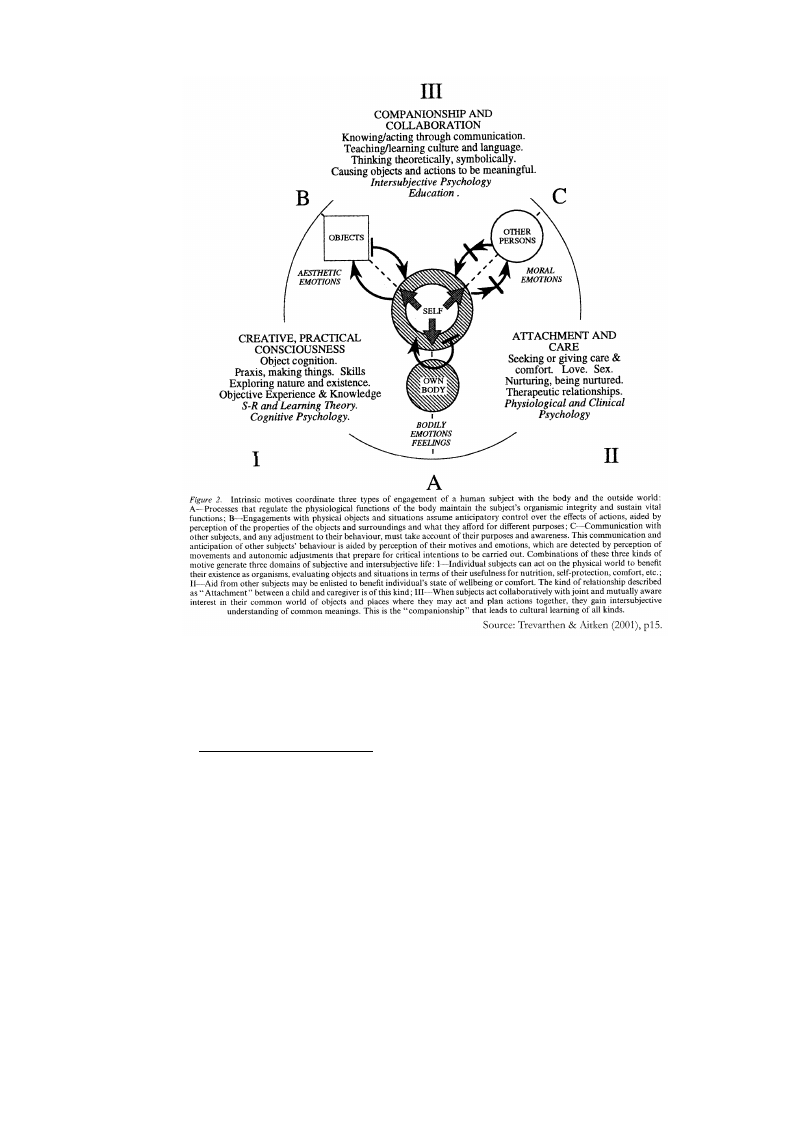
Figure 2.1: Trevarthen’s three relational domains
2.4.5 Staged transformations
Piaget supposed that childhood mental development proceeds in a predetermined
sequence of age-specific stages each of which is contingent on the previous stage. At each
the infant’s worldview is dramatically altered, subsuming or reframing the previous stage.
Earlier phases can be revisited but only under conditions like stress, fatigue or
psychopathology. Without having wholly overturned the basic notion, later authors have
considerably modified this conception showing, for instance, that neonates have far greater
coherence of innate motivation and awareness of objects than previously thought, and that
33
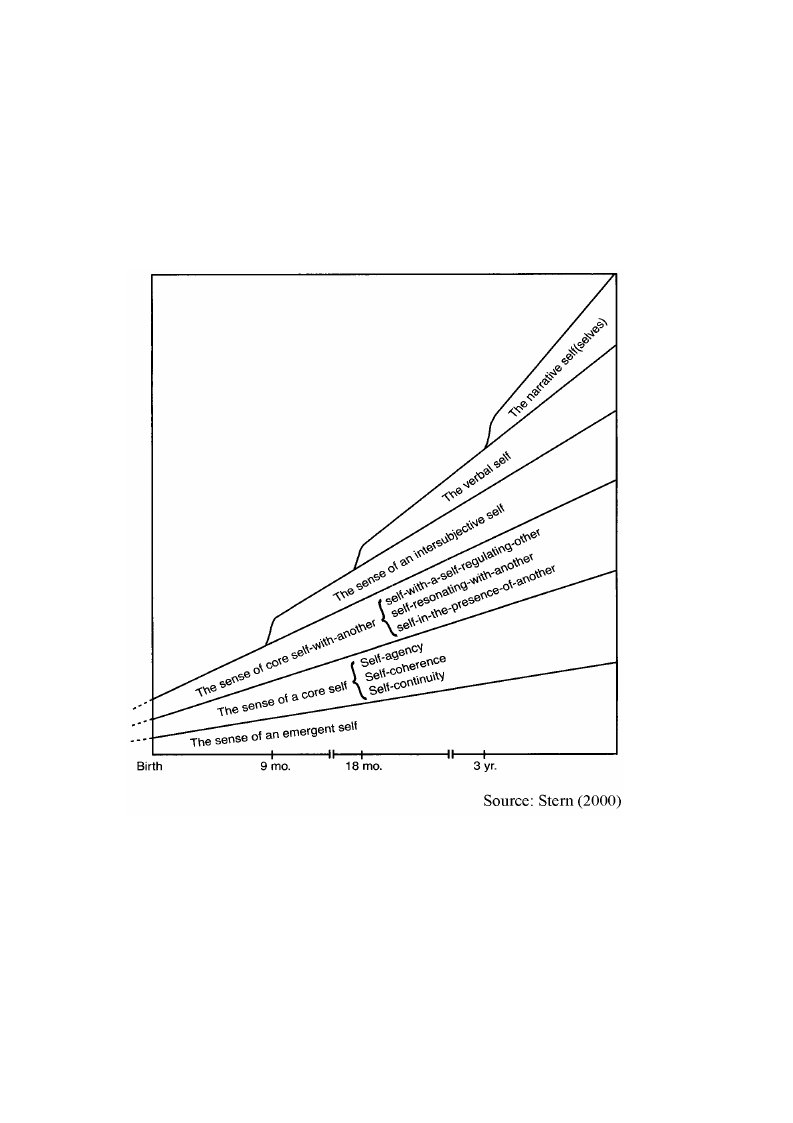
their capacity for relating to other persons as well as their intellectual assets have seriously
been underestimated (Lacerda, von Hofsten et al. 2001; Trevarthen 1998).
Stern challenged a central tenet of the Piagetian view, suggesting that each stage
supplements but leaves intact the previous one: no special conditions are needed to move
between these ‘senses of self’ or ‘domains of relatedness’ as they are all present and
experienced simultaneously (Stern 2000).
Figure 2.2: Stern’s conception of the emergence of self
In Stern’s formulation (Figure 2.2), early experiences remain pertinent to the growing
child and later adult not just because of their transmuted effects but because they remain
directly meaningful to an aspect of self. Senses of ‘emergent’, ‘core’ and ‘-with-another’
34

selves are present from birth. Concentric or ‘nested’ selves are present throughout life, and
the psychotherapeutic language of needing to ‘take care of one’s inner child’ begins to make
sense. Though a lengthy psychotherapeutic excursion would probably be out of place here, it
may at least be worth mentioning how this view appears to lend support to Carl Rogers’
understanding of the fully integrated self being a personality that neither denies nor seeks to
privilege any aspect of self over any other, and is therefore at ease with itself (Rogers 1961).
2.5 Attachment theory
2.5.1 Origins in ethology and psychoanalysis
John Bowlby was a psychoanalytically-trained British psychiatrist, attracted by its
explanatory and therapeutic power but uneasy with its poor empirical base. Observing in the
1940s that deprived upbringings could have deleterious effects on later behaviour (Bowlby
1944), he made his name with a bestselling post-war report for the World Health
Organisation on the mental health of homeless children (Bowlby 1951, 1953). Seeking to
provide scientific underpinnings to Object Relations theory, in 1952 he encountered the then
new branch of applied zoology termed ethology (Lorenz 1952). Excited by the idea of
imprinting he formulated Attachment Theory, which helped account for external dangers to
the child he felt psychoanalysts had wrongly discounted. Attachment is a phenomenon in the
animal kingdom, one closely related to what used to be termed the ‘survival instinct’.
Even such apparently a mentally unsophisticated animal as the ant is said to form worker-
to-queen ‘attachment’ and can transfer it to a new queen (Alloway and Ryckman 1991). As
in lower animals, primate attachment behaviour is partly hormonally mediated and can have
lasting effects, playing out with greater and growing mental complexity as the self develops.
Harlow showed that proximity-seeking in monkeys was not related to feeding, as Freudians
believed (Harlow 1958; Harlow and Suomi 1970) but to an ‘innate need for companionship’
(Suttie 1935). Bowlby favoured an ‘epigenetic’ model of development which rests on
interaction with the mother (terminology now superceded by ‘primary caregiver’)
(Waddington and Hal 1977). It was a spatial theory, consisting of proximity-seeking, the
‘secure base’ effect, and separation protest, and results in the development of an ‘internal
working model’ of relationship (Holmes 1993, Chapter 4). This marriage of psychoanalysis
and evolutionary biology inspired a voluminous body of work that is now in principle
confirmed. The pervasive importance of attachment is generally accepted (Holmes 1993;
Schore 1994).
35

2.5.2 Experimental confirmation
Bowlby’s proposal was not met with widespread acclaim. Many psychoanalysts felt it
dismissed central concepts of internal psychological experience, devaluing their work.
However unlike many of their hypotheses, Attachment Theory was open to experimental
confirmation. Bowlby conducted and published considerable research but probably the most
significant early empirical evidence sprang from the work of his pioneering colleague and
some say co-founder of Attachment Theory, Mary Ainsworth, who in the late 1960s devised
the ‘Strange Situation’ test as a tool for assessing naturalistic mother-child interaction
(Holmes 1993, 104). From observations of a twenty-minute session of mother and child
playing, being introduced to a stranger, parting from the mother and reuniting, three and later
four distinct, repeatable patterns of response were identified. Around two thirds of children
were termed Secure, and one third each Insecure Avoidant and Insecure Ambivalent, with
very small numbers Insecure Disorganised (Ainsworth, Blehar et al. 1978).
Importantly, these categories proved to have diagnostic utility and have become a robust
clinical tool. Later, a method that allows equally reliable non-behavioural diagnosis was
created, the lengthy Adult Attachment Interview (George, Kaplan et al. 1984/1985/1996).
Shorter questionnaire forms that are almost as reliable have more recently become widely
available. Prospective studies have demonstrated both that the quality of the maternal
relationship correlates with attachment status at one year (Grossman, Grossman et al. 1986;
Main and Weston 1982; Sroufe 1979) and that numerous effects on personality can persist
into adulthood and even the next generation (Fonagy 1999b; Fonagy, Steele et al. 1994;
Murray 2001).
On a physiological level, recent neuroscientific evidence supports Bowlby's assertions
that attachment is an instinctive behaviour with a biological function, a control system in the
brain regulating affectively driven behaviour. This regulatory 'senior executive of the
emotional brain' - the orbitofrontal system and its cortical and subcortical connections - is
expanded in the right hemisphere, which is dominant in infancy and centrally involved in
inhibitory control. Attachment theory is ‘essentially a regulatory theory’, and attachment can
be defined as the interactive regulation of biological synchronicity between organisms
(Schore 2000).
36

2.5.3 Refinements
2.5.3.1 Criticisms of attachment theory
The normal pattern of infant care across human history and in different cultures is that it
is shared within a stable group of adults and older children usually, but by no means
universally, related persons and female. Given that in this situation the young child has a
hierarchy of attachment figures to turn to, feminists have critiqued Bowlby for his exclusive
emphasis on the relationship with the mother, which is seen as a reinforcement of a male
dominated status quo that may ironically produce greater insecurity for the child (Holmes
1993). Bowlby has been criticised for using biology to justify the cultural product of
‘patriarchal but father-absent’ nuclear families which suit the needs of capitalism (Leupnitz
1988). Both points have fed into later work.
Research has examined Bowlby’s assertions in detail, and corrected some of them. Brief
mother-child separations per se probably do not generally lead to lasting damage, and the
state of their relationship before separation is important: the more tension in the relationship,
the greater the damage from separation. Antisocial behaviour seems linked not primarily to
maternal absence but to family discord (Rutter 1981). But Bowlby’s core claim stands:
complete maternal deprivation leads to clinging infancy and a restless, attention-seeking
child, and; there is what may be conceived as a ‘sensitive period’ for forming stable
relationships from six months to around four years (Tizard 1977).
2.5.3.2 Infants are participants, reacting actively and ‘logically’ to
experience
Children appear to react logically to the degree of reassurance they encounter, becoming
less secure if maltreated and more secure if not (Crittenden 1992). It is easier for a child to
use a secure mother as a secure base (Posada, Waters et al. 1995). Secure mothers and others
who interact with warmer verbal tones and gentler physical interventions gain greater
compliance and cooperation than mothers of nonsecure infants, who show the opposite
pattern (Londerville and Main 1981). Fearful mothers and those with restricted affect
expression influence their offspring to be less emotionally demonstrative and behave less
well; greater joyfulness in mothers leads to an easier temperament (Kanaya 1985-1986).
From the outset, the effects are two-way: mothers’ mental states and behaviour are also in
part responses to their children's personalities. Later behaviour problems have been shown to
be more likely even into teenage if the mother suffers from postnatal depression (PND), and
37

PND is extended with ‘difficult’ children, who also affect adults other than the mother.
Counseling helps both mothers and the relationship with the child, seriously reducing later
behaviour problems (Murray 2001). Infants’ reactions to attachment experiences may be the
expression of an evolved mechanism. Since the main dilemma facing juveniles would have
been the trade-off between survival and growth, individual differences in attachment may be
attempts to optimise the risks occurring in the environment of human evolutionary
adaptedness (Chisholm 1996).
2.5.3.3 Biological motherhood is not essential
Whilst there are undoubtedly olfactory and other signals which help establish and
reinforce an innate system for mother-child bonding, it is clear that a ‘blood relationship’
between mother and infant is not as important as Bowlby may have suspected: children
adopted in their first few years can form secure relationships (Tizard 1977) and babies can
become strongly attached to men acting as primary caregivers (Geiger 1995, 1996). Kibbutz
children primarily cared for by the same non-family caregiver tend to develop similar styles
of attachment to that adult (Sagi, Lamb et al. 1985; Sagi, Van IJzendoorn et al. 1995).
However communal sleeping arrangements can lead to an increase in insecure attachments
(Sagi, Van IJzendoorn et al. 1994), presumably because the attention given to these infants is
not as great or as personalized. Rather it is the degree and quality of interaction an infant has
with a substitute caregiver that governs the child’s behaviour. Infants with highly involved
caregivers display the highest levels of contact seeking, distance interaction, and exploratory
behaviors in the caregiver’s presence, while infants with low-involved caregivers show the
lowest levels of these behaviors and seek more contact and interaction with a stranger
(Anderson, Nagle et al. 1981).
2.5.3.4 Embodiment and touch
Direct sensual experience of physical contact with other people has been normal
throughout evolution (Cook 1978), is important in helping regulate infant arousal (Brennan,
Wu et al. 1998), enhances self-regulation in premature infants (Feldman, Weller et al. 2002)
and shows correlations with early attachment behaviour (Lowinger, Dimitrovsky et al.
1995). Autistic children show better social relatedness when massaged regularly (Escalona,
Field et al. 2001), and Amazonian tribal infants are carried continuously by one or other
parent next to their skin, which has been linked with a markedly calmer temperament in later
life (Liedloff 1989). Memories of having received physical affection from parents correlate
38

with parental warmth, intimacy and attachment, and relates to competent social and
emotional development in adolescence (Oleson 1996). Interestingly, infants who do not
sleep with their parents develop stronger and more longstanding attachments to inanimate
security-objects than those who do (who tend to have breastfed) (Hayes, Roberts et al. 1996).
‘Corporeal attachment’ has been suggested as a term for the possession of a realistic body
image and attitude, and of being sensuously in touch with one’s own physicality
(Anonymous 2001). The idea that the highest form of environmentalism is to ‘love the world
as our own body’ has been mooted (Loy 1997), alongside the notion that we should be
treating the ‘world as lover, world as self’ (Macy 1991b) to reach such a state.
2.5.3.5 Models of self and other
If attachment behaviour of the adult is predictable from the infant’s experience, how does
this come about? Bartholomew returned to Bowlby’s model in suggesting that underlying
attachment status are two mental ‘constructs’, respectively the internal models of the self and
other (Bartholomew 1990; Bartholomew and Horowitz 1991; Griffin and Bartholomew
1994) (though as has been noted, these ‘constructs’ may be partly innate). This led to a
perhaps more satisfactory explanatory model (Figure 2.3) that appeared to offer an
ethologically and psychologically coherent account of why these states should arise, and a
two-dimensional space within which four distinct types of attachment status can be
conceptualized (Griffin and Bartholomew 1994).
A closely related model utilizes the same categories but considers Bartholomew’s vertical
and horizontal axes respectively to be ‘avoidance’ and ‘anxiety’ (Brennan, Clark et al. 1998;
Hazan and Shaver 1994; Shaver and Fraley 1997).
Parker separately measured the perceived quality of care and degree of control by each
parent using the Parental Bonding Instrument (Parker, Tupling et al. 1979), postulating four
types of parenting: neglectful (low care and low control); affectionless control (high control
and low care); affectionate control (high care and high control); and optimal (high care and
low control) (see Figure 2.4). Optimal parenting indicates that the parent provides adequate
affection and accords the young person appropriate emotional independence or allows
appropriate emotional independence to develop. Both affectionless control and neglectful
parenting have been shown to be associated with antisocial or offending behaviour of youths
(Mutale 2000).
39
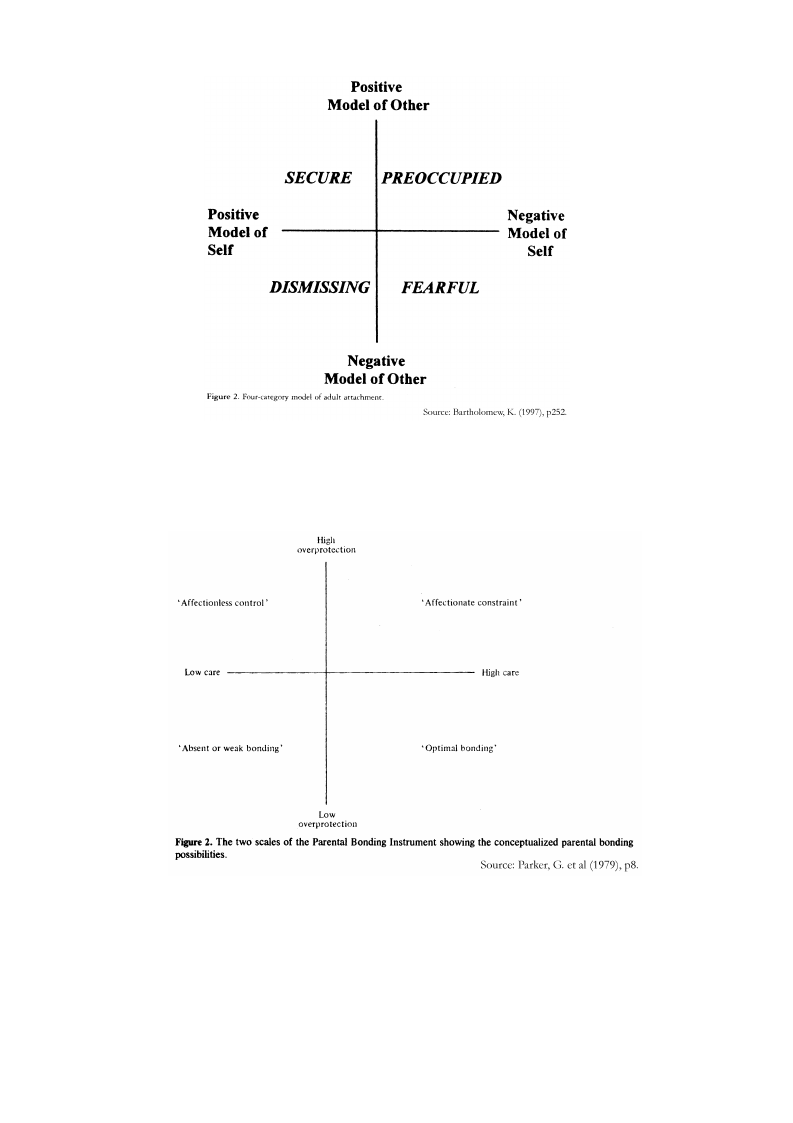
Figure 2.3: Bartholomew’s four-category model of adult attachment
Figure 2.4: Parental Bonding Instrument scales
40

Combining these models, the axes equate as follows:
Model >
Internal working model
Equivalent vertical Positive-negative model
axis
of others
Avoidance-anxiety
Low-high avoidance
Care-Overprotection
High-low care
Equivalent
horizontal axis
Positive-negative model Low-high anxiety
of self
Low-high
overprotection
Table 2.1: Comparison of attachment model axes
Debate continues over whether there is a third factor, as revealed in factor analyses
(Murphy, Brewin et al. 1997). More complex models and classifications are now being
proposed, including the ‘dynamic maturational’ (Crittenden 2000), alongside the ‘lifespan’
perspective, which argues that since protective needs extend beyond infancy, attachment is
important throughout life (Goldberg, Grusec et al. 1999).
2.5.3.6 Multiple psychologies: The same constructs?
Disparate origins apart, it may be that apparently incompatible theories of personality
development as differentiation (from psychoanalysis), attachment and mutuality (as
conceptualized by self-in-relation theorists) in fact tap into the same underlying interpersonal
and intrapersonal constructs (McKinney-Goss 2000). Certainly there are significant overlaps
and parallels between attachment and psychoanalytic theories (Fonagy 1999a) and theory of
mind (Fonagy, Steele et al. 1997).
Theorists and clinicians hailing from many formerly distinct schools of thought have
adopted its framework, as this chart of the principal influences (Figure 2.5) shows. The
initially hostile reception Bowlby received has turned into what may be described as a
torrent of approval. Attachment research is now an extremely active and wide ranging
enterprise, which has been extended into some surprising fields, as we shall now see.
41
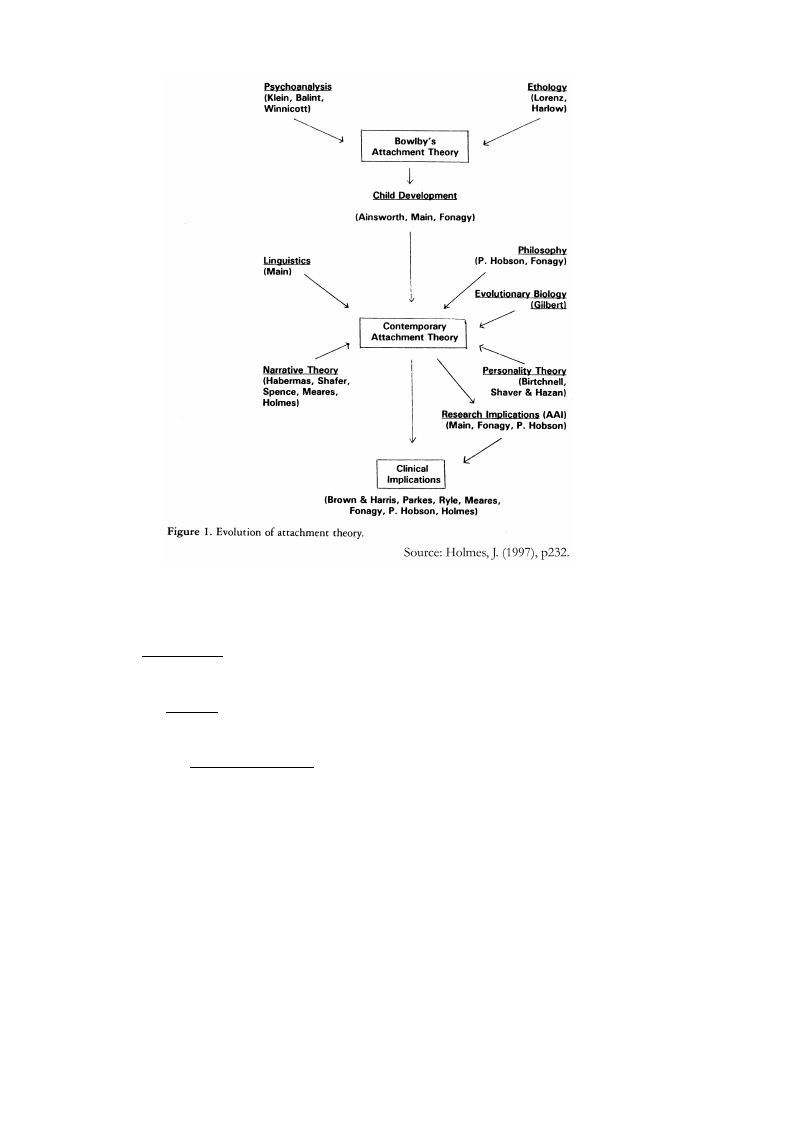
Figure 2.5: Evolution of attachment theory
2.5.4 Extensions
2.5.4.1 Human
2.5.4.1.1 Intrinsic influences
Despite its dependence and need to form attachments, the infant is motivated from birth
to seek more than mere care giving from others. Our desire to communicate stimulates us
immediately to start learning about the ‘intentions, interests and feelings’ of others
(Trevarthen 2001): motivation which contemporary cognitive theory cannot account for
(Trevarthen 1992). Musicality is innate and prelinguistic (Trevarthen 1999-2000), as is a
certain morality shaped, various investigators argue, by evolution for greatest gene, personal,
or species advantage (Dawkins 1976; Wright 1994).
42

As the infant matures and establishes influence over itself, experience divides into ‘self’ -
over which it has increasing - and ‘other’ - over which it has (apparently) diminishing -
control. Feedback from exploratory use of its physical and mental faculties - i.e. using and
perceiving senses, limbs, the mind - might be termed ‘intrapersonal’ experience and it is in a
sense the rate at which this is allowed to develop and the emotional regulation surrounding it
which creates security for the maturing individual self. Whilst, as any primary caregiver is
aware, the infant’s nascent personality is evident from an early age, it is in a state of ‘original
innocence’. Attachment experience is determined by whether it is allowed to unfold amid
security and without detrimental external interference.
2.5.4.1.2
The first dyad
Most early work on attachment was done with mother-infant relationships (Ainsworth,
Blehar et al. 1978, 307), where the mother’s presence provides emotional security,
encouraging exploratory behaviour (Ainsworth and Bell 1970). Protest-despair reactions to
separation correlate with behaviour prior to separation, and the nature of the separation and
reunion environments, similar to monkeys (Mineka and Suomi 1978). The wider context also
impinges: mothers and their offspring have less fluent nonverbal interaction when living in
an unfamiliar culture, precipitating identity confusion and emotional insecurity for the
mother (a failure of ‘belonging’) which is instinctively apparent to the child (Gratier 1999-
2000). Given that culture is mainly transmitted via mimicry (Trevarthen, Kokkinaki et al.
1999), this implies that first generation immigrants at least may always be insecure.
Born with the ability to express their emotional states, infants stimulate reciprocal
relations with caregivers (Trevarthen and Aitken 1994). Infant temperament therefore affects
the infant-caregiver relationship, although there is disagreement about the degree of
influence from the child (Miyake, Chen et al. 1985; Sroufe 1985). Compatibility between
personalities is therefore a determinant of a relationship. For example, ‘highly sensitive
people’ (HSPs), the 20% of individuals who exhibit particular nervous sensitivity, are more
likely to be insecurely attached (Goldsmith, Bradshaw et al. 1986, cited in Aron (1999), 70).
Young HSPs may more easily feel overwhelmed and ‘frozen’ when adults make them
uncomfortable, compounding poor communication (Aron 1999, 72).
Hence, earlier notions that attachment status develops consistent with only the child’s
temperament or those of the principal caregiver have been superceded by those of a dynamic
dialogue between the two (Sroufe 1985).
43

2.5.4.1.3 The next dyad, and the first triad
The father also serves as an attachment figure, but this does not as some claim
demonstrate the invalidity of attachment theory (Willemsen, Flaherty et al. 1974). Rather the
child inhabits a ‘social network’ (Weinraub, Brooks et al. 1977) within which it successively
builds up attachment relationships, eventually to form a hierarchy of ‘friendships’ (Trinke
and Bartholomew 1997).
Infants are most intimately and strongly attached to their primary caregiver, seeking
proximity when in need more often to mothers than fathers (Ban and Lewis 1974). When all
three are together, they have complex effects on each other: for instance interaction with
each parent, greater with each when alone, may be inhibited (Lamb 1977a). The presence of
the father improves mother-child affective interaction, but reduces the mother’s playfulness
with secure infants (Zaslow, Rabinovich et al. 1988). Together they develop a relational triad
(Clarke-Stewart 1978) which cannot be explained dyadically, just as with primate
relationships (de Waal and Embree 1997).
How the mother and father jointly run their lives has significant effects: children of
working couples are more secure if the mother prefers to stay at home, is maritally satisfied,
and considers the child manageable. Children of full-time working mothers are more
dependent. Temperamentally easy children attach better to fathers (Payne 2001). Deliberate
attempts to generalise attachment away from parents can cause difficulties: kibbutz children
who stay with their parents rather than communally are more secure (Sagi, Van IJzendoorn
et al. 1994) and adopt their attachment status. Those who sleep in communal houses do not
(Sagi, Van IJzendoorn et al. 1997) and may have damaged mother-child attachment
(Aviezer, Sagi et al. 1999).
Parental over-control steers the child toward an anxious adulthood (Chorpita and Barlow
1998), and overprotective parenting impedes the facility for self-protection against distress,
for example in incarcerated young offenders (Biggam and Power 1998). Using the Parental
Bonding Instrument instrument (Parker, Tupling et al. 1979) it has been shown that young
prisoners’ self-esteem, hopelessness, and suicidal behavior correlates with parental bonding
style (McGarvey, Kryzhanovskaya et al. 1999).
It is increasingly recognized that psychological difficulties may be not just problems of
individual adjustment but also of models of relationships between others picked up from the
context of upbringing: a significant relationship has been detected between family role
behavior and a child’s interpersonal attachment (Deason 1998).
44

2.5.4.1.4
Wider and lasting effects
Bowlby argued that early experience does not lead inevitably to later pathology, but feeds
into the present context of development. Extremes apart, anxious attachment is not itself a
psychopathology but sets in train pathways which are more likely to result in later pathology
(Sroufe, Carlson et al. 1999). Attachment as a quality of relationship extends beyond
childhood and the specific needs of protection from predation and survival; it serves to
protect in times of illness, injury, and emotional distress, even into adulthood (Goldberg,
Grusec et al. 1999). Relationships can be transient and emotionally distant, but ‘affectional
bonds’ exist when we maintain contact over time and absence, feel joy on reunion and grief
at permanent loss. Since an attachment is an affectional bond, attachment figures are non-
substitutable, other attachments notwithstanding. But attachments have something beyond
other affectional bonds:
‘This is the experience of security and comfort obtained from the relationship
with the partner, yet the ability to move off from the secure base provided by the
partner, with confidence to engage in other activities. Because not all attachments
are secure, this criterion should be modified to imply a seeking of the closeness
that, if found, would result in feeling secure and comfortable in relation to the
partner.’ (Ainsworth 1989)
Nevertheless, the effects of attachment status are wide-ranging and lifelong, and the odds
are stacked against children of mothers with poor parenting skills. The most comprehensive
study to date of the relationships between child-care, family factors, and early development
followed 1100 US children from birth to age 7. The most consistent predictors of children’s
outcomes were maternal sensitivity, quality of the home environment, and income. Over
90% of 3 year old US children experience regular non-maternal care, with over half getting
over 30 hours a week (Allhusen, Appelbaum et al. 2001). This seems to lead to greater
confidence, as pre-schoolers who have interacted with strangers are more ready to seek
physical contact with novel strangers (Klein and Hewitt 1987).
Attachment status determines peer relationships at an early stage. Mother-infant conflict
leads to sibling conflict (Volling and Belsky 1992). Four and five year olds show stable
social and emotional characteristics: those with secure attachment histories score higher on
emotional warmth, social maturity, and peer popularity, while anxious-resistant subjects
have the lowest peer status (LaFreniere and Sroufe 1985), which is not surprising given that
feeling secure activates feelings of empathy (Mikulincer, Gillath et al. 2001). Attachment
45

style may well have lasting effects on the development of children's understanding of other
minds (Holder 1996). Dismissing and preoccupied older teenage girls have poorer
communication skills and interact less well with their best friends (Black, Jaeger et al. 2000).
Behaviour with romantic partners echoes parental relationships (Roisman, Madsen et al.
2001). Adults visiting significant others - including parents, friends and romantic partners -
echo infant attachment separation behaviour (Yankeelov 1996) as do spouses who must part
company (Vormbrock 1995). Although insecure relationships are not necessarily unstable;
they can endure despite dissatisfactions and abusive behaviour (Bartholomew and Shaver
1998), instability of attachment impacts negatively on mental health (for instance impaired
mourning (Parkes 1991)), but also potentially on physical health, as it does on monkey
immunity (Coe, Lubach et al. 1994).
On a positive note, whilst early traumatic attachment experiences can lead to extreme
effects, they can be counteracted in the secure base of a therapeutic bond. Borderline
personality disorder, (BPD) a condition of profoundly insecure attachment, can involve
vacillations between a wish for proximity and a dread of engagement (Sable 1997). People
with BPD report more alienation, egocentricity, and social incompetence in object relation
deficits, view their parents more negatively and are more likely than the norm to be
classified as avoidant and hostile (Sack, Sperling et al. 1996).
Establishing an affectionate bond in parent-child and therapist-client relationships is
similar to that in intimate partnerships: all three provide a ‘safe’ space to sustain emotional
bonding (Karlsberg and Karlsberg 1994). Therapy can also help delinquent children who
have had serious attachment disruption through adoption. Brief ‘holding therapy’ includes
cognitive restructuring, psychodrama, inner child metaphor, and therapeutic holding
(Myeroff, Mertlich et al. 1999). Special needs children also benefit (Myeroff 1997), and
changes are still present 2 years after the therapy (Randolph 1997).
2.5.4.1.5 One attachment or many?
It is clear that we develop multiple attachments (Goldberg 1983; Lamb 1982; Mitchell, J.
Clyde 1987). Bowlby, sometimes misrepresented on this, specifically denied ever having
said that mothering cannot safely be distributed among several figures (Bowlby 1969, 303).
As the first year progresses into the second, infants may develop several attachments
including to father, siblings and grandparents, depending on who cares for them. Rather we
need ask whether the attachment style established with the primary caregiver ‘locks in’ a
pattern for later attachments. The converse notion is more complex: that the child can
46

establish differentiated attachment styles with different people. It seems the answer is mainly
the latter, with qualifications.
Attachment experience is consistent according to the caregiving adult: siblings brought
up by the same mother tend to form similarly secure or nonsecure relationships (Van
IJzendoorn, Moran et al. 2000), but experiences with mother and father are dissimilar, and
they have different effects on infant personality development (Lamb 1977b).
In the absence of healthy parental attachment, the presence of at least one competent and
emotionally stable person who is attuned to child's needs and with whom it can form a close
bond is protective (Werner 1995), since that relationship can become a preferred model for
later relationships. In this way, abused children can escape intergenerational cycles of abuse
and become model parents, a phenomenon termed resilience (Fonagy, Steele et al. 1994).
Even in narrowly numerical terms, this is why traditional societies are likely to provide
better protection against attachment insecurity, since multiple alternative attachment figures
are constantly available. The child can maintain many and turn to the one that feels best in
any given situation – indeed this is the evolutionary norm. The extended family is one step
less ideal than this, and the isolated nuclear family inevitably more risky still.
But can the qualities sought in an ideal ‘loving’ relationship be provided through other,
perhaps non-human means? In other words, is it possible to obtain ‘resilience’ from non-
human sources? Can a pet give the unconditional love that it is known can later be protective
against the perpetration of abuse? Can security be attaied through other means: secure
identity within a community, or the security of intimately knowing and ‘owning’ or
‘belonging to’ a place? Arkow suggests that many children ‘who live in violent households
seek solace in their pets as islands of kindness in the chaos roaring around them’ (Arkow
2002a). The notion of resilience through connection with inanimate nature has been mooted
(Stephens 1999).
It may be that non-human attachments are present in normal attachment hierarchies. It
may also be that they can act as compensation for inadequate human care. The effects of a
‘good’ relationship with a non-human figure may even flow back into human relationships.
2.5.4.2 Attachment to all sentient others?
The concept of attachment has now been extended to applications beyond interhuman
relationships to include other sentient creatures, most rigorously to research on relationships
with pet animals.
47

2.5.4.2.1 Interspecies relationships are normal
Close behavioural associations with non-human animals are common, historic, useful,
and probably co-evolved. Species communicate across the species barrier (Smith 1999) and
develop attachments, relationships between sheep and dogs having been noted 40 years ago
(Cairns and Johnson 1965). Bonding between sheep, goats and cattle strengthens with time
and is used to limit predation (Hulet, Anderson et al. 1991; Hulet, Anderson et al. 1987;
Hulet, Anderson et al. 1989). Sadly even a motherly lioness cannot prevent her fellows
regarding infant antelopes she adopts as lunch (Astill 2002). Scientists bond with
experimental subject animals, bonds which also affect the animal (Davis 1993), rendering
swathes of past research of doubtful value. In the field or laboratory this can result in
profound behavioral and physiological changes relevant in research fields ranging from the
biomedical (e.g. heart rate, blood pressure, and immunological changes) to animal sciences
(e.g. growth and production) and in species ranging from primates and dogs to chickens,
reptiles, and even octopuses (Davis and Balfour 1992). Possible scientist-animal
relationships include dominant-subordinate, parent-offspring, predator-prey and potential
sexual partner (Estep and Hetts 1992). Scientists who bond with an experimental animal may
feel a special responsibility to that animal or may wish altogether to avoid research in which
bonding occurs (Lehman 1992).
A compelling reason to accept the normality of close human-animal relations, at least
with respect to dogs, is the antiquity of the relationship. Archaeological evidence points to
domestication around 10- to 20,000 years BME (Brisbin Jr. and Risch 1997). Recent genetic
evidence puts it at 100,000 (Mlot 1997; Vila, Savolainen et al. 1997) or even 400,000 years
(Eliasi 2002). This cooperative association has probably influenced our own evolution
(Marschark and Baenninger 2002) and may even account for our success (Ananova 2002).
Understanding the habits and mind of prey and predators was useful to early humans, and
hunting may have become more efficient by cooperation with and domestication of dogs,
bringing additional benefits like protection, companionship, emergency nutrition (i.e.
insurance), extension of the senses into animal realms (i.e. education).
Animal imagery is among the earliest known human artifacts, and effigies of animals
have played and continue to play a critical role in cultural symbolism, dreams and folklore
(Shepard 1978; 1996). Levinson (1972) argues that ‘Man has not changed essentially over
the last million years... (and) most men have a need to associate with animals’. The
ethologist Konrad Lorenz (cited in Levinson) claimed a need to associate with animals, and
equated the need for the companionship of his dog to a bond with nature.
48

Despite this, and a flow of scientific evidence to the contrary emerging from the turn of
the nineteen-seventies onwards, accounts as late as 1978 appeared to characterize a close
emotional bond with a pet as pathological. Although the mutual need for attachment is
acknowledged, Rynearson suggests that abnormal developmental frustration can cause a
child to ‘displace attachment needs onto the pet’. This ‘defensive’ relationship can create
enduring psychiatric reactions if interrupted (Rynearson 1978) – but so can the sudden loss
of any close individual. Dissociative Identity Disorder (a psychiatric term related to
schizophrenia and multiple personality disorder describing detachment from current events
and psychic disowning of experience, involving decreased concentration and memory, and
considered a defense against unbearable emotional turmoil) may characterize individuals
highly attached to pets. Parental neglect or rejection may precipitate particularly strong pet
attachment and even subsequent vocational orientation (Brown and Katcher 2001).
Pet attachment is significantly correlated with dissociation and absorption (the most
benign nonpathological element of dissociation, involving imaginative involvement such as
daydreaming), and high nature attachment is significantly related to absorption. Two fifths of
those with high pet attachment have clinical levels of dissociation. Pet attachments may
provide a compensatory relationship for people with histories of trauma. An attachment to
nature may be indicative of seeking an experience of sensory absorption, but not a ‘personal’
relationship (Brown 1997, 2001). It may be that there is a degree of attachment to the non-
human that is unhealthy, but this perspective risks throwing out the baby with the bath water.
Brown and colleagues do not appear to accept the notions that it may be a positively healthy
coping response for a child deprived of ‘good enough’ human attachments to turn to a pet or
nature, that relationships with non-human animals or places may in themselves be good for
you and qualitatively differentiated from inter-human relationships or, more radically, that
attachment to animals and nature more generally may be a prerequisite of sanity (Shepard
1982). One author believes that pets are temporary substitutes – ‘transitional objects’ – in the
maturing mind of the child which, though they may be pragmatically useful in the
maturational process, hold no unique position in it nor necessarily have any longer term
effects particular to them. ‘…pet animals are for many people another step in the progressive
differentiation of self from other.’ (Klein 1997, 250). The unfortunate but logical
extrapolation of this argument being of course that the complete obliteration of human
experience of nature would have no ill effects on us (though it may be that this was not the
intended implication).
Pet keeping is in fact a culturally universal phenomenon, although its means of
expression varies (Brown 2002). Midwest US pet ownership is associated with large, intact,
affluent rural households, whereas companion animal bonding is higher for adults in small
49

urban, divorced families (Poresky and Daniels 1998). More than one in four Indiana
schoolrooms have a class pet: 72% of classrooms have pets, and 46% of classrooms without
pets allow students to bring in their own. Animals found include: Mammals (including
Chinchilla, Gerbils, Guinea pigs, Hamsters, Mice, White rats, Hedge hogs, and Rabbits),
Birds, (e.g., Parakeets), Reptiles (including Anoles, Iguanas, Legless Lizards,) Snakes (e.g.,
Corn, Boa constrictor, and Garter), and Turtles (including Box turtles), Amphibians
(including Salamanders), Frogs (including African and tree frogs), and Toads, Fish
(including guppies, Goldfish, Beta, and basic tropical fishes), Insects, (e.g., Ant farm,
Butterflies, Caterpillars, Cockroaches (including hissing), Crickets, and Mealworms),
Invertebrates (including worms), Hermit crabs and Crawdads, Sea anemone, Snails, and
Spiders (e.g., Tarantula). Animals motivate students to behave better and provide
opportunities for care giving, a strong reward for working well in class (Rud and Beck
2000). Children who have pets talk about them, have contact with others' pets, enjoy animal-
related school assignments, movies, television, books and zoos more than those without.
Boys read and watch television about animals more than girls. Of all school age groups,
middle schoolers have more animal contact and like pets best. Less than one in thirty has no
contact with animals or animal-related information (Kidd and Kidd 1990).
This is important since ‘what is experienced as … vital to the self determines one’s
spontaneous “field of care.”’ (Myers Jr. 1998, 16) Adults who had pets when they were
children have more positive attitudes to pets now. The younger the child encountered a pet,
and the closer they were to it, the more sympathetic they are (Poresky, Hendrix et al. 1988).
Pet owners and non-owners do not differ in personality, but may differ in attitudes (Johnson
and Rule 1991). Dog owner’s choice of breed may correlate with their personality
(Notarangelo 2000).
The role pets fulfill changes with age. They are for all children more significant in
understanding relationships than for adults, and seem particularly important for certain
children. A novel approach accessed such conceptions by hypothesising that in children’s
drawings, distances between figures represent emotional distance. Fascinatingly, as children
become older animals in their drawings move closer, and family members – at first nearest –
move further away, eventually to be displaced by pets. Cats, dogs, caged and farm animals
are placed significantly closer to self-figures than fish, and older children are more likely to
draw themselves holding an animal. Whilst pet owners and non-owners are equally
emotionally close to family members, for owners pets are even closer (Kidd and Kidd 1995).
Taken literally this suggests that pets are significant others at critical phases of child
development, at times more important than humans, and in normative, not just pathological,
situations. One accessible stereotype here might be the young teenage girl who ‘loves’ her
50

pony (there is of course the possibility that closeness to animals may be an effect of child
‘ownership’). Kidd and Kidd’s conclusions might also be taken to support certain other
notions:
• Children constellate their relationships differentially: they know which
relationships are close and which less so - and animals are actors in that drama;
• Pet owning children have a greater number of close companions with whom they
interact;
• Children with pets encounter more types of ‘personalities’ with which to interact;
• During the transition from infancy to middle childhood, pets move from being
less significant than family to more so;
• Owners and non-owners draw family members at similar distances, but owners
draw pets between themselves and family. Hence the latter see themselves as
closer to their pets than humans in absolute terms: their subjective experience is
of closer relationships.
• Children construct a phylogenetic hierarchy at least partially on the basis of
emotional identification.
Kellert distinguishes three domains of children’s experience of nature: direct, indirect and
vicarious or symbolic (Kahn Jr. and Kellert 2002, 118; Kellert 1996). Direct experience is
defined as largely unplanned play involving physical contact with natural settings and
nonhuman species that are outside and independent of the built environment and apart from
continuous human input and control. Indirect experience is defined as physical contact but in
programmed and managed contexts where nature is subject to deliberate and extensive
manipulation, such as gardens, zoos and aquaria. Included in this category are ‘related but
different’ contacts with domesticated plants and companion animals. Finally, vicarious or
symbolic experience is encounters with representations of nature that can be realistic but
may also be metaphorical or stylised – formerly mainly in print media (and dating back to
cave paintings, totems and preliterate oral tradition) but increasingly through electronic
means (Jung 1990; Levi-Strauss 1966; Mithen 1996; Shepard 1978, 1996).
Though this categorisation is useful, it perhaps too readily leaps to clean distinctions, for
instance over domesticated animals. Cats, dogs, horses, birds and fish are seen as wholly
under human control, connoting an extinguishment of their ‘essential wildness’. ‘Direct’
51

experience of wildness one might have with a wild animal is assumed to be more genuine
than the cowed (sic!) animality one might have with a pet (and seeing animals in the
wilderness contributes significantly to the perceived psychological value of such experiences
(Fiedeldey 1994)). Many pets are the product of selective breeding and behavioural
manipulation, but distant observation of a wild animal could be classed as a ‘vicarious’
experience, the true nature of the animal remaining forever ineffable, whereas the lasting,
deep and dynamic relationships many establish with companion animals could be seen as a
much more ‘direct’ and genuine encounter with otherness. There are proven distinctions
between the quality of experience that can be had with familiar (Zasloff 1996) and unknown
(Eddy 1995; Lowe and Bradshaw 2002; Mitchell and Thompson 1990) animals.
2.5.4.2.2 ‘Companion animals’ engender health
Pets have multiple impacts on wider measures of health. Pet attachment is positively
correlated with physical health (Dembicki and Anderson 1996; National Institutes of Health
1987; Serpell 1991) (although some contrary evidence has been found (Budge, Spicer et al.
1998)) and mental health is improved, for example in the elderly (Dembicki and Anderson
1996; Garrity, Stallones et al. 1989)). Just as with mothers and infants, compatibility
between pet and owner matters. People who are more physically, behaviorally and
psychologically compatible with their pets report better mental health and fewer physical
symptoms, independent of their level of pet attachment and human social support (Budge,
Spicer et al. 1998).
Pets supply ongoing comfort, opportunity for nurturance, and reduce loneliness (Sable
1995). Pet owners tend to be more physically active, have lower blood pressure, lower
cholesterol and survive heart attacks more than non-pet owners (Riverdeep Interactive
Learning 2001). Dogs act as a social lubricant and source of humour between humans
(Kenworthy 1997). Senior citizens who have a pet are more active and suffer less
deterioration in coping (Raina, Waltner-Toews et al. 1999). A pet supplies companionship,
affection and protection, and makes them more alert, visit the doctor and suffer from
depression and loneliness less. Alzheimer's patients exposed to aquaria are more relaxed,
alert, have a better appetite and attention span (Riverdeep Interactive Learning 2001).
Animal therapy promotes empathy and nurturing; encourages socialization; and provides
non-threatening physical and emotional contact (Riverdeep Interactive Learning 2001).
Suggestions that raising pets promotes self-esteem (Levinson 1978) have been confirmed
(Triebenbacher 1998). Wider emotional benefits including higher levels of self-concept, self-
esteem and autonomy in pre- and early adolescence (Covert, Whiren et al. 1985; Davis 1987;
52

Davis and Juhasz 1985; Van Houtte and Jarvis 1995) and better distress coping (Taggart
1997) have been demonstrated. Pets are seen as special friends, important family members,
and providers of social interactions, affection, and emotional support (Triebenbacher 1998).
Children with pets are better socially integrated, have wider social networks, and are more
popular with their classmates (Endenburg and Baarda 1995). Girls have stronger pet bonds
than boys, and closeness of girls peer and pet relationships correlate, but do not differ
between owners and non-owners. Petless boys relate less well with peers (Angle 1995).
In pre-adolescence a pet is a developmental resource, seen as both responsibility and
friend, though the nature of child-pet relationships shifts according to the demands of
development. Indeed a static relationship between pet and child would be cause for concern
(Brown, Richards et al. 1996). Just as with humans, human-animal relationships can have a
maturing dynamic narrative, of which a sensitive human may be aware. In Wuthering
Heights, Emily Bronte portrays the dog as a scapegoat, and is aware of connections between
animal abuse and domestic violence. In her own life, Bronte tells of her mastiff, Keeper,
with whom she struggled at first, before the relationship became one of caring. After her
death, Keeper may have acted as a bridge to other humans as he mourned his own loss and
comforted others in theirs (Adams 2000). Early pet involvement enhances adult empathy for
other human beings (Paul and Serpell 1992).
How does this come about? Parents, teachers and peers often make acceptance and
approval conditional; pets’ affection is unconditional (Masson 1997). The preadolescent's
need to develop a positive self-concept and feel valued by a close friend may drive the
interaction (Angle 1995). Pets can play a critical role in providing self-object functions,
particularly in an impoverished or exploitive environment: this is known as the ‘stand-in’
interpretation. Unresponsive pets provide their own special difficulties (Alper 1993). One is
tempted to speculate on how a pet’s own mental health may be affected, particularly for
example whether an orphaned (particularly young) pet may be changed by participation in a
human family.
Pets are important for the mental well being of many homeless people (Kidd and Kidd
1994). Petting a dog reduces stress, but it’s not just the dog: the relationship matters.
Greeting a known dog raises blood pressure more than an unknown one, petting it reduces
blood pressure still more (Baun, Bergstrom et al. 1984). Perceived social support improves
the lot of cardiac rehabilitation patients, although not necessarily a novel but friendly small
dog (Craig et al 2000). Cat owners believe they receive affection and unconditional love
(Zasloff and Kidd 1994). Fifty-seven percent of owners would prefer the company of their
pet to another human on a desert island (Riverdeep Interactive Learning 2001).
53

Candidate explanations for associations between pet ownership and health include:
• Pets could have either direct physiological effects or mediatory relational effects.
In the latter case, for example, early exposure to pets (Ownby, Johnson et al.
2002; Platts-Mills 2002) or a farm childhood (Ernst and Cormier 2000;
Kilpelainen, Terho et al. 2000; Von Ehrenstein, Von Mutius et al. 2000) reduces
later asthma and allergies;
• Pet ownership could facilitate person-to-person relations, or;
• Health could be a consequence of other factors that covary with pet ownership
(Collis and McNicholas 1998).
It may be that ‘being in relation’ with another sentient being is in itself healthy (Collis,
McNicholas et al. 1993). One might therefore postulate that those who live alone and have
little social life would proportionately benefit most from the acquiring of a pet, and that
those already living amid a complex of relationships – say in an extended family – would, all
other things being equal, exhibit the least effect.
2.5.4.2.3 Animal attachment and its consequenses
Human-pet bonding is multidimensional, characterized by emotional-psychological,
social, behavioural, and commitment dimensions (Johannson 2000). Three aspects have been
distinguished: (1) emotional bond/affectional tie, (2) physical proximity, and (3) caretaking
(Triebenbacher 1999). People develop attachment relationships to pets (Endenburg and
Baarda 1995; Melson, Peet et al. 1991), and numerous authors analysing human-pet relations
in the attachment framework (e.g. Melson, 1989; Johnson et al, 1992; Marks et al, 1994;
Sable, 1995). The dog-human affectional bond, in particular, can be characterised in such
terms (Previde, Custance et al. 2001). Both attachment and social support theories are
required to explain the pets’ role (Stammbach and Turner 1998; Stammbach and Turner
1999).
Attachment to companion animals is normal for children (Melson 1990; Melson, Peet et
al. 1991; Stevens 1990), for adults (Marks, Koepke et al. 1994; Poresky and Daniels 1998;
Stallones, Marx et al. 1990) and for the elderly (Cookman 1996; Garrity, Stallones et al.
1989; Raina 1996; Stallones, Marx et al. 1988), contributing to emotional and social well-
being, offering comfort, reducing loneliness at stressful transitions and providing
54

opportunities to nurture others across the whole life cycle (Sable 1995). For example, newly
dog-owning children are visited more by friends and engage in more leisure activities at
home together. Attachment to the dog increases confidence and decreases tearfulness (Paul
and Meyer 2001). Dogs may act as ‘transitional objects’ for the drug dependent (Charnaud
2000) (though this author might prefer the term ‘transitional subjects’). The course of grief
when a pet dies is very similar to that of human loss (Archer and Winchester 1994). Children
grieve more than adults (Jarolmen 1998), girls tend to be closer and the closer the child was
to the pet, the worse the grief (Brown, Richards et al. 1996). However, pets are helpful in
overcoming grief (Adkins and Rajecki 1999). Those who cannot spent much time with their
pets, like working women, find them less therapeutic (Watson and Weinstein 1993). Pet
attachment is greater for children whose mothers are employed (Melson, Peet et al. 1991),
the implication being that when parents are less available, pets act as ‘supplementary
attachment figures’, as they can for older people (Keil 1991).
The parallels between attachment to fellow humans, attachment to pets, and the potential
for wider circles of attachment to other sentient and non-sentient phenomena are too stark to
ignore. Our intimate and multiple psychological associations with nature and natural
phenomena are at least as old as consciousness and, it can strongly be argued, as old as life.
Cricitally, they may be non-substitutable. While sharing human attachment qualities, human-
pet relationships are different and supplementary, the therapeutic effects occurring
independently of other social relationships (Sable, 1995). In a note of caution, Dehasse
suggests that interspecies attachment is weaker than intraspecies, since it is easily acquired
but requires reinforcement to avoid de-socialization, is not generalisable to all individuals of
the species, and has a threshold of socialization that depends on the species concerned
(Dehasse 1994). We will critically examine these assertions.
Pet owners are keenly aware of their animal’s levels of playfulness, confidence, affection,
excitability, activity, friendliness to strangers, intelligence, and owner- directed aggression.
Less attached dog owners are dissatisfied with its behaviour, but weakly attached cat owners
are unhappy with how much affection they get (Serpell 1996). It may be that just as with
other people, humans can have poor relationships with pets and, crucially, the owner’s
attachment status spills over from one relationship to the other.
Those who choose their pet dog themselves bond more closely with their animals (Kogan
and Viney 1998). The more attached a family is to its pet, the more likely it is to take it with
them when moving home (Chumley, Gorski et al. 1993). The more emotional investment a
farmer has put into his or her livestock, the more negatively they view predators (Vitterso,
Kaltenborn et al. 1998). Owner attachment status characterises the psychological effect of
55

owning a pet: fearful owners are closest to their pets, less depressed and more satisfied with
life compared to non-owners. Preoccupied owners are more depressed (Taggart 1997).
Dog owners are more empathic and prosocial than non-owners, and dog owners and cat
owners more attached to their pets than owners of other kinds of pets. Children who scored
higher than average on the attachment to pets scale showed significantly higher scores on the
empathy and prosocial orientation scales than non-owners and lower attachment children.
Children with higher levels of pet attachment also rated their family climate significantly
better than children with lower attachment to pets (Vidovicet al 1999).
Being hit or being given away are common sub-abusive behaviours that harm companion
animals. Giving up a pet to a shelter is emotionally difficult (DiGiacomo, Arluke et al.
1998). People can be both attached and maltreaters: mothers' kindness to their children's pets
is associated with adults' attachment to animals, but not to the likelihood of hitting pets.
Adults whose parents gave away their childhood pets are more likely to give away their own.
Since males are, it is claimed, more influenced by their fathers' attitudes, and females by
mothers, same-sex parental modeling may account for intergenerational continuity of
attitudes and behaviours to animals (Raupp 1999).
Animal and child abuse are correlated (Clifton 1994a, b; Gray 1996) and the public are
aware of it (Raupp, Barlow et al. 1997) though no causal link has been identified (Arkow
2002a). Children who significantly abuse nature, particularly willfully harming animals, are
far more likely to be violent adults (Felthous and Kellert 1987; Kellert and Felthous 1985)
and approve of violence (Flynn 1999). Child abuse of animals can signal an inability for a
child to empathize; witnessing animal maltreatment may desensitize the child to violence
(Arkow 2002a). Serial killers often have a history of personal abuse and abuse of pets by
parents, and themselves abuse animals though, clearly, all animal abusers do not kill
humans. As early as 1905 Freud had suggested that childhood animal cruelty can be a
precursor to cruelty to humans (Beck and Katcher 1996; Lockwood and Ascione 1998).
There is hope that this is not an inexorable course, however. Guided peer befriending and
group empathising as in the ‘Circle of Friends’ initiative can markedly reduce antisocial
behaviour in middle-school children (Neustatter 2001), behaviour which often stems from
the child’s home environment.
Abusive acts seem to be the victory of the need to retaliate against repression over the
intuitive sympathy for subjectivity in the other. So why should intuiting subjectivity in the
non-human (or even the non-related) elicit non-violence? Because in general animals do not
act aggressively to humans? Because of the empathic insight into the capacity to suffer?
These are as yet unanswered questions.
56

2.5.4.2.4
‘Family ecology’ and the community
Though it is not the principal concern of this thesis to analyse in detail what children
learn about nature from their wider culture and how they negotiate between those human
ideas and their own experience, a brief word is appropriate.
Hinde claims that: ‘The most important part of our environment is our social
environment: our personality is shaped by how we perceive others to perceive us…’ and
that: ‘… our social behaviour involves complex negotiations with our social environment – a
dialectic which brings a new social truth.’ (Hinde 1998, 13) see also Backman (1988), Hinde
(1997). This echoes the ‘bootstrapping’ hypothesis for the acquisition of culture, which
suggests that cognitive skills emerge through early social interactions. Infants learn how to
interact and understand others in their first few years, skills they then use to learn about
culture. But such learning enhances cognitive skills: ultimately, therefore, socialization into
culture both facilitates and is facilitated by the acquisition of cognitive skills (Messer and
Collis 1996).
Of all the wider impacts on the child, interactions within the family itself are known to be
critical - ‘family ecology’ is one of the three major domains of attachment risk, alongside the
child’s own characteristics and parental management and socialization (Greenberg, 1999;
Greenberg, Speltz, & DeKlyen, 1993). But stresses outside primary relationships can also
diminish parents ability to foster secure attachment (Spieker 1986). Keller identified 5
distinct patterns of problem behaviour at age 3, but attachment security alone did not predict
later problem behavior: children had to be at risk in other areas (Keller 2001). Difficult
circumstances like maternal illness do not necessarily cause lasting harm: contextual risks
including family functioning, home environment, social status and adverse events are better
predictors of social competence. Attachment status in such families relates directly only
major depression (Seifer, Sameroff et al. 1996). Critically, contextual risks mediate the
relation between maternal depression and child behavior problems (Cicchetti, Rogosch et al.
1998). In other words, social policies like the poverty alleviation, improving housing and
tackling ‘neighbours from hell’ may prove to be not just short-term expedients but may pay
off with a reduction in intergenerational transmission of insecurity.
In fact the child is inescapably embedded in and motivationally engaged with nested
systems offering progressively less personalised relationships. In Bronfenbrenner’s
characterisation (see Figure 2.6), as usual the non-human world does not merit theoretical
mention despite his own description of a childhood spent largely in the bucolic grounds of a
rural psychiatric hospital in which it would be difficult not to conclude that it played a part
57
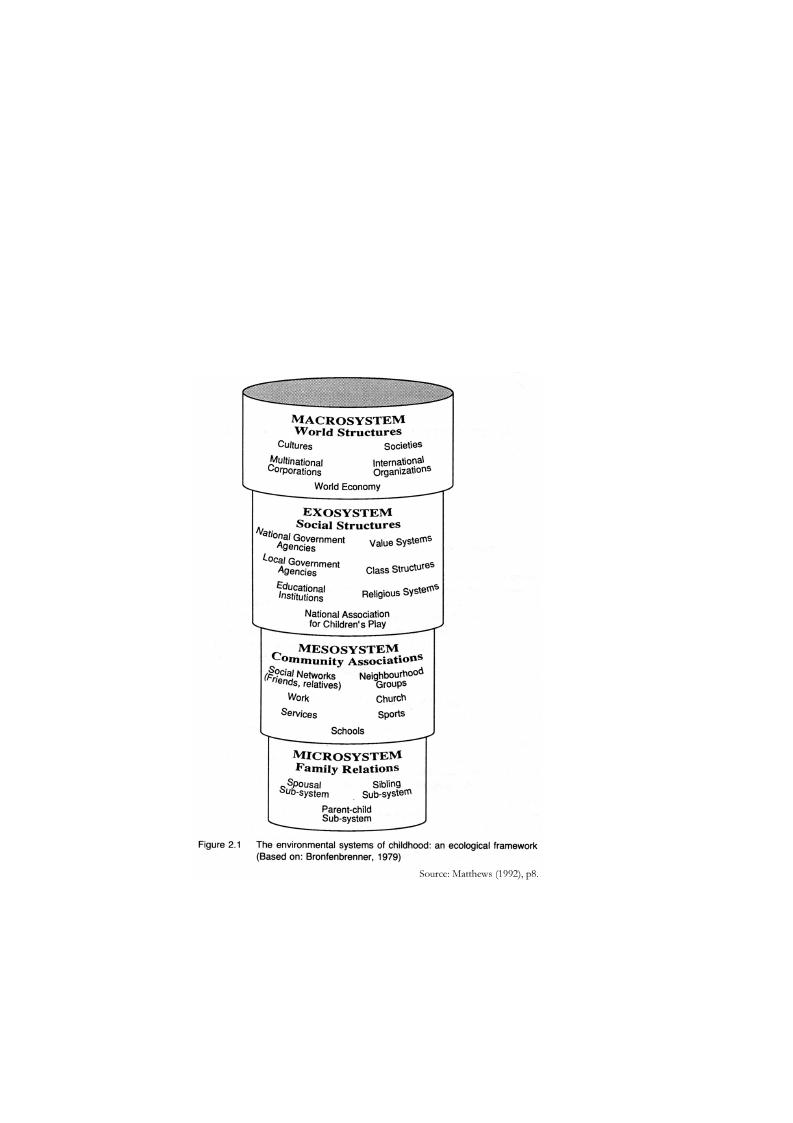
(Bronfenbrenner 1979). Undoubtedly each of these systems – and the uniquely human
processes within some of them - plays an influential role in shaping the ideas we hold, but
the contention herein is that given their early and primal nature, attachment relationships are
probably the most significant element.
Notably, therefore, there appear to be differences in the proportions found of each
attachment classification between cultures, and expectations of a ‘good child’ (Harwood,
Miller et al. 1995), appropriate maternal and paternal behaviour (Carlson 2001; Onishi 1997)
and wider personality factors (Berry, Poortinga et al. 2002). Indeed, cultures vary in many
wider psychological dimensions, a field of study known as psychological anthropology
(Bock 1994; Schwartz, White et al. 1992; Shweder 1991). Incidentally, this demonstrates
that attachment requirements are not sufficient wholly to explain childhood learning.
Figure 2.6: Bronfenbrenner’s microsystem-macrosystem model
58

In all cultures, children encounter mediated nature not only directly through cultural
structures (e.g. national parks, zoos, botanic gardens, gardens in suburbia, pet-keeping and
sentimentality, landscaping in parks, work and public places, interpretative displays,
museums, litter, prestigious architecture versus neglected slums) but also indirectly through
cultural practices (e.g. media (e.g. television, magazines, books, imagery in cartoons, natural
history programmes, incidental images of nature in news, drama, etc.), political (e.g.
consumerism) and religious ideology. Clearly, the types and relative amounts of each of
these will differ radically widely for children brought up in modern urban industrial,
agricultural or gatherer-hunter surroundings. But for children, all experience of cultural
meanings is necessarily mediated.
2.5.4.3 Attachment and the non-sentient environment
Investigators have for some decades claimed to detect the salient features of attachment
in relations with animals lower in the phylogenetic hierarchy, with plants, places and even
inanimate objects. This begs the question of whether attachment must be a bidirectional
process: if a tree, house or blanket is not sentient, surely it cannot contribute to attachment
relations? Conversely, if infants and adults exhibit behaviour toward the non-sentient that
uncannily mirrors interpersonal attachment, perhaps it ought to be characterised as such, and
theory must be revised to accommodate this. Are attachments to the non-human always
mediated through the human?
2.5.4.3.1
Attachment and lower animals
There is obvious difficulty in deciding how to categorise ‘non-sentient’ animals, given
that prevailing evidence suggests a continuum of consciousness. Many animals of little
consequence to human mental life may be in a limited sense ‘sentient’ if this is taken to
include intraspecies communication, planning or some understanding of the presence and
knowledge of others - which would include for example birds who learn to pick at milk
bottle lids or detect deception by others, and the well-known mimicry of crows and parrots,
but could also by extension encompass termite behaviour.
Given this, it might be helpful to coin a new term, ‘anthroposalience’, to capture the
degree to which animals (and other phenomena) are meaningful to us. Perhaps one indication
is a disproportionate literature on the subject – there are fewer published studies on attitudes
to invertebrates (Ingold 1986; Kellert and Wilson 1993) and their awareness (Sherwin 2001)
than on vertebrates.
59

Pet keeping in the west is heavily biased toward dogs and cats. Keeping smaller
mammals, birds, fish and reptiles is not uncommon, although owners show progressively
lower attachment scores (Zasloff 1996). This may be related to differences in the extent to
which animals ‘mirror’ human purposes, interests and feeling. Nevertheless, there is clearly
some ongoing fascination to interacting with wild creatures that draws us back: feeding birds
is popular and a readily sustained habit among the young (Beck, Melson et al. 2001), and
children form close emotional bonds even with snakes (Anonymous 2003).
2.5.4.3.2 Attachment and plants
Beyond primary physiological reactions to colour (red agitates; green calms) and the
alleged biophilic response of attraction to plants as an indicator of food and water, can we
become ‘attached’ to plants? The notion may startle many academic psychologists, but it is
not surprising to many gardeners, farmers, botanists, foresters and forest-dwellers, pagans
and assorted others, some of whom might even say that ‘not only do I care for the plants, but
they care for me.’
The pre-eminent student of human-plant interaction is Diane Relf of the US People-Plant
Council, who has compiled a database of the very substantial literature. Plants intertwine
with the roots of culture (Balick and Cox 1996) and our evolution, and have influenced
language, art, and literature. Cultivating plants shaped civilization, and the search for plants
guided early exploration. Beyond material outputs, vegetation brings numerous
psychological, sociological, and physiological benefits to individuals including children (Rae
and Stuber 1976), office workers and the elderly. Horticultural therapy is used in hospitals,
geriatric institutions, physical rehabilitation centers, drug rehabilitation programs, and
correctional institutions (Lewis 1996). Horticulture brings communities together, increases
pride and improves depressed neighbourhoods (Relf 1992a, b). Both children (Francis 1995)
and adults (Francis and Hester 1994) find meaning in gardens, and they are described by
gardeners themselves variously as paradisiacal, providers, teachers and healers (Olwell
1990). There is a risk of misattributing human reactions to vegetation itself when in fact they
are to its being a proxy for climate, geology (i.e. soil), topography (e.g. aspect) and even
human action and interaction, but this point seems uninvestigated.
However the special case that, by virtue of their size, longevity and prominence in the
literature, trees seem to occupy in our consciousness may throw some light. Householders
value them highly (Schroeder and Ruffolo 1996), many view them as sacred or spiritual
(Dwyer, Schroeder et al. 1991; Foucault and De Foucault 1993; Van Beek and Banga 1992),
see them as models for health (Hoffman 1998) or worship them (Doornewaard 1992). They
60

are bound up with lore and legend in many cultures (Aburrow 1993). People will risk their
lives (Weber 1989), devote their lives to planting (Giono 1995) or hold ‘conversations with’
(Kaza 1993) trees. Visiting arboreta brings pleasures like aesthetic beauty, tranquility,
pleasant moods, escape from the daily routine and urban congestion, and contact with natural
processes (Schroeder 1987). Accessible woods have potent psychological value as
destressors and are sought after as sites for leisure and exercise (Bussey 1995; Kassioumis
1981). City authorities realise they provide aesthetic, psychological, climatological and
pollution benefits (Jim 1987) and foresters have been told that to do their jobs properly they
must understand their non-rational value (Mitchell, Force et al. 1993; Vining and Schroeder
1987). That replanting forests is desirable since it will bring both social as well as
environmental benefits is a message the public hears and accepts (Hill 1998b). Some hate
them (Frost 2002), but plastic substitutes cannot inspire the same reactions (Iltis 1973).
Humans may have a propensity for metaphor or ‘blended meanings’, and are therefore
capable of lending ‘personality’ traits to inanimate objects, but this last finding does suggest
that for plants at least, their real qualities matter.
Among the most telling evidence is that those who grow up in rural areas as adults prefer
natural forests, whereas urban dwellers prefer developed parks (Schroeder 1983) which
suggests at very least a developmental habituation effect. But whilst there is much research
on emotional reactions to plants and trees, there appears to be little or none on the specific
issue of attachment relations, except that which uses the term in a colloquial, metaphoric
sense (Barnes 1999; Bernhardt 1993), leaving open the possibility of further investigation.
2.5.4.3.3
Attachment and inanimate objects
Inanimate objects can be the focus of ‘attachments’ too, and not just for the young.
Blankets can act as reassuring ‘transitional objects’ for infants, who play more readily in
their presence (Passman and Weisberg 1975) and may be attempting to make up for
insufficient bodily contact (Cook 1978). It may be that such ‘attachments’ are in fact more
like ‘addictions.’ But the attachments that the senile can develop to inanimate objects is
comparable (Leger, Garoux et al. 1986), and in adulthood the phenomenon of owning items
of ‘sentimental value’ is universal – or is it? Some indigenous peoples own very little and are
said not to vest special store (e.g. personal security?) in personally owned inanimate objects
(although this author has not encountered evidence of any culture where collective objects
do not carry some meaning), but they tend to be in situations where they are (presumably)
relatively settled and their practical needs are fulfilled by their surroundings.
61

Animal toys seem to be a special case in that they are inanimate ‘pretending’ to be
animate. Infants establish favourite animal toys as early as 3 months (Busch 1977) to which
they turn at times of stress seemingly to regulate their emotions (Steier and Lehman 2000) in
a striking echo of the way they use their mothers (although mothers are preferred from birth).
Infants from one year old know the difference between real and toy animals, and prefer dogs
to cats. Boys are more attached at that age; girls overtake them by age 2 (Kidd and Kidd
1987). Children can of course have what has been termed ‘sensitive companionship’ with
dolls and imaginary friends, but no mother will be unaware that they are less than happy
with substitutes for their favoured choice (Gunnar and Stone 1984). Their ongoing attraction
even into late adolescence may be testimony to the fact that toys partially satisfy attachment
needs (Humphrey 1987).
2.5.4.3.4 Attachment and the built environment
Whilst the built environment cannot by definition have had exact evolutionary impact on
our preferences, the homes, suburbs, work and social settings we create nevertheless both
externalise ideas and predilections we hold, and have a curiously self-referential impact on
our psyche. People living in run-down slums may feel depressed about their surroundings:
grand civic buildings may engender public pride. The pre-eminent architect of the twentieth
century, Frank Lloyd Wright, strongly believed that the ‘atmosphere’ created by the place in
and the things with which a person lived shaped their character – whether they are conscious
of it or not (McCarter in Palmer 2001, 155).
Whilst people differ in their desire to control the natural environment (Jorgenson 1978), it
seems instinctive to construct shelter from locally available materials, leading to a plethora
of vernaculars (Kahn and Easton 2000; Oliver 1997; Rudofsky 1981). Our personalities are
reflected in our houses, their décor (Cooper Marcus 1995; Gosling, Ko et al. 2002) and our
gardens (Bhatti 1999; Bhatti and Church 2000; 2001). Fashions in housing architecture
follow the zeitgeist – from Le Corbusier’s people-denying (Brockman 2002) phallic,
machine-like skyscrapers in a milieu of futurism, through post-war one-size-fits-all
utilitarian boxes to the post-industrial critique (dating back to at least a century to Geddes)
(MacDonald 1992; Meller 1994) of urban centres as having failed human scale needs and
declining in quality of life (Baldassare and Wilson 1995). If we do not yet know whether the
‘concrete jungle’ is deleterious to children’s mental health, we do know that boring
enclosures disturb the behaviour and damage the brains of captive animals (Miller 2002), a
finding which incidentally may render much animal research inaccurate if not useless.
62

Becoming ‘used to’ a place is probably the primary case of categorical learning in
animals, sufficient integrated knowledge of a place facilitating efficient life there. But it is
also evident that the need for security is place-based. People ‘become attached’ to their home
(Earhart 1992; Earhart and Weber 1996; Giuliani 1991; O'Bryant and Murray 1986), street
(Fuhrer and Kaiser 1992), neighbourhood (Bonaiuto, Aiello et al. 1999; Hyde 1998; Ringel
and Finkelstein 1991; Taylor 1996; Taylor, Gottfredson et al. 1984), work (Dubin 1995),
workplace (Finch and Inalhan 2002), town (McAndrew 1998) and holiday home (Kaltenborn
1997b). Children ‘become attached’ to their school classroom (Turkel 1997). Divorce
precipitates ‘clinging’ reactions to home in children (Stirtzinger and Cholvat 1991), and
premature initiation of out-of-home daycare in infants disrupts attachment behaviour
(Vaughn, Deane et al. 1985). Insecure parental attachment predicts greater lifetime
homelessness (Franskoviak 1999), which could be a direct effect of poor place attachment or
an indirect one mediated by relationship conflict.
Most place attachment studies have viewed places as exclusively social rather than
physical. Neighbourhood attachment seems weaker than that to home or city, social
attachment predominates over physical, and place attachment varies with age (Hidalgo and
Hernandez 2001). Place attachment is predictable from home ownership and the
extensiveness of social networks, and is significantly related to neighborhood satisfaction
(Ringel and Finkelstein 1991). Those living in culs-de-sac are more strongly place attached
than those on through streets (Brown and Werner 1985). We also develop multiple place
attachments to places of recreation, learning and relaxation. Attachments to home are not
necessarily the strongest of these and may even be painful. Adults feel a need for places
where they can find and explore their personal and socio-political identity (Manzo 1995).
But living in a place does not automatically lead to attachment to it (Rubinstein and
Parmelee 1992). Rigorous research into attachment to place and home is at long last being
undertaken (McBain 2000). Interestingly, the challenge in producing believable virtual
worlds is now seen to extend beyond visual accuracy: what convinces us we are in a
relationship are the emotional dynamics, or the ‘metrics of human relatedness’. Attachment
theory is therefore being used to assess a ‘Virtual Mom,’ with clinical psychiatric testing to
follow (Alessi and Huang 1998).
Finally, proponents of ‘psychogeography’ - a marriage of geography and depth
psychology - maintain that conscious experience of the external world is rooted in
unconscious fantasies and defenses such that geographic and manmade features come to
embody male and female anatomy, incestuous desires, inner splits, separation conflicts, and
family relations. It claims to be open to academic enquiry, encompassing historical and
cultural geography, psychohistory, cultural anthropology, environmental and political
63

psychology, migration studies, cartography, international relations and psychoanalysis (Stein
1987; Stein and Niederland 1989). However a much older use of the term by the
revolutionary anarcho-Marxist art movement the Situationist International defined
psychogeography as: ‘The study of the precise effects of geographical setting, consciously
managed or not, acting directly on the mood and behaviour of the individual.’ They intended
a critique of what they saw as urban capitalism’s reduction of life to mere production and
consumption, and the resulting alienation (van Kranenburg 2002). A more recent
formulation suggests that: ‘Psycho-geography is the hidden landscape of atmospheres,
histories, actions and characters which charge environments. The lost social ley-lines which
make up the unconscious cultural contours of places.’ Psychogeographic research is pursued
through the dérive, an aimless drifting through the city while recording the emotions
provoked by each place; and mental mapping, producing mood-based maps (Nottingham
Psychogeographical Unit 2002). The aim of such methods is to alert the participants to
invisible psychic compartmentalisations and our reactions to them (Debord 1955; van
Kranenburg 2002). Environmental psychologists might legitimately claim that this is what
they do too.
2.5.4.3.5 Attachment and place
Outside interpersonal attachment, by far the greatest volume of ‘attachment’ literature is
on place, though much of it blurs the distinction between built and natural environments.
Attachment to place – often in the literal sense of preferring to stay or return there - is
common in the animal kingdom, for instance among fish (McNulty 1997), birds (Nolan and
Ketterson 1991), sheep (BBC Radio Cumbria 2002) and deer (Fischer 2001). Prehistoric
(Fullagar and Head 1994) and therefore potentially modern humans probably have it too.
The concept of ‘place attachment’ is common currency in certain geographic circles, having
been somewhat loosely borrowed from interpersonal attachment (Altman and Low 1992;
Proshansky, Fabian et al. 1983). Increasingly heard are the related terms of having a ‘sense’
(Bott 2000) or ‘feeling’ (Hiss 1990) of place. Is has been said that attachment to landscape
can be seen as a reflection of its evolutionarily determined status as a basic unit of human
activity, or as a cultural artifact, or a source of abstract symbols (Riley 1992).
Psychological assessment of the emotional reaction of visitors to natural areas was
envisaged decades ago (Jacob 1973) and has become a mainstay of environmental
psychology. However, with partial roots in behaviourism, and others in geography and
architecture, this field is unfortunately characterised by the absence of the non-human living
as an intersubjective experience (Bell, Greene et al. 1996; Bonnes and Secchiaroli 1995).
64

Indeed in it’s striving for ‘scientific’ rigour it may not merely have failed to acknowledge
non-human subjectivity, it may have (perhaps unintentionally) denigrated it since:
‘…it is not merely that experimental (and by implication environmental)
psychology has failed to foster a realistic awareness of our place in the natural
world, but rather that it has actively contributed to the construction and
legitimation of a form of personhood that is inherently hostile to nature.’ (Kidner
2001, 51).
Nevertheless, we are now able reliably to measure ‘sense of place’ (Bott 2000; Williams
and Vaske 2001). So too ‘place attachment’, which has an internal structure or
dimensionality that resembles levels or hierarchies in attitudes (Kaltenborn 1997a). The
latter is mentioned in four literatures: psychoanalytic (object relations) theory; environmental
autobiography; behaviour mapping, and; favorite place analyses (Chawla 1992). Place
attachment is said to be made up of: the interactional past, or memories of interactions
associated with a site, and; interactional potential, or future experiences perceived as
possible (Milligan 1998). Another characterisation suggests that it is distinct from
territoriality and has two dimensions – ‘rootedness’ and ‘involvement/acquaintanceship’.
People differ in the intensity of their place attachment, but some places are more ‘attachable’
than others (Taylor, Gottfredson et al. 1985).
Ryan differentiated place-specific and conceptual attachment to urban natural areas.
Neighbours and recreational users tended to be place-attached, and favoured management for
aesthetics; conservationist volunteers, staff, and the particularly knowledgeable were
conceptually attached and favoured management for native species. 'Wilder' areas were more
appreciated by those engaged in restoration (Ryan 1997).
Those who are more highly place attached move around less for leisure (Fuhrer, Kaiser et
al. 1993), whereas modern mobility is said to result in the ‘kinetic personality’: a rootless,
dislocated, interpersonally promiscuous type increasingly immersed in a virtualized culture,
who sees time as fragmentary, and process as more important than product. Imaginary living
compensates for real location attachment, notoriety replaces expertise, and intellectualism is
mistrusted. Youth orientation, expediency, and craftiness are emphasized (Rubin 1990). On
the other hand, those who feel ‘embedded’ in their workplace or community may as a result
behave differently: analogously, ‘ecological embeddedness’ implies personal identification
with the land, and attitudes of reciprocity, and caretaking (Whiteman and Cooper 2000).
65

Many claim that direct experience of nature and ‘special places’ shapes childhood (Nixon
1997). Nabhan and Trimble (1994) argue, albeit in poetic prose, that children ‘need’ wild
places; they are conspicuously prominent in adult recollections of childhood (Chawla 1994).
Certainly, children living in greener environments have greater attentional capacity and can
delay gratification and inhibit impulses better than those who live surrounded by concrete
(Kuo 2001; Taylor, Kuo et al. 2002). Rural children are also more strongly place-attached
than urban children (Nanistova and Mesarosova 2000).
In a developmental perspective, children’s opportunities for spatial learning may to adults
seem initially limited and confined to physically controlling and orienting the self but, with
mobility and inquisitiveness, they soon mushroom. Their exploratory, or ‘home’, range
develops progressively with experience, as per Matthews’ diagrams (see Figure 2.7 and
Figure 2.8). Children aged 4 to 5 have a home range of up to 140 feet from home, extensions
of this range occurring first along paths to playgrounds. Children aged 6 to 9 range ten times
further, and travel 5 to 8 times as much; for 10 to 12 year olds the number of destinations
greatly increases (Coates and Bussard 1974). Over time they become actively aware of a
larger area and more distant places, the greatest increase due to self-initiated mobility
between the ages of 8 and 9 (Matthews 1992).
The more children know about a place the more they are aware of it (Matthews 1992,
122) and the greater their place attachment (Taylor, Gottfredson et al. 1984). Boys on
average acquire a larger ‘home range’ of confident wandering, and do so earlier than girls.
Regardless of other factors, children who roam furthest are most skilled at environmental
recall and representation (Matthews 1992, 168). Children themselves prefer to play in green
space or near home (Moore 1986), and middle school-age children are the heaviest users of
the outdoor landscape (Chawla 1992). Children’s discovery of place is a ‘dialectic with the
making of self’ (Matthews 1992) which may to some extent hinge on exploratory behaviour
(Keller 1998).
Perhaps adults also have an inherent need to explore. While place attachment depends on
experience of a particular location and is linked to lower socioeconomic status, attachment to
‘wilderness’ is more generalised and linked to lifestyle (Williams, Patterson et al. 1992).
However with increasing experience of a place, adult wilderness users wander progressively
further from civilisation (McFarlane, Boxall et al. 1998). Those taking trips into wilderness
areas often report feelings of spiritual inspiration (Fredrickson and Anderson 1999). Solitary
‘vision quest’-type activities may increase feelings of self-worth (Angell 1994), including in
abused women who attribute the effects to ‘a renewed sense of connectedness with the
Earth’ (Powch 1994).
66
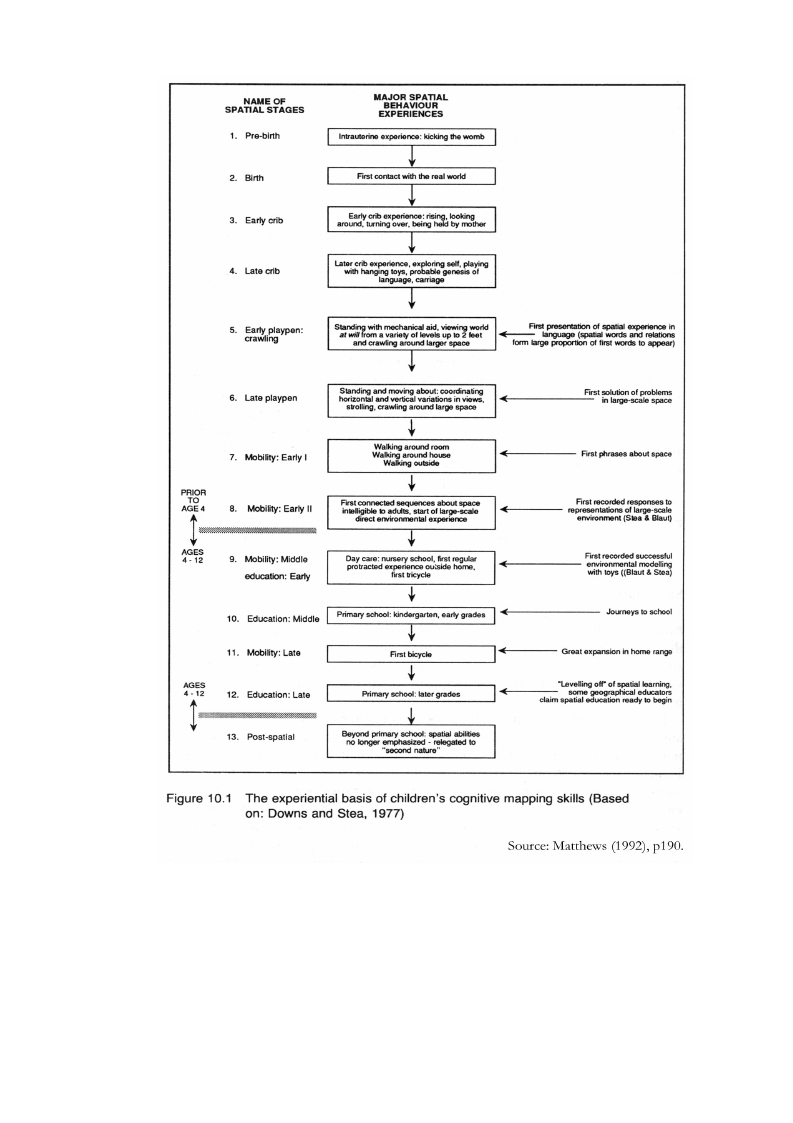
Figure 2.7: Matthews' experiential basis of mapping
67
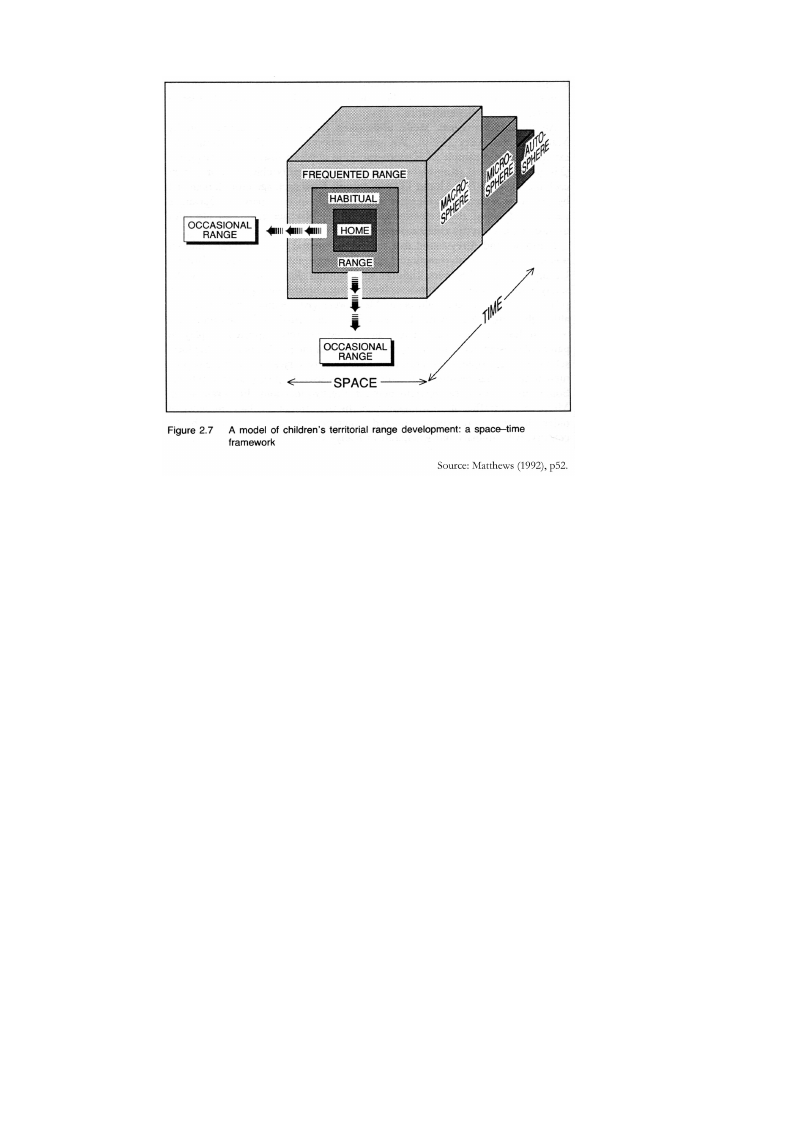
Figure 2.8: Matthews’ model of children’s range development
Places can be meaningful to us mythologically and psychodynamically (Lestrange 1998)
– imaginal and sometimes real ‘journeying’ is central to shamanistic therapies. People
employ metaphors of their place as metaphors of their lives, including images of home and
journey, and attachment to and detachment from place (Lestrange 1998). Landscapes are
said to ‘communicate’ meanings (Devereux 1996; O’Donohue 2000; Tuan 1974). Aimless
exploration in natural settings is psychologically beneficial, being associated with creativity
(Claxton 1997), stress reduction (Ulrich 1993) and self-esteem (White and Heerwagen
1998). Solitude from other humans may be needed to arrive at accurate self-knowledge: lack
of it may contribute to dependencies and disorders like sleeplessness, depression, addiction
and abuse. Time spent alone and attachment are complementary, not mutually exclusive
(Buchholz 1997). Interestingly, some psychotherapists are asking clients to see their bodies
as a landscape (Mowthorpe and Dunn 1997) to aid their ‘inner journeys’.
Psychoanalysis speaks of the need for psychic ‘separation’ of the child from the primary
caregiver; but it may be that a necessary condition of successful separation is having
previously successfully become attached to place: this has been shown in young dogs (Fox
1975). Stimulus-poor primates remain more attached to their mothers (‘pathological hyper-
attachment’), which led Bobbitt (1968, in Fox 1975) to propose that detachment from the
68

mother is a progressive process linked to attachment to the environment. Ironically, given
the suggestion that poorly attached children may become over-attached to pets, for instance,
it may be that secure interpersonal attachment is a necessary prerequisite of normal
attachment to place: agoraphobia and anxious attachment are related (Ruiter 1992; Strodl
and Noller 1999).
People who are displaced experience nostalgia, disorientation, and alienation which can
undermine their mental health (Fullilove 1996). The strength of these effects is determined
by, among other things, the strength of prior attachment (Brown and Perkins 1992;
McAndrew 1998). Children whose parents move home often are more likely to become
anxious or depressed (Ballenger 2000). Children whose parents divorce and yet stay in the
same place tend to mourn, deny the reality of the divorce and intensify their need to control
the environment. Those who move, however, spend time trying to adjust to the new place
and establish new boundaries of behaviour (Stirtzinger and Cholvat 1991). It has been
suggested that residential moves may be understood better as a process of separation and
reunion with a type of settlement than a permanent breaking of bonds (Feldman 1996).
It is clear therefore that places and landscapes have significant psychological impacts on
us. There was even speculation half a century ago that mountains have had an influence on
the development of human intelligence (Young 1957). Perhaps this could be postulated for
many aspects of our surroundings. It is not just that:
‘We need natural landscapes and seascapes as psychological resources so that
we can put ourselves at ease by returning home again to the environment that
made us the natural organisms that we are.’ (Partridge 1984)
but that the mechanism for that ‘returning’ is now coming into focus: spontaneous, and
preferably early, exploration.
2.5.4.3.6
Climate, community, ‘The Planet’ and ‘God’
If one has by now accepted the argument that at least some of the important defining
elements of attachment relationships are present in interactions with pets, plants and places,
it is not a great stretch to understand how the argument for psychological meaningfulness
may also be extended to other dynamic and inescapable features of the outdoors (Hill
1998a). Given the progression toward the ever-grander scale and less animate, the logical
extension is now to ask if attachment might exist to the largest-scale and most intangible
69

phenomena that touch our lives, the climate, ‘The Planet’ (capitalised to echo the common
environmentalist mantra to ‘Save The Planet’), ‘community’ and ‘God’.
The day-to-day weather of one’s place, the temperature and its variability, the
precipitation, the winds, the cycles of light and darkness, the seasons, all might conceivably
be attachment-salient phenomena. Perhaps only in the effectively weatherless indoors (where
in western industrial culture we now spend the vast majority of our time) might we even
contemplate otherwise. For example ‘cabin fever’ or Seasonal Affective Disorder (SAD),
more common at extremes of latitude, is discussed seriously, but there may for instance be
some grain of truth to the colloquial impression that societies nearer the equator tend to be
more easy-going because of the predictability of light and warmth; that (relatively rainy, at
least on oceanic seaboards) western coasts tend to harbour more unselfconscious cultures in
contrast to more proper east coast cities; or that peoples who ‘enjoy’ relentless cold winds
have an air of teeth gritted against the gales about them… It is not difficult to imagine how
portents of good weather or seasonal turning like a ‘red sky at night’, the coming of the rains
in a dry place, or the first cuckoo of spring might change people’s mood. Certainly the moon
has effects (Dobson 2000). On another level, though ‘The Planet’ is a fairly recent idea in
human consciousness, and cannot therefore have had evolutionary psychological
consequences, environmentalists repeatedly claim it is desirable to feel ‘love’ for it
(Caldicott 1992). Nevertheless the initial impact at least of the first image of the earth from
space is undeniable. Unfortunately there is no research known to this author that addresses
these phenomena in an attachment framework: these are therefore another opening for
further research.
However the idea of community, or at least of the ‘tribe’, is primal: the oddity is that
some humans seem to see it as optional. Primates are inherently social, vitally concerned
with each other’s minds (Mithen 1996). Belonging to a troop provides protection, a
repository for ‘culture’ and opportunity for maturation of interpersonal relationships.
‘Grooming’ maintains hierarchy and calm; as grooming time rises among primates, so does
cranial capacity. But our brain size is such that we would spend an unmanageable proportion
of our time grooming; since we do not, the conclusion is that language evolved as ‘virtual
grooming’, to fill the gap by efficiently extending our knowledge of others without direct
contact. From correlations with primate troop size and numerous other indices including
both archaeological and modern data, human group size is reliably computed to be about 150
(Dunbar 1996) – not the size of settlements we live in, but the size of community we can
personally know and (mentally) inhabit.
Loss of community impacts directly on individual health (Mackenzie 1994) and modern
industrial society with its individualism and hypermobility mitigates against it more than
70

most, contributing to a widespread malaise including depression and unfilled attachment
needs (James 1998). Although loneliness is more than merely being alone (i.e. is a subjective
experience) (Rook 1984), social bonding is a proven buffer against stresses (Fleming and
Baum 1986; Rook 1987), releasing endogenous opioids and causing relaxation (Nelson and
Panksepp 1998). Individuals who experience insufficient or inadequate social support have
higher levels of stress hormones, reduced resistance to disease, susceptibility to heart attacks,
and poorer mental state (e.g. optimism).
An individual’s attitudes to and degree of participation in their community predict their
psychological attachment to it (Zhao 1996). Interestingly, security of attachment uniquely
predicts perceived social support: and children who feel they have social support are more
likely to see ambiguous actions as prosocial rather than aggressive (McLeister and Barnett
1999). Although concordant for most people, sense of community and attachment to place
are different. Those most likely to experience a sense of community are more likely to be
female, more socially linked and perceiving of less disorder, whereas attachment to place is
felt most strongly by less educated, long-term residents of stable, wealthy neighborhoods.
Since personality factors are far more important than surroundings (which accounts for just
10% of variance in these sentiments), planners seeking to improve neighbourhoods should
pay more attention to the people than the place (Hyde 1998). A particular perspective on
rebuilding community is integral to the Third Way political philosophy of the UK’s Blair
government (Etzioni 1995; James 1998, 139).
‘Attachments’ are also said to form with a variety of other phenomena including social
networks, strata and organisations, localities, nations, linguistic, national and racial groups.
Even intangible concepts such as ideas, ideologies and subcultures can be considered,
perhaps analogous to the security people may feel in pursuing a lifestyle such as nomadism
or shifting cultivation, or historical expansionism (Crosby 1997).
As for God, the theologian Martin Buber believed there are two relational stances we
adopt toward other beings (including specific mention of the non-sentient such as trees): I-it
and I-thou. Experiences of separation flow from the former; the latter is intimate
identification and, he claimed, ‘All real living is meeting.’ (Buber 1958/1933, 25).
Analogously, philosopher John Macmurray saw the function of religion as a constant
reminder of what the ideal ‘other’ would be like, from which flows improved behaviour to
real others (Macmurray 1991). Indeed there is now evidence confirming that religion is used
to make up for the lack of an ideal other (Granqvist and Hagekull 2000) or as a substitute
attachment figure (Kirkpatrick 1998).
71

2.5.4.4 Non-attachment
In Buddhism and Hinduism, the concept of ‘non-attachment’ describes a lack of need for
worldly comforts or a valuation of all things as equal, and is seen as a vanishingly high
aspiration which few reach (Bakker 2001). At first thought this may seem to be a distinct,
purely spiritual, understanding unrelated to Attachment Theory. But non-attachment, it has
been claimed, may lie in the balance between attachment and detachment (Zimberoff and
Hartman 2002). Naïve attempts to practice saintly non-attachment may be damaging if done
out of context (Kornfield 1993). This may be because such descriptions do in fact have
unacknowledged roots in Attachment Theory: ‘non-attachment’ may be a state, not of never
having developed secure attachments but, rather, of having developed and then transcended
them. In other words, genuine (religious) non-attachment may come about as a result of
knowing that the security of people, things and places is always there to return to if needs be.
2.6 Holistic theories: ‘Ever-widening spheres of meaning and
participation’
The so-called ‘Romantic’ model of development (Figure 2.9) has been characterised as a
journey from absolute one-ness or identification with the world through an apogee of
severance from it and back again at maturity to a complete reconciliation (Chawla 1994, 46).
This has obvious commonalities with various humanistic psychologies, which hold the
possibility of self-actualisation as an article of faith (a state that Maslow claimed only about
10% of people ever truly achieved), and with psychoanalytic ideas of separation.
Within this framework we might note that integration with and separation of self from
world necessarily includes bonding with and then separating from others, a notion central to
the ‘object relations’ school (Greenberg and Mitchell 1983; Mahler, Pine et al. 1975;
Winnicott 1976). A similar conception comes from Erikson, who says that ‘the human
personality in principle develops according to steps predetermined in the growing person's
readiness to be driven toward, to be aware of, and to interact with, a widening social radius’
(Erikson 1963, p. 270), a sentiment shared with the related field of attachment theory
(Ainsworth, Blehar et al. 1978; Bowlby 1988; Sperling and Berman 1994).
The ‘ecopsychological manoeuvre’, as one recent author expresses it (Fisher 2002) is
‘simply to assert that this process wishes to continue beyond the human realm, that our
humanity is incomplete until we have established our kinship or social relations with the
72
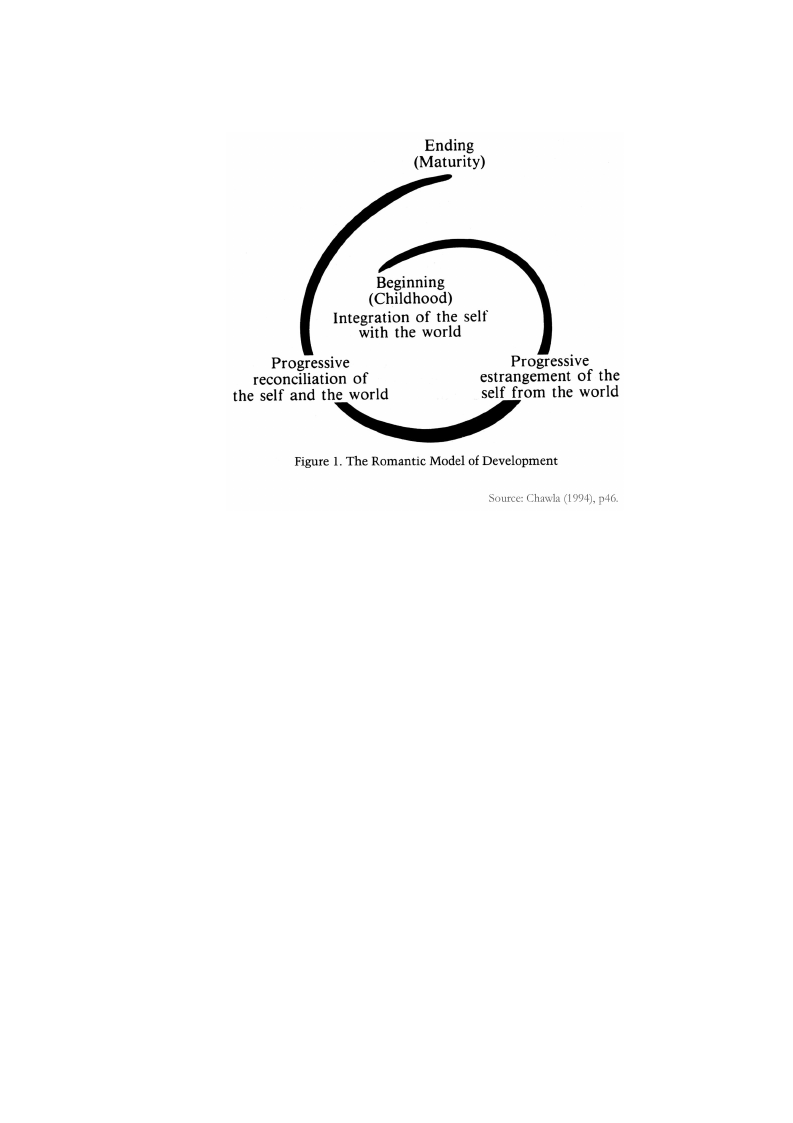
larger natural world and so satisfied our longing to feel at home in or at peace with the
cosmos as a whole.’
Figure 2.9: Romantic model of personal development
Given all of the above perhaps, to pursue the idea, it is a modest leap to contemplate that
attachment theory might usefully be broadened to encompass and describe an aspect of the
human-nature relationship. It may be that attachment to nature is no analogy, but a reality.
Perhaps we seek to maintain proximity to nature although, as in human relationships, in its
absence that closeness can be maintained to some extent with the help of an internal
representation of nature established or developed in early interactions. When deprived of it
we may, as in interhuman attachment, seek intermittently to re-establish proximity and
interaction, with pleasure or joy upon reunion. Long separations from nature may cause
subconscious or even conscious distress: and some maintain that permanent loss of all or part
causes grief (Seed, Macy et al. 1988).
Shepard argues that psychological maturity ‘celebrates a central analogy of self and world
in ever-widening spheres of meaning and participation, not an ever-growing domination over
nature, escape into abstraction, or existentialist funk.’ (Shepard 1982, p14) The claim is that
we are innately motivated simultaneously to differentiate ourselves from others and to
expand our awareness to broader and deeper conceptions of what ‘other’ might be. He
73
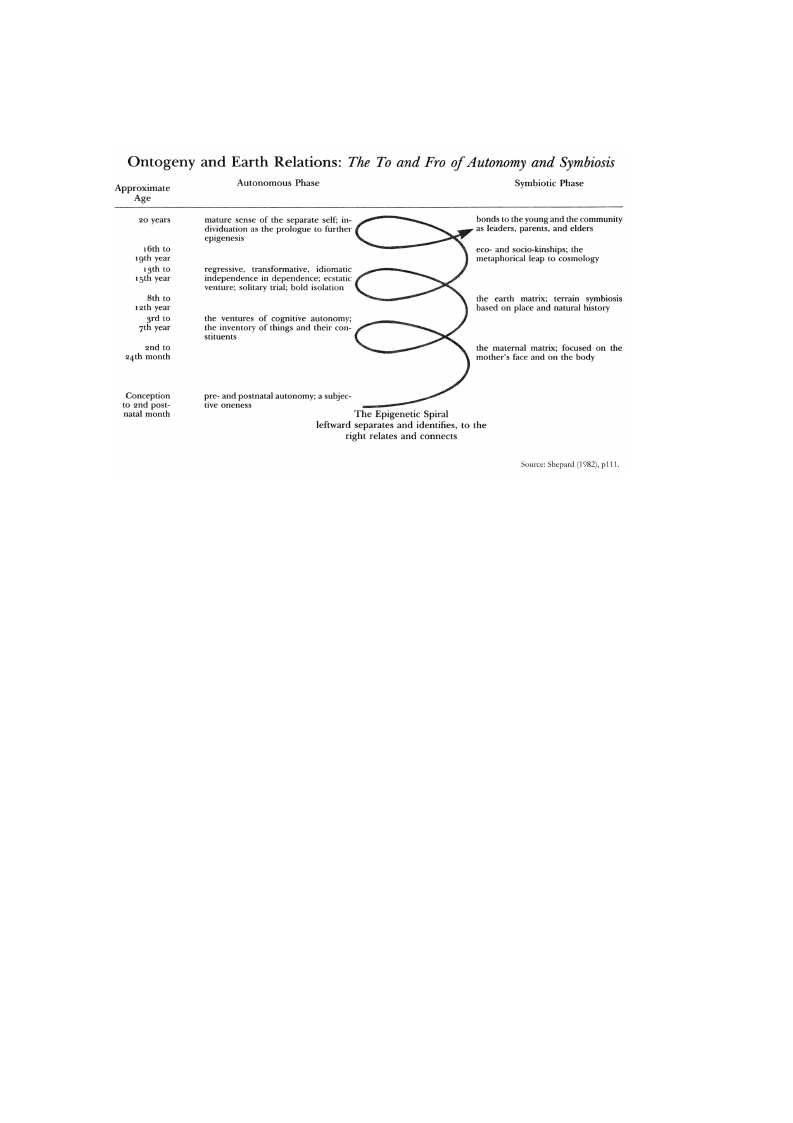
conceives of the process as an oscillation or spiraling between symbiosis with a world that
includes the non-human, and autonomy (see Figure 2.10).
Figure 2.10: Ontogeny and earth relations
Perhaps this sort of ‘dependent co-arising’ conception is what led Naess to state:
‘Traditionally, the 'maturity of the self' has been considered to develop through
three stages: from ego to social self (comprising of ego), and from social self to
metaphysical self (comprising social self). But in this conception of maturity of the
self, Nature is largely left out... Therefore, I tentatively introduce, perhaps for the
very first time, the concept of the 'ecological self'. We may said to be in, and of,
Nature from the very beginning of ourselves.' (in Sessions 1995)
The notion that qualities of the non-human world lastingly affect us may not be at all
new; that the very structure of our personalities (and perhaps flowing from that our cultures)
are deeply intertwined with our experience of nature is perhaps more novel to some. As we
have seen, psychology has only begun to examine this proposition. However the impetus
provided by the environmental movement has in the last generation brought about
noteworthy investigations into what we think about and why we behave in the ways we do
with regard to nature, and to this we now turn.
74

Chapter 3: Literature review: Attitudes and behaviours
toward nature
‘There was a child went forth every day,
And the first object he looked upon,
That object he became…’
Walt Whitman (1976/1855)
3.1 Experience, attitudes and behaviour in general
Debates about the ‘self’ revolve, as has been seen, to a significant extent around how
experience of the environment in its broadest sense (i.e. our human, built and natural
surroundings) impacts on ‘who we are’. But ‘who we are’ may itself be an impossible notion
ever fully to capture, since it inevitably and perhaps definingly includes some knowledge of
the always-elusive interior life. Nevertheless, some aspects of the self cannot escape more
exact characterization. It is when the individual acts in the world – moves, behaves, speaks,
reacts – that the self becomes translated into deeds. When seemingly consistent patterns
begin to emerge in these deeds, we start to believe we have a sense of who someone is.
Inevitably, the ways in which these patterns of external actions (which we call
behaviours) and the internal cognitive and emotional patterns from they are reasoned to flow
(which we call attitudes) are related has stimulated considerable theorizing and
experimentation. This chapter therefore briefly examines where these speculations have
brought us to, and how in particular the self acquires and expresses its attitudes and
behaviours in relation to nature.
3.1.1 What are attitudes and how do they arise?
Attitudes are beliefs and feelings about an object that predispose one to behave in a
consistent manner toward the object (Fishbein and Ajzen 1975; Weigel 1983). Fishbein and
Ajzen (1975, 6) define attitude as ‘a learned predisposition to respond in a consistently
75

favorable (sic) or unfavorable manner with respect to a given object’. They break their
definition into three components: attitude is learned; it predisposes action; and such action or
behaviour is generally consistent. Attitude is evaluative in nature - toward, for instance,
pollution or wildlife - and such evaluations are based on beliefs. Hence environmental
attitude can be defined as a learned predisposition to respond consistently favourably or
unfavourably with respect to the environment. Numerous scales have been constructed to
assess this attitude and its components – for example attitudes to wildlife, pollution or
ecosystems. And there are problems with the claim that all aspects of attitudes are outcomes
of learning and never innate (see discussion on biophilia in previous chapter). But first we
will examine how attitudes are believed to come about.
Thurstone’s early definition held that attitudes are simply positive or negative affect
towards an object, a conception others echo:
‘Attitudes are likes and dislikes. They are our affinities for and our aversions to
situations, objects, persons, groups, or any other identifiable aspects of our
environment, including abstract ideas and social policies’ (Bem 1970, 14)
More recently authors have suggested there are two components to attitudes (for example
mental readiness to act, plus guidance of evaluations) and latterly three components (of
cognition, affect and behaviour – a trichotomy which may have its roots in the three
evolutionary layers of the brain: cerebral cortex, limbic system and old brain), which has
been shown to account for greater covariation among measures. In an attempt to standardise
terminology, Breckler and Wiggins used the terms affect and evaluation for, respectively, the
emotional and cognitive dimensions of attitudes, usage that will be employed later in this
work (Hogg and Vaughan 1998).
Bem contends that every attitude ultimately rests on a basic belief in either the credibility
of one’s own sensory experience, or upon the credibility of some external authority (1970).
Thus, the possibility arises of two types of experiential learning: direct, and vicarious (also
termed culturally mediated or social). Behaviourist descriptions of how this learning occurs
speak of classical and instrumental conditioning, and observational learning from wholly
external sources. In either case, first hand experience is supplemented by learning from other
people (the most important being parents) and the media. Social psychologists tend to prefer
the language of cognitive development, which places greater emphasis on the progressive
building of a network of connections between ideas. Attitudes are held for reasons of
foreknowledge (to avoid having to make judgments afresh each time an object is
encountered), utilitarianism (recall of positive or negative outcomes), social identity
76

(expression of one’s core values), and self-esteem (aligning oneself with success and
denigrating things the holder finds threatening) (Bohner 2001).
Attitudes, therefore, can be said to summarise multifactorial dispositions that are assumed
to arise from a combination of direct and social experience.
3.1.2 Do attitudes predict behaviour?
Probably the most powerful initial spur to the study of attitudes was the common-sense
belief that they in some way ‘cause’ behaviour. Investigation has shown however that whilst
there is often a relationship, it is not straightforward. Ajzen and Fishbein (1977) suggested
that in order to find a close relation, both attitude and behaviour must be in respect of the
same action, target, context and time frame. The reliability of predicted relationships
increases with repetition of the behaviour and with ‘conceptual correspondence’, where
subjects are primed to value particular aspects of attitude (Bohner 2001).
A good deal of research has investigated public attitudes and the attitude-behaviour
relationship. Much of it assumes attitudes predispose individuals to behave in a certain way
(Ajzen and Fishbein 1977; Liska 1975; Rokeach and Kliejunas 1972; Sample and Warland
1973). Whether attitudes predict specific behaviours has, however, been controversial.
One of the earliest and most widely cited empirical studies was undertaken before the
Second World War on the subject of racism. LaPiere demonstrated a weak relationship
between attitudes and behaviour, but has since been methodologically and conceptually
critiqued. Many now suggest that contextual factors can have a significant influence on the
relationship (Ajzen and Fishbein 1977; Liska 1975; Sherman and Fazio 1983). It has been
pointed out that the attitudes assessed must relate meaningfully to the behaviour (Weigel and
Newman 1976), that the wording of the questions asked of subjects can be critical (Schuman
and Karlton 1985), and that multiple-item indicators of attitudes are more robust than single-
item indicators (Sample and Warland 1973).
If the attitudes being assessed are abstract, they may be less easily measured and
predictions derived from them may therefore be less accurate (Fazio and Williams, 1986). If
the behaviours being assessed are not commonplace, there may be less of a predictable
relationship with attitudes (Liska 1974). According to the Specificity Hypothesis (Fishbein
and Ajzen 1975), general attitudes can only explain general behaviours. Greater consistency
and predictive power can be obtained when measuring specific behaviours and well-defined
attitude indicators. Put another way, the predictive power of attitudes on behaviour cannot be
separated from the method used to assess them.
77
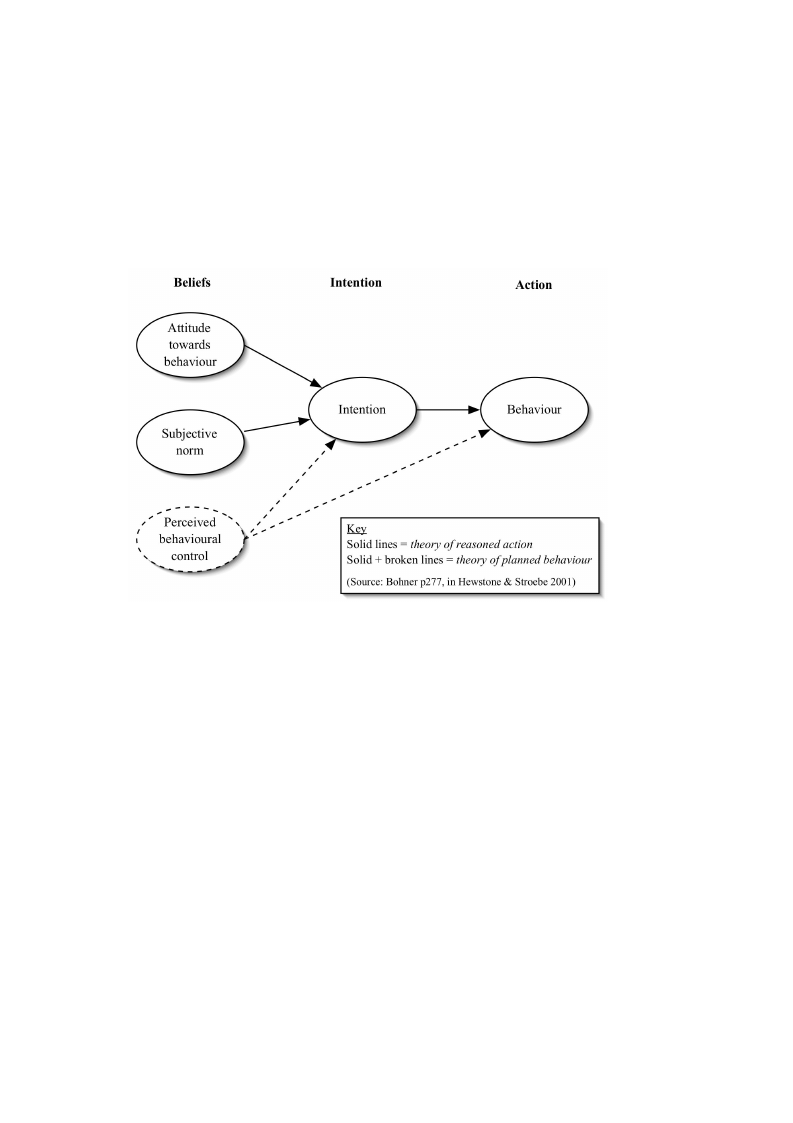
For example, the substantial attitude-behaviour research on recycling in the main suggests
that attitudes are not good predictors of this environmentally sound behaviour (Buttel, 1987;
De Young, 1986). Nor are income or education (De Young and Kaplan, 1985; Vining and
Ebero, 1990). The best predictors turn out to be practical factors such as accessibility and
ease of use (Derksen and Gartrell, 1993; Folz, 1991; Jacobs et al., 1984; Katzev et al., 1993):
people living close to recycling facilities or with regular recycling collections are, not
surprisingly, more diligent recyclers.
Figure 3.1: Theories of reasoned action and planned behaviour
A series of progressively more sophisticated theoretical approaches have attempted to
capture the various factors that seem to be involved, with increasing success. The single
most important attitude-behaviour theory has been that of Fishbein and Ajzen (1975). Their
theory of reasoned action (see Figure 3.1) recognised that attitudes rest on a variety of
predictor variables: firstly, attitude towards the behaviour concerned arises as a consequence
of the subject’s expectancy that a particular act will give rise to a particular outcome,
modulated by the value they attach to this outcome; secondly, the subjective norm arises
from the belief the subject has that a significant other person thinks they should do
something, modulated by their motivation to comply with this person. These two
components come together to form a behavioural intention, which leads to behaviour. This
theory has been successfully applied to predicting numerous behaviours.
78

The model was later extended (Ajzen 1991) to incorporate a further predictor variable,
perceived behavioural control, which was defined as the extent to which a subject believes it
is easy or hard for them to perform the act in question. Thus renamed the theory of planned
behaviour, this modification improved accuracy in complex and challenging situations
where people have differing degrees of control over the outcome, and is the currently most
popular theory.
3.1.3 Can experience predict behaviour, regardless of attitudes?
The conventional, rationalist view is that learning takes place as a consequence of
experience (with is broadly conceived of as the taking in of new information), leading to the
formation of attitudes, which then precipitate behaviour. It might therefore at first seem
perplexing if behaviour could relate to experience in a manner that was not mediated by
concordant attitudes. But this is to forget that behaviour, cognition and attitudes are
themselves experienced, and that learning can therefore occur from each, effectively short-
circuiting this linear model. It is also perhaps to suggest that conventional assumptions about
attitudes, or at least definitions of attitudes, place too much emphasis on the rational
processing of information: not every act is consciously controlled. Behaviours can be
automatic, and some automatic behaviours may not accord with expressed views. Though
not the subject of this thesis, it may be that a redefinition of attitudes to incorporate
subconscious and even bodily learning would begin to answer this criticism.
Patterns of previous behaviour can influence future behaviour, without necessarily being
mediated by attitudes. Two mechanisms are recognised: repetitive past behaviour (or habit)
can become automatic if it occurs in a stable context, directly affecting future behaviour, or;
past behaviour that happens in unstable contexts is less well learned and remains under
conscious control, but can influence future behaviour indirectly via intentions (Bohner 2001;
Prislin and Ouellette 1996).
Further, the attitude-behaviour relationship can itself be reversed and, in certain
situations, behaviour can lead to changed attitudes. The theory of cognitive dissonance
postulates that if there is a difference between the attitudes a person holds and their actions,
discomfort known as cognitive inconsistency is experienced. Cognitive consistency theorists
reason that humans possess a drive to achieve cognitive consistency, and that inconsistency
acts as an irritant or stimulus. People experiencing this discomfort seek to reduce the
inconsistency by changing their attitudes: justifying what they have done in retrospect, under
the logic that ‘if I am doing something for no apparent reason, it must be because I like it’.
79

The perception of who brought about the change is critical. If a person believes they were
compelled to alter their behaviour (e.g. restrictions on smoking), they can come to change
their attitudes in the reverse direction, evaluating the forbidden act more favourably;
however, if they feel they made the choice freely, attitudes tend to change in favour of the
new behaviour, the better to justify it. Bem proposed that people can sometimes infer their
own attitude from external cues: for example, being bribed allows an experimental
participant to believe they only did a particular act for that reason, and not because they
believed it to be right (Bohner 2001).
3.2 Attitudes and behaviours toward nature
3.2.1 Conceptions and models
Attitudes to nature are a special case of attitudes in general. Whilst there may be innate
elements of our attitudes to the non-human – the subject of the biophilia theory – is it clear
that much is learned. Tanner (1980), for example, clearly does not subscribe to a strong
biophilic view: ‘Children must first learn to love the natural world before they can become
profoundly concerned with maintaining its integrity.’ Partridge points up the danger of
generalisations in this area, highlighting the influences of both history and culture on
attitudes to nature.
‘If we do, in fact, have a genetically coded need for nature, then our encounters
with nature should evoke feelings of unity, harmony, and affirmation. That it
sometimes does, and profoundly so, is abundantly clear in the historical records of
religion, art, and literature... (There is, however, a contrary trend) … The early
colonists in North America regarded the wilderness as dreadful, alien, satanic.
Even today, those who live in such remote regions as Tanzania and southern Utah,
are bewildered by the trouble and expense that Europeans and southern
Californians will tolerate just to be in the presence of their ‘useless’ wilderness.’
(Partridge 1984)
These differences over time and between societies are important in accounting for
differing individual and collective behaviours toward nature, since: ‘What we do about
80

ecology depends upon our ideas of the man-nature relationship’ (White Jr. 1967, 1206). The
so-called idealists, such as Schumacher (1974), believe that current ideas and values
substantially determine environmental actions and policy, and hence conclude that ‘the
remedy for our environmental predicament lies in a change of values - in what ideas we hold
as true and valid and worth defending’ (Pepper, Perkins et al. 1984). This wholly rationalist
view has more recently come to be seen as perhaps somewhat naïve if, as Pepper et al
suggest, we tend to make up our minds about such matters, often on an ‘irrational’ basis,
then look for evidence to support these beliefs. Little change in attitude may result from
bombarding people with facts they are predisposed to dismiss. In recent years many have
begun to suggest that an ecologically sustainable society would necessarily be based on
ideologies and values that are long-standing, cross-cultural, in some sense ‘natural’ or
‘primal’, but currently not widely held.
By the early 1970s social scientists began to hone in on environmental attitudes and their
consequences, leading to the creation of the New Environmental Paradigm (NEP) and a
number of other research instruments (Dunlap and Van Liere 1978; Maloney, Ward et al.
1975; Stern, Dietz et al. 1993; Weigel and Weigel 1978). However there is uncertainty about
whether these scales are comparable (Stern and Oskamp 1987) as they may not be tapping
into the same core construct (Van Liere and Dunlap 1981), although they may share
significant variance (Stern, P. C. 1992).
The earliest was the Ecology Scale, developed by Maloney and Ward (1973) to measure
attitudes as well as knowledge, emotions, and behaviour. To no-one’s surprise, respondents
generally scored higher on verbal commitment and affect, and lower on actual commitment
and knowledge. A version for children, the Children's Environmental Attitude and
Knowledge Scale (Leeming, Dwyer et al. 1995), was also produced, with different items but
a similar scale structure (Pelstring 1997).
By contrast, Weigel and Weigel’s (1978) Environmental Concern Scale and the
Awareness of Consequences (AC) scale, produced to help predict environmental behaviour,
included belief and evaluative dimensions. Similar to the NEP in that it sought to examine
general attitudes toward environmental issues, it included such items as ‘the currently active
anti-pollution organizations are really more interested in disrupting society that they are in
fighting pollution’, and ‘the federal government will have to introduce harsh measures to halt
pollution since few people will regulate themselves.’
These three widely used scales for environmental attitudes (NEP, ECS, AC) predict
between 19% and 23% of the variance of (self-reported) environmental behaviours, but with
81

decreasing strength with rising income, lesser education and more right wing politics
(Tarrant and Cordell 1997).
O’Riordan (1977) proposed the basis of what has become the most enduring
classification of environmental attitudes, defining the extremes of a possible one dimensional
spectrum of attitudes as ‘technocentrism’ and ‘ecocentrism’. Technocentrism was said to be
rooted in scientific rationalism, assumed experts knew best and politics merely confused
matters, and held an optimistic view about our ability successfully to manipulate nature to
our own ends. Ecocentrism on the other hand assumed that humans are inextricably situated
within a delicate and ‘seamless web of life’ of which we are an integral - but not essential -
part, bound by the laws of nature, which are outside our control. An ecocentrist would argue
for the preservation of wilderness for its own sake (or ‘intrinsic value’), rather than its
significance to us (or ‘instrumental value’), although its value to us goes beyond sustaining
human life to encompass psychological and even spiritual functions. While the ecological
point of view focuses on the ‘all-ness’ of nature, anthropocentric perspectives particularise,
or focus more on the ‘eachness’ of things. The ecocentrist believes that a view of the whole
increases knowledge of the parts (Partridge 1984).
(The criticism sometimes heard that ecocentrism is inherently nonsensical, since humans
cannot view the environment from other than a human perspective, is founded on a
misreading of what the characterisation is intended to capture, which is not where we stand
but where we direct our empathy. Similarly, the stance that since humankind is part of
nature, all human actions are ‘natural’ is a piece of semantic sophistry, collapsing the
distinction between humans and nature without addressing the case that causes it to be made
(Oelschlaeger 1991, 1992; Passmore 1980). We will accept Oelschlaeger’s definition of
ecocentrism as ‘a human but non-anthropocentric perspective on nature’.)
Contemporaneously, Dunlap and Van Liere’s (1978) New Environmental Paradigm held
that a world-view was emerging that differed dramatically from what was termed the
Dominant Social Paradigm (DSP). The DSP included faith in science, ‘progress’, and a
laissez-faire economy (with obvious echoes of technocentrism). Subscribers to the NEP
believed in limits to growth, a steady-state economy, and preservation of natural resources
(clearly related to ecocentrism). The original 12-item scale sought to assess where subjects
stood on the DSP-NEP scale, according to their level of agreement with belief statements
such as: ‘We are approaching the limit of the number of people the earth can support’; ‘The
balance of nature is very delicate and easily upset’, and; ‘Humans need not adapt to the
natural environment because they can remake it to suit their needs.
82

Later authors (Oelschlaeger 1991, 1992; Thompson and Barton 1994) nuanced
O’Riordan’s two-extremes view, interposing less extreme categories of anthropocentrism
and conservationism. Anthropocentrism is the view that human needs are supreme and the
final arbiter of action, but is seen as less conceited over the power of technology. ‘Nature
matters, has value, has significance, only if there is a species to whom it can have
significance. It follows that values in nature are almost exclusively human values’. (Partridge
1984) Conservationism, or ‘anthropocentric nature-love’, shares an holistic view of nature
with ecocentrists: the whole is greater than the sum of the parts. All elements of an
ecosystem are critical to its healthy functioning, and maintaining this with for example
wilderness will bring benefit to future generations. But nature is valued first in terms of
human utility, including non-material values such as aesthetics and morality.
From the ecocentric point of view, conservationism remains anthropocentric, since
human interests are the ultimate arbiters of value. Ecocentrism goes beyond conservationism
by questioning the idea that humans are superior to nature, with subsequent imposition of
human values on nature.
Most research on environmental values implicitly assumes that underlying attitudes
predispose people to particular actions. Research to test the relationship between
environmental attitudes and ‘responsible environmental actions’ has been sparse (Stern,
Young et al. 1992, 89-91), focuses heavily on home recycling (De Young and Kaplan 1985;
Vining and Ebero 1990) and all too rarely covers environmentally-relevant behaviours like
lifestyle choice (e.g., public transport use, buying recycled products), or environmental
activism.
A more sophisticated, two-dimensional understanding of individual perception of the
environment was suggested by Douglas (1996). People are said to differ along two axes – of
social and interpersonal relations, and of desirable restrictions on behaviour. Within any
given culture, people choose their ‘thought style’ in order to sustain their preferred patterns
of social relations. Those who prefer strong group boundaries and binding behavioural
prescriptions are termed hierarchical; strong boundaries and minimal prescriptions,
egalitarian; minimal boundaries and minimal prescriptions, individualistic, and; minimal
boundaries and binding prescriptions, fatalistic (Douglas 1996).
Thompson et al extended Douglas’ quadripartite attitudinal stance notion with the
suggestion by ecologists that people tend to propose different solutions to ecological
problems based on their own concepts of the ecosystem to produce a four-fold classification
of ‘myths of nature’ (Schwartz and Thompson 1990; Thompson, Ellis et al. 1990). People
characterise nature as benign, ephemeral, perverse/tolerant, or capricious. Since each of
83

these models is founded on personal assumptions that are in general unexamined by the
individual, each appears self-evidently rational and workable in practice to its holder. Each
corresponds with one of Douglas’ thought styles. Keller describes these ‘myths’ as follows:
‘Nature is ephemeral.’ The egalitarian thinker holds that resources are scarce
and uncontrollable, and nature exists in delicate balance. Risk averse, they believe
that reducing their personal consumption will help solve environmental problems.
The preferred policy aims at equity for present and future generations to be
achieved by radical changes in society and one's own behaviour.
‘Nature is tolerant.’ The hierarchical thinker sees nature as a robust but
unstable system whose limits are known only to experts. Resources are scarce, but
controllable. Armed with expert advice, Governments can control the environment
through regulation and, as such, we should make use of what it offers within its
known limits.
‘Nature is benign.’ The individualist conceives nature to be a robust system,
with abundant and controllable resources. A believer in equal opportunity, free
market economics and economic growth, s/he believes that technological solutions
will inevitably arise to overcome environmental problems. This, many would
argue, represents the dominant beliefs of western industrial society.
‘Nature is capricious.’ The fatalist perceives nature to be unmanageable and
unpredictable, and both resources and needs are uncontrollable. Since things
happen by chance, they see little reason to act and are unconcerned about
environmental problems (Keller, R. and Poferl 1998).
It is notable that amid the work on environmental attitudes, ‘environment’ seems to
signify many things to many people. On some occasions it is as broad as ‘the planet’ or
‘ecosystems’, on others it is associated with the political issues that have come to be labeled
‘environmentalist’. Place-based surveys may refer to both local and national issues, ignoring
the fact that proximity and degree of personal involvement are known to have significant
effects on people’s attitudes (e.g. Jorgensen and Stedman 2001; Kellert 1993; Stedman 2002;
Vaske and Kobrin 2001). There is a pervading sense of what has been called ‘thingification’
(Césaire 2000; Lefort 1996) of ‘the environment’ and a comparative avoidance of the
motivational roots of the sometimes-close personal relationships which, for most of us,
constellate the bulk of our contact with particular aspects of the non-human.
84

Most curious of all, however, is the treatment of animals in general, and specifically what
might - to coin a phrase - be termed ‘intimate nature’: gardens, house plants, tame and semi-
wild domestic animals including companion cats and dogs, fish in tanks, garden birds, house
mice, welcome and unwelcome insects. There is research of varying perspective and
authority on each of these, for example attitudes to animals (Hills 1993), hunting (Yun Hwan
and Seong Il 1995), woodlot ownership (Erickson, Ryan et al. 2002) and on the theme of
house plants in offices and homes – sponsored by florists (Horticultural Trades Association
circa 1990), but in years of digging this author has failed to unearth quantitative research
which satisfactorily addresses the whole panoply of relations with non-human nature in an
integrated fashion. This is undoubtedly for lack of a unifying theory. It could also in part be
because there is unclarity between the terms ‘environment’ and ‘nature’ - the usually
unstated assumption presumably being that what is examined is attitudes to non-sentient
nature (arbitrarily dividing animals into two artificially human-defined categories), or that to
which we do not relate personally (but why exclude pets as examples of ‘nature’?).
What proof is there that particular environmental attitudes lead to particular
environmental behaviours? In fact, the correlations are modest (Buttel 1987; Dunlap and
Scarce 1991; Gigliotti 1992; Van Liere and Dunlap 1980). In fact, whether espoused
environmental attitudes are carried through into behaviour rests not on expressed good
intentions but on underlying beliefs. Thompson and Barton (1994) demonstrated that of
those who endorse pro-environmental attitudes, people that hold anthropocentric values are
significantly less likely to practice conserving behaviours, are more apathetic toward
environmental issues and join less environmental organizations than those who hold
ecocentric values. In other words, whatever people say they believe, active
environmentalism can be recognised not from expressed pro-environmental attitudes, but
from ecocentric values.
3.2.2 Demographics and personality
The placing of environmental attitudes in the context of attitudes we hold toward other
objects, and the significance of gender, personality and cultural perspectives (all significant
influences in childhood) was perhaps underemphasised in early work.
We might ask, for example, how much we value nature in relation to other causes
demanding our sympathy. This is of importance not least because expert and lay judgments
of the ecological importance of particular ecosystems differ (Edwards-Jones 1994). One of
the few social science methodologies pursued in this field is not psychological, but
85

economic. Building on a standard ‘price = value’ assumption, environmental economists ask
people how much they would pay to save the last elephant or accept to allow a particular
type of pollution. This ‘contingent valuation’ method can lead to perverse results since,
clearly, the price people allocate is likely to depend on their wealth, their own and their
culture’s attitudes to nature. The ‘rational economic man’ model of behaviour employed is
psychology primitive: values can be arrived at for reasons outside this model (for example
altruism), and economists need to take more account of attitudes (Spash 2000). Fortunately
there have been some more even-handed attempts by psychologists enquiring about attitudes
to nature to assess relative values (Paul 1992).
Sex is a significant arbiter of attitudes. Women show consistently higher levels of
environmental concern while men have greater knowledge of facts (Gifford, Hay & Boros,
1982/83; Arcury, Scollay & Johnson, 1987). Women are stronger supporters of
environmental protection and more willing to act on it (Stern and Dietz 1994). This may be
rooted in differing male and female socialisation experiences: it has been argued that women
are taught to characterize moral dilemmas in terms of interpersonal relationships, which may
therefore be resolved through an ethic of care. Men’s understanding, on the other hand, is
said to be more impersonal and they are more likely to resort to abstract concepts of ‘justice’
(Gilligan 1993).
This difference, it is suggested, leads women to endorse and operate from a more
protective, biocentric position (Mohai 1992; Steger and Witt 1989). Sex differentiation in
environmental concern and therefore behaviour may reflect pre-existing divisions of labour
(South and Spitze 1994). Although higher environmental consciousness is associated with
parental education, particularly among boys, girls exhibit greater environmental
responsibility than boys. Wilderness experience also contributes to greater concern, although
it is less significant than gender and socioeconomic factors (Hampel, Boldero et al. 1996).
Attitudes to animals are significantly related to gender (Mathews and Herzog Jr. 1997).
There are other salient demographic factors: US participation in environmental politics
and environmental organizations is consistently greater among those with more money,
education and prestigious careers (Pierce, Steger et al. 1992; Verba and Nie 1972).
Environmental knowledge and actions differ between rural and urban residents (Arcury and
Christianson 1993) and between subcultures (Bragg 1995, 1996). There are (or at least were
in the US a generation ago) positive correlations between pro-environmental behaviour and
liberalism, socialism and education level, and negative correlations with conservatism and
religiosity (Weigel 1977).
86
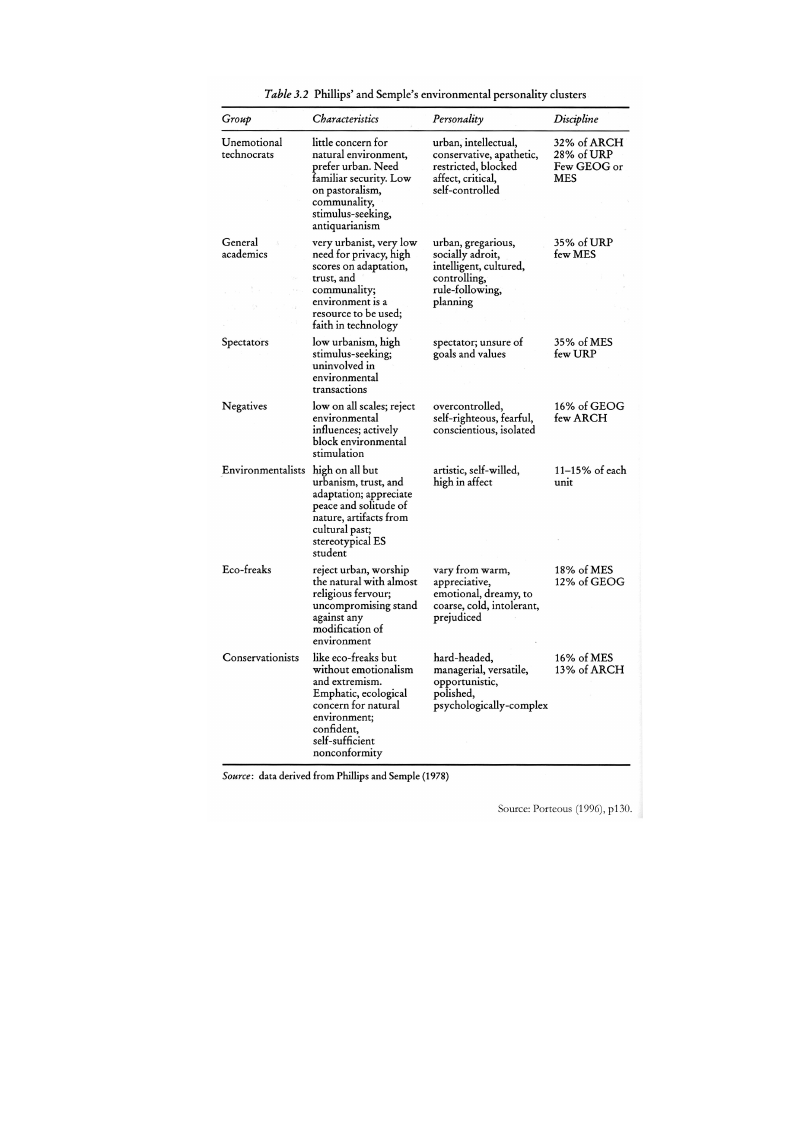
Figure 3.2: Environmental personality clusters
It is now fairly clear that certain early environmental influences have marked effects later
in life. A person’s first hand experience of their environment as a child can influence their
environmental attitudes, preferences for nature and the development of pastoral attitudes.
87

Having been brought up in an urban area is positively related to preferences for built settings
and negatively to preferences for natural environments (Hoyt and Acredolo 1992), and place
of upbringing (presumably a proxy for the amount of contact they may have with animals)
significantly influences attitudes to animals: country children understand ‘herd mentality’
and see animals as commercial products, while city children favour individual animals
(Arkow 2002b). As might be expected, the degree to which children ‘forage’ in natural
settings is related to adult knowledge of biodiversity (Chipeniuk 1995). So what, one must
wonder, does it foretell when children have become more familiar with cartoon creatures
than real ones? (Balmford, Clegg et al. 2002).
A particularly interesting yet surely under-explored area is the way in which individual
personality factors impact on orientation to the environment. It has long been known that
personality effects exist on environmental attitudes (Gray 1985), for example attitudes to
animals are related to sensitivity and imaginativeness (Mathews and Herzog Jr. 1997). Some
personality-behaviour relationships are counter-intuitive, such as that outdoor play is not
related to extraversion in middle childhood (Roberts 1978). There is even expert but
anecdotal evidence of very direct links, such that abhorrence of and attempts to eradicate
insect pests in farmers may be related to early childhood experiences of intrusive (sometimes
sexual) touching (Hill 2003). Attempts have been made (see Figure 3.2) to codify the
attitudes held by particular ‘environmental personality clusters’ into domains (Porteous
1996).
3.2.3 Historical and cultural factors
Since this particular evaluation of attitudes to nature has not been performed in historical
and cultural isolation, but on (and within) a western industrial culture at the turn of the
twenty-first century, it would be remiss by omission not to reflect on the significance of
these factors in shaping such attitudes. There are indeed differences in attitudes to the
environment between cultures (Abram 1996; Arbuthnot and Lingg 1975; Milton 1993;
Palmer, Suggate et al. 1998a, 1998b). Patterns of attitudes, knowledge, and behaviour toward
wildlife and its conservation relate to the biogeographical, cultural, and historical
characteristics of each country (Kellert 1993). This is said to be because:
‘… the overall cultural context, which serves as a blueprint for individual
values, beliefs and motivations, determines both the degree to which concern will
be transformed into action and the directions their influence will take.’ (Beckmann,
Christensen et al. Undated)
88

It is equally clear that attitudes to nature in particular cultures can change markedly over
historical time (Biese 1905; Brown 1999; Devereux 1996; Schama 1996). Accordingly, we
will consider briefly some salient points in these fields.
The primæval human habitat was east African savannah and, rather like troupes of
primates today, humans lived in small wandering groups at low population densities in a
resource-abundant landscape. Such cultures tended to be relatively free of possessions as all
day-to-day needs – such as tools for hunting and food preparation - were available from the
skilful transformation of readily available materials. The survival necessity of personal,
sensory familiarity with the potential utility of a wide variety of natural materials and the
intimate awareness of how much effort each product (e.g. a tool, clothing, food) took to
arrive at – in other words, the indivisibility of function from form in nature – would
therefore have formed a behavioural basis for a system of values that would accord what
some have called special ‘reverence’ for nature. Even today, indigenous people project a full
range of emotions and symbols of human mythology onto their surroundings (e.g. the Mbuti
of Zaire (Kenrick 1996), and Hong Kong Chinese (Anderson 1996)) that might be
considered to culminate in the practice of shamanism – where animals and other nature
‘spirits’ are valued as equal sentient beings in a parallel world. Lest it be imagined that
investing objects with spiritual power is characteristic only of pre-industrial peoples, it is as
well to recall that ‘modern’ people believe in magic of several sorts. We like to possess
photographs of those we love and may take pleasure in destroying one of someone we hate -
at some level equating image with object, hoping good or bad consequences might follow.
This ‘sympathetic magic’ is an example of the Principle of Similarity. We value a gift from a
loved one; many value items that belonged to the famous. In so doing we invoke the
Principle of Contagion – the belief that things will retain some influence or characteristic of
the person they have been in contact with. The associations we make may be personal and
recent or supra-personal, cultural connections as when expatriates display art works from
their original culture (Rozin and Nemeroff 1990) but they are not dissimilar from the
material associations of indigenous cultures.
Relations with animals over millennia have also had profound consequences for our
thinking. The difference between nutrition and starvation in early human cultures may have
rested on our facility for observing the behaviour and understanding the state of mind of prey
(BBC 2003). Hunting success at a much earlier stage than was previously supposed probably
involved not just our own ingenuity but also symbiotic interaction with canids. As long as
100,000 years ago, according to DNA evidence, humans and wolves were co-operating to
mutual advantage like the capture of bigger game, and this development of cross-species
89

cognitive relationships may even have been pivotal for human evolutionary success
(Ananova 2002). Domestication of animals (although some say they domesticated us!
(Budiansky 1994)) has had an undoubted effect on social and perhaps even our biological
evolution (Baenninger 1995) leading - it is speculated - to symbolism and therefore art. As a
result our relations with animals appear to be as complex as our relations with each other.
Ten distinct facets of attitudes to animals have been distinguished by Kellert (1996),
including the dominionistic, scientistic, ecologistic, humanistic, moralistic and aesthetic.
As far as relations with place are concerned, the conventional wisdom is that rootless
gatherer-hunting was the early norm, which was progressively superseded by settlement and
a loss of mobility. Brody reverses this, maintaining that ‘settled’ peoples were gatherer-
hunters (with an established home territory inhabited in some cases unbroken for thousands
of years), whilst the ‘movers’ were the agriculturalists who always needed to colonise new
lands since in such a system population always expands beyond what is locally supportable
(Brody 2001). Fascinatingly, there may be a ‘gene for’ exploration linked to novelty-seeking
and hyperactivity, which is more prevalent in migratory societies (Chen, Burton et al. 1999).
And even something as apparently neutral as spatial thinking is subject to sociocultural
influence (Gauvain 1992). It may be that the degree of hierarchy in a society relates to its
degree of mobility (and thus relations to the land). Whilst gather-hunters are more
egalitarian, mainly operating on division of labour and shifting authority according to the
task in hand, underpinned by a complex network of relations and obligations; absolute rulers,
always associated with settled societies, tend to operate with a cascading series of overseer-
servant roles where superficially at least the loci of overt power are clear and unchanging
(Boehm 2000; Diamond 1988, 1997; Erda and Whiten 1996).
What effect might the structure of a society have on individual personality? Certainly
cultures do not all favour the same personality traits. A comparison of children in Canada
and China showed that whilst shy and sensitive children were most often chosen to be
friends and playmates in the far east, in north America these were among the least chosen
(Chen, Rubin et al. 1992). However these differing cultures arrive at these preferences, a
decade and more of reinforcement of personality traits will have its impact: it is to be
assumed in the absence of better evidence that children who move cultures will adopt the
interpersonal attitudes of their new playmates.
In the industrialised world economic prerogatives like urbanisation and waged labour
have, perhaps inadvertently, mandated a reorganisation of our relational lives around its
demands: we may as a result be suffering from endemic disturbances in our relationships
(including attachments) to individuals, places and communities. ‘Detached, alienated people,
many of them functioning with a pathologically developed false self, barely navigate life's
90

challenges. Our cultural emphasis on autonomous functioning and separateness has led to a
retreat from valuing interpersonal and communal dependence and has greatly contributed to
a rise in the number of people whose suffering is often expressed in addictions and
personality disorders.’ (Walant 1995, from jacket) We have seen not only see the progressive
loss of functional ‘tribes’ but also the emergence of women’s independence, for which few
foresaw the psychological consequences. Women bringing up children are more relational
and less happy when working full time or not at all (i.e. isolated). Frustrated mothers affect
their children’s mental health (James 1998).
It seems to be an inescapable human need to construct explanations (as I do here) of how
we came to be in the situation we are in: all cultures, oral and written, have stories fulfilling
the role of origin myths. In oral cultures these cosmologies are fluid, adapting to the times:
the advent of writing concretises them, effectively freezing time and place – raising the risk
of disjunctions when they are applied at a later time, in another place. Whilst no review of
this particular issue is attempted, it is notable that cosmologies meld human fact, like the
deeds of ancestors, with place-specific environmental events. For example by 3,700 BME,
the narrative of the protagonist of the oldest known written work, Gilgamesh, was current. In
it, he was warned of a monumental flood and instructed to build a boat to save himself - a
full millennium before the story of Noah circulated. Yet, far from being fanciful, geologists
and marine archaeologists believe the ancient Flood may have been the aftermath of the
breaking of the Mediterranean through the Bosphorus (Ryan and Pitman 1998). Another
notable characteristic is the drift from polytheistic, goddess- and earth-centred mythologies
to monotheistic god- and sky-centred ones, at least in the west (Gimbutas 1996). It may be
that religions embody the relationship between culture and place, and that the dominance and
manipulation of ecosystems inherent in agriculture was poorly served by matriarchal
accounts. Certainly there is a suggestion at least that ecosystems influence religious
character, e.g. Christianity and the Abrahamic faiths emphasise the asceticism and solitude
characteristic of their desert origins; animism has remained powerful in species-rich
temperate and tropical ecosystems, and; Buddhism arose in a settled, hierarchical tropical
society.
There are also transformations in attitude to nature that occur as societal structure evolves
in situ. Tuan, for example, traces diagrammatically (Figure 3.3) the historical transformation
of the urban-wilderness relationship, in which isolated islands of ‘sacred’ human settlement
in a sea of ‘profane’ non-human surroundings have come increasingly to invade and
eventually dominate nature to the extent that prevalent modern western values consider
wilderness threatened (Tuan 1974).
91
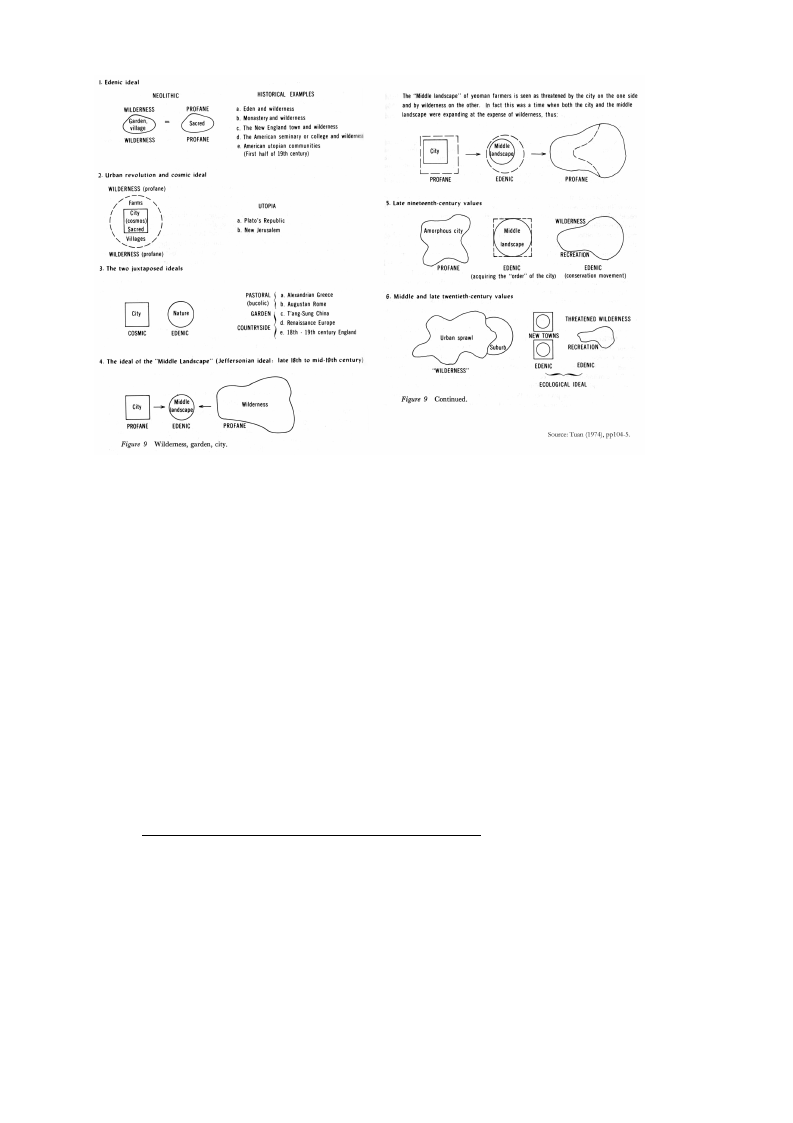
Figure 3.3: Tuan’s cultural evolution of human-nature relations
The fields which hold perhaps the greatest potential for unifying these perspectives may
be psychological anthropology (Bock 1994; Schwartz, White et al. 1992) and cultural
psychology (Shweder 1991), which study psychological similarities and differences between
cultures. They do not, however, appear to devote any noticeable attention to differences
between the ecological situations of various cultures and the potential this might have for
influencing psycho-cultural norms of attitudes to nature (and beyond). Nevertheless many
anthropologists are aware of this issue (Ingold 1986; Kenrick 1996; Turnbull 1961/1993,
1987; Willis 1994).
In summary, it is apparent that both historical change, cultural differences and possibly
even ecological circumstances can influence relations with the non-human.
3.2.4 Deliberate change: environmental education
Above and beyond innate and unintended nature-related factors of childhood (discussed
at length above and in the previous chapter) there remains what some hope is an important
proactive influence on the moulding of children’s environmental attitudes and behaviour:
environmental education. It is a field whose conventional wisdom for the last generation held
92

that people’s attitudes were less pro-environmental than they might be due to ignorance
(Arbuthnot 1974). Greater ‘awareness’ of the environment would (through an undefined
pathway) motivate more responsible behaviour toward it. Contemporary environmental
education has tended to dwell perhaps too heavily on knowledge, primarily engaging the
learner’s intellect. Whilst a school’s curriculum can promote positive or negative attitudes to
nature so, notably, can the ‘hidden curriculum’ in the ‘naturalness’ or otherwise of its
grounds (Bigelow 1996; Titman 1994). Gigliotti (1990) declared environmental education to
have failed, and Iozzi (1989) suggested that the ‘affective domain’ is the key entry point for
environmental educators.
A slightly more sophisticated model assumes that more of the right kind of information
precipitates changes in attitude that then bring about changed behaviour. These simplistic
models have repeatedly been found to be inadequate: 'Many environmental education
programmes are constructed on the false premise that knowledge about issues is sufficient,
and that knowledge by itself will lead to action.' (Hungerford and Volk 1990) cited in
(Chawla 1998a). There is also a danger that in delivering classroom-bound environmental
information, contact with the object of study is squeezed out, since ‘the more children are
insulated from direct contact with (nature) … the greater the influence assumed by parents,
peers, media and teachers’ (Chawla and Hart 1995).
Environmental education aims to create an active and informed citizenry that will work to
maintain a varied, beautiful and resource-rich planet for future generations. One might
therefore expect that the kinds of learning experiences that produce such persons would be
well known and understood. But as late as 1980 Tanner pointed out that the discipline was
devoid of research addressing this. We now know that environmental education can enhance
pro-environmental attitudes and encourage environmentally responsible behaviour in the
short-term (Armstrong and Impara 1991). But, effectively, in the absence of any long-term
prospective research on its effects, we still do not know whether it works (Sterling 2002).
The technique of Significant Life Experience (SLE) research was created to begin to fill
this knowledge void by, as it were, looking down the other end of the telescope. If we were
not sure what drove environmentalists to their enthusiasm, perhaps we should ask them.
Tanner began with a survey of autobiographic recall of important personal influences among
‘informed citizen (environmental) activists’ – importantly giving no cues as to what sort of
influences were sought (Tanner 1980). Tanner found his respondents overwhelmingly
claimed to be motivated to their present concerns by positive, not negative, experiences, and
that they most often mentioned as influences playing or walking outdoors, and parents and
teachers (for their personalities, not the courses they taught). This accorded with his earlier
93

hypothesis that children must first come to know and love the natural world before they can
become concerned with its care (Tanner cited in Palmer 1993).
Palmer, Suggate and colleagues have since firmly substantiated SLE research with a body
of work on ‘Emergent Environmentalism’, which replicates the primacy of these influences
cross-culturally (Palmer 1993; Palmer and Suggate 1996; Palmer, Suggate et al. 1998a, b;
1999), whilst acknowledging the existence of cultural differences.
In an attempt to systematise the intriguing but methodologically opaque work of Cobb
(1993) which suggested that the genesis of adult imaginativeness lay in a ‘spirit of place’
encountered first in middle childhood, Chawla (1986) extracted from a variety of twentieth-
century autobiographies specific mentions of the child’s surroundings. Codifying these, a
typography of environmental memory was identified (see Table 9.1). Particularly common
for those who turned out to be what she termed ‘creative thinkers’ were experiences of
‘transcendence’ characterised by identification with the natural environment and enduring
inspiration, always having occurred in a context of freedom and solitude. Subsequently, a
firmer link between an ‘artistic turn of mind’ and deeply personalised, ‘ecstatic’ memories,
usually of being alone in (what seemed to the child to be) wild outdoor places, with the
additional characteristic of the presence of a source of unconditional (human) love, was
established (Chawla 1990) – but also from autobiographies. Chawla too has published
repeatedly in the SLE idiom, reconfirming and increasing detailed understanding of the
original findings (Chawla 1998a, b, c; 1999; 2001). Further qualitative detail has recently
been added to these descriptions (Corcoran 1999), but still sourced from environmental
educators. Other recent work has begun to question the role of the teacher and how they
should respond to these findings (Payne, Phillip 1999).
The work of Tanner, Palmer, Chawla and others is undoubtedly valuable in identifying
probable causative influences, but problematic as it is open to the criticism of being circular
and self-fulfilling. Of course environmental enthusiasts will remember the environment
happily! Unfortunately, the method has another inbuilt methodological limitation: it is,
apparently in all cases, the result of autobiographic recall. As Chawla (Chawla 1999) admits,
for lack of comparison groups these studies do ‘not show that these antecedents distinguish
environmentally committed people from the general public’. Sia’s scale of people’s
sensitivity to the environment has been used (Sia, Hungerford et al. 1985/6; Sivek and
Hungerford 1989/90) to distinguish between those who are more or less environmentally
active, but that too is in danger of being self-fulfilling. Chawla admits of numerous other
ongoing weaknesses in SLE work (Chawla 1998a) but curiously never proposes quantitative
methods. There remains scant work examining their thesis with those who hold less strong,
no, or anti-environmental views.
94

It is interesting to reflect at this point on the claims that a slightly different group,
naturalists, make about why choose their particular vocation. It has often been reported
anecdotally that empathic or awe-laden emotive connections with the subject of study have
played and continue to play a part (Goodall 1996; Wilson 1984). Eminent primatologists
have testified to their ‘feeling’ the animal’s personality upon eye contact or their ‘heart
missing beats’. Stretching the point further, biologists such as Jonas Salk say they attempt to
imagine their way into the organism’s predicament, even if it is a virus (Verbeek and de
Waal 2002). There are interesting parallels in some of these descriptions with what Freud
called the 'oceanic state', a term borrowed from Walt Whitman (Thorsen 1983), and with
what Levy-Bruhl described as the 'participation mystique' where 'the subject is unable to
distinguish himself clearly from the object to which he is bound...' in 'an a priori one-ness of
subject and object' which he suggests is a 'primordial condition' experienced only by
individuals of 'les societies inferieures' (Jung, Hull et al. 1971/1923).
It begins to seem that environmental education which aims to engender ecocentrism may
need to focus on safely guiding participants to an experience of what has been termed the
‘ecological self’, after which environmentally irresponsible behaviour is unthinkable (Naess
1989), rather than transmitting information. Hence, as out of favour as environmental
education may have become, it may not be an invalid exercise, merely insufficiently proven.
If instead of didactic gorging on facts it can reliably furnish children with opportunities to
experience the emotional states just described in direct contact with nature, which some
schools of thought certainly strive for (Cornell 1989; Cornell 1979; Van Matre 1990), it is at
least likely to deliver a generation retaining some level of connection with the non-human.
3.2.5 ‘Ordinary ecstasy’: outdoor recreation
Few nomadic humans remain. An increasing majority of us, not necessarily through
personal choice, live in settled societies. Yet our thirst for contact with nature lingers.
Though interactions with animals and place – our day-to-day habitat - have been discussed in
the previous chapter in the context of attachment, the reader will appreciate the parallels
here. For many, however, these things do not fully answer our need. Whether in the guise of
‘hobby’, ‘sport’, ‘exercise’ or ‘getting away from it all’, recreation in natural surroundings is
an increasingly popular (partial) antidote to the pressures of urban life (Cordell and
McKinney 1999), and a significant economic force (Higgins 2000). Why so?
While commuting is known to induce stress (Novaco, Stokols et al. 1979), people
routinely use accessible nature to find solace (Rohde and Kendle 1994), and reduce stress by
taking a walk in a the woods (Bussey 1995). The same is undoubtedly true for other low
95

physical demand hobbies that take place in nature, like fishing and gardening. That an
attachment-like behaviour is involved is betrayed by the fact that tourists feel emotional
attachment to their destinations (Changuk Lee 1998; Eisenhauer, Krannich et al. 2000) and
that childhood experience of woodlands is the best predictor of adult use of them (Ward
Thompson, Aspinall et al. 2002). But even with more physically demanding activity, the
theme of attachment is evident: the extent to which recreationists identify with the location
of their sport is related to how enthusiastically they pursue the activity (Bricker and
Kerstetter 2000). It does not seem to be primarily a question of vigour: climbers seek in the
main not to take absolute risks but to pose themselves personal challenges related to their
experience (Ewert 1994) – exploring the boundaries at which they feel challenged but able to
return to safety.
The field of outdoor and adventure education also seeks to capitalise on the attractions the
outdoors offers (though environmental education might take place outdoors, they are not the
same thing (Parkin 1998)). Adventure education increases environmental sensitivity among
teenagers (Metzger and McEwen 1999), and benefits the mentally ill (raising self-esteem,
lowering depression and increasing trust in the schizoid) (Kelley, Coursey et al. 1997).
Women’s groups undertaking even short duration nature-based physical activities have
found them to be a trigger for major changes in lifestyle and attitudes in cases of depression
or anxiety (Kessell 1994), and in the case of wilderness experience, psychological healing
(Calder 2003; Friese, Pittman et al. 1995; Glassman 1995; Greenway 1996).This
‘transformational’ learning – a step change from one qualitative state to another (Cranton
1994) - is an effect sought in professional development (Cranton 1996) and business
(Torbert and Fisher 1995).
But the ethos with which these courses are run seems critical. There seem to be two
contrasting orientations toward outdoor educational activity: to ‘conquer’ or to ‘befriend’
nature. Outward Bound (OB)-style courses have on the one hand had a reputation for being
very physically and mentally challenging, whereas ‘nature study’ courses have been seen as
somewhat ‘touchy-feely’. But it is important that instructors be sensitive to their students’
needs, since OB courses can overstress and re-traumatise combat veterans suffering from
post-traumatic stress disorder (Hyer, Boyd et al. 1996).
What is the common thread of outdoor recreation? Csikszentmihalyi (1991) would
suggest ‘flow’, a total, pleasurable absorption in the task at hand during which time seems to
stand still, and which can lead to profound and lasting changes in environmental attitudes.
However the place and the circumstances may be more responsible for the epiphany than the
activity. A continuum of effects from momentary and ecstatic to repeated and more mundane
– even subconscious – encounters can have a similar longer-term effect. In either case the
96

experience does not require particular skill or risk-taking (Key 2003). A common factor in
the many available descriptions is a momentary sense of egolessness – the loss of the ‘I’ that
monitors the ‘me’ – and a transcendent sense of union with a greater whole. It is an
experience that everyone is said to have from time to time, though more often those who are
‘self actualised’ (Maslow 1962); and tends to leave people with a lasting conviction of
having gained great knowledge and insight (James 1960) into the connectedness of
everything (Key 2003).
This is strikingly similar to remembered blissful childhood experiences among the
creatively inspired and the enthusiastically pro-environmental. It is also reminiscent of
descriptions of states induced by hallucinogens, an example of the ‘peak experiences’
described by Maslow and later by Grof as an experience of ‘cosmic unity’. Its characteristics
are transcendence of the subject-object dichotomy, exceptionally strong positive affect
(peace, tranquility, joy, serenity, and bliss), a feeling of sacredness, transcendence of time
and space, an experience of pure being, and a richness of insights of cosmic relevance.
Subjects frequently talk about timelessness and say they are in touch with infinity (Grof
1976). However, despite Maslow’s desire to establish a ‘science of religion’ by
demonstrating that all so-called spiritual experiences are at root this same phenomenon
(Thorsen 1983), and his surveying a wide body of evidence, he curiously failed to include
experiences of the natural world, of which even William James had said in 1902:
‘Certain aspects of nature seem to have a peculiar power of awakening such
mystical moods.’ (James, William 1960)
Of course, this was not new even then: half a century earlier John Muir, and half a
century before him Wordsworth, captured similar sentiments. Indeed it may be that the
intuition of such feelings is primal, inseparable from the contentment of any animal securely
at home in its natural surroundings.
Interestingly there are other approaches which seek to generate these types of experiences
for adults, for example psychotherapeutic interventions involving nature, generically termed
ecotherapy (Burns 1998; Clinebell 1996) which claim success in individual transformation,
but have been criticised for being excessively individualistic. Another not unrelated field of
examples would be the group exercises used in experiential deep ecology, which entails
collective rituals and so-called despair and empowerment work (Macy 1991b; Macy and
Young Brown 1998; Seed, Macy et al. 1988), and perhaps even nature-worship rituals of
paganism and Wicca.
97


Chapter 4: Questions arising and hypotheses for
investigation
4.1 Unanswered questions concerning attachment and
environmentalism
Having reviewed the literatures on both self-in relation and the formation of attitudes and
behaviours toward nature, it is clear that there are many unanswered questions. This chapter
attempts to put some of these questions into the context of a generic experience-attitudes-
behaviour model, from which a number of testable hypotheses are formulated.
There is a wide variety of attitudes and behaviours toward the non-human. There has
however been a limited amount of work, especially quantitative, on the relation between
early experience and environmental attitudes and behaviour. In particular, though qualitative
analyses have suggested a relationship between adult environmental attitudes and childhood
contact with nature in recollections such as autobiography, there has been no confirmation of
this by other than prompted recall in a population of strongly pro-environmental ‘activists’.
Other potential ‘influences’ mooted include the attitudes of caretaker adults, siblings, and
contact with companion animals or nature ‘proxies’ (such as toys and media
representations). Nor, supposing one or more such causative relationships exist, has there
been a broader exploration of the qualitative factors in childhood experience that contribute
to pro- or anti-environmental attitudes.
The reasons for the failure to address these important uninvestigated issues in this manner
are not the central subject of this project, but they could include research difficulties, cultural
or disciplinary blind spots, the fact that the answers seem obvious to those who have thought
about the issues, or to others insignificant, or even a failure to discern the fact that there are
questions worth addressing.
One dimension of early experience in particular, attachment, is concerned with
exploration, secure-base behaviour, and conceptions of empathy in others. Attachment style,
which is established in the first few years of life in interaction with emotionally salient
others (including but not limited to principal caregivers), persists to some degree into later
adult-adult relationships. However not all emotionally significant relationships in childhood
are with humans: attachment relations are for instance known to develop with companion
99

animals. It has also been suggested that attachment may extend beyond sentient animals,
potentially to ‘lesser’ creatures, plants, trees and even places and landscapes.
It is clear that attachment style relates in a complex but predictable fashion to personality
traits (Diehl, Elnick et al. 1998; Leveridge 1998; Meyers 1998), and indeed there are even
personality differences between adults who had childhood attachments to ‘transitional
objects’ and those who did not (Cohen and Clark 1984). Personality is in turn predictive of
attitudes to animals and pro-environmental behaviour (Balderjahn 1988; Mathews and
Herzog Jr. 1997).
It might therefore by extension be hypothesized that attitudes to the environment may
relate in some fashion to attachment to parents and perhaps to other attachment objects
including animals, nature and place, and that behaviour toward the environment flows from
attitudes so formed. In addition, or alternatively, it may be that adult behaviours to nature are
related directly to childhood experience of nature, or to the behaviour the child witnesses in
adults around them.
For simplicity, the set of multifactorial working hypotheses emerging above will from
now on be referred to generically as the ‘Attachment to nature’ hypothesis. The null
hypothesis is of course the inverse – that none of human, animal and non-sentient (‘place’ or
sometimes ‘environment’ being used as loose shorthand for non-sentient influences)
experiences nor attachment styles predict attitudes and behaviours to the environment.
These arguments suggest an account of the origination of environmental attitudes and
behaviour that is best summarized diagrammatically, as follows. Solid lines represent the
conventional experience-attitude-behaviour model, dashed lines represent the possibility that
childhood factors may influence adult behaviour, without necessarily according with adult
attitudes.
The model rests on a number of alleged relationships between variables, some of which
are poorly established and some of which are purely speculative. It therefore appears that an
investigation into the relationships between these factors could act as a simultaneous test of
several theories. It is not the intention to ‘prove’ the model overall, based as it is on generic
experience-attitude-behaviour theory, but selectively to examine certain possible strands
within it relating to the ideas previously reviewed. Stated as hypotheses, the relationships
can be described as a number of major and minor postulations, as follows.
100
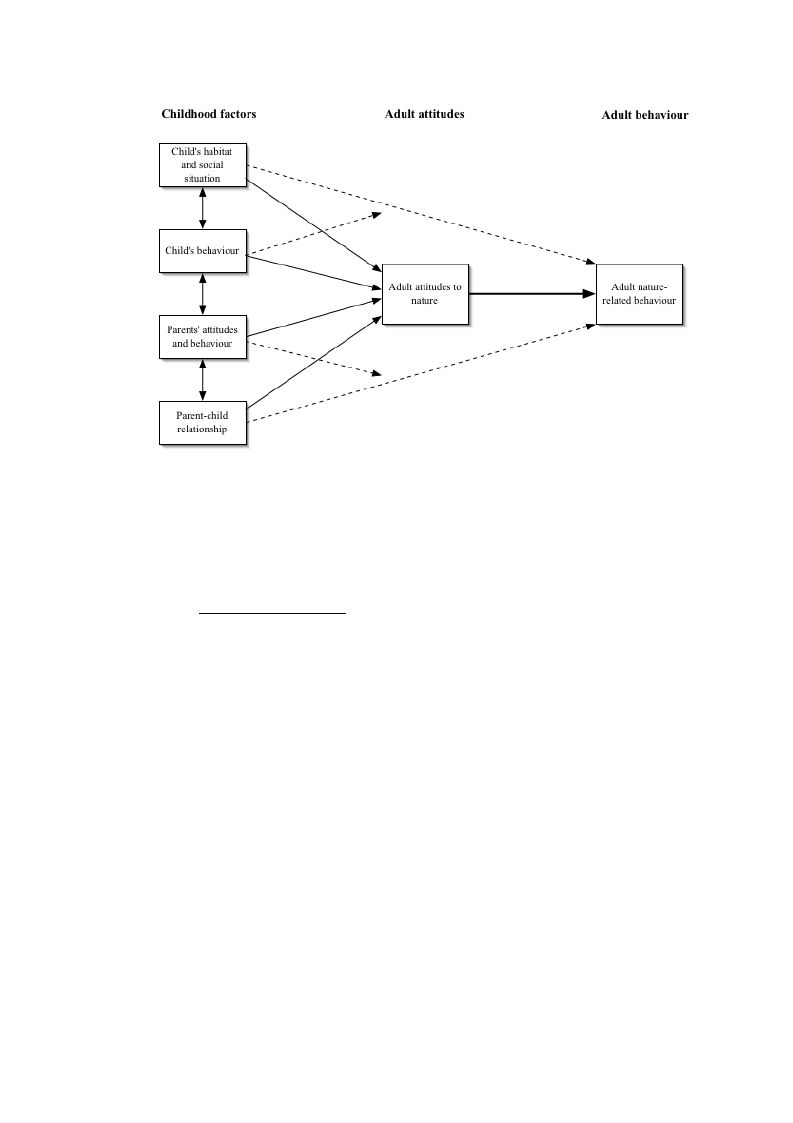
Figure 4.1: A model for the origination of environmental attitudes and behaviour
4.2 Major hypotheses
• One: Adult attitudes to nature are related to parental attachment status
• Two: Adult attitudes to nature are affected by direct contact with nature as a
child
• Three: Adult attitudes to nature are affected by parental behaviour
A series of further relationships bearing on the same questions but according to existing
evidence probably less important may also be proposed.
101

4.3 Minor hypotheses
• Four: Adult attitudes to nature are affected by indirect and vicarious experience
of nature as a child
• Five: Adult attitudes to nature are affected by the size and nature of the animal
and human ‘menagerie’ the child grows up in
• Six: Adult attitudes to nature are affected by social factors
• Seven: Adult behaviour toward nature is shaped by childhood factors,
independently of adult attitudes (e.g. habit)
4.4 Wider utility of such an investigation
An investigation of these relationships, which has been touched upon in previous work
but not addressed theoretically or methodologically in the manner proposed, would have
wider utility as an opportunity to relate hitherto relatively distinct and poorly linked areas of
social and developmental psychology. It is not novel to suggest that both interpersonal and
environmental experience have synergistic effects in development, but it is an inadequately
explored area with regard to environmental attitudes and behaviours. Such an investigation
has the potential to bring a degree of integration between theories of personality and
environmental attitude-behaviour, and open new avenues for subsequent work. Whatever the
nature of the results they would be applicable not only within environmental psychology and
environmental studies, but also potentially have ramifications for developmental and
personality psychology and perhaps anthropology, education and politics. What is more,
given the availability – as will be described - of a variety of well-used experimental
instruments useful in measuring a number of the variables, it becomes an achievable task for
a single investigator.
102

Chapter 5: Methodology
This chapter in turn reviews the possible methods that could have been used to carry out
this research and, after arriving at a decision on which to employ, recounts in detail what was
done to gather the data.
5.1 Review of methodological alternatives
Firstly, consideration is given to what data must be gathered in order to test the various
hypotheses; secondly, how to select the cohort of subjects and; thirdly, what means might be
employed to obtain the information from the selected cohort.
In social sciences quantitative and qualitative research techniques are complementary.
The insufficiency of quantitative work on childhood experiences of and subsequent adult
attitudes to nature and the availability of some good qualitative work, albeit largely with
environmental educators, documenting the subjective roots of environmentalism, were
factors in the decision to make an investigation of the former kind. However a more
important consideration was the potential utility of any results of this kind in the present
state of knowledge.
Attachments, including those that cross the species barrier, are accepted as a primary
influence on development of knowledge, skills and attitudes, with mechanisms now being
explained even down to the biochemical level. It seemed important to test whether the
attachment concept applied in a wider range of situations than had hitherto been postulated.
The mechanism of an attachment to nature was, it was supposed, unlikely to be different
from that between parent and child, but its occurrence had not been demonstrated.
Furthermore, if ‘attachment to nature’ does exist, then a demonstration of strong correlations
with the factors most likely to be salient would be a foundation for further work, including
investigation of the qualitative explications of mechanism. Autobiographical methods cannot
be expected to provide the information needed, given the potential for biases in recollection
of past memories, which are as likely to be coloured by differences in individual experience
at any stage of life, as well as by collective feelings and ideas. The most logical investigation
was a quantitative survey involving a considerable amount of data gathering on subjects’
personal experience of nature in childhood.
103

Clearly, an investigation of the as yet poorly explained relationships between the various
forces affecting attitudes to nature requires both a quantitative survey of the gross outcomes
of, for example, having grown up isolated from direct experience of nature, and a qualitative
analysis of how and why the relationships exist.
5.1.1 What information is required?
The areas for investigation can be conceived as a 2 x 3 matrix, as follows:
Area of interest / Life stage >
Attachment
Attitudes and beliefs
Behaviour and experiences
Child
To parents
Of parents
Related to nature
Adult
To nature
Regarding nature
Related to nature
Table 5.1: Matrix of areas for investigation
Qualitative, autobiographical investigations of the relationship between adult attitudes to
nature and childhood experience have been carried out (Palmer, Corcoran et al. 1996; Palmer
1993; Palmer and Suggate 1996) and there exists a considerable body of environmental
attitude-behaviour research. However there appears to be no quantitative investigation of
childhood nature experience, nor any work that directly addresses attachment effects. There
may be good reasons for this absence: an investigation of the relationships between
childhood nature experiences and adult attitudes and behaviour toward the non-human
requires data about two time periods, which is inevitably problematic. For childhood
experiences of nature, it was necessary to gather data about:
• Demographic status of the informants’ families;
• Childhood experiences and behaviour in relation to nature;
• Overt and unintended parental influences on childhood activity and ‘play’;
• Parental behaviour toward the environment;
• Attachment status of child to parents.
As far as childhood circumstances are concerned, ‘experiences’ of the non-human must
be taken to include pets, vicarious experiences of nature such as books and broadcast media,
particular enthusiasms of the child itself (e.g. nature-related hobbies), and the immediate
physical surroundings and qualities of the place the child grows up in. On that note, it might
104

be asked why not look at ecosystem or vegetative surroundings or at least activities
involving plants. After all there are available indices that measure the cognitive, emotional,
social and psychological effects of therapeutic interaction with plants: Azar and Conroy’s
scale (1989) for this has strong internal consistency (r=.947) and construct validity. However
it was designed to be completed by horticultural therapists, not clients, and principal
components analysis revealed factors of skills in basic work, community, communication,
organization and the ability to deal with authority – none being dimensions over which
clarification is sought here. Nevertheless the possible influence of vegetation and topography
remains an interesting potential sphere of influence for future workers.
For assessment of adult attitudes, the following information is required:
• Adult demographics;
• The adult subject’s attitudes and beliefs about the non-human environment itself
and its relation to human concerns;
• Their behaviour toward the environment.
The attachment dimension in particular requires some thought. Human-pet attachment
relationships have been delineated in four dimensions (Melson 1990):
• Time spent with and activities directed toward the pet;
• Interest in and affect (feelings) toward the pet;
• Cognitive constructs developed about the pet and the relationship itself, and;
• Behavioural responsiveness to the pet and its needs.
By analogy, four similar dimensions of ‘attachment’ to nature might be conceived as:
• Time spent in contact with nature and activities in nature;
• Affective responses toward nature;
• Attitudes and beliefs about nature and human relationships with it;
• Behaviour when in or with nature.
105

Following the conceptual model of this investigation, information therefore needs to be
gathered for each of these four potential dimensions of human-nature attachment.
5.1.2 Kinds of cohorts
The following options for what type of cohort to employ were considered:
• Prospective survey of different subjects
• Prospective survey of the same subjects
• Post hoc survey of different subjects
• Post hoc survey of the same subjects
A prospective survey of different subjects might begin with groups known to be dissimilar
(e.g. children born in the country versus children born in the city; children of eco-enthusiasts
versus children of technocentrists). One of these could be a randomly selected control group
with which the experimental group could be compared. Given that the hypothesis calls for an
effect of place of upbringing and this is unavoidably defined for most children, there seems
little advantage of attempting to operate with an artificially created control group rather than
one which acknowledges from the outset that the participants fall into known dissimilar
groups. It is difficult to decide what constitutes ‘normality’ in terms of home place, when the
conditions of upbringing are so clearly culturally and economically determined. A mixture of
chosen numbers of city and country children might not usefully measure anything but what
happens when you mathematically homogenise differing groups. To increase the viability of
the study or to allow it to start with smaller numbers one could start out with a known cohort
and keep replacing any dropouts with matched new subjects. But this would risk impairing
the integrity of research aimed at assessing the effect of an as-yet inadequately understood
set of influences.
The overarching problem of investigating the effect of one set of experiences on later
behaviour is accessing accurate information about both time periods. The ideal is a
prospective survey of same subjects where individuals are followed from beginning to end.
This would address most of the problems of gaining access to the childhood experience of
adults; however no technique can unarguably allow access to the experience of childhood
106

since it is subjective. Even asking children themselves can throw up significant distortions
in, for instance, their restricted use of language or self-understanding. However being able to
corroborate such witness with the later recollections of the same people as adults may be the
best way of checking for such bias.
The optimal design would be to follow a group of children from infancy (or, if Fonagy’s
proven model of the intergenerational transmission of attachment status is to be adhered to,
also including an assessment of the prospective parents before the child is born), making the
group large enough and broad enough to cope with the various home and environmental
surroundings, changes in habitation, parental habits, and perhaps personality types (of both
parents and children), through to adulthood. For statistical validity this would probably
require at least five hundred and perhaps twice that number of initial participants in order to
be sure that sufficient remained in the project over such a lengthy time scale.
Effectively, this not only pragmatically rules out such an approach for an individual even
assuming their initial commitment (there being no guarantee that the researcher would
indeed be there to complete the project over what could be a 25 year period), but for similar
reasons it would only really be within the scope of a national or international research-
council effort which could maintain the priority of and the funding for periodic follow ups.
There have been examples of projects of this scope (e.g. Framingham heart study); for the
results to be meaningful such a project would have to be on that scale. A shorter-scale effort
of perhaps a decade may evidentially be worth pursuing, but it is obviously not within the
provenance of a lone researcher.
Alternatively, a post hoc survey of different subjects might ask one group about
childhood experience and another (which may or may not be overlapping in dimensions the
researcher may or may not be aware of) about their adult experience. This approach might
suggest themes that could link the two phases of life, may permit maximum extraction of
descriptive detail and would perhaps be the most convenient for any researcher, but would
be the least satisfactory design of these alternatives for the prescribed purpose given that it is
least likely to illuminate causation. In any case, in assuming that subjects are truthful and
accurate about the majority of details of the place in which they grew up, it mimics a
prospective survey of dissimilar subjects to some extent.
In a post hoc survey of same subjects, adults are available to be asked about their present
and past experience in a convenient one-hit survey, although this is obviously subject to the
truthfulness and accuracy with which subjects give information. Potential subjects can be
invited to participate on the basis of known, relevant criteria. For example, those who
currently live in a particular kind of surroundings may be more likely than the average
107

person to have lived in a similar place as a child: hence an invitation to country adults would
probably yield a greater proportion of country children than a similar invitation to urban
adults. Unlike prospective studies, the number of participants within sub-groups is much
more easily controlled: if too few respond the experimenter can make renewed efforts to gain
additional responses from the groups from whom they are lacking, for example particular
vocational or age groups. Such a design is likely to make it statistically easier to discern and
estimate the size of effects of experiences on individuals and groups of similar individuals. It
also has the advantage that participants can be asked for information about any time in their
lives, which is a useful next-best approach for accessing childhood experience.
In conclusion, therefore, a post hoc survey of same subjects became the chosen cohort
selection method.
5.1.3 Types of data gathering
Having decided how the participants should be selected, it remains to be decided by what
means the required information should be gathered from them. The choice is to use a direct
or face-to-face method of data gathering such as observation or interview, as against an
indirect method, such as a questionnaire or secondary sources.
While observation (also termed ethological) methods would present no insurmountable
obstacles to gathering data on adult and child behaviour in relation to nature (and this has
been done, clearly demonstrating greater accuracy than subject recall), for large numbers
they would obviously be cumbersome and time consuming. Without further communication
and supplementary methods it would also be impossible to infer more than minimal detail
about the subjects intentions or feelings. Critically, this method could not yield some critical
data about attitudes underlying particular behaviours that this model requires, nor anything
on correlations between child and adult behaviour in individuals and perhaps in groups.
However, analogously to the ‘strange situation’ attachment test, it may be that observation of
subjects in nature surroundings could illustrate patterns of behaviour that might substantiate
notions of inner factors or inferences that help to confirm or disconfirm aspects of the
hypotheses. This may be helpful in future research in this area.
Gathering data through interviews may prove uniquely useful in seeking a depth of
qualitative detail, such as in trying to elucidate interesting suggested relationships between
experience and attitudes. However where the goal is statistically valid relationships, the time
and effort involved for each subject can outweigh the additional value, as without an
enormous input of experimenter time the numbers of subjects would be too small to result in
108

statistical validity. In addition, the analysis of interview data commonly involves
interpretation, although discourse analysis along the lines of Potter and Wetherall (1993) was
considered and may be fruitful for a complementary study. There are a variety of approaches
to interviews, differing as to the degree of prior preparation and the extent to which the
interviewer controls the subject matter discussed.
Structured interviews are prone to the problem of experimenter bias insofar as results
may unconsciously reflect acknowledged or unacknowledged assumptions and will fail to
capture data outside the model being tested. However where the information sought is
factual and straightforward (involving little speculative thought or discursive responses on
the subject’s part, easily recalled and likely to be divulged without demur), this method can
be highly productive, though given time constraints the numbers of interviews a single
researcher can aspire to are still likely to be limited to two figures.
Semi-structured interviews involve a more discursive conversational style, where
questions may be somewhat open-ended and answers can be led where the subject is
prepared to give the most detail, can be useful in some circumstances. It does require
vigilance on the interviewer’s part to keep the subject matter broadly on track. This could
have been employed in this case but again the numbers would probably have proven too
small.
Unstructured interviews have been characterized as a wholly ‘conversational’ or ‘fishing
expedition’ type of interview, which can yield interesting results relevant to this area of
research (for instance by asking open ended questions like ‘what is your earliest memory?’),
but can also be very time consuming (particularly in the analysis stage, where coding
methods have to be created afresh) and without a prior agenda on the part of the interviewer
may not cover the issues relevant to the research goal. Given this, it was judged not relevant
to the enquiry.
It is clear that a good deal of descriptive, qualitative evidence and speculation (based, for
instance, on examination of collated autobiographies and semi-structured interviews) has
been accumulated about the origins of environmental attitudes. However there is insufficient
confirmatory quantitative work. Therefore, primarily for this reason, interviews were
rejected as a technique to be used in the evidence gathering designed to examine childhood
experience-adult behaviour correlations. Nevertheless, the potential for interview data to
supplement and deepen understanding of mechanisms was borne in mind and therefore a
question was included at the end of the questionnaire asking subjects to volunteer their
willingness to be interviewed at some later stage. A significant number did, and these contact
109

details are available for later use, should the author or approved others so choose in pursuing
subsequent research.
We now turn to the possibility of gathering data through the use of questionnaires. This
method has a number of advantages that would be useful in a project of this nature:
• Ability to target to specific audiences, anywhere;
• Freedom to mix question types (e.g. yes/no; Likert scale; open-ended);
• Reservoir of prior validated scales and precedents;
• Ease of piloting and revision;
• Optional length and number of questions;
• Diminished opportunity for investigator bias (beyond that in assembling the
instrument);
• Choice of delivery and completion methods (see below);
• All participants are asked for the same information;
• Ease of mass administration;
• Relatively rapid analysis of data.
There are however also a series of disadvantages, including:
• Exclusion of data not specifically solicited or included in the ‘model’;
• Limited response length and detail;
• Potential for ambiguity of questions;
• Question order can affect answers; this is the case in environmental attitude
scores (Armstrong and Impara 1990);
• Layout, grammar, typeface and presentation (paper/web, sheets/booklet) may
affect answers;
• Omission of those who dislike questionnaires, who are sub-literate or not
available to be offered the item;
• Possibility of participants systematically avoiding certain questions.
110

However the most influential choice to be made is who is to complete the questionnaire.
Experimenter-completed questionnaires are:
• More likely to be filled in accurately;
• More likely to have all questions completed;
• Potentially less likely to assess subtleties;
• Likely to guarantee a higher response rate.
Participant-completed questionnaires on the other hand are:
• More likely not to be attempted;
• More prone to error and partial completion;
• May allow more time to be spent at it, which may result in more accurate
answers;
• More likely to be abandoned part way through and hence not returned.
There is also a more subtle set of problems inherent in any self-report (e.g. illegibility,
selective response, misunderstanding, mis- and selective recall, wishful thinking, deliberate
and unintentional misrepresentation, deception). The answers people give to surveys are
often not a highly dependable representation of real behaviour (Weigel 1983); measuring
what people actually do can reveal closer links between attitudes and behaviour (Hines,
Hungerford et al. 1986). However, given the practical impossibility of observing long-term
behaviour in tandem with the other variables required in this research, the lesser reliability of
self-report still allows for sufficient utility (Stern and Oskamp 1987; Warriner, McDougall et
al. 1984).
Finally there are the potential errors that can be introduced in subsequent data
manipulation (e.g. investigator, typist or coder misreading of data, mistyping, miscounting,
miscalculation, misinterpretation of meaning, misrelating data).
One other possibility is to consider whether this PhD could have been conducted in an
entirely theoretical mode, utilising solely secondary sources of information. In principle,
111

since a comprehensive theory of human-nature relations has yet to be accepted and tested, it
may be that speculations on a model for such would be a productive investigation. However,
the nascent field of ‘ecopsychology’ is without an articulating framework as it includes
insights and postulates from a panoply of disciplines and traditions that have hitherto not
been considered mutually compatible. Fisher has recently attempted to provide an over-
arching conceptual framework (Fisher 2002) but it is heavily philosophical and does not
readily offer itself to scientific testing.
There is clearly not enough empirical, quantitative work in this area. Given the ongoing
elucidation of attachment mechanisms and functioning in child and developmental
psychology, burgeoning extensions to attachment theory arising in companion animal
research, the body of work within geography on place attachment and the deluge of prose
works testifying to the impact of childhood experience of nature, it is clear that further
theoretical work in this area would have risked reiterating what others had eloquently
described or, worse, repeating unsupported assertions about human-nature relations already
stated ad nauseam elsewhere.
Clearly, the as yet poorly explained relationships between these forces will require both a
quantitative survey of the gross outcomes of, for example, having grown up distant from
nature – to which this is a small contribution, and a qualitative analysis of how and why that
should be, for a comprehensive understanding to develop.
However, for the purposes of this investigation, it appeared that a questionnaire
instrument was the only methodology that could systematically deliver sufficient volumes of
data on a large number of variables, from hundreds of selected participants, by one
researcher, for a reasonable investment of time and effort, to yield information that could
throw quantitative light on the model. This was therefore the method pursued.
5.2 The methodology adopted
Having arrived at a decision on how to gather the data and from whom, the practicalities
of doing so must follow. Here we will firstly identify which groups of subjects were chosen
and why, how the questionnaire was delivered, who responded and to what degree; secondly,
how the questionnaire was developed, and; thirdly, how the resultant data was prepared for
analysis.
112

5.2.1 Participants
In this section we will look at why certain groups were chosen for sampling, how they
were brought into the research, and the demographic characteristics of the respondents.
5.2.1.1 Sample groups
Within the practical limitations of availability within the given time, distance and
financial constraints, a selection of groups was chosen for participation principally for their
probable broad distribution along O’Riordan’s axis of ecocentrism-technocentrism (see
Procedures for how these samples were obtained). These were as follows:
• Earth First! - radical ‘eco-warriors’, some of whom were ‘living simply’ and/or
outdoors;
• CHE – students of a Masters degree in ‘Human Ecology’ from a small graduate
school espousing ‘deep green’ values;
• VUB – ethnically diverse international students of a Masters degree in ‘Human
Ecology’ from a Belgian university espousing ‘light green’ values;
• Nature Quango3 – likely to be ecologically-minded but given their
responsibilities probably pragmatic;
• Choir - urban with arguably irrelevant interests (a potential control group: it
became evident that their distribution – see below – was not appropriate for this);
• Foresters - pragmatic outdoors types from wide social background, not generally
dealing professionally with animals;
• Farmers - tending to be from rural, often socially conservative backgrounds and
commonly dealing with animals, including first-hand death and killing;
• Biotechnologists - strongly scientifically educated and applying manipulative
techniques to the control of nature, but at a remove;
• Economists - Undergraduate year 2 economics class, University of Edinburgh;
• Engineers – employees of a large defence electronics contractor.
3 Quango = ‘Quasi-autonomous Non-Governmental Organisation’
113

In the case of several disparate, informal organisations (e.g. Earth First!), there was a
need to deploy questionnaires when they were gathered together, so the author had to attend
group meetings. Others were available by post and by internal mail systems (see Procedures,
below). Further groups that were considered and not used were:
• Environmental organization supporters;
• Abattoir workers;
• Local authority employees;
• Undergraduate engineering and law students;
• Nuclear industry employees;
• Oil industry employees.
There were no outright refusals from groups that were approached by telephone followed
by an explanatory letter. However among these groups there was a degree of involuntary
elimination due to responses following enquiries to the responsible person (e.g. the nuclear
employer accepted, then changed their mind; oil industry manager would have been willing
but had recently done a company-wide questionnaire and felt the timing was internally
inappropriate). Others were not pursued as targets for diversity and numbers of respondents
were met before they would have been required.
5.2.1.2 Administration and responses
Whilst Dillman's ‘total design method’ (1978) including persistent follow-up reminders
may be the ideal for achieving high and optimally representative samples, samples in this
project had to taken more opportunistically, as and when groups of suitable candidates
became available. Groups were chosen incrementally with the goal of achieving a spread of
environmental values from technocentric to ecocentric, an approximate reflection of general
population age and sex distribution, a selection of vocations with relevance to ‘nature’ and,
finally, sufficient numbers.
The questionnaire was handed in person to groups of radical environmentalists at a
conference, international students on a local field trip, economics undergraduates at a
lecture, a suburban choir at rehearsals, and miscellaneous others at a small graduate school
of environmental studies; postally to groups of farmers and foresters, and; by internal
114

organisational mail services to staff of a government conservation agency, a defence
electronics firm, and a biotechnology research organisation.
The questionnaire was given with one of three introductions: a personal (face-to-face)
explanation; a group (face-to-face) explanation, or; a covering letter explaining what was
wanted and mentioning that permission had been given by the subject’s employer or
professional group. There was of course potential that these approaches may have had
different effects on willingness to complete and return, but results do not bear this out. In
addition, within the selected groups respondents were self-selected in the sense of
willingness to respond. Some returned the questionnaire by hand at the time or later, some
by post (usually in the enclosed stamped addressed envelope), and the remainder via internal
organisational mail systems.
Sampling took place in two stages, the first commencing in July 1997 and continuing
until mid-1998, and a second phase beginning in mid-2001. By October 2001 what turned
out to be the final tranche of questionnaires was circulated. Shortly afterwards the self-
determined minimum response total of 200 (Lemeshow, Hosmer et al. 1990) returned and
fully completed scripts from respondents was achieved and further distribution ceased.
Further returned scripts continued to drift in by mail and by hand sporadically until January
2002, at which point the dataset was closed for analysis at 294 respondents.
The overall sample size is considerably larger than originally intended due to a longer
than planned sampling phase, a slightly higher response rate than expected and unexpected
permission having been given at a late stage to poll two large groups. Three sub-groups had
10 or less respondents (CHE, Economists, Electronics) - probably too few for meaningful
conclusions to be drawn about these groups. The groups constituting Ecoradicals, Nature
Quango and International Students have numbers in the high teens and twenties that may
permit conclusions to be drawn about these groups with an intermediate level of certainty.
Farmers, Foresters, Biotechnologists and Choir all have at least 39 respondents and
constitute the most reliable body for analysis.
Group response rates for each sample sub-group varied from a very high 78.3% (Choir)
down to 15.6% (Economists). Rates of between 41% and just over 52% were achieved with
the large and potentially analytically most important biotechnology, farmer and forester sub-
groups. Given the complex and demanding nature of the questionnaire and the inability in
almost all cases to follow up and prompt respondents to return it, overall this was considered
a better than satisfactory response.
115

Group
Conservationists
Radical
environmentalists
Engineers
International
students
Choir
Farmers
Foresters
Biotechnologists
Economists
Environmental
graduate school
Total
Organisation
Date
(confidential)
Nature
7/97
‘Quango’
(UK) Earth
7/97
First! national
gathering
Defence
9/97
electronics
contractor
VUB (Free
4/98
University Of
Brussels) field
trip to Scotland
‘Voice House’, 1/98
Edinburgh
National Union 8/01
of Farmers
Scotland,
Lothians Office
membership list
Institute of
5/01
Chartered
Foresters (UK)
Independent
10/0
biotechnology 1
research
institute staff
Undergraduate 11/0
year 2
1
economics class,
University of
Edinburgh
Centre for
97-
Human
00
Ecology,
Edinburgh
Notes
Distributed via
internal mail by
Personnel Officer,
collected there &
posted back
Handed out by
author at annual
gathering
Handed out
internally &
returned by hand
Handed out &
collected by author
on field trip
Handed out &
collected
personally by
author at choir
rehearsals or by
post
Script with cover
letter posted to
named individuals
(every third on list)
Posted scripts with
cover letter & SAE
to UK members,
surnames
beginning S
Sent scripts for
distribution via
internal mail by
Director’s PA,
collected internally
Author asked for
help verbally,
handed out scripts
at morning lecture.
Returned by
internal mail
Personally by hand
No. Valid Return
sent returns %
60 18
30
80 24
30
30 7
23.3
35 23
65.7
60 47
78.3
150 62
41.3
109 57
52.3
90 39
43.3
45 7
15.6
41 10
24.4
700 294 42
Table 5.2: Questionnaire distribution and response rates
116

Distribution and return rates were as follows:
Return rate >
Delivery method
Post
By hand
Internal mail
Overall
Scripts distributed
% (no.)
37 (259)
37.3 (261)
25.7 (180)
100 (700)
Distributed scripts returned
% (no.)
45.9 (119)
42.5 (111)
35.6 (64)
42 (294)
Relative return rate
1.09
1.01
0.85
1.00
Table 5.3: Questionnaire distribution and return rates
5.2.1.3 Sample demographics
As would be expected given the way in which sample sub-groups were selected, often
deliberately to oversample groups rare in the population at large (e.g. farmers),
demographics of the various sample sub-groups reveal biased distributions. For age and sex:
• The student and student-like groups (Economists, International Students and
Ecoradicals) are all young, with a mean age under 30, with the International
Students being somewhat female;
• Farmers have a mean age in their mid-fifties and are heavily male;
• Foresters are heavily male;
• Choir are very heavily middle-aged females;
• Biotechnologists and Nature Quango groups are somewhat female.
Overall, younger females and older males predominate – due to farmers and foresters
being mainly old and male, and choir members, international students and ecoradicals being
mainly female. The sample is also biased toward the Managerial/Technical (middle) class,
with less than one in ten in the lower 3 Social Class groupings and an over-representation of
Professionals, placing a question mark over any conclusions regarding the population as a
whole and about the lower class groupings in particular.
117

Unskilled
Semi-skilled
Skilled non-manual
Skilled manual
SocialClass
No reply
Managerial/technical
Professional
Figure 5.1: Social class distribution of sample
The whole sample is much more highly educated than the population at large: 73.5% to at
least degree standard. It is therefore unrepresentative of the general population although is
probably more representative of the (mostly) professional groups surveyed.
As a result of the deliberate oversampling of rural residents, including farmers and (in all
expectation) foresters, only one third of the sample is city dwellers. The remainder is
relatively evenly distributed among the four other possible habitations (and each type of
habitation contains at least 13%, or one in 8, of respondents), which strengthens the potential
validity of comparisons about residents from outside cities.
City
Town
Village
Country not farm
Farm
Total
Valid Percent
36.1
16.5
14.1
13.1
20.3
100.0
Table 5.4: Distribution of residence
None of these results – barring the education level - were unexpected, but each should
serve as notice for caution about the wider applicability of any conclusions based on this
sample alone.
118

5.2.2 Materials
In this section we will outline in detail the data required to make it possible to test the
model and detail how the test instrument was compiled to produce this data.
Having surveyed the possible methods of gathering the required data and the nature of the
information required, it seemed that a largely structured questionnaire with some semi-
structured elements was the most appropriate instrument. However, whilst many of the
component parts of such a questionnaire could be culled from previous research, it was clear
that for the purposes of this project, it would be necessary to design certain original
instruments in order to fulfill its unique information needs.
The resulting questionnaire, incorporating several validated instruments and other
original elements was, given the considerable data requirements, as compact as possible, but
nonetheless unusually lengthy (28, A5 sides, bound). It is believed that many of the worst
sources of potential error were ironed out in subjecting it to lengthy and rigorous testing
described below. Indeed in retrospect it seems clear from participant feedback that the time
and effort invested at this stage paid off with a questionnaire that is sufficiently clear and
logical in its progression to have stimulated positive comment from some participants.
The questionnaire was prepared as a means of gathering data to test the various
relationships proposed in the model (see Questions Arising, above) and the resultant
hypotheses. Given the particular requirements of this survey and with a sense gleaned from
the Literature Review of the variables that previous authors have successfully included, the
model was redrawn as a set of relationships between variables, as shown in Figure 5.2.
119
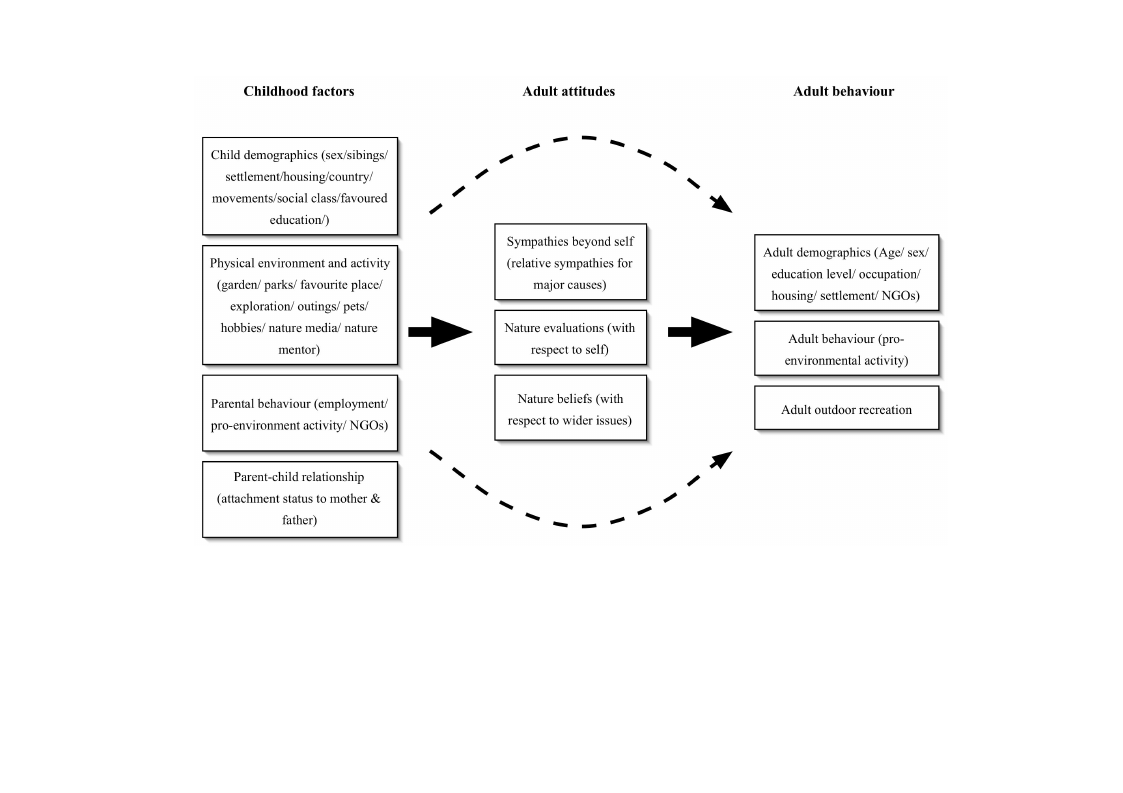
Figure 5.2: Model for variables in the Questionnaire
120

5.2.2.1 Full list of variables
As detailed below, this model was then converted into a number of questionnaire sections
dealing with the various areas of enquiry in turn. In each case, pre-existing instruments were
considered, where known, for their applicability in this case. As a result, some sections
merely employed available, validated instruments whereas others were created afresh. This
process led to a questionnaire instrument that measured a wide variety of variables: these
were termed ‘Simple’ variables. A further series of variables was created as a result of a
series of mathematical transformations of certain of these variables, most often in the form
of scale scores or principal components analyses to produce factor scores: these were termed
‘Derived’ variables. Finally, as detailed in Table 5.5: Full List of Simple and Derived
Variables, a number of combinations of these variables were computed to produce
‘Compound’ variables.
Type of Variable
Childhood Child
Factors Demographics
Child Behaviour
Simple (Questionnaire)
Variable
Sex;
Siblings (Male,
Female);
Sibling Position;
Settlement Size;
Settlement Description;
Housing Type;
Country;
Movements;
Garden;
Park/Woods;
Pet Presence;
Which Pet Types;
Mammal Types;
Non-mammal Types;
TV; Nature Mentor;
Which Mentor;
Mentor Feelings;
Father Occupation;
Mother Occupation;
Mother At Home
Favourite School
Subjects; Play;
Favourite Place;
Favourite Place
Description;
Favourite Place
Feelings;
Derived Variable
‘Urban/Rural;
‘Childhood Surroundings’;
Social Class;
‘Rich/Poor World’
Nature Hobby Category;
121

Adult
Attitudes
Adult
Behaviour
Parental
Behaviour
Attachment Status
Relative
Sympathies
Nature
(Eco)Evaluations
Nature
(Eco)Emotionality
Adult
Demographics
Adult Behaviour
Outdoorsiness
Wander;
Wander Feelings;
Trips; Trip Feelings;
Nature Hobbies;
Nature Hobby
Frequency;
Favourite Hobby;
Nature Reading;
Reading Frequency;
Nature Media
Frequency;
Why Nature Media
Parental NGO
Members;
Parental NGOs;
Parental Ecoactivity
overall
Paternal
Care/Overprotection;
Maternal
Care/Overprotection
Human (Overall, Local,
Global);
Animal;
Environmental
Ecoevaluation Category
Ecoemotionality
Category
Age;
Settlement Size;
Settlement Description;
Occupation;
Education Level;
Tertiary Subject;
Sample Sub-group
Adult Ecoactivity
overall
Outdoorsiness overall
Factors:
‘Ecopractical’; ‘Ecopolitical’
Paternal Attachment
Classification;
Maternal Attachment
Classification
Sympathy Category (of 3 & of
4);
Factors: ‘Environmental
Sympathy’; ‘Animal
Sympathy’; ‘Human Sympathy’
Factors: ‘Anthropocentric’;
‘Technocentric’;
‘Conservationist’; ‘Ecocentric’
Factors: ‘Secure’;
‘Fearful’;
‘Dismissive’;
‘Stoic’
Social Class
Factors: ‘Ecopractical’;
‘Ecopolitical’; ‘Ecotransport’
Factors: ‘At Ease’;
‘Loner’;
‘Utilitarian’; ‘Pragmatist’
Table 5.5: Full List of Simple and Derived Variables
A further series of ‘Compound’ variables of use in later analyses was created by
combining existing variables as follows:
122

Compound variable
‘Townie’
‘Nature Home’
‘Menagerie’
‘Nature Mediation’
‘Ecoparenting’
‘Explorer’
‘Free Range Child’
‘Nature Child’ /
‘Nature Child Score’
Components
Urban/Rural + Childhood
Surroundings
Garden + Pets
Siblings + Pets
Nature Mentor + Country
Trips
Nature Mediation + parental
Nature Media encouragement
ParkPlay + Wander
Explorer + Favourite Place
Garden + Pets + Hobby
Coding scheme
Urban-grey/ urban-green/ rural-
green/ rural-grey4
Garden-no pets/ garden-pets/ no
garden-pets/ no garden-no pets4
Alone/ one or less pet-sib/ two or
more pet-sib/ three or more pet-
sib5
Mentor rare trips/ mentor some
trips/ mentor often trips/ no
mentor rare trips/ no mentors some
trips/ no mentor often trips
Neither/ encourage/ mentor/ both6
Stay at home/ play never wander/
play rarely wander/ play some
wander/ play often wander/
wander not play
Battery child/ free range child7
Both + hobby/ both no hobby/
garden + hobby/ garden no hobby/
pet + hobby/ pet no hobby/ neither
+ hobby/ neither no hobby (Nature
Child Score = none/ one/ two/
three elements)
Table 5.6: List of Compound Variables and Coding Schemes
4 A “2 x 2” matrix.
5 The goal of this variable was to capture the degree of human-animal interaction. Children with
neither siblings nor pets were coded as one group (1); no siblings or no pets or only one of each in a
second group (2); three siblings and/or pets a third (3); four siblings and/or pets a fourth (4); five or
more siblings or pets a fifth (5).
6 ‘Neither’ = reasons for watching nature media do not mention parents’ encouragement + no nature
mentor; ‘Encourage’ = reasons for watching nature media mention parents’ encouragement + no
nature mentor; ‘Mentor’ = no parents’ encouragement + nature mentor; ‘Both’ = parents’
encouragement + nature mentor.
7 ‘Free range’ = in the most active three categories in ‘Explorer’ (i.e. Play Some Wander, Play Often
Wander and Wander not Play) and favourite childhood place away from home (Question 2.10 recode
2). By contrast, subjects who fell within the least active three categories in the Explorer variable (i.e.
Stay at Home, Play Never Wander and Play Rarely Wander) and whose favourite childhood place was
near home are termed ‘Battery Children’.
123

5.2.2.2 Development of the questionnaire
The questionnaire consisted of 7 sections:
• Section 1: (current) demographics
• Section 2: childhood environmental activity (including child demographics)
• Section 3: parental work and environmental actions
• Section 4: charitable giving (relative sympathies)
• Section 5; present environmental activities and actions
• Section 6: attachment status to mother and father
• Section 7: environmental beliefs and evaluations
The order in which the sections were presented came about as a result of repeated pilot
versions and respondent feedback, and in particular a consideration to make the earlier part
of the questionnaire more plainly factual to intrigue and interest, moving progressively to
more personally challenging questions once the respondent was committed to filling it in.
5.2.2.2.1 Section 1: demographics
Section 1 sought information on basic demographic factors such as age, gender, final
level and subject of education and favourite school subjects, occupation (also used as a
proxy for social class), presence of siblings and birth order position. Standard demographic
questions on sibling numbers and position, education level and subject choice, occupation,
age and sex were included.
Throughout this study ‘childhood’ has been referred to without having stated exactly
what period it encompasses since, among other things, different authors seem to mean
different things. For the purposes of this study, however, an age must be chosen not least so
that subjects’ can be instructed to try to recall experiences within a common time frame. A
choice has therefore been made that childhood will be treated as up to and including age 12,
on the grounds that a common definition of a child is a pre-adolescent, but also conscious
that this is to some extent developmentally arbitrary.
Whilst this section was an original construction the only slightly non-standard items
concern place of habitation (Q1.1) and the size of the settlement (Q1.2). These two questions
124

on current residential type (city, town, village, farm and countryside apart from a farm) and
settlement size (<500, <5,000, <50,000, <500,000 and >500,001) were created with the aims
of distinguishing urban from rural from farming childhoods, and of elucidating the
potentially different perspectives of objective settlement size and subjective perception of
the size character of the settlement. A proxy birth order position question (Q1.3) was
included, broken down only to youngest/oldest/middle/only child.
Educational attainment levels (Q1.6) are characterized in dual Scottish/English style to
make the questionnaire maximally comprehensible to all British-schooled respondents. It
was decided to give an open choice of University subject, favourite school subject(s) and
occupation as more codified questions would have consumed too much space and respondent
attention, and since classifications are available for all of these (although this creates more
work in coding).
5.2.2.2.2
Section 2: childhood habitation/activities
Additional original demographic factual questions in this section were country of
childhood (Q2.1), number of homes before age 12 (Q2.2), housing type (Q2.5), presence of
garden (Q2.6), nearby nature (Q2.7), pets (Q2.18), pet types (Q2.19), and presence of
television (Q2.24) each suggested by a wide reading of the literature as potentially salient.
Questions potentially open to more subjective answers were on frequency of playing in
nearby nature (Q2.8), wandering more than 20 minutes from home (2.12) (proxy for
approximately 1 km, a distance greater than the mean stimulated recall of 11 year olds
(Matthews 1985)), trips to the country (Q2.14), to the city (Q2.16), having had a favourite
place (Q2.9) and describing it (Q2.10), having had nature hobbies (Q2.20), the favourite
(Q2.22) and their frequency (Q2.21), reading about (Q2.23) and watching or listening to
media about nature (Q2.25), having had an adult nature ‘mentor’ (Q2.27) and their
relationship (Q2.28), and feelings about the favourite place (Q2.11), wandering (Q2.13),
country trips (Q2.15), city trips (Q2.17), nature media (Q2.26), and the nature mentor
(Q2.29). In all cases of frequencies, the simple colloquial four-element never-rarely-
sometimes-often scale was employed for ease of understanding, and for feelings about trips
the four-element scale hated-disliked-liked-loved was adopted.
Given the relative immobility and confinement of pre-school infants and the
inaccessibility to the detail of these interactions when asking adults two and more decades
later, it was judged a valid next-best approximation to use as a proxy variable for nature
contact in the first five or so years of life the presence or absence of a garden and/or pets.
125

A more detailed pet relationship picture could have been obtained with the Companion
Animal Bonding Scale (Poresky, Hendrix et al. 1987) or the Pet Bonding Scale (Angle,
Blumentritt, & Swank, 1993). However, since extensive work in the area of pet-human
relationships reliably indicates a relationship between having pets and a range of relevant
factors, it was judged sufficient on the grounds of brevity to simplify to merely asking if pets
were present in childhood and, if so, which. It was decided that since the critical factors are
the ownership of pets and where they sit on the objective (and childhood subjective)
phylogenetic tree, identified by the animal species, two questions on these aspects would be
sufficient. The choice of identified pets was drawn up to include all major childhood pet
groups (Paul and Serpell 1993).
The questions on nature hobbies, their frequency and which was favourite were included
to illustrate the frequency and character of unmediated nature contact. By contrast, the
questions on reading and broadcast media were included to characterize the extent of
mediated nature contact, and to enable the possibility of examining the correlation between
mediated and unmediated nature contact.
Questions on a ‘nature mentor’ were included as previous work suggested that such
figures could play a significant role in modulating the child’s degree and quality of contact
with nature (Palmer 1993), and as the extensive literature on environmental education
virtually takes as given that teachers can play this role. However the literature is vague on
this point and unclear about why teachers, who may spend much time with the child but at a
later stage than numerous other adults or older children, and mostly in the classroom, might
be significant. The author’s suspicion is that whilst teachers may moderate the child’s
relationship with nature, people with whom the child has had earlier and closer relationships,
and the emotional character of those relationships, may be more important. Hence three
questions on the remembered presence of a mentor, the relationship status of the mentor to
the child, and an open question requesting description of the affective character of this
relationship.
5.2.2.2.3 Section 3: parental work and environmental actions
This section sought information on parental occupations, mother’s work pattern, parental
environmental group membership and environmental actions. The environmental actions
section merits some detail.
Validated scales measuring environmental concern and general involvement in
conservation issues were reviewed, the requirement being that they could be both recalled by
126

adult subjects in respect of their parents, and also used (in Section 5) about their own actions
(Maloney and Ward 1973; Maloney, Ward et al. 1975; Schahn and Holzer 1990; Weigel and
Weigel 1978). Typically these scales cover perceptions or knowledge of environmental
problems, level of concern about environmental issues (e.g. pollution, waste disposal),
conservation actions people would be prepared to undertake, conservation actions actually
undertaken, and emotional responses to environmental problems. By way of comparison, a
more recent formulation of such an instrument asks if subjects (Steel 2000):
• Avoid Pesticides
• Avoid Aerosol Cans
• Avoid Foam Containers
• Avoid Paper Products
• Use Recycled Paper
• Composting
• Buy Environmentally Sound Products
• Reduce Water Usage
• Reduce Energy Consumption
However no existing instrument appeared ideal by itself and most missed the overt
political dimension of environmentalism. Therefore a further instrument to measure these
dimensions was sought. Measures of political participation in environmental issues are often
based on the classic study Political Action (Barnes and Kaase 1979). The possibilities it
suggested were:
• Political activity
• Signing petitions
• Donating money to an environmental group
• Joining an environmental group
• Writing letters to local, state or federal legislators or agency officials
• Writing letters to newspapers
127

• Soliciting signatures for a petition
• Phoning or personally lobbying legislators or agency officials
• Campaigning for a candidate
• Attending public meetings
• Participating in lawful demonstrations
• Civil disobedience
The most statistically significant of these were donating money, demonstrating and
contacting politicians. Following Bray (1996) these were therefore combined with the 7 most
pertinent environmental concern items to form a revised joint environmental behaviour
instrument.
When measuring self-report rather than observed factors like these on environmental
behaviours and activism it is important to be mindful of the potential for socially desirable
responses, which may lead to overestimation of actual behavior (and in the case of the
subject reporting their parents’ behaviours, over-or under-estimation). In addition,
respondents or their parents may have indulged in each named activity only once or
regularly, so the overall index can only be regarded as a relatively loose indicator of pro-
environmental activity.
5.2.2.2.4 Section 4: charitable giving
Section 4 is a verbatim re-use of the ‘Charity Donations Test’, an instrument created by
Paul (1992). Its first published use, in measuring relative sympathies to animals (Paul and
Serpell 1993), showed a strong positive correlation between animal giving and number of
pets in childhood, and a negative correlation with human giving. The exercise is both an
absolute measurement (respondent honesty permitting) of the appeal of different popular
human, animal and environmental concerns and a relative measure pitting them against one
another, and it was for this latter quality that it was employed on this occasion.
5.2.2.2.5 Section 5, first half: present environmental activities
This instrument was a revised version of the one used by Bray (1996), following a review
of the literature which did not unearth a more appropriate existing one. The sixteen items
128

chosen identified a series of the most common activities that bring one into contact with
nature directly or vicariously, and asked the respondent how often he or she participated in
each activity. Items were chosen to reflect a gradation from obligatory contact with nature
(e.g. ‘because of my job’) to habitual everyday (e.g. ‘to walk a pet’) on through necessary-
for-hobbies (e.g. ‘shooting’; ‘gardening’) and finally deliberate contact seeking (e.g. ‘visit
wild areas’; ‘study plants’; ‘stay out overnight’). Further items were included to distinguish
between solitary and accompanied nature contact; vicarious contact (e.g. ‘watch nature
programmes’) and, finally; motorised and non-motorised outdoor sports. It was hoped that
this range of options would help distinguish between people who were actively interested in
nature for its own sake, and those who were not. The response scale of ‘Never-hardly ever-
every year-every month-every week-every day’ scale was chosen for maximum
comprehension and speed of completion.
5.2.2.2.6
Section 5, second half: present environmental actions
Apart from the rewording necessary to address the questions to the respondent, this
section was identical to the analogous part of Section 3. Questions 5.27 and 5.28 were the
same as Questions 3.4 and 3.5, asked in respect of respondents.
5.2.2.2.7
Section 6: adult attachment
Why measure attachment status? The requirement in this instance is for a means to
measure the preverbal, security-seeking quality of the relationship between the child and
each of their parents, under the assumption that this may be reflected in other relationships.
As probably the most thoroughly examined phenomenon of parent-child relationship quality,
the theory of attachment, with its strong suggestion of lasting and broad effects on
personality and life events, appears to be a highly appropriate framework for the present
study. Hence a review of available attachment instruments was conducted.
The most significant and widely acknowledged measurement of attachment status is the
Strange Situation procedure (Ainsworth, Blehar et al. 1978), which involves direct
observation of infant-mother behaviour in a laboratory situation. Because of its cumbersome
nature, there has been a move toward increasingly brief questionnaires to complement and in
some cases substitute in a less labour-intensive and time-consuming way for the standard
behavioural measures. Condon and Corkindale (1998) for instance focused on the mother's
subjective experiences of her infant in creating their 19 item self-report questionnaire which
provides acceptable levels of internal consistency and test-retest reliability. Four factors
129

(pleasure in proximity, acceptance, tolerance, and competence as parent) account for
approximately 40% of the variance. However the criterion validity of the instrument has yet
to be established by comparison with behavioural measures.
There appears to be no analogous ‘adult strange situation’ procedure for the assessment
of adult attachment status, which is an interesting omission from the body of research,
particularly given the foundational nature of the infant behavioural test. However adult
questionnaire instruments have been developed. The benchmark instrument is the Adult
Attachment Interview (AAI) (George, Kaplan et al. 1984/1985/1996), a widely utilized,
robust and reliable instrument with a decade and more of clinical application. It is
administered face-to-face by trained interviewers and takes a considerable time for each
subject. Options for self-report attachment instruments included:
• Parental Bonding Instrument (Parker, Tupling et al. 1979).
• Reciprocal and Avoidant Attachment Questionnaires (West, Sheldon et al. 1987;
West and Sheldon-Keller 1994).
• Relationship Questionnaire (Bartholomew and Horowitz 1991; Hazan and Shaver
1987).
• Relationship Styles Questionnaire (Griffin and Bartholomew 1994).
• Expressions of Close Relationship Scale (Bartholomew and Shaver 1998;
Brennan, K.A., Clark et al. 1998).
Despite differing in terms of domain (family, peer, or romantic relationships), method
(interview, Q-Sort, or self-report), dimensionality (categories, prototype ratings, or
dimensions), and categorization systems, these measures are in general strongly convergent
with each other and the benchmark AAI (Bartholomew and Shaver 1998; Manassis, Owens
et al. 1999; Sperling, Foelsch et al. 1996; West, Spreng et al. 1998), and the choice can be
based on practicality. The instrument chosen must be one that can be completed briefly by
unsupervised adults with no prior knowledge, yet which produces relevant information about
their experience as children. The construction of a tailored instrument was briefly considered
but, given the likely magnitude of the task and the availability of existing potentially
applicable instruments, was deemed unnecessary.
The Reciprocal and Avoidant Attachment Questionnaires were deemed to require too
much amendment. The Relationship Questionnaire does not apply specifically to parental
130
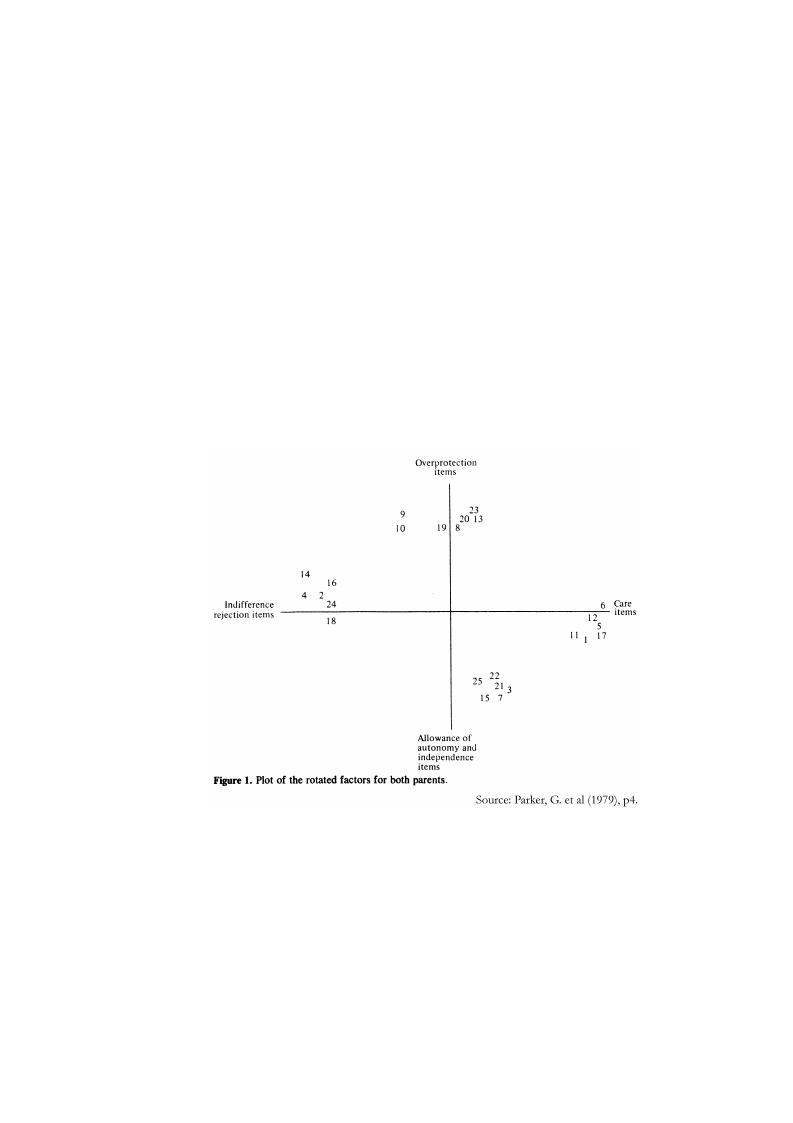
relationships, the Relationship Styles Questionnaire is aimed at romantic relationships, and
the Expressions of Close Relationship Scale focuses on partner relationships. The Parental
Bonding Instrument (PBI) appears appropriate. Whilst there does not appear to be a great
deal of published research on its use, what there is reinforces its validity and applicability to
the circumstances of this investigation (Arrindell, Gerlsma et al. 1998; Chambers, Power et
al. 2000; Klimidis, Minas et al. 1992a, b; Manassis, Owens et al. 1999; Murphy, Brewin et
al. 1997) and it was therefore chosen.
The PBI is a 4-point, 25-item Likert-style scale used to measure dimensions of parent-
child bonding entitled ‘care’ and ‘overprotection’ (see Figure 5.3). Adult respondents answer
the questions as they relate to their biological parents or parent figures as remembered from
their first 16 years. Twelve of the items relate to care and 13 relate to protection of the child
by the parent. It has a response reliability of 0.704 (p <0.001) in a 48-item version and test-
retest correlation of 0.761 (p<0.001) for the ‘care’ scale and 0.628 (p<0.001) for the
‘overprotection’ scale and both scales have high split-half reliability. It takes 2-5 minutes to
complete (Parker, Tupling et al. 1979).
Figure 5.3: Item dimensions plot for Parental Bonding Index
The PBI has been applied widely in a variety of cultures and languages and is considered
applicable to samples in Spain (Gomez-Beneyto, Pedros et al. 1993), France (Mohr, Preisig
et al. 1999), Italy (Scinto, Marinangeli et al. 1999), China (Bih-Ching, Wen-Juo et al. 1999)
and Japan (Sato, Narita et al. 1999). It has also usefully been applied to non-normative
131

populations including incarcerated young offenders in Scotland (Chambers, Power et al.
2000) and to schizophrenics (Favaretto, Torresani et al. 2001).
There is some debate in the literature over whether the PBI is best used as a two- or three-
factor measure. Whilst maintaining that the PBI is in practical terms best used to measure
two factors, Parker et al point out that the correlation between their measurements of the care
and overprotection scales is –0.238 (p<0.001), suggesting that the scores on the two
dimensions are not entirely independent and require orthogonal correction in use. Some
recent authors have maintained that a three-factor solution is more appropriate. Murphy’s
analysis distinguished between three factors of care, denial of psychological autonomy and
encouragement of behavioural freedom (Murphy, Brewin et al. 1997), and Cox claims
confirmation for this argument (Cox, Enns et al. 2000). However this evidence was
published after the present questionnaire was created and has thus been excluded from the
enquiry. It may be legitimate to reanalyze the present dataset in this light at a later date.
Given the disjunction between the relatively impersonal nature of the rest of the final
questionnaire and this instrument, it was felt there was a significant likelihood of an
unusually high neutral or middle-point effect, so a 4-point Likert scale was chosen to force
respondents into a choice on each item.
5.2.2.2.8 Section 7: environmental attitudes
Numerous studies have attempted to assess environmental attitudes and behaviours (e.g.
Maloney and Ward 1973; Maloney, Ward et al. 1975; Schahn and Holzer 1990; Weigel and
Newman 1976; Weigel and Weigel 1978). Characteristically they cover perceptions or
knowledge of problems, concern over environmental issues, espoused and actual
conservation actions and, more unusually, emotional responses to problems. One of the
earliest sets of instruments was derived to assess verbal commitment (VC), actual
commitment (AC), emotionality /affect (A) and knowledge (K) to ecological issues from an
initial pool of 500 questions. The most significant subscale intercorrelation was that scale K
did not correlate significantly with any of the other scales, whereas there were moderately
higher correlations between all the other subscales (Maloney and Ward 1973). The authors
concluded:
‘In colloquial terms, most people say they are willing to do a great deal to help
curb pollution problems and are fairly emotional about it, but, in fact, they actually
do fairly little and know even less.’
132

However other studies have found that a majority claim to have changed their behaviour
for environmental reasons, and believe that lack of environmental education was a major
problem (NSW Environmental Protection Authority 1994).
Dunlap established a relationship between environmental attitudes and behaviour, and
belief in ‘traditional’ American beliefs and values (e.g. progress, abundance and
individualism) (Dunlap and Van Liere 1978; Dunlap, Van Liere et al. 2000). This ‘Dominant
Social Paradigm’ was conceived of as in opposition to the ‘environmental paradigm,’ for
which the ‘New Environmental Paradigm Scale’ (NEP) was constructed. As one of the most
reliable environmental attitude scales (Tarrant and Cordell 1997) it became the most widely
used. The name of the instrument is perhaps unfortunate, implying that such values are
novel, when in fact there is a striking resonance with the values of native peoples globally,
and Western cultures historically (Grove 1992p42).
Used to show that environmental attitudes are not particularly good predictors of pro-
environment behaviours (Theodori, Luloff et al. 1998), its unidimensionality has been
challenged: a number of US National Park Service studies found two dimensions, although it
was conceded that park visitors would likely support a more ecological view (Noe and Snow
1990). Another analysis suggests three dimensions: the balance of nature; limits to growth;
and man over nature (Albrecht, Bultena et al. 1982), although a reanalysis of both this and
the original author’s data was unable to confirm either result without reducing the scale to
nine items (Geller and Lasley 1985). Further revisions reduced to six the number of
questions required for a reliability coefficient (Cronbach's Alpha) of .82, agreement on the
first three and disagreement on the last three scoring highest:
• The balance of nature is very delicate and easily upset by human activities;
• The earth is like a spaceship with only limited room and resources;
• Plants and animals do not exist primarily for human use;
• Modifying the environment for human use seldom causes serious problems;
• There are no limits to growth for nations like the United States;
• Humankind was created to rule over the rest of nature.
133

Gray (1985) questions ‘whether any measure of environmental paradigms can be
unidimensional’ and asserts that ‘beliefs in such a complex domain as ecology are not likely
to be simple...but complex and multidimensional.’
An evident bias of the NEP and similar instruments is their somewhat catch-all use of the
term ‘attitudes’ to capture what are in fact opinions or expressed beliefs about public
environmental issues. Whilst there must of course be a relationship between such socio-
political concerns and more personal experience, the individual’s relationship with nature is
not necessarily entirely captured by description at this level, which tends to neglect the
affective dimension of knowledge. Although people's values about nature predict
environmentalism (Oskamp 1977), comparatively few studies examine such emotional
responses to nature.
Numerous authors have proposed dimensions along which an individual’s attitudes to
nature might be placed: instrumentalists versus spiritualists; utilitarian versus moral
consideration to non-humans elements of the universe; egoistic and social-altruistic versus
biospheric; and technocentrism-anthropocentrism-ecocentrism (O'Riordan 1977; Thompson
and Barton 1994)).
The terminology of ‘ecocentrism’ and ‘technocentrism’ originates with O’Riordan:
ecocentrists view ecology as being of prime importance; technocentrics see science and
technology as being central. For ecocentrists, nature exists for its own sake: human
extinction would not remove meaning from the continued existence of other life (Pepper,
Perkins et al. 1984). Both animate and inanimate nature has rights, and human values which
undermine nature’s intrinsic values must be abandoned or modified (Oelschlaeger 1991).
The fates of humans and nature are irredeemably physically and psychological
interdependent (Partridge 1984). ‘Radical ecocentrists’, often termed deep ecologists, go
further suggesting that since humans are threatening the richness and diversity of life, a
decrease in human population is desirable for the greater ecocentric good; that requires
fundamental changes in economic, technologic and cultural ideology (Oelschlaeger 1991).
Conservationists, or ‘anthropocentric nature-lovers’, share an holistic view of nature with
ecocentrists: the whole is greater than the sum of the parts. All elements of an ecosystem are
critical to its healthy functioning, and maintaining this through, for example, wilderness will
bring benefit to future generations. Nature is valued primarily in terms of human utility,
including non-material values such as aesthetics and morality.
Anthropocentrists consider humanity to be central, appraising all else from this
standpoint. Oelschlaeger prefers ‘preservationist’ since, he maintains, anthropocentrism is
134

not necessarily in conflict with nature (nature preservation being psychologically and
materially beneficial to humans).
Technocentrics believe nature to be inert matter and energy governed by rational laws
and available for humans to transform at will. Progress is measured by economic growth and
technological advance, and objective science can solve environmental problems which may
be an inevitable price of development, but are better borne than abandoning modernity which
would involve a descent into primitivism (Pepper, Perkins et al. 1984). Environmental
decisions are best left to scientific and economic experts; political or public involvement in
environmental decision-making is neither necessary nor desirable (O'Riordan 1977).
The continuum appears as follows:
Technocentric - Anthropocentric - Conservationist - Ecocentric
Thompson and Barton (1994) looked at the relationship between ecocentric,
anthropocentric and apathetic attitudes to nature as motives for self-reported conserving
behaviours and for belonging to environmental organisations. Example (not used) items from
their 33-item scale include ‘I prefer wildlife to zoos’, and ‘Sometimes when I’m unhappy I
find comfort in nature.’ It was found that ecocentric and anthropocentric scales
independently predicted conserving behaviour and belonging to environmental organisations
in a general population sample.
In light of these two differing but seemingly not coincident approaches it was decided to
include instruments reflecting each (evaluations and affect) as it was likely they would
provide complementary perspectives. For the former, a 12-item variant of the NEP was
constructed, following Bray’s (1996) recent local experience testing with a Scottish
population. For the latter, a 12-item variant of Thompson and Barton’s (1994) instrument
was constructed, including only the more directly personal, emotion-referencing items and
synthesising complementary ones.
Respondents to both instruments were asked to agree or disagree with a series of
statements. All response scales used were 4-point (Strongly Disagree-Disagree-Agree-
Strongly Agree) Likert scales for the sake of uniformity (with other four-point scales
elsewhere in the questionnaire), comprehensibility, disambiguation and speed. Questions
were alternated such that a respondent answering consistently from one perspective would
not be able to agree (or disagree) with every single question. With each instrument a
considerable number of minor amendments were made consistent with removal of
135

ambiguity, repetition, cultural inapplicability, verbosity, and high reading age (where no
sense was lost).
5.2.3 Procedures
The way in which the questionnaire was tested and revised before use, how the data was
turned into computerised form, and how the data was recoded ready for analysis (including a
full explanation of how each of the final variables was obtained from the raw data) will now
be described
5.2.3.1 Piloting
A series of 8 cycles of revision and feedback were carried out in order to ensure that the
questionnaire had optimised the likelihood of users finding it interesting, and being
motivated to complete and return it8. Initial versions were printed and presented on single-
side stapled A4 paper and feedback sought from experienced colleagues initially on content
but as that became settled, progressively on form. Less forewarned and informed individuals
were recruited as informal trial respondents in each cycle of revision, including:
• Colleagues and researchers in the Psychology Department;
• Colleagues with an interest in the subject matter;
• Postgraduate students interested in ecopsychology;
• Undergraduate students;
• Friends and family.
There was a very useful set of responses to the content of the questionnaire from these
differing perspectives, much of which may otherwise have escaped the author. Many
changes made included rephrases of the framing commentary, question wording and
question order, and section order. Some notable points include:
8 Details of the changes made in pilot questionnaire instruments between versions are retained on file
by the author, as are full copies of all versions used in development. The public (1997) version was
revision 8; version 9 (2000) was issued to correct a few minor typographical errors.
136

• Addition of a ‘friendly’ introduction and closing statement style including
reassurance about anonymity;
• Keep the amount of prior information to digest as modest as necessary to entice
participation;
• Start with factual, easy questions requiring little thought or internal reflection;
• Move on to questions requiring historical reflection and some indirect emotional
content;
• Build to direct, personal, emotion and opinion-based (evaluative) questions, so as
to leave the subject (who completes the questionnaire in the assigned order)
gently through it.
• Encourage completion of questions even where doubts exist, and the addition of
written commentary where the participant feels it appropriate;
• Inclusion of a space at the end for comments;
• An opt-in ability to volunteer for later research involving interviews, with a
promise to send a summary of the completed research to all who gave their
address.
In particular, the authors’ concerns about the emotional depth of the PBI were borne out,
seen for instance as a ‘sudden intrusion’ by some, particularly when there was no
forewarning; it therefore required some careful introductory wording to prepare the
participant. The PBI answer phrasing was misread and misunderstood by some pilot
respondents, so the wording was changed from:
‘Very like’ to ‘Very like this’
‘Moderately like’ to ‘A bit like this’
‘Moderately unlike’ to ‘A bit unlike this’
‘Very unlike’ to ‘Very unlike this’
The PBI answer order was judged to have potential to discourage negative answers, so
the order was reversed, going from:
137

Very like > Very unlike to Very unlike this > Very like this
The feedback on the form of the questionnaire, in addition to a variety of personal advice,
examination of previous example questionnaires and a rapid review of best practice was as
follows:
• Typeface: a serif typeface (Times, Apple system version) was used throughout as
it has been shown that serifs increase legibility and reading speed, especially
when dealing with small type or giving less than full attention.
• Symbolism of the University crest (as opposed to anonymity of source or verbal
naming alone): – carries prestige and authority that suggests the research is
legitimate and important.
• Colour: Non-standard colours gain greater attention in the first place. They are
not as easy to ‘lose’ in a pile of normal white paper. And they carry a subtly more
demanding connotation of wanting to be completed. Similar logic was employed
for the use of the non-standard recycled green envelopes.
• Pre-paid and addressed reply envelopes: pre-addressed envelopes, either for
internal or external mailing, are known in market research to gain a greater
response rate as they make the act of mailing the completed questionnaire ready
for return slightly less time-consuming. Also, pre-stamped envelopes for external
mailing carry the obvious connotation that prior expenditure has been incurred by
the experimenter, placing a subtle obligation on the respondent to take the item
seriously.
• Bookletting: people tend to respond better (higher acceptance and completion
rates) to folded and saddle-stapled booklets rather than corner-stapled
questionnaires.
• Size: A4 size is often used in questionnaires. However alternative versions in the
half-size and more unusual A5 produced reactions that this was a more portable,
aesthetically satisfying package in the hand that could be left folded open at the
page the person had got to. It also made it possible to send it in A5 envelopes
giving an impression of professionalism.
138

In particular, a good deal of time was spent in the design stage desk-top publishing the
questionnaire such that it was visually appealing and highly functional, a process in which
the author’s professional print design experience aided considerably. Users preferred a
layout using sequences of similar-formatted questions in a left-side column with answers on
the right, rather than an answer space beneath each question.
Bearing in mind the need to reorganise it for reproduction in the order seen by
respondents, sideways bound into an A4 book, the entire final questionnaire is included in
Appendices.
In ordering and reordering response sets, items within existing and original instruments,
and sections within the questionnaire, biases as a result of order effects cannot be discounted.
It may have proven a useful in eliminating these possible biases to reorder and/or randomise
these, but this was not done. Similarly, within the multi-item sections, item randomisation
would in future work be a worthwhile methodological precaution.
On reflection after completion, certain questions and sections could be considered
‘leading’: e.g. all of the environmental behaviour instrument in Sections 3 and 5. This should
be addressed in future work.
5.2.3.2 Post-survey respondent feedback
By the end of piloting, very few respondents objected to the order of questions and,
having repeatedly revised the questionnaire in the light of feedback in the pilot stage, much
of potential critical feedback was pre-empted.
As expected, several respondents objected to what they saw as the ‘intrusiveness’ or
‘irrelevance’ of some of the questions (presumably the attachment questions, though none
was specific). A few were irritated at being forced into a 4-point Likert scale – whilst some
registered discomfort by writing that the scale was forcing them to make a choice they did
not feel was relevant, there were a greater (but still modest) number of instances of questions
not answered, which seems to suggest that respondents who could not find an answer which
readily expressed their opinion tended to not bother answering, although there could of
course be alternative explanations for this, for example being in a rush.
Numerous respondents commented to the effect that pro-environmental behaviour was
more a matter of poverty than piety for their parents’ generation. This is an unanticipated but
entirely valid criticism, but nevertheless a given. None of these comments would, if available
before use of the questionnaire, likely have made important changes necessary, and none
appear to cast serious doubt on the likely validity of any results.
139

A number of respondents pointed out that the questionnaire does not take account of
marine environments, and this is on reflection a very good point. Freshwater from puddles
and baths to rivers and lakes are favourite play environments for many children, and perhaps
a whole separate category of marine environments, particularly beaches, needs to be
incorporated. This would be especially important when examining populations that have in
the past or now live near the sea, and future researchers should take note.
5.2.3.3 Data transcription
Verbatim data input of all 163 items per script was performed by hand keying throughout.
The author entered a 10% sample; the remaining 90% was carried out by a qualified and
experienced assistant (a paid, graduate psychologist) into a purpose-built database made to
look nearly identical to the questionnaire so as to make transcription as user-friendly and
error-free as possible. This database may be reusable in future as a web-based version of the
questionnaire.
Transfer into the statistical software package SPSS 10 for Macintosh was accomplished
via a roundabout route, necessitated by field length limitations and import and export format
options, involving: export from Filemaker Pro 5 as tab delimited; import into AppleWorks 5
and export as Excel format; import into Excel 2001 and export as .dif; and finally import into
SPSS via the guided importation routine. All other combinations were found to curtail,
mutilate or lose data in certain fields at one stage or other. Even this route involved a field
length limit which abbreviated a very few plain text (descriptive) fields, most commonly
where the respondent had written at length in reply to an open-ended question. However a
random sample of data was assessed and it is believed that no data corruption took place and,
in any case, all the original data is available in the Filemaker database.
The following global coding rules were adopted:
• First answer validity: where a respondent gave more than one answer to a
question requesting only one, the first was used;
• Alternating uncertainty: when answers are definite but equivocal, use a first left
then right policy to fit them into coding categories;
• Spoiled scripts: where a response was indecipherable, record no answer;
• Omission: where no answer was made, record no answer.
140

At each stage, hand checking and correction took place against the original scripts,
including a thorough checking by the author of a number of scripts and a random check of
individual variables among the outsourced input data. All exceptional or suspect values were
back-checked with original scripts during data manipulation, resulting in the correction of a
very few mistakes. This low rate of known errors (below 2%) lends confidence that the
transcription was at least 98% accurate.
Most of the data was unusable in its raw state following initial data entry, as it was
recorded in non-computable terms (i.e. verbal or open field string variables). For each
answer range a recoding into numeric form with appropriate value labeling in SPSS 10 was
performed. This was the only manipulation performed on the majority of variables and
therefore no further comment is made on recoding these. Certain data required a second level
recoding in order to allow the derivation of numerous variables of use in a meaningful
analysis, details of which are tabulated below. This included variables for which, following a
preliminary examination of frequencies and in conjunction with a consideration of the
potential for extracting meaning, it was decided to recode into aggregated groups (e.g.
country of upbringing, education, employment). In this presentation, this has been completed
only for those variables that have been used in later analyses: certain unused variables (e.g.
vocation classification) have been left for aggregation at a later stage. Furthermore, with a
view to the potential for comparison with other research findings, a series of recodings into
standardised data coding schemes were carried out for certain demographic variables. Where
the variable in question was original to this survey or possessed no standard coding scheme,
tailor-made coding schemas were prepared, as detailed below.
5.2.3.4 Preparation of the data
Variables were derived from the raw data as follows:
5.2.3.4.1
Section 1: demographics
Question(s)
Q1.1: Present residence
Q1.3/1.4/1.5: Sibling position,
sex & numbers
Variable(s) derived
Adult residence type
No. of siblings/ sibling
sex balance
Coding scheme
City/town/village/country not
farm/farm
0/1/2/3/4 or more siblings;
Only child/all male/all
female/mixed sex
141

Q1.8: Favourite(s) at school;
Q1.7: University studied
Education subjects9
Q1.6: When left education
Q1.9: Respondent occupation;
(Also Q3.1: Father’s
occupation; Q3.2: Mother’s
occupation)
Education level
Occupation10
(Derived from Q1.9)
(As adult & as child; derived
from Q1.9 & Q3.1)
Vocational groupings
Social class
Q1.10 Age
Age bands
ISCED 97 area codes
(International Standard
Classification of Education:
(UNESCO 1997))
ISCED 97 level codes (as above)
SOC90 (Standard Occupational
Classification 1990: UK
Government Employment
Department Group/Office of
Population Censuses and Surveys)
RIASEC (Holland, 1996)
NS-SEC (National Statistics
Socio-Economic Classification:
UK National Statistics office)
24 and under; 25-34; 35-44; 45-
54; 55 and over
Table 5.7: List of derived demographic variables
5.2.3.4.2 Section 2: childhood habitation/activities
Question(s)
Q2.1:
childhood
country
Q2.2: number
of childhood
homes
Q2.3:
childhood
residence
Q2.5: main
house type
Variable(s) derived
Childhood country
code; Rich/poor
world
Number of
childhood locations
Child residence
type; Urban/rural
Housing type;
Childhood
surroundings
Coding scheme
Scotland/England/Ireland/ Wales/(UK)/Europe &
USA/ Rest of World – Affluent/ Rest of World -
Poor; Rich world/poor world
One/two/three/four or more
City/town/village/country not farm/farm; Urban (=
city or town)/ Rural (= village, country or farm)
High-rise/urban terraced house/ house in country/
built-up area semi-detached/open estate semi-
detached;
9 A further recoding to be performed at a later date will be a personal judgment of whether a person’s
education and vocational choice involves significant study of or interaction with animals, plants and
the outdoors, or none of these.
10 The most up to date (at the time of writing) UK standard occupational classification (SOC90) was
used, with the addition of the following modifications (as personally advised by (Office of National
Statistics 2002)):
030* Full-time student
040* Independent means (author’s modification: includes retired)
050* Permanently sick
060* Full-time care of home and/or dependent relative
070* No previous occupation (used in this case for unemployed)
142

Q2.10:
describe
favourite
place
Q2.11:
feelings in
favourite
place
Q2.19: family
pets owned
Q2.22:
favourite
nature hobby
Q2.26:
read/watch
nature media
Favourite place
type & location
matrix
Feelings in
favourite place
No. of pet types
encountered;
Mammal types
encountered;
Non-mammal types
encountered
Favourite nature
hobby type
Nature media
enthusiasm
Grey (= high-rise/urban terraced house/ built-up area
semi-detached)/ Green (= house in country/open
estate semi-detached)
Near home-in nature/near home-not in nature/ far
from home-in nature/far from home-not in nature11
Transcendence/security/pleasure/
interest/ambivalence/dis-ease 12
None/one/two/three/four or more.
Gardening/fishing-hunting/bird watching/ horse
riding/observing-collecting/work-exercise/ all-none13
Nothing more interesting on/ education-information/
parents interest-encouragement/ own interest-
curiosity/ enjoyment-entertainment-beauty/
fascination-inspiration-wonder-loved animals or
plants 14
11 Manually recoded on an iterative, subjective assessment (or ‘content analysis’) basis of recurrent
concepts. Two factors appeared most common: whether the favourite place was in nature or not, and
whether near home or not. The author and two independent coders analysed each response to
determine whether either or both of these two elements could reasonably be inferred. A preliminary
analysis of inter-coder correlation suggested an acceptably high score of over 70% in all cases.
12 Coded using a classification scheme for environmental autobiographic memories developed from
analysis of published autobiographies (Chawla 1986), as an attempt to systematize the work of Cobb
(1993). Chawla recorded descriptions of feelings of authors about being ‘in nature’, clustering them
into categories which were then named. Two alternative readers matched the affective terms proposed
with an inter-coder correlation of 0.92, justifying the original classification.
13 A content analysis for groups of like hobbies was performed, first removing duplicates, then
synonyms, finally conflating the remainder into this final list on the basis of perceived behavioural
commonalities. A preliminary analysis of inter-coder correlation between the author and two
independent raters suggested an acceptably high score of over 70% in all cases.
14 A content analysis in which on the first pass all identical words were deleted; on the second pass
concepts that appeared to be synonymic or significantly overlapping were clustered (e.g. ‘parents
encouraged me to’ clustered with ‘it was what I was allowed to watch’); on the third all unclassified
replies that had not been mapped onto the existing concepts (less than 10% of replies) were matched
to their closest equivalent cluster, and on the fourth the concepts were arranged into ascending order
of apparent enthusiasm. Two additional volunteer coders performed a matching exercise to this
143

Q2.29: nature
mentor
feelings
Mentor feeling type
plants 14
Transcendence/security/pleasure/
interest/ambivalence/dis-ease15
Table 5.8: List of derived childhood variables
5.2.3.4.3 Section 3: parental work and environmental (eco-) actions
Questions 3.1 & 3.2: see Q1.9 under demographics above.
Questions 3.4 & 3.5: Only 9% answered yes to Q3.4, the remainder no, and there were
few answers to Q3.5. Respondents clearly either could not remember environmental groups
their parents belonged to or, perhaps just as likely, such memberships were far less common
a generation and more ago. Therefore the variable for analysis is yes/no (= membership/no
membership).
For Questions 3.6-3.15, two sets of variables were derived: an overall environmental
ecoactivity index (computed as a proportion of total possible listed activities which subjects
claim to do), and; a principal components (factor) analysis. Two factors with eigenvalues
over 1 accounted for over 49% of variance. The questions loading on these factors (> 0.6)16
were:
Factor 1, named ‘Ecopractical’, was made up of:
• Question 3.6 Parent Recycle
• Question 3.7 Parent Energy
• Question 3.8 Parent Packaging
• Question 3.9 Parent Compost
scheme from the original list, and preliminary analysis of inter-coder correlation suggested an
acceptably high score of over 70% in all cases.
15 A content analysis was begun for this response but on comparison with the results of Question 2.11
it became clear that, although Chawla’s (1986) classification scheme was designed for memories of
experiences of place, the scheme appeared applicable to this equally emotion-laden variable.
16 According to Kline (1994), factor loadings of 0.3 or higher may be significant.
144

• Question 3.10 Parent Water
• Question 3.11 Parent Green Products
Factor 2, named ‘Ecopolitical’, was made up of:
• Question 3.13 Parent Donate
• Question 3.14 Parent Protest
• Question 3.15 Parent Political
Question 3.12 loads well below 0.5 on both Factors and was therefore discounted.
Question(s)
Variable(s)
derived
Coding scheme
Q3.6-3.15 Eco-
activities
Parental
ecoactivity
index
Parental
ecopractical
factor
Parental
ecopolitical
factor
Absolute score, and levels (inactive/
hypoactive/ active/ hyperactive)17
Numeric difference (+/-) from mean
factor score
Numeric difference (+/-) from mean
factor score
Table 5.9: List of derived parental ecoactivity variables
Scale
reliability
(alpha)
.7650
.7600
.6784
5.2.3.4.4
Section 4: charitable giving
In the original use of this ‘relative sympathies’ instrument (Paul, 1992), responses were
grouped into animal welfare causes (Q4.3 & 4.5), environmental causes (Q4.1 & 4.7) and
human (the remainder) to give three simple additive scores, although since the human score
rested on twice as many items it was not clear how comparisons were made between them.
In this instance, three sets of variables were derived: respondents were classified into one of
3 categories and one of 4 categories (by separating the human items into those of global
(Q4.4 & 4.8) and national (Q4.2 & 4.4.6) concern), and; a principal components (factor)
analysis was performed with 3 and 4 factors: the 3 factor solution followed the original
17 Scale based on quartiles of mean score for questions answered.
145

instrument, whereas the results of the 4 factor solution seemed to confuse matters so were
not pursued. Factors loading >0.5 were:
Factor 1, ‘Environmental sympathy’, was made up of:
• Question 4.1 Habitats
• Question 4.7 Rainforests
• Question 4.2 Cancer (negative loading)
• Question 4.6 Hospice (negative loading)
Factor 2, ‘Animal sympathy’, was made up of:
• Question 4.3 Vivisection
• Question 4.5 Animal Neglect
Factor 3, ‘Human sympathy’, was made up of:
• Question 4.4 Torture
• Question 4.8 Disasters
Question(s)
Q4.1-4.8 charitable giving
Variable(s) derived
Sympathy category of
3
Sympathy category of
4
Environmental
sympathy factor
Animal sympathy
factor
Human sympathy
factor
Coding scheme
Environmental/ animal/ human18
Environmental/ animal/ human-
global/ human-national
Numeric difference (+/-) from mean
factor score
Numeric difference (+/-) from mean
factor score
Numeric difference (+/-) from mean
factor score
Table 5.10: List of derived charitable giving variables
18 Respondents were placed into the categories to which they allocated most money. Where they
allocated equal amounts to two or more categories, a rule of alternating category was adopted, such
that approximately equal numbers of matching ambiguous subjects were placed in each category for
which this was the case.
146

5.2.3.4.5
Section 5, first half: present environmental (eco-)activities
As with the use of this instrument for Parental Ecoactivity, two sets of variables were
derived from Questions 5.17-5.26: an overall environmental activity index, and; a principal
components (factor) analysis. Three factors with eigenvalues over 1 accounted for over 61%
of variance. Grouping questions that load above 0.5, the following factors emerge:
Factor 1: ‘Ecopolitical’, was made up of:
• Question 5.19 Packaging
• Question 5.22 Green Products
• Question 5.24 Donate
• Question 5.25 Demos
• Question 5.26 Politics
Factor 2: ‘Ecopractical’, was made up of:
• Question 5.17 Recycle
• Question 5.18 Energy
• Question 5.20 Compost
• Question 5.21 Water
Factor 3: ‘Ecotransport’, was made up of:
• Question 5.23 Transport
It should be noted that although the Ecoactivity Factors for parents and adults clearly
overlap, the two most ‘consumerist’ oriented items have ‘jumped’ from the Ecopractical to
the Ecopolitical Factor between generations. The normal level for confidence in scale
reliability is .7: therefore the reliability of Factor 2 at .5886 suggests that conclusions that
draw on this should be treated with caution. Since Factor 3 loaded most heavily on just one
item, it was not used in further analysis.
147

Question(s)
Variable(s) derived Coding scheme
Q5.17-5.26 Adult
eco-activities
Adult ecoactivity
Adult ecopolitical
factor
Adult ecopractical
factor
Adult ecopolitical
factor
Inactive/ hypoactive/ active/
hyperactive 19
Numeric difference (+/-) from
mean factor score
Numeric difference (+/-) from
mean factor score
Numeric difference (+/-) from
mean factor score
Table 5.11: List of derived adult ecoactivity variables
Scale reliability
(alpha)
.8134
.8054
.5886
Not calculated
5.2.3.4.6 Section 5, second half: present environmental actions
Three sets of variables were calculated from the results of this section: an additive total
score for all outdoor activity (‘Outdoorsiness’); a principal components (factor) analysis,
and; classification of each respondent into one of four categories of activity preference.
Outdoorsiness was computed as a mean of questions answered. For the factor analysis, four
factors with eigenvalues over 1 accounted for over 53% of variance. The questions loading
on these factors (> 0.5 or, where less, their maximum loading) were:
Factor 1, termed ‘At Ease’, was made up of:
• Question 5.2 Walk Other
• Question 5.5 Long Walk
• Question 5.6 Camping
• Question 5.7 Visit Wild
• Question 5.13 No Motor Sport
Factor 2, termed ‘Loner’, was made up of:
• Question 5.11 Bird Watch
• Question 5.12 Nature Study
• Question 5.15 Nature TV
19 Scale based on quartiles of mean score for questions answered.
148

• Question 5.16 Nature Read
Factor 3, termed ‘Utilitarian’, was made up of:
• Question 5.3 Walk Pet
• Question 5.4 Walk Alone
• Question 5.9 Fishing (weak correlation but no other was higher)
• Question 5.10 Field Sport
• Question 5.14 Motor Sport
Factor 4, termed ‘Pragmatic’, was made up of:
• Question 5.1 Outdoor Job
• Question 5.6 Camping (moderate negative correlation)
• Question 5.8 Gardening
Question(s)
Q5.1-5.16
Outdoor activities
Variable(s)
derived
Coding scheme
‘Outdoorsiness’
Outdoorsiness
‘At Ease’ factor
Outdoorsiness
‘Loner’ factor
Outdoorsiness
‘Utlitarian’
factor
Outdoorsiness
‘Pragmatist’
factor
Outdoorsiness
category
Indoorsy/ hypooutdoorsy/ outdoorsy/
hyperoutdoorsy20
Numeric difference (+/-) from mean
factor score
Numeric difference (+/-) from mean
factor score
Numeric difference (+/-) from mean
factor score
Numeric difference (+/-) from mean
factor score
At ease/ loner/ utilitarian/ pragmatist22
Table 5.12: List of derived outdoorsiness variables
Scale
reliability
(alpha)
.7259
.7052
.7410
.526121
.4355
N/a
20 Classified on the basis of sample quartiles
21 Modest Alpha value including the poorly correlated Fishing item, but reliability is decreased by
removing the item so it has been left in.
22 Respondents allocated into categories on the basis of the factor for which they exhibited the greatest
deviation from the sample mean category scores.
149

The Nature Utilitarian Alpha of .5261 is not sufficiently close to .7 for great reliability,
and the Nature Pragmatic Alpha of .4355 is low and therefore subjects the factor to suspicion
over reliability.
5.2.3.4.7 Section 6: adult attachment
As per the PBI (Parker, Tupling et al. 1979), the 25 responses to each use (paternal,
maternal relationship) of the instrument measure 2 distinct factors. In each case a mean of
the 12 (care) and 13 (overprotection) questions is computed to register a score for that factor.
Those two scores combine to yield a parental attachment status for each parent. All alphas
are high and indicative of a mature and robust instrument.
Question(s)
Q6.1-6.25
Q6.26-6.50
Variable(s)
derived
Coding scheme
Paternal care;
Paternal
overprotection
Paternal
attachment
status
Maternal care;
Maternal
overprotection
Maternal
attachment
status
High/low23
Secure/ affectionate constraint/ weak
bonding/ affectionless control24
High/low23
Secure/ affectionate constraint/ weak
bonding/ affectionless control24
Table 5.13: List of derived attachment variables
Scale
reliability
(alpha)
.9138;
.8135
-
.9295;
.8974
-
5.2.3.4.8 Section 7, first half: attitudes and beliefs towards nature
Two sets of variables were calculated from the results of this section (Questions 7.1-
7.12): a principal components (factor) analysis, and classification of each respondent into
one of four categories of ecoevaluation preference. For the factor analysis, four factors with
23 Low = score in lower half of scale; high = in top half of scale.
24 Secure attachment status = high care + low overprotection; affectionate constraint = high care +
high overprotection; weak bonding = low care + low overprotection; affectionless control = low care
+ high overprotection.
150

eigenvalues over 1 accounted for over 58% of variance. The questions loading on these
factors (> 0.5 or, where less, their maximum loading) were:
Factor 1, termed ‘Anthropocentric’, was made up of:
• Question 7.2 People First
• Question 7.7 Meaning
• Question 7.11 Endangered
• Question 7.12 Desires
Factor 2, termed ‘Technocentric’, was made up of:
• Question 7.3 Emotive
• Question 7.4 Science
Factor 3, termed ‘Conservationist’, was made up of:
• Question 7.8 Part Nature
• Question 7.9 Parts
Factor 4, termed ‘Ecocentric’, was made up of:
• Question 7.1 Money Can’t
• Question 7.5 Diversity
• Question 7.6 Protection
• Question 7.10 Wilderness
Question(s) Variable(s) derived Coding scheme
Q7.1-7.12
Ecoevaluation
statements
Ecoevaluation
‘Anthropocentric’
factor
Ecoevaluation
‘Technocentric’
factor
Ecoevaluation
‘Conservationist’
factor
Numeric difference (+/-) from mean
factor score
Numeric difference (+/-) from mean
factor score
Numeric difference (+/-) from mean
factor score
Scale
reliability
(alpha)
.7327
.6295
.5987
151

‘Conservationist’
factor
Ecoevaluation
‘Ecocentric’ factor
Ecoevaluation
category
factor score
Numeric difference (+/-) from mean
factor score
Anthropocentric/ Technocentric/
Conservationist/ Ecocentric22
Table 5.14: List of derived ecoevaluation variables
.2147
N/a
Adult Ecoevaluations scale rating alpha = .4564: this scale is divergent overall so this low
score is not problematic - more store is set on the alphas of the sub-scales. However the
‘Conservationist’ alpha of .5987 is not sufficiently close to .7 for great reliability. More
concerning however is the ‘Ecocentric’ alpha of .2147: declining sub-scale reliability is to be
expected from derived factors, but this last value is low and the factor therefore of
questionnable robustness – which is surprising given previous researchers’ findings and the
commonalities evident in the questions which load onto the factor.
Note: In line with the convention that places technocentrism and ecocentrism at opposite
extremes of a continuum of environmental values, these factors will henceforth be referred to
in the order technocentric, anthropocentric, conservationist and ecocentric (T, A, C, E).
5.2.3.4.9 Section 7, second half: emotional responses to nature
Two sets of variables were calculated from the results of this section (Questions 7.13-
7.24): a principal components (factor) analysis, and a classification of each respondent into
one of four categories of ecoemotionality preference. In factor analysis, four factors with
eigenvalues over 0.915 accounted for over 64% of variance. The questions loading on these
factors (> 0.5) were:
Factor 1, termed ‘Secure’, was made up of:
• Question 7.15 Memories
• Question 7.17 Unaffected
• Question 7.19 Unknown
• Question 7.21 Uplifted
• Question 7.23 Close
152

Factor 2, termed ‘Fearful’, was made up of:
• Question 7.16 Indoors
• Question 7.22 Anxious
• Question 7.24 Nothing
Factor 3, termed ‘Dismissive’, was made up of:
• Question 7.13 Civilize
• Question 7.20 Silly
Factor 4, termed ‘Stoic’, was made up of:
• Question 7.14 Wasps
• Question 7.18 Less Happy
Question(s)
Q5.1-5.16
Outdoor
activities
Variable(s) derived Coding scheme
Ecoemotionality
‘Secure’ factor
Numeric difference (+/-) from
mean factor score
Ecoemotionality
‘Fearful’ factor
Ecoemotionality
‘Dismissive’ factor
Ecoemotionality
‘Stoic’ factor
Ecoemotionality
category
Numeric difference (+/-) from
mean factor score
Numeric difference (+/-) from
mean factor score
Numeric difference (+/-) from
mean factor score
At ease/ loner/ utilitarian/
pragmatist22
Table 5.15: List of derived ecoemotionality variables
Scale reliability
(alpha)
.7618
.7501
.5382
.0144
N/a
Adult Ecoevaluations scale rating alpha = .3060: this scale is known to be divergent
overall so this low score is not problematic - more store is set on the alphas of the sub-scales.
However the ‘Dismissive’ alpha of .5382 is not sufficiently close to .7 for great reliability.
Far more concerning however is the ‘Stoic’ alpha of .0144: this worryingly low value
suggests that Stoic may not be a meaningful factor – which is, as with Ecocentric above,
surprising given the apparent commonalities evident in the questions loading onto the factor.
However it is included in subsequent analysis for comparative purposes mainly on the
153

grounds that the other environmental values scale, and several other scales, have resulted in
four distinct factors.
This completes the description of data preparation.
154

Chapter 6: Analysis of major hypotheses
The three major hypotheses are tested in turn against the data.
6.1 Hypothesis one: Adult attitudes to nature are related to
parental attachment status
The first hypothesis predicted that there would be a relationship between the attitudes to
nature held by adult respondents, and their parental attachment status.
In order to test this hypothesis, the relationship between the two attitude to nature scales,
the relative sympathies scale, and parental attachment status was explored (see chapter 5 for
detail on how the attitude scales and attachment status scores were derived).
The first test examined the relationship between overall attachment status and attitudes to
nature as represented by ecoevaluation scale scores. This test was performed separately for
fathers and for mothers. The test was a mixed 2-way MANOVA, with the between subjects
independent variable being attachment status (secure, affectionate constraint, weak bonding,
affectionate control) and the within subjects dependent variable being ecoevaluation status.
The levels of the ecoevaluation status variable were represented by the four factor scores
derived from the ecoevaluation scale (technocentric, anthropocentric, conservationist,
ecocentric). The mean values for these four factor scores by attachment status are shown in
the following Table.
6.1.1 Paternal attachment status and ecoevaluation
Secure
Affectionate constraint
Affectionless control
Absent bonding
Technocentric
M25
SD
.07 1.00
-.22 .92
-.57 .92
-.04 1.01
Anthropocentric
M
SD
-.02 .95
-.04 1.04
.46
.94
-.03 1.19
Conservationist
M
SD
-.05 1.01
.04 1.08
.25 1.03
.12 .98
Ecocentric
M SD
-.12 .95
.47 1.47
-.15 .60
.41 1.02
Table 6.1: Paternal attachment status by ecoevaluation status
25 Throughout, M = mean, SD = standard deviation and CI = confidence interval (95% in all cases).
Where units are not stated, measurements are on the various Assigned Scales (i.e. arbitrary).
155

The MANOVA test revealed that there was a significant interaction between paternal
attachment status and ecoevaluation status ecocentric, with F (3, 221) = 4.04, p <.01 (the
sum of squares table for this analysis is shown at Appendix 11.3.1.1).
To examine this interaction, the relevant simple effects were calculated. The analysis
revealed that there was a significant difference between the ecocentric scores for participants
who showed secure attachment status and participants who showed absent bonding
attachment status, with latter showing higher ecocentrism.
To further examine the relationship between attachment status, as represented by the
paternal care factor score and by paternal overprotection factor score, and the four
ecoevaluation factors, bivariate correlations were computed. The results of these analyses are
shown in the Table below.
Technocentric Anthropocentric Conservationist Ecocentric
Care Score Pearson
.082
-.018
-.027
-.127
Correlation
Sig. (2-tailed)
.221
.788
.687
.058
N
225
225
225
225
Overprotection Pearson
-.068
.114
-.025
.060
Score
Correlation
Sig. (2-tailed)
.307
.089
.714
.371
N
225
225
225
225
Table 6.2: Correlations between paternal care and overprotection factor scores and
ecoevaluation factor scores
The results showed that there were no significant correlations between either paternal
scores on care or on overprotection and the four ecoevaluation factor scores. A negative
correlation was close to significance (p =.058)26 for paternal care versus ecocentric, however.
6.1.2 Maternal attachment status and ecoevaluation
The same analyses were then performed for maternal attachment status. The mean values
for these four factor scores by attachment status are shown in the Table below.
26 Tabulated p values have been reported throughout to three decimal places. Textual references to
these values are made to the rounded categories of < .01 and < .05, as appropriate (values of between
.051 and .055 being rounded down to .05), except where particular attention is drawn to suggestive
correlations that fall just outside significance, in which case (as here) three decimal places are used.
156

Secure
Affectionate constraint
Affectionless control
Absent bonding
Technocentric
M SD
.06 .99
-.05 .95
-.15 1.40
-.42 .96
Anthropocentric
M
SD
-.03 1.03
.22
.91
-.28
.85
.11
.88
Conservationist
M
SD
-.01 1.01
-.01 1.05
-.34 .70
.48 .99
Ecocentric
M SD
-.03 1.02
-.05 .79
.78 1.11
-.06 1.01
Table 6.3: Maternal attachment status by ecoevaluation status
The MANOVA test revealed no significant interactions between maternal attachment
status and ecoevaluation status (the sum of squares table is shown at Appendix 11.3.1.2).
To further examine this relationship, relevant simple effects were calculated. The results
showed no significant difference between maternal attachment status and the ecoevaluation
factor scores (although levels of ecoevaluation status ecocentric between those with maternal
attachment status secure and affectionless control came close to significance at p= .057).
Technocentric Anthropocentric Conservationist Ecocentric
Care Score Pearson
.104
.001
-.060
-.127
Correlation
Sig. (2-tailed)
.114
.993
.364
.054
N
230
230
230
230
Overprotection Pearson
-.029
.103
.027
.084
Score
Correlation
Sig. (2-tailed)
.665
.120
.679
.204
N
230
230
230
230
Table 6.4: Correlations between maternal care and overprotection factor scores and
ecoevaluation factor scores
The results showed that, notably similarly to the paternal situation, there was a significant
correlation between ecocentric and care such that higher maternal care reduces ecocentrism.
6.1.3 Paternal attachment status and ecoemotionality
The second test examined the relationship between attachment status and attitudes to
nature as represented by ecoemotionality scale scores. This test was performed separately for
fathers and for mothers. The test was a mixed 2-way MANOVA, with the between subjects
independent variable being attachment status (secure, affectionate constraint, weak bonding,
affectionate control) and the within subjects dependent variable being ecoemotionality
status. The levels of the ecoemotionality status variable were represented by the four factor
157

scores derived from the ecoemotionality scale (secure, fearful, dismissive, stoic). The mean
values for these four factor scores by attachment status are shown in the following Table.
Secure
Affectionate constraint
Affectionless control
Absent bonding
Secure
M SD
-.06 .99
.42 .75
-.06 1.13
.36 1.00
Fearful
M SD
-.05 .93
.12 .91
.35 .79
.12 1.40
Dismissive
M SD
.03 .99
.05 1.13
-.34 .98
-.02 1.03
Stoic
M SD
.03 .95
-.27 1.27
-.48 .61
.09 1.20
Table 6.5: Paternal attachment status by ecoemotionality status
The MANOVA test revealed that there was a significant interaction between paternal
attachment status and ecoemotionality status nature secure, with F (3, 247) = 2.64, p <.05
(the sum of squares table for this analysis is shown at Appendix 11.3.1.3).
To examine this interaction, the relevant simple effects were calculated. The analysis
revealed that there were no significant differences between the ecocentric scores for
participants with different paternal attachment status.
6.1.4 Maternal attachment status and ecoemotionality
The same analyses were then performed for maternal attachment status. The mean values
for these four factor scores by attachment status are shown in the Table below.
Secure
Affectionate constraint
Affectionless control
Absent bonding
Secure
M SD
.01 1.02
.05 1.04
.05 .91
-.14 .74
Fearful
M SD
-.05 1.06
.09 .85
.20 .94
.14 .78
Dismissive
M SD
.04 1.01
.06 .98
-.09 .94
-.44 .95
Stoic
M SD
.11 .95
-.22 1.02
-.65 .78
-.11 1.41
Table 6.6: Maternal attachment status by ecoemotionality status
The MANOVA test revealed that there was a significant interaction between maternal
attachment status and ecoemotionality status nature stoic, with F (3, 253) = 3.39, p <.05 (the
sum of squares table for this analysis is shown at Appendix 11.3.1.4).
To examine this interaction, the relevant simple effects were calculated. The analysis
revealed that there was a significant difference between the nature stoic scores for
158

participants who showed secure attachment status and participants who showed affectionless
control attachment status, with the latter exhibiting lower nature stoicism.
To further examine the relationship between attachment status, as represented by the
maternal care factor score and by maternal overprotection factor score, and the four
ecoemotionality factors, bivariate correlations were computed. The results of these analyses
are shown in the Table below.
Secure
Care Score
Pearson
-.010
Correlation
Sig. (2-tailed)
.871
N
257
Overprotection
Pearson
.070
Score
Correlation
Sig. (2-tailed)
.261
N
257
** Correlation is significant at the 0.01 level (2-tailed).
* Correlation is significant at the 0.05 level (2-tailed).
Fearful
-.063
.318
257
.123*
.049
257
Dismissive
.174**
.005
257
-.006
.917
257
Stoic
.087
.167
257
-.135*
.030
257
Table 6.7: Correlations between maternal care and overprotection factor scores and
ecoemotionality factor scores
The results showed that there were significant correlations between maternal
overprotection and ecoemotionality factor fearful, between maternal overprotection and
ecoemotionality factor stoic (negative), and a highly significant correlation between maternal
care and ecoemotionality factor dismissive.
6.1.5 Paternal attachment status and relative sympathies
The third and final test examined the relationship between overall attachment status and
attitudes to nature as represented by relative sympathy scale scores. This test was performed
separately for fathers and for mothers.
The test was a mixed 2-way MANOVA, with the between subjects independent variable
being attachment status (secure, affectionate constraint, weak bonding, affectionate control)
and the within subjects independent variables being relative sympathy status. The levels of
the relative sympathy status variables were represented by the three factor scores derived
from the relative sympathy scale (environmental, animal, human). The mean values for these
three factor scores by attachment status are shown in the following Table.
159

Secure
Affectionate constraint
Affectionless control
Absent bonding
Environment Sympathy
M
SD
-.05
1.01
-.28
.87
.21
1.18
.30
.88
Animal Sympathy
M
SD
-.02
.94
.31
1.76
-.09
1.18
.06
.90
Human Sympathy
M
SD
-.10
.96
.14
1.23
.01
1.04
.22
.90
Table 6.8: Paternal attachment status by relative sympathies
The MANOVA test revealed that there was no significant interaction between paternal
attachment status and relative sympathies (the sum of squares table for this analysis is
shown at Appendix 11.3.1.5).
Care
Score
Overprotection
Score
Pearson
Correlation
Sig. (2-tailed)
N
Pearson
Correlation
Sig. (2-tailed)
N
Environment
Sympathy
-.131*
.030
274
-.035
.565
274
Animal
Sympathy
-.036
.557
274
.072
.233
274
Human
Sympathy
-.033
.590
274
.013
.832
274
Table 6.9: Correlations between paternal care and overprotection factor scores and
relative sympathy factor scores
The results showed a significant negative correlation between paternal care and
environment sympathy.
6.1.6 Maternal attachment status and relative sympathies
The same analyses were then performed for maternal attachment status. The mean values
for these three factor scores by attachment status are shown in the Table below.
Secure
Affectionate constraint
Affectionless control
Absent bonding
Environment Sympathy
M
SD
-.01
.96
-.05
1.08
.27
1.25
.08
1.12
Animal Sympathy
M
SD
-.02
1.02
-.02
.91
.17
1.17
.04
.95
Human Sympathy
M
SD
-.02
.97
-.13
.91
.09
1.18
.22
1.31
Table 6.10: Maternal attachment status by relative sympathies
160

The MANOVA test revealed that there was no significant interaction between maternal
attachment status and relative sympathies (the sum of squares table for this analysis is shown
at Appendix 11.3.1.6).
Care Score
Overprotection
Score
Pearson Correlation
Sig. (2-tailed)
N
Pearson Correlation
Sig. (2-tailed)
N
Environment
Sympathy
-.114
.057
281
.024
.684
280
Animal
Sympathy
-.079
.185
281
.108
.070
280
Human
Sympathy
-.068
.257
281
-.015
.802
280
Table 6.11: Correlations between maternal care and overprotection factor scores and
relative sympathy factor scores
The results showed no significant correlations, although maternal care came close to a
negative correlation with environment sympathy (p= .057) and maternal overprotection came
close to a correlation with animal sympathy (p= .07).
6.1.7 Attachment and exploring nature
Tests were performed to explore the potential within-childhood effects of parental
attachment patterns on childhood behaviour.
This set of tests examined the relationship between having had a favourite place as a child
and parental attachment factor scores. Favourite place was analysed in three forms: on the
basis of a yes/no, and (from participant descriptions, on the basis of content analysis)
whether that place was in nature or not, or near or away from home (see chapter 5 for full
derivations of these variables). The first tests were a set of 3, mixed 2-way MANOVAs, with
the between subjects independent variables being, respectively, favourite place (yes, no),
favourite place (in nature, not in nature), and favourite place (near home, away from home),
and the within subjects dependent variable being parental attachment status represented by
the two factor scores derived from the attachment scale (care, overprotection). The mean
values for these two factor scores by favourite place variables, for each parent, are shown in
the following Table.
161
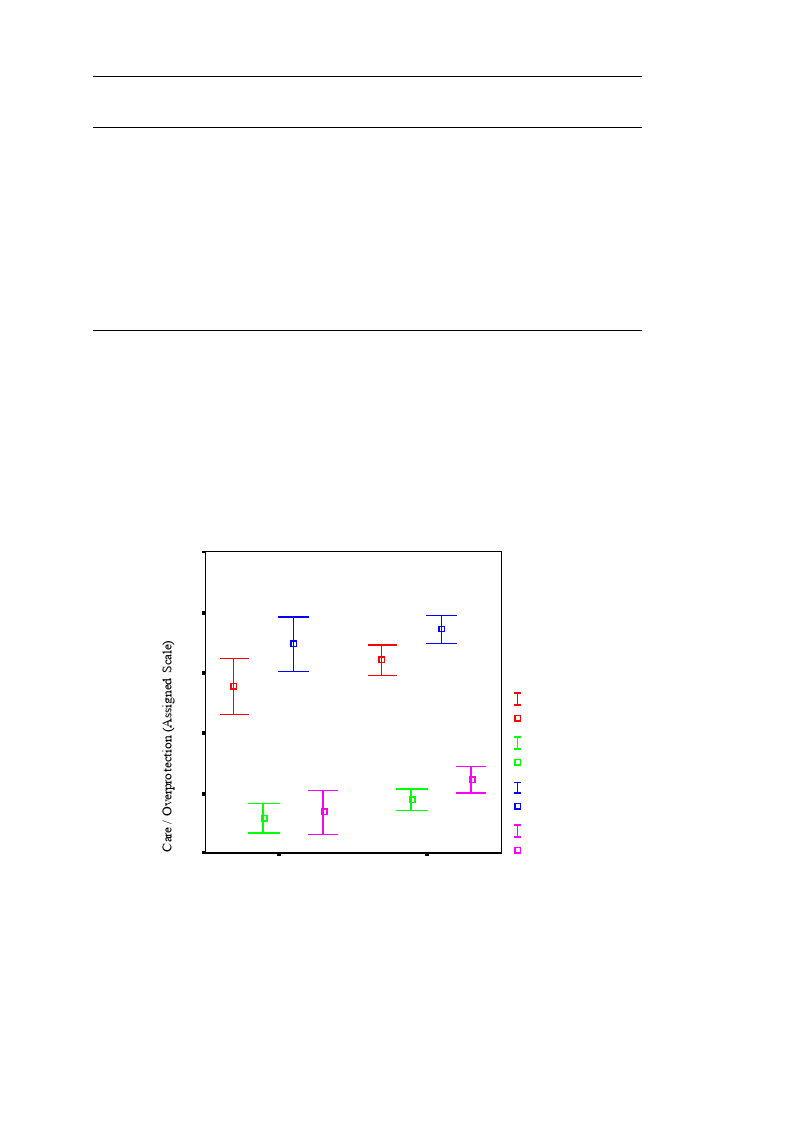
FavPlace
FavPlace
Nature/Not
FavPlace
Home/Away
Paternal
Care
M SD
Favourite place
2.05 .70
No favourite place 2.00 .55
Favourite place in 2.04 .69
nature
Favourite place not 2.17 .89
in nature
Unclassifiable
1.67 .35
Favourite place near 1.89 .74
home
Favourite place 2.11 .68
away from home
Unclassifiable
2.08 .74
Paternal Maternal Maternal
Overprotection Care Overprotection
M SD M SD M SD
.90 .47 2.29 .69 1.03 .60
.90 .45 2.27 .54 1.06 .57
.89 .43 2.27 .70 1.03 .58
.79 .56 2.58 .55 .90 .59
1.09 .25 1.79 .18 1.08 .11
.79 .40 2.19 .81 .86 .59
.95 .46 2.34 .62 1.11 .57
.80 .40 2.29 .75 .94 .57
Table 6.12: Favourite place variables by parental attachment factor scores
The MANOVA tests revealed a significant interaction between favourite place proximity
and maternal overprotection, with F (1, 154) = 5.56, p < .05. Figure 6.1 reveals that a
favourite place away from home relates to significantly higher maternal overprotection.
There is also a pattern of higher scores on all factors, for both parents, for those with a
favourite place away from home.
3.0
2.5
2.0
FCare Score
1.5
FOverpro Score
1.0
MCare Score
.5
N=
42
42
42
42
Favourit e place near
109 109 109 109
Favourit e place away
Favour ite Plac e Home/Awa y
MOverpro S core
Figure 6.1: Favourite place location versus parental attachment factor scores
162
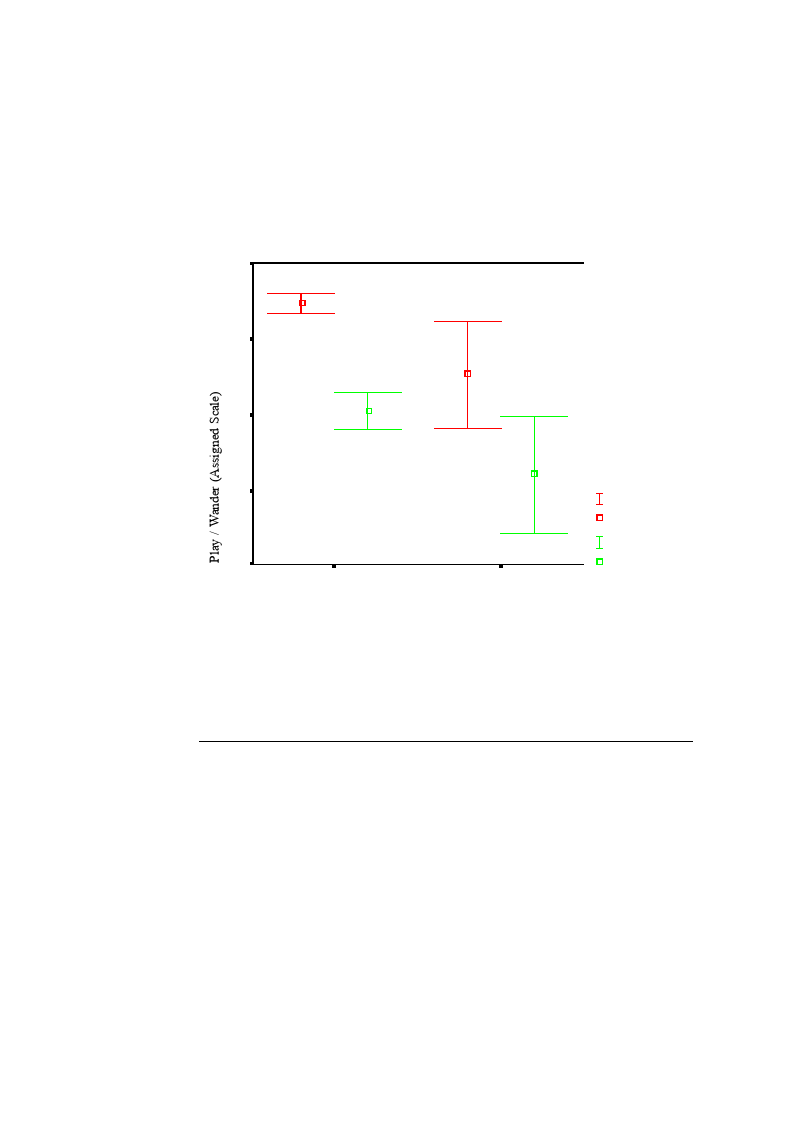
Among other ‘exploration’ variables, the MANOVA test reveals a significant relationship
between paternal overprotection and play at F (40, 240) = 1.43, p = .05, and both play (p <
.01) and wander (p < .05) correlate negatively. Figure 6.2 reveals that low overprotection is
associated with higher play and wander.
4.0
3.5
3.0
2.5
ParkP lay
2.0
N=
251
251
Low overprotection
Paternal Over protec tion
30
30
High overprot ection
Wander
Figure 6.2: Play / Wander versus paternal overprotection
6.1.8 Attachment versus other selected attitude and behaviour measures
Finally, a series of separate ANOVA tests were performed for attachment status versus
selected attitudinal (relative sympathy category of 3 and of 4, ecoevaluation maximum
variance, ecoemotionality maximum variance) and unexamined behavioural (parental
ecoactivity category, adult ecoactivity category, outdoorsiness category) measures, for both
mother and father (see chapter 5 for derivation of all these factors). Collated sum of squares
tables for the variables tested are to be found at Appendices 11.3.1.7 and 11.3.1.8.
163

6.1.8.1 Paternal attachment status
Only EcoActiveNow (= adult ecoactivity) category is significant versus paternal
attachment (F = 2.91, p <.05). To examine this interaction, the relevant simple effects were
calculated. The analysis revealed that there was a significant difference between the adult
ecoactivity scores for participants who showed secure attachment status and participants who
showed absent bonding attachment status, with the latter exhibiting higher adult ecoactivity.
Further analysis using the MANOVA test with variables paternal care, paternal
overprotection, and adult ecoactivity revealed a significant relationship (F = (38, 58) 2.17, p
< .01), in which the higher the level of adult ecoactivity, the lower the paternal care score.
6.1.8.2 Maternal attachment status
No measures were significant versus Maternal Attachment.
6.1.9 Other notable results
Further tests examined the relationship between attachment factor scores care and
overprotection for each parent, and other factors. None proved significant or notable apart
from the following.
6.1.9.1 Maternal care and sample sub-group
There are differences between sample sub-groups with regard to maternal care score.
Whilst the mean for the whole sample falls as would be expected from the norm amongst all
general populations squarely into the secure/optimal bonding quadrant of the PBI (Care
score >1.5; Overprotection score < 1.5), and the mean for each of the sample sub-groups
falls into the same quadrant, a single sub-group is different. Compared to the other sub-
groups, the CHE Sample Sub-group has conspicuously low maternal care and high maternal
overprotection scores, placing the group mean in the weak bonding/dismissing avoidant
category and close to the affectionless control/fearful (Bartholomew 1997; Parker, Tupling et
al. 1979) attachment category.
164
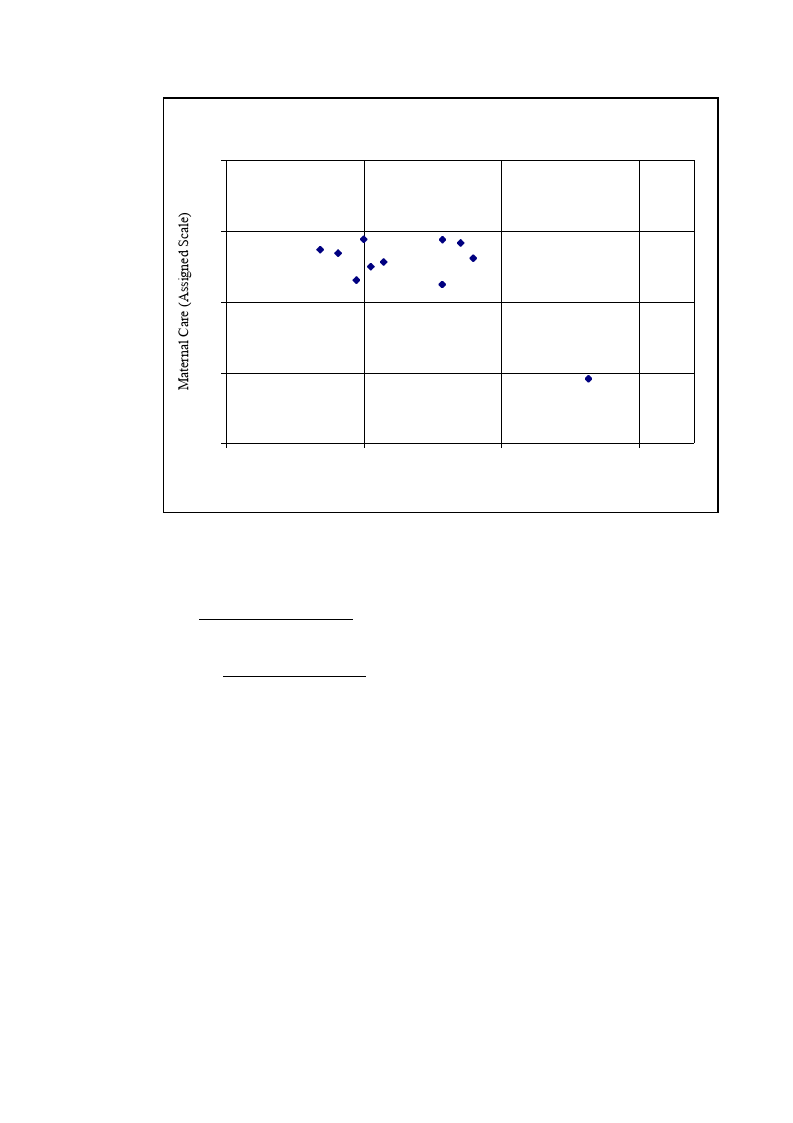
Sample Sub-group
3
2.5
Farm
Forest
Econ
Biotech
Quango
MEAN
ALL
Elect
VUB
Ecorad
Choir
2
1.5
CHE
1
0.75
1
1.25
1.5
Maternal Overprotection (Assigned Scale)
Figure 6.3: Maternal Attachment Status versus Sample Sub-group
6.1.10 Summary of findings
6.1.10.1 Paternal attachment
• Ecoevaluation status ecocentric differs according to paternal attachment status:
further investigation show that there is a close to significant (p =.058) negative
correlation between attachment factor paternal care and the ecoevaluation factor
ecocentric;
• Ecoemotionality nature secure differs according to paternal attachment;
• Environment sympathy is negatively correlated with paternal care;
• Subjects with absent bonding attachment status have higher adult ecoactivity
levels than those with secure attachment status;
• The lower the paternal care score, the higher the adult ecoactivity level;
165

• There is a significant relationship, between paternal overprotection and play, with
low overprotection correlated with higher play and wander.
6.1.10.2 Maternal attachment
• Ecoevaluation factor ecocentric is close to significantly different (p = .057)
between those with maternal attachment status secure and affectionless control;
• Maternal care has a significant negative correlation (p = .054) with ecoevaluation
factor ecocentric (similar to the paternal situation);
• Ecoemotionality nature stoic differs according to maternal attachment status;
• Maternal overprotection is correlated with ecoemotionality factors fearful and
stoic (negative); maternal care is correlated with ecoemotionality dismissive;
• Maternal care has a close to significant negative correlation (p = .057) with
environment sympathy;
• Mean attachment status of the whole sample and of all sample sub-groups is
secure bonding, except for sub-group CHE, which is dismissing avoidant;
• Higher maternal overprotection is significantly related to favourite place away
from rather than near home;
• All attachment factor scores, for both parents, are higher (though mostly non-
significantly) for those whose favourite place was away from home.
166

6.2 Hypothesis two: Adult attitudes to nature are affected by
direct contact with nature as a child
The second hypothesis concerns the first of Kellert’s (1996; 2002) three domains of
childhood nature experience, ‘direct’ experience (which appears strongly coincident with
both Cobb and Chawla’s ‘ecstatic places’ and Palmer et al’s ‘experiences of the natural
world’), postulating that there is a relationship between the attitudes to nature held by adult
respondents, and their experiences of first-hand contact with nature as a child.
In order to test this hypothesis, two sets of relationships were analysed. First, the
relationships between the two attitude to nature scales, the relative sympathies scale and the
childhood variable place of residence was assessed (this latter variable was employed as a
proxy for the prevalence of nature close to the child’s home: the variables garden and park
near, and their combined index access to greenery, were not used as over 92.2% of sample
respondents answered yes to the first, 95.9% to the second, and in combination the
proportion of children who had one or the other was 98.6%, rendering analysis or presence-
versus-absence statistically unreliable).
Second, the relationships between the same set of attitude and relative sympathies scales
and primarily the childhood variables play, wander, and favourite place (describing
respectively how often the adult played outside as a child, recalled wandering more than 20
minutes from home, and recalled having had a favourite place) were assessed (see chapter 5
for detail on how the attitude scales and nature interaction variables were derived).
6.2.1 Accessible nature and attitudes to nature
This set of tests examined the relationship between overall accessibility of nature to the
child as represented by the variable place of residence and, by turns, ecoevaluations,
ecoemotionality and relative sympathies.
6.2.1.1 Accessible nature and ecoevaluation
The first test was a mixed 2-way MANOVA, with the between subjects independent
variable being place of residence (urban, rural, farm) and the within subjects dependent
167

variable being ecoevaluation status represented by the four factor scores derived from the
ecoevaluation scale (technocentric, anthropocentric, conservationist, ecocentric). The mean
values for these four factor scores by attachment status are shown in the following Table.
Urban
Rural
Farm
Technocentric
M
SD
-.12
1.05
.03
.95
.25
.90
Anthropocentric
M
SD
-.01
1.04
-.18
.97
.22
.90
Conservationist
M
SD
.07
1.04
.11
.91
-.29
.94
Ecocentric
M SD
.01 1.04
.05 .90
-.08 1.00
Table 6.13: Childhood residence by ecoevaluation factor scores
The MANOVA test revealed that there was a significant interaction between place of
residence and ecoevaluation factor conservationist with F (2, 229) = 2.99, p = .052 (the sum
of squares table for this analysis is shown at Appendix 11.3.2.1).
To examine this interaction, the relevant simple effects were calculated. The results
showed a significant difference for subjects with childhood place of residence farm between
ecoevaluation factor scores conservationist (low) and technocentric/anthropocentric (high). It
is evident that farm children are particularly highly technocentric and anthropocentric, and
particularly lowly conservationist.
6.2.1.2 Accessible nature and ecoemotionality
The second test was a mixed 2-way MANOVA, with the between subjects independent
variable being place of residence (urban, rural, farm) and the within subjects dependent
variable being ecoemotionality status represented by the four factor scores derived from the
ecoemotionality scale (secure, fearful, dismissive, stoic). The mean values for these four
factor scores by attachment status are shown in the following Table.
Urban
Rural
Farm
Secure
M
SD
.12 1.06
.08
.91
-.38 .85
Fearful
M
SD
.18 1.11
-.20 .78
-.25 .81
Dismissive
M
SD
-.17
.97
-.05
1.08
.50
.82
Stoic
M
SD
-.04 .96
.18
.92
-.08 1.16
Table 6.14: Childhood residence by ecoemotionality factor scores
Examining the results of ecoemotionality factor scores versus place of residence, a
number of distinct trends can be observed. Taking the factors in turn:
168

• For ecoemotionality nature secure there is a falling trend, in which urban and
rural children are similar, whereas farm children display a far lower score;
• For ecoemotionality nature fearful there is also a falling trend, in which urban
children score much more highly than both rural and farm children, who are
similar;
• For ecoemotionality nature dismissive there is a rising trend, in which urban and
rural children seem broadly similar, whereas farm children display much higher
scores.
The MANOVA test revealed that there were significant interactions between place of
residence and ecoemotionality factors nature secure (F (2, 256) = 5.27, p <.01), nature
fearful (F (2, 256) = 5.39, p <.01) and nature dismissive (F (2, 256) = 9.67, p <.01) (the sum
of squares table for this analysis is shown at Appendix 11.3.2.2).
To examine these interactions, the relevant simple effects were calculated. For
ecoemotionality nature secure, there were significant differences between place of residence
rural and farm (p <.01) and between urban and farm (p <.05). For ecoemotionality nature
fearful, there were significant differences between place of residence urban and rural (p
<.05) and between rural and farm (p <.05). Finally for ecoemotionality nature dismissive,
there were significant differences between place of residence urban and farm (p <.01) and
between rural and farm (p <.05).
6.2.1.3 Accessible nature and relative sympathies
The third test was a mixed 2-way MANOVA, with the between subjects independent
variable being place of residence (urban, rural) and the within subjects dependent variable
being relative sympathy status represented by the three factor scores derived from the
relative sympathy scale (environmental, animal, human). The mean values for these three
factor scores by attachment status are shown in the following Table.
Urban
Rural
Farm
Environment Sympathy
M
SD
.16
.96
.12
.99
-.59
.91
Animal Sympathy
M
SD
.00
.88
.02
1.12
-.02
1.17
Human Sympathy
M
SD
.16
1.05
.10
.94
-.55
.71
Table 6.15: Childhood residence by relative sympathy factor scores
169
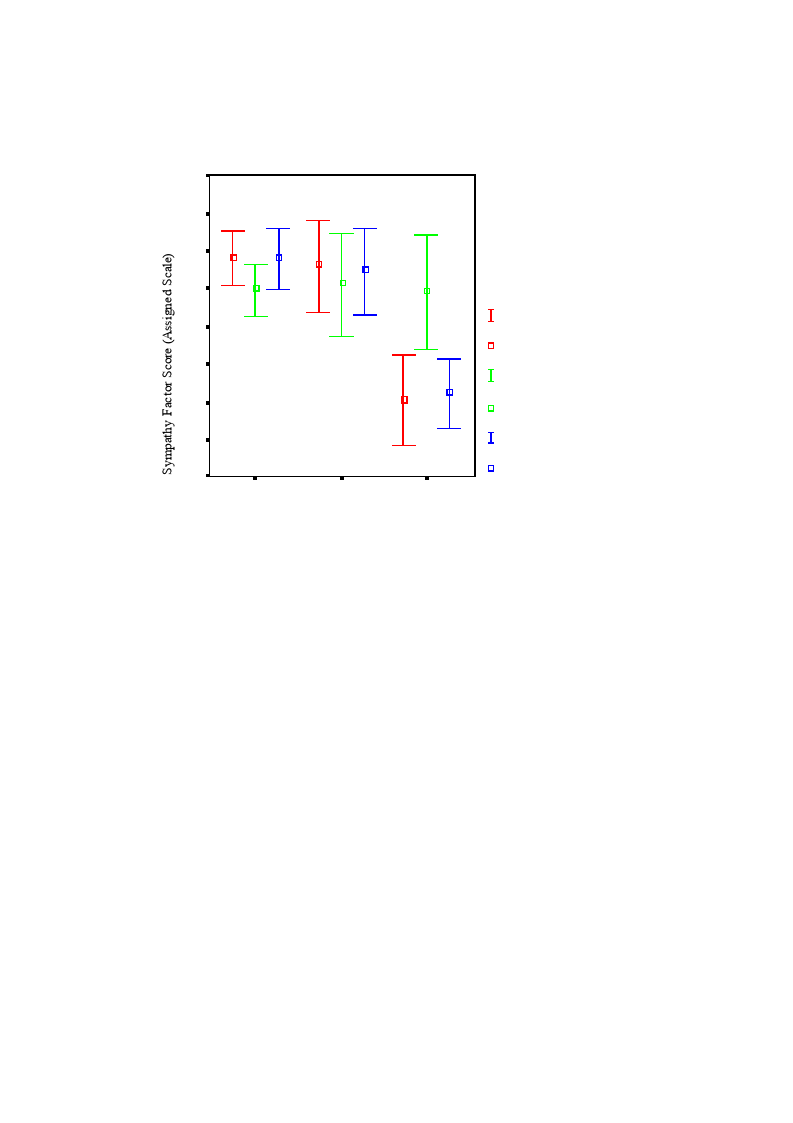
The MANOVA test revealed significant interactions between place of residence and
relative sympathy factors environment (F (2, 283) = 13.92, p <.01), and human (F (2, 283) =
12.18, p <.01) (the sum of squares table for this analysis is shown at Appendix 11.3.2.3).
.6
.4
.2
.0
-.2
F actorSco r e
Envi ronment S ympathy
-.4
-.6
-.8
-1.0
N=
161 161 161
Urban
67 67 67
R ural
Childhood Residenc e
58 58 58
F arm
F actorSco r e
Anim alSympathy
F actorSco r e
Human Sym pathy
Figure 6.4: Childhood residence versus relative sympathy factor scores
Examining Figure 6.4 reveals a distinct picture. For both relative sympathies environment
and human (but, interestingly, not for animal), farm children display far lower scores than
both rural and urban children.
To examine these interactions, the relevant simple effects were calculated. For relative
sympathy environment, there were significant differences between place of residence
urban/rural and farm (for both, p <.01). For relative sympathy human, there were significant
differences between place of residence urban/rural and farm (for both, p <.01).
A number of other demographic variables were analysed for possible relationships with
accessible nature. The significant relationships were as follows.
170

6.2.1.4 Accessible nature and education
The highest education level reached by subjects is found to correlate with both absence of
nearby ‘domesticated’ nature (p < .05) and having inhabited more urbanised and less ‘green’
surroundings (p < .01).
6.2.1.5 Accessible nature and sample sub-groups
Two of the sample sub-groups had notably less access to gardens than the norm,
Electronics and VUB (p < .01). In addition, there were significant differences between the
sample sub-groups in the rate of presence of a park or woods nearby in childhood (p < .05).
As expected, farmers live in greener, more rural environments and tend to have moved
home less (p < .01).
6.2.2 Exploring nature and attitudes to nature
This second set of tests examined the relationship between the degree to which the
subjects played in and explored nature as children (represented by the variables ParkPlay,
Wander, Favourite Place, Favourite Place Description, and Explorer) and, by turns,
ecoevaluations, ecoemotionality and relative sympathies.
Play and exploration behaviour is taken to be activity that is at least to some extent a
voluntary choice made by the child. Clearly, although there is overlap between what parents
allow the child to do and what the child actually does, within those parameters the child will
in most circumstances be able to exercise a degree of choice.
6.2.2.1 Play and ecoevaluation
The first test used was a mixed 2-way MANOVA, with the between subjects independent
variable being frequency of play in nearby parks or woods (never, rarely, sometimes, often)
and the within subjects dependent variable being ecoevaluation status represented by the four
factor scores derived from the ecoevaluation scale (technocentric, anthropocentric,
conservationist, ecocentric). The mean values for these four factor scores by attachment
status are shown in the following Table.
171

Never
Rarely
Sometimes
Often
Technocentric
M
SD
.18
.68
-.43 .87
-.15 .88
.06
1.03
Anthropocentric
M
SD
-.02
.45
.13
.94
.12
.95
-.03
1.02
Conservationist
M
SD
.76
1.20
.28
.91
.08
1.14
-.05
.97
Table 6.16: Play by ecoevaluation factor scores
Ecocentric
M SD
.02 2.15
.09 1.15
.05 .94
-.02 .99
The MANOVA test revealed that there were no significant interactions between
frequency of play and ecoevaluation factors (the sum of squares table for this analysis is
shown at Appendix 11.3.2.4).
6.2.2.2 Play and ecoemotionality
The first test used was a mixed 2-way MANOVA, with the between subjects independent
variable being frequency of play in nearby parks or woods (never, rarely, sometimes, often)
and the within subjects dependent variable being ecoevaluation status represented by the four
factor scores derived from the ecoevaluation scale (technocentric, anthropocentric,
conservationist, ecocentric). The mean values for these four factor scores by attachment
status are shown in the following Table.
Never
Rarely
Sometimes
Often
Secure
M
SD
-.75 2.62
-.10
.90
.00 1.17
.01
.96
Fearful
M
SD
1.30
2.12
.11
.83
.40
1.06
-.10
.96
Dismissive
M
SD
-.82
.49
-.31
1.07
-.20
1.04
.07
.98
Stoic
M
SD
-.18
.29
-.39
.92
-.05
.95
.04
1.02
Table 6.17: Play by ecoemotionality factor scores
172
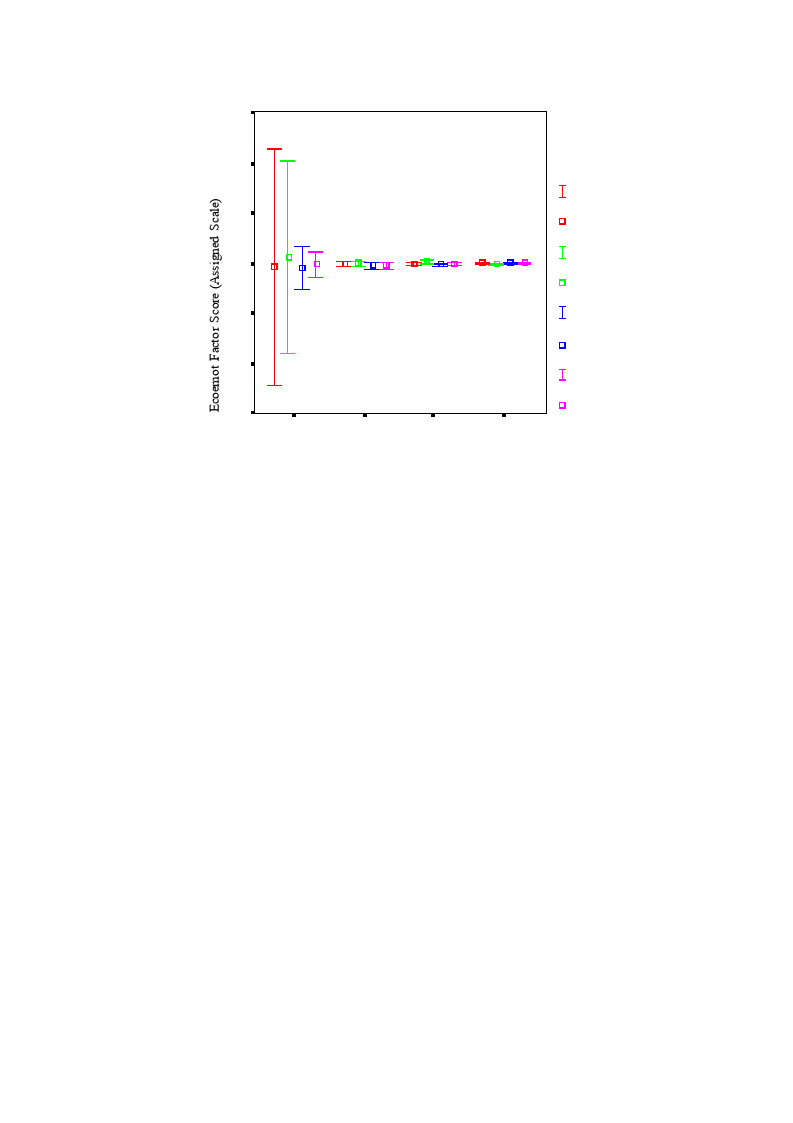
30
20
10
0
-10
-20
-30
N=
22 22
Never
12 12 12 12
R arely
42 42 42 42
S ometimes
203 203 203 203
Often
Play (Freque ncy)
Figure 6.5: Play versus ecoemotionality factor scores
F actorScore
N atureS ec u re
F actorScore
N atureF ea rful
F actorScore
NatureDism issive
F actorScore
N atureS toic
Examining Figure 6.5 it is notable that the confidence intervals for those who never
played in nearby nature are markedly greater than all other groups, particularly for factors
secure and fearful. This may be artefactual, solely due to the smaller numbers in this group
(7) compared to those who played rarely (13), sometimes (53) or often (221), though this
would not alone seem satisfactorily to account for the considerably lesser variance among
those who never played for the factors dismissive and stoic as against secure and fearful; or
it may in part be due to other factors.
The MANOVA test revealed that there was a significant interaction between frequency of
play and ecoemotionality nature fearful with F (3, 255) = 4.32, p <.01) (the sum of squares
table for this analysis is shown at Appendix 11.3.2.5).
To examine this interaction, the relevant simple effects were calculated. The results
showed a significant difference between nature fearful subjects who played in nearby nature
sometimes (high) and often (low) (p < .05).
173

6.2.2.3 Play and relative sympathies
The first test used was a mixed 2-way MANOVA, with the between subjects independent
variable being frequency of play in nearby parks or woods (never, rarely, sometimes, often)
and the within subjects dependent variable being ecoevaluation status represented by the four
factor scores derived from the ecoevaluation scale (technocentric, anthropocentric,
conservationist, ecocentric). The mean values for these four factor scores by attachment
status are shown in the following Table.
Never
Rarely
Sometimes
Often
Environment Sympathy
M
SD
.35
1.33
-.24
.78
-.05
.96
.02
1.01
Animal Sympathy
M
SD
-.68
.14
.01
.66
-.12
.76
.05
1.07
Human Sympathy
M
SD
.42
1.09
.10
1.32
.04
1.07
-.03
.96
Table 6.18: Play by relative sympathy factor scores
The MANOVA test revealed that there were no significant interactions between
frequency of play and relative sympathy factors (the sum of squares table for this analysis is
shown at Appendix 11.3.2.6).
6.2.2.4 Wander and ecoevaluation
The first test used was a mixed 2-way MANOVA, with the between subjects independent
variable being frequency of play in nearby parks or woods (never, rarely, sometimes, often)
and the within subjects dependent variable being ecoevaluation status represented by the four
factor scores derived from the ecoevaluation scale (technocentric, anthropocentric,
conservationist, ecocentric). The mean values for these four factor scores by attachment
status are shown in the following Table.
Never
Rarely
Sometimes
Often
Technocentric
M
SD
.25
.95
-.26
.83
.01
.97
.04 1.09
Anthropocentric
M
SD
.06
1.03
.04
1.03
.07
.84
-.09
1.09
Conservationist
M
SD
.03
.98
-.08
.89
.04
.99
.00
1.07
Ecocentric
M SD
-.06 1.00
.00 .95
.01 1.00
.01 1.03
Table 6.19: Wander by ecoevaluation factor scores
The MANOVA test revealed no significant interactions between frequency of wander and
relative sympathy factors (the sum of squares table is shown at Appendix 11.3.2.7).
174
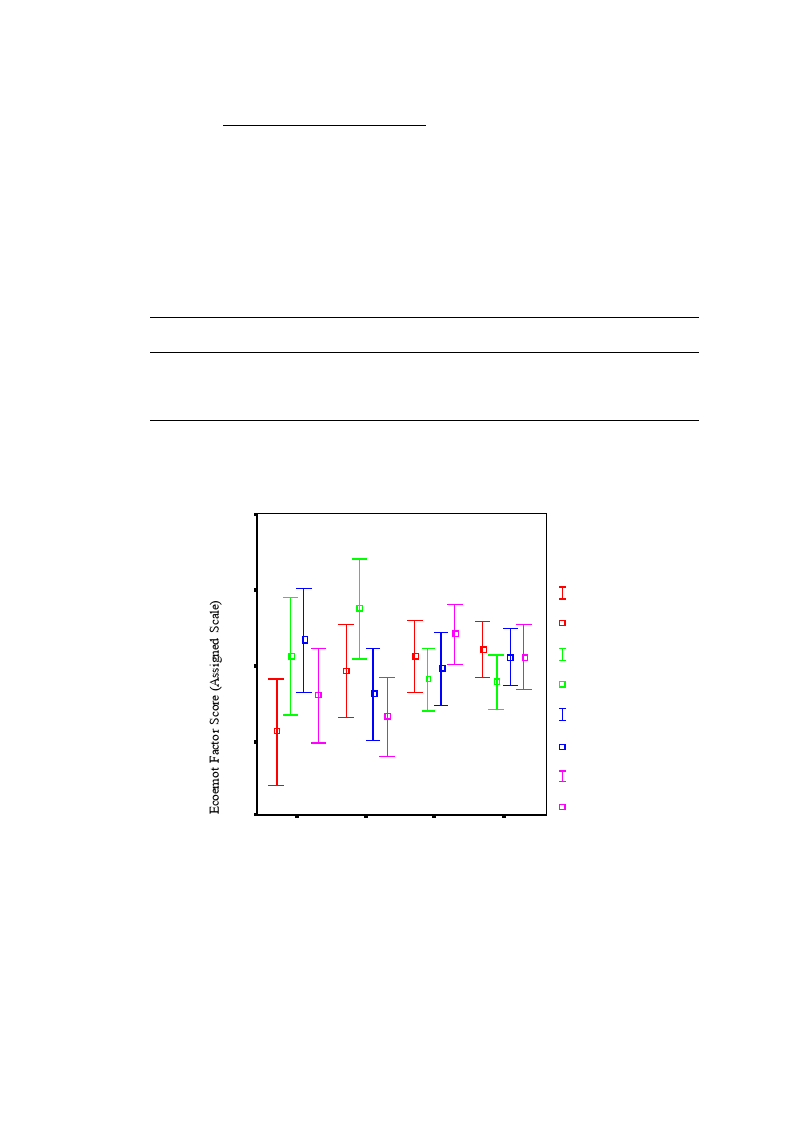
6.2.2.5 Wander and ecoemotionality
The first test used was a mixed 2-way MANOVA, with the between subjects independent
variable being frequency of wander in nearby parks or woods (never, rarely, sometimes,
often) and the within subjects dependent variable being ecoevaluation status represented by
the four factor scores derived from the ecoevaluation scale (technocentric, anthropocentric,
conservationist, ecocentric). The mean values for these four factor scores by attachment
status are shown in the following Table.
Never
Rarely
Sometimes
Often
Secure
M SD
-.44 .94
-.04 1.02
.06 1.04
.10 .96
Fearful
M SD
.06 1.05
.37 1.11
-.09 .94
-.11 .95
Dismissive
M
SD
.17
.93
-.19
1.01
-.03
1.06
.05
.97
Table 6.20: Wander by ecoemotionality factors scores
Stoic
M SD
-.20 .84
-.34 .86
.20 .88
.05 1.13
1.0
.5
F actorScore
N atureS ec u re
0.0
F actorScore
N atureF ea rful
F actorScore
-.5
NatureDism issive
-1.0
N=
30 30 30 30
Never
45 45 45 45
R arely
78 78 78 78
S ometimes
106 106 106 106
Often
Wande r (Freque ncy)
F actorScore
N atureS toic
Figure 6.6: Wander versus ecoemotionality factor scores
175

Most noticeable from Figure 6.6 is the steady rising trend for higher nature secure scores
with rising wander frequency. There also appear to be effects for the other three factors
where increasing exposure to nearby nature from never to rarely causes the mean value to
rise or fall, and greater levels of exposure reverse that trend.
The MANOVA test revealed that there were significant interactions between wander
frequency and ecoemotionality factors nature fearful (F (3, 255) = 2.82, p <.05), and nature
stoic (F (2, 255) = 3.45, p <.05). Nature secure came close at F (2, 255) = 2.48, p <.061 (the
sum of squares table for this analysis is shown at Appendix 11.3.2.8).
To examine these interactions, the relevant simple effects were calculated. For
ecoemotionality nature fearful, there was a significant difference between wander
frequencies rarely and often (p <.05). For ecoemotionality nature stoic, there was a
significant difference between wander frequencies rarely and sometimes (p <.05). Finally for
ecoemotionality nature secure, there was a significant difference between wander frequency
often and never (p <.05).
6.2.2.6 Wander and relative sympathies
The first test used was a mixed 2-way MANOVA, with the between subjects independent
variable being frequency of wander (never, rarely, sometimes, often) and the within subjects
dependent variable being ecoevaluation status represented by the four factor scores derived
from the ecoevaluation scale (technocentric, anthropocentric, conservationist, ecocentric).
The mean values for these four factor scores by attachment status are shown in the following
Table.
Never
Rarely
Sometimes
Often
Environment Sympathy
M
SD
-.32
.80
-.02
.86
.07
1.03
.05
1.08
Animal Sympathy
M
M
-.03
.75
.27
1.21
-.11
.92
-.03
1.01
Human Sympathy
SD
M
.25
1.15
-.06
.93
-.04
.99
-.02
.99
Table 6.21: Wander by relative sympathy factor scores
176
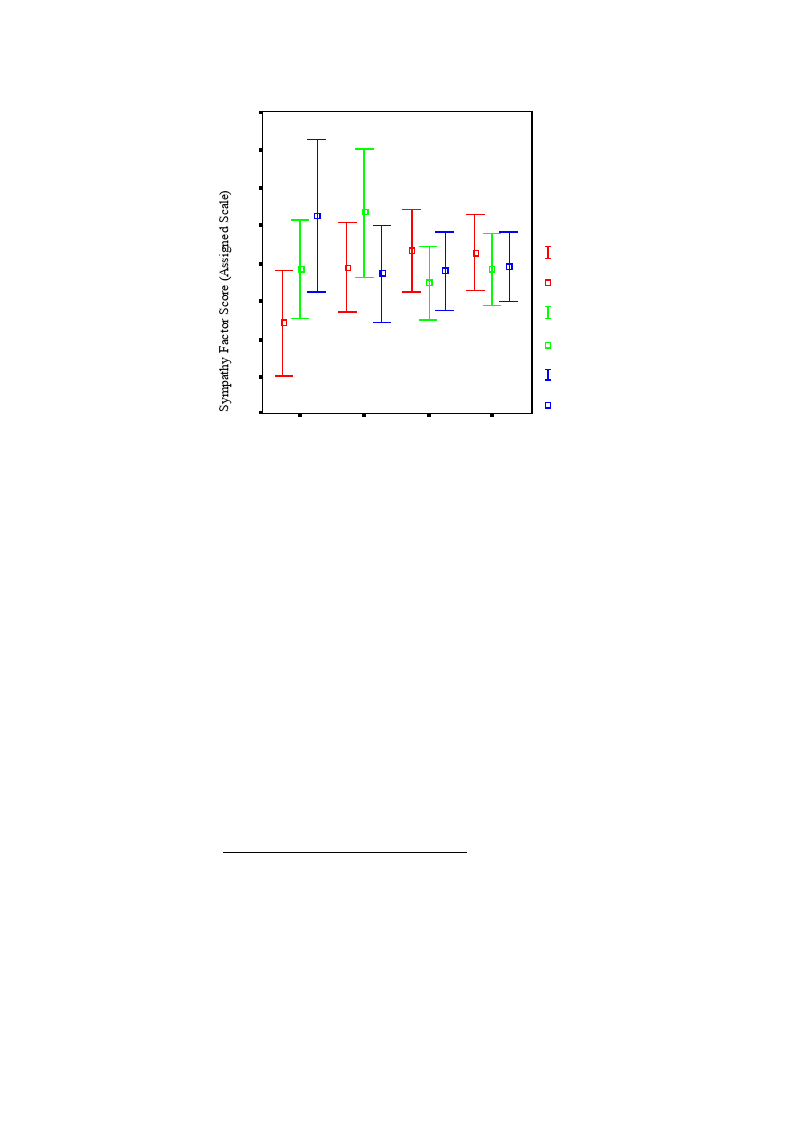
.8
.6
.4
.2
0.0
F actorSco r e
Envi ronment S ympathy
-.2
-.4
-.6
-.8
N=
34 34 34
Never
52 52 52
R arely
87 87 87
S ometime s
113 113 113
Often
Wande r (Freque ncy)
F actorSco r e
Anim alSympathy
F actorSco r e
Human Sym pathy
Figure 6.7: Wander versus relative sympathy factor scores
Reviewing Figure 6.7, the principal observable trend appears to be a steady rise in
environment sympathy with rising wander frequency. It is also observed that those who
never wandered have widely divergent relative sympathies, whereas increasing wander
frequencies appear to coincide with increasingly convergent relative sympathies.
The MANOVA test revealed that there were no significant interactions between place of
residence and ecoevaluation factors (the sum of squares table for this analysis is shown at
Appendix 11.3.2.9).
To examine this interaction, the relevant simple effects were calculated. There was a
significant interaction between wander frequency never and relative sympathies (p < .05)
such that animal sympathy was higher than environmental, and human sympathy greatest.
6.2.2.7 Favourite place and ecoevaluation
This set of tests examined the relationship between having had a favourite place as a child
and ecoevaluation factor scores. Favourite place was analysed in three forms: on the basis of
a yes/no, and (from participant descriptions, on the basis of content analysis) whether that
177

place was in nature or not, or near or away from home (see chapter 5 for full derivations of
these variables). The first tests were a set of 3, mixed 2-way MANOVAs, with the between
subjects independent variables being, respectively, favourite place (yes, no), favourite place
(in nature, not in nature), and favourite place (near home, away from home), and the within
subjects dependent variable being in each case ecoevaluation status represented by the four
factor scores derived from the ecoevaluation scale (technocentric, anthropocentric,
conservationist, ecocentric). The mean values for these four factor scores by favourite place
variables are shown in the following Table.
FavPlace Favourite
place
No favourite
place
FavPlace In nature
Nature/Not
Not in nature
Unclassifiable
FavPlace Near home
Home/Away
Away
from home
Unclassifiable
Technocentric
M SD
-.03 1.04
.08 .92
-.10 1.02
.40 .87
-.92 .
-.19 1.04
-.04 .99
.07 1.03
Anthropocentric
M
SD
-.09 1.03
.20 .93
-.03 1.04
-.58 .89
-.18
.
-.40 .92
.01 1.06
.05 1.04
Conservationist Ecocentric
M
SD M SD
.03 1.02 .09 1.00
-.10 .94 -.17 .96
.05 .98 .08 .98
-.13 1.41 -.10 1.01
-.20
. 2.20 .
.07 .97 .18 1.07
.08 1.01 .04 1.00
-.21 1.16 .04 .89
Table 6.22: Favourite place variables by ecoevaluation factor scores
178
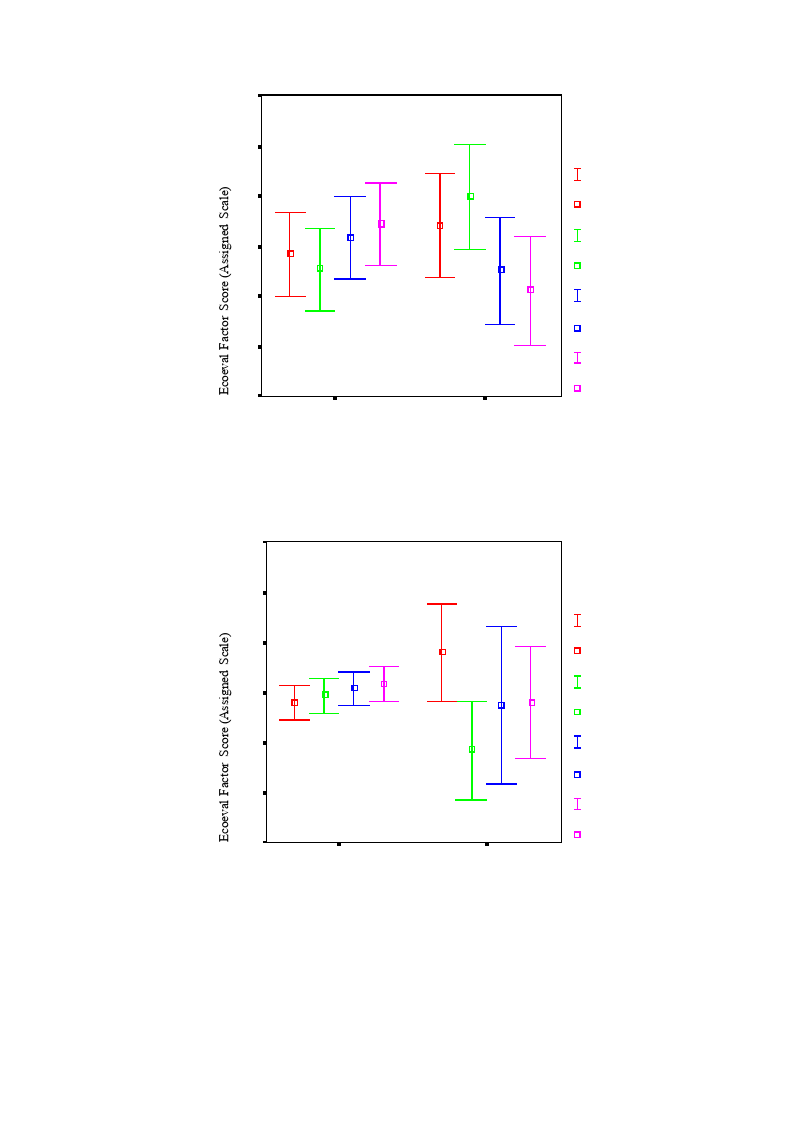
.6
.4
.2
FactorScore
Te chnocentric
-.0
-.2
-.4
-.6
N=
150 150 150 150
Favourit e place
Favour ite Plac e
78
78
78
78
No favourit e place
FactorScore
Anthropocentric
FactorScore
Conservationist
FactorScore
Ecocentric
Figure 6.8: Favourite place versus ecoevaluation factor scores
1.5
1.0
.5
FactorScore
Te chnocentric
0.0
-.5
-1.0
-1.5
N=
132 132 132 132
Favourit e place in n
15
15
15
15
Favourit e place not
Favour ite Plac e in Natur e / Not
FactorScore
Anthropocentric
FactorScore
Conservationist
FactorScore
Ecocentric
Figure 6.9: Favourite place location versus ecoevaluation factor scores
179
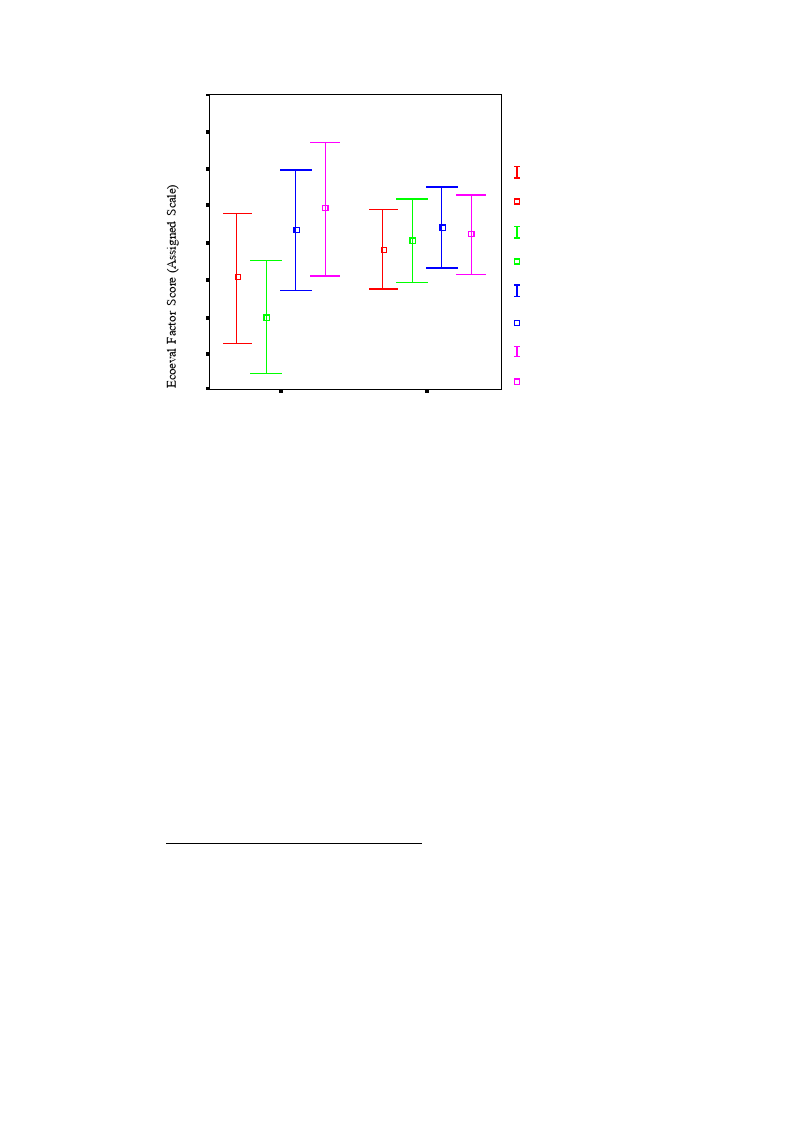
.8
.6
.4
FactorScore
.2
Te chnocentric
0.0
-.2
-.4
-.6
-.8
N=
36
36
36
36
Favourit e place near
86
86
86
86
Favourit e place away
Favour ite Plac e Home / Awa y
FactorScore
Anthropocentric
FactorScore
Conservationist
FactorScore
Ecocentric
Figure 6.10: Favourite place proximity versus ecoevaluation factor scores
Examining Figure 6.8, Figure 6.9 and Figure 6.10 it is apparent that having a favourite
place near home and not in nature is most associated with lowered anthropocentrism, whilst
not having had a favourite place, or having had a favourite place that was in nature and away
from home, is associated with raised anthropocentrism.
The MANOVA tests revealed that there were significant interactions between favourite
place and ecoevaluation factors. Having had a favourite place or not interacted with
ecoevaluation factor anthropocentric with F (1, 226) = 4.22, p < .05 (and came close with
ecocentric at p = .058). Favourite place being in nature or not had no significant interactions
with ecoevaluation factors, although anthropocentric came very close at F (1, 145) = 3.88, p
< .051. Favourite place being near or away from home also significantly interacted with
anthropocentric with F (1, 120) = 4.19, p < .05.
6.2.2.8 Favourite place and ecoemotionality
This set of tests examined the relationship between having had a favourite place as a child
and ecoemotionality factor scores. Favourite place was analysed in three forms: on the basis
of a yes/no, and (from participant descriptions, on the basis of content analysis) whether that
place was in nature or not, or near or away from home (see chapter 5 for full derivations of
180
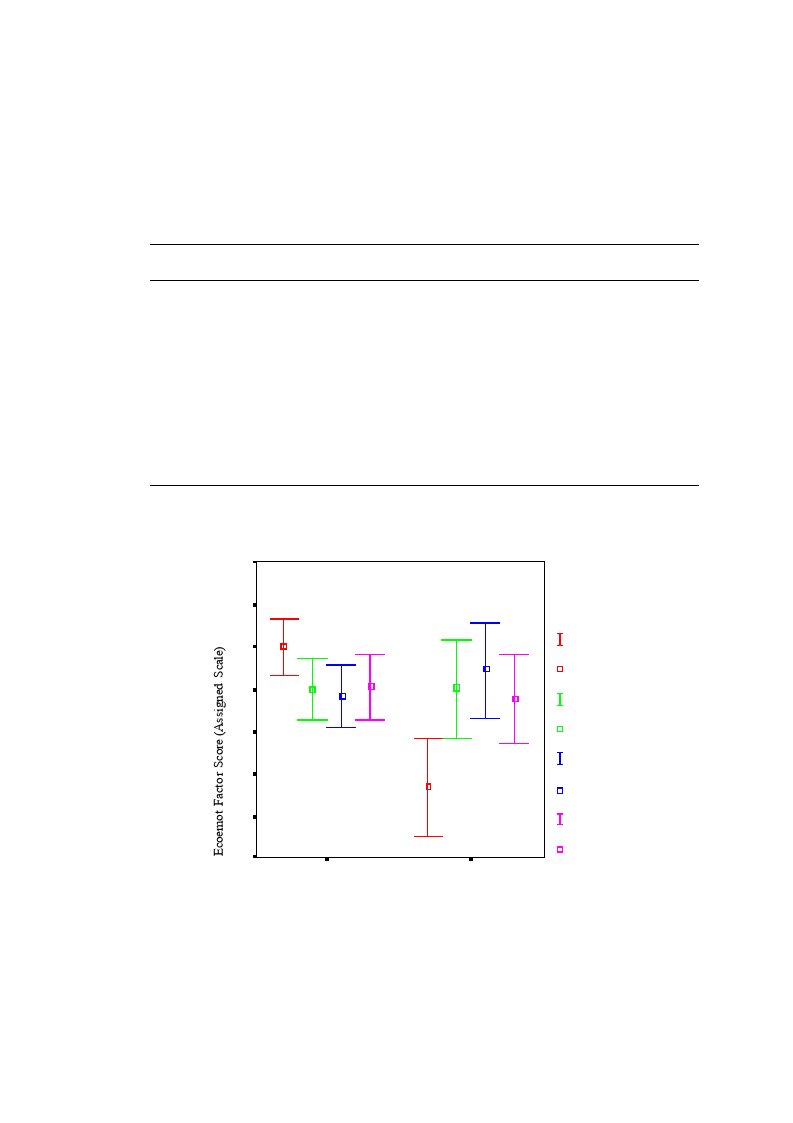
these variables). The first tests were a set of 3, mixed 2-way MANOVAs, with the between
subjects independent variables being, respectively, favourite place (yes, no), favourite place
(in nature, not in nature), and favourite place (near home, away from home), and the within
subjects dependent variable being in each case ecoemotionality status represented by the four
factor scores derived from the ecoemotionality scale (secure, fearful, dismissive, stoic). The
mean values for these factor scores by favourite place variables are shown in Table 6.23.
FavPlace Favourite place
No
favourite place
FavPlace In nature
Nature/Not
Not in nature
Unclassifiable
FavPlace Near home
Home/Away
Away
from home
Unclassifiable
Secure
M SD
.20 .92
-.46 1.02
.24 .89
-.24 1.03
-.88 .
-.01 .94
.28 .90
.16 .91
Fearful
M SD
.00 .99
.00 1.03
-.01 .99
-.05 .97
1.34 .
.13 .93
.02 1.05
-.28 .76
Dismissive
M SD
-.03 1.00
.09 .99
-.08 1.00
.19 1.03
.46 .
-.51 .90
.04 1.02
.27 .87
Stoic
M SD
.01 1.03
-.05 .92
.07 1.03
-.21 .77
-.32 .
-.05 .85
.08 1.08
.06 .95
Table 6.23: Favourite place variables by ecoemotionality factors scores
.6
.4
.2
F actorScore
N atureS ec u re
0.0
F actorScore
-.2
N atureF ea rful
-.4
-.6
-.8
N=
180 180 180 180
Favourit e place
Favour ite Plac e
77
77
77
77
No favourit e place
F actorScore
NatureDism issive
F actorScore
N atureS toic
Figure 6.11: Favourite place versus ecoemotionality factor scores
181
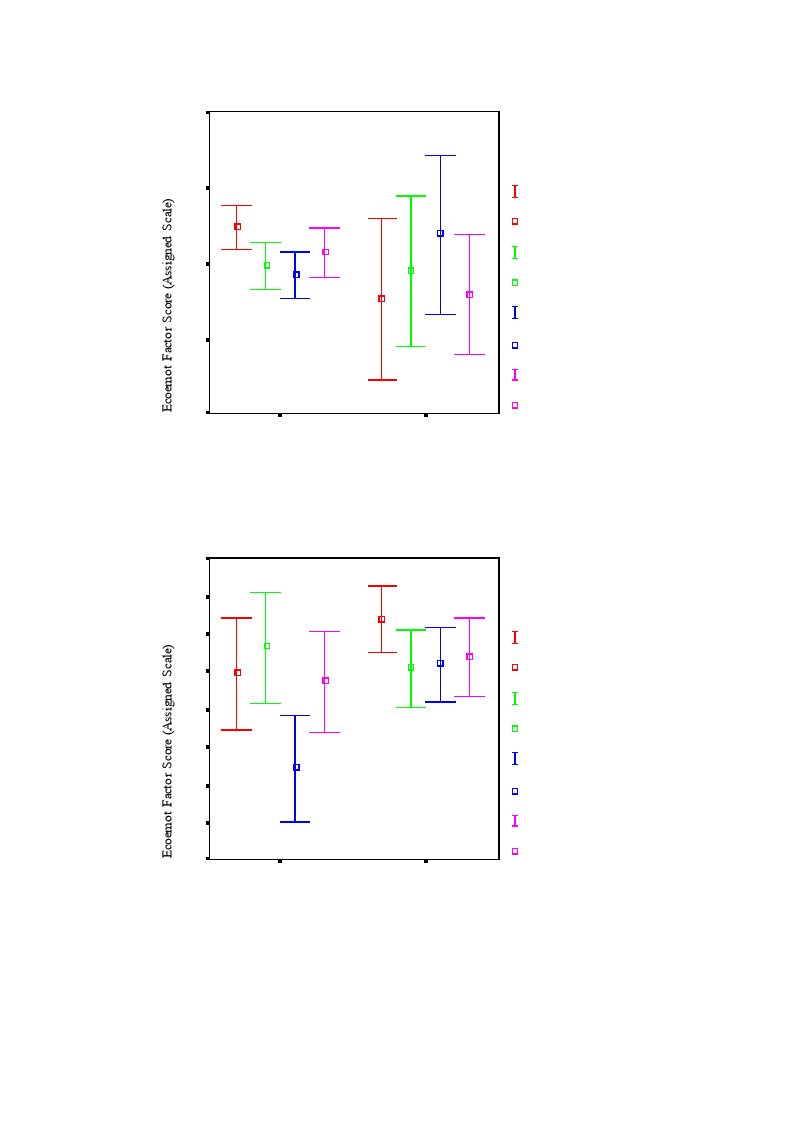
1.0
.5
F actorScore
N atureS ec u re
0.0
F actorScore
N atureF ea rful
F actorScore
-.5
NatureDism issive
-1.0
N=
159 159 159 159
Favourit e place in n
17
17
17
17
Favourit e place not
Favour ite Plac e in Natur e / Not
F actorScore
N atureS toic
Figure 6.12: Favourite place location versus ecoemotionality factor scores
.6
.4
.2
F actorScore
.0
N atureS ec u re
-.2
-.4
-.6
-.8
-1.0
N=
41
41
41
41
Favourit e place near
105 105 105 105
Favourit e place away
Favour ite Plac e Home / Awa y
F actorScore
N atureF ea rful
F actorScore
NatureDism issive
F actorScore
N atureS toic
Figure 6.13: Favourite place proximity versus ecoemotionality factor scores
182

The MANOVA tests revealed that there were significant interactions between favourite
place and ecoemotionality factors. Having had a favourite place or not interacted with
ecoevaluation factor nature secure with F (1, 255) = 26.24, p < .01. Favourite place being in
nature or not also interacted with ecoevaluation factor nature secure with F (1, 174) = 4.29, p
< .05. Favourite place being near or away from home interacted with ecoevaluation factor
nature dismissive with F (1, 144) = 9.21, p < .01.
Examining Figure 6.11, Figure 6.12 and Figure 6.13, low ecoemotionality factor nature
secure relates strongly to not having had a favourite place, and less dramatically to the place
not being in nature. Low ecoemotionality nature dismissive relates strongly to having had a
favourite place near home.
Some caution must be exercised with regard to the above conclusions which involve
distinctions about favourite place since there was an overall strong propensity for favourite
places to be in nature (89%) and away from home (72%).
6.2.2.9 Favourite place and relative sympathies
This set of tests examined the relationship between having had a favourite place as a child
and relative sympathy factor scores. Favourite place was analysed in three forms: on the
basis of a yes/no, and (from participant descriptions, on the basis of content analysis)
whether that place was in nature or not, or near or away from home (see chapter 5 for full
derivations of these variables). The first tests were a set of 3, mixed 2-way MANOVAs, with
the between subjects independent variables being, respectively, favourite place (yes, no),
favourite place (in nature, not in nature), and favourite place (near home, away from home),
and the within subjects dependent variable being in each case relative sympathy status
represented by the four factor scores derived from the relative sympathy scale (human,
animal, environment). The mean values for these four factor scores by favourite place
variables are shown in the following Table.
183
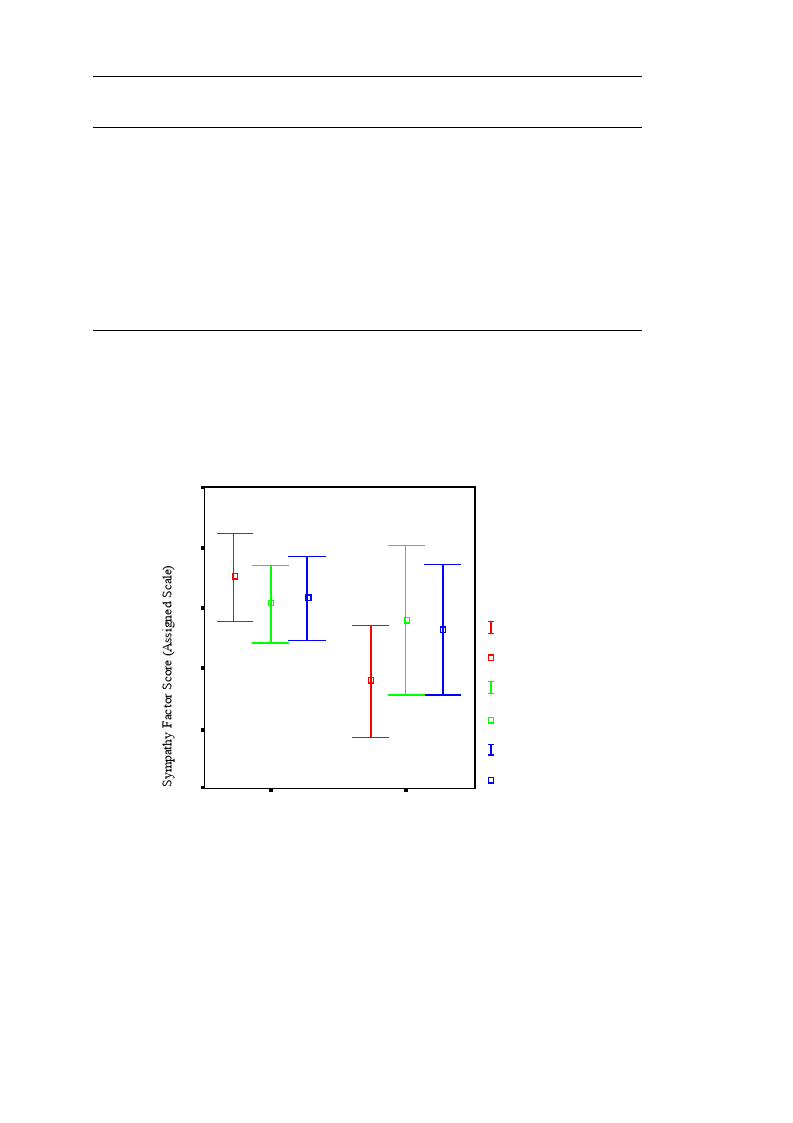
FavPlace Favourite place
No favourite place
FavPlace Favourite place
Nature/Not in nature
Favourite place
not in nature
Unclassifiable
FavPlace Favourite place
Home/Away near home
Favourite place
away from home
Unclassifiable
Environment
Sympathy
M
SD
.10
1.02
-.24
.89
.13
1.02
Animal Sympathy Human Sympathy
M
M
SD
M
.01
.91
.03
.99
-.04 1.18 -.07 1.04
.03
.92
.04
.96
.02
1.00
-.03
.83
.08
1.23
1.76
.
-.73
.
.54
.
.13
.88
.21
.92
.07
.88
.14
1.08
-.02
.92
.00
.99
.07
.99
-.07
.87
.21
1.08
Table 6.24: Favourite place variables by relative sympathy factor scores
The MANOVA tests revealed one interaction: having had a favourite place or not
interacted significantly with relative sympathy factor environment with F (1, 281) = 7.61, p
< .01.
.4
.2
-.0
F actorSco r e
-.2
Envi ronment S ympathy
F actorSco r e
-.4
Anim alSympathy
-.6
N=
193
193
193
Favourit e place
Favour ite Plac e
90
90
90
No favourit e place
F actorSco r e
Human Sym pathy
Figure 6.14: Favourite place versus relative sympathy factor scores
Examining Figure 6.14 it is clear that not having had a favourite place relates strongly to
lower environment sympathy.
184
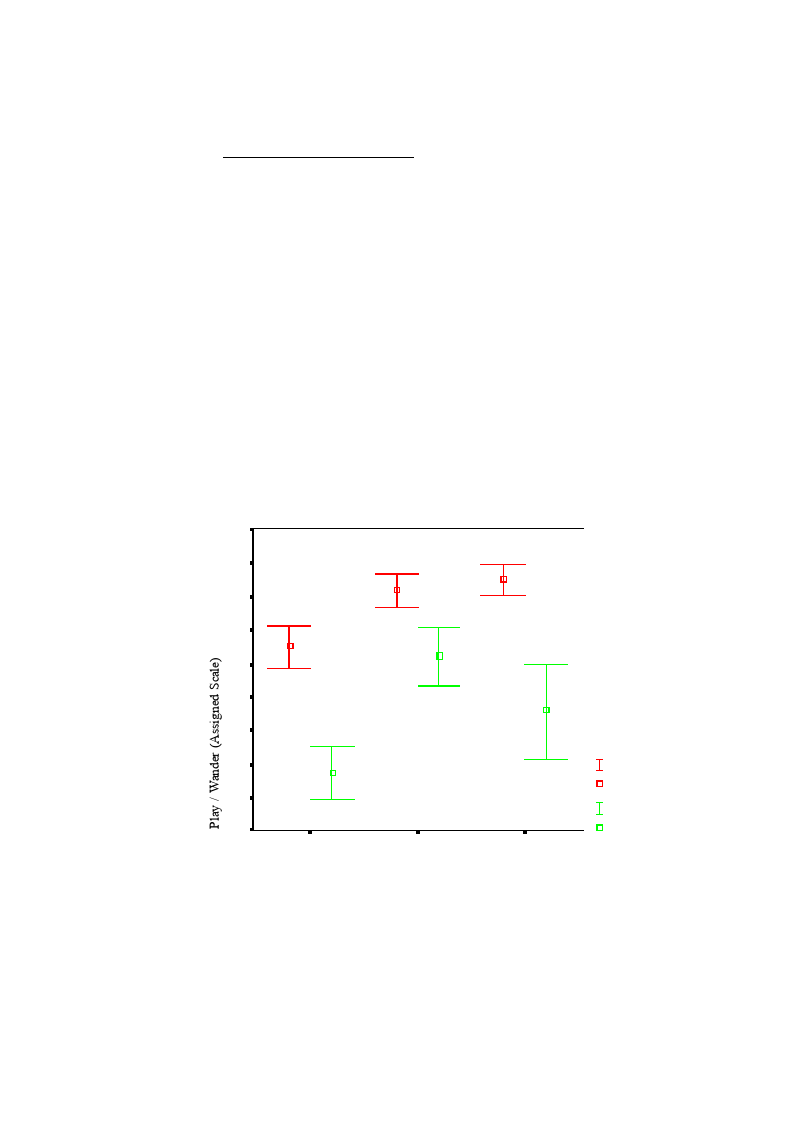
Analyses were also performed for exploratory behaviour versus childhood place and age.
6.2.2.10 Exploring nature and place
This concerns the relationship between the child behaviours of play and wander, and both
the child’s place and subjects’ adult residence.
A univariate ANOVA was performed for frequency of both play and wander versus
childhood place, revealing a significant interaction between place and play (F (3, 277) =
3.82, p < .05), and for play a simple effect between play sometimes and often (p < .05), but
none for wander. (There was, as would be expected, a significant correlation (p < .01)
between play and wander: children who play outdoors near home more often are more likely
to wander further from home than those who play less outdoors.)
Figure 6.15 reveals a rising trend for play with increasing rurality. Wander behaviour is
greater among rural than urban children, decreasing non-significantly among farm children.
The trends for play and wander by childhood place (Figure 6.16 and Figure 6.17) are
revealing.
4.2
4.0
3.8
3.6
3.4
3.2
3.0
2.8
2.6
2.4
N=
165
165
Urban
Childhood Residenc e
68
68
R ural
61
61
F arm
ParkP lay
Wander
Figure 6.15: Mean play / wander frequency versus childhood residence
185
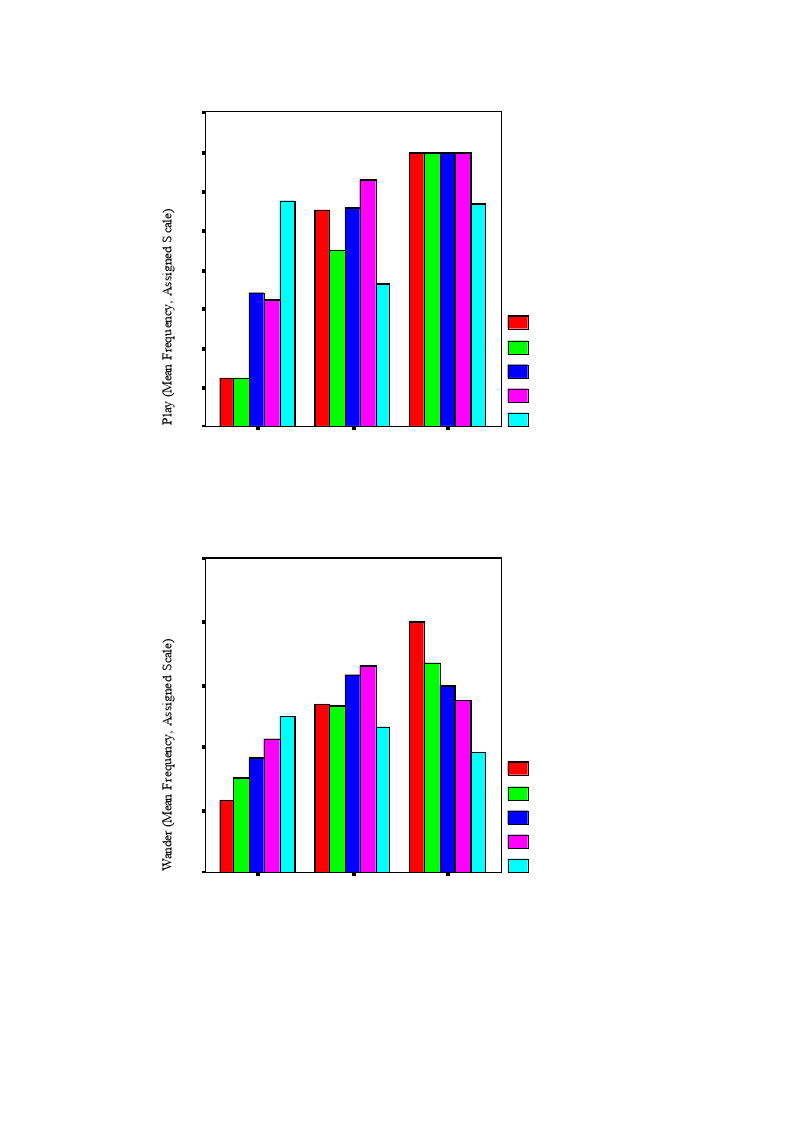
4.1
4.0
3.9
3.8
3.7
3.6
3.5
3.4
3.3
Urban
R ural
Childhood Residenc e
F arm
Live Now
City
Town
Vil lage
Country not farm
F arm
Figure 6.16: Play frequency versus childhood residence, by adult residence
4.5
4.0
3.5
3.0
2.5
2.0
Urban
R ural
Childhood Residenc e
F arm
Live Now
City
Town
Vil lage
Country not farm
F arm
Figure 6.17: Wander frequency versus childhood residence, by adult residence
186
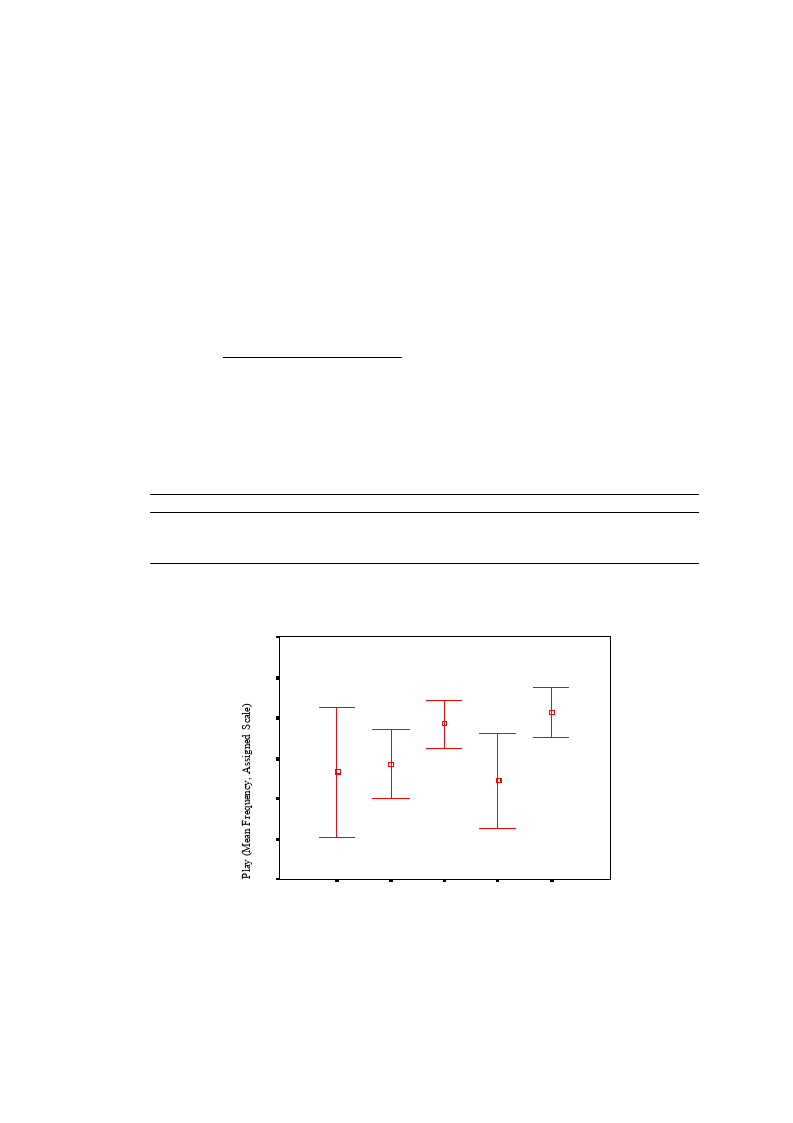
It appears that the more frequently urban children played in accessible nature, the more
likely they are to go on as adults to live in a rural or farm location. Rural children reveal no
singular trend. Farm children have almost universally high frequencies of playing outdoors
near home, wherever they go on to live as adults.
The pattern appears much the same for wander, with the tendency for urban children who
wandered more to go on to live in more rural locations. In this case, however, contrary
movement is also indicated in farm children: the more frequently they wandered more than
20 minutes from home, the greater their tendency to move to a more urban location as adults
(equally, the less frequently they wandered, the more likely they are to stay on the farm).
6.2.2.11 Exploring nature and age
In ANOVA tests of age band versus childhood play and wander, there were significant
differences for play (F = 2.92, p < .05) and wander (F = 3.85, p < .01). Against age band,
there is a significant correlation (p < .01) for wander.
AgeBand
Pearson Correlation
Sig. (2-tailed)
N
ParkPlay
.100
.085
294
Table 6.25: Age band versus play and wander
4.2
4.0
3.8
3.6
3.4
3.2
3.0
N=
30
24 and under
Age Band
70
25-34
78
35-44
53
45-54
63
55 and ove r
Figure 6.18: Age band versus mean play
Wander
.189
.001
294
187

4.0
3.5
3.0
2.5
2.0
1.5
N=
30
24 and under
Age Band
70
25-34
78
35-44
53
45-54
63
55 and over
Figure 6.19: Age band versus mean wander
Examination of the figures reveals that there is a trend to more play and wander with
greater age, with one exception. Whilst - as expected given progressive urbanization - there
appears to be a declining likelihood of playing in accessible nature over the course of the
second half of the twentieth century, there is a dip in play for the 45-54 age group (the age
cohort most likely to have been young children in the immediate post war years).
6.2.3 Summary of findings
• Significant interaction between place of residence and ecoevaluation factor
conservationist. Significant difference for subjects with residence farm between
ecoevaluation factor conservationist (low) and technocentric/anthropocentric
(high).
• Significant interactions between place of residence and ecoemotionality factors
nature secure, nature fearful and nature dismissive.
• For ecoemotionality nature secure there is a falling trend, in which urban and
rural children are similar, whereas farm children display a far lower score;
188

• For ecoemotionality nature fearful there is also a falling trend, in which urban
children score much more highly than both rural and farm children, who are
similar;
• For ecoemotionality nature dismissive there is a rising trend, in which urban and
rural children seem broadly similar, whereas farm children display much higher
scores.
• For relative sympathy environment, significant differences between residence
urban/rural and farm. For relative sympathy human, significant differences
between place of residence urban/rural and farm. For both relative sympathies
environment and human, farm children display far lower scores than both rural
and urban children.
• Education level reached correlates with both absence of nearby ‘domesticated’
nature and having inhabited more urbanised, less ‘green’ surroundings.
• Significant variance between sample sub-groups in terms of access to gardens
and presence of a park or woods nearby in childhood.
• Farmers live in greener, more rural environments and tend to have moved home
less.
• Significant interaction between play frequency and ecoemotionality nature
fearful. Significant difference between fearful subjects who played in nature
sometimes (high) and often (low).
• For those with play frequency sometimes, ecoemotionality nature fearful is
significantly higher than dismissive.
• Significant interactions between wander frequency and ecoemotionality factors
nature fearful, and nature stoic. Nature secure came close (p <.061).
• For ecoemotionality nature fearful, significant difference between wander rarely
and often. For nature stoic, significant difference between wander rarely and
sometimes. For nature secure, significant difference between wander often and
never.
• For wander frequency rarely, ecoemotionality nature fearful is significantly
higher than stoic.
• Steady rising trend for higher nature secure scores with rising wander frequency.
• Steady rise in environment sympathy with rising wander frequency. Those who
never wandered have widely divergent relative sympathies.
189

• Having had a favourite place or not interacted with ecoevaluation factor
anthropocentric (and came close with ecocentric). Favourite place being in nature
or not had no significant interactions with ecoevaluation factors, although
anthropocentric came close (p < .051). Favourite place being near or away from
home also significantly interacted with anthropocentric.
• Having a favourite place near home and not in nature is associated with low
anthropocentrism; not having had a favourite place, or having had a favourite
place that was in nature and away from home, is associated with high
anthropocentrism.
• Significant interactions between favourite place and ecoemotionality factors.
Having had a favourite place or not interacted with ecoevaluation nature secure.
Favourite place being in nature or not also interacted with ecoevaluation nature
secure. Favourite place being near or away from home not interacted with
ecoevaluation nature dismissive.
• Not having had a favourite place strongly relates to low ecoemotionality nature
secure, and slightly less dramatically to the place not being in nature. Low
ecoemotionality nature dismissive relates strongly to having had a favourite place
near home.
• Having had a favourite place or not interacted significantly with relative
sympathy factor environment. Not having had a favourite place relates strongly to
lower environment sympathy.
• Favourite place away from home relates to significantly higher maternal
overprotection. Higher scores on all factors (both parents), for those with a
favourite place away from home.
• No significant relationship between paternal overprotection and either play or
wander, though play comes close (p = .055). Low overprotection is associated
with higher play.
• Children who wander least are most likely as adult to live in a place like their
childhood home.
• Nature exploratory behaviour declines throughout the latter half of the 20th
century.
190

6.3 Hypothesis three: Adult attitudes to nature are affected by
parental behaviour
The third hypothesis predicted that there would be a relationship between the attitudes to
nature held by adult respondents, and the behaviour with respect to nature of their parents.
6.3.1 Parental ecoactivity and attitudes to nature
6.3.1.1 Parental ecoactivity and ecoevaluation
The first test examined the relationship between parental ecoactivity, measured as overall
level (categorized by quartiles), and attitudes to nature as represented by ecoevaluation
factor scores. The test was a mixed 2-way MANOVA, with the between subjects
independent variable being parental ecoactivity category (i.e. inactive, hypoactive, active and
hyperactive), and the within subjects dependent variable being ecoevaluation status.
The levels of the ecoevaluation status variable were represented by the four factor scores
derived from the ecoevaluation scale (i.e. technocentric, anthropocentric, conservationist,
ecocentric). The mean values for these four factor scores by parental ecoactivity category are
shown in the following Table.
Inactive
Hypoactive
Active
Hyperactive
Technocentric
M
SD
.13
.99
-.12
.97
.11 1.02
-.35 1.33
Anthropocentric
M
SD
.02
1.08
-.04
.81
-.04
1.15
.29
1.42
Conservationist
M
SD
.14
1.01
-.12
.98
.01
1.00
-.11
1.22
Ecocentric
M SD
.06 1.06
-.11 .98
-.03 .79
1.09 1.21
Table 6.26: Parental ecoactivity by adult ecoevaluation factor scores
The MANOVA test revealed a significant interaction between parental ecoactivity
category and ecoevaluation status ecocentric with F (3, 225) = 3.30, p = > .05, with simple
effects revealing a significant difference between parental ecoactivity category hyperactive
and both active and hypoactive, with inactive coming close (p = .053) (the sum of squares
table for this analysis is shown at Appendix 11.3.3.1).
191

To further examine the relationship, bivariate correlations were computed for both
parental ecoactivity level and parental ecoactivity factor scores (i.e. ecopractical and
ecopolitical) versus ecoevaluation factor scores. The results revealed no significant
correlations between parental ecoactivity and ecoevaluation factor scores.
6.3.1.2 Parental ecoactivity and ecoemotionality
The second test examined the relationship between parental ecoactivity, measured as an
overall level (categorized into quartiles), and attitudes to nature as represented by
ecoemotionality factor scores. The test was a mixed 2-way MANOVA, with the between
subjects independent variable being parental ecoactivity category (i.e. inactive, hypoactive,
active and hyperactive), and the within subjects dependent variable being ecoemotionality
status. The levels of the ecoemotionality status variable were represented by the four factor
scores derived from the ecoemotionality scale (i.e. nature secure, nature fearful, nature
dismissive and nature stoic). The mean values for these four factor scores by parental
ecoactivity category are shown in the following Table.
Inactive
Hypoactive
Active
Hyperactive
Secure
M SD
-.16 1.02
-.04 .99
.18 .98
.71 .72
Fearful
M SD
.16 1.16
-.15 .81
.07 1.10
-.07 .68
Dismissive
M
SD
-.03
1.05
-.05
.97
.12
.96
-.35
.86
Stoic
M SD
-.04 1.08
.10 .88
-.09 1.11
-.31 1.14
Table 6.27: Parental ecoactivity by ecoemotionality factor scores
The MANOVA test revealed a significant interaction between parental ecoactivity
category and ecoemotionality status nature secure with F (3, 250) = 2.72, p = > .05 (the sum
of squares table for this analysis is shown at Appendix 11.3.3.2).
To further examine the relationship, bivariate correlations were computed for both
parental ecoactivity level and parental ecoactivity factor scores (i.e. ecopractical and
ecopolitical) versus ecoemotionality factors scores. The results showed that there were
significant correlations between parental ecoactivity level (p < .01) and parental ecoactivity
factor score ecopractical (p < .05) and ecoemotionality factor nature secure.
192

6.3.1.3 Parental ecoactivity and relative sympathies
The third test examined the relationship between parental ecoactivity, measured as an
overall level (categorized into quartiles), and relative sympathies factor scores. The test was
a mixed 2-way MANOVA, with the between subjects independent variable being parental
ecoactivity category (i.e. inactive, hypoactive, active and hyperactive), and the within
subjects dependent variable being relative sympathies status. The levels of the relative
sympathies status variable were represented by the three factor scores derived from the
relative sympathies scale (i.e. human, animal, environment). The mean values for these three
factor scores by parental ecoactivity category are shown in the following Table.
Inactive
Hypoactive
Active
Hyperactive
Environment Sympathy
M
SD
-.09
.99
-.01
1.03
.09
.91
.59
1.07
Animal Sympathy
M
SD
-.06
1.03
-.01
.92
.12
1.18
.22
.70
Human Sympathy
M
SD
.03
1.00
-.03
1.09
.07
.85
-.19
.89
Table 6.28: Parental ecoactivity by relative sympathy factor scores
The MANOVA test revealed that there was no significant interaction between parental
ecoactivity category and relative sympathies status (the sum of squares table for this analysis
is shown at Appendix 11.3.3.3).
To further examine the relationship, bivariate correlations were computed for both
parental ecoactivity level and parental ecoactivity factor scores (i.e. ecopractical and
ecopolitical). The results showed that there were no significant correlations between parental
ecoactivity and relative sympathies.
6.3.1.4 Other parental ecoactivity-related findings
Scores for parental ecoactivity and adult ecoactivity overall are highly correlated (.305, p
<.01) between generations. Correlations between the derived factors are also significant for
parental ecopolitical versus adult ecopolitical (.221, p < .01), and for parental ecopractical
versus adult ecopractical (.279, p < .01) but not across factors. MANOVA tests reveal no
interactions between overall parental ecoactivity and overall adult ecoactivity scores, but
strong interactions between parental ecopractical and adult ecoactivity (F (3, 247) = 2.78, p
< .05), parental ecopractical and adult ecopractical (F (3, 247) = 2.97, p < .05), and parental
ecopolitical and adult ecopolitical (F (4, 247) = 2.42, p < .05). Calculating the simple effects
193

reveals that ecopractical is much the more influential parental factor, relating significantly in
a variety of ways to adult ecopractical and adult ecopolitical.
Whilst ANOVA tests reveal no significant interaction with adult place of residence (live
now), the correlations with parental ecopolitical is striking (p < .01).
There are significant differences (p < .05) in parental ecopractical level with regard to
subsequent education level reached. Analysis of simple effects identifies the difference as
between post O level (lowest parental ecopractical) and post A level (highest), although
examination of the results paints a complex picture, with early school leavers (pre O-level)
having relatively highly ecopractical parents, and undergraduate and postgraduate achievers
having intermediate parental ecopracticality scores.
Finally, there is a significant (p < .05) interaction (using ANOVA) between the frequency
of country trips and parental ecopractical score. Analysis of simple effects reveals the
difference to be between children taken on country trips rarely and often (p < .05), which
scores higher on parental ecopractical.
6.3.2 Nature mentoring and attitudes to nature
6.3.2.1 Nature mentor and ecoevaluation
The first test examined the relationship between the nature mentor variable (i.e. yes, no),
and attitudes to nature as represented by ecoevaluation factor scores. The test was a mixed 2-
way MANOVA, with the between subjects independent variable being presence or absence
of a nature mentor, and the within subjects dependent variable being ecoevaluation status.
The levels of the ecoevaluation status variable were represented by the four factor scores
derived from the ecoevaluation scale (i.e. technocentric, anthropocentric, conservationist,
ecocentric). The mean values for these four factor scores by nature mentor are shown in the
following Table.
Technocentric
SD
M
Yes -.04
1.05
No
.07
.90
Anthropocentric
SD
M
.02
1.04
-.04
.93
Conservationist
SD
M
-.05
1.04
.10
.92
Ecocentric
SD M
.01 1.04
.00 .92
Table 6.29: Nature mentor by adult ecoevaluation factor scores
194

The MANOVA test revealed that there was no significant interaction between nature
mentor and ecoevaluation status (the sum of squares table for this analysis is shown at
Appendix 11.3.3.4).
6.3.2.2 Nature mentor and ecoemotionality
The second test examined the relationship between the nature mentor variable (i.e. yes,
no), and attitudes to nature as represented by ecoemotionality factor scores. The test was a
mixed 2-way ANOVA, with the between subjects independent variable being presence or
absence of a nature mentor, and the within subjects independent variable being
ecoemotionality status. The levels of the ecoemotionality status variable were represented by
the four factor scores derived from the ecoemotionality scale (i.e. nature secure, nature
fearful, nature dismissive and nature stoic). The mean values for these four factor scores by
nature mentor are shown in the following Table.
Secure
Fearful
Dismissive
Stoic
M
SD
M
SD
M
SD
M
SD
Yes
.09
.98
-.05
.98
-.08
.99
.02
.99
No
-.16
1.03
.08
1.03
.16
1.01
-.03 1.00
Table 6.30: Nature mentor by ecoemotionality factor scores
The ANOVA test revealed that there was no significant interaction between nature
mentor and ecoevaluation status. Nature secure came closest at F (1, 255) = 3.54, p = .061
(the sum of squares table for this analysis is shown at Appendix 11.3.3.5).
6.3.2.3 Nature mentor and relative sympathies
The third test examined the relationship between the nature mentor variable (i.e. yes, no),
and relative sympathies factor scores. The test was a mixed 2-way ANOVA, with the
between subjects independent variable being presence or absence of a nature mentor, and the
within subjects independent variable being relative sympathies status. The levels of the
relative sympathies status variable were represented by the three factor scores derived from
the relative sympathies scale (i.e. human, animal, environment). The mean values for these
three factor scores by nature mentor are shown in the following Table.
195

Environment Sympathy
M
SD
Yes
.06
1.02
No
-.12
.95
Animal Sympathy
M
M
.03
1.05
-.06
.89
Human Sympathy
SD
M
-.11
.88
.24
1.19
Table 6.31: Nature mentor by relative sympathy factor scores
The ANOVA test revealed that there was a significant interaction between nature mentor
and relative sympathies factor human sympathy, with F (1, 282) = 7.85, p < .01, such that
absence of a nature mentor increases human sympathy (the sum of squares table for this
analysis is shown at Appendix 11.3.3.5).
6.3.2.4 Other nature mentor-related findings
There is a correlation between Country Trips and having a Nature Mentor (p < .01).
Interestingly, whilst neither the presence of a Nature Mentor nor frequency of Country
Trips seems to have a measurable effect on individual Ecoevaluation factor scores, jointly
(MANOVA) (a variable otherwise entitled nature mediation) they do with F = (3, 123), p <
.05. Examination of the results reveals a modest decline in ecoevaluation factor
anthropocentrism with increasingly frequent country trips, more clearly where there was no
nature mentor.
There is a significant (ANOVA) interaction (p < .01) between education level reached
according to frequency of country trips. Simple effects reveal significant differences between
rare trips and sometimes/often, but the correlation is not significant.
There are two effects for sample sub-groups: firstly, whilst there is no main effect versus
nature mediation, there is a simple effect with significant differences among groups between
those who had no mentor some trips and those who had mentor some trips (p < .05), and,
secondly; there is a close to significant interaction between sample sub-group and country
trips (p = .058), with CHE and economists scoring lowest on frequency of country trips and
foresters, biotechnologists and nature quango scoring highest.
196

6.3.3 Ecoparenting and attitudes to nature
6.3.3.1 Ecoparenting and ecoevaluation
The first test examined the relationship between ecoparenting, categorised as one of four
levels, and attitudes to nature as represented by ecoevaluation factor scores. The test was a
mixed 2-way MANOVA, with the between subjects independent variable being ecoparenting
category (a 2x2 variable combining nature media encouragement and nature mentorship,
having values neither/ encourage/ mentor/ both), and the within subjects dependent variable
being ecoevaluation status. The levels of the ecoevaluation status variable were represented
by the four factor scores derived from the ecoevaluation scale (i.e. technocentric,
anthropocentric, conservationist, ecocentric). The mean values for these four factor scores by
ecoparenting category are shown in the following Table.
Neither
Encourage
Mentor
Both
Technocentric
SD
M
.14
.90
-.50
.71
.01
1.08
.03
.75
Anthropocentric
SD
M
-.03
.97
-.28
.83
-.13
1.03
-.09
.88
Conservationist
SD
M
.16
.90
.16
1.04
-.10
1.01
.13
1.16
Ecocentric
SD M
-.19 .88
.25 .81
.05 1.12
-.05 .98
Table 6.32: Ecoparenting by adult ecoevaluation factor scores
The MANOVA test revealed that there was no significant interaction between
ecoparenting category and ecoevaluation status (the sum of squares table for this analysis is
shown at Appendix 11.3.3.7).
6.3.3.2 Ecoparenting and ecoemotionality
The second test examined the relationship between ecoparenting, categorised as one of
four levels, and attitudes to nature as represented by ecoemotionality factor scores. The test
was a mixed 2-way MANOVA, with the between subjects independent variable being
ecoparenting category (i.e. neither/ encourage/ mentor/ both), and the within subjects
dependent variable being ecoemotionality status. The levels of the ecoemotionality status
variable were represented by the four factor scores derived from the ecoemotionality scale
(i.e. nature secure, nature fearful, nature dismissive and nature stoic). The mean values for
these four factor scores by ecoparenting category are shown in the following Table.
197

Neither
Encourage
Mentor
Both
Secure
M SD
-.03 1.09
-.14 1.09
.08 .98
.07 1.03
Fearful
M SD
.25 1.12
.02 .87
.00 1.08
-.18 .90
Dismissive
M
SD
.23
.93
-.44
.96
-.10
1.00
-.22
.91
Table 6.33: Ecoparenting by ecoemotionality factor scores
Stoic
M SD
-.06 .96
.04 .91
.05 .99
.18 .91
The MANOVA test revealed that there was no significant interaction between
ecoparenting category and ecoevaluation status (the sum of squares table for this analysis is
shown at Appendix 11.3.3.8).
6.3.3.3 Ecoparenting and relative sympathies
The third test examined the relationship between ecoparenting, categorised as one of four
levels, and attitudes to nature as represented by relative sympathies factor scores. The test
was a mixed 2-way MANOVA, with the between subjects independent variable being
ecoparenting category (i.e. neither/ encourage/ mentor/ both), and the within subjects
dependent variable being relative sympathies status. The levels of the relative sympathies
status variable were represented by the three factor scores derived from the relative
sympathies scale (i.e. human, animal, environment). The mean values for these three factor
scores by ecoparenting category are shown in the following Table.
Neither
Encourage
Mentor
Both
Environment Sympathy
M
SD
.09
1.05
-.38
.60
.07
1.02
-.02
.82
Animal Sympathy
M
M
-.09
.83
.76
1.29
-.06
.86
.70
1.60
Human Sympathy
SD
M
.03
1.11
.28
1.01
-.09
.90
.09
.83
Table 6.34: Ecoparenting by relative sympathy factor scores
The MANOVA test revealed that there was a significant interaction between
ecoparenting category and relative sympathies factor animal sympathy (the sum of squares
table for this analysis is shown at Appendix 11.3.3.9).
To examine this interaction, the relevant simple effects were calculated. The analysis
revealed that there were significant differences between the animal sympathy scores for
participants who experienced ecoparenting neither and encourage/both, and between mentor
and encourage/both. The picture is clarified by examining the figure.
198
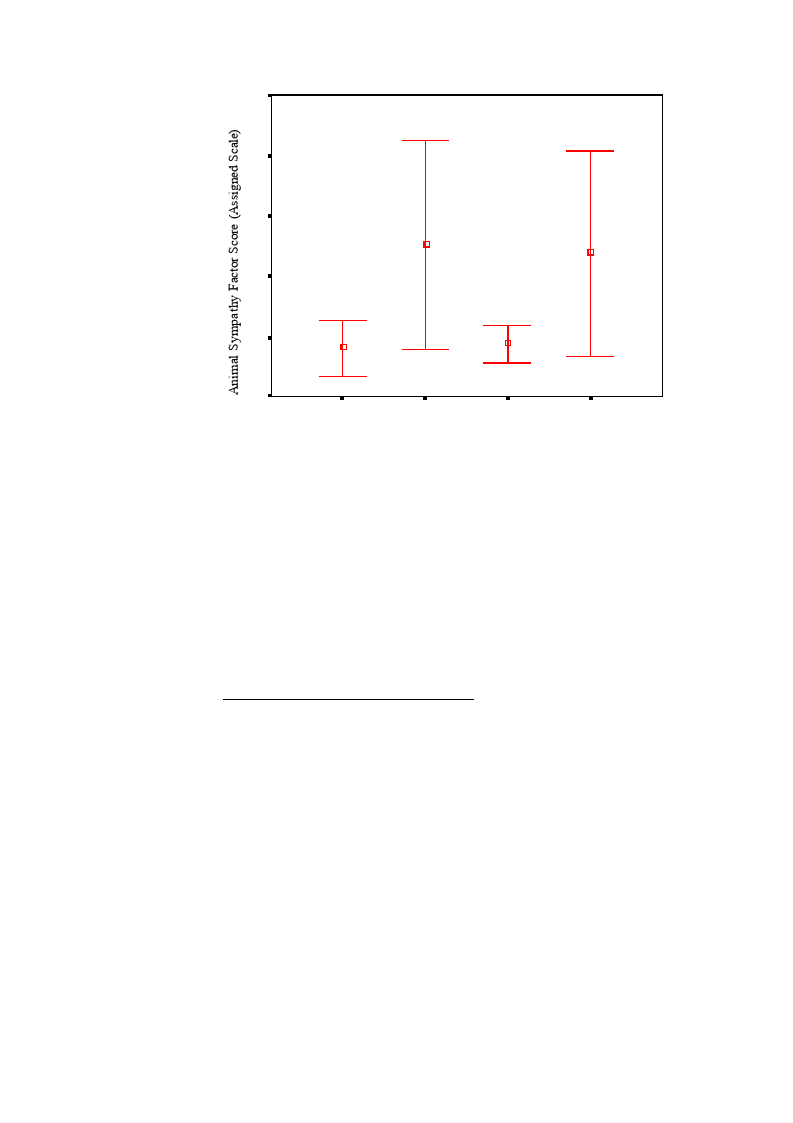
2.0
1.5
1.0
.5
0.0
-.5
N=
51
Neither
11
Encourage
124
M entor
16
B oth
Ecopar enting Status
Figure 6.20: Animal sympathy factor score versus ecoparenting category
Children who had neither a nature mentor or nature media encouragement, or experienced
only a nature mentor, score low on animal sympathy. Children who had nature media
encouragement or both that and a nature mentor score high. The common factor being that
nature media encouragement relates to higher animal sympathy score irrespective of nature
mentor status.
6.3.3.4 Other ecoparenting-related findings
There is a significant interaction (p < .01) between adult social class and ecoparenting but
the pattern is not linear. Whilst middle, upper, and unskilled class children receive a
moderate degree of ecoparenting, children of skilled manual workers receive much less, and
those of semi-skilled workers much more.
Ecoparenting also approaches significance (.067) versus age. 25-34 year olds had a
greater degree of ecoparenting than all others.
199

6.3.4 Summary of findings
• There is a significant interaction between parental ecoactivity category and
ecoevaluation status ecocentric, with hyperactive being higher than all others
• There are significant correlations between ecoemotionality factor nature secure
and both parental ecoactivity level and parental ecoactivity factor ecopractical.
• Parental ecoactivity and adult ecoactivity are highly correlated between
generations, both overall and in terms of the factors ecopractical and ecopolitical.
Further analysis reveals that ecopractical is much the more widely influential
parental factor.
• Place of residence correlates with rising parental ecopolitical.
• Parental ecopractical interacts in a significant but complex way with regard to
subsequent education level reached.
• The more ecopractical the parents, the more children are taken on country trips.
• There was no significant correlation between nature mentor and ecoemotionality,
though the presence of a nature mentor came close to significance in raising
nature secure (p = .061).
• There was increased human sympathy among those without a nature mentor.
• The more a child was taken on country trips, the more likely they are to have had
a nature mentor.
• Ecoevaluation factor anthropocentrism declines modestly with increasingly
frequent country trips, and does so faster where there was no nature mentor.
• There is a close to significant interaction between sample sub-group and country
trips, with CHE and economists scoring lowest on frequency of country trips and
foresters, biotechnologists and nature quango scoring highest.
• Nature media encouragement relates to higher animal sympathy score,
irrespective of nature mentor status.
• There is a significant interaction between adult social class and ecoparenting but
it is hard to see a pattern. Whilst middle, upper, and unskilled class children
appear to receive a moderate degree of ecoparenting, children of skilled manual
workers receive much less, and those of semi-skilled workers much more.
• Ecoparenting also approaches significance (.067) versus rising age, although
those with the greatest absolute degree of ecoparenting were 25-34 year olds.
200

Chapter 7: Analysis of minor hypotheses
A series of further minor hypotheses were tested using mainly derived variables, to see if
further light could be cast on child-nature interaction.
7.1 Hypothesis four: Adult attitudes to nature are affected by
indirect and vicarious childhood experience of nature
In order to test this hypothesis, the relationships between, on the one hand, the two
attitude to nature scales and the relative sympathies scale and, on the other, the childhood
variables describing nature hobby, nature media and the compound variable nature child
were employed.
7.1.1 Prevalence of indirect and vicarious nature experience
First, however, the prevalence of favourite nature hobbies reported by this sample.
Overall, 62.4% reported having had a childhood nature hobby, of whom 94% pursued it at
least sometimes. Breaking hobbies indulged in into categories according to content analysis
reveals the picture as in Figure 7.1, below (as before, see chapter 5 for derivation of these
variables). Grouping by the most probable domain of experience in Kellert’s (1996; 2002)
framework leads to the following conclusions:
• ‘Direct’ nature contact hobbies involving physical contact with primarily non-
domesticated nature (fishing/hunting + horse riding + work/exercise) accounted
for 41% of pursuants;
• ‘Indirect’ hobbies involving domesticated nature (gardening) were the preference
of 21%, and;
• ‘Vicarious’ hobbies involving partially abstracted ‘nature study’ (observe/collect
+ birdwatching) were the favourite of 33%.
201

Valid Percent
Birdwatching
14%
All/None
5%
Fishing/Hunting
26%
Observe/Collect
19%
Gardening
21%
Horse riding
5%
Work/Exercise
10%
Figure 7.1 Favourite Nature Hobby (First Coder results)
The other measure of children’s overt interest in nature gathered was regarding their use
of print and broadcast media. Just 9.4% say they never remember reading nature books as
children, while 61.5% say they did so sometimes or often. Only 8% never remember
listening to radio or watching TV for nature programmes, while 67% did sometimes or often.
A third compound variable was calculated, entitled nature child, made up of the presence
or absence of a garden, pets and a nature hobby: 89.5% of respondents experienced at least
two of these three.
7.1.2 Nature hobbies and attitudes to nature
This set of tests examined the relationship between childhood nature hobbies as
represented by the variables nature hobby (presence or absence), hobby frequency and
favourite hobby and, by turns, ecoevaluations, ecoemotionality and relative sympathies.
202

7.1.2.1 Nature hobbies and ecoevaluation
The tests were a series of 3 separate, mixed 2-way MANOVAs, with the between subjects
independent variables being nature hobby (presence or absence), hobby frequency, and
favourite hobby, and the within subjects dependent variable being ecoevaluation status as
represented by the four factor scores derived from the ecoevaluation scale (i.e. technocentric,
anthropocentric, conservationist, and ecocentric). The mean values for these four factor
scores by hobby variables are shown in the following Table.
Technocentric Anthropocentric
M SD
M
SD
Hobbies Nature hobby -.01 1.02 -.06 1.01
No nature
.01 1.00 .06 1.00
hobby
Hobby Freq Never
.06 .39 1.07 .85
Rarely
.17 1.05 -.05 1.20
Sometimes
-.17 1.03 -.04 .90
Often
.10 1.02 -.10 1.09
Fav Hobby Gardening
-.29 .98 .18 1.22
Fishing/
.26 1.08 -.26 1.07
Hunting
Birdwatching .22 .97 -.34 .55
Horse riding
.00 1.20 -.56 .69
Observe/
-.46 .95 .05 .69
Collect
Work/
.12 1.15 -.06 1.01
Exercise
All/ None
.15 .40 1.13 1.34
Conservationist
M
SD
-.05 1.00
.05 1.01
.23
.87
-.15 1.08
-.08 1.02
.03
.99
-.13 1.21
.07
.99
-.45
.91
-.19
.75
.12
.90
.07 1.01
.46 1.03
Ecocentric
M SD
.00 1.00
.01 1.00
.79 1.33
-.16 1.07
-.15 .95
.17 1.02
.36 1.03
.00 1.16
.09 1.02
-.09 .54
-.18 .83
-.16 .96
-.76 .69
Table 7.1: Nature hobbies by ecoevaluation factor scores
The only significant interaction revealed was between favourite hobby and ecoevaluation
factor anthropocentric (F = 2.35, p < .05) such that the greatest anthropocentrism was
exhibited by those with favourite hobby gardening (and all/none), and the least by those
with favourite hobby horse riding (the sum of squares table for this analysis is shown at
Appendix 11.3.4.1).
7.1.2.2 Nature hobbies and ecoemotionality
The tests were a series of 3 separate, mixed 2-way MANOVAs, with the between subjects
independent variables being nature hobby (presence or absence), hobby frequency, and
203

favourite hobby, and the within subjects dependent variable being ecoemotionality status as
represented by the four factor scores derived from the ecoemotionality scale (i.e. secure,
fearful, dismissive, and stoic). The mean values for these four factor scores by hobby
variables are shown in the following Table.
Hobbies
Hobby Freq
Fav Hobby
Nature hobby
No nature hobby
Never
Rarely
Sometimes
Often
Gardening
Fishing/ Hunting
Birdwatching
Horse riding
Observe/ Collect
Work/ Exercise
All/ None
Secure
M SD
.14 .96
-.18 1.03
-.37 .95
-.31 1.04
.10 .87
.21 1.03
.27 .96
.12 .95
-.14 1.06
-.36 1.19
.21 .96
.46 .77
-.30 .84
Fearful
M SD
-.07 .98
.13 1.05
1.01 .09
.22 .96
-.03 .81
-.14 1.11
.00 1.17
-.18 1.14
-.29 .74
-.15 .82
.23 .89
-.28 .56
.07 .77
Dismissive
M SD
.00 1.02
.04 .94
.95 .42
.09 1.45
-.09 1.03
.03 1.01
.11 1.15
.04 1.02
.08 .89
-.22 1.05
-.25 1.11
-.14 .91
.01 1.09
Table 7.2: Nature hobbies by ecoemotionality factor scores
Stoic
M SD
.07 .97
-.13 1.06
-1.25 .62
-.21 1.06
.12 1.08
.03 .87
.06 1.16
.09 .82
.12 .87
.37 .64
-.27 1.00
.14 1.05
.62 1.20
The only significant interaction revealed was between nature hobby and ecoemotionality
factor nature secure (F = 5.95, p < .05), those with a nature hobby having a higher nature
secure score. Calculation of simple effects revealed no significant differences (the sum of
squares table for this analysis is shown at Appendix 11.3.4.2).
7.1.2.3 Nature hobbies and relative sympathies
The tests were a series of 3 separate, mixed 2-way MANOVAs, with the between subjects
independent variables being nature hobby (presence or absence), hobby frequency and
favourite hobby, and the within subjects dependent variable being relative sympathies status
as represented by the four factor scores derived from the relative sympathies scale (i.e.
environment, animal, and human). The mean values for these three factor scores by hobby
variables are shown in the following Table.
204

Environment Sympathy Animal Sympathy Human Sympathy
M
SD
M
SD
M
SD
Hobbies Nature hobby
.14
1.05
-.01 1.00 -.09 .94
No nature hobby -.22
.84
.06 1.03 .18 1.06
Hobby Freq Never
-.27
.72
-.38
.63
.95 1.07
Rarely
-.36
.87
-.46
.57
.25 1.08
Sometimes
.05
.89
.22 1.13 .03
.95
Often
.28
1.18
-.19
.85
-.23
.91
Fav Hobby Gardening
.03
.79
-.01
.81
.09
.95
Fishing/ Hunting -.23
.96
-.18
.81
-.11
.87
Birdwatching
.27
.83
-.30
.62
-.20 1.02
Horse riding
.50
1.10
.37 1.20 .12
.88
Observe/ Collect .21
1.21
.17 1.01 -.18 1.09
Work/ Exercise
.33
1.09
.16
.95 -.02 .84
All/ None
.81
1.62
-.70
.28
-.69
.80
Table 7.3: Nature hobbies by relative sympathy factor scores
Significant interactions were revealed between:
• nature hobby and relative sympathy factor environment (F = 9.12, p < .01), with
the presence of a nature hobby relating to higher environment sympathy;
• nature hobby and relative sympathy factor human (F = 4.95, p < .05), with the
absence of a nature hobby relating to higher human sympathy scores;
• hobby frequency and relative sympathy factor animal (F = 2.96, p < .05), with
the simple effects revealing a significant difference between frequency
sometimes and often;
• hobby frequency and relative sympathy factor human (F = 3.36, p < .05), with the
simple effects revealing a significant difference between frequency never and
often, a correlation of p < .01 and declining human sympathy with increasing
hobby frequency;
• hobby frequency correlates (p < .05) with relative sympathy environment, and;
• Close to significance between favourite hobby and relative sympathy factor
animal (F = 2.15, p = .051).
(the sum of squares table for this analysis is shown at Appendix 11.3.4.3).
205

7.1.3 Nature media and attitudes to nature
This set of tests examined the relationship between nature media as represented by the
variables read books, TV (presence or absence), and watch TV and, by turns, ecoevaluations,
ecoemotionality and relative sympathies.
7.1.3.1 Nature media and ecoevaluation
The tests were a series of 3 separate, mixed 2-way MANOVAs, with the between subjects
independent variables being read books, TV, and watch TV, and the within subjects
dependent variable being ecoevaluation status as represented by the four factor scores
derived from the ecoevaluation scale (i.e. technocentric, anthropocentric, conservationist,
and ecocentric). The mean values for these four factor scores by nature media variables are
shown in the following Table.
Read Bks
TV
Watch TV
Never
Rarely
Sometimes
Often
Television
No television
Never
Rarely
Sometimes
Often
Technocentric
M SD
-.32 1.10
-.03 1.02
.04 .96
.08 1.07
-.02 1.00
.04 .98
-.12 .91
.07 .99
-.12 1.01
.16 1.05
Anthropocentric
M
SD
-.03 .82
.13 1.10
-.05 .87
-.08 1.20
-.14 .92
.45 1.13
.64 1.18
.08
.94
-.12 .89
-.18 1.13
Conservationist
M
SD
.25 .93
.02 1.10
-.08 .96
.03 1.00
.03 .99
-.09 1.05
-.11 1.20
.01 .92
.00 .99
.10 1.06
Ecocentric
M SD
-.02 .95
-.04 1.17
.00 .90
.02 .97
.00 1.01
-.07 .91
.19 .94
-.17 1.05
.06 1.08
.19 .80
Table 7.4: Nature media by ecoevaluation factor scores
The only significant interactions revealed were between:
• TV and ecoevaluation factor anthropocentric (F = 15.41, p < .01), with absence of
a television relating to higher anthropocentrism scores;
• watch TV and ecoevaluation factor anthropocentric (F = 3.38, p < .05), with
simple effects calculation revealing a significant difference between watch TV
never and sometimes/often, and increasing television viewership relates to
declining anthropocentrism.
(the sum of squares table for this analysis is shown at Appendix 11.3.4.4).
206

7.1.3.2 Nature media and ecoemotionality
The tests were a series of 3 separate, mixed 2-way MANOVAs, with the between subjects
independent variables being read books, TV, and watch TV, and the within subjects
dependent variable being ecoemotionality status as represented by the four factor scores
derived from the ecoemotionality scale (i.e. secure, fearful, dismissive, and stoic). The mean
values for these four factor scores by nature media variables are shown in the Table below.
Read Bks
TV
Watch TV
Never
Rarely
Sometimes
Often
Television
No television
Never
Rarely
Sometimes
Often
Secure
M SD
-.39 .70
.13 1.04
.00 1.02
.05 1.02
.00 .99
-.04 1.04
-.13 1.04
-.14 1.08
-.01 .95
.37 .93
Fearful
M SD
-.34 .98
.04 1.07
.03 .91
.03 1.12
.03 .99
-.09 1.03
-.21 .71
.12 1.13
-.03 .96
-.01 1.08
Dismissive
M SD
-.10 1.16
.01 1.10
.03 .88
-.05 1.03
-.14 .97
.37 .99
.28 1.11
.11 1.06
-.20 .92
.00 1.02
Stoic
M SD
-.06 1.02
-.07 1.07
.00 1.02
.09 .85
.00 1.01
.02 1.01
-.32 .93
.07 1.12
.08 .99
-.10 .87
Table 7.5: Nature media by ecoemotionality factor scores
The significant interactions revealed were between:
• TV and ecoemotionality factor nature dismissive (F = 14.20, p < .01), those with
a television scoring lower;
• watch TV and TV and ecoemotionality factor nature secure (F = 2.92, p < .05),
with calculation of simple effects showing that the significant difference was
between rarely and often, and increasingly frequent nature TV viewing relates to
rising nature secure score.
(the sum of squares table for this analysis is shown at Appendix 11.3.4.5).
207

7.1.3.3 Nature media and relative sympathies
The tests were a series of 3 separate, mixed 2-way MANOVAs, with the between subjects
independent variables being read books, TV, and watch TV, and the within subjects
dependent variable being relative sympathies status as represented by the four factor scores
derived from the relative sympathies scale (i.e. environment, animal, and human). The mean
values for these four factor scores by nature media variables are shown in the following
Table.
Read Bks
TV
Watch TV
Never
Rarely
Sometimes
Often
Television
No television
Never
Rarely
Sometimes
Often
Environment Sympathy Animal Sympathy Human Sympathy
M
SD
M
M
SD
M
-.17
1.00
.12
1.41
.22
.95
.02
.98
.00
.95
.07
.99
-.05
.96
.09
1.02 -.12
.97
.19
1.08
-.22
.79
.05
1.04
.05
.99
.06
1.01
.01
.96
-.16
1.00
-.15
.97
-.02 1.14
-.27
.91
-.10
.82
-.44 1.13
.10
1.07
.11
1.38 -.12
.94
.02
1.02
-.04
.87
.03
.92
.09
.99
.13
.97
.04
1.01
Table 7.6: Nature media by relative sympathy factor scores
No significant interactions were revealed (the sum of squares table for this analysis is
shown at Appendix 11.3.4.6).
7.1.4 Nature child and attitudes to nature
This set of tests examined the relationship between the nature child variable (used here as
nature child score, following a simple recoding into how many of the nature variables
garden, pet and hobby the subject registered (i.e. none, one, two, or three) and, by turns,
ecoevaluations, ecoemotionality and relative sympathies.
7.1.4.1 Nature child and ecoevaluation
The test was an ANOVA between nature child score and ecoevaluation status as
represented by the four factor scores derived from the ecoevaluation scale (i.e. technocentric,
208

anthropocentric, conservationist, and ecocentric). The mean values for these four factor
scores by nature child score are shown in the following Table.
Nature Child Score Three
Two
One
None
Technocentric Anthropocentric Conservationist Ecocentric
SD M SD
M
SD
M SD M
-.04 1.02 -.07 1.01 -.07 1.00 .08 1.01
.02 .98 -.02 .89 -.02 1.04 -.10 .88
.17 .99 .25 1.20 .07 .93 -.01 1.18
-1.20 .
.60
.
1.26
. -.63 .
Table 7.7: Nature child score by ecoevaluation factor scores
No significant interactions were revealed (the sum of squares table for this analysis is
shown at Appendix 11.3.4.7).
7.1.4.2 Nature child and ecoemotionality
The test was an ANOVA between nature child score and ecoemotionality status as
represented by the four factor scores derived from the ecoemotionality scale (i.e. secure,
fearful, dismissive, and stoic). The mean values for these four factor scores by nature child
score are shown in the following Table.
Nature Child Score
Three
Two
One
None
Secure
M SD
.18 .96
-.20 .97
-.19 1.09
-.24
.
Fearful
M SD
-.05 1.01
-.07 .88
.39 1.31
1.22 .
Dismissive
M
SD
.02 1.08
.03 .84
.06 1.07
-1.07
.
Stoic
M SD
.06 1.00
-.07 .97
-.02 1.24
-1.63 .
Table 7.8: Nature child score by ecoemotionality factor scores
The single significant interaction revealed was between nature child score and
ecoemotionality factor nature secure (F = 3.14, p < .05), nature secure declining with
decreasing nature child score (the sum of squares table for this analysis is shown at
Appendix 11.3.4.8).
209

7.1.4.3 Nature child and relative sympathies
The test was an ANOVA between nature child score and relative sympathies status as
represented by the four factor scores derived from the relative sympathies scale (i.e.
environment, animal, and human). The mean values for these three factor scores by nature
child score are shown in the following Table.
Nature Child Score
Environment Sympathy Animal Sympathy Human Sympathy
SD
M
M
SD
M
M
Three
.12
1.07
.03
1.06
-.06
.93
Two
-.09
.88
.08
1.05
.10 1.10
One
-.32
.87
-.32
.50
.15
.95
None -1.10
.
-.71
.
-1.08
.
Table 7.9: Nature child score by relative sympathy factor scores
No significant interactions were revealed (the sum of squares table for this analysis is
shown at Appendix 11.3.4.9).
7.2 Hypothesis five: Adult attitudes to nature are affected by the
size and nature of the animal and human ‘menagerie’ the child
grows up in
7.2.1 Pets and attitudes to nature
This set of tests examined the relationship between childhood pet ownership as
represented by the variables pets (presence or absence), number of pet types, number of
mammal types and number of non-mammal types and, by turns, ecoevaluations,
ecoemotionality and relative sympathies.
210

7.2.1.1 Pets and ecoevaluation
The tests were a series of mixed 2-way MANOVA, with the between subjects
independent variables being pets (presence or absence), number of pet types, number of
mammal types and number of non-mammal types and the within subjects dependent variable
being ecoevaluation status as represented by the four factor scores derived from the
ecoevaluation scale (i.e. technocentric, anthropocentric, conservationist, and ecocentric). The
mean values for these four factor scores by pet variables are shown in the following Table.
Pets
Number of pet
types
N of mammals
N of non-
mammals
Pets
No pets
No pets
Technocentric Anthropocentric Conservationist Ecocentric
M SD M SD M SD M SD
.00 .99 .00 1.01 -.03 1.01 .07 .98
.03 .97 .03 .91 .04 .91 -.41 .94
.03 .98 .04 1.01 .13 .94 -.40 .91
One pet type
.03 1.07 .18 1.21 .27 1.10 .15 1.17
Two pet types
.10 .95 .00 .96 -.15 .90 .06 .96
Three pet types -.05 1.01 -.10 .87 -.13 1.06 .10 .98
Four or more pet -.19 1.03 -.13 .94 -.03 .99 -.01 .90
types
No mammals
.06 .98 .07 .98 .10 1.01 -.26 .94
One mammal
-.02 1.03 .10 1.21 .17 .97 .02 1.11
type
Two mammal
.00 .98 -.03 .83 -.20 1.00 .14 .98
types
Three mammal -.03 1.04 -.22 .88 -.05 1.00 -.01 .85
types
No non-mammals .04 .98 .01 .99 .01 1.03 -.03 1.03
One non-mammal .07 1.06 .04 1.10 -.07 .95 .12 .91
type
Two non-mammal -.29 1.01 .04 .92 .03 .94 -.14 .89
types
Three or more
-.42 .93 -.74 .49 .13 1.17 .25 1.34
non-mammal
types
Table 7.10: Pets by ecoevaluation factor scores
The only significant interaction revealed was between pets and ecoevaluation factor
ecocentric (F (1, 223) = 6.96, p < .01), with pet presence significantly raising ecocentrism
(the sum of squares table for this analysis is shown at Appendix 11.3.4.10).
211

7.2.1.2 Pets and ecoemotionality
The tests were a series of mixed 2-way MANOVA, with the between subjects
independent variables being pets (presence or absence), number of pet types, number of
mammal types and number of non-mammal types and the within subjects dependent variable
being ecoemotionality status as represented by the four factor scores derived from the
ecoemotionality scale (i.e. secure, fearful, dismissive, and stoic). The mean values for these
four factor scores by pet variables are shown in the following Table.
Pets
Pets
No pets
Number of No pets
pet types
One pet type
Two pet types
Three pet types
Four or more
pet types
N of
No mammals
mammals
One mammal
type
Two mammal
types
Three mammal
types
N of
No non-mammals
non-mammals
One non-mammal
type
Two non-mammal
types
Three or more
non-mammal types
Secure
M SD
.03 1.00
-.26 .93
-.20 .95
Fearful
M SD
.00 1.02
-.05 .88
.00 .88
Dismissive
M SD
.03 1.02
-.10 .87
-.13 .88
Stoic
M SD
.00 1.01
.04 1.05
.01 1.00
.14 1.11 .23 1.33 -.19 1.18 -.11 1.06
.03 1.06 .03 1.02 .26 1.01 -.01 1.09
.00 .91 -.05 .81 .02 .88 .09 .96
-.04 .92 -.30 .69 -.12 .94 .03 .80
-.13 .95 -.01 .87 -.13 .87 .09 .96
.16 1.09 .22 1.29 .05 1.13 -.17 .99
-.01 .97 -.06 .81 .03 1.01 .19 1.09
-.17 .92 -.31 .70 -.03 .85 -.13 .78
-.02 1.03 -.01 1.01 -.05 1.01 -.03 1.04
-.09 .99 .10 1.12 .21 1.00 .08 1.01
.23 .88 -.16 .72 .04 .83 .03 .58
.43 .89 -.12 .39 -.92 .80 -.11 1.36
Table 7.11: Pets by ecoemotionality factor scores
The significant interactions revealed were between number of mammal types and
ecoemotionality factor nature fearful (F (3, 255) = 2.84, p < .05), with simple effects
demonstrating a significant difference between one and three mammal types, a negative
correlation (p < .05) and the figure (below) showing a rise and fall pattern; and between
number of non-mammal types and ecoemotionality factor nature dismissive (F (3, 255) =
3.10, p < .05), with simple effects demonstrating a significant difference between one and
212
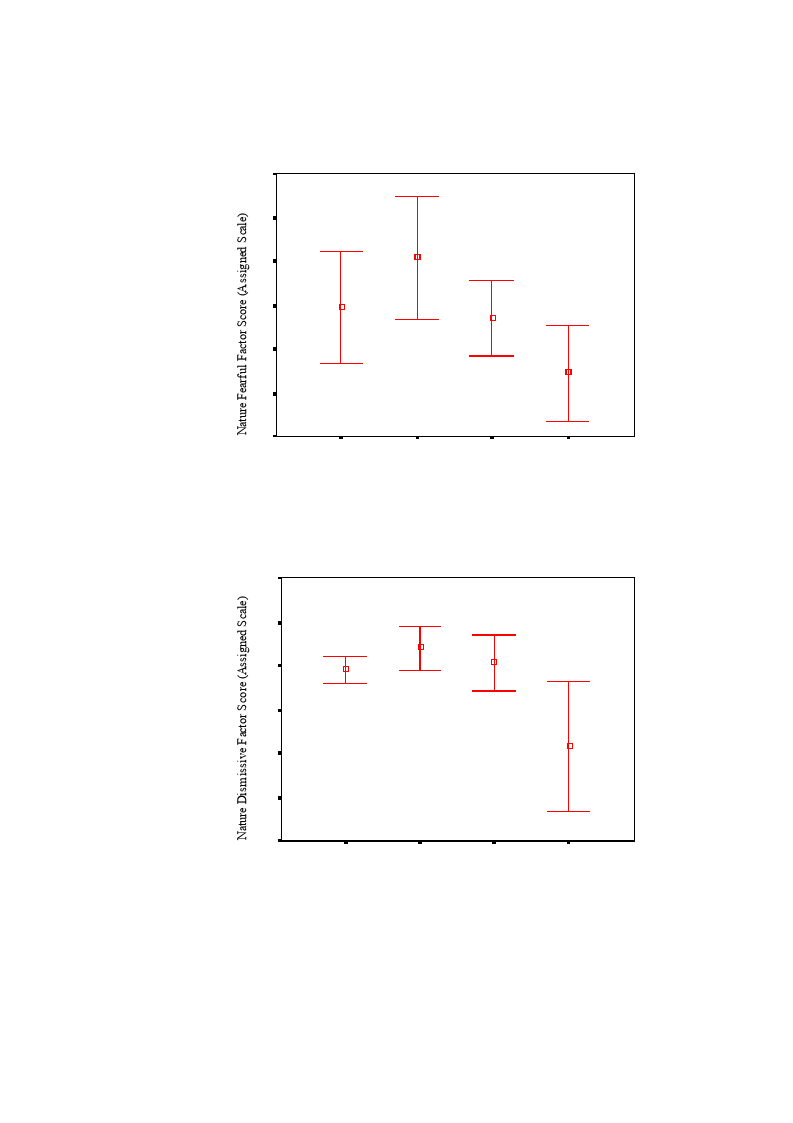
three non-mammal types and the figure again (below) showing a rise and fall pattern where
nature dismissive decreases from one to three non-mammal types (the sum of squares table
for this analysis is shown at Appendix 11.3.4.11).
.6
.4
.2
-.0
-.2
-.4
-.6
N=
46
No mammals
85
86
42
Two mammal types
One mammal type
Three mammal types
Numbe r of mammal types
Figure 7.2: Nature fearful factor score versus number of mammal pet types
1.0
.5
0.0
-.5
-1.0
-1.5
-2.0
N=
161
63
28
7
No non-mammals
Two non-mammal types
One non-m ammal t ype
Three or more non-ma
Numbe r of non-mammal pe t types
Figure 7.3: Nature dismissive factor score versus number of non-mammal pet types
213

7.2.1.3 Pets and relative sympathies
The tests were a series of mixed 2-way MANOVA, with the between subjects
independent variables being pets (presence or absence), number of pet types, number of
mammal types and number of non-mammal types and the within subjects dependent variable
being relative sympathies status as represented by the four factor scores derived from the
relative sympathies scale (i.e. environment, animal, and human). The mean values for these
four factor scores by pet variables are shown in the following Table.
Pets
Number of
pet types
N of
mammals
N of non-
mammals
Pets
No pets
No pets
Environment
Sympathy
M
SD
-.01 1.00
-.07
.98
.02
1.01
Animal
Sympathy
MM
.05 1.05
-.35 .49
-.32 .50
Human
Sympathy
SD M
.01 .99
-.03 1.10
-.04 1.09
One pet type
-.05
Two pet types
-.16
Three pet types
.04
Four or more pet types .29
No mammals
-.05
.81 .10 .95 .18 1.09
.94 .06 1.11 .04 1.00
1.05 .00 .88 -.15 .95
1.24 .06 1.32 -.07 .83
.98 -.30 .53 -.04 1.06
One mammal
type
Two mammal
types
Three mammal
types
No non-mammals
.05
.90 .10 1.05 .14 1.06
-.10
.99 -.03 .90 -.04 .94
.14
1.24 .19 1.38 -.19 .91
-.03
.95 .04 1.01 .03 1.05
One non-mammal
type
Two non-mammal
types
Three or more
non-mammal types
-.18
.97 -.07 1.05 -.02 .98
.15
1.03 .07 .91 -.09 .82
1.22 1.24 -.40 .61 -.07 .83
Table 7.12: Pets by relative sympathy factor scores
The significant interactions revealed were between pets and relative sympathies factor
animal sympathy (F (1, 276) = 5.04, p < .05), presence of pets increasing animal sympathy;
and between number of non-mammal types and relative sympathies factor environment
sympathy (F (3, 282) = 6.34, p < .01), with simple effects demonstrating a significant
difference between none/one/two non-mammals types and three or more non-mammal types,
a positive correlation (p < .05) and the figure (below) showing a fall and rise pattern where
214
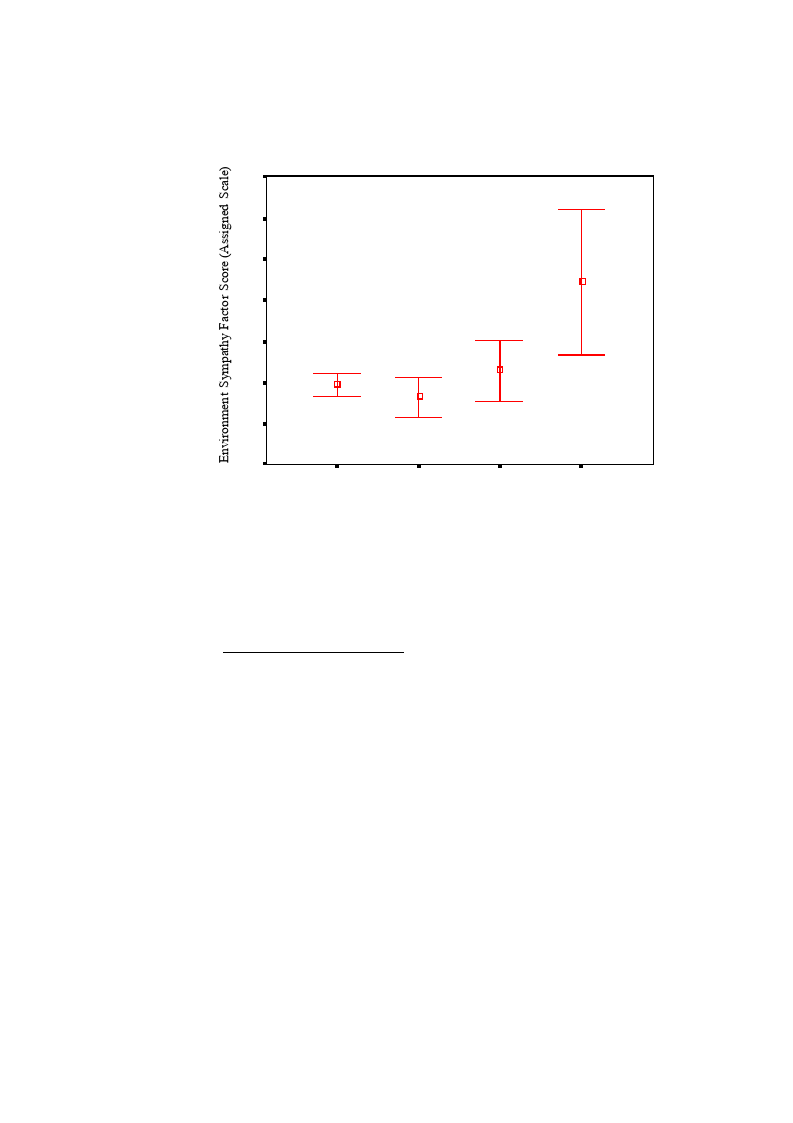
environment sympathy falls slightly from none to one non-mammal types then rises (the sum
of squares table for this analysis is shown at Appendix 11.3.4.12).
2.5
2.0
1.5
1.0
.5
0.0
-.5
-1.0
N=
177
67
32
10
No non-mammals
Two non-mammal types
One non-m ammal t ype
Three or more non-ma
Numbe r of non-mammal pe t types
Figure 7.4: Environment sympathy factor score versus number of non-mammal pet types
7.2.1.4 Other pet-related findings
All four pet variables employed correlate individually with each other (< .01).
There is significant variance (< .01) across sample sub-groups for all four pet variables.
The only significant difference revealed in simple effects is between CHE and
foresters/farmers for number of non-mammal types. Examination of Figure 7.5 shows that
the two ‘deep green’ sample sub-groups, CHE and ecoradicals, had the greatest variety of pet
types overall, and economists and electronics the least. Breaking down into types of pets,
Figure 7.6 further reveals that whilst CHE and ecoradicals shared high variety in mammal
types with farmers, farmers differed in having conspicuously fewer non-mammal pet types.
Economists, electronics and foresters had even fewer non-mammal types. Electronics had
the least number of mammal types.
215
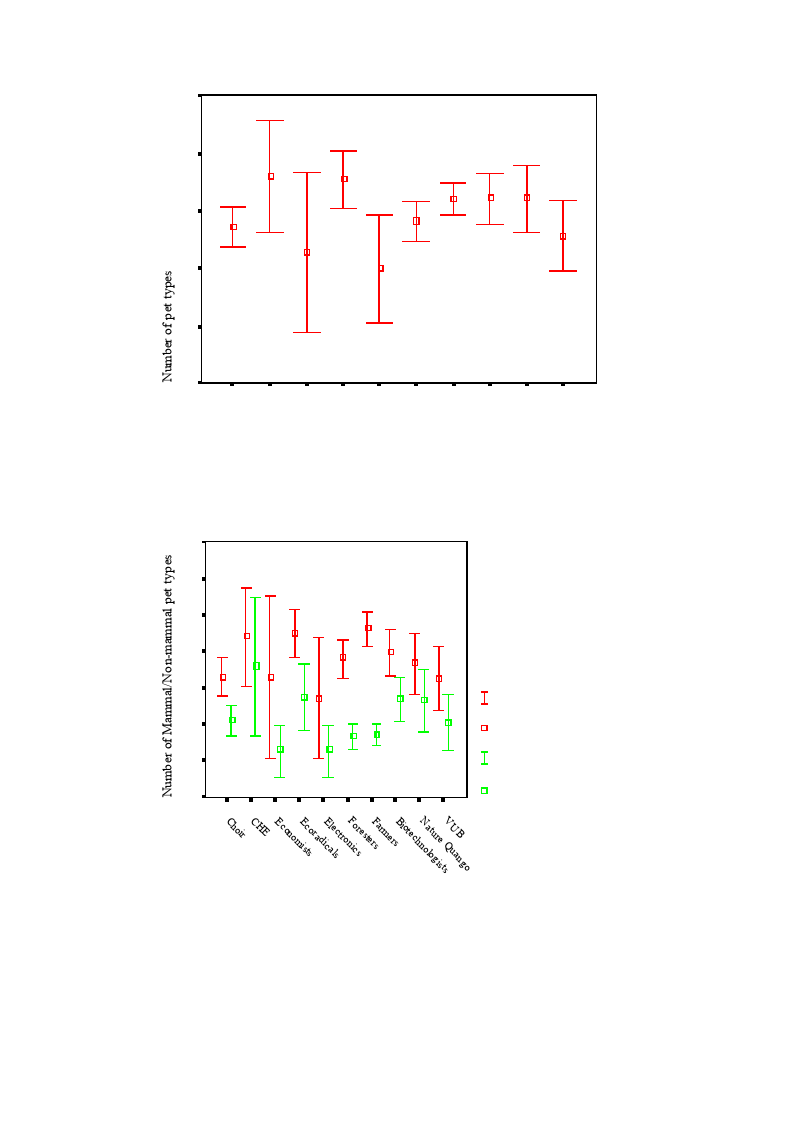
4
3
2
1
0
-1
N=
47
C hoir
10
7
24
7
57
62
39
18
23
Economist s El ectronics
Farmers Nature Quango
CHE
Ecoradical s
Foresters Biotechnol ogists VUB
Sample Sub-group
Figure 7.5: Number of pet types versus sample sub-groups
3.0
2.5
2.0
1.5
1.0
.5
0.0
-.5
N = 47 47 10 10 7 7 24 24 7 7 57 57 62 62 39 39 18 18 23 23
Number of m amm al
pet types
Number of non-mammal
pet types
Sample Sub-group
Figure 7.6: Number of mammal and non-mammal pet types versus sample sub-groups
216

7.2.2 The ‘menagerie’ and attitudes to nature
This set of tests examined the relationship between numbers of pets-plus-siblings and
siblings only as represented by the variables menagerie and siblings (numbers) and, by turns,
ecoevaluations, ecoemotionality and relative sympathies.
7.2.2.1 Menagerie and ecoevaluation
The tests were mixed 2-way MANOVAs, with the between subjects independent
variables being menagerie and siblings, and the within subjects dependent variable being
ecoevaluation status as represented by the four factor scores derived from the ecoevaluation
scale (i.e. technocentric, anthropocentric, conservationist, and ecocentric). The mean values
for these four factor scores are shown in the following Table.
Technocentric Anthropocentric Conservationist
M SD M SD M SD
Menagerie No pet+sibs -.62 .88 -.05 1.03 -.39 1.15
Index
One pet+sib .29 1.00 .19 1.04 .10 1.15
Two
-.32 1.12 -.14 .93 .24 1.02
pets+sibs
Three
.12 .99 -.19 .94 .04 .89
pets+sibs
Four
.11 .96 -.10 1.01 -.26 1.10
pets+sibs
Five
-.08 .98 .14 1.17 .05 .88
pets+sibs
Six pets+sibs .06 .96 .03 .79 -.23 .81
Seven or more -.13 1.03 .20 .97 .10 1.08
pets+sibs
Siblings None
-.04 1.09 .07 .92 -.32 1.14
One
-.03 1.04 -.23 .92 .03 1.05
Two
-.01 1.05 -.06 .96 -.04 .90
Three
.00 .76 .00 1.01 .44 .85
Four or more .09 1.03 .47 1.11 -.23 .95
Ecocentric
M SD
-.27 .64
-.02 .93
-.11 1.03
-.25 .96
.05 1.04
.11 1.07
.38 .94
-.01 .93
-.13 .93
.10 .98
-.19 .93
-.21 .94
.35 1.13
Table 7.13: Menagerie and siblings by ecoevaluation factor scores
No significant interaction was evident with menagerie but with siblings, there were
significant interactions with:
217

• Ecoevaluation factor anthropocentric (F (4, 223) = 3.31, p < .05), simple effects
revealing a significant difference between one and four or more, and a correlation
of p < .01 demonstrating that rising anthropocentrism relates to increasing sibling
numbers;
• Ecoevaluation factor conservationist (F (4, 223) = 2.71, p < .05), simple effects
revealing a significant difference between none and three;
• Ecoevaluation factor ecocentric (F (4, 223) = 2.35, p < .05).
(the sum of squares table for this analysis is shown at Appendix 11.3.4.13).
7.2.2.2 Menagerie and ecoemotionality
The tests were mixed 2-way MANOVAs, with the between subjects independent
variables being menagerie and siblings, and the within subjects dependent variable being
ecoemotionality status as represented by the four factor scores derived from the
ecoemotionality scale (i.e. secure, fearful, dismissive, and stoic). The mean values for these
four factor scores are shown in the following Table.
Menagerie
Index
Siblings
No pet+sibs
One pet+sib
Two pets+sibs
Three pets+sibs
Four pets+sibs
Five pets+sibs
Six pets+sibs
Seven or more
pets+sibs
None
One
Two
Three
Four or more
Secure
M SD
.21 .73
Fearful
M SD
-.38 .98
Dismissive
M SD
.31 .32
Stoic
M SD
-.08 1.20
.04 1.03 .11 .89 -.01 1.02 -.26 1.19
.07 .92 -.03 .86 -.30 1.05 -.07 1.07
-.22 .99 .08 .87 -.12 1.06 .11 .97
.08 .98 -.03 1.04 .07 .90 .11 .99
.15 1.14 .12 1.41 .13 1.20 -.07 .83
.09 .98 -.21 .76 .25 .82 .04 1.02
-.20 .91 -.19 .79 .07 .88 .01 1.03
.24 .78 -.08 .83 .00 1.00 .05 1.31
-.03 .97 .01 .86 -.08 1.01 -.09 .95
-.02 1.03 -.03 1.02 -.06 .97 .11 .87
-.21 1.01 -.28 .70 -.05 .98 .02 .95
.15 1.09 .26 1.47 .41 1.00 .03 1.14
Table 7.14: Menagerie and siblings by ecoemotionality factor scores
No significant interactions were evident with either variable (the sum of squares table for
this analysis is shown at Appendix 11.3.4.14).
218

7.2.2.3 Menagerie and relative sympathies
The tests were mixed 2-way MANOVAs, with the between subjects independent
variables being menagerie and siblings, and the within subjects dependent variable being
relative sympathies status as represented by the four factor scores derived from the relative
sympathies scale (i.e. environment, animal, and human). The mean values for these four
factor scores are shown in the following Table.
Menagerie
Index
Siblings
No pet+sibs
One pet+sib
Two pets+sibs
Three pets+sibs
Four pets+sibs
Five pets+sibs
Six pets+sibs
Seven or more
pets+sibs
None
One
Two
Three
Four or more
Environment
Sympathy
M
SD
.21
.80
-.15
1.06
-.02
.81
-.07
.88
-.07
.86
.17
1.17
.09
1.21
.03
1.32
-.04
.76
-.03
.99
.04
1.01
.08
1.09
-.06
1.17
Animal
Sympathy
M
M
.11 .61
-.15 .74
.22 1.29
.05 .97
.03 1.12
.13 1.02
-.26 .63
-.38 .76
.53 1.65
.05 .91
.04 .94
-.32 .69
-.31 .72
Human
Sympathy
SD
M
-.42 .75
-.34 .86
.10 .97
.16 1.04
.07 .98
-.06 1.11
.08 .98
-.27 .88
-.17 .84
-.04 .97
.02 .92
.22 1.09
-.06 1.19
Table 7.15: Menagerie and siblings by relative sympathy factor scores
No significant interaction was evident with menagerie but with siblings, there was a
significant interaction with relative sympathy factor animal sympathy (F (4, 277) = 4.40, p <
.01), simple effects establishing a significant difference between none and three/four or more
siblings, a negative correlation of p < .01, and declining animal sympathy with rising sibling
numbers (the sum of squares table for this analysis is shown at Appendix 11.3.4.15).
7.2.2.4 Miscellaneous menagerie-related findings
Whilst there was no significant ANOVA between sample sub-groups and menagerie,
compared to other groups, economists and electronics had conspicuously low means.
219
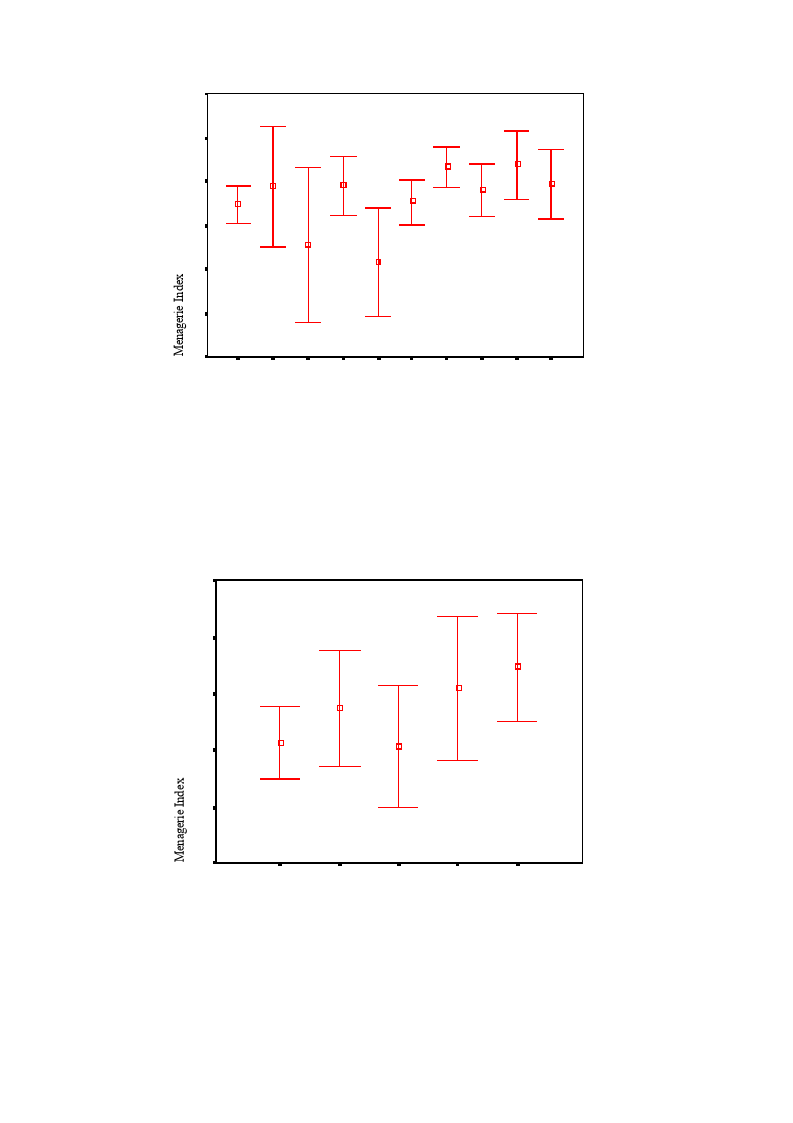
6
5
4
3
2
1
0
N=
46
10
7
24
6
57
61
38
18
23
Choir
Economist s El ectronics
Farmers Nature Quango
CHE
Ecoradical s
Foresters Biotechnol ogists VUB
Sample Sub-group
Figure 7.7: Sample sub-group versus menagerie index
Whilst there was no significant ANOVA between menagerie and livenow, the figure
shows a trend toward more rural residence for those with a larger menagerie in childhood.
5.0
4.5
4.0
3.5
3.0
2.5
N=
104
C ity
Adult Residence
48
Town
41
38
59
Vil lage Country not farm Farm
Figure 7.8: Adult residence versus menagerie index
220

7.3 Hypothesis six: Adult attitudes to nature are affected by
social factors
7.3.1 Child movements and attitudes to nature
This set of tests examined the relationship between the number of childhood homes as
represented by the variable child movements and, by turns, ecoevaluations, ecoemotionality
and relative sympathies.
7.3.1.1 Child movements and ecoevaluation
The test was a mixed 2-way MANOVA, with the between subjects independent variable
being child movements and the within subjects dependent variable being ecoevaluation status
as represented by the four factor scores derived from the ecoevaluation scale (i.e.
technocentric, anthropocentric, conservationist, and ecocentric). The mean values for these
four factor scores are shown in the following Table.
One place
Two places
Three places
Four or more places
Technocentric
M SD
.11 .98
.04 1.00
-.28 .88
-.22 1.16
Anthropocentric
M
SD
.22 1.08
-.34
.86
.03
.92
-.16
.85
Conservationist
M
SD
-.02 .95
.00 1.02
.08 1.17
.11
.98
Ecocentric
M SD
.07 1.11
-.18 .86
.06 .78
.02 .98
Table 7.16: Child movements versus ecoevaluation factor scores
The only significant interaction revealed was between child movements and ecoevaluation
factor anthropocentric (F (3, 225) = 4.53 p < .01), with the significant difference being
between one and two places and a negative correlation. There was also a negative correlation
for ecoevaluation factor technocentric, both factors declining as shown in the figure below
with numbers of moves (the sum of squares table for this analysis is shown at Appendix
11.3.4.16).
221

.6
.4
.2
0.0
-.2
-.4
-.6
-.8
N=
112 112
One place
58
58
Two places
30
30
29
29
Three places
Four or more places
Child Move ments
FactorScore
Te chnocentric
FactorScore
Anthropocentric
Figure 7.9: Child movement versus ecoevaluation factor scores
7.3.1.2 Child movements and ecoemotionality
The test was a mixed 2-way MANOVA, with the between subjects independent variable
being child movements and the within subjects dependent variable being ecoemotionality
status as represented by the four factor scores derived from the ecoemotionality scale (i.e.
secure, fearful, dismissive, and stoic). The mean values for these four factor scores are
shown in the following Table.
One place
Two places
Three places
Four or more places
Secure
M
SD
-.01 1.07
.09 .98
-.01 .86
-.12 .95
Fearful
M SD
.11 1.20
-.26 .74
-.01 .79
.13 .74
Dismissive
M
SD
.22 .97
-.14 1.00
-.13 1.09
-.43 .87
Stoic
M SD
.11 1.03
-.16 1.01
-.03 .95
-.11 .87
Table 7.17: Child movements by ecoemotionality factor scores
The only significant interaction revealed was with ecoemotionality factor score dismissive
(F (3, 252) = 4.84, p < .01), with simple effects demonstrating a significant difference
between one and four or more places, and a significant negative correlation such that
222

increasing numbers of child movements relate to declining nature dismissive (the sum of
squares table for this analysis is shown at Appendix 11.3.4.17).
7.3.1.3 Child movements and relative sympathies
The test was a mixed 2-way MANOVA, with the between subjects independent variable
being child movements and the within subjects dependent variable being relative sympathies
status as represented by the four factor scores derived from the relative sympathies scale (i.e.
environment, animal, and human). The mean values for these four factor scores are shown in
the following Table.
One place
Two places
Three places
Four or more places
Environment Sympathy
M
SD
-.16
1.00
.09
1.01
.18
.92
.27
1.04
Animal Sympathy
M
M
-.01
1.05
-.17
.76
.44
1.36
-.02
.78
Human Sympathy
SD
M
-.07
.97
.08
1.13
.18
.86
-.08
.97
Table 7.18: Child movements by relative sympathy factor scores
The significant interaction revealed was between child movements and relative
sympathies factor animal sympathy (F (3, 279) = 3.08, p < .05), with simple effects showing
the significant difference between two and three places. Factor score environment sympathy
was however close (p = .054), and had a significant (p < .01) positive correlation (the sum of
squares table for this analysis is shown at Appendix 11.3.4.18).
7.3.1.4 Other social factors-related findings
There is a highly significant correlation between education level and number of child
movements F = 4.50, p < .01, and a positive correlation (p < .01) such that those who moved
more reach higher levels of formal educational attainment.
7.3.2 Social class and attitudes to nature
This set of tests examined the relationship between the social class of respondents in
childhood as represented (as has been the somewhat sexist convention until very recently) by
the father’s social class (variable dad class) and, by turns, ecoevaluations, ecoemotionality
and relative sympathies.
223

7.3.2.1 Social class and ecoevaluation
The test was a mixed 2-way MANOVA, with the between subjects independent variable
being dad class and the within subjects dependent variable being ecoevaluation status as
represented by the four factor scores derived from the ecoevaluation scale (i.e. technocentric,
anthropocentric, conservationist, and ecocentric). The mean values for these four factor
scores by social class are shown in the following Table.
No reply
Professional
Managerial/ technical
Skilled manual
Skilled non-manual
Semi-skilled
Unskilled
Technocentric
M SD
-.11 .87
-.14 .88
.07 .98
.43 .95
-.21 1.18
-.29 .84
-.66 1.61
Anthropocentric
M
SD
.19
.65
-.11 1.05
-.04 .96
.25
.99
-.04 1.05
-.21 .78
.50 1.57
Conservationist
M
SD
-.33 .99
-.10 1.07
.03 .98
.00 .87
.03 1.14
.50 .89
.09 1.07
Ecocentric
M SD
-.53 .75
.05 .83
-.09 1.03
.32 1.09
.18 .98
-.17 1.31
.18 1.27
Table 7.19: Social class by ecoevaluation factor scores
There were no significant interactions (the sum of squares table for this analysis is shown
at Appendix 11.3.4.19).
7.3.2.2 Social class and ecoemotionality
The test was a mixed 2-way MANOVA, with the between subjects independent variable
being dad class and the within subjects dependent variable being ecoemotionality status as
represented by the four factor scores derived from the ecoemotionality scale (i.e. secure,
fearful, dismissive, and stoic). The mean values for these four factor scores by social class
are shown in the following Table.
No reply
Professional
Managerial/ technical
Skilled manual
Skilled non-manual
Semi-skilled
Unskilled
Secure
M
SD
-.53 .82
.08 .90
-.08 1.01
.10 1.08
.03 1.12
-.01 .58
.84 1.07
Fearful
M
SD
-.38 .45
-.01 .86
-.12 .92
.27 1.30
.08 .97
.27 .91
.73 1.88
Dismissive
M
SD
.21 .72
-.12 .97
.15 1.00
-.07 .99
-.24 1.03
-.51 .64
-.17 1.41
Stoic
M
SD
.14 .66
-.16 .83
-.02 1.07
.20 1.12
.17 .75
-.17 1.43
.10 1.00
224
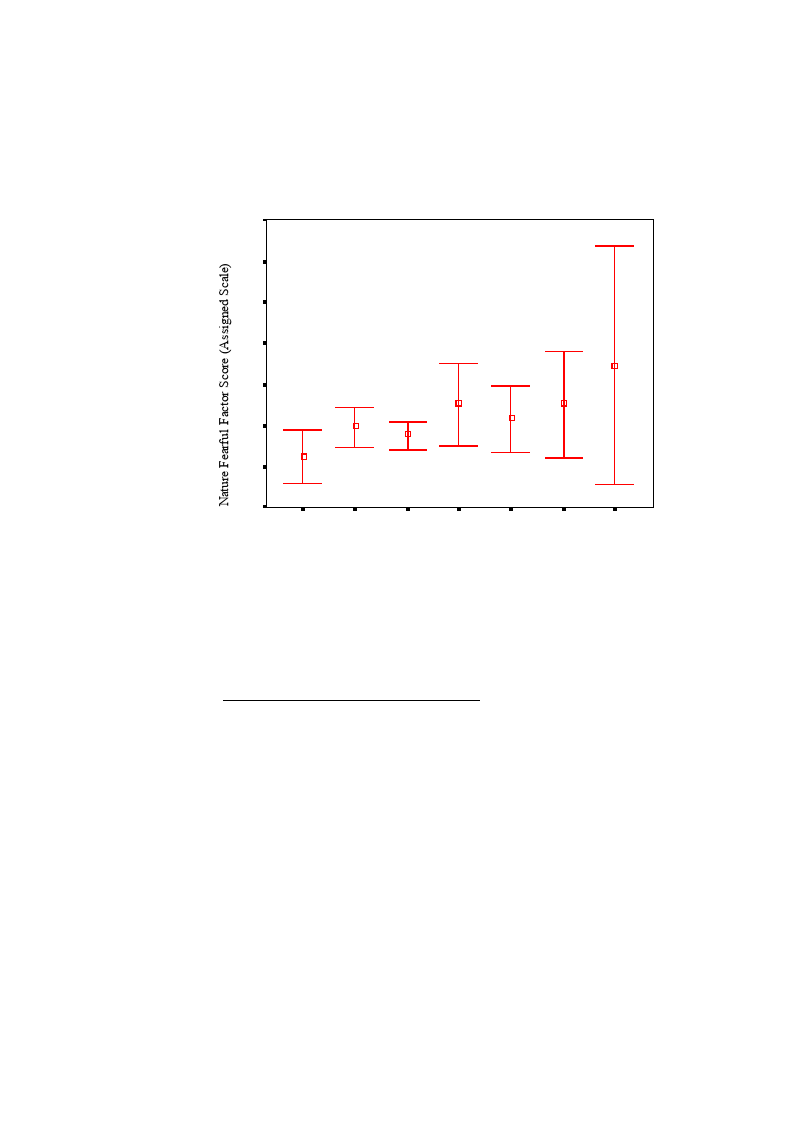
There were no significant interactions revealed. There was however a significant
correlation (< .05) between factor score nature fearful and social class, as shown in Figure
7.10, such that nature fearful is higher among the lower social class groups (the sum of
squares table for this analysis is shown at Appendix 11.3.4.20).
2.5
2.0
1.5
1.0
.5
0.0
-.5
-1.0
N=
10
53
124
28
25
10
9
No repl y
M anagerial/technical Skill ed non-manual
Unski lled
P r o fessional
Skill ed manual
Sem i-skilled
Child Social Cla ss
Figure 7.10: Social class versus ecoemotionality factor nature fearful
7.3.2.3 Social class and relative sympathies
The test was a mixed 2-way MANOVA, with the between subjects independent variable
being dad class and the within subjects dependent variable being relative sympathies status
as represented by the four factor scores derived from the relative sympathies scale (i.e.
environment, animal, and human). The mean values for these four factor scores by social
class are shown in the following Table.
225
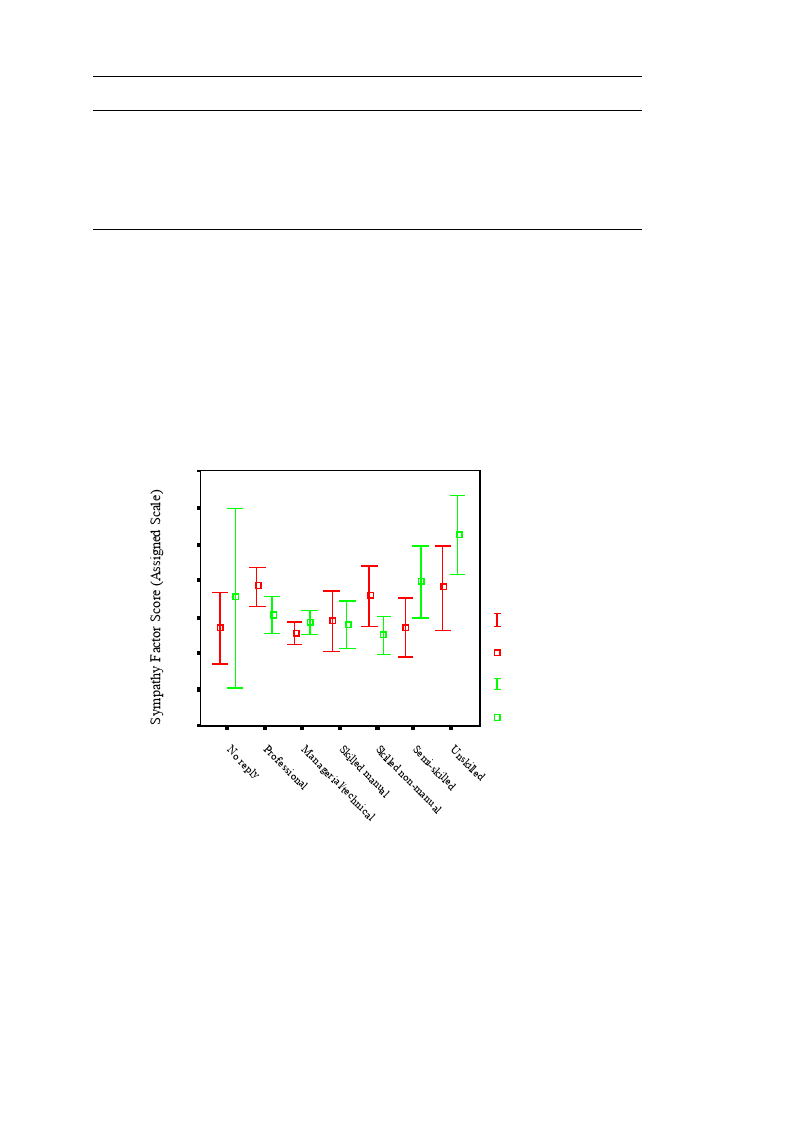
No reply
Professional
Managerial/technical
Skilled manual
Skilled non-manual
Semi-skilled
Unskilled
Environment Sympathy
M
SD
-.15
.77
.42
1.02
-.22
.97
-.06
1.07
.29
1.00
-.15
.64
.40
.68
Animal Sympathy
M
M
.26
1.95
.02
.95
-.07
.98
-.11
.86
-.25
.67
.48
.78
1.13
.65
Human Sympathy
SD
M
-.02
.88
.21
1.02
-.10
1.04
-.10
.73
.15
1.18
.04
.85
.11
.73
Table 7.20: Social class by relative sympathies factor scores
There were significant interactions revealed with relative sympathies factors environment
(F (6, 279) = 3.83, p < .01), with a significant difference between professional and
managerial, and; animal (F (6, 279) = 2.84, p < .05), with significant differences between
unskilled and non-manual/manual/managerial, and a significant (p < .05) correlation (the
sum of squares table for this analysis is shown at Appendix 11.3.4.21).
2.0
1.5
1.0
.5
0.0
-.5
-1.0
-1.5
N = 12 12 60 60 139 139 29 29 26 26 12 12
88
F actorSco r e
Envi ronment S ympathy
F actorSco r e
Anim alSympathy
Child Social Cla ss
Figure 7.11: Social class versus relative sympathy factors environment and animal
226

7.3.3 Education and attitudes to nature
This set of tests examined the relationship between the education of respondents as
represented by the variable education level and, by turns, ecoevaluations, ecoemotionality
and relative sympathies.
7.3.3.1 Education and ecoevaluation
The test was a mixed 2-way MANOVA, with the between subjects independent variable
being education level and the within subjects dependent variable being ecoevaluation status
as represented by the four factor scores derived from the ecoevaluation scale (i.e.
technocentric, anthropocentric, conservationist, and ecocentric). The mean values for these
four factor scores are shown in the following Table.
Pre O level
Post O level
Post A level
Undergraduate
Postgraduate
Technocentric
M
SD
-.20 1.08
.03 .98
-.31 .95
.18 .95
-.10 1.04
Anthropocentric
M
SD
.65
.82
.15
.99
.02
.95
-.15
.92
-.14
1.00
Conservationist
M
SD
-.21
.73
-.32 1.08
-.41
.81
.12
.95
.01
1.08
Ecocentric
M SD
-.20 .97
-.13 .86
.07 .85
.02 1.12
.04 .99
Table 7.21: Education by ecoevaluation factor scores
The only significant interaction revealed was with ecoevaluation factor anthropocentric
(F (4, 218) = 3.35, p < .05), with the significant difference being between pre-O level and
undergraduate/postgraduate, and a negative correlation (p < .01) (the sum of squares table
for this analysis is shown at Appendix 11.3.4.22).
7.3.3.2 Education and ecoemotionality
The test was a mixed 2-way MANOVA, with the between subjects independent variable
being education level and the within subjects dependent variable being ecoemotionality
status as represented by the four factor scores derived from the ecoemotionality scale (i.e.
secure, fearful, dismissive, and stoic). The mean values for these four factor scores by pet
variables are shown in the following Table.
227

Pre O level
Post O level
Post A level
Undergraduate
Postgraduate
Secure
M SD
-.17 .82
-.02 1.06
-.18 .78
-.02 1.07
.10 1.02
Fearful
M SD
-.03 .91
-.03 1.32
.16 .75
.12 1.01
-.20 .94
Dismissive
M
SD
.51
1.02
.30
1.08
.06
.87
-.10
.93
-.13
.99
Table 7.22: Education by ecoemotionality factor scores
Stoic
M SD
-.45 1.17
.14 .78
.01 1.08
.09 1.01
.04 .96
The only significant interaction revealed was with ecoemotionality factor score dismissive
(F (4, 244) = 3.00, p < .05), with simple effects demonstrating a significant difference
between pre-O level and postgraduate, and a significant (p < .01) negative correlation (the
sum of squares table for this analysis is shown at Appendix 11.3.4.23).
7.3.3.3 Education and relative sympathies
The test was a mixed 2-way MANOVA, with the between subjects independent variable
being education level and the within subjects dependent variable being relative sympathies
status as represented by the four factor scores derived from the relative sympathies scale (i.e.
environment, animal, and human). The mean values for these four factor scores by pet
variables are shown in the following Table.
Pre O level
Post O level
Post A level
Undergraduate
Postgraduate
Environment Sympathy
M
SD
-.58
.92
-.30
.95
-.19
.78
.09
1.04
.14
.96
Animal Sympathy
M
M
.30
1.47
.06
1.37
.22
.87
.00
.97
-.15
.78
Human Sympathy
SD
M
-.56
.80
-.27
.79
.04
1.17
.05
.98
.21
1.02
Table 7.23: Education by relative sympathies factor scores
The significant interactions revealed were with relative sympathies factor environment (F
(4, 271) = 3.73, p < .01), with simple effects showing the significant difference between pre-
O level and undergraduate/postgraduate, and a significant (p < .01) correlation; factor human
sympathy (F (4, 271) = 3.79, p < .01), with simple effects showing the significant difference
between pre-O level and postgraduate and a significant (p < .01) correlation. There was also
a negative correlation (p < .05) with factor animal sympathy (the sum of squares table for
this analysis is shown at Appendix 11.3.4.23).
228

7.3.4 Adult home and attitudes to nature
This set of tests examined the relationship between the number of childhood homes as
represented by the variable live now and, by turns, ecoevaluations, ecoemotionality and
relative sympathies.
7.3.4.1 Adult home and ecoevaluation
The test was a mixed 2-way MANOVA, with the between subjects independent variable
being live now and the within subjects dependent variable being ecoevaluation status as
represented by the four factor scores derived from the ecoevaluation scale (i.e. technocentric,
anthropocentric, conservationist, and ecocentric). The mean values for these four factor
scores are shown in the following Table.
City
Town
Village
Country not farm
Farm
Technocentric
M
SD
-.07 1.08
-.08 .94
.19 .84
-.18 1.06
.15 1.00
Anthropocentric
M
SD
-.02 1.05
-.17 1.09
-.10
.87
-.18
.80
.31
.97
Conservationist
M
SD
.18
.95
-.08 1.11
.05 1.00
.11 1.05
-.37
.91
Ecocentric
M SD
.05 1.02
.07 1.12
-.25 1.02
.02 .76
-.03 1.01
Table 7.24: Adult home by ecoevaluation factor scores
The only significant interaction was with ecoevaluation factor conservationist (F (4, 224)
= 2.57, p < .05), with the significant difference being between city and farm, and a negative
correlation (p < .05) (the sum of squares table for this analysis is shown at Appendix
11.3.4.25).
7.3.4.2 Adult home and ecoemotionality
The test was a mixed 2-way MANOVA, with the between subjects independent variable
being live now and the within subjects dependent variable being ecoemotionality status as
represented by the four factor scores derived from the ecoemotionality scale (i.e. secure,
fearful, dismissive, and stoic). The mean values for these four factor scores are shown in the
following Table.
229

City
Town
Village
Country not farm
Farm
Secure
M SD
.03 1.05
.25 1.01
-.15 .94
.18 1.04
-.29 .87
Fearful
M SD
.34 1.11
.17 1.19
-.25 .75
-.37 .64
-.31 .77
Dismissive
M
SD
-.25
.94
-.03
.97
.12 1.09
-.20
.94
.50
.93
Table 7.25: Adult home by ecoemotionality factor scores
Stoic
M SD
.00 1.02
-.01 1.07
.15 .93
.16 .87
-.17 1.03
Significant interactions were revealed with ecoemotionality factor fearful (F (4, 251) =
6.39, p < .01), simple effects showing the significant difference to be between city and
village (p < .05)/country not farm/farm (both p < .01), and a negative correlation (p < .01),
and; factor dismissive (F (4, 251) = 5.60, p < .01), simple effects showing the significant
difference to be between farm and country not farm/city, and a significant correlation (p <
.01). Factor secure also came close (p = .060) to a significant interaction (the sum of squares
table for this analysis is shown at Appendix 11.3.4.26).
7.3.4.3 Adult home and relative sympathies
The test was a mixed 2-way MANOVA, with the between subjects independent variable
being live now and the within subjects dependent variable being relative sympathies status as
represented by the four factor scores derived from the relative sympathies scale (i.e.
environment, animal, and human). The mean values for these four factor scores by pet
variables are shown in the following Table.
City
Town
Village
Country not farm
Farm
Environment Sympathy
M
SD
.24
.93
.16
1.09
-.19
.84
.05
.85
-.46
1.10
Animal Sympathy
M
M
.17
.94
-.20
.75
-.33
.68
.06
1.38
.04
1.14
Human Sympathy
SD
M
.15
1.03
.25
1.04
.18
1.05
-.01
.89
-.58
.70
Table 7.26: Adult home by relative sympathy factor scores
Significant interactions were revealed with all three factors.
• environment F (4, 278) = 5.56, p < .01, with simple effects showing significant
differences between farm and city/town, and a negative correlation (p < .01);
230

• animal F (4, 278) = 2.41, p < .05, with no simple effects;
• human F (4, 278) = 7.19, p < .01, simple effects showing significant differences
between farm and all other values, and a negative correlation (p < .01).
(the sum of squares table for this analysis is shown at Appendix 11.3.4.27).
7.4 Hypothesis seven: Adult behaviour toward nature is shaped
by childhood factors, independently of adult attitudes
Whilst, as is evident from the analysis of the foregoing hypotheses, certain early
experiences seem to have particular later attitudinal effects, the relationship between early
experience of nature and later pro-environmental behaviour may not be as straightforward as
the conventional experience-attitudes-behaviour model might suggest. Previous research has
shown that attitude-behaviour relationships can sometimes be weak, whilst this thesis has
shown that in - for example - the area of pro-environmental activity, the correlation between
parental and later adult behaviour can be strong: this begs the possibility that some
behavioural learning may occur and be maintained through unselfconscious habit rather than
through cognitive or affective experience.
Sufficient data have been gathered for an analysis that would test this hypothesis, which
postulates that some or all adult behaviours may be demonstrably related to or influenced
directly by childhood experiences, without necessarily being based on conscious adult
attitudes.
To complete this account, having performed exhaustive analyses of the relationships
between experiential and attitudinal variables, two further sets of analyses would be
required: between the variables representing experience and behaviour, and between those
for attitudes and behaviour. Whilst it would be possible to make simple comparisons of the
strength of various relationships, this would not provide a high standard of test. A more
appropriate method is likely to be ‘structural equation modeling’ of this triangular set of
relationships. This has successfully been used in a variety of investigations concerning
environmental attitude-behaviour correspondences (Vitterso, Kaltenborn et al. 1998;
Williams, D. R., Vogt et al. 1999) and is likely to prove fruitful in providing a suitably
robust test of this hypothesis.
231

However, given the very considerable volume of analytic data already processed and,
above all, time constraints, reluctantly the decision has been taken to delay mastery of a new
set of statistical techniques and the examination of this hypothesis to a later date.
7.5 Summaries of findings
7.5.1 Hypothesis FOUR
Hobbies
• 62.4% had a nature hobby, of whom 94% pursued it at least sometimes;
• anthropocentrism varies significantly with favourite hobby;
• those with a nature hobby are more nature secure score and have higher
environment and lower human sympathy, and human sympathy also declines
with increasing hobby frequency;
• there is a significant difference in animal sympathy between hobby frequency
sometimes and often, but no clear pattern;
• favourite hobby varies close to significantly with animal sympathy (p = .051).
Media
• absence of a television increases anthropocentrism;
• those with a television are less nature dismissive;
• increasing viewing of nature TV raises nature secure and diminishes
anthropocentric.
7.5.2 Hypothesis FIVE
Pets
• the presence of pets significantly raises both animal sympathy and ecocentrism;
232

• nature fearful decreases significantly from one to three mammal types, and
nature dismissive falls significantly between one and three non-mammal type;
• environment sympathy rises significantly between none/one/two and three or
more non-mammal types;
Siblings
• anthropocentrism rises and animal sympathy declines with increasing sibling
numbers;
• there is a significant rise in conservationist between none and three siblings, but
no clear trend overall;
• economists and electronics had conspicuously the lowest mean menagerie scores,
but not significantly so;
• those with a larger menagerie in childhood tend to live more rurally as adults.
7.5.3 Hypothesis SIX
• Children who never move home are most technocentric and anthropocentric; and
the more they move the less anthropocentric they become, with the most
significant effect being from the first time of moving;
• Ecoemotionality dismissive falls and relative sympathy environment rises with
rising home mobility;
• Nature fearful and animal sympathy fall with rising social class;
• Education diminishes anthropocentric, nature dismissive and animal sympathy,
and raises environment and human sympathy;
• Conservationist, nature fearful and both environment and human sympathy fall
with increasingly rural living, while nature dismissive rises.
7.5.4 Hypothesis SEVEN
Postponed to a later date – see explanation above.
233

234

Chapter 8: Discussion: Hypotheses and results
This discussion is undertaken in two sections. The first part addresses each of the
hypotheses in turn, attempting to relate the specific findings to each other, extracting where
possible larger messages and proposing consonant explanations for why the relationships
this implies might occur. The second part moves on to relate these outcomes to the wider
bodies of knowledge with which this research engages. Conclusions are drawn, and a
number of novel theoretical postulations are proposed.
8.1 Hypothesis one summary and discussion
‘Adult attitudes to nature are related to parental attachment status’
8.1.1 Summary of main findings
• Higher paternal care equates to lower ecocentrism and environment sympathy.
Low paternal care (and absent bonding compared to secure attachment) relates to
higher adult ecoactivity. Secure paternal attachment scores lowest for nature
secure. High maternal care is associated with greater nature dismissiveness, and
comes close to a negative association with ecocentrism, and a negative
correlation with environment sympathy. The degree of affectionless control
compared to secure attachment is close to an association with higher ecocentrism.
• Overprotective mothering is associated with higher nature fearfulness, lower
stoicism, and favourite place away from home. Children of overprotective fathers
score lower for wander, and paternal overprotection correlates negatively with
both play and wander.
• One sample sub-group is maternally insecure (dismissive avoidant), the rest are
rated as secure.
• Both the above attachment factors, care and overprotection, for both parents, are
higher (though mostly non-significantly) when the favourite place was away from
home (see figure below). Higher paternal overprotection correlates with both
decreasing play and wander.
235

8.1.2 Discussion
It is clear that both parental attachment factors have distinct influences on their child’s
later environmental attitudes. Care scores for both parents have influence on all three
attitudinal measures employed. Parental overprotection on the other hand has a number of
behavioural consequenses for both parents, but the only attitude influence is that of mothers
on ecoemotionality.
The principal consequence of care appears to be on the degree of ‘closeness to nature’.
Those whose parents invested high levels of care are less ecocentric, less sympathetic to the
environment and, in the case of mothers, more nature dismissive. Low levels of care appear
to engender the opposite: in the case of fathers, this also leads to higher adult ecoactivity
(particularly for absent bonding compared to secure); for mothers, affectionless control
compared to secure is close to being associated with higher ecocentrism.
Why would generous caring from either parent diminish closeness to nature? There are
several potential explanations, not necessarily mutually exclusive. It could be that parents
who are high carers themselves have no great affection for nature, and transmit their own
specific values (begging the almost circular question of why that might be so, which will for
now be put to one side). It may be that children who receive the highest degrees of care are
so engagingly socialized into the company of their mother or of other humans that their need
for intersubjective relations is satisfied by human company, unintentionally leaving little
‘mind share’ for the non-human. Or, it may be that high care – which can perhaps be
conceived of as indulgence or ‘spoiling’ – itself acts as a coercion or obstruction, imposing
human company where the child left to choose freely would seek familiarity with the non-
human. Children who receive moderate and lesser degrees of care may, conversely, have
more unoccupied time during which, for lack of better options, relating to the non-human
happens to occur, or may – perhaps as a reaction to feeling inadequately cared for - feel more
of a need to seek out the excitement and comfort (including freedom and self-discovery)
nature can offer.
The particular correlation between high maternal care and increased nature
dismissiveness is consistent with the above explanation, but is itself intriguing. It implies
that mothers have some special emotionally salient influence that fathers lack, which carries
over to, or otherwise perturbs, their children’s affective response to the non-human. It may
be merely that this effect is strongest with primary caregivers, or some other reason: a
distinction cannot be made without further investigation.
Overprotective parenting by contrast seems principally to affect the child’s pattern of
recreation. Overprotective fathers prevent the child from wandering far, less protective
236

fatherhood is close to an association with higher play. Overprotective mothers also affect
child behaviour, seemingly driving them to more distant favourite places, but also increasing
fear of and decreasing stoicism about nature.
The nature stoic factor appears to describe resignation insofar as there is little sense of
trying to avoid contact with nature, yet being in it reduces inner feelings of happiness. Thus
one might speculate that the overprotected child may have taken on a disempowered
relational quality in which discomfort is felt (possibly as a result, in this instance at least, of
increased nature fearfulness), but that this state is accepted as unavoidable and therefore
tolerated. It is interesting to speculate how this might relate to having a more external than
internal locus of control.
Children of overprotective mothers also tend to have a favourite place away from home.
This is highly unlikely to be because such mothers lead their children further into nature or
away from home since neither nature mentor nor frequency of country trips remotely
correlates with maternal overprotection. Hence the much more likely explanation is that such
children experience a smothering quality from their mother, preventing them finding
independence within their mother’s close orbit. As a result, they preferentially recall their
favourite place (and presumably the strong positive feelings overwhelmingly associated with
such) from times when they either wandered far from home or, possibly, were on holiday.
It appears clear that the father’s role can also be deeply affecting in terms of how far the
child is allowed, or feels it has permission, to roam. The more overprotective (which, in
terms of two dimensional attachment space, has also been termed anxious or constraining)
the father, the less the child appears to play and wander (the latter being a proxy for
autonomous exploration). Given the finding elsewhere that a critical factor for the child who
is to grow up into a pro-environmental, nature secure adult is the freedom to play and
wander in nature without adult sanction, it can be suggested that paternal anxiety about a
child’s safety or ability to look after her or himself at an age where it is developmentally
appropriate for the child so to do may be particularly damaging to later feelings of ease with,
and lack of fear of, nature.
It was expected that the mean attachment for the whole sample as well as that for each
sample sub-group would be secure. The one sample sub-group that is insecure is worthy of
comment. This group (CHE), taken from mature students at a self-described radical graduate
school that espouses ‘deep green’ values, had a mean of attachment in the dismissing
avoidant quadrant. As such, and given the relationships that have been demonstrated
between parental attachment and attitudes to nature, it may not seem a surprising conclusion
that those with a self-evidently strong ideological orientation to nature differ from other
237

sample sub-groups. However that seems not to be the case: the other sample sub-group
which might be expected to share this radical ecopolitical stance (ecoradicals) have maternal
care scores no different from all other groups. Perhaps the critical factor is the subject matter
they are studying, ‘human ecology’? Unlikely - the other group of mature students surveyed
study this same subject and have normal maternal care and lower than average maternal
overprotection scores. However the author’s close personal familiarity with both institutions
allows a confident judgment that the VUB course is taught from an acknowledged ‘light
green’, technocratic orientation. A remaining potential explanation, therefore, may be a
particular attraction to dismissing avoidant (also termed absent or weakly bonded)
individuals. As suggested above, those more likely to feel close to nature as a result of poor
parental relations and of having been left to their own devices take a more emotionally
founded academic (and hence, some might suggest, abstracted and theorising yet arguably
manipulative) approach to ‘saving the world’. Numbers are small here, though, and these
conclusions must be very tentative.
Those whose favourite place was away from home score higher (though mostly non-
significantly) for both attachment factors, for both parents, than those for whom the favourite
place was close. This is a pattern that might be accounted for again with either or both of
‘push’ or ‘pull’ arguments. It could be that higher care and overprotection, which moves
subjects toward the affectionate constraint attachment quality, creates a desire in the child to
seek and find escape from parental attention, or at least makes time spent with them less
enjoyable. Or it could be that children who most enjoy the greater independence of favourite
places away from home somehow reinforce parental care and overprotection behaviours,
perhaps because they are perceived as being at more risk. Given that low paternal
overprotection is associated with higher play, it is safe to claim that there is some evidence
here for the former, without necessarily ruling out the latter.
The overarching and perhaps most significant question that examination of this
hypothesis can bear upon is whether our relations to nature echo or are distinct from parental
attachment patterns. If one accepts that we relate to nature affectively through an innate
attachment mechanism requiring lived experience of nature for its full fruition (one
formulation of ‘biophilia’, tested later in this chapter), there are two possibilities as to how it
is expressed: that attachment to nature is merely a reiteration of the fundamental pattern of
attachment to the primary caregiver (or global attachment style), or; that it is a distinct
relationship in its own right whose attachment status is negotiated and maintained with the
non-human, separately from other relationships. Since secure attachment to parents is clearly
associated with decreased affection for nature, the former is disproven. The latter is of course
what one would expect, particularly if relations with nature are conceived of as relationships
238

with a subjective other: this would be consistent with the knowledge that differentiated
relationship-specific attachments develop (Mikulincer and Arad 1999; Pierce and Lydon
2001) and that hierarchic distinctions between human attachment relationships exist (Trinke
and Bartholomew 1997).
However this possibility would be the most difficult to demonstrate from the evidence
herein, since if it were (universally) so there would be no evident relationships between
parental attachment status and relations with nature. But there are. The final and intriguing
possibility is that children establish relations with nature reactively. That is to say, poor
human attachment drives greater affection for (and by implication, the possibility of
attachment to) nature, as children seek to fulfill unsatisfied attachment needs by substituting
‘mother nature’ for ‘mother’. This seems to be so. This is not to claim that all people who are
close to nature as adults had bad relationships with their parents, but that - from this
evidence - poor human attachment appears to be one of the reasons why some people
establish such relations. Furthermore, whilst this is not of course proof of nature’s inherent
subjectivity, it does at least suggest that humans can relate motivationally and affectively to
the non-human within such a behavioural framework.
Finally, it is worth noting that the factors extracted from several of the adult attitudinal
and behavioural measures (for example ecoemotionality factors nature secure and
dismissive, and outdoorsiness factors at ease and loner), are distinctly reminiscent of an
attachment-like typology. In a future investigation of ‘attachment to nature’ the attachment
dimensions of care/avoidance (an axis also termed ‘internal working model of other’) and
overprotection/anxiety (also ‘internal working model of self’) (Bartholomew 1990; Griffin
and Bartholomew 1994) might productively be substituted for by parallel dimensions
putatively labeled ‘nature trust’ and ‘nature acceptance/acceptance of self in nature’. Indeed
it may be that the attachment model employed in intersubjective human relations, which is
increasingly accepted as valid for human-companion animal relations, is also to some degree
valid for human - non-animal nature (and therefore also animal - non-animal nature). The
perhaps over-casual use by previous authors of the phrases ‘attachment to place’ and
‘attachment to nature’ could prove not be mere convenient analogies but a tangible
psychological phenomenon in which non-animal nature can authentically be treated with
shades of subjectivity and an ‘internal working model of nature’ (or multiple models or
differentiated parts of nature) postulated. A reanalysis of the data presented herein may
throw some light on the validity of such a speculation.
In conclusion, parental attachment clearly has a number of coherent effects on attitudes to
nature. Importantly, relationships with nature do not seem to be modeled on parental
relationships. High care and secure human attachment seem to distance the non-human. High
239

overprotection seems to prevent children exploring nature; when they can escape such
anxious parenting, they find independence in favourite places far from home. There may be
strand of ‘reactive’ environmentalism that is built on rejective (absent or weak) parental
bonding, and the search for a substitute in nature.
8.2 Hypothesis two summary and discussion
‘Adult attitudes to nature are affected by direct contact with nature as a child’
8.2.1 Summary of main findings
• Farm children, who not surprisingly lived less mobile lives in greener, more rural
environments, are strongly technocentric/ anthropocentric and weakly
conservationist. They are less nature secure and more dismissive than urban/ rural
children and, with rural children, less nature fearful. They are also less
sympathetic to the environment and humans than both urban and rural children.
• Education level correlates with absence of nearby ‘domesticated’ nature and
greater urbanism.
• Sample sub-groups differ significantly in terms of childhood access to gardens,
and nearby parks and woods.
• Increasingly frequent playing and wandering in nature reduces nature fearfulness.
Nature secure and stoic rise with wandering frequency, as does environment
sympathy. Nature dismissive, however, rises with playing frequency.
• There is lower anthropocentrism among those who had a favourite place, if that
place was near home, and (very nearly) if it was not in nature. High nature secure
also relates to having had a favourite place, and that place having been in nature.
A favourite place near home relates to low nature dismissive. Having had no
favourite place relates to low environment sympathy.
8.2.2 Discussion
From the results it is clear that the hypothesis is strongly supported from two separate
directions, one of which was to some extent unanticipated. First, the degree and type of
240

readily accessed nature near the childhood home appears to leave a distinct mark on adult
personality in the form of attitudes and behaviour toward nature. Second, the child’s own
behaviour in relation to nature close to home, and further afield, also has distinct
relationships with adult attitudes. In particular, the phenomenon of independent exploration
on the part of the child - unsupervised by adults - appears significant. These directions will
be examined in turn.
It must be conceded that the measures chosen to assess the degree and type of accessible
nature from those available in this body of evidence are among the more crude. The
proportion of respondents that claimed to have experienced the more detailed measures -
including contact with pets (86%), gardens (92%) and nearby parks, woods or countryside
(96%) - was considered so high as to be statistically unviable when examined jointly as
overall nature contact. It is therefore all the more remarkable that such clear relationships
emerged.
8.2.2.1 ‘Given’ nature
As far as the child’s involuntary, given surroundings are concerned, urban children tend
to be more sympathetic to the environment, less technocentric and less nature fearful than
rural children. Whilst it is possible to argue convincingly that urban dwellers tend to possess
a sentimentalized view of nature, this does not rule out the possibility that ready proximity to
even degraded, urbanised nature engenders more secure attitudes to it.
The effects of living outside towns are, however, not straightforward. Rural children and
farm children differ markedly on a number of attitudinal measures: farm children are more
sympathetic to humans and less to the environment, more anthropocentric and technocentric,
less nature secure and more nature dismissive. Increasingly rural children become more
technocentric adults. Ecocentrism is similar in formerly urban and rural children but weaker
in farm children. Conservationist is similar in formerly urban and rural children but
markedly less in former farm children.
Taken together, these results suggest two main effects: that of increasing rurality (or
decreasing urbanity), and; that of utilitarian interaction with nature. The first appears to be
most evident when considering technocentrism: the more rural the child, the more
technocentric are the attitudes held in adulthood. It could be that some aspect of farm living,
be it the things the child does there, or the way the adults around them influence the child’s
attitudes, raises fear of nature and increases faith in the ability – and perhaps also the rights
and the ‘necessity’ - of humanity to manipulate nature to our own ends. In relation to the
241

second apparent effect, it may be that a more matter-of-fact, utilitarian interaction with
nature and the relative rarity (and perhaps also a greater significance of and lack of
distraction when engaged in) contact with other people in an agricultural existence reinforces
the perception that nature is less worthy of consideration and humans more so. In addition,
there could well be other interpersonal effects of farm life (i.e. of encountering both
relatively utilitarian adults and the farm animal- and land-scape) that affect children and
which deserve further investigation.
One might speculate from another perspective that urban dwellers, having the readiest
access to technology – living, it has been said, within the ‘machine’ that is the city - might
have no obvious call for more of it in their lives, whereas rural dwellers are more likely to
have direct experience of its absence and fallibility and therefore have a greater appreciation
of the (mixed) benefits its successful application may bring. Farm children, being
participants in a lifestyle that increasingly revolves around technological factors and
interventions (science, machinery) to maintain viability, may consequently have the highest
opinion of its usefulness. By this token one might predict a progressive rise over the last 200
years in the technocentrism of farm children, as technology has come to dominate farming
practices.
The ecoemotionality findings suggest two distinct effects: that of non-urban children
being comfortable (less nature fearful) with what is familiar – such that being surrounded by
and having access to nature diminishes fears of the unknown, because it is no longer
unknown, and; that of a lowering of regard (higher nature dismissive) – this might be seen as
a less ‘precious’ attitude – for nature when it is seen as ‘the factory’, as some farming groups
insist. There may be room here for an interspecies hypothesis paralleling the mechanism by
which prejudice against human out-groups is increased when members of the out-group
belong to an identifiably different group whose status is lower and socially sanctioned as
such, and yet conversely negative out-group reactions are reduced where feelings of security
are activated (Mikulincer and Shaver 2001). Alternatively, or additionally, a postulation
from an (eco-)psychodynamic perspective might suggest that the utilitarian, agribusiness
dictates of modern farming practice create a situation in which nature is ‘being abused’ and,
to distance themselves from this abuse, farm children adopt a measure of denial or
discounting of the sentience and intrinsic value of nature. Whilst no judgment is made at this
point as to the ‘rightness’ of differing valuations of nature, it is noted that for the great
majority of human groups urbanisation is an historically recent condition: it may be that the
changed attitudes to nature it engenders, if indeed it does, are anomalous in terms of human
social evolution and possibly inappropriate for a (traditional) agrarian existence.
242

Urban and rural children are both much more nature secure than farm children. This does
not, as might at first be suspected, relate to the quality of parental attachment associated with
differing vocations, since although the only clear interaction in that area is between maternal
care and sample sub-group, farm children fall within the normal range. Again, one might
hypothesise that whilst farm children may be comfortable with nature as existential
surroundings, they and their families are more directly dependent on its beneficence for good
times; being therefore at some level conscious of ways in which it can unpredictably ‘bite
back’ (failed harvests, animal disease), they are less trustful of it. Alternatively, following
the ‘abuse’ argument, there may be a parallel between the insecurities experienced and
played out by, for instance, addict parents (e.g. alcoholics) upon their offspring, and those of
farmers aware they are putting too much pressure on their land. These possibilities remain
highly speculative.
More urban children become more educated. This effect may be one in which children
have less opportunities to play in (enjoyable) natural surroundings in inner city environments
and thus, finding less outdoor stimulation, spend more time at home studying. There is
however a more interesting possibility which may be deserving of further attention by
educationalists: that children with and without access to nature indulge in similar amounts of
playing, but that those from less ‘green’ surroundings who have easy access to nature tend to
learn relatively less about the natural world and relatively more about the human-made
world. There is evidence, for instance, that childhood ‘foraging’ in nature leads to a more
intimate and informed knowledge of biodiversity in adulthood (Chipeniuk 1995). Later, it
may be that nature-familiar children may perform less well and thus do not progress as far in
education not because they possess any less knowledge in a cumulative sense, but because
they are mis-assessed by an education system over focused on anthropocentric, technology-
related knowledge criteria.
More colloquially, this might be understood as a version of the notion of the ‘wise
farmer’ who, having spent a lifetime on the land, might have far more insight into the state
of his crops from a moment’s inspection than an agricultural scientist with a decade or more
of technical knowledge – yet the scientist is regarded as the ‘expert’. Norberg-Hodge,
alleging that economic development brings with it pedagogical assumptions that inexorably
lead to the loss of the place-specific knowledge that constitutes one of the main sources of
connection between indigenous population and their ancestral lands, prescribes what she sees
as an urgent antidote:
'Instead of memorizing a standardized universal knowledge, children need to be
given the tools to understand their own environment. In the process, the narrow
243

specialization and urban orientation of Western-style education would give way to
a broader, more contextual and ecological perspective. Location-specific
knowledge of this kind would be holistic and specific at the same time. Such an
approach would seek to perpetuate or rediscover traditional knowledge. It would
build on centuries of empathetic interaction and experience with the web of life in
a particular place.’ (Norberg-Hodge 1992, 164)
Life and career choices may be related to access to nature in childhood. There were
significant differences between sample sub-groups in the rate of presence of a park or woods
nearby in childhood (p < .05). Two of the sample sub-groups, electronics and VUB, had
notably less access to gardens than the norm (p < .01). There may be possible explanations
in two directions, although their relative likelihood cannot be ascertained from this evidence:
that for non-nature related reasons (e.g. parental personality factors) these children were
already at a very young age involuntarily living in such places and also destined for this type
of future or, more plausibly; that the lack of access to domestic nature had – as with so many
other variables in this research project - marked and lasting effects on the objects and styles
with which they most readily relate as adults.
8.2.2.2 Play and exploration choices
For the second body of evidence, it is clear that children’s free pattern of play (and the
freedoms they are allowed) affect their later attitudes to nature. However it is worth
remarking overall that, unlike with relationships to ‘given’ nature, no significant
relationships were found between the child’s play and wander behaviours and adult
ecoevaluations. Contrasting these ecoevaluation results with those for ecoemotionality
(below), this hints at the possibility of differing mechanisms which lead to the formation of
these, respectively, affective and cognitive attitudinal constructs that concern ‘wilder’, or at
least less familiar, places.
Several significant relationships were uncovered with regard to ecoemotionality. As
would be expected, rural children play and wander far from home more than urban. Children
who play and wander more at some distance from home, probably having moved this far
independently, are as adults less fearful of nature. Children who wander more frequently
become adults who are more nature secure and, interestingly, stoic, suggesting that perhaps
increased tolerance for nature’s vicissitudes can come about through experience (or that
accepting children, experiencing less fear, are happy to wander more). Nature dismissive
also rises with playing frequency: this could be because having secure attachment (higher
244

maternal care having been linked to increased nature dismissiveness in hypothesis one
discussion, above) is characteristic of parents who trust their children to play more often, or
the converse; that more frequent playing leads to an attenuation of emotional salience
(‘familiarity breeds contempt’).
It will be noted that in very many of these relationships, two contrasting explanations
could be mounted to account for the behaviour. First, that the child’s behavioural choices are
made because of some preconfiguration of personality that predisposes the child to, for
example, feel secure in nature. The second possibility is that the child’s behavioural choices
– and quite possibly parentally sanctioned freedom - to play at a distance from home lead to
intimate familiarity with nature and thus later feelings of security in it. It is not possible from
this evidence adequately to distinguish between the ‘personality’ and ‘parental influence’
accounts – and the reality may prove to be more of a ‘constructionist’ dialogue between the
two forces – but it remains an intriguing question. Whether the locus of control is the child’s
or not, it seems clear that the child’s freedom to explore at its own leisure may be pivotal to
the development of its relationship with nature.
In this context the increasing urbanization occurring globally is a concern. Parents’
increasing fears in recent decades over dangers to their children outside the home – leading
to such behaviours as an enormous increase in the proportion of school age children being
driven rather than making their own way to school (Hillman 1992) – are surely evident in the
steady decline in wander child behaviour (p < .01) over the lifetimes of participants in this
survey.
Having had a favourite place in nature correlates with lower ecoevaluation factor
anthropocentrism, comes close with higher adult ecocentrism, and again correlates with
feeling secure about nature. These changes are in the direction predicted – that closer and
more intimate familiarity with nature predisposes more favourable later attitudes and lesser
attitudes to humans. The argument is further reinforced by a highly significant correlation
between nature secure and having had a favourite place, and a significant correlation with
that place having been in nature: it may be suspected that an ‘explorer’ child learns that it is
possible to feel secure in nature on their own account through the documented childhood
favourite activity of ‘den making’ (and thus, one might wonder, of imaginative play).
With regard to ecoemotionality, there is a highly significant relationship between low
nature dismissive and having had a favourite place near home. Given that there is no
correlation between whether this favourite place is in nature or not and dismissive, this
would tend to suggest that the degree of dismissiveness of nature is somehow related to the
proximity of the home and its human factors, such as the relationship with parents. Taking
245

into account the fact that the only significant relationship between dismissive and parental
attachment factors is a positive correlation with maternal care, it seems quite possible that
the type of child who experienced low maternal care may be the same child that creates and
frequently visits a special or favourite place near home as a refuge from their relatively
rejective mother, a place which would be highly emotionally salient (i.e. not to be dismissed;
perhaps a carrier of special meanings). Again, and as with the arguments concerning
attachment behaviours in hypothesis one, both push and pull directions can be envisaged:
high levels of maternal care may equally well crowd out opportunities for exploration.
It should be borne in mind that it is almost impossible to be certain from a retrospective
survey of this kind that subtle or overt parental controls or sanctions do not play a larger part
in shaping child play and wander behaviour than this analysis can reveal: in other words,
children through the lens of their own reports may appear to have more freedom to choose
than was in fact the case.
In conclusion, it is clear that direct contact with nature has a number of marked influences
on adult attitudes to nature, probably over two main axes: the rural-urban, and; the degree of
utilitarianism inherent in the lifestyle. Children’s behaviour in playing in nearby nature has
important effects, but it is in wandering autonomously away from home and discovering
nature for themselves that closeness to nature is particularly awakened.
8.3 Hypothesis three summary and discussion
‘Adult attitudes to nature are affected by parental behaviour’
8.3.1 Summary of main findings
• Higher parental ecoactivity is related to higher ecocentrism and nature secure,
and the latter also to ecoactivity factor ecopractical.
• Overall ecoactivity is correlated between generations, with parental ecopractical
the most influential factor. Ecopractical parents take their children on more
country trips. Increasingly rural adult residence relates to increasingly
ecopolitical parents.
• The more a child was taken on country trips, the more likely they are to have had
a nature mentor, and the less anthropocentric they become. Among those with no
nature mentor, human sympathy is greater, but as country trips become more
246

frequent anthropocentrism falls faster than it does among those who had a nature
mentor.
• Nature media encouragement correlates with higher animal sympathy score,
irrespective of nature mentor status.
8.3.2 Discussion
Parents who perform more overt pro-environmental behaviours are expressing what are
normally classed as more pro-environmental values (which may account for the association
with enhanced ecocentrism in their offspring); they may also be more likely to act in ways
that familiarize their children with nature, leading to the greater nature secure scores among
this group. The finding that ecopractical parents take their children on more country trips
supports this latter contention. Whilst the attitudes of parents are inaccessible from this data,
those who are particularly ecopractical may behave in such a way because they themselves
feel secure in nature – certainly they enhance nature secure among their offspring.
It is clear that pro-environmental behaviours, particularly practical conserving ones are,
ironically, conserved to a highly significant degree across generations. People tend to
maintain what are now seen as ecologically friendly practices such as recycling and ‘green’
consumption that their parents modeled. In other words, leading by example works. This of
course does not necessarily imply that such people are ‘environmentalists’ since, as a
number of respondents pointed out, in the childhood of many older adults, the concept did
not exist. For many it simply seems to have been the behaviour of those of limited material
circumstances – a far greater proportion of the population in the past than now - or who
perhaps had war-time habits of reuse and recycling that preceded more affluent and wasteful
modern ways.
Higher levels of the parent ecopolitical factor may be associated with adult residence
because parents who are more externally politically directed in their environmental views
instill an affinity for the rural in their children. Alternatively, since rural children tend to
settle in rural areas and vice versa, those who grew up in the countryside may have had
parents whose lifestyles precipitated greater environmental activism.
Since a child taken on country trips by definition has someone who is willing to take
them, it stands to reason that the more trips they recall, the more likely they had an adult
from whom they remember learning about nature - a nature mentor. In line with numerous
other findings of increased direct contact with nature, the child’s anthropocentrism would
then fall as nature becomes more meaningful and humanity’s role in manipulating it
247

becomes more evident. By contrast, the absence of a nature mentor would mean the child
was probably afforded fewer opportunities for reassuring companionship in non-human
settings (and perhaps, speculatively, could also indicate a relative dearth of close caring
adults overall), leading perhaps to a yearning for human company alongside a relatively poor
familiarity with nature, accounting for the higher human sympathy in such cases. This might
also contribute to an explanation of the more rapid fall in anthropocentrism with increasing
country trips among non-mentored children: the increased familiarity with nature gained
may open the door to displacement of human interpersonal needs onto the non-human.
Tentatively one might conclude that the adult’s role in introducing the child to natural
phenomena is a subtle and multifactorial one, resting not on overt teaching of intellectual
positions and argumentation, but rather on practical interactions with nature and on the
positive emotional quality the adult brings to such interactions.
That nature media encouragement relates to higher animal sympathy, irrespective of
nature mentor status, discounts the possibility that direct learning about animals (from the
nature mentor) would account for the greater sympathy. It is possible that children who
watch more nature television due to parental encouragement learn about animals from that –
but since animal sympathy does not correlate with the frequency of TV viewership, that is
not likely. We are therefore left to speculate that it may be some aspect of the
encouragement – either the parents’ own viewing habits rubbing off on the children, or the
parents’ ‘encouragingness’ – that may be the reason.
In conclusion, it is clear that parents who behave in enthusiastic terms toward nature,
particularly if that expression is practical, bequeath that environmentalism to their children.
Adults who act as guides and facilitators of children’s enthusiasm to discover the natural
world have a lasting influence on their attitudes.
8.4 Hypothesis four summary and discussion
‘Adult attitudes to nature are affected by indirect and vicarious childhood experience of
nature’
8.4.1 Summary of main findings
• Approximately two-thirds of children had a nature-related hobby, the vast
majority of whom pursued it relatively frequently. Such children become adults
248

who are more nature secure, more sympathetic to the environment and less so to
humans;
• Children with a television are less nature dismissive, and increasing viewing of
nature TV raises nature secure and diminishes anthropocentric. Absence of a
television increases anthropocentrism.
8.4.2 Discussion
This hypothesis is concerned with Kellert’s second and third domains of childhood nature
experience (Kahn Jr. and Kellert 2002; Kellert 1996). Such was the majority experience for
respondents to this survey. Approximately two-thirds of children had a nature-related hobby,
and most pursued it frequently. Around nine in ten had at least two of pets, a garden or a
nature hobby. Two in 5 had what seemed to be ‘direct’ nature hobbies; one in 5 ‘indirect’
hobbies, and; one in 3 ‘vicarious’ hobbies (for details see chapter 6). As far as literature is
concerned, just one in 10 never remember reading nature books, whilst two thirds did it at
least sometimes. Bearing in mind the relative rarity of television in the youth of a
considerable proportion of older participants, it is notable that just one in 12 never remember
listening to radio or watching nature media and, again, two thirds did it at least sometimes.
Not surprisingly, reading nature books and watching nature media are correlated (p < .01).
Having a nature hobby can, arguably, rest on what Kellert might term direct contact with
nature, for instance bird watching or botanical classification, and particularly if arrived at
through the mentorship model of a parent or relative who early in the child’s life encouraged
careful observation of what is serendipitously encountered for its own sake. Yet to the mind
of this author the motivation to indulge in such activities in the modern world – requiring as
they often do (in the context of a declining proportion of adults that have such unforced
familiarity with nature, and an enormously impoverished natural world) a willingness to
learn the necessary subtle detail and fine distinctions from ‘factual’ rather than ‘folk’ sources
– must increasingly be vicarious. Certainly, such ‘nature study’ could be a conduit through
which nature-frustrated or -deprived children find an outlet, but even so there would appear
to be a moving away from direct affective experience into the cognitive - the inevitable
distancing from experience that abstract thought brings.
Nevertheless it is open to argument to choose to classify ‘vicarious’ nature hobbies
(birdwatching, observing/ collecting) as ‘direct’, in which case fully three quarters of those
who registered a preference could be held to have said that their favourite nature hobby was
one involving ‘direct’ contact with non-domesticated nature. This could be viewed as both a
249

confirmation of common sense observations of children playing, and at the same time
remarkable. Perhaps children have, or had, little choice in the matter: that which this
investigation has classified as ‘nature’ may in the past have been the given surroundings of
most children, and therefore the preference could just be based on familiarity. But given the
substantial bodies of evidence for children’s voluntary preferences for living things amassed
elsewhere, it is clear that mere proximity cannot account for this predilection.
Child nature hobbies have unambiguous relationships with later sympathies. Having had
a nature hobby and pursuing it more rather than less often relates to greater environmental
sympathy. The presence of such a hobby also relates to increased nature secure, and
diminished sympathy for humans. These findings reinforce earlier conclusions that contact
with nature, particularly first hand experience, acts to increase children’s confidence in
themselves in relation to it.
However the effects of indirect nature contact might act, it is clear that vicarious contact
also has clear effects. Children with a television are less nature dismissive, and increasing
viewing of nature TV raises nature secure and diminishes anthropocentric. As with direct
nature contact, an increased familiarity with the non-human (and possibly also the decrease
in the proportion of time spent in human company it implies) diminishes the assumption of
superiority over nature that characterizes anthropocentrism. As if to confirm this, absence of
a television (and hence an increased proportion and, some would maintain, quality of human
interaction) increases anthropocentrism. However, whether the effect is one of broadcast
content or form – in other words, it could be down to vicarious nature per se, or it could be
an artifact of the hypnotic power of television viewing itself – awaits more fine-grained
research.
These findings suggest that interaction with the non-human in any form increases feelings
of security with respect to it. It may be that children who have already found nature
rewarding have had their appetite whetted and enthusiastically seek increased knowledge
and repetition of their experiences; this could work in tandem with the earlier finding that
children with absent or weak parental bonding may reactively seek contact with nature.
Another possibility is that endogenous personality factors drive the child away from the
human and toward the non-human. None of these arguments are mutually exclusive, but
neither are any proven.
Finally, it is worth noting that the nature child variable has not declined with the passage
of time: in other words, whilst urbanization continues apace and opportunities to roam freely
are daily curtailed, children over generations have not lost enthusiasm for personally
interacting with nature where it is still possible.
250

In conclusion, both nature hobbies and watching nature media are the habits of children
who become adults who feel close to nature.
8.5 Hypothesis five summary and discussion
‘Adult attitudes to nature are affected by the size and nature of the animal and human
‘menagerie’ the child grows up in’
8.5.3 Summary of main findings
• The known relationship between pets and increased animal sympathy is
confirmed. However, having pets also increases ecocentrism. Different pet types
have different effects: increasing numbers of mammal pet types diminishes
nature fearful, whereas; increasing numbers of non-mammal pets diminishes
nature dismissive and raises environment sympathy;
• Menagerie has no significant attitudinal effects, although those with a larger
childhood menagerie tend to live more rurally as adults;
• Bigger families however do have effects on environmental attitudes – rising
sibling numbers increase anthropocentrism and diminish animal sympathy.
8.5.4 Discussion
8.5.4.1 Animal ‘siblings’
That pet ownership in childhood correlates significantly with adult animal sympathy
confirms previous findings (Paul and Serpell 1993; Poresky, Hendrix et al. 1988). Not
surprisingly, the keeping of mammal and non-mammal pet types is also correlated (p < .01).
This leads to the near tautological conclusion that those who like particular types of animals
(which, of course, is more likely at an early age to have been coincident with the liking of
the child’s parents) like animals in general more than non-animal lovers.
The pattern of effects related to ecoemotionality is curious. Personal experience of
increasing numbers of mammal pet types is associated with declining nature fearful. But the
pattern is of a (non-significant) rise in fearful between none (effectively the control
251

condition) and one pet type, followed by consistent decline with more types. This would not
be remarkable but for the repetition of the pattern for nature dismissive versus non-
mammals, and for nature fearful and pet types overall.
It could be hypothesized that breaking through the barrier of interspecies relationships,
which would in most cases be coincident with the first mammal pet type encountered is,
because of its unfamiliarity, an inevitably anxiety-provoking process. If, however, further
relationships are formed, the ‘otherness’ of animals may increasingly become normalised
and accorded its own intrinsic value. Children with diverse experience would have more
confidence with the non-human in general. There may be parallels with the process of
racism, where increasing familiarity with members of an out-group usually leads to less
antagonism.
Despite the failure of the ‘menagerie hypothesis’ elsewhere, this at least appears to be a
partial vindication of the underlying idea that the diversity of sentient (and possibly non-
sentient) encounters has effects on environmental attitudes. It could also much more
speculatively be considered to suggest the possibility of ‘resilience’ with regard to
relationships with nature. In humans, the long-term deleterious effects of poor relationships
with primary caregivers can be compensated for through good relationships with others
(Fonagy, Steele et al. 1994). It may be that having had a greater variety of non-human
experience and thus an increased likelihood of an emotionally close relationship with a
companion animal, pet owners would develop a greater assurance over their capacities to
deal with the non-human, and greater self-esteem.
The highly significant correlation between ecocentrism and pets in childhood is also
interesting, given previous findings. Paul (2000) concludes that whilst empathy for animals
and humans are linked, they are not a single construct, being associated with pet ownership
and childhood pet ownership for the former, and having a child at home with the latter. It
therefore follows logically that sympathy for animals would not necessarily be the same
construct as sympathy for the environment. Here, however, environmental sympathy is
raised in association with pet ownership, but only of non-mammal pets. Increasing non-
mammal pets also coincide with falling nature dismissive.
Evidently, first-hand experience with lower animals appears to broaden the base of
sympathy from animals in particular to the environment more generally. This could be
explained by the existence of an inbuilt, graduated facility for sympathy with organisms
from different levels of the phylogenetic hierarchy, which is activated by experience.
252

8.5.4.2 Siblings
The finding that the more siblings a child had, the less their adult sympathy for animals,
is counter to the direction Shepard predicted. Allied to this is the finding that the more
siblings, the greater the adult’s anthropocentrism.
Clearly there is, once more, an effect of familiarity in which the increased opportunity for
(and possibly even unavoidability of!) more human encounters in larger families crowds out
the ‘voice’ of the non-human. It may also be that even in large families where the children
are enthusiastic explorers of nature in their own ready-made ‘gang’, individuals are less able
to find the solitude characteristic of closeness to nature.
Lone children exhibit a higher (n.s.) degree of anthropocentrism than all other children
except those from large families of 5 or more children, a curious echo of the rising-then-
falling pattern of nature fearful with increasing pet numbers (see above). This could be
explained by postulating a learned need in only children to hold others in high regard in
order to achieve ‘replacement siblinghood’, whereas those with small numbers of siblings
experience the highest level of unavoidable conflict (and consequent lasting anomie), which
progressively diminishes with the multiplication of relationships and therefore the diffusion
of their intensity that occurs as sibling numbers rise.
The finding that those from larger (pet plus human) families live more rurally as adults
may just be a demographic artifact of the more rapid pace of change toward smaller family
units in cities where pressure on space is greater and dwellings smaller.
In conclusion, while pet mammals enhance sympathy for animals, non-mammal pets also
enhance wider feelings of care for the environment. Large numbers of siblings detract from
contact with nature.
8.6 Hypothesis six summary and discussion
‘Adult attitudes to nature are affected by social factors’
8.6.1 Summary of main findings
• Children who never move home are most technocentric and anthropocentric; and
the more they move the less anthropocentric they become, with the most
significant effect being from the first time of moving;
253

• Ecoemotionality dismissive falls and relative sympathy environment rises with
rising home mobility;
• Nature fearful and animal sympathy fall with rising social class;
• Education diminishes anthropocentric, nature dismissive and animal sympathy,
and raises environment and human sympathy;
• Conservationist, nature fearful and both environment and human sympathy fall
with increasingly rural living, while nature dismissive rises.
8.6.2 Discussion
This hypothesis gathers various demographic data elements describing salient aspects of
the child’s life and, in the case of the variable adult home (= Live Now), the adult’s present
surroundings. The few variables considered here are not the central thrust of this thesis and
cannot, of course, capture a complete view of social experience. Nevertheless, they throw
interesting light on the relative influences of social, parental and childhood environmental
experience in influencing environmental attitudes (and indeed are deserving of further
research attention in themselves).
House moves during childhood are not matters of little consequence to children: they
appear to have significant effect on a number of environmental attitudes. That environment
sympathy rises with house moves is perhaps counterintuitive, since one might expect the
most settled children to develop the deepest emotional ties to their place, yet moving home
in childhood seems to increase environmental sympathy. Furthermore, there is a highly
significant correlation between increasing numbers of child movements and declining
ecoemotionality nature dismissive. It seems that contrary to expectations the more a child
experiences different home environments (and the upheaval it brings), the more the non-
human seems to register as an important and valuable category of experience. Both these
factors could vary as a consequence of the child needing to find a stable ‘anchor’ to hold
onto through the emotional turbulence of finding itself in an unfamiliar place. Children in
new environments, lacking the context of human friends could, for instance, find non-human
surroundings less intimidating than the established social networks of other children. One
might also bear in mind our nomadic history, and therefore the evolutionary normality of
moving home.
It could also be that the exercise of having to build afresh a complete ‘mental map’,
previously done instinctively at an earlier age and with – naturally – no prior expectation of
having to do it again from scratch, is quite disorientating. The fact that this will (almost by
254

definition of its’ having been remembered) occur in most cases in later childhood suggests
that as a consequence of its state of mental development the child is likely to engage in a
more self-reflexive and perhaps attentive exercise of finding self-in-nature, and that self-
awareness matures into a greater regard for the non-human and a reduced willingness to
discount it as emotionally meaningful. Another account in attachment terms might suggest
that either or both of human or place disturbance lead to a need to find a stable replacement
attachment figure, and that often is the new place.
Since anthropocentrism and technocentrism also decline with increasing numbers of
home moves there is evidently a concurrent turning away from human company and
achievements. It may be that this is due to a progressive loss of trust in human relationships
that are regularly broken, or again that nature seems to the mobile child increasingly a
constant in a sea of changing human faces, or a combination of the two such that the
instability the child is faced with drives them to relocate their desire for predictable
companionship to things which seem less mutable (although, curiously, conservation and
ecocentrism do not as might be expected correspondingly increase –lending weight perhaps
to the argument that the turn is away from humans but not toward nature). The fact that it is
the first move that has the biggest effect also appears to bolster the ‘loss of trust’ notion.
However it may be that these effects are due to something additional and covariant about
the character of highly mobile children’s lives that has not been examined herein. They may
more commonly be children of expatriates, for example (they are very significantly more
urban than rural, and close to significantly (.057) the children of professional families);
divorce may prefigure many house moves, or; highly mobile families provide less close
relationships, which the child makes up for in interactions with nature. These other issues
cannot be addressed from this data.
Higher social class relates to declining fear of nature and of animal sympathy. Education
seems to act similarly, reducing animal sympathy. It may not be surprising that highly-
qualified office-bound white-collar workers, who would - it might be imagined - inevitably
interact less frequently with the non-human than lower class, manual and often outdoor
workers, would be less sympathetic to animals. But by contrast with the whole population
norm, more than half of the managerial/technical social class group in this sample are
involved in farming and forestry. One might note that foresters are by definition people who
enjoy non-sentient nature, and farmers have already shown themselves to be highly
anthropocentric. There may therefore be room for the possibility that being or becoming
affluent and the process of education de-emphasises if not denigrates the valuation of
animals.
255

Education also reduces both nature dismissive and anthropocentric but increases
sympathy for the environment and humans. These effects are markedly similar to the effects
of the presence and increasing viewership of television, which is also associated with falling
anthropocentric and nature dismissive (and, non-significantly, rising human and environment
sympathy). It is therefore likely that the information content of both education and the media
about the plight of humans and the environment outside the realm of immediate personal
experience has some influence on children’s attitudes. It could be considered paradoxical,
however, that while sympathy for humans rises, anthropocentrism – a measure of the relative
valuation of human interests against other life forms - should fall. But there is not necessarily
dissonance between feeling that fellow humans are deserving of assistance, and not placing
their needs above that of (what might be seen as) the even less favourable plight of the
environment.
Finally, it is worth mentioning that there is a correlation (p < .01) between higher
education level and greater numbers of child movements. This may be a proxy for some
other factor – for example, parental mobility may be greater where the parents are
themselves educated (potentially a circular argument), or especially ambitious for
themselves or their offspring - or there may be some direct effect such as that disturbed
human or place attachment may influence the child toward finding security less in physical
surroundings and more in abstracted educational settings or, finally, there may be some
effect of repeated moves on the kind of intelligence that helps children pass examinations.
Rural dwellers are less afraid of, caring about and sympathetic to nature, and less
sympathetic to humans. This pattern might be summarized (from an urban perspective) as
‘brutalisation’; but from the countryside the urban dwellers’ opposite stance might be seen as
‘sentimentality’. Either way, the effect is robust and evidently a consequence of the degree to
which fellow humans dominate our interactions.
Throughout this body of work former farm children have emerged as markedly the most
anthropocentric adults, yet rural adults have significantly lower human sympathy. This might
seem contradictory, but for the same reasons as are rehearsed above with regard to education
and the media, may not be so incomprehensible. It may be that there is not a close identity
between the average values of former farm children and those who now live on farms
(because the farmers who have sold up and moved off the land differ psychologically from
those who have stayed, or because of turnover of rural residents – the ones who stayed or
have been attracted inward being the most misanthropic). Or it may be that anthropocentrism
in general terms is expressed because of a direct awareness of reliance on exchanges with
other humans and their technologies for survival (and the fact that agriculture clearly acts at
the margin between the human and non-nature, bending nature to serve human needs), but
256

that this does not translate into sympathy for humans in the specific, the farm child being
relatively unfamiliar with large numbers or groups of humans. Either way it is an interesting
and confounding apparent contradiction that begs further investigation.
In conclusion, moving home brings about changes in children that distance them from
humans and brings them closer to nature.
257


Chapter 9: Discussion: Childhood, attachment and
environmentalism
This second part of the discussion attempts to make sense of inferences drawn from the
empirical evidence gathered and analysed above, in the context particularly of the current
literatures of attachment and childhood precursors of environmentalism. Seven arguments
are made bearing upon both fields, followed by a final discussion in which a number of new
theoretical possibilities for conceptualizing human-nature attachment and environmentalism
are tentatively proposed. The seven arguments are, respectively:
• Parental attachment influences attitudes to the non-human
• Attachment to the non-human is a separate relationship
• Humans normally dominate socialization, followed by animals
• Exploration engenders nature security, assuming freedom from constraint
• Parents can constrain play and wandering, or facilitate nature security
• Vicarious nature experience satisfies some needs, but may not replace experience
in reality
• Poor attachment can lead to displacement of needs onto the non-human
These arguments will be addressed in turn. There is of course considerable overlap of
evidence underpinning several of these arguments: to avoid excessive repetition the chapter
is assumed to be read as a whole. Numerous suggestions for research pursuing certain of
these arguments appear in the final chapter, Conclusions.
9.1 Parental attachment influences attitudes to the non-human
As we have seen in the first part of this chapter, parental attachment status has distinct
influences on attitudes to nature, namely:
259

• High levels of care appear to diminish nature sympathy through exclusion, or by
transmission of parental values. Low care enhances ecocentrism.
• Paternal overprotection obstructs exploration; maternal overprotection increases
nature distrust and disempowerment but also the likelihood (desire?) to escape.
There are two routes by which parental attachment relations could have their effect.
Parents could affect the child’s confidence with respect to nature, which would presumably
have effects on the child’s play and wander behaviour when parents are not present: this is
discussed in the context of the later section on exploration. This section will henceforth
concern itself with the other alternative, which is the impact that parental attitudes and
behaviours toward child may have when the child is either within the parental orbit, or on the
child’s degree of interpersonal understanding towards humans.
Parental care and overprotection, the two components of attachment, are both measures of
an aspect of the intensity of relation and, crucially, of behaviours. Care might broadly be
seen as directed toward the child’s internal life, and overprotection towards its external life,
respectively. Exemplary parental care is an engagement with the child’s felt needs, an
egalitarian communicative dance in which the adult - as much servant as master – seeks
genuinely to comprehend and respond to the child’s mental life.
Parents who are best able to conceive of and think about relationships in terms of mental
processes and functions (interests, desires, moral feelings) are most likely to bring up secure
children (Fonagy, Steele et al. 1991). By this concern, the child learns that its needs are not
to be feared, since they can be fulfilled, and that therefore both their internal and external
worlds are to be trusted. This leads to secure attachment.
Secure attachment contributes to subjective well-being, emotional regulation, self esteem,
positive perception of others, and well-adjusted interpersonal behaviour and cognitions
(Collins and Allard 2001; Mikulincer and Florian 2001). Interaction with available and
responsive significant others promotes attachment security (Bowlby 1973). Felt attachment
security enhances the likelihood of being supportive to others in need (Collins and Feeney
2000).
Given that empathy (other-focused) and distress (self-focused) are distinct behaviours
(Batson and Shaw 1991), there may be two opposing motivations for offering assistance:
genuinely altruistic (seeking to comfort the other), and a more ‘selfish’ style built on poor
attachment security, whose goal is primarily to ameliorate distress for the self. Indeed,
Bowlby suggested that the sense of attachment security might relate dynamically to the
260

system for care giving behaviour, which provides protection to others in need (Bowlby
1969). Secure attachment is associated with responsiveness to a romantic partner’s needs
(Mikulincer, Gillath et al. 2001), but since other ‘romance’ factors may a part, better
confirmation would be among nonintimates: the single such study to date confirms a
relationship between supportiveness and lower anxiety and avoidance (Westmaas and Silver
2001). In other words, priming the sense of attachment security strengthens empathy and
inhibits personal distress; more anxious and avoidant people are less empathic (Mikulincer,
Gillath et al. 2001).
The crux of the matter for this thesis is that this predisposition to empathy and
understanding in general does not spill over to the non-human in particular: the two
possibilities – that such closeness tends to exclusivity (‘smothering’), or that such parents
themselves have little regard for the non-human and inadvertently transmit these values –
have already been raised. The argument applies in reverse for low care relating to higher
ecocentrism.
Overprotection, on the other hand, as a behaviour would be more concerned with placing
a protective cordon around the child, the better to fend off the possibility of threats at the
earliest stage. Given that secure attachment is a combination of high care and low
overprotection, and noting that children are active participants in the attached dyads, it
would seem that while less overprotection would serve to allow the child to encounter and
learn from threats directly, high overprotection would tend to obstruct exploration. This
would seem likely to lead to the observed effects of maternal overprotection: less trust in
Nature, passivity toward ‘her’ yet, from suppressed curiosity, a will to escape her influence
or ignore her.
9.2 Attachment to the non-human is a separate relationship
Since secure attachment to parents is clearly associated with diminishment of affection
for nature, attachment to nature cannot be part of one (global) pattern of attachment. The
only other option is that it is a distinct relationship (or class of relationships) in its own right,
negotiated and maintained directly with the non-human.
That relations with the non-human are in fact attachment bonds is now accepted in
respect of companion animals, there being too many parallels with attachment to humans to
deny. For example, the death of pet animals is a significant loss of security and source of
distress among most who possess them, and particularly for those like the elderly for whom
261

the pet may have been their ‘closest friend’. It is measurable and varies demographically: pet
attachment is higher for adults in smaller families, urban residences, divorced adults, and
those who mention a dog first when asked about their pets (Poresky and Daniels 1998),
grows with child age (Melson, Peet et al. 1991) and strengthens with increasing loneliness
and stress in older adults (Keil 1998).
That it is positive to have such bonds is also increasingly orthodoxy: Melson suggested
that the childhood pet bond would promote healthy development through stress buffering,
and positive influence on internal working models (Melson. 1989; Melson, Peet et al. 1991;
Robin, ten Bensel et al. 1983). Work with juvenile delinquents has shown that pet bonds do
influence internal working models, but not social development - it may be that other factors
over-ride any benefits of pets (Brown 2000).
Similarly, people’s relations with their natural and physical surroundings betray many of
the characteristics of attachment bonds. Setting up and looking after a garden ‘synergistically
focuses several dimensions of attachment’ (Sime and Kimura 1988). Disruptions in place
attachment after burglary, voluntary relocation and disasters parallel upheavals in sentient
relationships (e.g. Speller 1999); strong pre-existing attachments are protective (Brown and
Perkins 1992), and being dispossessed of land appears to have similar sequelae,
encompassing not only the loss of familiar surroundings but usually material uncertainty and
often, especially for agricultural and rural peoples, a major threat to identity.
Unfortunately, attachment literature by and large fails to acknowledge the potential
significance of the non-human, including the non-animal. Even, as has been noted, the
extensive place attachment literature appears to have failed to incorporate any recent
advances in Attachment Theory. One up-to-date clinical listing of the possible causes of
impaired attachment recognizes three categories:
• Caregiver factors (e.g. abuse, insensitivity, depression, immaturity including
teenage parenting, substance abuse, prolonged absence, unresolved attachment
difficulties);
• Child factors (e.g. prematurity, medical conditions, congenital problems, difficult
temperament);
• Environmental factors (e.g. poverty, stress, violence, isolation, boredom, multiple
caregivers) (Evergreen Psychotherapy Center Undated).
262

In comparison with the burgeoning volume of attachment research concerned with
relations to humans, vanishingly little attention is given to affective relations with the
physical and non-human environment – including clothing, food, toys, peers, animals, plants,
climate, sounds and technology – which also clearly could carry psychological sequelae.
Even the child’s own body - including characteristics like physical strength or neuroticism –
may matter. Exceptionally painful or happy events of any prominence can leave their mark.
In seeking a means further to characterize attachment to the non-human beyond accepted
relations with companion animals, future workers could do worse than to adapt the schema
put forth by Melson (1990), who identifies four dimensions of human-pet attachment
relationships:
• Time spent with and activities directed toward the pet;
• Interest in and affect (feelings) toward the pet;
• Cognitive constructs developed about the pet and the relationship itself, and;
• Behavioural responsiveness to the pet and its needs.
By analogy, four similar dimensions of ‘attachment to nature’ might be conceived as:
• Time spent in contact with nature and activities in nature;
• Affective responses toward nature;
• Attitudes and beliefs about nature and human relationships with it, and;
• Behaviour when in or with nature.
Environmental leaders may believe they are driven by learned, cultural motivations that
justify the wisdom of ‘saving the planet’ for future generations, but it is increasingly clear
that they would be far less likely to subscribe to such aspirations if nature had been
inaccessible to them as youngsters, or if they had not had an adult mentor who modeled easy
familiarity with the non-human (Nixon 1997).
263

9.3 Humans normally dominate socialization, followed by
animals
The main effects demonstrated in this sphere are known: having had more pets increases
subsequent sympathy with animals, and greater human sympathy in adults is known to be
related to their having children at home, which appears to align with the finding here of
human sympathy rising with sibling numbers. The existence of a generalized capacity for
empathy which overlaps between animal and human domains has also been hinted at (Paul
2000).
However the finding of falling animal sympathy with rising sibling numbers is, to this
author’s knowledge, new as is the possibility of an extension of the ‘overlapping sympathies’
notion to the environment in general, related to having had non-mammal pets. It seems that
whether or not there is a generalized capacity for attachment, there is clearly a hierarchy of
sympathies based on experience, in which humans over-ride animals, and lower animals are
somehow experienced as equating to ‘the environment’.
It also follows that the proposal of a ‘menagerie effect’, a strong overlap between
empathy with siblings and animals, is disproven. It may be that in accordance with theories
of peer group socialization (Harris 1998), constant peer company reinforces its own
importance. Nevertheless there remain unexplained factors relating animal numbers to
interhuman relationships: as children homeless adults had more pets than the non-homeless,
and are more attached to them as adults. It may be that troubled families adopt larger
numbers of pets, or that families with more pets become troubled (Kidd and Kidd 1994).
There does seem to be what might be termed a ‘weak menagerie effect’, in that having
encountered progressively more animal types relates to diminishing fear of nature and
dismissiveness of nature with, as has been noted, a ‘dip’ corresponding to the first animal
encountered. This might be explained as the challenge of encountering non-human
‘otherhood’ (or viewed from an ecocentric stance, breaking through barriers to what has
been called ‘ecological selfhood’). The potential here for a parallel with the phenomenon of
resilience is noted.
264

9.4 Exploration engenders nature security, assuming freedom
from constraint
As has been shown in the first part of this chapter, there is a relationship between a
childhood history of frequent playing and wandering with increased security in and reduced
fear of nature, and greater sympathy for the environment. Having had a favourite place in
nature also relates to nature security. Children who are given or assume the freedom to play
and establish a favourite place (e.g. ‘dens’) far from home appear to learn through direct
contact to feel comfortable there.
Two critical factors seem to be opportunity for exploration, and the child’s and parents’
personalities. In consequence, the more rural a child’s upbringing, the more likely they
would have been able to wander freely; the closer they were to farming, the more utilitarian
and technocentric becomes their outlook. The child’s personality is surely likely to influence
their desire to explore. But, as we see in the next section, the relational style of parents can
overshadow the child’s desires: overprotection can obstruct exploration; too much care
seems to relegate nature to the periphery of the child’s awareness. Conversely a little of what
might be termed ‘benign neglect’ (or in other circumstances, trust) frees (or forces) the child
to befriend the non-human. Further work is needed to tease apart the relative contributions of
exploratory or confident child personality and parental control; it is surely a dialogue. Either
way, freedom to explore seems pivotal to the child’s relationship with nature.
Since a dismissive attitude to nature rises with play frequency and a stoic attitude rises
with frequency of wandering, it is tempting to speculate that early encounters with ‘intimate’
nature (as playing near home will always precede wandering further) allow the child to
develop confidence with and then a blasé attitude to the familiar non-human, and the act of
journeying, becoming familiar with and establishing their own place (i.e. selfhood) in the
world allows a child increasingly to adopt a matter-of-fact acceptance of unfamiliar nature.
It seems clear that however we relate to places, we do so through more than mere
fearfulness or lack thereof. As children, most of us latch on to a place that provides sensate
stimulation, concealment, physical challenge and a fruitful situation for creative play. These
places are imaginatively, sometimes collectively amongst a play ‘gang’, sculpted and
absorbed into our sense of self and identity, providing meaning which is not a mere reading
of the environment but an expressive dialogue within and about it (Sobel 1991). As
attachment to other people is both person-specific and a generalisable pattern, so it seems
attachment to place is place-specific but, once established, can extend and set the tenor of
265

affective relations to place more broadly. Chawla (1986) appears to have accessed these
feelings when examining autobiographies for evidence of early environmental memories
(Table 9.1).
As can be seen from this classification, the quality of place which impresses a child so
strongly that years later it conjures up such clarity of emotion is not necessarily only its
safety: it is also at turns the emotions of elation, pleasure, loneliness, rejection and absence it
may excite. Whilst this author sees no mention in Chawla’s work of attachment theory, there
are inescapably strong echoes throughout this classification of the subjective experience of
human attachment behaviours. Therefore, if we assume for a moment the possibility of a
global nature attachment style parallel to global human attachment style, we can propose the
fourth column as a tentative scheme of ‘nature attachment styles’ that these feelings
represent.
Place attachment-based behavioural patterns probably carry through into adulthood. The
attachment system exists to provide security through caregiver proximity, the exploratory
system to discover the environment. Since a secure base facilitates exploration, the systems
are complementary. So, just as play provides opportunity for exploratory behavior among
children, and work does for adults (Hazan and Shaver 1990) (and we have seen herein that
vocational choice relates to childhood nature access), so – obviously – adults display
exploratory behaviour in leisure activities. The anxiously attached avoid thrill seeking,
valuing love over leisure; the anxious and avoidant engage in leisure to gain social approval
and regulate negative affect about relationships (Carnelley and Ruscher 2000).
Turning finally to the motivations for exploration, it is evident that a desire to become
familiar with our surroundings is of survival advantage – today but more so in our primæval
environment of evolutionary adaptation (EEA), whose genetic consequences we bear. This
constitutes not predetermined qualities but a dynamically interactive set of tendencies or
predispositions. Some of these are low level and strong (e.g. tissue differentiation); some low
level but weak (e.g. segmentation, which can sometimes be switched by a single gene); some
higher level and strong (e.g. the visual system), and; some high level and weak (e.g.
individuation/self-realisation?). What might be termed ‘territorial intimacy’ is clearly higher
level, but may not be weak: it is a universal subjective experience of even city dwellers that
familiarity makes a new neighbourhood increasingly easy to navigate. It may not be unique
to humans: certain animals like Red Deer seem to evolve a collective distributed awareness
of their shared habitat.
266

Form of
environmental
autobiographical
memory
Transcendence
Affection
Ambivalence
Idealization
Rejection
Detachment
Omission
Description
Descriptive
terms included
‘Nature
attachment’
style?
Memory of a dynamic relationship with the outer Transcendence
Secure?
world, of a profound continuity with natural
processes. It transcends social consciousness
through a feeling of one-to-one communion with
the environment. It often inspires long
descriptions richly evocative of all five senses,
detailing everything in the setting. Most
commonly, it involves elation, a sense of
exuberance or enveloping calm, of timelessness,
boundlessness, and radiance. Occasionally,
Free(dom), space,
excitement,
adventure, risk,
discovery, joy,
belonging,
wonder, awe,
magic, bliss,
wholeness, peace,
fatalism must be distinguished: a chilling, searing tranquillity
glimpse of nature’s monstrousness which
consumes life as prodigally as it creates it.
Memory of places to which we trace our roots,
Affection
Secure?
which are associated with happiness and security.
It incorporates social definitions of the
environment, and there is a parallel between the
warmth of feeling for the place and for the people
in it. Catalogues of everything in the setting are
common.
Relaxation,
enjoyment,
pleasure,
contentment,
security, safety,
'home', laughter,
fun, happiness,
friendship, loved,
liked
Ambivalence results when identification with the Ambivalence
Preoccupied
place in which one is rooted (is) complicated by
Mixed feelings,
?
the tension that it represents family weaknesses of loneliness,
social injustices. Often the dominant culture
devalues this place. It cannot be rejected because
it is where one’s personality and perspective
developed and there are ties of affection to it, but
isolation (where
not highly
content), sadness
neither can it be comfortably embraced.
The person identifies with an environmental
Idealization
Dismissive?
abstraction rather than a concretely live-in place. Idyllic
It may be a geographic region, as in patriotism, or
a realm of the imagination. This mentally
inhabited world becomes an intensely felt symbol
for personal desires and values.
The environment represents a place to escape
from. It fails to meet basic needs. It may be
rejected for what it actively contains – because it
is dangerous, filthy, or chaotic, or for what it lacks
Rejection
Fear, terror,
vertigo, scared
Fearful?
– because it is barren and unchallenging or foreign
and alienating.
Detachment occurs when few words of feelings
are invested in environmental description. The
environment is referred to in order to locate life
events in time and space, but it is a flat backdrop
Detachment
No emotional
terms mentioned
Preoccupied
/
Dismissive?
in scenes in which the actors occupy center stage.
The physical setting is not described at all. The
location of events must be inferred from scattered
allusions.
Omission
No reply, can't
remember
Dismissive/
Preoccupied
?
From (Chawla 1986, 37), with additions
Table 9.1: Characterisation of environmental memories
267

Donald (2001) maintains that with the progression of non-Darwinian (i.e. cultural)
evolution, the human mind increasingly stores ‘knowledge’ in both the collective
understandings we share and the objects and environment we construct. Humans are so
peculiarly successful precisely because human consciousness is partly embodied outside our
brains. He seems to maintain that this is entirely dependent on interpersonal exchange or
dialogue only with the products of human endeavour: but the non-human remains ever
present. All cognitive development takes place under the influence of external factors,
mediated by the organism’s heritage of sensory organs, behavioural repertoire, mental life
and culture. The qualities of both the EEA and the environment of individual adaptation
(EIA) leave their marks on each of us. Our ability to interiorise and make sense of the
textural and topographical complexity of the external world must piggyback on an ability
honed over millennia to do this in relation to our natural primaeval surroundings, nature.
Hence we arrive at the idea of ‘situated cognitive development’: no organism can
develop, as species or as individual, in isolation from an environment. Donald presumably
means to incorporate experience of place as a building block of consciousness, and our EEA
‘place’ is certainly not anthropogenic. We know that individual’s place awareness and brain
anatomy is changed by exploratory behaviour (Maguire, Gadian et al. 2000). It is therefore a
modest step to accept that collective human consciousness (and therefore that of other
sentients) is place-dependent. Culture mirrors (i.e. builds ‘on’ or ‘in’) place.
9.5 Parents can constrain play and wandering, or facilitate
nature security
It is impossible to be certain that subtle or overt parental controls or sanctions do not play
a larger part in shaping child play and wander behaviour than this analysis can reveal:
children may believe they have more freedom to choose than was in fact the case. Even
noting that, it is clear from the evidence herein that the child who is able to wander far from
home is the classic ‘nature secure’ individual (and that vocational choices may relate to this
quality in a wider range of groups than previously described). Few children, excepting those
of the pathologically neglectful, would be able to do that without either parental sanction or
deception. These options imply that the child either had parents who were sufficiently
trusting to allow (or even encourage) independent exploration, or the child was highly
motivated to evade parental controls for the sake of exploration. In the case of neglectful
parents, the child would still be free to explore. Parents who successfully apply mobility
268

constraints (probably against the child’s will) seem to affect the child’s later attitudes to
nature (curiously, there is an example in the animal kingdom which parallels this hypothesis
and the implication of deleterious effects of confinement: attachment to place in birds
(juncos) has been shown to be dependent on living freely, rather than mere captive residence
(Nolan and Ketterson 1991)). In all cases it can be seen that the attitudes of and controls
operated by parents’ impact on the child’s likelihood of free exploration. Further work is
required to distinguish between the relative importance of exploratory or confident children
and of parental controls; clearly, there is a dialogue between the two.
What evidence has been gathered relating to proactive adult facilitation of contact with
nature underlines the importance of this facilitation. Having had a nature mentor relates to
reduced anthropocentrism (one is tempted to speculate that this could be because the child
learns how nature-unfriendly are other humans, although the opposite option that it could be
down to not liking the mentor has to be admitted!). However since nature media
encouragement appears to facilitate animal sympathy, the former explanation is more likely:
that the adult who offers the child the opportunity for practical interactions with nature in a
emotionally positive context is helping create a young environmentalist.
9.6 Vicarious nature satisfies some needs, but may not replace
reality
Just as there may be a universal human propensity to fabricate personalizing systems of
explanation for events – religion (Milton 2002, Chapter 1) – so there may be a tendency to
get to know our place and its inhabitants, and to create a safe place within it. Children
exhibit ‘nesting’ behaviour when they find and construct favourite places. But what of
children whose nesting behaviour is frustrated? Even ferociously anti-religious communist
states have signally failed to extinguish religiosity. In the absence of real nature, do children
seek imaginative connection with the non-human?
Clearly children in general seek to relate to a favourite imagined place – an interest that
increasing urbanization does not appear to have diminished. They are enthusiastic about
imaginative connections, including nature hobbies and consumption of nature-related media.
We have shown that in common with direct nature experience, nature hobbies and media
draw children into connection with the natural and to some extent away from the human
world: hobbies relate to greater environmental sympathy and nature secure, and lower
human sympathy, and; nature television reduces nature dismissive and anthropocentrism,
269

and also raises nature secure. But just as films and stories about parents may educate about
but cannot replace the experience of parenting, vicarious representations of nature are in
some sense different, perhaps appealing more to the intellectual than the affective faculties,
and certainly in the case of nature broadcasting are consumed passively and usually require
no practical action.
The unanswered questions remain: which kind of nature experience do children prefer,
real or vicarious (and when and why)? And, since imagination and reality are known to be
handled by different parts of the brain (Salisbury 2002), and fantasy proneness at least
partially mediates the relation between insecure attachment and psychopathology (Wheeler
1999): what are the effects on the brain and its health of declining contact with real nature
and its replacement by a vicarious version? Again a re-analysis of this data to compare the
effects of high real-low vicarious and high vicarious-low real nature contact may throw light
on this.
9.7 Poor attachment can lead to displacement of needs onto the
non-human
Modern industrial civilization is putting severe and increasing strain on parent-child
relationships. One in five British children complains that their parents are too stressed to
make time for them; one in ten that they are pressured to live out the parent’s frustrated
ambitions; parents are away from home outside working hours in two thirds of families
(Summerskill and Brownell 2002). One wonders if the alleged ‘sentimentality’ of urban
dwellers about nature is a consequence of the increasing distance between people.
Can non-human attachments compensate in any way for inadequate human bonds -
ameliorating anxiety and perhaps breaking through avoidance in childhood – and thus have
lasting effects into adulthood? Psychotherapist Judith Herman (1992, 107) believes that at
age seven or eight, abused children often seek out a safe hiding place, being ‘more
dependent than other children on external sources of comfort and solace’; many anecdotes
echo this (Shaw 2000). Certainly, at an extreme, excessive pet keeping (‘animal hoarding’) is
known to be linked to delusional and attachment disorders, hoarders often having stronger
bonds to their animals than to any human (Tryba 2002).
From the evidence produced here, it appears that children may establish stronger relations
with nature in reaction to faltering human attachments. What could be termed ‘reactive’ or
rejective environmentalism seems to be built on rejective (absent or weak) parental bonding,
270

and therefore by implication the search for a substitute in nature. Children who experienced
low maternal care are less nature dismissive, and overprotective mothering is associated with
having a favourite place away from home, suggesting that such children are both driven
away by an anxious tendency to over control and displace an under satiated need for
understanding onto the non-human (this author has many times heard the accusation that
particularly over-enthusiastic environmentalists who work themselves to burn out trying to
‘fix’ environmental problems or ‘win’ campaigns are ‘playing out their problems on the
world’ – though supporting empirical evidence has not been forthcoming). Equally, the
importance of nature rises when a child experiences ‘place rejection’ and has to move home.
It would be interesting in this context further to consider what the common but harmful sub-
abusive behaviour of intergenerational transmission of rejectiveness of pets (being hit or
being given away) might imply – although it is not related to attachment (Raupp 1999), or
the psychological affects on children of destruction of nature (Shaw 2000).
In the spirit of considering the issue from the opposite direction, it is likely that – given
our evolutionary heritage of small bands wandering the savannah – constant place
displacement and hence stronger connections than most urban humans now have with real
nature have been the norm. Sanity, in the sense of being optimally adjusted to our
surroundings, is likely to have been based on sufficient and appropriate familiarity with the
non-human. In this light, contemporary high expectations of close and exclusive interhuman
bonds could be seen as a narcissistic stance that fails to acknowledge our fellowship in the
larger family of life. In short, anthropocentrism could be defined as a delusion brought about
by human overcrowding.
9.8 Theories of attachment and environmentalism may require
modification
Children are curious. Pre-equipped with the motivation to interact with both sentient and
insentient surroundings, from birth they engage with the people, animals and inanimate
objects they encounter. Especially rewarding interactions that reinforce the experiential
pleasure of being alive, embodied and in relation are pursued.
Attachment theory accounts for a core level of valuation of self and other, which
continues to be critical throughout life. As originally conceived, it argued that the child’s
first relationship sets a pattern that is carried into all later relationships (Lewis and Feiring
1991). But attachment also occurs in a framework of multiple relationships, and is more of a
271

contextually dependent capacity than a trait (Lewis 1994). Having established a ‘secure
base’ from which to explore, successive but less intense attachments are normally made with
father, siblings, relatives and beyond; but if the first secure base fails, another is sought.
Such is the internalization of the experience of the secure base that not only real but also
imagined encounters with supportive others - even among the insecurely attached - activate
feelings of security (Mikulincer and Shaver 2001). Most people have multiple attachment
schemas and may even develop relationship-specific attachments which differ from their
global attachment style (Mikulincer and Arad 1999; Pierce and Lydon 2001).
Neonates may in some sense be aware that they are interacting with something like
themselves, by definition implying that they are also aware of things not like themselves
(and though this awareness may be learned, the fact that it is evident very early suggests
otherwise). The less similar are these things, the more they fall into the category we call
objects, and the more the infant needs to check out or triangulate their perceptions with the
reactions of a companion. The basic awareness may be present at an early stage, but clarity
in this distinction is surely greater from an adult standpoint.
The enthusiasm for relating is undoubtedly natural, the mechanisms which drive it
particularly attuned to interhuman relations. But to the newborn, things do not fall cleanly
into categories of either ‘objects’ or ‘other persons’. If one’s view of sentience is of a diffuse
hierarchy in which humans are unique or outstanding in certain respects but to varying
degrees share other characteristics with other life forms, then it could be that whilst children
are pre-equipped to recognize and affiliate with certain telling qualities of fellow humans (or
even a ‘virtual other’ (Braten 1992) awaiting refinement from experience), some of these
‘templates’ may be ‘fuzzy’ and for characteristics which are more widely shared. As
evidence from the adaptability of feral children suggests, infants may latch onto the closest
available human-like source of responses, human or not (Candland 1993; Newton 2001).
Children do indeed appear to have innate but only partly accurate ‘folk biological’ ideas
about other life forms, which are modified both quantitatively with increased knowledge, but
also qualitatively as they come to understand phenomena like contagion and inheritance
(Coley, Solomon et al. 2002).
That the net is cast much wider than exclusively human company may not be completely
accidental: it may perhaps be for evolutionarily useful reasons. Familiarity with conspecifics
is of course the priority in the young infant, for reasons of survival. But in primaeval
surroundings acquaintance with the wider world and the ability to make independent
judgments about what was threatening and what useful would as independence necessarily
developed have been progressively more critical for self-preservation. It is still so today. The
domestication of animals was no accident.
272

9.8.1 Beyond mother-infant attachment
Theory as it stands conceives of all attachments as in some sense lesser versions of the
main, (ideally) mother-infant one, and the need for attachments is subject to a threshold: the
child requires to experience a certain level of success in human attachment and, providing its
need is met, the experience is internalized and the child is able to move on to engage with
other humans with whom there is an attenuated need for attachment (Bronfenbrenner 1979).
I take issue with two implicit assumptions that:
• Attachment occurs only with other humans, and;
• Humans alone fulfill attachment needs.
The evidence that human attachment does not end with humans is overwhelming. A
simple version of this objection is by now well supported, through the extensive work that
has been undertaken with respect to domestic pets. It is beyond dispute that children (and for
that matter adults) form attachments of some description to domestic animals, and also the
reverse: animals form attachments to humans.
My objection is more profound. Animal relations are universally sought and valued by
children, their quality seemingly primarily related to the animal’s place on the phylogenetic
hierarchy. So, too, are relations with what is conventionally characterised as non-sentient:
lower animals, plants, flowers, trees, rocks, caves, and cliffs. Beyond that, children notice,
accept and enjoy the weather and the landscape as, effectively, a matrix (Pearce 1992) in
which their existence is forged, as ‘mother nature’ (and in some cultures, father too).
Experience of each aspect of the non-human leads to empathy with it. Adults maintain these
propensities, for instance with attachments to non-domestic (e.g. farm) animals (e.g.
(Vitterso, Kaltenborn et al. 1998); perhaps even to intangibles like cultures and values.
(Whether these sorts of attachment occur in reverse is perhaps a question best asked
elsewhere, although there is good evidence of, for instance, mourning among pets and some
suggestive and circumstantial evidence at least for emotions of attachment and loss from
other sentients, e.g. Goodall (1996). This overall pattern of attachments to things, places,
companion animals, ideas and beliefs, alongside people-to-people attachments, has been
called the ‘attachment structure’ and as such provides important sources of security,
belonging, and self-identity (Cookman 1996). Being attached to all living beings has been
described psychoanalytically as ‘being at home in the world’, which ‘symbolizes an
273

archetypal intent to invest kinship libido in people, animals, and objects’ (Hill 1996). Recall
the primary attachment principle that ‘other’ becomes part of ‘self’ regulation (i.e. libido)
and well-being.
Attachment relations may be self-organising, on a unidimensional hierarchy of
distinctions between most like and least like self. In children’s drawings of self and others,
they appear by middle childhood spontaneously to have reconstructed a phylogenetic
hierarchy of relatedness, such that cats, dogs, caged and farm animals are placed closer to the
self than fish (Kidd and Kidd 1995). What remains to be demonstrated is the dynamics of the
establishment of the constellation of relationships, in terms of the human-nonhuman
distinction and in terms of individual differences between children’s personalities.
9.8.2 Complexity of attachment
Unfortunately attachment is not as simple as a unitary phenomenon whose intensity may
rest only on the single dimension of degree of likeness. There are definitely two, possibly
three (Cox, Enns et al. 2000; Murphy, Brewin et al. 1997), and perhaps more dimensions or
factors. ‘Attachment’ may in fact be convenient shorthand for something that on closer
scrutiny fragments into a multifaceted phenomenon (e.g. Rutter (1981) on dimensions of
security and its sequelae). For psychological health the child must have a ‘good enough’
experience of each. Where a mother may, bringing up the child alone, convey her own
positive and negative idiosyncrasies to the child, the introduction of a father figure, and then
others, is ‘protective’ for the child in the sense that it is likely that these ‘others’ have
complementary personal qualities and are therefore more likely to match minimal standards
in several dimensions. This to some degree accounts for the phenomenon of resilience (and
the unfairness - for mother and child - of unsupported motherhood).
One thrust of this thesis is, however, to question psychology’s pervasive
anthropocentrism, and examine the value of a greater awareness of the non-human as not
merely a source of convenient, potentially extensible models for human functioning, but also
as the ongoing evolutionary context of human (cognitive, emotional and behavioural)
development. Without an understanding of how we interact developmentally with everything
that is salient to us, we cannot claim to have a rigorous understanding of why humans are as
they are; and we cannot explain those things without the fullest bio-historical understanding
of how we came to have the genetic, physiological and psychological make-up we do have.
274

Attachment is about adapting to one’s environmental circumstances. It also has an often-
unacknowledged normative component: we seem without demur to have accepted today’s
nature-deprived urban people as ‘normal.’ But:
‘… clinical psychology’s portrayal of the statistically normal present-day
configuration of selfhood as ‘natural’ and healthy rests on an ahistorical
perspective that is blind to the way current styles of subjectivity have been caught
up in the industrialist transformation of the world.’ (Kidner 2001, 69)
Just as there is ‘good enough’ experience of human parenting so there may be a ‘good
enough’ experience of non-human environment, sentient and non-sentient, emotional and
physical. It is tempting at this point to call forth a concentric circles model of attachment but
this would be an oversimplification for several reasons: one being that attachments to infants
are reciprocally co-constructed phenomena within the family environment (Bell, Paul et al.
2000). At very least we must imagine overlapping concentric circles (and interference
patterns) of ripples from multiple stones dropped into a pond. In fact, research is underway
on the complex systems-relational experience of attachment formation within the family
(Lewis and Granic 2002).
If it is correct to accept non-human attachments as valid, then it ought to be possible to
show, as was done through the praiseworthy detective story that unearthed attachment as we
understand it today, distinctions between individuals subjected to differing non-human
circumstances and, tracing those individual’s personal histories back in time, we should be
able to achieve some level of confidence in predicting the effects that particular sets of
circumstances have.
For instance we might ask: is the degree of closeness a child experiences to its pets an
instinctual, almost ‘ontogeny recapitulates phylogeny’ replaying of some mechanism by
which the less sophisticated child’s mind seeks out complementary minds of a suitable level
of complexity with which to interact? Does the degree of closeness a child experiences
correlate with its attachment status? With the attachment status of the pet? Aware that a
desire to develop attachments to the non-human may be driven in part by failed human
attachments, does the nature and strength of this desire vary according to individual
personality and upbringing? Or is there some universal structure of interspecies relatedness,
a coevolutionary legacy between domestic (or all?) animals and humans (or between some or
all animals – a physio-psychological parallel to symbiosis) that leads to the establishment (or
maintenance?) of networks of cross-species attachments, independent of human-human
attachments? If we are born with Braten’s ‘virtual other’, why not a ‘virtual world’ too?
275

Analogous to the long-running dispute over intelligence quotient as the single measure of
intelligence versus a theory of multiple intelligences, might there be a general attachment
capacity and numerous specific capacities?
Since one can have psychiatric ‘dissociation’ from one’s body and experience (a
syndrome linked to problematic attachment) as a result of early shock precipitating
withdrawal into fantasy life, can one have ‘nature dissociation’ from living in a shockingly
artificial environment, which drives one to watching Disney cartoons, sentimentalizing about
nature, but being fundamentally fearful of it? (Fear of nature being a documented
phenomenon in urban children (Bixler and Flood 1997).) Can one be ‘nature resilient’ as a
result of having had a good relationship with nature in childhood, which somehow ‘protects’
against 1) anti-environmental behaviors as an adult and 2) bad human relationships in
adulthood. Or do nature lovers have such bad (or distant?) relationships because though they
learned to get along with something, it was not humans and they do not know how to handle
them?
9.8.3 Dimensions of attachment to nature
This seeming avalanche of questions arises because the boundaries of attachment theory
are not firm. If attachment is indeed (a foundational part of) what we experience in relation
to the non-human, then attachment theory as it stands is inadequate and requires formal
extension to incorporate the need for and consequences of relations with animals, plants and
places. If – as some would certainly object – this is to stretch the meaning of attachment
theory beyond breaking point, then what exactly are the boundaries of attachment? Is there
some unstated additional factor – humanness, or sentience perhaps – that must be added?
What does it mean subjectively, clinically, to be attached to something that is insentient,
even intangible? If the consensus is that whatever is happening in these situations is not
attachment, then do we need another, new theory to describe what happens in human-nature
relations?
In the former case, attachment alone can at best capture only one – albeit fundamental –
level of human-nature relations. This thesis has examined only that part, conscious that we
interact with nature in many other ways mediated by for example social motivation,
communication, and culture. But these come later.
In contemplating such a theoretical revision, the reader might ponder where and for what
reason(s) to settle on a hierarchy of progressively wider conceptions of attachment:
276

• Attachment is a metaphor for relations with nature: i.e. our behaviour and models
of non-human others appear like we are attached as with humans, but since these
relationships do not meet the criteria that distinguish attachment from other types
of relationship, it remains a metaphor. (Actually, they may be met, if contact with
the non-human is a necessity for healthy growth, engenders insecurity from
detachment, involves proximity-seeking, adoption of characteristics of the
caregiver and internal working models, conforms to relationship-specific
attachment security, creates an enduring attachment style, has predictable
sequelae of poor attachment, and life span effects);
• Attachment to the non-human is a reality, but it is a spill-over of attunement to
the human ‘other’ (but attachment of humans to individual pets is accepted, and
this work strongly suggests that attachment to non-animal nature is also
relationship-specific and based on responses to and engagement with non-human
idiosyncrasies);
• We are attached to other sentient animals, but it ends there (but attachment to
place is fairly well established);
• We are attached in varying degrees to all living things (c.f. the Biophilia
hypothesis). The propensity for this seems at least probable (but we would
rigorous need tests other than those for interhuman and companion animal
attachment to be sure).
• Attachment behaviour, being demonstrated in a wide variety of animals to kin,
other species and place, is a universal of relationships with everything that is
emotionally significant to sentient beings. (Perhaps, but does this threaten to
render attachment theory meaninglessly broad? No, but it does beg the case for
deconstrucion of it into baser elements including safety, trust, joy, acceptance,
empathy, etc.)
• Attachment is, echoing an eastern religious position on consciousness, a
fundamental quality of all matter. All things are attached to all things. (Numerous
possible countervailing arguments include: the assumed hierarchy of
consciousness based on activity regulated by a central nervous system; the
inability of rocks to act, ‘feel’ or respond; the immobility of trees, and; the
propensity of humans to read sense into random static patterns (e.g. Rorsach blot
tests). Essentially this is a theological position widely held in indigenous cultures
but untestable by scientific method.)
277
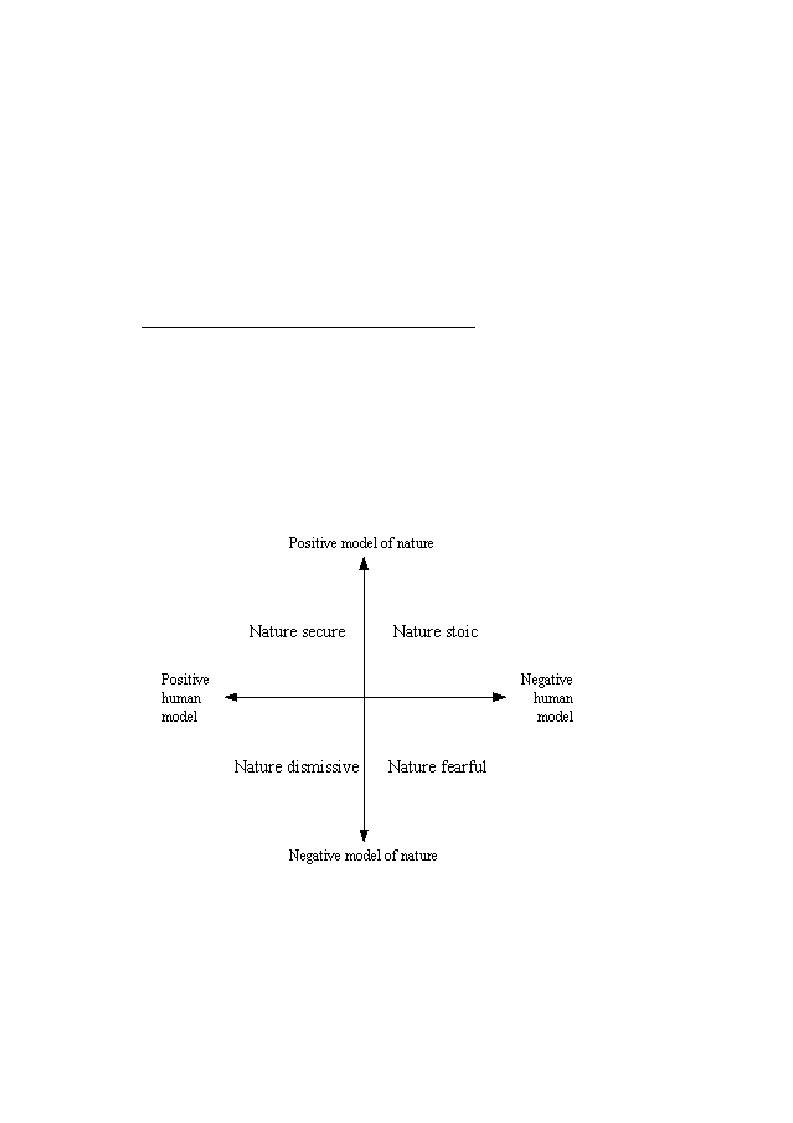
Furthermore, one might logically ask how we might test for ‘attachment to nature’. From
this question intriguing possibilities flow. Before the modern conceptualization was settled
upon, a lack of grounding in empirical evidence prevented human attachment theory from
gaining wide acceptance from some psychologists. The breakthrough that surmounted that
problem was the development of the Strange Situation procedure, which provided a
repeatable, behavioural assessment of attachment status. Some years later, the evidence that
procedure furnished fed into Bartholomew’s (Bartholomew 1990; Griffin and Bartholomew
1994) proposal of the four-category model.
9.8.4 A model for a General Theory of Attachment
Comparing that four-category model with the four ecoemotionality scale categories, there
is an inescapable echo of human attachment in the latter. If we then map these
ecoemotionality factors onto Bartholomew’s two-dimensional human framework, the
possibility of an at least two-dimensional nature attachment typology (with the axes
relabeled as seems most fitting for internal working models of other humans and nature)
begins to seem appealing:
Figure 9.1: Proposed four category model of nature attachment
278

Of course in order to make this four-category model meaningful, we must postulate that
we possess an internal working model of nature, a new departure but one that follows the
logic of attachment to nature constituting a genuine relationship.
Working backwards by analogy from this proposed model and comparing the relationship
of the four-category human attachment model to the Strange Situation procedure, one might
reasonably ask whether it might be possible to design (or observe) an analogous behavioural
test for nature attachment. Principal components analysis of the data for outdoor recreation
(the complete examination of which has been held over to a later stage) produced
‘outdoorsiness’ factors termed ‘at ease’ and ‘loner’, again to some degree redolent of
attachment-like behaviours.
Could it be that a self-report (or observational) test of a person’s outdoor recreational
behaviour reliably betrays their inner attitude or state of nature anxiety and avoidance?
People are known to experience ambiguous emotions about nature, including both attraction
and anxiety, for example in the case of urban woods (Burgess 1995), where people’s entire
lives are played out within a forest (Kenrick 1996), and cross-culturally (Anderson, E.N.
1996). Certainly ‘secure base’ behaviour is known to occur in adulthood more generally
(Crowell, Treboux et al. 2002). There is curiously suggestive evidence that there may in fact
be something to this case in the intercorrelations between the behavioural (outdoorsiness)
and attitudinal (ecoevaluations27 and ecoemotionality28) scale factors.
From a source unconnected to attachment theory comes another possible clue. Beckman
(Undated) revised Douglas’ model of ‘thought styles’29 to apply to attitudes to nature
(Douglas 1996; Keller and Poferl 1998). The four proposed thought styles characterize
nature as, respectively, benign, tolerant, ephemeral and capricious, yet again seeming to
carry echoes of the four attachment categories.
27 There is a tantalizingly close to one-to-one relationship between ecoevaluation and outdoorsiness
factors: Conservationist correlates only with at ease (p < .05); Loner only with ecocentric (p < .01);
And pragmatist only with technocentric (p < .05); But utilitarian correlates with no ecoevaluation
factor (analysis of outdoorsiness factors is outwith this work; contact author for details).
28 At ease correlates with secure and stoic (p < .01) and dismissive (negative) (p < .05); Loner with
secure and stoic (p < .01), and negatively with dismissive (p < .05); Utilitarian with dismissive and
fearful (negative) (p < .01); And pragmatist with dismissive and fearful (negative) (p < .01) and stoic
(negative ) (p < .05). Overall outdoorsiness score also correlates (p < .01) with both secure and fearful
(negative), but not with dismissive and stoic, indicating that the latter two factors may be at opposite
ends of a scale of ‘nature avoidance’ (analysis of outdoorsiness factors is outwith this work; contact
author for details).
29 Created by Douglas for the purpose of capturing overall attitudinal orientations to experience.
279
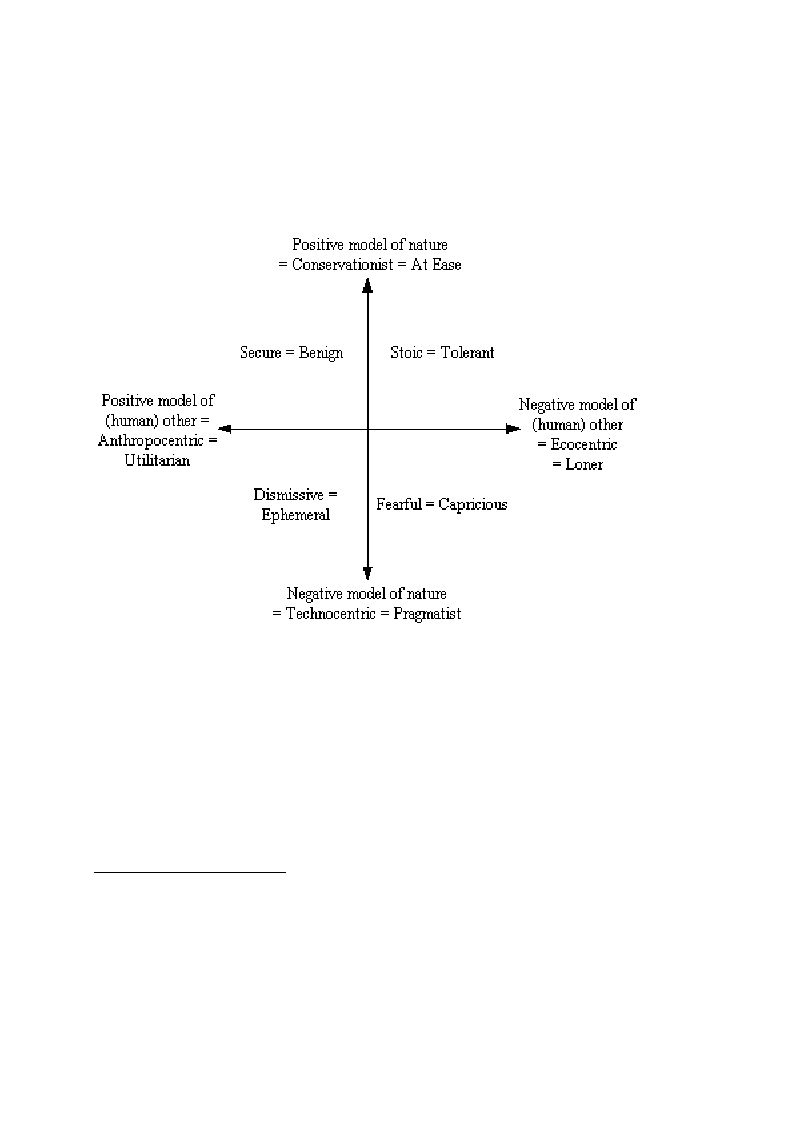
Is it possible that this stylization has unwittingly described ‘nature attachment‘
categories? There is no empirical evidence for this, but the temptation to at least attempt a
speculative ‘best fit’ of both Beckman’s styles and the scale factors derived from this study
onto the proposed model is too great for this author to ignore. Taking into account all the
known relationships, personal judgment alone would suggest the following:
Figure 9.2: Possible nature attachment model incorporating derived factors
At this stage this model must be seen as highly tentative and based on narrow (and
incompletely examined) evidence. It immediately calls forth problems (e.g. the fit
corresponds to most of the known relationships between factors, but some relationships are
contradictory30) and is proposed with a degree of uncertainty (for instance, partial rotation of
certain of the axes may offer an improvement), but that is not to say it may not be a useful
basis for subsequent research into human-nature relations.
30 E.g. both at ease and loner correlate positively with secure and stoic but negatively with dismissive,
and; it is not surprising to find ecocentric loners having the most negative model of humans, but this
position equates to an intermediate better model of nature – surely ecocentrics would have a highly
positive model of nature?
280
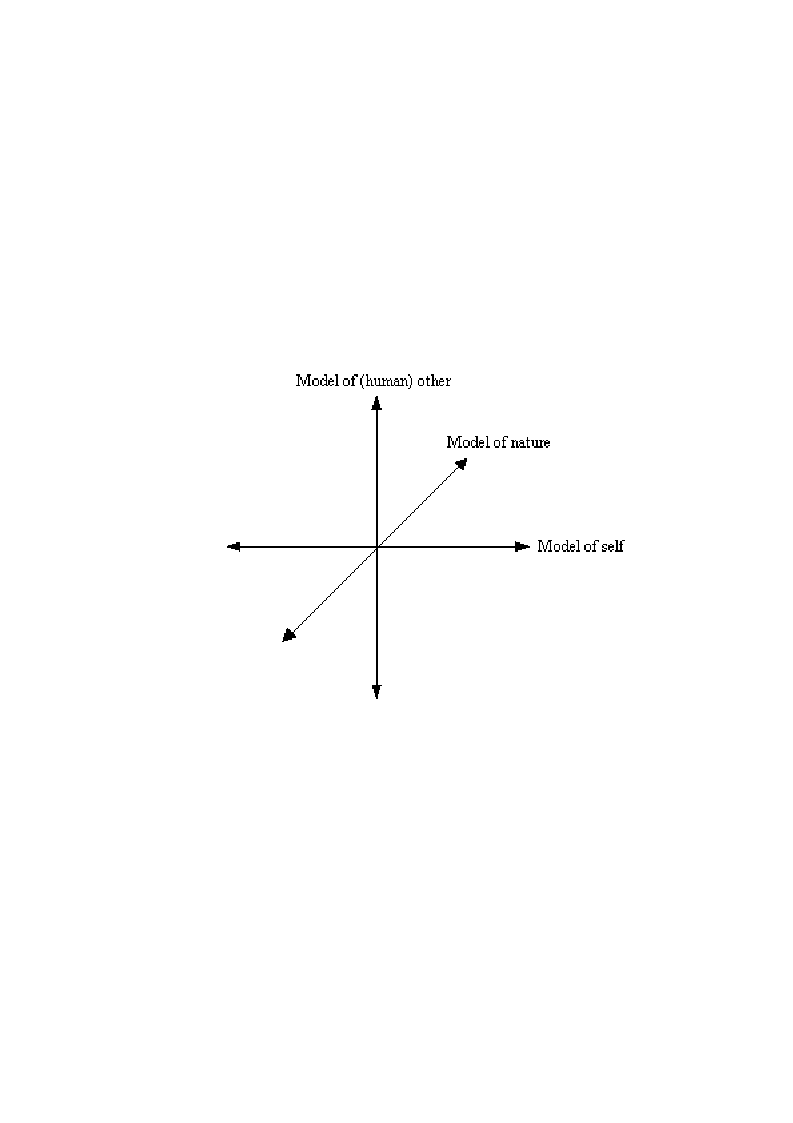
If we accept however that an attachment mechanism may indeed apply in respect of the
non-human (and therefore a model of this kind would be required), how might it relate to the
established two-dimensional model of human attachment? We have seen evidence for
instance that secure (human) attachment and nature security do not seem to go together – the
relationships appear distinct (i.e. not coincident). Here speculation is pushed to its furthest
point in this thesis, for which there is no direct evidence: perhaps there could be a three
dimensional interpretation in which attachment to nature becomes a third dimensional axis to
human attachment. It may even be that, given the different attitudes that have been shown to
arise from experience of mammals, non-mammals and the non-sentient, there may be more
than three axes of attachment overall (but this cannot be represented in a simple diagram).
Figure 9.3: Speculative 3D model of human-nature attachment relations
Finally with regard to attachment, the notion of ‘rejective environmentalism’ has been
proposed: that children suffering from overt or implicit parental neglect or abuse who do not
have access to a human pseudo-parental replacement may turn to non-human satisfiers. One
clue might lie in the fact that attachment to place and to people do not seem to correspond:
Hess hypothesized that secure adults would tend to loving attachment to place, the
preoccupied would idealize, the dismissing consider it unimportant, and the fearful would
find the memories painful. An inconsistent pattern was demonstrated, though place in its
281

own right was found to be important to the development of a sense of personal security and
identity (Hess 1998). If correct, ‘rejective environmentalism’ implies that there may be an
innate minimal threshold for attachment, and the phenomenon may underlie some people’s
consuming interest in or close relationship with pets, outdoor recreation, gardens, natural
history, botany or zoology.
It also reactivates the question of whether such stand-in attachment targets would
constitute inadequate or pathological replacements, or whether this is a rational and healthy
reaction to circumstances. Modern urban cultures may themselves suffer from a blanket
pathological separation from nature: a longer term or cross-cultural perspective might
suggest that a balanced personality would have an emotionally engaged relationship with
both the human and non-human. It could also be counted as an intriguing hint of support for
the biophilia hypothesis – the innate ‘love of nature’ (Kellert and Wilson 1993).
In addressing the potential for adding to or amending attachment theory with regard to
experience of nature, a related but important question has been left aside. This research
employed approaches to the measurement of environmental attitudes and values established
over 20 years ago, which are still by and large accepted. The author included two different
scales for environmental attitude measurement for a number of reasons, not least of which
was that they apparently addressed different dimensions of relating to the environment.
Since the results obtained for ecoevaluations and ecoemotionality are divergent (in terms
of both factors derived and the pattern of relationships between these two scales and other
scales31), the perception that the two scales are not in fact measuring the same things seems
to have been vindicated. The ecoevaluations scale seems on face validity to be measuring a
more cognitive dimension of attitudes, the ecoemotionality scale a more affective dimension.
We have examined the implications of this in terms of attachment theory but, to take a step
back, how might these differing scales relate to their initial intent, which is to characterise
environmentalism, and to the way we understand environmental learning?
31 There is clearly an interesting pattern of relationships between the ecoevaluation and
ecoemotionality factors, but it is far from a one-to-one correspondence. Nature secure correlates (p <
.01) with conservationist and ecocentric, as might be predicted; Nature dismissive correlates with
anthropocentric, technocentric and negatively with conservationist (all p < .01); Nature stoic
correlates with no ecoevaluation factors, but comes closest to anthropocentric (p = .067) - again
perhaps to be expected; but perplexingly nature fearful correlates with anthropocentric, technocentric
– explicable – but also ecocentric (all p < .05) and not conservationist – positively odd if the
technocentric-ecocentric continuum is a correct understanding of the structure of environmental
values (for full tables see appendices on CD-ROM).
282
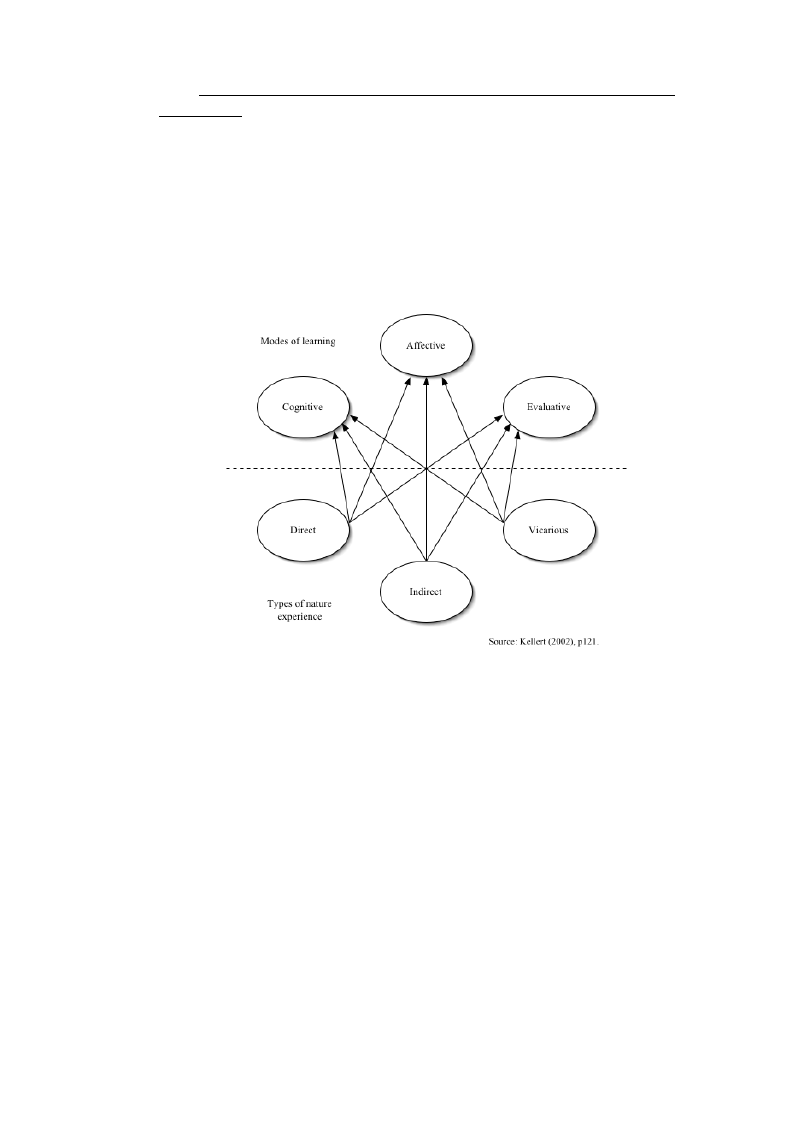
9.8.5 Environmentalism as motivation for learning about (attachment
to) nature?
What exactly is environmentalism? At one level, it is to espouse pro-environmental
attitudes. Earlier it was suggested that in addition to the appropriate attitudes, a propensity to
act upon those attitudes may also be characteristic. One incidental possibility is that
‘environmentalism’ equates to secure ‘attachment to nature’ status. But ecocentrism is not in
the same location as nature secure in the possible nature attachment model above, which
Thompson and Barton’s (1994) work suggests it might.
Figure 9.4: Types of nature experience and modes of learning
As this thesis was being concluded, Kellert (2002) published a diagram to describe the
relationships between his proposed three types of nature experience and what he sees as the
three possible modes of learning about nature. Whilst this diagram undoubtedly helps clarify
the relationships, there appear to be two immediate problems with it. First, it seems perhaps
inadvertently to suggest that all nine relationships are of equal value: this thesis and much
prior work throw that assumption into serious question (and to be fair Kellert does in his
accompanying text acknowledge ‘considerable uncertainty … (over the) … functional and
adaptive balance’ of the different types of experience of nature in childhood). It also makes a
point of separating out ‘evaluative’ learning from ‘cognitive’, and omitting behavioural (or
habitual) learning entirely.
283

We know that ecoactive adults tended to have had ecopractical parents. There were clear
and positive relationships between children’s direct relations with nature - particularly
independent exploratory behaviour - and ecoemotionality, but none between play and
wander behaviours and ecoevaluations. It is known that adult attitudes are not always very
reliable predictors of behaviour. What could account for this pattern of relationships?
Cumulatively, the evidence begins to hint at the possibility of differing mechanisms that
would underpin the formation of affective, cognitive and behavioural orientations toward the
non-human. It certainly seems on surface validity at least to accord with the known
multifactorial structure of motivations for environmental behaviour (Bamberg and Schmidt
2003). It follows that environmentalism itself might not be unidimensional but in fact be a
term used to describe a more complex multifactorial phenomenon (of perhaps three ‘types’
or ‘dimensions’) which Kellert’s framework helps us characterise. Additional circumstantial
evidence for this view comes from Bixler et al (2002), who claim that while childhood play
in wild environments relates to more positive adolescent perceptions of and outdoor
recreation activities in natural environments, it does not affect intellectual interest in
environmental sciences or environmentalism.
Direct (‘ecstatic’) childhood experience of nature would be the strongest influence of all,
having its most significant impact on the affective domain but also tending to reinforce some
behaviours (e.g. wandering in nature). The closely corresponding ‘emotional’, ‘gut’, or
‘experiential’ environmentalism would have a significant but lesser grounding in indirect
experience and affective mentorship (i.e. adults who set a tone of confident, respectful
interactions with nature). The balance between the two is unknown, but the former is
unsubstitutable by either of the latter. It may be the only type of environmentalism that
consistently motivates nature-friendly action without external reinforcement.
Indirect experience of nature such as interaction with highly controlled versions of nature
(e.g. regimented gardens) and adult nature mentorship would be likely to have its greatest
impact on the affective and behavioural domains. The most closely corresponding type of
environmentalism would be the ‘habitual’, or ‘mimic’ dimension, which would be based on
repetition of observed or performed routine including the practices of parents, peers and
other role models. There is a suspicion that this may not be tied to any particular set of
values. Thus a child whose parents were diligent conservers of physical resources might do
the same in adulthood, without necessarily any strong opinions linking that behaviour to
environmental reasoning.
Vicarious (i.e. the most culturally determined and factually-based aspect of) experience
would have its greatest impact on the cognitive dimension, but would also have a lesser
284
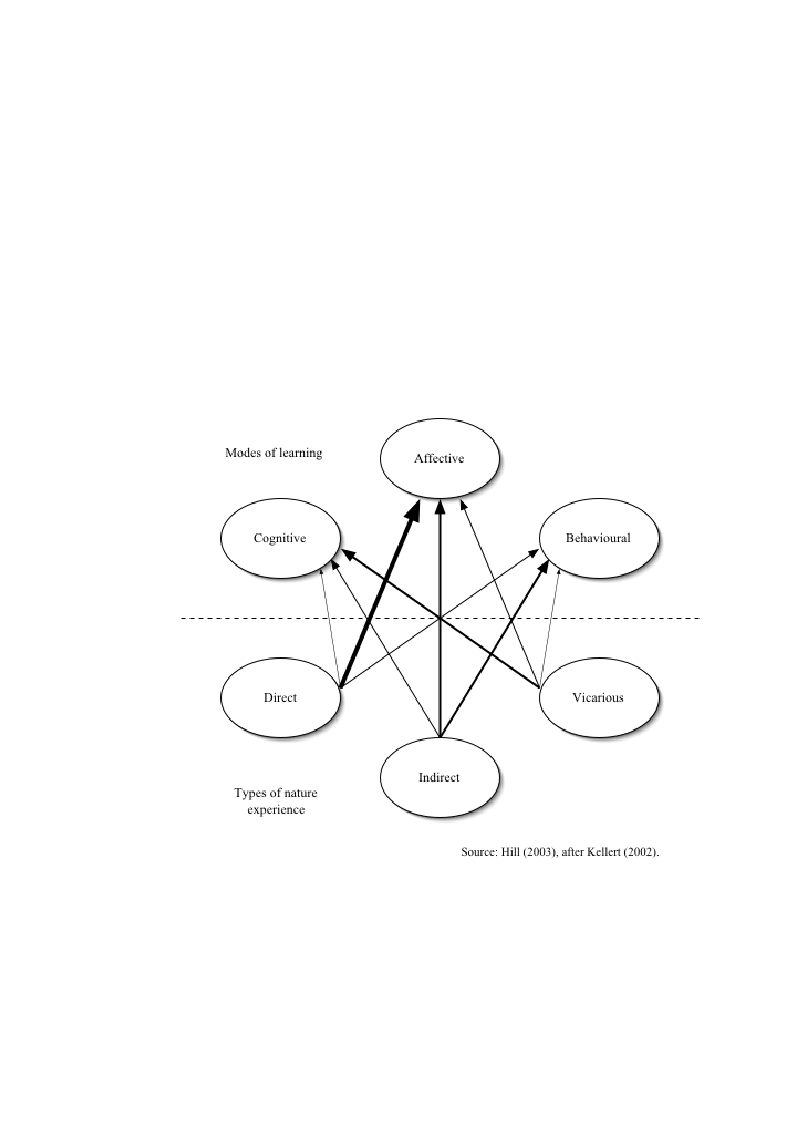
impact on the affective (e.g. reading about anthropomorphized animals in books). The
corresponding cognitive, ‘intellectual’ environmentalism would be marked by early and
persistent pursuit of ‘information’ and (arguably) relationally disengaged ‘study’ of nature.
There is some suspicion that this would occur more often in individuals who are dissociated
to some degree from themselves or others.
This author would therefore make a number of changes to Kellert’s original to produce a
diagram that more accurately reflects these notions. Firstly, evaluative learning (the
development of ‘values, beliefs and moral perspectives’) is more conventionally regarded as
a product of cognitive, affective and behavioural learning than a separate category of
learning itself: hence, evaluative learning would be replaced by behavioural learning.
Secondly, the arrows indicating influence of experience on learning would be given a
weighting (thickness) to reflect their potential significance or power, given the suggestions
above and the various pointers in this thesis.
Figure 9.5: Revised relationships between nature learning and experience
285

This diagram is merely a convenient graphical presentation of some ideas about the
overall comparative importance of the three modes of learning: it does not address the
questions of how their relative significance might vary with time, or how these ideas might
relate to the revisions suggested above to attachment theory. It reiterates, however, that given
that direct experience is probably the strongest influence on learning about nature and in
particular seems to affect the affective domain perhaps, after all, genuinely active
environmentalism is rooted in direct nature experience.
9.9 Conclusions: What was intended and pulling the strands of
theory together
Plenty of research suggests influences and mechanisms of attitude change in adulthood,
but more often than not it fails to identify why attitudes are as they are in the first place.
Underlying the basic personality orientation of adults in many areas of relating in general is
early experience. The limited work that has been done on the sources of these values in
respect to relations with the environment points to some of the factors I have examined. This
research confirms quantitatively that multiple childhood influences contribute to adult
attitudes to nature, including in particular both the influences identified previously as most
important in Significant Life Experiences research - spending time in nature, and parents.
Hence it can conservatively be concluded that these factors are indeed pre-eminent in
shaping environmental values, and that they are related to other values held by adults in
relatively predictable patterns.
The justifications for carrying out this thesis included clarification of the degree of
correlation between the various influences and outcomes, and the working out of novel
theoretical implications and finer distinctions that others may productively follow; the
testing of new instruments for investigating this field has been a potentially useful spin-off.
Specific questions have been clarified regarding the influence of: direct, indirect and
vicarious contact with nature; principal caregivers/close others, and certain broader
sociocultural factors including media. In particular, the ‘headline’ conclusions reached
suggest that:
• Attachment to nature exists distinct from human attachments;
• Independent exploration is critical to its establishment;
286

• Parental attachment relations can facilitate or inhibit nature attachment;
• Poor human attachment can reinforce nature attachment;
• Sympathetic adults can facilitate children’s curiosity and experimentation,
suggesting a ‘mediated nature resilience’ effect;
• Vicarious experience of nature cannot replace real experience;
• Having lower animal pets enhances environmental sympathy;
• Places with absent or degraded nature or which afford insufficient exploratory
and ‘nest building’ opportunities may impede nature security;
• Large families may obstruct nature familiarity;
• Environmentalism may be multidimensional.
None of these findings in themselves preclude other sources of variation of environmental
attitudes than the ones I have identified (for instance culture, economic or personal
pressures, life experience as an adult). Unexamined influences include for example those of
climate, ecosystem of upbringing, and the personality traits, history and culture of
respondents.
To those who would suspect that the effects of topography or weather are peripheral to
psychology’s ‘real’ intra- and interpersonal concerns it is worth pointing that the
diametrically opposite point has been made; namely that an indigenous-based
‘ecopsychological model’ of psychological well-being (specifically the Hoop (inter-
relatedness in the horizontal dimension) and the Tree (capturing groundedness and aspiration
in the vertical dimension)) proves that ‘psychology is ecopsychology’ (Hoffman 1998).
Qualitatively dissimilar, relations with the non-human are not inferior versions of the
‘real thing’, humans. They are non-substitutable, differentiated components of a greater
picture of fully relating to the world at large. Whilst we await (though may never obtain)
definitive ‘proof’ of the biophilia hypothesis’ inbred ‘love of nature’, it is evident that the
non-human can – and in a fully functional person does - hold unique emotional salience.
We feel nature because we cannot afford not to live in ‘affective landscapes’ –
environments we traverse which offer threats and comforts, dangers and refuges to which we
must respond, often as quickly as, quite literally, humanly possible. Bereft of our ‘Hare
Brains’, or our ‘Tortoise Minds’ (Claxton 1997) we would not be able adequately to protect
ourselves. Hence, our relationship with nature may not be primarily mediated through
conceptualized and verbalized ideas and opinions about nature (although developmentally
287

and evolutionarily they come to matter), but through subconscious, hard-wired feelings and
accompanying behaviours. These emotional landscapes may be the product of individual and
collective interaction and experience, but they are not merely subjective, they are shared and
real. Silently, subtly, and almost always beneath awareness, they profoundly govern our
lives.
Over the life-span, it does not stretch a point too far to suggest that healthy relatedness to
the non-human may rival in importance healthy human relations: it is certainly true that one
cannot be replaced by a surfeit of the other without marked effects, some might say damage,
occurring. Deprivation may precipitate its own particular psychopathology, as when having
no choice but to work indoors:
‘… my tendency to feel depressed may have less to do with any latent
psychopathology or specific ‘stressor’ than it has to do with the impossibility of
fulfilling my deeply intuited need to be part of a world that makes sense in a bodily,
spiritual, and ecological way. Complementarily, the ‘ability’ to tolerate such
inhuman conditions without becoming depressed may also be understood, when
seen within a broader ecological context, as a sort of numbed acquiescence to a
slow spiritual and ecological death.’ (Kidner 2001, 69-70)
On the other hand, a realistic yet sympathetic relationship with nature (the ‘world’),
embodying trust in its beneficence, and an appropriate wariness of its hazards, may well be a
mark of mental health, acting as it does as a reliable friend, a bulwark against difficulties
elsewhere in life. The parallels with healthy human relationships are striking. Both can only
be attained through first hand experience.
If our continuing quality of life and perhaps survival depends on making a success of this
relationship – and it is argued herein that we do not have a choice not to – then
understanding its ontogeny is pivotal, guiding its unfolding in future generations critical, and
therapeutically treating its damaging malformations in present populations highly desirable.
288

289

Chapter 10: Consequences, applications and further research
‘Every child should have mud pies, grasshoppers, water bugs, tadpoles, frogs,
mud turtles, elderberries, wild strawberries, acorns, chestnuts, trees to climb.
Brooks to wade, water lilies, woodchucks, bats, bees, butterflies, various animals
to pet, hayfields, pine-cones, rocks to roll, sand, snakes, huckleberries and hornets;
and any child who has been deprived of these has been deprived of the best part of
... education’
Luther Burbank
The previous chapters confirm that the primary influence on children’s relationship with
nature is hands-on personal experience, which is irreplaceable, and which leads to adults
who are assured and empathic in their dealings with the non-human. For that to happen, the
child probably needs first to develop good relationships with parents, and then have both
opportunity and permission to explore. Nature-confident adults can provide a healthy
example just by doing what they already enjoy. Where these circumstances fail, children
may still turn to nature but in perhaps less secure, more ‘needy’ ways.
As a result of these findings we are now able broadly to conceive of a generic,
experiential pathway by which we arrive at our basic orientation to the non-human, which
implicates nature itself, our earliest social engagements, and our own curiosity. Our place
and situation of upbringing are demonstrably critical in forming our ‘ecological self’ (Naess
1989), which will inevitably be expressed through behaviours (see Chapter 3). Since they in
turn help shape our environment, we have a feedback loop.
In the following pages a speculative model is offered for understanding how our culture
might be seen to mitigate in multiple, mutually reinforcing ways against the successful
formation of secure relationships with nature. A series of specific interventions is proposed,
many underpinned or endorsed by these research findings (and not all directed at
childhood32), but all with the potential to contribute to the reversal of what can seem like a
32 The admittedly arguable assumption being made that what works for children may well also be
positive for adults.
290

downward spiral. These include: supporting good ‘nature parenting’ and ‘mentoring’;
providing opportunities for positive, self-directed interaction with nature; taking into account
individual differences in relations with nature, and; never forgetting the central issue – direct
unsupervised contact.
Finally, it is hoped that the emerging theoretical directions presented here, particularly
the proposal for a General Theory of Attachment encompassing all emotionally salient
phenomena, will be taken forward by other researchers. As a contribution, a considerable
number of suggestions for further research are assembled, mostly springing either directly or
tangentially from this work.
10.1 Applications
10.1.1 An intergenerational downward spiral
In focusing on what happens when we vary the amount and quality of contact that
children have with non-human nature in its various forms, we have revealed some of the
likely consequences in later attitudes and perhaps in behaviour. Though we cannot be sure
how these attitudes and behaviours described will play out in society at large, this author has
no difficulty in believing that there will inevitably be significant outcomes. Now, therefore,
comes the time to broaden consideration once again to the way in which consequences that
we should not wish to happen may already be having their effects in society, what practical
steps might be taken to address such problems, and what questions future researchers might
consider asking in order to throw more light on what could be a life or death situation for our
species.
Childhood experience may fundamentally pattern attitudes of adults to nature, and nature
does not cease to act on the psyche merely because one is no longer a child. Many of the
psychological correlates of the path of continued ecological loss that we have manifestly
followed are ongoing, and many will worsen, including33:
33 Incidentally, many of these also apply to the loss of internal complexity in human societies
precipitated by amongst other things the market economy, but this is a wider debate that has
deliberately been avoided in this thesis.
291

• Loss of physical complexity in our world and the beneficial challenge of
surroundings, resulting in: fewer aesthetic pleasures, peak experiences, creative
inspiration; a narrowing of the individual and collective knowledge base; loss of
human cultural breadth, diversity and tolerance of ‘the other’;
• Reduction in complexity of interspecies relationships generally, including a
reduction in variety of non-human ‘others’ to whom to humans can relate;
• Fewer opportunities for environmental ‘nurturance’, including a reduction in the
capacity of the environment to ‘soothe’;
• Increasing difficulty in acquiring and maintaining secure supplies of resources,
and competition in for them;
• Deteriorating Quality of Life, greater necessity for unsought mobility, more
environmental challenges (e.g. weather) and disasters (e.g. floods, fires), and
increasing isolation (e.g. ecologist Aldo Leopold’s assertion that an ecologist
lives ‘alone in a world of wounds’) and psychiatric symptoms (e.g. depression).
If, as is known, anti-environmental behaviour precipitates a decline in the quality of the
natural environment and, as is suspected, a worse environment impacts negatively on mental
health and attitudes to the environment, the probable cumulative effect over time may be a
downward spiraling of both, each fuelling decline in the other.
This notion of an interlocked downward spiraling or negative feedback loop between
environment and human psychology finds at least a partial illustrative mechanism in Kahn’s
proposed ‘environmental generational amnesia’ (EGA) (Kahn Jr. 2001, 183-4). Building on
findings that while two thirds of children in a garbage-strewn and polluted neighbourhood of
Houston, Texas understood the concept of pollution in general terms, yet only one third
believed it affected them directly, Kahn suggests that each generation calibrates anew its
expectations of the environment. Thus, ‘if one’s only experience is with a certain amount of
pollution, then that amount becomes not pollution but the norm against which more polluted
states are measured.’
292
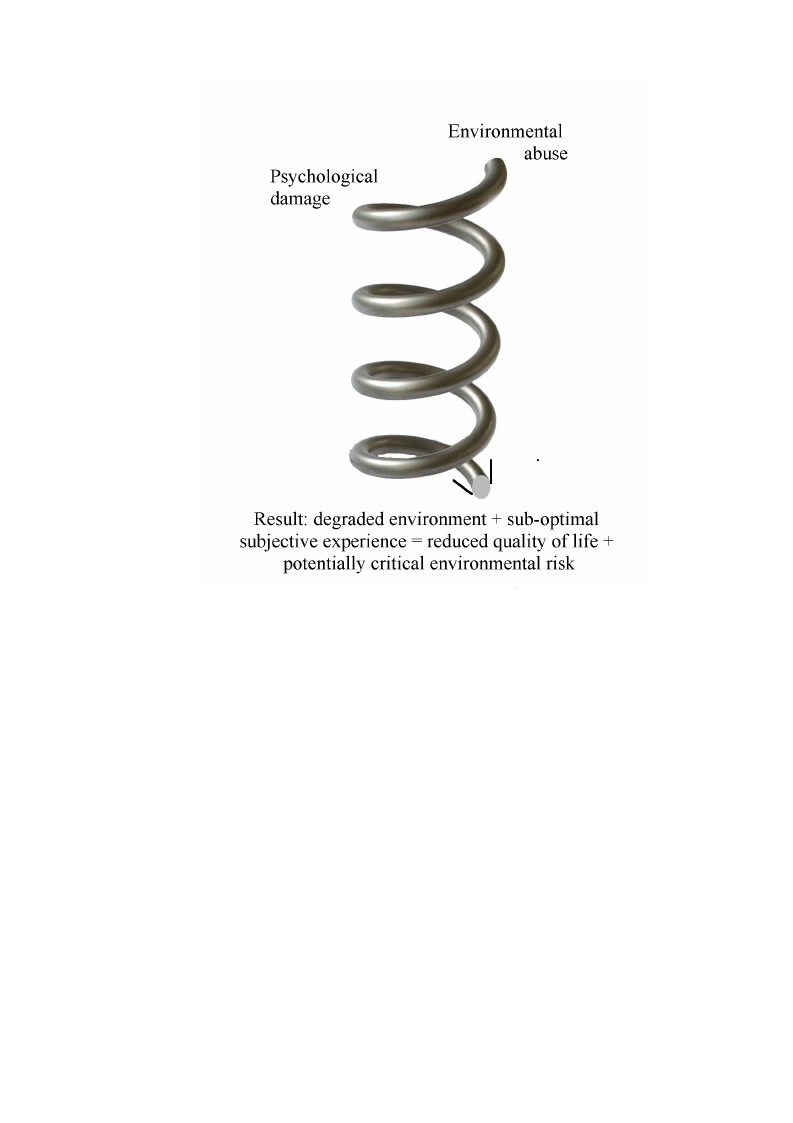
Figure 10.1: Cycle of enviromental-psychological deterioration
Each generation takes as its norm (effectively the ‘non-polluted condition’) the
environment encountered during childhood, and with each generation environmental quality
deteriorates. The overall timescale of serious deterioration being greater than our lifetimes,
we are unable to realise in a direct and experiential way the cumulative effect. This is why
for most people the motivation to act is absent. If this EGA does indeed exist, ‘it helps
provide a psychological account of how our world has moved toward its environmentally
precarious state.’ Thus we are given a reason for actively maintaining parks and preserves in
and near cities as a matter of need, and for taking children there (Kahn Jr. 2001, 6-7).
It is interesting to speculate how this psychological deterioration – presumably involving
a more hostile internal working model of nature – may act: how it contributes to poorer
subjective experience and what part it plays in increasing nature-hostile behaviour.
293

As a parallel model of a perhaps not unrelated process, it has been proposed that just as
we have domesticated and brought under our control animals and nature at large, so too have
we ‘domesticated’ ourselves (Wilson 1988). The suggestion that the once wild and free
Homo sapiens exists now only in urban zoos, a sorrowful shadow of its former self may be a
Romantic idea, but it appears to be more – to go beyond a mere physical analogy for
civilisation and urbanisation. The proposal is that this process of domesticated
imprisonment, conscious or not, is one that at its heart has the increasing internalisation of
the machine metaphor for a human being. Whether we know it or not, we may have
undertaken a Mephistophelian bargain for what appear to be the benefits of modernity, the
downside of which is a degrading change in human consciousness and, indeed, in human
nature itself.
To the extent that this is a correct diagnosis, and given the overall tone of this thesis, it is
perpetuated through the professionalized apparatus of modern industrial society: the health
service, architectural design and town planning, transport and economic policy. However
much their practitioners deny or remain unaware of it, their incremental exclusion of nature
and erroneous understandings of human developmental, educational, well-being and other
needs in relation to the non-human almost certainly have long-term psycho-social sequelae.
In a culture firmly set on this downward spiral, it seems that the forces mitigating against
the potentially positive effects of environmental education and education for sustainable
development may be too strong – effectively ensuring they are running up a down escalator.
It may be that they cannot succeed unless the childhood need for ordinary, everyday contact
with and independent exploration in nature is met.
10.1.2 Reversing an anti-environmental culture?
Emboldened by our new understanding, can we not make a move to help turn the tide,
changing the generations of anti-environmental culture by implementing a range of
psychologically-insightful measures? Can we, for instance, embed much more prominently
what might be termed ‘ecopsychological intelligence’ in all spheres of life, to create an
‘environmentally aware society’ analogous to the call for emotional intelligence that may
lead to a psychologically aware society? (James 1998).
Can, for example, Attachment Theory form a basis for more psychologically-informed
political policies that are likely to deliver environmental repair? Holmes (1996) notes that
since the notion of ‘security’ is common currency to both political dialogue and
psychotherapeutic discourse (which emphasises security as a central human need),
294

Attachment Theory can act as a point of entry for proposals of environment-related
psychotherapy into the social debate. Social comment on psychological matters often seems,
to the expert, inept, or too general to be of practical use. Whilst warning against the dangers
of what he terms ‘attention-seeking’, in which the still largely marginal psychoprofessions
stray out of their sphere to comment on social events, like protesting citizens throwing
handfuls of gravel against advancing tanks, Holmes advocates cautious pronouncements
from Attachment Theory and the concept of security in relation to social problems that link
violence and inequality, the environment, and nationhood.
Some believe that the practice of psychologically informed therapy can directly prevent
war and other products of destructive human motives. Specific aberrations of psychological
health, argues Beck, underlie anger, interpersonal hostility, ethnic conflict and genocide.
Perpetrators, who often believe they are doing good, are locked into distorted belief systems
that control behaviour (the same in a rampaging mob as in an enraged spouse).
Psychotherapeutic tools can be used by individuals and society to undercut the emotions
driving such ‘warped thinking’ (Beck 1999). Some therapists claim that ‘immersive
moments’ - instances of complete understanding between patient and therapist - are powerful
enough to dislodge from its hiding place the alienated, detached self which our cultural
emphasis on individualism and denigration of communalism engenders, and which is blamed
for a rise in addictions and personality disorders, enabling the individual to begin
incorporating the ‘inner core’ of motives into the ‘external, social self’ (Walant 1995). The
echo of what have been identified as ‘ecstatic moments’ in nature is too obvious to ignore.
If this lofty project of renewal or healing contains even a grain of validity, then one might
also wish to plan an arguably less acute, but perhaps even more desirable therapeutic action
to support reduced environmental abuse. Certainly if one of the goals of environmentalism is
the attainment of what has been called collective ‘skillful living’, then environmentally
unsustainable behaviour can be perceived as crassly self-destructive behaviour of an addict.
Indeed the language of addiction and recovery is already in use among radical,
psychologically educated environmentalists (Glendinning, 1994).
Of course it is impractical to expect individualized, medium to long-term professional
psychotherapy ever to occur en masse. Setting aside the question of whether all therapies are
appropriate, there will be several orders of magnitude too few trained therapists available to
administer it. If we optimistically assume 20 clients per therapist at any one time, it would
require around 2 million new therapists in the UK and about 350 million globally! But if we
intend to follow the therapy model, what practicable ‘cultural ecotherapy’ options are there?
295

Individual therapy for the worst ‘offenders’ (e.g. dog-batterers) could potentially be used,
as it is in cases of marital violence. At present such a course might be politically weak, but it
is not beyond comprehension that it could come to pass. This author would still more
controversially like to see the possibility of compulsory treatment extended to those who
abuse nature in other ways. Such an approach fails, however, to address the effects of
societal reinforcements for environmentally abusive behaviour ‘offensive’ to nature. It may
not stem the flow of new offenders. Nor does it address mass low-level behaviour. Some
might argue that therapy for decision-makers – or some form of sanction that could have an
analogous world-shaking impact - may be necessary, given the way that those who manage
some business and political policies act in ways that carelessly assault the non-human. Such
an approach might result in policy changes, or it might merely cause its subjects to retire
from management positions. It might not necessarily have to take the form of overt therapy,
but perhaps take the form of advice given by alert management consultants. One such
consultant, John Elkington, reports that some powerful figures with whom he works in
multinational boardrooms have already felt and expressed despair in emotional terms
(Elkington 1995). However this recognition of the effects of careless actions by individuals
does not address the structures that put these managers into such positions, nor the attitudes
of those who put them there.
Reform of the global political and economic system so that it becomes the rule to place a
higher value on nature than is currently the case is a goal of many environmentalists.
Psychology is making a contribution through marketing of ideas and issues, generating peer
pressure, training negotiating skills and methods of conflict resolution. It can have an
impact: this kind of pressure from knowledge helped bring about nuclear disarmament of the
superpowers.
Changes in education could play a part, but perhaps not in the usual form called for of
curricular modification. Formal education seems not to be the primary shaper of
environmental attitudes. Promising results have been demonstrated however, not necessarily
directly by environmental education, but in projects that seek to explore and encourage
empathy and compassion for both peers and animals among infant school children (Arkow
and Ascione Undated; Fitzgerald 1980; Marvin, Cooper et al. 2002).
Holmes (1996) believes that clarification of ideas about the emotional effects of secure or
insecure attachment followed by their wider promulgation would be good for general
psychological health. Perhaps the same could apply to ecopsychological ideas. What must be
acknowledged is that many ideas that ‘experts’ in psychopathology claim to have established
already exist in elements of folk knowledge and behaviour, and that millions of folk-
counsellors in society, be they family doctors, priests or grandmothers dispense a listening
296
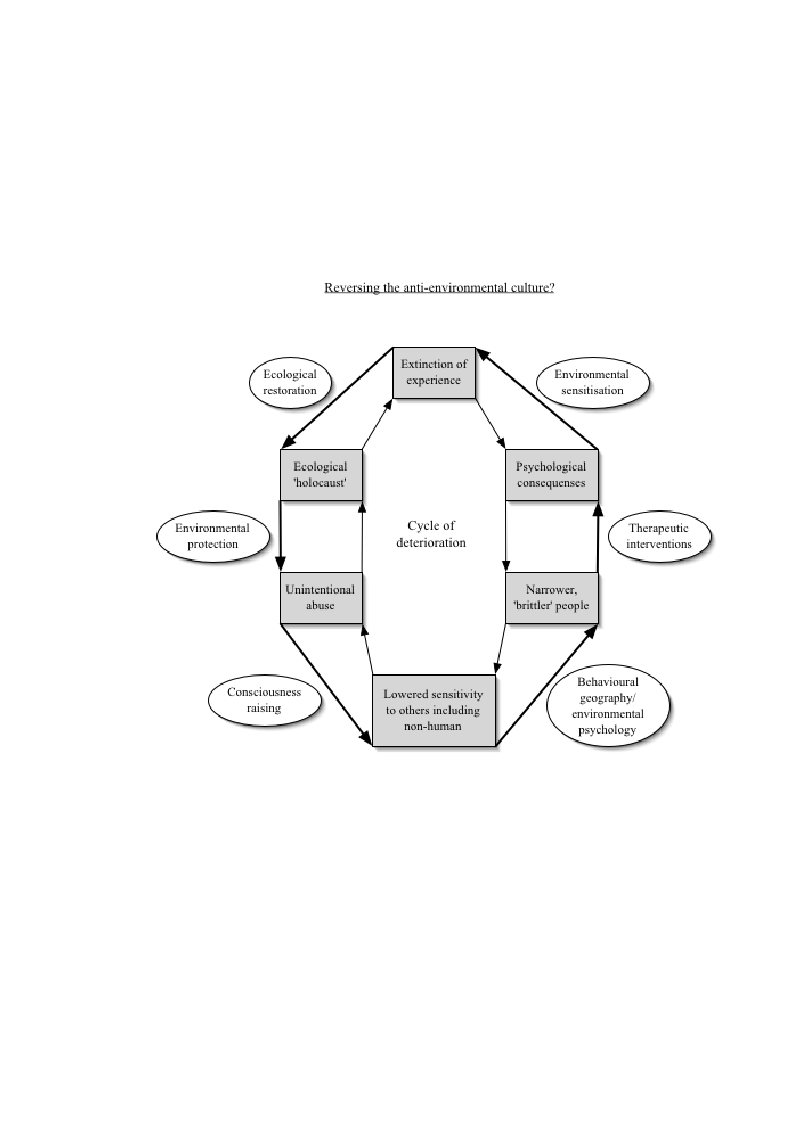
ear and worldly advice (Illich 1978). These dispensers of wise counsel are perhaps the most
efficient targets for bringing about change. Role models – e.g. pop and soap stars - are
arguably too distant, idolized, transient and immature.
Of course, none of these interventions is likely in isolation to result in the reorientation of
a culture that other drivers continue to impel in the opposite direction. Collectively, however,
it is possible that sufficient interventions may have an impact.
Figure 10.2: Proposed model for reversing anti-environmental culture
What is notably lacking from environmentalist discourse is an overarching conception of
how its various manifestations, including those mentioned above, articulate. It is to address
this omission that I proposed the following, largely self-explanatory, model (Hill 2001).
Effectively, it is to look down the centre of the spiral diagram (Figure 10.1) and to place on it
297

existing downward drivers (the clockwise, inner arrows) and existing pro-environmental
interventions (outer, anti-clockwise arrows) which might be seen as attempts to reverse each
of the elements of deterioration (Figure 10.2).
Until half way through the twentieth century, all new ideas throughout human history
have been communicated primarily interpersonally, and arguably this is still so for
meaningful, personally affecting notions. All major socio-ideological changes – for example
socialism, feminism and environmentalism - have taken several generations to become
orthodoxy. The change we seek in attitudes to the environment has to be a slow, person-to-
person revolution.
10.1.3 ‘Clinical’ applications: possible positive interventions
An illustrative selection follows of more ‘ecopsychologically-aware’ policy prescriptions
in a variety of areas (including education, planning, economics, conservation, democratic
accountability and global geopolitics), which the lessons drawn from this and other similar
research would support. Those that affect the young in particular have much in common with
recent declarations on the ‘rights of children’ (Andersson-Brolin 2002). No claim is made
that this is comprehensive, nor are items ordered by importance. For clarity a matrix of
immediate and future actions, directed respectively at the non-human and at humans, has
been considered.
10.1.3.1 Actions directed to benefit awareness of the non-human, in this
generation
• Support and promote nurturant and security-enhancing human experience of
nature – particularly by direct contact – including, for example, gardening, pet
keeping, creation and enhancement of parks, and of city farms;
• Make the environment more acceptable to people, taking into account that in the
countries causing greatest damage citizens are mainly urbanized and alienated
from nature, and therefore they find it challenging to accept nature ‘in the raw’.
An example is the Forestry Commission’s derided but correct attempt to increase
‘visitor friendliness’ by thinning out frequently visited areas (Blacker 2002);
• Encourage a sense of belonging and ‘ownership’ of objects of nature (such as
urban trees, or community woodland) through, for example, public and especially
298

local participation in decision making about, and active maintenance of, local
environments;
• Strengthen the local ability to regulate environmental exploitation, increasing
overall public system sensitivity to signals of degradation.
10.1.3.2 Actions to change humans, in this generation
• Creation of real results from collective political action (e.g. the Kyoto protocol);
• Redrawing of world trade regulations to incorporate robust, ecologically-based,
not economically-based, limitations on destructive human activity;
• Official recognition of the rights of other species and the interdependence of their
welfare with human welfare (e.g. the Earth Charter);
• Encouraging greater collaboration among professionals in a range of disciplines,
from public health to landscape architecture and city planning, to enhance
environmental benefits (Frumkin 2001);
• Incorporating affective considerations into planning. As an example of a failure
in this regard, it has been acknowledged that until recently the system used for
planning recreation in US forests was ‘incapable of incorporating emotional
issues’ (Mitchell, Force et al. 1993);
• Greening of poor neighbourhoods. It has been found that moving poor urban
children to ‘greener’ areas enhances their cognitive functioning (Wells 2000));
• Applying ecotherapy in its many guises, which is already occurring in modest
ways, but avoiding a one-size-fits-all approach. It has been shown that
encouraging ‘connectedness’ to nature in at risk children brings about
improvement in self-esteem and empathy, and diminished aggression (Feral
1998). As an example of how approaches may differ, those at ease with nature
but ill at ease with crowds of humans may benefit most from group-centred
therapy, such as experiential deep ecology, carried out in wild places; those
afraid of nature but confident with, say, older women may benefit most from
being led on wilderness journeys by a grandmother);
• Encouraging outdoor and adventure education, including sport but also
psychologically premeditated courses such as wilderness experiences and vision
quests, which could act as the ecotherapeutic equivalent of aversion therapy;
299

• Exposing the psychological underpinnings of behaviour toward nature.
‘Conventional’ and ‘ecological’ agricultural systems may have their roots not in
‘science’, but in two ways of expressing the self, and the same may also apply to
differing institutional structures and processes affecting the use of nature (Hill
1991; Hill and MacRae 1995)).
10.1.3.3 Actions in favour of the non-human, over many generations
• Absolutely prevent the further fragmentation of ecosystems and preserve
biodiversity hotspots;
• Preserve endangered animals and those whose gene pool threatens to become too
narrow for survival as a temporary measure pending habitat restoration;
• Restore and expand non-human habitats;
• Reform planning at all levels to incorporate both human- and ecosystem-scale
needs, and establish very long-term (e.g. 100 years) plans for the human
population and limits to exploitation of nature, based on best estimates of its
ability to absorb impacts (e.g. the currently politically fashionable contraction
and convergence idea for CO2 emissions);
• Reconceptualise economics from overall growth to steady state with regard to
living systems.
10.1.3.4 Actions to change human behaviour, over many generations
• Encourage cultural taboos on energy and natural resource wastage;
• Increase regional (implying 'bioregional' (Andruss 1990; Sale 1985)) co-
operation on natural resource use and managing human impacts;
• Educate on the environmental and psychological effects of consumer society and
encourage the questioning of its individual and collective purpose;
• Encourage the teaching of 'humane', emotionally sympathetic values;
• Value ecological restoration both as aesthetic amelioration and an experience of
nurturance;
300

• Accept limits to, and responsibility for management of, inequity to levels that
maintain tensions below the level that results in conflict and unacceptable
suffering.
10.2 Further Research
A lengthy series of questions that have arisen at various times during this research project
follows, arranged roughly according to domains of interest. Some relate primarily to
attachment theory, some to questions of environmental attitudes and education. Still others
are more concerned with questions of environmental and evolutionary psychology. Many
have overlapping implications for the areas into which they are (arbitrarily) grouped, and for
areas not explicitly mentioned. The author makes no claim to comprehensiveness in
theoretical or awareness terms or, again, to an arrangement in order of importance. Some of
these questions may already have been addressed in literature that the author has not
examined, and the reader will undoubtedly be capable of posing questions that have not
occurred to the author.
10.2.1 Questions that may have improved this research
As previously suggested, this survey omitted to gather data on certain parameters that
might have proved useful. Lest it be understood that the following is advocating a
lengthening of an already long questionnaire, it is worth noting that there is scope for
significantly reducing complexity in other areas (e.g. removing redundant items from scales,
using more tick box answers) to reduce the burden overall. With that proviso, future
investigations should consider gathering data on:
• Marine and freshwater environments;
• Specific ‘favourite place’ location and surroundings; the nature of and motivation
for exploratory behaviour; qualitative description of relationship with nature
mentor(s), and; details of direct/indirect and vicarious nature experience;
• Personality dimensions, e.g. internal/external locus of control, creativity;
301

• Measures of non-environmental values, e.g. political ideology (known to affect
support for environmental preservation (Steel, Steger et al. 1990) and perceptions
of risk (Steel, Soden et al. 1990)) and optimism/pessimism.
More generally, for the purposes of intergenerational comparisons, any investigation
using a similar method might benefit from building the investigation from the beginning
symmetrically around a mirroring of childhood and adult experience, and perhaps even
better add the subjects’ children’s experiences. Best of all, long term prospective following
of cohorts throughout the life cycle - in the mode of attachment studies that have enabled the
phenomenon of resilience to be demonstrated - would provide the most incontrovertible
evidence.
A final suggestion for further research on this theme is that administering a simplified
version of the questionnaire on the World Wide Web. While there are obvious difficulties of
bias toward those who are on the internet, curious about this topic, or willing and able to fill
in such a questionnaire, it may nevertheless be worthwhile since it would allow a single
author to gather data from a larger sample and hence permit greater of statistical accuracy
and more robust cross-cultural comparisons, albeit from respondents in the affluent world.
10.2.2 Theoretical questions
Future work on related theoretical questions might usefully examine the following:
• Can the findings of this survey be replicated with different target groups and
cultures, with this methodology or another?;
• Given the suggestion herein that attachment to nature is a distinct category of
human experience, there is a requirement for work to examine in greater detail
how this comes about and how it relates to attachment to human objects, in
particular whether attachments to natural objects differ in quality and intensity as
they are known to between human and companion animal attachment figures;
• What are the characteristics of an ‘internal working model of nature’?;
• What would an integrated attachment to nature or ‘Nature Bonding Instrument’
(taking into account people, animals, place and other factors) consist of?;
• Is an adult scale for attachment - an ‘Adult Strange Situation' test - feasible?;
302

• Is there such a thing as ‘nature resilience’? Is ‘security’ multidimensional,
including human and non-human relations, such that neither is substitutable?;
• Can childhood pets (or other non-human attachments) stand in for and have
similar resilience-promoting effects, to non-parental human relationships?;
• Is there such a thing as ‘rejective environmentalism’? Do pet-owning children,
who have experienced closer relationships to pets than family, have closer human
relationships in adulthood?;
• How can we adequately describe animal attachment to humans, to each other,
and to places, not just imprinting in simpler animals but the affective relations of
pet dogs and cats, domesticated animals, wild animals humans encounter, e.g. via
bird tables?;
• Is it meaningless to question whether lower animals, plants and places can
develop ‘attachments’? How does the sentient/non-sentient, dead/alive distinction
help us in the attachment to nature context? Is ‘experience’ something that only
motile and sentient objects gain? Are these not inapplicable anthropocentric
projections?;
• How low down the phylogenetic tree does attachment between animals go? How
does it develop ontogenetically – in parallel with qualitatively more complex
consciousness?;
• Is the reconstruction of the phylogenetic hierarchy in childhood based on ability
to identify emotionally with the animals or something else, such as exposure,
safety, the animal’s behavioural qualities?;
• To what extent is security engendered by familiarity with a particular place
transferable to another place? If, as seems likely, it is only partly transferable,
what part, and why?;
• Is sexual attraction enhanced by the demonstration of archetypally useful ‘male’
and ‘female’ knowledge (e.g. intimate knowledge of the home territory, ‘raiding’
skills), or attachment patterns to the non-human, over that of knowledgability in
general?;
• Can theories of group (or peer) socialization be extended to incorporate the non-
human?;
• Does further investigation support the proposed multi-dimensional
environmentalism?;
303

• Is contact with non-human nature necessary for sanity? This could be
investigated by, for instance, correlating land use with location-relevant mental
health data;
• Why do parents fear fresh water yet take children to the seaside?
10.2.3 Developmental questions
Future work on related developmental questions might usefully examine the following:
• What are the developmental (e.g. physiological, neurological, linguistic,
intellectual) effects of growing up in surroundings with particular non-human
characteristics versus others, e.g. ‘the concrete jungle’ versus ecologically rich
more natural habitat? Which physiological effects of being in natural
surroundings as adults (e.g. of birdsong, or park land) are innate and which
learned?;
• What particular characteristics of the environment (e.g. ‘greenness’, hiding
opportunities, relative danger & safety, biodiversity) have specific effects upon
the child’s mind, and what are these effects?;
• Does the therapeutic introduction of pets or other nature-related additions to a
child’s familiar environment have any long-term effect?;
• Does landscape, ecology or climate predictably affect cultural attitudes to nature?
What other factors shape cultural differences in behaviour toward nature?;
• Do the prevailing attitudes to nature in the culture a child experiences have
developmental effects?;
• Are there neuroanatomical correlates of the non-human attachment patterns, as
have been demonstrated for human attachment?;
• Why do those with more ecopolitically active parents choose to live more
rurally?
• How exactly does parental nature mediation impact on career choice?;
• Is contact with nature (as with model human relationships) always healing? If so,
is the healing in proportion to the time or intensity of contact?;
304

• Is there a threshold effect? How much nature contact and in what form (level of
sentience, place- and species-familiarity, opportunity for interaction, opportunity
for nurturance, specific characteristics of nature i.e. hostility/friendliness) is
protective for personality characteristics, or for later attitudes to nature?
• What are the effects of partial and total (if that is possible) deprivation of nature?;
• What is the normative healthy upbringing (historically, cross-culturally) in terms
of interactions with the various aspects of nature? Can modern industrial-urban
lifestyles ever approximate to this?;
• Is the disturbance of place attachment and the network of human and non-human
attachments an element in the psychological impact of involuntary migration
(including demolition of housing, territorial conquest) and what are its longer-
term consequences? Is the greater security of undisturbed inhabitants and the
insecurity of immigrants a ‘natural’ defence against territorial takeover?
10.2.4 Questions on the nature of relationships
Future work on related relational questions might usefully examine the following:
• How does this nature attachment perspective articulate with the related but more
purely psychoanalytically based object relations-attachment perspective? A
combined instrument has been devised (Buelow, McClain et al. 1996);
• As abuse of pets and children are known to co-vary, are damaging behaviours
with respect to the non-human in children and later in life more broadly related to
poor interhuman relationships?;
• Does improving a child’s (or an adult’s) non-human environment enhance
interpersonal behaviour and management of stress? If not within a lifetime, then
over generations?;
• Do those who live alone and have little social life benefit most from acquiring a
pet, as against those already living amid a complex of human relationships?
• Do parental attitudes to the non-human have effects on the formation of self?;
• What effect do sex and personality traits have on relations to nature?;
305

• Is adult ownership of a pet a symbol of the capacity for nurturance and therefore
a sexual attractant? Is it the same for both men and women? Is being seen to
‘love nature’ indeed the same phenomenon?;
• Do pet owning children have a larger total number of close relationships with
others, and are these relationships human and animal combined, or human alone?
Is reliance on the human alone in any way harmful?;
• Are children with pets more tolerant of others, and of differences between
persons?;
• What triggers the growing importance of relationships with pets in middle
childhood, and how does this pattern lead into adolescent and adult relational
patterns? Are there both normative and pathological relational sequences from
birth to senescence?;
• What are the effects of long-term familiarity with landscape on the ability to
detect change over time?
10.2.5 Educational questions
Future work on related educational questions might usefully examine the following:
• What is the absolute and comparative impact of short duration and/or intermittent
environmental education experiences, including wilderness and vision quests, on
environmental attitudes and behaviours?;
• Does the physical, emotional and personal context in which environmental
education is delivered (e.g. classroom versus woods, obedient listening to a
lecture versus more emotionally open or engaged group work, abstracted global
issues versus concrete personally relevant) affect retention and later attitudinal
and behavioural changes?;
• What is the long term effect of sustained, long term environmental education (i.e.
a prospective study from infancy to adulthood)?;
• How do factors like education and social class affect environmental attitudes and
behaviour – for example through the mediation of variables like teacher ‘nature
mentorship’ (i.e. not curriculum but personal ease with nature) and parental
ecopracticality?;
306

• Is the only truly effective ‘environmental education’ time spent in the company
of non-human nature? What qualitative factors matter and why? How and for
what reason is being alone for some of this time critical? What is the influence of
parents? Can teachers have an influence if they are not ‘inspired’ and convey
genuine enthusiasm themselves?;
• What are the comparative effects of direct preverbal experience of infant play
with the non-human versus early childhood discovery, premeditated instruction at
different stages, experience of nurturance (i.e. of classroom plants and animals),
outdoor education (including technical or ‘conquering’ versus appreciative or
‘meditative’ orientations) and wilderness experiences?
10.2.6 Health and mental health questions
There are a number of areas which future work on related health and mental health
questions might usefully include.
• Do generally well people who have regular contact with nature report greater
well-being, sleep patterns, fewer headaches, reduced joint pain in chronic illness
or any other markers of better physical health?;
• Do city children who attend a rural summer camp have better health during the
subsequent school term or year than their friends who spent the summer in the
city?;
• Do patients with serious debilitating disease (e.g. cancer, AIDS) survive longer,
have fewer infections, less pain, or higher T-cell counts, if they have pets?;
• Does time spent in hospital gardens speed postoperative recovery?;
• Is there an empirical basis for psychotherapy that utilizes contact with nature?;
• If there are individual differences in attachment to nature, might the tailored
application of a variety of ecotherapeutic approaches yield better results than
‘one-size fits all’? If any of these therapeutic approaches shows promise, which
patients will benefit and what kinds of contact with nature have the greatest
efficacy and cost effectiveness? (Frumkin 2001);
307

• Does the duration of contact with nature matter for outcomes in ways analogous
to the different effects of brief versus long-term therapy?;
• Is being a 'nature abuser' stressful and a threat to health?;
• What do (psychoanalytically defined) 'projections' onto nature ('the garden is out
of control'; 'an angry wind') signify for emotional health?;
• Does improving the environment or moving to a better one enhance health or
mental health? Are these effects only over generations? Does 'ecological health'
impact on this? As there is said to be ‘good enough’ parenting, is there 'good
enough' place attachment?
10.3 A last word
This thesis has attempted to take the phrase ‘attachment to nature’ from a loosely
employed figure of speech to a scientifically examined notion. In so doing it has provided
some empirical justification for believing that, just as direct and early experience of human
relationships crystalises into patterns of attachment that provide a semi-deterministic
foundation to later human relations, so too do unmediated, personal experience of the non-
human, and appropriate interpersonal encouragement embed enduring relational
understandings of the natural world. Should subsequent research confirm this understanding,
real and wide implications for the individual, for society and for nature itself follow.
Attachment to nature is not an analogy.
308

Chapter 11: Appendices
11.1 Questionnaire as deployed
The version reproduced below is the first publicly employed version of February 1997.
In February 2000 a second public version was issued which corrected two minor
typographical errors (page 20: ‘Tried to make me dependent on him’ under Section 6 mother
changed to her, and ‘Felt I could not look after myself unless he was around’ changed to
she).
309

310

311

312

313

314

315
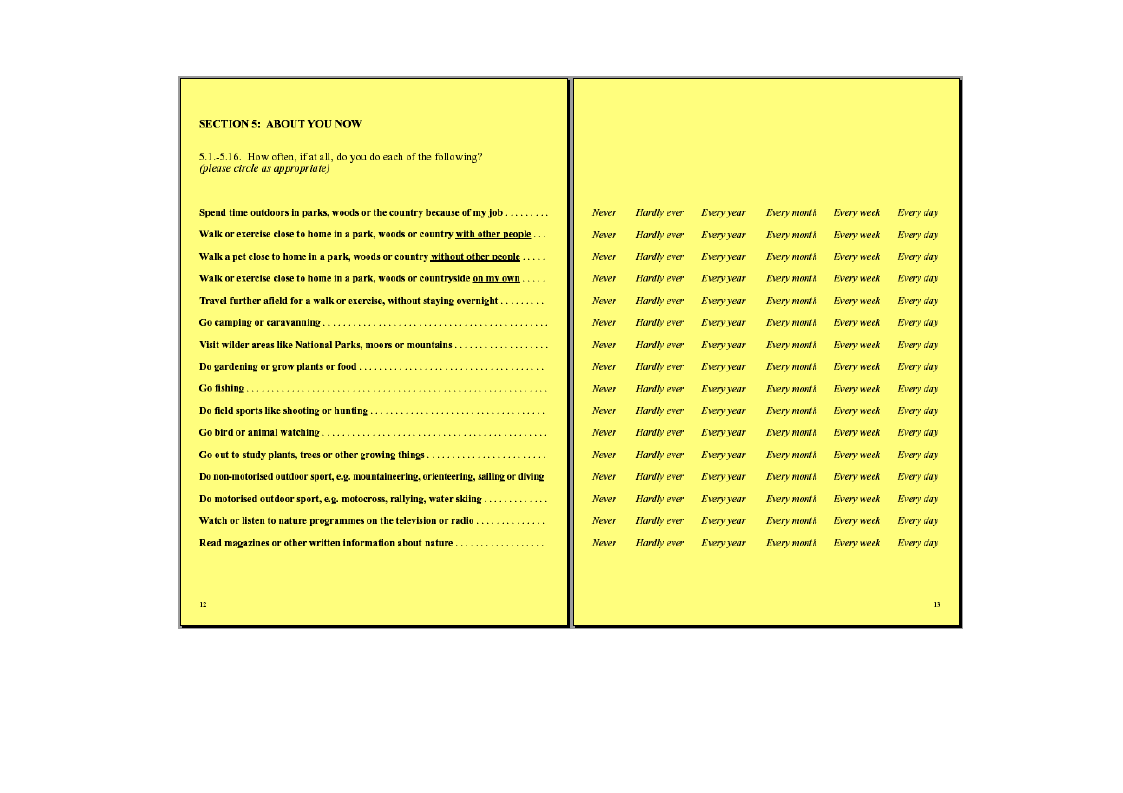
316

317
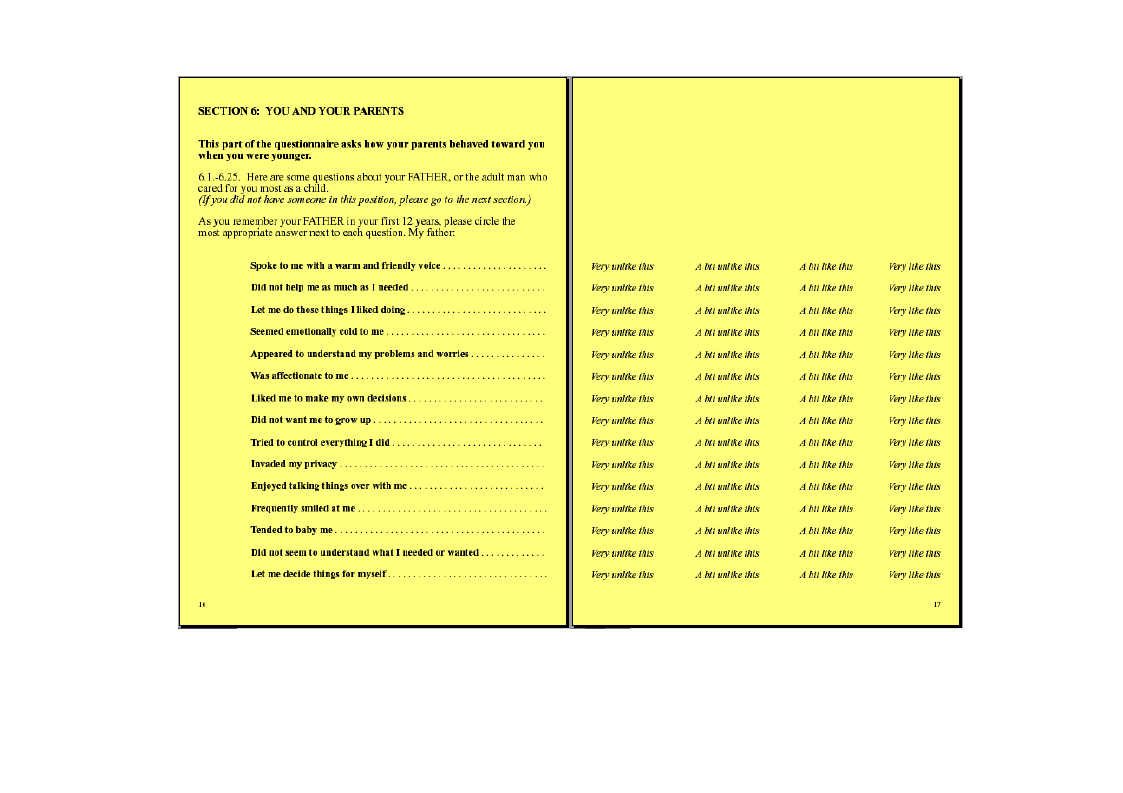
318

319

320

321

322

323

324
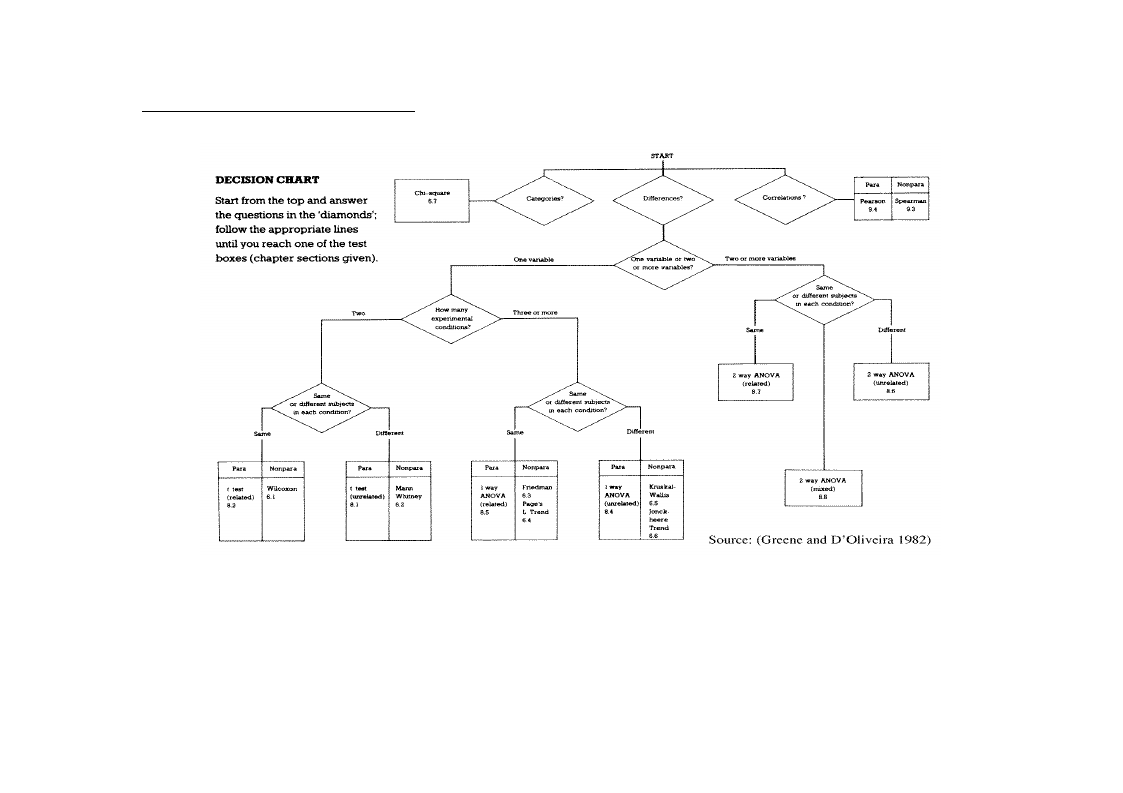
11.2 Statistical test decision flow chart
325

11.3 Sum of squares tables
11.3.1 Sum of squares tables relating to Chapter 6.1
11.3.1.1 Paternal attachment versus ecoevaluation
Tests of Between-Subjects Effects
Source
Dependent Variable
Type III Sum of
Squares
Corrected
Model
FactorScoreTechnocentric 5.181
FactorScoreAnthropocentric 2.513
FactorScoreConservationist 1.584
Intercept
FactorScoreEcocentric
11.811
FactorScoreTechnocentric 3.004
FactorScoreAnthropocentric .693
FactorScoreConservationist .713
FactorScoreEcocentric
1.969
FATTCHMT FactorScoreTechnocentric 5.181
FactorScoreAnthropocentric 2.513
FactorScoreConservationist 1.584
FactorScoreEcocentric
11.811
Error
FactorScoreTechnocentric 219.078
FactorScoreAnthropocentric 219.910
FactorScoreConservationist 226.762
FactorScoreEcocentric
215.258
Total
FactorScoreTechnocentric 224.262
FactorScoreAnthropocentric 222.425
FactorScoreConservationist 228.346
FactorScoreEcocentric
227.071
Corrected FactorScoreTechnocentric 224.259
Total
FactorScoreAnthropocentric 222.423
FactorScoreConservationist 228.346
FactorScoreEcocentric
227.069
a R Squared = .023 (Adjusted R Squared = .010)
b R Squared = .011 (Adjusted R Squared = -.002)
c R Squared = .007 (Adjusted R Squared = -.007)
d R Squared = .052 (Adjusted R Squared = .039)
df Mean
Square
3 1.727
3 .838
3 .528
3 3.937
1 3.004
1 .693
1 .713
1 1.969
3 1.727
3 .838
3 .528
3 3.937
221 .991
221 .995
221 1.026
221 .974
225
225
225
225
224
224
224
224
F Sig.
1.742 .159
.842 .472
.515 .673
4.042 .008
3.030 .083
.696 .405
.695 .405
2.021 .157
1.742 .159
.842 .472
.515 .673
4.042 .008
11.3.1.2 Maternal attachment versus ecoevaluation
Tests of Between-Subjects Effects
Source
Dependent Variable
Corrected
Model
FactorScoreTechnocentric
Type III Sum of
Squares
3.469
df Mean
Square
3 1.156
F Sig.
1.152 .329
326

FactorScoreAnthropocentric 2.882
FactorScoreConservationist 4.693
FactorScoreEcocentric
6.903
Intercept
FactorScoreTechnocentric 1.613
FactorScoreAnthropocentric 2.449E-03
FactorScoreConservationist 7.300E-02
FactorScoreEcocentric
2.124
MATTCHMT FactorScoreTechnocentric 3.469
FactorScoreAnthropocentric 2.882
FactorScoreConservationist 4.693
FactorScoreEcocentric
6.903
Error
FactorScoreTechnocentric 226.831
FactorScoreAnthropocentric 225.623
FactorScoreConservationist 225.802
FactorScoreEcocentric
221.741
Total
FactorScoreTechnocentric 230.299
FactorScoreAnthropocentric 228.523
FactorScoreConservationist 230.497
FactorScoreEcocentric
228.648
Corrected FactorScoreTechnocentric 230.299
Total
FactorScoreAnthropocentric 228.505
FactorScoreConservationist 230.495
FactorScoreEcocentric
228.643
a R Squared = .015 (Adjusted R Squared = .002)
b R Squared = .013 (Adjusted R Squared = .000)
c R Squared = .020 (Adjusted R Squared = .007)
d R Squared = .030 (Adjusted R Squared = .017)
3 .961
.962 .411
3 1.564
1.566 .199
3 2.301
2.345 .074
1 1.613
1.607 .206
1 2.449E-03 .002 .961
1 7.300E-02 .073 .787
1 2.124
2.165 .143
3 1.156
1.152 .329
3 .961
.962 .411
3 1.564
1.566 .199
3 2.301
2.345 .074
226 1.004
226 .998
226 .999
226 .981
230
230
230
230
229
229
229
229
11.3.1.3 Paternal attachment versus ecoemotionality
Tests of Between-Subjects Effects
Source
Dependent Variable
Type III Sum of
Squares
Corrected FactorScoreNatureSecure 7.761
Model
FactorScoreNatureFearful 2.806
FactorScoreNatureDismissive 1.740
FactorScoreNatureStoic
4.434
Intercept
FactorScoreNatureSecure 2.346
FactorScoreNatureFearful 1.573
FactorScoreNatureDismissive .431
FactorScoreNatureStoic
2.243
FATTCHMT FactorScoreNatureSecure 7.761
FactorScoreNatureFearful 2.806
FactorScoreNatureDismissive 1.740
FactorScoreNatureStoic
4.434
Error
FactorScoreNatureSecure 241.926
FactorScoreNatureFearful 250.606
FactorScoreNatureDismissive 247.302
df Mean
Square
3 2.587
3 .935
3 .580
3 1.478
1 2.346
1 1.573
1 .431
1 2.243
3 2.587
3 .935
3 .580
3 1.478
247 .979
247 1.015
247 1.001
F Sig.
2.641 .050
.922 .431
.579 .629
1.492 .217
2.396 .123
1.551 .214
.430 .512
2.263 .134
2.641 .050
.922 .431
.579 .629
1.492 .217
327

FactorScoreNatureStoic
244.763
Total
FactorScoreNatureSecure 249.913
FactorScoreNatureFearful 253.417
FactorScoreNatureDismissive 249.047
FactorScoreNatureStoic
249.208
Corrected FactorScoreNatureSecure 249.687
Total
FactorScoreNatureFearful 253.412
FactorScoreNatureDismissive 249.042
FactorScoreNatureStoic
249.197
a R Squared = .031 (Adjusted R Squared = .019)
b R Squared = .011 (Adjusted R Squared = -.001)
c R Squared = .007 (Adjusted R Squared = -.005)
d R Squared = .018 (Adjusted R Squared = .006)
247 .991
251
251
251
251
250
250
250
250
11.3.1.4 Maternal attachment versus ecoemotionality
Tests of Between-Subjects Effects
Source
Dependent Variable
Type III Sum of
Squares
Corrected
Model
FactorScoreNatureSecure
7.761
FactorScoreNatureFearful 2.806
FactorScoreNatureDismissive 1.740
FactorScoreNatureStoic
4.434
Intercept
FactorScoreNatureSecure 2.346
FactorScoreNatureFearful 1.573
FactorScoreNatureDismissive .431
FactorScoreNatureStoic
2.243
FATTCHMT FactorScoreNatureSecure 7.761
FactorScoreNatureFearful 2.806
FactorScoreNatureDismissive 1.740
FactorScoreNatureStoic
4.434
Error
FactorScoreNatureSecure 241.926
FactorScoreNatureFearful 250.606
FactorScoreNatureDismissive 247.302
FactorScoreNatureStoic
244.763
Total
FactorScoreNatureSecure 249.913
FactorScoreNatureFearful 253.417
FactorScoreNatureDismissive 249.047
FactorScoreNatureStoic
249.208
Corrected
Total
FactorScoreNatureSecure
249.687
FactorScoreNatureFearful 253.412
FactorScoreNatureDismissive 249.042
FactorScoreNatureStoic
249.197
a R Squared = .031 (Adjusted R Squared = .019)
b R Squared = .011 (Adjusted R Squared = -.001)
c R Squared = .007 (Adjusted R Squared = -.005)
d R Squared = .018 (Adjusted R Squared = .006)
df Mean
Square
3 2.587
3 .935
3 .580
3 1.478
1 2.346
1 1.573
1 .431
1 2.243
3 2.587
3 .935
3 .580
3 1.478
247 .979
247 1.015
247 1.001
247 .991
251
251
251
251
250
250
250
250
F Sig.
2.641 .050
.922 .431
.579 .629
1.492 .217
2.396 .123
1.551 .214
.430 .512
2.263 .134
2.641 .050
.922 .431
.579 .629
1.492 .217
328

11.3.1.5 Paternal attachment versus relative sympathies
Tests of Between-Subjects Effects
Source
Dependent Variable
Type III Sum of
Squares
Corrected FactorScoreEnvirontSympathy 6.124
Model
FactorScoreAnimalSympathy 1.932
4.024
Intercept FactorScoreEnvirontSympathy .179
FactorScoreAnimalSympathy .420
FactorScoreHumanSympathy .431
FATTCHMT FactorScoreEnvirontSympathy 6.124
FactorScoreAnimalSympathy 1.932
FactorScoreHumanSympathy 4.024
Error
FactorScoreEnvirontSympathy 265.459
FactorScoreAnimalSympathy 275.079
FactorScoreHumanSympathy 257.008
Total
FactorScoreEnvirontSympathy 271.584
FactorScoreAnimalSympathy 277.052
FactorScoreHumanSympathy 261.327
Corrected FactorScoreEnvirontSympathy 271.583
Total
FactorScoreAnimalSympathy 277.010
FactorScoreHumanSympathy 261.032
a R Squared = .023 (Adjusted R Squared = .012)
b R Squared = .007 (Adjusted R Squared = -.004)
c R Squared = .015 (Adjusted R Squared = .004)
df Mean
Square
3 2.041
3 .644
3 1.341
1 .179
1 .420
1 .431
3 2.041
3 .644
3 1.341
270 .983
270 1.019
270 .952
274
274
274
273
273
273
F Sig.
2.076 .104
.632 .595
1.409 .240
.182 .670
.413 .521
.453 .502
2.076 .104
.632 .595
1.409 .240
11.3.1.6 Maternal attachment versus relative sympathies
Tests of Between-Subjects Effects
Source
Dependent Variable
Type III Sum of
Squares
Corrected FactorScoreEnvirontSympathy 1.322
Model
FactorScoreAnimalSympathy .554
FactorScoreHumanSympathy 1.842
Intercept
FactorScoreEnvirontSympathy .556
FactorScoreAnimalSympathy .228
FactorScoreHumanSympathy .186
MATTCHMT FactorScoreEnvirontSympathy 1.322
FactorScoreAnimalSympathy .554
FactorScoreHumanSympathy 1.842
Error
FactorScoreEnvirontSympathy 280.441
FactorScoreAnimalSympathy 278.480
df Mean
Square
3 .441
3 .185
3 .614
1 .556
1 .228
1 .186
3 .441
3 .185
3 .614
276 1.016
276 1.009
F Sig.
.434 .729
.183 .908
.619 .603
.547 .460
.226 .635
.188 .665
.434 .729
.183 .908
.619 .603
329

FactorScoreHumanSympathy 273.805
Total
FactorScoreEnvirontSympathy 281.764
FactorScoreAnimalSympathy 279.035
FactorScoreHumanSympathy 275.710
Corrected FactorScoreEnvirontSympathy 281.763
Total
FactorScoreAnimalSympathy 279.033
FactorScoreHumanSympathy 275.647
a R Squared = .005 (Adjusted R Squared = -.006)
b R Squared = .002 (Adjusted R Squared = -.009)
c R Squared = .007 (Adjusted R Squared = -.004)
276 .992
280
280
280
279
279
279
11.3.1.7 Paternal attachment versus selected attitudinal and behavioural
measures
(Collated ANOVAs)
Sympathy CatOf3
Sympathy CatOf4
EcoEval Max Variance
EcoEmotion Max Variance
Parent EcoActive Cat
EcoActive Now Cat
Outdoorsiness Category
Sum of Squares df Mean Square F Sig.
Between Groups 4.183
3 1.394
.583 .627
Within Groups 663.027
277 2.394
Total
667.210
280
Between Groups 9.000
3 3.000
.930 .427
Within Groups 893.491
277 3.226
Total
902.491
280
Between Groups 3.637
3 1.212
1.081 .357
Within Groups 304.971
272 1.121
Total
308.609
275
Between Groups 6.657
3 2.219
2.011 .113
Within Groups 303.536
275 1.104
Total
310.194
278
Between Groups 6.711
3 2.237
1.632 .182
Within Groups 378.257
276 1.370
Total
384.968
279
Between Groups 7.039
3 2.346
2.910 .035
Within Groups 223.338
277 .806
Total
230.377
280
Between Groups .804
3 .268
.155 .927
Within Groups 480.477
277 1.735
Total
481.281
280
11.3.1.8 Maternal attachment versus selected attitudinal and behavioural
measures
(Collated ANOVAs)
330

Sum of Squares df Mean Square F Sig.
Sympathy CatOf3
Between Groups 1.117
3 .372
.156 .926
Within Groups 674.943
282 2.393
Total
676.059
285
Sympathy CatOf4
Between Groups 4.150
3 1.383
.436 .728
Within Groups 898.965
283 3.177
Total
903.115
286
EcoEval Max Variance Between Groups 1.666
3 .555
.489 .690
Within Groups 316.701
279 1.135
Total
318.367
282
EcoEmotion Max Variance Between Groups 8.214
3 2.738
2.463 .063
Within Groups 313.524
282 1.112
Total
321.738
285
Parent EcoActive Cat
Between Groups .477
3 .159
.235 .872
Within Groups 188.307
278 .677
Total
188.784
281
EcoActive Now Cat
Between Groups 2.054
3 .685
.988 .399
Within Groups 195.358
282 .693
Total
197.413
285
Outdoorsiness Category Between Groups 12.719
3 4.240
2.486 .061
Within Groups 482.646
283 1.705
Total
495.366
286
11.3.2 Sum of squares tables relating to Chapter 6.2
11.3.2.1 Accessible nature versus ecoevaluation
Tests of Between-Subjects Effects
Source
Dependent Variable
Type III Sum of
Squares
Corrected FactorScoreTechnocentric 4.901
Model
FactorScoreAnthropocentric 4.168
FactorScoreConservationist 5.881
FactorScoreEcocentric
.487
Intercept
FactorScoreTechnocentric .584
FactorScoreAnthropocentric 1.492E-02
FactorScoreConservationist .257
FactorScoreEcocentric
1.005E-02
URBNRURL FactorScoreTechnocentric 4.901
FactorScoreAnthropocentric 4.168
FactorScoreConservationist 5.881
FactorScoreEcocentric
.487
Error
FactorScoreTechnocentric 226.099
FactorScoreAnthropocentric 226.832
FactorScoreConservationist 225.119
FactorScoreEcocentric
230.513
Total
FactorScoreTechnocentric 231.000
df Mean
Square
2 2.451
F Sig.
2.482 .086
2 2.084
2.104 .124
2 2.941
2.991 .052
2 .243
.242 .785
1 .584
.592 .443
1 1.492E-02 .015 .902
1 .257
.262 .609
1 1.005E-02 .010 .921
2 2.451
2.482 .086
2 2.084
2.104 .124
2 2.941
2.991 .052
2 .243
.242 .785
229 .987
229 .991
229 .983
229 1.007
232
331

FactorScoreAnthropocentric 231.000
232
FactorScoreConservationist 231.000
232
FactorScoreEcocentric
231.000
232
Corrected FactorScoreTechnocentric 231.000
231
Total
FactorScoreAnthropocentric 231.000
231
FactorScoreConservationist 231.000
231
FactorScoreEcocentric
231.000
231
a R Squared = .021 (Adjusted R Squared = .013)
b R Squared = .018 (Adjusted R Squared = .009)
c R Squared = .025 (Adjusted R Squared = .017)
d R Squared = .002 (Adjusted R Squared = -.007)
11.3.2.2 Accessible nature versus ecoemotionality
Tests of Between-Subjects Effects
Source
Dependent Variable
Type III Sum of
Squares
Corrected FactorScoreNatureSecure 10.200
Model
FactorScoreNatureFearful 10.427
FactorScoreNatureDismissive 18.121
FactorScoreNatureStoic
2.607
Intercept
FactorScoreNatureSecure .819
FactorScoreNatureFearful 1.748
FactorScoreNatureDismissive 1.773
FactorScoreNatureStoic
8.880E-02
URBNRURL FactorScoreNatureSecure 10.200
FactorScoreNatureFearful 10.427
FactorScoreNatureDismissive 18.121
Error
FactorScoreNatureStoic
FactorScoreNatureSecure
2.607
247.800
FactorScoreNatureFearful 247.573
FactorScoreNatureDismissive 239.879
Total
FactorScoreNatureStoic
FactorScoreNatureSecure
255.393
258.000
FactorScoreNatureFearful 258.000
FactorScoreNatureDismissive 258.000
FactorScoreNatureStoic
258.000
Corrected FactorScoreNatureSecure 258.000
Total
FactorScoreNatureFearful 258.000
FactorScoreNatureDismissive 258.000
FactorScoreNatureStoic
258.000
a R Squared = .040 (Adjusted R Squared = .032)
b R Squared = .040 (Adjusted R Squared = .033)
c R Squared = .070 (Adjusted R Squared = .063)
d R Squared = .010 (Adjusted R Squared = .002)
df Mean
Square
2 5.100
F Sig.
5.269 .006
2 5.213 5.391 .005
2 9.061 9.670 .000
2 1.304 1.307 .273
1 .819
.846 .358
1 1.748 1.807 .180
1 1.773 1.893 .170
1 8.880E-02 .089 .766
2 5.100 5.269 .006
2 5.213 5.391 .005
2 9.061 9.670 .000
2 1.304 1.307 .273
256 .968
256 .967
256 .937
256 .998
259
259
259
259
258
258
258
258
332

11.3.2.3 Accessible nature versus relative sympathies
Tests of Between-Subjects Effects
Source
Dependent Variable
Type III Sum of
Squares
Corrected FactorScoreEnvirontSympathy 25.525
Model
FactorScoreAnimalSympathy 6.044E-02
FactorScoreHumanSympathy 22.580
Intercept FactorScoreEnvirontSympathy 2.450
FactorScoreAnimalSympathy 4.490E-04
FactorScoreHumanSympathy 2.324
URBNRURL FactorScoreEnvirontSympathy 25.525
FactorScoreAnimalSympathy 6.044E-02
FactorScoreHumanSympathy 22.580
Error
FactorScoreEnvirontSympathy 259.475
FactorScoreAnimalSympathy 284.940
FactorScoreHumanSympathy 262.420
Total
FactorScoreEnvirontSympathy 285.000
FactorScoreAnimalSympathy 285.000
FactorScoreHumanSympathy 285.000
Corrected FactorScoreEnvirontSympathy 285.000
Total
FactorScoreAnimalSympathy 285.000
FactorScoreHumanSympathy 285.000
a R Squared = .090 (Adjusted R Squared = .083)
b R Squared = .000 (Adjusted R Squared = -.007)
c R Squared = .079 (Adjusted R Squared = .073)
df Mean
Square
2 12.763
F Sig.
13.920 .000
2 3.022E-02 .030 .970
2 11.290 12.176 .000
1 2.450 2.672 .103
1 4.490E-04 .000 .983
1 2.324 2.506 .115
2 12.763 13.920 .000
2 3.022E-02 .030 .970
2 11.290 12.176 .000
283 .917
283 1.007
283 .927
286
286
286
285
285
285
11.3.2.4 Play versus ecoevaluation
Tests of Between-Subjects Effects
Source
Dependent Variable
Type III Sum of
Squares
Corrected FactorScoreTechnocentric 3.818
Model
FactorScoreAnthropocentric .992
FactorScoreConservationist 3.324
FactorScoreEcocentric
.236
Intercept
FactorScoreTechnocentric .261
FactorScoreAnthropocentric 8.376E-02
FactorScoreConservationist 2.555
FactorScoreEcocentric
4.662E-02
Q2.8
FactorScoreTechnocentric 3.818
FactorScoreAnthropocentric .992
FactorScoreConservationist 3.324
FactorScoreEcocentric
.236
Error
FactorScoreTechnocentric 227.182
FactorScoreAnthropocentric 230.008
df Mean
Square
3 1.273
F Sig.
1.277 .283
3 .331
.328 .805
3 1.108
1.110 .346
3 7.863E-02 .078 .972
1 .261
.262 .610
1 8.376E-02 .083 .773
1 2.555
2.558 .111
1 4.662E-02 .046 .830
3 1.273
1.277 .283
3 .331
.328 .805
3 1.108
1.110 .346
3 7.863E-02 .078 .972
228 .996
228 1.009
333

FactorScoreConservationist 227.676
FactorScoreEcocentric
230.764
Total
FactorScoreTechnocentric 231.000
FactorScoreAnthropocentric 231.000
FactorScoreConservationist 231.000
FactorScoreEcocentric
231.000
Corrected FactorScoreTechnocentric 231.000
Total
FactorScoreAnthropocentric 231.000
FactorScoreConservationist 231.000
FactorScoreEcocentric
231.000
a R Squared = .017 (Adjusted R Squared = .004)
b R Squared = .004 (Adjusted R Squared = -.009)
c R Squared = .014 (Adjusted R Squared = .001)
d R Squared = .001 (Adjusted R Squared = -.012)
228 .999
228 1.012
232
232
232
232
231
231
231
231
11.3.2.5 Play versus ecoemotionality
Tests of Between-Subjects Effects
Source
Dependent Variable
Type III Sum of
Squares
Corrected FactorScoreNatureSecure 1.280
Model
FactorScoreNatureFearful 12.468
FactorScoreNatureDismissive 5.197
FactorScoreNatureStoic
2.279
Intercept
FactorScoreNatureSecure 1.144
FactorScoreNatureFearful 4.771
FactorScoreNatureDismissive 2.630
FactorScoreNatureStoic
.567
Q2.8
FactorScoreNatureSecure 1.280
FactorScoreNatureFearful 12.468
FactorScoreNatureDismissive 5.197
FactorScoreNatureStoic
2.279
Error
FactorScoreNatureSecure 256.720
FactorScoreNatureFearful 245.532
FactorScoreNatureDismissive 252.803
Total
FactorScoreNatureStoic
FactorScoreNatureSecure
255.721
258.000
FactorScoreNatureFearful 258.000
FactorScoreNatureDismissive 258.000
Corrected
FactorScoreNatureStoic
FactorScoreNatureSecure
258.000
258.000
Total
FactorScoreNatureFearful 258.000
FactorScoreNatureDismissive 258.000
FactorScoreNatureStoic
258.000
a R Squared = .005 (Adjusted R Squared = -.007)
b R Squared = .048 (Adjusted R Squared = .037)
c R Squared = .020 (Adjusted R Squared = .009)
df Mean
Square
3 .427
3 4.156
3 1.732
3 .760
1 1.144
1 4.771
1 2.630
1 .567
3 .427
3 4.156
3 1.732
3 .760
255 1.007
255 .963
255 .991
255 1.003
259
259
259
259
258
258
258
258
F Sig.
.424 .736
4.316 .005
1.747 .158
.758 .519
1.137 .287
4.955 .027
2.653 .105
.565 .453
.424 .736
4.316 .005
1.747 .158
.758 .519
334

d R Squared = .009 (Adjusted R Squared = -.003)
11.3.2.6 Play versus relative sympathies
Tests of Between-Subjects Effects
Source
Dependent Variable
Type III Sum of
Squares
Corrected FactorScoreEnvirontSympathy 1.698
Model
FactorScoreAnimalSympathy 3.960
FactorScoreHumanSympathy 1.414
Intercept FactorScoreEnvirontSympathy 2.228E-02
FactorScoreAnimalSympathy 2.065
FactorScoreHumanSympathy 1.051
Q2.8
FactorScoreEnvirontSympathy 1.698
FactorScoreAnimalSympathy 3.960
FactorScoreHumanSympathy 1.414
Error
FactorScoreEnvirontSympathy 283.302
FactorScoreAnimalSympathy 281.040
FactorScoreHumanSympathy 283.586
Total
FactorScoreEnvirontSympathy 285.000
FactorScoreAnimalSympathy 285.000
FactorScoreHumanSympathy 285.000
Corrected FactorScoreEnvirontSympathy 285.000
Total
FactorScoreAnimalSympathy 285.000
FactorScoreHumanSympathy 285.000
a R Squared = .006 (Adjusted R Squared = -.005)
b R Squared = .014 (Adjusted R Squared = .003)
c R Squared = .005 (Adjusted R Squared = -.006)
df Mean
Square
3 .566
F Sig.
.563 .640
3 1.320 1.324 .267
3 .471
.469 .704
1 2.228E-02 .022 .882
1 2.065 2.072 .151
1 1.051 1.045 .308
3 .566
.563 .640
3 1.320 1.324 .267
3 .471
.469 .704
282 1.005
282 .997
282 1.006
286
286
286
285
285
285
11.3.2.7 Wander versus ecoevaluation
Tests of Between-Subjects Effects
Source
Dependent Variable
Type III Sum of
Squares
Corrected FactorScoreTechnocentric 4.659
Model
FactorScoreAnthropocentric 1.250
FactorScoreConservationist .404
FactorScoreEcocentric
.118
Intercept
FactorScoreTechnocentric 1.537E-02
FactorScoreAnthropocentric 8.504E-02
FactorScoreConservationist 3.068E-03
FactorScoreEcocentric
2.245E-02
Q2.12
FactorScoreTechnocentric 4.659
FactorScoreAnthropocentric 1.250
df Mean
Square
3 1.553
F Sig.
1.564 .199
3 .417
.414 .743
3 .135
.133 .940
3 3.930E-02 .039 .990
1 1.537E-02 .015 .901
1 8.504E-02 .084 .772
1 3.068E-03 .003 .956
1 2.245E-02 .022 .882
3 1.553
1.564 .199
3 .417
.414 .743
335

FactorScoreConservationist .404
FactorScoreEcocentric
.118
Error
FactorScoreTechnocentric 226.341
FactorScoreAnthropocentric 229.750
FactorScoreConservationist 230.596
FactorScoreEcocentric
230.882
Total
FactorScoreTechnocentric 231.000
FactorScoreAnthropocentric 231.000
FactorScoreConservationist 231.000
FactorScoreEcocentric
231.000
Corrected FactorScoreTechnocentric 231.000
Total
FactorScoreAnthropocentric 231.000
FactorScoreConservationist 231.000
FactorScoreEcocentric
231.000
a R Squared = .020 (Adjusted R Squared = .007)
b R Squared = .005 (Adjusted R Squared = -.008)
c R Squared = .002 (Adjusted R Squared = -.011)
d R Squared = .001 (Adjusted R Squared = -.013)
3 .135
.133 .940
3 3.930E-02 .039 .990
228 .993
228 1.008
228 1.011
228 1.013
232
232
232
232
231
231
231
231
11.3.2.8 Wander versus ecoemotionality
Tests of Between-Subjects Effects
Source
Dependent Variable
Type III Sum of
Squares
Corrected FactorScoreNatureSecure 7.319
Model
FactorScoreNatureFearful 8.275
FactorScoreNatureDismissive 2.791
FactorScoreNatureStoic
10.063
Intercept
FactorScoreNatureSecure 1.369
FactorScoreNatureFearful .690
FactorScoreNatureDismissive 1.534E-04
FactorScoreNatureStoic
1.060
Q2.12
FactorScoreNatureSecure 7.319
FactorScoreNatureFearful 8.275
FactorScoreNatureDismissive 2.791
FactorScoreNatureStoic
10.063
Error
FactorScoreNatureSecure 250.681
FactorScoreNatureFearful 249.725
FactorScoreNatureDismissive 255.209
FactorScoreNatureStoic
247.937
Total
FactorScoreNatureSecure 258.000
FactorScoreNatureFearful 258.000
FactorScoreNatureDismissive 258.000
FactorScoreNatureStoic
258.000
Corrected FactorScoreNatureSecure 258.000
Total
FactorScoreNatureFearful 258.000
FactorScoreNatureDismissive 258.000
df Mean
Square
3 2.440
F Sig.
2.482 .061
3 2.758 2.817 .040
3 .930
.929 .427
3 3.354 3.450 .017
1 1.369 1.393 .239
1 .690
.705 .402
1 1.534E-04 .000 .990
1 1.060 1.090 .297
3 2.440 2.482 .061
3 2.758 2.817 .040
3 .930
.929 .427
3 3.354 3.450 .017
255 .983
255 .979
255 1.001
255 .972
259
259
259
259
258
258
258
336

FactorScoreNatureStoic
258.000
258
a R Squared = .028 (Adjusted R Squared = .017)
b R Squared = .032 (Adjusted R Squared = .021)
c R Squared = .011 (Adjusted R Squared = -.001)
d R Squared = .039 (Adjusted R Squared = .028)
11.3.2.9 Wander versus relative sympathies
Tests of Between-Subjects Effects
Source
Dependent Variable
Type III Sum of
Squares
Corrected FactorScoreEnvirontSympathy 4.165
Model
FactorScoreAnimalSympathy 4.893
FactorScoreHumanSympathy 2.492
Intercept FactorScoreEnvirontSympathy .693
FactorScoreAnimalSympathy .140
FactorScoreHumanSympathy .263
Q2.12
FactorScoreEnvirontSympathy 4.165
FactorScoreAnimalSympathy 4.893
FactorScoreHumanSympathy 2.492
Error
FactorScoreEnvirontSympathy 280.835
FactorScoreAnimalSympathy 280.107
FactorScoreHumanSympathy 282.508
Total
FactorScoreEnvirontSympathy 285.000
FactorScoreAnimalSympathy 285.000
FactorScoreHumanSympathy 285.000
Corrected FactorScoreEnvirontSympathy 285.000
Total
FactorScoreAnimalSympathy 285.000
FactorScoreHumanSympathy 285.000
a R Squared = .015 (Adjusted R Squared = .004)
b R Squared = .017 (Adjusted R Squared = .007)
c R Squared = .009 (Adjusted R Squared = -.002)
df Mean
Square
3 1.388
3 1.631
3 .831
1 .693
1 .140
1 .263
3 1.388
3 1.631
3 .831
282 .996
282 .993
282 1.002
286
286
286
285
285
285
F Sig.
1.394 .245
1.642 .180
.829 .479
.696 .405
.141 .708
.263 .608
1.394 .245
1.642 .180
.829 .479
11.3.3 Sum of squares tables relating to Chapter 6.3
11.3.3.1 Parental ecoactivity and ecoevaluation
Tests of Between-Subjects Effects
Source
Dependent Variable
Type III Sum of
Squares
Corrected FactorScoreTechnocentric 4.140
Model
FactorScoreAnthropocentric .861
FactorScoreConservationist 3.197
df Mean
Square
3 1.380
3 .287
3 1.066
F Sig.
1.384 .249
.286 .836
1.065 .365
337

FactorScoreEcocentric
9.695
Intercept
FactorScoreTechnocentric .266
FactorScoreAnthropocentric .282
FactorScoreConservationist 3.248E-02
FactorScoreEcocentric
5.361
PTECOACC FactorScoreTechnocentric 4.140
FactorScoreAnthropocentric .861
FactorScoreConservationist 3.197
FactorScoreEcocentric
9.695
Error
FactorScoreTechnocentric 224.375
FactorScoreAnthropocentric 226.096
FactorScoreConservationist 225.110
FactorScoreEcocentric
220.099
Total
FactorScoreTechnocentric 228.529
FactorScoreAnthropocentric 226.966
FactorScoreConservationist 228.307
FactorScoreEcocentric
229.803
Corrected FactorScoreTechnocentric 228.514
Total
FactorScoreAnthropocentric 226.956
FactorScoreConservationist 228.307
FactorScoreEcocentric
229.794
a R Squared = .018 (Adjusted R Squared = .005)
b R Squared = .004 (Adjusted R Squared = -.009)
c R Squared = .014 (Adjusted R Squared = .001)
d R Squared = .042 (Adjusted R Squared = .029)
3 3.232
3.304 .021
1 .266
.267 .606
1 .282
.281 .597
1 3.248E-02 .032 .857
1 5.361
5.480 .020
3 1.380
1.384 .249
3 .287
.286 .836
3 1.066
1.065 .365
3 3.232
3.304 .021
225 .997
225 1.005
225 1.000
225 .978
229
229
229
229
228
228
228
228
11.3.3.2 Parental ecoactivity and ecoemotionality
Tests of Between-Subjects Effects
Source
Dependent Variable
Type III Sum of
Squares
Corrected FactorScoreNatureSecure 8.007
Model
FactorScoreNatureFearful 4.866
FactorScoreNatureDismissive 2.029
FactorScoreNatureStoic
2.452
Intercept
FactorScoreNatureSecure 2.870
FactorScoreNatureFearful 1.303E-03
FactorScoreNatureDismissive .597
FactorScoreNatureStoic
.701
PTECOACC FactorScoreNatureSecure 8.007
FactorScoreNatureFearful 4.866
FactorScoreNatureDismissive 2.029
FactorScoreNatureStoic
2.452
Error
FactorScoreNatureSecure 245.134
FactorScoreNatureFearful 250.449
FactorScoreNatureDismissive 247.760
FactorScoreNatureStoic
254.040
Total
FactorScoreNatureSecure 253.192
df Mean
Square
3 2.669
F Sig.
2.722 .045
3 1.622 1.619 .185
3 .676
.682 .564
3 .817
.804 .493
1 2.870 2.927 .088
1 1.303E-03 .001 .971
1 .597
.602 .439
1 .701
.690 .407
3 2.669 2.722 .045
3 1.622 1.619 .185
3 .676
.682 .564
3 .817
.804 .493
250 .981
250 1.002
250 .991
250 1.016
254
338

FactorScoreNatureFearful 255.320
254
FactorScoreNatureDismissive 249.887
254
FactorScoreNatureStoic
256.492
254
Corrected FactorScoreNatureSecure 253.141
253
Total
FactorScoreNatureFearful 255.315
253
FactorScoreNatureDismissive 249.789
253
FactorScoreNatureStoic
256.492
253
a R Squared = .032 (Adjusted R Squared = .020)
b R Squared = .019 (Adjusted R Squared = .007)
c R Squared = .008 (Adjusted R Squared = -.004)
d R Squared = .010 (Adjusted R Squared = -.002)
11.3.3.3 Parental ecoactivity and relative sympathies
Tests of Between-Subjects Effects
Source
Dependent Variable
Type III Sum of
Squares
Corrected FactorScoreEnvirontSympathy 4.521
Model
FactorScoreAnimalSympathy 1.589
FactorScoreHumanSympathy .744
Intercept FactorScoreEnvirontSympathy 2.304
FactorScoreAnimalSympathy .454
FactorScoreHumanSympathy .105
PTECOACC FactorScoreEnvirontSympathy 4.521
FactorScoreAnimalSympathy 1.589
FactorScoreHumanSympathy .744
Error
FactorScoreEnvirontSympathy 273.994
FactorScoreAnimalSympathy 281.340
FactorScoreHumanSympathy 280.716
Total
FactorScoreEnvirontSympathy 278.515
FactorScoreAnimalSympathy 282.930
FactorScoreHumanSympathy 281.471
Corrected FactorScoreEnvirontSympathy 278.515
Total
FactorScoreAnimalSympathy 282.929
FactorScoreHumanSympathy 281.461
a R Squared = .016 (Adjusted R Squared = .006)
b R Squared = .006 (Adjusted R Squared = -.005)
c R Squared = .003 (Adjusted R Squared = -.008)
df Mean
Square
3 1.507
3 .530
3 .248
1 2.304
1 .454
1 .105
3 1.507
3 .530
3 .248
276 .993
276 1.019
276 1.017
280
280
280
279
279
279
F Sig.
1.518 .210
.520 .669
.244 .866
2.321 .129
.445 .505
.103 .748
1.518 .210
.520 .669
.244 .866
11.3.3.4 Nature mentor and ecoevaluation
Tests of Between-Subjects Effects
Source
Dependent Variable
Type III Sum of
Squares
df Mean
Square
F Sig.
339

Corrected FactorScoreTechnocentric .563
Model
FactorScoreAnthropocentric .154
FactorScoreConservationist 1.034
FactorScoreEcocentric
1.842E-05
Intercept
FactorScoreTechnocentric 5.777E-02
FactorScoreAnthropocentric 1.683E-02
FactorScoreConservationist .133
FactorScoreEcocentric
5.535E-03
Q2.27
FactorScoreTechnocentric .563
FactorScoreAnthropocentric .154
FactorScoreConservationist 1.034
FactorScoreEcocentric
1.842E-05
Error
FactorScoreTechnocentric 230.411
FactorScoreAnthropocentric 230.845
FactorScoreConservationist 229.798
FactorScoreEcocentric
229.499
Total
FactorScoreTechnocentric 230.975
FactorScoreAnthropocentric 231.000
FactorScoreConservationist 230.833
FactorScoreEcocentric
229.506
Corrected FactorScoreTechnocentric 230.975
Total
FactorScoreAnthropocentric 231.000
FactorScoreConservationist 230.832
FactorScoreEcocentric
229.499
a R Squared = .002 (Adjusted R Squared = -.002)
b R Squared = .001 (Adjusted R Squared = -.004)
c R Squared = .004 (Adjusted R Squared = .000)
d R Squared = .000 (Adjusted R Squared = -.004)
1 .563
.560 .455
1 .154
.153 .696
1 1.034
1.031 .311
1 1.842E-05 .000 .997
1 5.777E-02 .057 .811
1 1.683E-02 .017 .897
1 .133
.132 .716
1 5.535E-03 .006 .941
1 .563
.560 .455
1 .154
.153 .696
1 1.034
1.031 .311
1 1.842E-05 .000 .997
229 1.006
229 1.008
229 1.003
229 1.002
231
231
231
231
230
230
230
230
11.3.3.5 Nature mentor and ecoemotionality
Tests of Between-Subjects Effects
Source
Dependent Variable
Type III Sum of
Squares
Corrected FactorScoreNatureSecure 3.508
Model
FactorScoreNatureFearful .947
FactorScoreNatureDismissive 3.176
FactorScoreNatureStoic
.150
Intercept
FactorScoreNatureSecure .314
FactorScoreNatureFearful 6.776E-02
FactorScoreNatureDismissive .329
FactorScoreNatureStoic
9.487E-04
Q2.27
FactorScoreNatureSecure 3.508
FactorScoreNatureFearful .947
FactorScoreNatureDismissive 3.176
FactorScoreNatureStoic
.150
Error
FactorScoreNatureSecure 252.724
df Mean
Square
1 3.508
F Sig.
3.539 .061
1 .947
.952 .330
1 3.176 3.191 .075
1 .150
.151 .698
1 .314
.317 .574
1 6.776E-02 .068 .794
1 .329
.330 .566
1 9.487E-04 .001 .975
1 3.508 3.539 .061
1 .947
.952 .330
1 3.176 3.191 .075
1 .150
.151 .698
255 .991
340

FactorScoreNatureFearful 253.823
FactorScoreNatureDismissive 253.806
FactorScoreNatureStoic
253.842
Total
FactorScoreNatureSecure 256.244
FactorScoreNatureFearful 254.779
FactorScoreNatureDismissive 256.987
FactorScoreNatureStoic
254.005
Corrected FactorScoreNatureSecure 256.232
Total
FactorScoreNatureFearful 254.771
FactorScoreNatureDismissive 256.983
FactorScoreNatureStoic
253.992
a R Squared = .014 (Adjusted R Squared = .010)
b R Squared = .004 (Adjusted R Squared = .000)
c R Squared = .012 (Adjusted R Squared = .008)
d R Squared = .001 (Adjusted R Squared = -.003)
255 .995
255 .995
255 .995
257
257
257
257
256
256
256
256
11.3.3.6 Nature mentor and relative sympathies
Tests of Between-Subjects Effects
Source
Dependent Variable
Type III Sum of
Squares
Corrected FactorScoreEnvirontSympathy 1.926
Model
FactorScoreAnimalSympathy .542
FactorScoreHumanSympathy 7.704
Intercept FactorScoreEnvirontSympathy .230
FactorScoreAnimalSympathy 7.686E-02
FactorScoreHumanSympathy 1.047
Q2.27
FactorScoreEnvirontSympathy 1.926
FactorScoreAnimalSympathy .542
FactorScoreHumanSympathy 7.704
Error
FactorScoreEnvirontSympathy 282.663
FactorScoreAnimalSympathy 284.165
FactorScoreHumanSympathy 276.773
Total
FactorScoreEnvirontSympathy 284.589
FactorScoreAnimalSympathy 284.707
FactorScoreHumanSympathy 284.477
Corrected FactorScoreEnvirontSympathy 284.589
Total
FactorScoreAnimalSympathy 284.707
FactorScoreHumanSympathy 284.477
a R Squared = .007 (Adjusted R Squared = .003)
b R Squared = .002 (Adjusted R Squared = -.002)
c R Squared = .027 (Adjusted R Squared = .024)
df Mean
Square
1 1.926
F Sig.
1.921 .167
1 .542
.538 .464
1 7.704 7.850 .005
1 .230
.230 .632
1 7.686E-02 .076 .783
1 1.047 1.067 .303
1 1.926 1.921 .167
1 .542
.538 .464
1 7.704 7.850 .005
282 1.002
282 1.008
282 .981
284
284
284
283
283
283
341

11.3.3.7 Ecoparenting and ecoevaluation
Tests of Between-Subjects Effects
Source
Dependent Variable
Type III Sum of
Squares
Corrected FactorScoreTechnocentric 3.050
Model
FactorScoreAnthropocentric .591
FactorScoreConservationist 2.579
Intercept
FactorScoreEcocentric
2.424
FactorScoreTechnocentric .451
FactorScoreAnthropocentric 1.322
FactorScoreConservationist .597
FactorScoreEcocentric
2.199E-02
ECOPRNTS FactorScoreTechnocentric 3.050
FactorScoreAnthropocentric .591
FactorScoreConservationist 2.579
FactorScoreEcocentric
2.424
Error
FactorScoreTechnocentric 157.973
FactorScoreAnthropocentric 159.511
FactorScoreConservationist 160.159
FactorScoreEcocentric
172.798
Total
FactorScoreTechnocentric 161.105
FactorScoreAnthropocentric 161.948
FactorScoreConservationist 162.746
FactorScoreEcocentric
175.244
Corrected FactorScoreTechnocentric 161.023
Total
FactorScoreAnthropocentric 160.102
FactorScoreConservationist 162.738
FactorScoreEcocentric
175.222
a R Squared = .019 (Adjusted R Squared = .001)
b R Squared = .004 (Adjusted R Squared = -.015)
c R Squared = .016 (Adjusted R Squared = -.002)
d R Squared = .014 (Adjusted R Squared = -.005)
df Mean
Square
3 1.017
F Sig.
1.036 .378
3 .197
.199 .897
3 .860
.864 .461
3 .808
.753 .522
1 .451
.460 .499
1 1.322
1.334 .250
1 .597
.601 .439
1 2.199E-02 .020 .886
3 1.017
1.036 .378
3 .197
.199 .897
3 .860
.864 .461
3 .808
.753 .522
161 .981
161 .991
161 .995
161 1.073
165
165
165
165
164
164
164
164
11.3.3.8 Ecoparenting and ecoemotionality
Tests of Between-Subjects Effects
Source
Dependent Variable
Type III Sum of
Squares
Corrected FactorScoreNatureSecure .764
Model
FactorScoreNatureFearful 3.002
FactorScoreNatureDismissive 6.166
FactorScoreNatureStoic
.792
Intercept
FactorScoreNatureSecure 3.059E-03
FactorScoreNatureFearful 4.566E-02
FactorScoreNatureDismissive 1.527
df Mean
Square
3 .255
F Sig.
.243 .866
3 1.001 .875 .455
3 2.055 2.179 .092
3 .264
.278 .841
1 3.059E-03 .003 .957
1 4.566E-02 .040 .842
1 1.527 1.619 .205
342

FactorScoreNatureStoic
.259
ECOPRNTS FactorScoreNatureSecure .764
FactorScoreNatureFearful 3.002
FactorScoreNatureDismissive 6.166
FactorScoreNatureStoic
.792
Error
FactorScoreNatureSecure 187.573
FactorScoreNatureFearful 204.711
FactorScoreNatureDismissive 168.806
FactorScoreNatureStoic
170.230
Total
FactorScoreNatureSecure 188.576
FactorScoreNatureFearful 208.260
FactorScoreNatureDismissive 175.297
FactorScoreNatureStoic
171.235
Corrected FactorScoreNatureSecure 188.337
Total
FactorScoreNatureFearful 207.712
FactorScoreNatureDismissive 174.972
FactorScoreNatureStoic
171.022
a R Squared = .004 (Adjusted R Squared = -.013)
b R Squared = .014 (Adjusted R Squared = -.002)
c R Squared = .035 (Adjusted R Squared = .019)
d R Squared = .005 (Adjusted R Squared = -.012)
1 .259
3 .255
3 1.001
3 2.055
3 .264
179 1.048
179 1.144
179 .943
179 .951
183
183
183
183
182
182
182
182
.273 .602
.243 .866
.875 .455
2.179 .092
.278 .841
11.3.3.9 Ecoparenting and relative sympathies
Tests of Between-Subjects Effects
Source
Dependent Variable
Type III Sum of
Squares
Corrected FactorScoreEnvirontSympathy 2.192
Model
FactorScoreAnimalSympathy 14.713
FactorScoreHumanSympathy 1.970
Intercept FactorScoreEnvirontSympathy .329
FactorScoreAnimalSympathy 9.532
FactorScoreHumanSympathy .538
ECOPRNTS FactorScoreEnvirontSympathy 2.192
FactorScoreAnimalSympathy 14.713
FactorScoreHumanSympathy 1.970
Error
FactorScoreEnvirontSympathy 197.403
FactorScoreAnimalSympathy 179.112
FactorScoreHumanSympathy 181.737
Total
FactorScoreEnvirontSympathy 199.958
FactorScoreAnimalSympathy 194.131
FactorScoreHumanSympathy 183.836
Corrected FactorScoreEnvirontSympathy 199.596
Total
FactorScoreAnimalSympathy 193.825
FactorScoreHumanSympathy 183.707
a R Squared = .011 (Adjusted R Squared = -.004)
b R Squared = .076 (Adjusted R Squared = .062)
df Mean
Square
3 .731
3 4.904
3 .657
1 .329
1 9.532
1 .538
3 .731
3 4.904
3 .657
198 .997
198 .905
198 .918
202
202
202
201
201
201
F Sig.
.733 .533
5.421 .001
.715 .544
.330 .566
10.537 .001
.586 .445
.733 .533
5.421 .001
.715 .544
343

11.3.4 Sum of squares tables relating to Chapter 7
11.3.4.1 Nature hobbies and ecoevaluation
11.3.4.1.1 Nature hobby (Q2.20)
Tests of Between-Subjects Effects
Source
Dependent Variable
Type III Sum of
Squares
Corrected
FactorScoreTechnocentric 1.931E-02
Model
FactorScoreAnthropocentric .738
FactorScoreConservationist .486
FactorScoreEcocentric
3.197E-03
Intercept
FactorScoreTechnocentric 1.632E-03
FactorScoreAnthropocentric 1.822E-04
FactorScoreConservationist 1.047E-03
FactorScoreEcocentric
1.004E-02
Q2.20
FactorScoreTechnocentric 1.931E-02
FactorScoreAnthropocentric .738
FactorScoreConservationist .486
FactorScoreEcocentric
3.197E-03
Error
FactorScoreTechnocentric 224.208
FactorScoreAnthropocentric 222.926
FactorScoreConservationist 222.354
Total
FactorScoreEcocentric
219.518
FactorScoreTechnocentric 224.227
FactorScoreAnthropocentric 223.712
FactorScoreConservationist 222.881
FactorScoreEcocentric
219.529
Corrected Total FactorScoreTechnocentric 224.227
FactorScoreAnthropocentric 223.663
FactorScoreConservationist 222.840
FactorScoreEcocentric
219.521
a R Squared = .000 (Adjusted R Squared = -.004)
b R Squared = .003 (Adjusted R Squared = -.001)
c R Squared = .002 (Adjusted R Squared = -.002)
d R Squared = .000 (Adjusted R Squared = -.005)
df Mean
F Sig.
Square
1 1.931E-02 .019.891
1 .738
.728 .395
1 .486
.481 .489
1 3.197E-03 .003.955
1 1.632E-03 .002.968
1 1.822E-04 .000.989
1 1.047E-03 .001.974
1 1.004E-02 .010.920
1 1.931E-02 .019.891
1 .738
.728 .395
1 .486
.481 .489
1 3.197E-03 .003.955
220 1.019
220 1.013
220 1.011
220 .998
222
222
222
222
221
221
221
221
11.3.4.1.2 Hobby frequency (Q2.21)
Tests of Between-Subjects Effects
Source
Dependent Variable
Type III Sum of
Squares
df Mean
Square
F Sig.
344

Squares
Corrected FactorScoreTechnocentric 2.524
Model
FactorScoreAnthropocentric 3.978
FactorScoreConservationist .643
FactorScoreEcocentric
5.453
Intercept
FactorScoreTechnocentric 4.848E-02
FactorScoreAnthropocentric 1.468
FactorScoreConservationist 1.092E-03
FactorScoreEcocentric
.805
Q2.21
FactorScoreTechnocentric 2.524
FactorScoreAnthropocentric 3.978
FactorScoreConservationist .643
Error
FactorScoreEcocentric
5.453
FactorScoreTechnocentric 141.409
FactorScoreAnthropocentric 138.452
FactorScoreConservationist 137.970
FactorScoreEcocentric
135.397
Total
FactorScoreTechnocentric 143.992
FactorScoreAnthropocentric 142.708
FactorScoreConservationist 138.699
FactorScoreEcocentric
140.925
Corrected FactorScoreTechnocentric 143.933
Total
FactorScoreAnthropocentric 142.431
FactorScoreConservationist 138.613
FactorScoreEcocentric
140.849
a R Squared = .018 (Adjusted R Squared = -.004)
b R Squared = .028 (Adjusted R Squared = .006)
c R Squared = .005 (Adjusted R Squared = -.017)
d R Squared = .039 (Adjusted R Squared = .018)
Square
3 .841
.809 .491
3 1.326
1.303 .276
3 .214
.211 .888
3 1.818
1.826 .145
1 4.848E-02 .047 .829
1 1.468
1.442 .232
1 1.092E-03 .001 .974
1 .805
.808 .370
3 .841
.809 .491
3 1.326
1.303 .276
3 .214
.211 .888
3 1.818
1.826 .145
136 1.040
136 1.018
136 1.014
136 .996
140
140
140
140
139
139
139
139
11.3.4.1.3 Favourite hobby (Q2.22)
Tests of Between-Subjects Effects
Source
Dependent Variable
Type III Sum of
Squares
Corrected FactorScoreTechnocentric 11.055
Model
FactorScoreAnthropocentric 13.390
FactorScoreConservationist 6.137
FactorScoreEcocentric
7.851
Intercept
FactorScoreTechnocentric 1.482E-06
FactorScoreAnthropocentric 3.507E-02
FactorScoreConservationist 3.858E-03
FactorScoreEcocentric
.915
Q2.22
FactorScoreTechnocentric 11.055
FactorScoreAnthropocentric 13.390
FactorScoreConservationist 6.137
FactorScoreEcocentric
7.851
df Mean
Square
6 1.842
F Sig.
1.768 .111
6 2.232
2.349 .035
6 1.023
1.007 .424
6 1.308
1.302 .261
1 1.482E-06 .000 .999
1 3.507E-02 .037 .848
1 3.858E-03 .004 .951
1 .915
.910 .342
6 1.842
1.768 .111
6 2.232
2.349 .035
6 1.023
1.007 .424
6 1.308
1.302 .261
345

Error
FactorScoreTechnocentric 131.278
FactorScoreAnthropocentric 119.705
FactorScoreConservationist 127.962
FactorScoreEcocentric
126.656
Total
FactorScoreTechnocentric 142.381
FactorScoreAnthropocentric 133.654
FactorScoreConservationist 134.238
FactorScoreEcocentric
134.508
Corrected FactorScoreTechnocentric 142.333
Total
FactorScoreAnthropocentric 133.095
FactorScoreConservationist 134.099
FactorScoreEcocentric
134.506
a R Squared = .078 (Adjusted R Squared = .034)
b R Squared = .101 (Adjusted R Squared = .058)
c R Squared = .046 (Adjusted R Squared = .000)
d R Squared = .058 (Adjusted R Squared = .014)
126 1.042
126 .950
126 1.016
126 1.005
133
133
133
133
132
132
132
132
11.3.4.2 Nature hobbies and ecoemotionality
11.3.4.2.1 Nature hobby (Q2.20)
Tests of Between-Subjects Effects
Source
Dependent Variable
Type III Sum of
Squares
Corrected FactorScoreNatureSecure 5.789
Model
FactorScoreNatureFearful 2.379
FactorScoreNatureDismissive 9.815E-02
FactorScoreNatureStoic
2.328
Intercept
FactorScoreNatureSecure .106
FactorScoreNatureFearful .207
FactorScoreNatureDismissive 6.748E-02
FactorScoreNatureStoic
.235
Q2.20
FactorScoreNatureSecure 5.789
FactorScoreNatureFearful 2.379
FactorScoreNatureDismissive 9.815E-02
FactorScoreNatureStoic
2.328
Error
FactorScoreNatureSecure 241.485
FactorScoreNatureFearful 251.972
FactorScoreNatureDismissive 244.373
FactorScoreNatureStoic
250.725
Total
FactorScoreNatureSecure 247.378
FactorScoreNatureFearful 254.353
FactorScoreNatureDismissive 244.505
FactorScoreNatureStoic
253.060
Corrected FactorScoreNatureSecure 247.275
Total
df Mean
Square
1 5.789
F Sig.
5.945 .015
1 2.379 2.341 .127
1 9.815E-02 .100 .753
1 2.328 2.302 .130
1 .106
.109 .742
1 .207
.203 .652
1 6.748E-02 .068 .794
1 .235
.233 .630
1 5.789 5.945 .015
1 2.379 2.341 .127
1 9.815E-02 .100 .753
1 2.328 2.302 .130
248 .974
248 1.016
248 .985
248 1.011
250
250
250
250
249
346

FactorScoreNatureFearful 254.350
249
FactorScoreNatureDismissive 244.471
249
FactorScoreNatureStoic
253.052
249
a R Squared = .023 (Adjusted R Squared = .019)
b R Squared = .009 (Adjusted R Squared = .005)
c R Squared = .000 (Adjusted R Squared = -.004)
11.3.4.2.2 Hobby frequency (Q2.21)
Tests of Between-Subjects Effects
Source
Dependent Variable
Type III Sum of
Squares
Corrected FactorScoreNatureSecure 2.501
Model
FactorScoreNatureFearful 4.566
FactorScoreNatureDismissive 3.325
FactorScoreNatureStoic
5.850
Intercept
FactorScoreNatureSecure .253
FactorScoreNatureFearful 2.135
FactorScoreNatureDismissive 1.827
FactorScoreNatureStoic
3.222
Q2.21
FactorScoreNatureSecure 2.501
FactorScoreNatureFearful 4.566
FactorScoreNatureDismissive 3.325
FactorScoreNatureStoic
5.850
Error
FactorScoreNatureSecure 144.348
FactorScoreNatureFearful 149.510
FactorScoreNatureDismissive 166.758
FactorScoreNatureStoic
147.982
Total
FactorScoreNatureSecure 149.767
FactorScoreNatureFearful 154.632
FactorScoreNatureDismissive 170.083
Corrected
FactorScoreNatureStoic
FactorScoreNatureSecure
154.079
146.849
Total
FactorScoreNatureFearful 154.077
FactorScoreNatureDismissive 170.083
FactorScoreNatureStoic
153.832
a R Squared = .017 (Adjusted R Squared = -.002)
b R Squared = .030 (Adjusted R Squared = .011)
c R Squared = .020 (Adjusted R Squared = .001)
d R Squared = .038 (Adjusted R Squared = .020)
df Mean
Square
3 .834
3 1.522
3 1.108
3 1.950
1 .253
1 2.135
1 1.827
1 3.222
3 .834
3 1.522
3 1.108
3 1.950
157 .919
157 .952
157 1.062
157 .943
161
161
161
161
160
160
160
160
F Sig.
.907 .439
1.598 .192
1.044 .375
2.069 .107
.275 .601
2.242 .136
1.720 .192
3.418 .066
.907 .439
1.598 .192
1.044 .375
2.069 .107
11.3.4.2.3 Favourite hobby (Q2.22)
Tests of Between-Subjects Effects
Source
Dependent Variable
Type III Sum of
Squares
df Mean F Sig.
Square
347

Squares
Corrected FactorScoreNatureSecure 7.063
Model
FactorScoreNatureFearful 5.251
FactorScoreNatureDismissive 3.165
FactorScoreNatureStoic
6.583
Intercept
FactorScoreNatureSecure .144
FactorScoreNatureFearful .745
FactorScoreNatureDismissive .295
FactorScoreNatureStoic
2.644
Q2.22
FactorScoreNatureSecure 7.063
FactorScoreNatureFearful 5.251
FactorScoreNatureDismissive 3.165
Error
FactorScoreNatureStoic
FactorScoreNatureSecure
6.583
135.545
FactorScoreNatureFearful 141.992
FactorScoreNatureDismissive 160.891
FactorScoreNatureStoic
140.081
Total
FactorScoreNatureSecure 145.073
FactorScoreNatureFearful 147.956
FactorScoreNatureDismissive 164.203
FactorScoreNatureStoic
147.175
Corrected FactorScoreNatureSecure 142.608
Total
FactorScoreNatureFearful 147.243
FactorScoreNatureDismissive 164.056
FactorScoreNatureStoic
146.664
a R Squared = .050 (Adjusted R Squared = .011)
b R Squared = .036 (Adjusted R Squared = -.004)
c R Squared = .019 (Adjusted R Squared = -.021)
d R Squared = .045 (Adjusted R Squared = .006)
Square
6 1.177
6 .875
6 .527
6 1.097
1 .144
1 .745
1 .295
1 2.644
6 1.177
6 .875
6 .527
6 1.097
147 .922
147 .966
147 1.094
147 .953
154
154
154
154
153
153
153
153
1.277 .272
.906 .492
.482 .821
1.151 .336
.156 .693
.771 .381
.270 .604
2.775 .098
1.277 .272
.906 .492
.482 .821
1.151 .336
11.3.4.3 Nature hobbies and relative sympathies
11.3.4.3.1 Nature hobby (Q2.20)
Tests of Between-Subjects Effects
Source
Dependent Variable
Type III Sum of
Squares
Corrected FactorScoreEnvirontSympathy 8.715
Model
FactorScoreAnimalSympathy .365
FactorScoreHumanSympathy 4.842
Intercept FactorScoreEnvirontSympathy .462
FactorScoreAnimalSympathy .164
FactorScoreHumanSympathy .550
Q2.20
FactorScoreEnvirontSympathy 8.715
FactorScoreAnimalSympathy .365
df Mean
Square
1 8.715
1 .365
1 4.842
1 .462
1 .164
1 .550
1 8.715
1 .365
F Sig.
9.116 .003
.357 .551
4.949 .027
.483 .488
.160 .689
.562 .454
9.116 .003
.357 .551
348

FactorScoreHumanSympathy 4.842
Error
FactorScoreEnvirontSympathy 261.946
FactorScoreAnimalSympathy 279.879
FactorScoreHumanSympathy 268.064
Total
FactorScoreEnvirontSympathy 270.661
FactorScoreAnimalSympathy 280.318
FactorScoreHumanSympathy 272.962
Corrected FactorScoreEnvirontSympathy 270.661
Total
FactorScoreAnimalSympathy 280.244
FactorScoreHumanSympathy 272.905
a R Squared = .032 (Adjusted R Squared = .029)
b R Squared = .001 (Adjusted R Squared = -.002)
c R Squared = .018 (Adjusted R Squared = .014)
1 4.842
274 .956
274 1.021
274 .978
276
276
276
275
275
275
4.949 .027
11.3.4.3.2 Hobby frequency (Q2.21)
Tests of Between-Subjects Effects
Source
Dependent Variable
Type III Sum of
Squares
Corrected FactorScoreEnvirontSympathy 4.508
Model
FactorScoreAnimalSympathy 8.414
FactorScoreHumanSympathy 8.839
Intercept FactorScoreEnvirontSympathy .211
FactorScoreAnimalSympathy 1.548
FactorScoreHumanSympathy 2.303
Q2.21
FactorScoreEnvirontSympathy 4.508
FactorScoreAnimalSympathy 8.414
FactorScoreHumanSympathy 8.839
Error
FactorScoreEnvirontSympathy 186.537
FactorScoreAnimalSympathy 161.953
FactorScoreHumanSympathy 149.859
Total
FactorScoreEnvirontSympathy 194.679
FactorScoreAnimalSympathy 170.453
FactorScoreHumanSympathy 159.543
Corrected FactorScoreEnvirontSympathy 191.044
Total
FactorScoreAnimalSympathy 170.367
FactorScoreHumanSympathy 158.698
a R Squared = .024 (Adjusted R Squared = .006)
b R Squared = .049 (Adjusted R Squared = .033)
c R Squared = .056 (Adjusted R Squared = .039)
df Mean
Square
3 1.503
3 2.805
3 2.946
1 .211
1 1.548
1 2.303
3 1.503
3 2.805
3 2.946
171 1.091
171 .947
171 .876
175
175
175
174
174
174
F Sig.
1.377 .251
2.961 .034
3.362 .020
.194 .660
1.635 .203
2.628 .107
1.377 .251
2.961 .034
3.362 .020
11.3.4.3.3 Favourite hobby (Q2.22)
Tests of Between-Subjects Effects
349

Source
Dependent Variable
Type III Sum of
Squares
Corrected FactorScoreEnvirontSympathy 11.953
Model
FactorScoreAnimalSympathy 9.409
FactorScoreHumanSympathy 5.077
Intercept FactorScoreEnvirontSympathy 8.604
FactorScoreAnimalSympathy .549
FactorScoreHumanSympathy 2.304
Q2.22
FactorScoreEnvirontSympathy 11.953
FactorScoreAnimalSympathy 9.409
FactorScoreHumanSympathy 5.077
Error
FactorScoreEnvirontSympathy 164.629
FactorScoreAnimalSympathy 115.234
FactorScoreHumanSympathy 142.448
Total
FactorScoreEnvirontSympathy 179.050
FactorScoreAnimalSympathy 125.166
FactorScoreHumanSympathy 149.157
Corrected FactorScoreEnvirontSympathy 176.583
Total
FactorScoreAnimalSympathy 124.644
FactorScoreHumanSympathy 147.525
a R Squared = .068 (Adjusted R Squared = .032)
b R Squared = .075 (Adjusted R Squared = .040)
c R Squared = .034 (Adjusted R Squared = -.002)
df Mean
Square
6 1.992
6 1.568
6 .846
1 8.604
1 .549
1 2.304
6 1.992
6 1.568
6 .846
158 1.042
158 .729
158 .902
165
165
165
164
164
164
F Sig.
1.912 .082
2.150 .051
.938 .469
8.258 .005
.753 .387
2.555 .112
1.912 .082
2.150 .051
.938 .469
11.3.4.4 Nature media and ecoevaluation
11.3.4.4.1 Read Books (Q2.23)
Tests of Between-Subjects Effects
Source
Dependent Variable
Type III Sum of
Squares
Corrected
FactorScoreTechnocentric 2.634
Model
FactorScoreAnthropocentric 1.601
FactorScoreConservationist 2.033
FactorScoreEcocentric
9.144E-02
Intercept
FactorScoreTechnocentric .492
FactorScoreAnthropocentric 7.920E-03
FactorScoreConservationist .493
FactorScoreEcocentric
1.318E-02
Q2.23
FactorScoreTechnocentric 2.634
FactorScoreAnthropocentric 1.601
FactorScoreConservationist 2.033
FactorScoreEcocentric
9.144E-02
Error
FactorScoreTechnocentric 225.398
FactorScoreAnthropocentric 221.203
df Mean
Square
3 .878
F Sig.
.869 .458
3 .534
3 .678
3 3.048E-02
1 .492
1 7.920E-03
1 .493
1 1.318E-02
3 .878
3 .534
3 .678
3 3.048E-02
223 1.011
223 .992
.538 .657
.671 .571
.031 .993
.487 .486
.008 .929
.488 .485
.013 .909
.869 .458
.538 .657
.671 .571
.031 .993
350

FactorScoreConservationist 225.237
FactorScoreEcocentric
222.002
Total
FactorScoreTechnocentric 228.042
FactorScoreAnthropocentric 222.808
FactorScoreConservationist 227.270
FactorScoreEcocentric
222.106
Corrected Total FactorScoreTechnocentric 228.032
FactorScoreAnthropocentric 222.805
FactorScoreConservationist 227.270
FactorScoreEcocentric
222.093
a R Squared = .012 (Adjusted R Squared = -.002)
b R Squared = .007 (Adjusted R Squared = -.006)
c R Squared = .009 (Adjusted R Squared = -.004)
d R Squared = .000 (Adjusted R Squared = -.013)
223 1.010
223 .996
227
227
227
227
226
226
226
226
11.3.4.4.2 TV (Q2.24)
Tests of Between-Subjects Effects
Source
Dependent Variable
Type III Sum of
Squares
Corrected FactorScoreTechnocentric .183
Model
FactorScoreAnthropocentric 14.730
FactorScoreConservationist .563
FactorScoreEcocentric
.197
Intercept
FactorScoreTechnocentric 1.569E-02
FactorScoreAnthropocentric 4.006
FactorScoreConservationist .132
FactorScoreEcocentric
.177
Q2.24
FactorScoreTechnocentric .183
FactorScoreAnthropocentric 14.730
FactorScoreConservationist .563
Error
FactorScoreEcocentric
.197
FactorScoreTechnocentric 224.800
FactorScoreAnthropocentric 216.098
FactorScoreConservationist 229.102
FactorScoreEcocentric
218.706
Total
FactorScoreTechnocentric 224.995
FactorScoreAnthropocentric 230.829
FactorScoreConservationist 229.666
FactorScoreEcocentric
218.953
Corrected FactorScoreTechnocentric 224.983
Total
FactorScoreAnthropocentric 230.828
FactorScoreConservationist 229.665
FactorScoreEcocentric
218.903
a R Squared = .001 (Adjusted R Squared = -.004)
b R Squared = .064 (Adjusted R Squared = .060)
c R Squared = .002 (Adjusted R Squared = -.002)
df Mean
Square
1 .183
F Sig.
.184 .668
1 14.730 15.405 .000
1 .563
.556 .457
1 .197
.203 .652
1 1.569E-02 .016 .900
1 4.006
4.189 .042
1 .132
.130 .719
1 .177
.183 .669
1 .183
.184 .668
1 14.730 15.405 .000
1 .563
.556 .457
1 .197
.203 .652
226 .995
226 .956
226 1.014
226 .968
228
228
228
228
227
227
227
227
351

11.3.4.4.3 TV Frequency (Q2.25)
Tests of Between-Subjects Effects
Source
Dependent Variable
Type III Sum of
Squares
Corrected FactorScoreTechnocentric 2.942
Model
FactorScoreAnthropocentric 9.781
FactorScoreConservationist .618
FactorScoreEcocentric
3.510
Intercept
FactorScoreTechnocentric 5.706E-04
FactorScoreAnthropocentric 1.605
FactorScoreConservationist 3.353E-04
FactorScoreEcocentric
.638
Q2.25
FactorScoreTechnocentric 2.942
FactorScoreAnthropocentric 9.781
FactorScoreConservationist .618
Error
FactorScoreEcocentric
3.510
FactorScoreTechnocentric 206.847
FactorScoreAnthropocentric 197.584
FactorScoreConservationist 207.018
FactorScoreEcocentric
207.824
Total
FactorScoreTechnocentric 209.839
FactorScoreAnthropocentric 207.446
FactorScoreConservationist 207.682
FactorScoreEcocentric
211.672
Corrected FactorScoreTechnocentric 209.789
Total
FactorScoreAnthropocentric 207.365
FactorScoreConservationist 207.635
FactorScoreEcocentric
211.334
a R Squared = .014 (Adjusted R Squared = .000)
b R Squared = .047 (Adjusted R Squared = .033)
c R Squared = .003 (Adjusted R Squared = -.012)
d R Squared = .017 (Adjusted R Squared = .002)
df Mean
Square
3 .981
F Sig.
.972 .407
3 3.260
3.383 .019
3 .206
.204 .894
3 1.170
1.154 .328
1 5.706E-04 .001 .981
1 1.605
1.665 .198
1 3.353E-04 .000 .985
1 .638
.629 .429
3 .981
.972 .407
3 3.260
3.383 .019
3 .206
.204 .894
3 1.170
1.154 .328
205 1.009
205 .964
205 1.010
205 1.014
209
209
209
209
208
208
208
208
11.3.4.5 Nature media and ecoemotionality
11.3.4.5.1 Read Books (Q2.23)
Tests of Between-Subjects Effects
Source
Dependent Variable
Corrected
Model
FactorScoreNatureSecure
FactorScoreNatureFearful
Type III Sum of
Squares
5.251
3.103
df Mean
Square
3 1.750
3 1.034
F Sig.
1.761 .155
1.027 .381
352

FactorScoreNatureDismissive .431
FactorScoreNatureStoic
.769
Intercept
FactorScoreNatureSecure .510
FactorScoreNatureFearful .657
FactorScoreNatureDismissive .130
FactorScoreNatureStoic
1.751E-02
Q2.23
FactorScoreNatureSecure 5.251
FactorScoreNatureFearful 3.103
FactorScoreNatureDismissive .431
FactorScoreNatureStoic
.769
Error
FactorScoreNatureSecure 247.534
FactorScoreNatureFearful 250.855
FactorScoreNatureDismissive 249.599
FactorScoreNatureStoic
251.543
Total
FactorScoreNatureSecure 252.805
FactorScoreNatureFearful 253.960
FactorScoreNatureDismissive 250.032
FactorScoreNatureStoic
252.328
Corrected FactorScoreNatureSecure 252.785
Total
FactorScoreNatureFearful 253.957
FactorScoreNatureDismissive 250.030
FactorScoreNatureStoic
252.312
a R Squared = .021 (Adjusted R Squared = .009)
b R Squared = .012 (Adjusted R Squared = .000)
c R Squared = .002 (Adjusted R Squared = -.010)
d R Squared = .003 (Adjusted R Squared = -.009)
3 .144
.143 .934
3 .256
.254 .859
1 .510
.513 .474
1 .657
.652 .420
1 .130
.129 .719
1 1.751E-02 .017 .895
3 1.750 1.761 .155
3 1.034 1.027 .381
3 .144
.143 .934
3 .256
.254 .859
249 .994
249 1.007
249 1.002
249 1.010
253
253
253
253
252
252
252
252
11.3.4.5.2 TV (Q2.24)
Tests of Between-Subjects Effects
Source
Dependent Variable
Type III Sum of
Squares
Corrected FactorScoreNatureSecure 8.284E-02
Model
FactorScoreNatureFearful .736
FactorScoreNatureDismissive 13.431
FactorScoreNatureStoic
1.003E-02
Intercept FactorScoreNatureSecure 6.169E-02
FactorScoreNatureFearful .150
FactorScoreNatureDismissive 2.630
FactorScoreNatureStoic
1.589E-02
Q2.24
FactorScoreNatureSecure 8.284E-02
FactorScoreNatureFearful .736
FactorScoreNatureDismissive 13.431
FactorScoreNatureStoic
1.003E-02
Error
FactorScoreNatureSecure 251.845
FactorScoreNatureFearful 250.431
FactorScoreNatureDismissive 237.333
FactorScoreNatureStoic
256.578
df Mean F Sig.
Square
1 8.284E-02 .083 .774
1 .736
.738 .391
1 13.431 14.204 .000
1 1.003E-02 .010 .921
1 6.169E-02 .061 .804
1 .150
.151 .698
1 2.630 2.782 .097
1 1.589E-02 .016 .901
1 8.284E-02 .083 .774
1 .736
.738 .391
1 13.431 14.204 .000
1 1.003E-02 .010 .921
251 1.003
251 .998
251 .946
251 1.022
353

Total
FactorScoreNatureSecure 251.947
253
FactorScoreNatureFearful 251.168
253
FactorScoreNatureDismissive 250.764
253
FactorScoreNatureStoic
256.597
253
Corrected FactorScoreNatureSecure 251.928
252
Total
FactorScoreNatureFearful 251.167
252
FactorScoreNatureDismissive 250.764
252
FactorScoreNatureStoic
256.588
252
a R Squared = .000 (Adjusted R Squared = -.004)
b R Squared = .003 (Adjusted R Squared = -.001)
c R Squared = .054 (Adjusted R Squared = .050)
11.3.4.5.3 TV Frequency (Q2.25)
Tests of Between-Subjects Effects
Source
Dependent Variable
Type III Sum of
Squares
Corrected
Model
FactorScoreNatureSecure
8.542
FactorScoreNatureFearful 1.709
FactorScoreNatureDismissive 6.012
FactorScoreNatureStoic
3.515
Intercept
FactorScoreNatureSecure 9.816E-02
FactorScoreNatureFearful .175
FactorScoreNatureDismissive .374
FactorScoreNatureStoic
.749
Q2.25
FactorScoreNatureSecure 8.542
FactorScoreNatureFearful 1.709
FactorScoreNatureDismissive 6.012
FactorScoreNatureStoic
3.515
Error
FactorScoreNatureSecure 218.324
FactorScoreNatureFearful 230.942
FactorScoreNatureDismissive 221.643
FactorScoreNatureStoic
222.575
Total
FactorScoreNatureSecure 227.192
FactorScoreNatureFearful 232.654
FactorScoreNatureDismissive 227.911
FactorScoreNatureStoic
226.089
Corrected
Total
FactorScoreNatureSecure
226.866
FactorScoreNatureFearful 232.652
FactorScoreNatureDismissive 227.655
FactorScoreNatureStoic
226.089
a R Squared = .038 (Adjusted R Squared = .025)
b R Squared = .007 (Adjusted R Squared = -.006)
c R Squared = .026 (Adjusted R Squared = .013)
d R Squared = .016 (Adjusted R Squared = .002)
df Mean
Square
3 2.847
F Sig.
2.921 .035
3 .570
.553 .647
3 2.004 2.025 .111
3 1.172 1.179 .319
1 9.816E-02 .101 .751
1 .175
.169 .681
1 .374
.378 .539
1 .749
.754 .386
3 2.847 2.921 .035
3 .570
.553 .647
3 2.004 2.025 .111
3 1.172 1.179 .319
224 .975
224 1.031
224 .989
224 .994
228
228
228
228
227
227
227
227
354

11.3.4.6 Nature media and relative sympathies
11.3.4.6.1 Read Books (Q2.23)
Tests of Between-Subjects Effects
Source
Dependent Variable
Type III Sum of
Squares
Corrected FactorScoreEnvirontSympathy 2.860
Model
FactorScoreAnimalSympathy 3.768
FactorScoreHumanSympathy 3.520
Intercept FactorScoreEnvirontSympathy 3.136E-03
FactorScoreAnimalSympathy 1.037E-04
FactorScoreHumanSympathy .607
Q2.23
FactorScoreEnvirontSympathy 2.860
FactorScoreAnimalSympathy 3.768
FactorScoreHumanSympathy 3.520
Error
FactorScoreEnvirontSympathy 271.519
FactorScoreAnimalSympathy 278.580
FactorScoreHumanSympathy 270.068
Total
FactorScoreEnvirontSympathy 274.380
FactorScoreAnimalSympathy 282.396
FactorScoreHumanSympathy 273.589
Corrected FactorScoreEnvirontSympathy 274.380
Total
FactorScoreAnimalSympathy 282.348
FactorScoreHumanSympathy 273.588
a R Squared = .010 (Adjusted R Squared = .000)
b R Squared = .013 (Adjusted R Squared = .003)
c R Squared = .013 (Adjusted R Squared = .002)
df Mean
Square
3 .953
F Sig.
.969 .408
3 1.256 1.244 .294
3 1.173 1.199 .310
1 3.136E-03 .003 .955
1 1.037E-04 .000 .992
1 .607
.620 .432
3 .953
.969 .408
3 1.256 1.244 .294
3 1.173 1.199 .310
276 .984
276 1.009
276 .979
280
280
280
279
279
279
11.3.4.6.2 TV (Q2.24)
Tests of Between-Subjects Effects
Source
Dependent Variable
Type III Sum of
Squares
Corrected FactorScoreEnvirontSympathy 2.345
Model
FactorScoreAnimalSympathy 2.444
FactorScoreHumanSympathy 5.672E-02
Intercept FactorScoreEnvirontSympathy .698
FactorScoreAnimalSympathy .509
FactorScoreHumanSympathy 1.261E-02
Q2.24
FactorScoreEnvirontSympathy 2.345
FactorScoreAnimalSympathy 2.444
FactorScoreHumanSympathy 5.672E-02
Error
FactorScoreEnvirontSympathy 275.691
FactorScoreAnimalSympathy 279.068
df Mean
Square
1 2.345
F Sig.
2.365 .125
1 2.444 2.435 .120
1 5.672E-02 .056 .814
1 .698
.704 .402
1 .509
.507 .477
1 1.261E-02 .012 .912
1 2.345 2.365 .125
1 2.444 2.435 .120
1 5.672E-02 .056 .814
278 .992
278 1.004
355

Total
Corrected
Total
FactorScoreHumanSympathy 284.020
FactorScoreEnvirontSympathy 278.064
FactorScoreAnimalSympathy 281.513
FactorScoreHumanSympathy 284.077
FactorScoreEnvirontSympathy 278.037
FactorScoreAnimalSympathy 281.512
FactorScoreHumanSympathy 284.077
a R Squared = .008 (Adjusted R Squared = .005)
b R Squared = .009 (Adjusted R Squared = .005)
c R Squared = .000 (Adjusted R Squared = -.003)
278 1.022
280
280
280
279
279
279
11.3.4.6.3 TV Frequency (Q2.25)
Tests of Between-Subjects Effects
Source
Dependent Variable
Type III Sum of
Squares
Corrected FactorScoreEnvirontSympathy 2.441
Model
FactorScoreAnimalSympathy 1.884
FactorScoreHumanSympathy 4.776
Intercept FactorScoreEnvirontSympathy 2.858E-02
FactorScoreAnimalSympathy .117
FactorScoreHumanSympathy 2.692
Q2.25
FactorScoreEnvirontSympathy 2.441
FactorScoreAnimalSympathy 1.884
FactorScoreHumanSympathy 4.776
Error
FactorScoreEnvirontSympathy 260.188
FactorScoreAnimalSympathy 271.085
FactorScoreHumanSympathy 233.105
Total
FactorScoreEnvirontSympathy 262.926
FactorScoreAnimalSympathy 273.222
FactorScoreHumanSympathy 238.368
Corrected FactorScoreEnvirontSympathy 262.629
Total
FactorScoreAnimalSympathy 272.969
FactorScoreHumanSympathy 237.882
a R Squared = .009 (Adjusted R Squared = -.003)
b R Squared = .007 (Adjusted R Squared = -.005)
c R Squared = .020 (Adjusted R Squared = .008)
df Mean
Square
3 .814
F Sig.
.785 .503
3 .628
.581 .628
3 1.592 1.714 .165
1 2.858E-02 .028 .868
1 .117
.109 .742
1 2.692 2.899 .090
3 .814
.785 .503
3 .628
.581 .628
3 1.592 1.714 .165
251 1.037
251 1.080
251 .929
255
255
255
254
254
254
11.3.4.7 Nature child and ecoevaluation
Tests of Between-Subjects Effects
Source
Dependent Variable
Type III Sum of
Squares
df Mean
Square
F Sig.
356

Corrected FactorScoreTechnocentric 2.376
Model
FactorScoreAnthropocentric 2.529
FactorScoreConservationist 2.041
FactorScoreEcocentric
2.046
Intercept
FactorScoreTechnocentric 1.040
FactorScoreAnthropocentric .538
FactorScoreConservationist 1.445
FactorScoreEcocentric
.420
NTRKD123 FactorScoreTechnocentric 2.376
FactorScoreAnthropocentric 2.529
FactorScoreConservationist 2.041
FactorScoreEcocentric
2.046
Error
FactorScoreTechnocentric 212.744
FactorScoreAnthropocentric 210.339
FactorScoreConservationist 215.309
FactorScoreEcocentric
207.909
Total
FactorScoreTechnocentric 215.120
FactorScoreAnthropocentric 212.906
FactorScoreConservationist 217.525
FactorScoreEcocentric
209.956
Corrected FactorScoreTechnocentric 215.120
Total
FactorScoreAnthropocentric 212.868
FactorScoreConservationist 217.350
FactorScoreEcocentric
209.955
a R Squared = .011 (Adjusted R Squared = -.003)
b R Squared = .012 (Adjusted R Squared = -.002)
c R Squared = .009 (Adjusted R Squared = -.005)
d R Squared = .010 (Adjusted R Squared = -.004)
3 .792
3 .843
3 .680
3 .682
1 1.040
1 .538
1 1.445
1 .420
3 .792
3 .843
3 .680
3 .682
213 .999
213 .988
213 1.011
213 .976
217
217
217
217
216
216
216
216
.793 .499
.854 .466
.673 .569
.699 .554
1.041 .309
.545 .461
1.429 .233
.431 .512
.793 .499
.854 .466
.673 .569
.699 .554
11.3.4.8 Nature child and ecoemotionality
Tests of Between-Subjects Effects
Source
Dependent Variable
Type III Sum of
Squares
Corrected FactorScoreNatureSecure 9.012
Model
FactorScoreNatureFearful 5.969
FactorScoreNatureDismissive 1.226
FactorScoreNatureStoic
3.549
Intercept
FactorScoreNatureSecure .191
FactorScoreNatureFearful 2.093
FactorScoreNatureDismissive .889
FactorScoreNatureStoic
2.573
NTRKD123 FactorScoreNatureSecure 9.012
FactorScoreNatureFearful 5.969
FactorScoreNatureDismissive 1.226
FactorScoreNatureStoic
3.549
Error
FactorScoreNatureSecure 230.841
df Mean
Square
3 3.004
3 1.990
3 .409
3 1.183
1 .191
1 2.093
1 .889
1 2.573
3 3.004
3 1.990
3 .409
3 1.183
241 .958
F Sig.
3.136 .026
1.988 .116
.413 .744
1.149 .330
.199 .656
2.091 .149
.899 .344
2.500 .115
3.136 .026
1.988 .116
.413 .744
1.149 .330
357

FactorScoreNatureFearful 241.214
FactorScoreNatureDismissive 238.377
FactorScoreNatureStoic
248.088
Total
FactorScoreNatureSecure 239.858
FactorScoreNatureFearful 247.206
FactorScoreNatureDismissive 239.707
FactorScoreNatureStoic
251.637
Corrected FactorScoreNatureSecure 239.854
Total
FactorScoreNatureFearful 247.184
FactorScoreNatureDismissive 239.603
FactorScoreNatureStoic
251.636
a R Squared = .038 (Adjusted R Squared = .026)
b R Squared = .024 (Adjusted R Squared = .012)
c R Squared = .005 (Adjusted R Squared = -.007)
d R Squared = .014 (Adjusted R Squared = .002)
241 1.001
241 .989
241 1.029
245
245
245
245
244
244
244
244
11.3.4.9 Nature child and relative sympathies
Tests of Between-Subjects Effects
Source
Dependent Variable
Type III Sum of
Squares
Corrected FactorScoreEnvirontSympathy 6.721
Model
FactorScoreAnimalSympathy 3.909
FactorScoreHumanSympathy 3.161
Intercept FactorScoreEnvirontSympathy 1.862
FactorScoreAnimalSympathy .801
FactorScoreHumanSympathy .754
NTRKD123 FactorScoreEnvirontSympathy 6.721
FactorScoreAnimalSympathy 3.909
FactorScoreHumanSympathy 3.161
Error
FactorScoreEnvirontSympathy 256.678
FactorScoreAnimalSympathy 272.777
FactorScoreHumanSympathy 265.344
Total
FactorScoreEnvirontSympathy 263.433
FactorScoreAnimalSympathy 276.711
FactorScoreHumanSympathy 268.562
Corrected FactorScoreEnvirontSympathy 263.400
Total
FactorScoreAnimalSympathy 276.686
FactorScoreHumanSympathy 268.504
a R Squared = .026 (Adjusted R Squared = .015)
b R Squared = .014 (Adjusted R Squared = .003)
c R Squared = .012 (Adjusted R Squared = .001)
df Mean
Square
3 2.240
3 1.303
3 1.054
1 1.862
1 .801
1 .754
3 2.240
3 1.303
3 1.054
266 .965
266 1.025
266 .998
270
270
270
269
269
269
F Sig.
2.322 .076
1.271 .285
1.056 .368
1.929 .166
.781 .378
.756 .385
2.322 .076
1.271 .285
1.056 .368
358

11.3.4.10 Pets and ecoevaluation
11.3.4.10.1 Pets (Q2.18)
Tests of Between-Subjects Effects
Source
Dependent Variable
Type III Sum of
Squares
Corrected
Model
FactorScoreTechnocentric 1.378E-02
FactorScoreAnthropocentric 2.522E-02
FactorScoreConservationist .138
FactorScoreEcocentric
6.654
Intercept
FactorScoreTechnocentric 2.907E-02
FactorScoreAnthropocentric 2.101E-02
FactorScoreConservationist 3.542E-03
FactorScoreEcocentric
3.234
Q2.18
FactorScoreTechnocentric 1.378E-02
FactorScoreAnthropocentric 2.522E-02
FactorScoreConservationist .138
FactorScoreEcocentric
6.654
Error
FactorScoreTechnocentric 218.510
FactorScoreAnthropocentric 220.096
FactorScoreConservationist 223.240
FactorScoreEcocentric
213.245
Total
FactorScoreTechnocentric 218.539
FactorScoreAnthropocentric 220.123
FactorScoreConservationist 223.456
FactorScoreEcocentric
219.899
Corrected FactorScoreTechnocentric 218.523
Total
FactorScoreAnthropocentric 220.121
FactorScoreConservationist 223.378
FactorScoreEcocentric
219.899
a R Squared = .000 (Adjusted R Squared = -.004)
b R Squared = .001 (Adjusted R Squared = -.004)
c R Squared = .030 (Adjusted R Squared = .026)
df Mean
F Sig.
Square
1 1.378E-02 .014 .906
1 2.522E-02 .026 .873
1 .138
.138 .711
1 6.654
6.959 .009
1 2.907E-02 .030 .863
1 2.101E-02 .021 .884
1 3.542E-03 .004 .953
1 3.234
3.382 .067
1 1.378E-02 .014 .906
1 2.522E-02 .026 .873
1 .138
.138 .711
1 6.654
6.959 .009
223 .980
223 .987
223 1.001
223 .956
225
225
225
225
224
224
224
224
11.3.4.10.2 Pet Types (Q2.19)
Tests of Between-Subjects Effects
Source
Dependent Variable
Type III Sum of
Squares
Corrected FactorScoreTechnocentric 2.065
Model
FactorScoreAnthropocentric 2.534
FactorScoreConservationist 6.127
FactorScoreEcocentric
7.657
Intercept
FactorScoreTechnocentric 5.489E-02
df Mean
Square
4 .516
F Sig.
.512 .727
4 .633
.629 .642
4 1.532
1.546 .190
4 1.914
1.946 .104
1 5.489E-02 .054 .816
359

FactorScoreAnthropocentric 3.057E-03
FactorScoreConservationist 7.427E-02
FactorScoreEcocentric
8.270E-02
Q2.19
FactorScoreTechnocentric 2.065
FactorScoreAnthropocentric 2.534
FactorScoreConservationist 6.127
FactorScoreEcocentric
7.657
Error
FactorScoreTechnocentric 228.935
FactorScoreAnthropocentric 228.466
FactorScoreConservationist 224.873
FactorScoreEcocentric
223.343
Total
FactorScoreTechnocentric 231.000
FactorScoreAnthropocentric 231.000
FactorScoreConservationist 231.000
FactorScoreEcocentric
231.000
Corrected FactorScoreTechnocentric 231.000
Total
FactorScoreAnthropocentric 231.000
FactorScoreConservationist 231.000
FactorScoreEcocentric
231.000
a R Squared = .009 (Adjusted R Squared = -.009)
b R Squared = .011 (Adjusted R Squared = -.006)
c R Squared = .027 (Adjusted R Squared = .009)
d R Squared = .033 (Adjusted R Squared = .016)
1 3.057E-03 .003 .956
1 7.427E-02 .075 .784
1 8.270E-02 .084 .772
4 .516
.512 .727
4 .633
.629 .642
4 1.532
1.546 .190
4 1.914
1.946 .104
227 1.009
227 1.006
227 .991
227 .984
232
232
232
232
231
231
231
231
11.3.4.10.3 Mammal Types
Tests of Between-Subjects Effects
Source
Dependent Variable
Type III Sum of
Squares
Corrected FactorScoreTechnocentric .228
Model
FactorScoreAnthropocentric 2.954
FactorScoreConservationist 5.458
FactorScoreEcocentric
4.372
Intercept
FactorScoreTechnocentric 7.630E-04
FactorScoreAnthropocentric 7.459E-02
FactorScoreConservationist 4.822E-03
FactorScoreEcocentric
.164
MAMMALS FactorScoreTechnocentric .228
FactorScoreAnthropocentric 2.954
FactorScoreConservationist 5.458
FactorScoreEcocentric
4.372
Error
FactorScoreTechnocentric 230.772
FactorScoreAnthropocentric 228.046
FactorScoreConservationist 225.542
FactorScoreEcocentric
226.628
Total
FactorScoreTechnocentric 231.000
FactorScoreAnthropocentric 231.000
FactorScoreConservationist 231.000
df Mean
F Sig.
Square
3 7.586E-02 .075 .973
3 .985
.984 .401
3 1.819
1.839 .141
3 1.457
1.466 .225
1 7.630E-04 .001 .978
1 7.459E-02 .075 .785
1 4.822E-03 .005 .944
1 .164
.165 .685
3 7.586E-02 .075 .973
3 .985
.984 .401
3 1.819
1.839 .141
3 1.457
1.466 .225
228 1.012
228 1.000
228 .989
228 .994
232
232
232
360

FactorScoreEcocentric
231.000
232
Corrected FactorScoreTechnocentric 231.000
231
Total
FactorScoreAnthropocentric 231.000
231
FactorScoreConservationist 231.000
231
FactorScoreEcocentric
231.000
231
a R Squared = .001 (Adjusted R Squared = -.012)
b R Squared = .013 (Adjusted R Squared = .000)
c R Squared = .024 (Adjusted R Squared = .011)
d R Squared = .019 (Adjusted R Squared = .006)
11.3.4.10.4 Non-mammal Types
Tests of Between-Subjects Effects
Source
Dependent Variable
Type III Sum of
Squares
Corrected FactorScoreTechnocentric 3.667
Model
FactorScoreAnthropocentric 3.413
FactorScoreConservationist .413
FactorScoreEcocentric
1.760
Intercept
FactorScoreTechnocentric 1.544
FactorScoreAnthropocentric 1.772
FactorScoreConservationist 4.644E-02
FactorScoreEcocentric
.170
NONMAMML FactorScoreTechnocentric 3.667
FactorScoreAnthropocentric 3.413
FactorScoreConservationist .413
FactorScoreEcocentric
1.760
Error
FactorScoreTechnocentric 227.333
FactorScoreAnthropocentric 227.587
FactorScoreConservationist 230.587
Total
FactorScoreEcocentric
229.240
FactorScoreTechnocentric 231.000
FactorScoreAnthropocentric 231.000
FactorScoreConservationist 231.000
FactorScoreEcocentric
231.000
Corrected FactorScoreTechnocentric 231.000
Total
FactorScoreAnthropocentric 231.000
FactorScoreConservationist 231.000
FactorScoreEcocentric
231.000
a R Squared = .016 (Adjusted R Squared = .003)
b R Squared = .015 (Adjusted R Squared = .002)
c R Squared = .002 (Adjusted R Squared = -.011)
d R Squared = .008 (Adjusted R Squared = -.005)
df Mean
Square
3 1.222
F Sig.
1.226 .301
3 1.138
1.140 .334
3 .138
.136 .938
3 .587
.584 .626
1 1.544
1.549 .215
1 1.772
1.775 .184
1 4.644E-02 .046 .831
1 .170
.169 .681
3 1.222
1.226 .301
3 1.138
1.140 .334
3 .138
.136 .938
3 .587
.584 .626
228 .997
228 .998
228 1.011
228 1.005
232
232
232
232
231
231
231
231
361

11.3.4.11 Pets and ecoemotionality
11.3.4.11.1 Pets (Q2.18)
Tests of Between-Subjects Effects
Source
Dependent Variable
Type III Sum of
Squares
Corrected
Model
FactorScoreNatureSecure
2.432
FactorScoreNatureFearful 5.751E-02
FactorScoreNatureDismissive .561
FactorScoreNatureStoic
4.471E-02
Intercept
FactorScoreNatureSecure 1.640
FactorScoreNatureFearful 8.230E-02
FactorScoreNatureDismissive .135
FactorScoreNatureStoic
3.935E-02
Q2.18
FactorScoreNatureSecure 2.432
FactorScoreNatureFearful 5.751E-02
FactorScoreNatureDismissive .561
FactorScoreNatureStoic
4.471E-02
Error
FactorScoreNatureSecure 245.982
FactorScoreNatureFearful 250.638
FactorScoreNatureDismissive 249.254
FactorScoreNatureStoic
256.377
Total
FactorScoreNatureSecure 248.463
FactorScoreNatureFearful 250.723
FactorScoreNatureDismissive 249.878
FactorScoreNatureStoic
256.426
Corrected FactorScoreNatureSecure 248.413
Total
FactorScoreNatureFearful 250.696
FactorScoreNatureDismissive 249.815
FactorScoreNatureStoic
256.422
a R Squared = .010 (Adjusted R Squared = .006)
b R Squared = .000 (Adjusted R Squared = -.004)
c R Squared = .002 (Adjusted R Squared = -.002)
df Mean
Square
1 2.432
F Sig.
2.471 .117
1 5.751E-02 .057 .811
1 .561
.562 .454
1 4.471E-02 .044 .835
1 1.640 1.667 .198
1 8.230E-02 .082 .775
1 .135
.135 .713
1 3.935E-02 .038 .845
1 2.432 2.471 .117
1 5.751E-02 .057 .811
1 .561
.562 .454
1 4.471E-02 .044 .835
250 .984
250 1.003
250 .997
250 1.026
252
252
252
252
251
251
251
251
11.3.4.11.2 Pet Types (Q2.19)
Tests of Between-Subjects Effects
Source
Dependent Variable
Type III Sum of
Squares
Corrected FactorScoreNatureSecure 2.673
Model
FactorScoreNatureFearful 6.433
FactorScoreNatureDismissive 7.846
FactorScoreNatureStoic
1.187
Intercept
FactorScoreNatureSecure 5.869E-02
df Mean
Square
4 .668
F Sig.
.665 .617
4 1.608 1.624 .169
4 1.961 1.992 .096
4 .297
.293 .882
1 5.869E-02 .058 .809
362

FactorScoreNatureFearful 9.480E-02
FactorScoreNatureDismissive .280
FactorScoreNatureStoic
9.911E-04
Q2.19
FactorScoreNatureSecure 2.673
FactorScoreNatureFearful 6.433
FactorScoreNatureDismissive 7.846
FactorScoreNatureStoic
1.187
Error
FactorScoreNatureSecure 255.327
FactorScoreNatureFearful 251.567
FactorScoreNatureDismissive 250.154
FactorScoreNatureStoic
256.813
Total
FactorScoreNatureSecure 258.000
FactorScoreNatureFearful 258.000
FactorScoreNatureDismissive 258.000
FactorScoreNatureStoic
258.000
Corrected FactorScoreNatureSecure 258.000
Total
FactorScoreNatureFearful 258.000
FactorScoreNatureDismissive 258.000
FactorScoreNatureStoic
258.000
a R Squared = .010 (Adjusted R Squared = -.005)
b R Squared = .025 (Adjusted R Squared = .010)
c R Squared = .030 (Adjusted R Squared = .015)
d R Squared = .005 (Adjusted R Squared = -.011)
1 9.480E-02 .096 .757
1 .280
.285 .594
1 9.911E-04 .001 .975
4 .668
.665 .617
4 1.608 1.624 .169
4 1.961 1.992 .096
4 .297
.293 .882
254 1.005
254 .990
254 .985
254 1.011
259
259
259
259
258
258
258
258
11.3.4.11.3 Mammal Types
Tests of Between-Subjects Effects
Source
Dependent Variable
Type III Sum of
Squares
Corrected FactorScoreNatureSecure 4.303
Model
FactorScoreNatureFearful 8.331
FactorScoreNatureDismissive 1.159
FactorScoreNatureStoic
6.712
Intercept
FactorScoreNatureSecure .314
FactorScoreNatureFearful .372
FactorScoreNatureDismissive 8.174E-02
FactorScoreNatureStoic
1.219E-02
MAMMALS FactorScoreNatureSecure 4.303
FactorScoreNatureFearful 8.331
FactorScoreNatureDismissive 1.159
FactorScoreNatureStoic
6.712
Error
FactorScoreNatureSecure 253.697
FactorScoreNatureFearful 249.669
FactorScoreNatureDismissive 256.841
FactorScoreNatureStoic
251.288
Total
FactorScoreNatureSecure 258.000
FactorScoreNatureFearful 258.000
FactorScoreNatureDismissive 258.000
df Mean
Square
3 1.434
F Sig.
1.442 .231
3 2.777 2.836 .039
3 .386
.384 .765
3 2.237 2.270 .081
1 .314
.316 .575
1 .372
.380 .538
1 8.174E-02 .081 .776
1 1.219E-02 .012 .912
3 1.434 1.442 .231
3 2.777 2.836 .039
3 .386
.384 .765
3 2.237 2.270 .081
255 .995
255 .979
255 1.007
255 .985
259
259
259
363

FactorScoreNatureStoic
258.000
259
Corrected FactorScoreNatureSecure 258.000
258
Total
FactorScoreNatureFearful 258.000
258
FactorScoreNatureDismissive 258.000
258
FactorScoreNatureStoic
258.000
258
a R Squared = .017 (Adjusted R Squared = .005)
b R Squared = .032 (Adjusted R Squared = .021)
c R Squared = .004 (Adjusted R Squared = -.007)
d R Squared = .026 (Adjusted R Squared = .015)
11.3.4.11.4 Non-mammal Types
Tests of Between-Subjects Effects
Source
Dependent Variable
Type III Sum of
Squares
Corrected FactorScoreNatureSecure 3.286
Model
FactorScoreNatureFearful 1.502
FactorScoreNatureDismissive 9.076
FactorScoreNatureStoic
.669
Intercept
FactorScoreNatureSecure 1.466
FactorScoreNatureFearful .178
FactorScoreNatureDismissive 2.576
FactorScoreNatureStoic
4.939E-03
NONMAMML FactorScoreNatureSecure 3.286
FactorScoreNatureFearful 1.502
FactorScoreNatureDismissive 9.076
FactorScoreNatureStoic
.669
Error
FactorScoreNatureSecure 254.714
FactorScoreNatureFearful 256.498
FactorScoreNatureDismissive 248.924
Total
FactorScoreNatureStoic
FactorScoreNatureSecure
257.331
258.000
FactorScoreNatureFearful 258.000
FactorScoreNatureDismissive 258.000
FactorScoreNatureStoic
258.000
Corrected FactorScoreNatureSecure 258.000
Total
FactorScoreNatureFearful 258.000
FactorScoreNatureDismissive 258.000
FactorScoreNatureStoic
258.000
a R Squared = .013 (Adjusted R Squared = .001)
b R Squared = .006 (Adjusted R Squared = -.006)
c R Squared = .035 (Adjusted R Squared = .024)
d R Squared = .003 (Adjusted R Squared = -.009)
df Mean
Square
3 1.095
F Sig.
1.096 .351
3 .501
.498 .684
3 3.025 3.099 .027
3 .223
.221 .882
1 1.466 1.468 .227
1 .178
.177 .674
1 2.576 2.639 .106
1 4.939E-03 .005 .944
3 1.095 1.096 .351
3 .501
.498 .684
3 3.025 3.099 .027
3 .223
.221 .882
255 .999
255 1.006
255 .976
255 1.009
259
259
259
259
258
258
258
258
364

11.3.4.12 Pets and relative sympathies
11.3.4.12.1 Pets (Q2.18)
Tests of Between-Subjects Effects
Source
Dependent Variable
Type III Sum of
Squares
Corrected FactorScoreEnvirontSympathy .122
Model
FactorScoreAnimalSympathy 5.029
FactorScoreHumanSympathy 4.902E-02
Intercept FactorScoreEnvirontSympathy .201
FactorScoreAnimalSympathy 2.816
FactorScoreHumanSympathy 2.219E-02
Q2.18
FactorScoreEnvirontSympathy .122
FactorScoreAnimalSympathy 5.029
FactorScoreHumanSympathy 4.902E-02
Error
FactorScoreEnvirontSympathy 275.308
FactorScoreAnimalSympathy 275.630
FactorScoreHumanSympathy 279.744
Total
FactorScoreEnvirontSympathy 275.510
FactorScoreAnimalSympathy 280.662
FactorScoreHumanSympathy 279.793
Corrected FactorScoreEnvirontSympathy 275.430
Total
FactorScoreAnimalSympathy 280.659
FactorScoreHumanSympathy 279.793
a R Squared = .000 (Adjusted R Squared = -.003)
b R Squared = .018 (Adjusted R Squared = .014)
df Mean
Square
1 .122
F Sig.
.123 .726
1 5.029 5.036 .026
1 4.902E-02 .048 .826
1 .201
.201 .654
1 2.816 2.820 .094
1 2.219E-02 .022 .882
1 .122
.123 .726
1 5.029 5.036 .026
1 4.902E-02 .048 .826
276 .997
276 .999
276 1.014
278
278
278
277
277
277
11.3.4.12.2 Pet Types (Q2.19)
Tests of Between-Subjects Effects
Source
Dependent Variable
Type III Sum of
Squares
Corrected FactorScoreEnvirontSympathy 5.716
Model
FactorScoreAnimalSympathy 5.267
FactorScoreHumanSympathy 3.761
Intercept FactorScoreEnvirontSympathy .227
FactorScoreAnimalSympathy .130
FactorScoreHumanSympathy 2.863E-02
Q2.19
FactorScoreEnvirontSympathy 5.716
FactorScoreAnimalSympathy 5.267
FactorScoreHumanSympathy 3.761
Error
FactorScoreEnvirontSympathy 279.284
FactorScoreAnimalSympathy 279.733
FactorScoreHumanSympathy 281.239
df Mean
Square
4 1.429
F Sig.
1.438 .222
4 1.317 1.323 .262
4 .940
.940 .441
1 .227
.228 .633
1 .130
.130 .718
1 2.863E-02 .029 .866
4 1.429 1.438 .222
4 1.317 1.323 .262
4 .940
.940 .441
281 .994
281 .995
281 1.001
365

Total
FactorScoreEnvirontSympathy 285.000
286
FactorScoreAnimalSympathy 285.000
286
FactorScoreHumanSympathy 285.000
286
Corrected FactorScoreEnvirontSympathy 285.000
285
Total
FactorScoreAnimalSympathy 285.000
285
FactorScoreHumanSympathy 285.000
285
a R Squared = .020 (Adjusted R Squared = .006)
b R Squared = .018 (Adjusted R Squared = .005)
c R Squared = .013 (Adjusted R Squared = -.001)
11.3.4.12.3 Mammal Types
Tests of Between-Subjects Effects
Source
Dependent Variable
Type III Sum of
Squares
Corrected FactorScoreEnvirontSympathy 2.121
Model
FactorScoreAnimalSympathy 7.104
FactorScoreHumanSympathy 3.611
Intercept FactorScoreEnvirontSympathy 3.608E-02
FactorScoreAnimalSympathy 3.327E-02
FactorScoreHumanSympathy .245
MAMMALS FactorScoreEnvirontSympathy 2.121
FactorScoreAnimalSympathy 7.104
FactorScoreHumanSympathy 3.611
Error
FactorScoreEnvirontSympathy 282.879
FactorScoreAnimalSympathy 277.896
FactorScoreHumanSympathy 281.389
Total
FactorScoreEnvirontSympathy 285.000
FactorScoreAnimalSympathy 285.000
FactorScoreHumanSympathy 285.000
Corrected FactorScoreEnvirontSympathy 285.000
Total
FactorScoreAnimalSympathy 285.000
FactorScoreHumanSympathy 285.000
a R Squared = .007 (Adjusted R Squared = -.003)
b R Squared = .025 (Adjusted R Squared = .015)
c R Squared = .013 (Adjusted R Squared = .002)
df Mean
Square
3 .707
F Sig.
.705 .550
3 2.368 2.403 .068
3 1.204 1.206 .308
1 3.608E-02 .036 .850
1 3.327E-02 .034 .854
1 .245
.245 .621
3 .707
.705 .550
3 2.368 2.403 .068
3 1.204 1.206 .308
282 1.003
282 .985
282 .998
286
286
286
285
285
285
11.3.4.12.4 Non-mammal Types
Tests of Between-Subjects Effects
Source
Dependent Variable
Type III Sum of
Squares
Corrected FactorScoreEnvirontSympathy 18.006
Model
df Mean
Square
3 6.002
F Sig.
6.339 .000
366

FactorScoreAnimalSympathy 2.376
FactorScoreHumanSympathy .446
Intercept
FactorScoreEnvirontSympathy 8.991
FactorScoreAnimalSympathy .880
FactorScoreHumanSympathy .147
NONMAMML FactorScoreEnvirontSympathy 18.006
FactorScoreAnimalSympathy 2.376
FactorScoreHumanSympathy .446
Error
FactorScoreEnvirontSympathy 266.994
FactorScoreAnimalSympathy 282.624
FactorScoreHumanSympathy 284.554
Total
FactorScoreEnvirontSympathy 285.000
FactorScoreAnimalSympathy 285.000
FactorScoreHumanSympathy 285.000
Corrected FactorScoreEnvirontSympathy 285.000
Total
FactorScoreAnimalSympathy 285.000
FactorScoreHumanSympathy 285.000
a R Squared = .063 (Adjusted R Squared = .053)
b R Squared = .008 (Adjusted R Squared = -.002)
c R Squared = .002 (Adjusted R Squared = -.009)
3 .792
3 .149
1 8.991
1 .880
1 .147
3 6.002
3 .792
3 .149
282 .947
282 1.002
282 1.009
286
286
286
285
285
285
.790 .500
.147 .931
9.496 .002
.878 .349
.146 .703
6.339 .000
.790 .500
.147 .931
11.3.4.13 Menagerie and ecoevaluation
11.3.4.13.1 Menagerie Index
Tests of Between-Subjects Effects
Source
Dependent Variable
Type III Sum of
Squares
Corrected FactorScoreTechnocentric 8.365
Model
FactorScoreAnthropocentric 4.968
FactorScoreConservationist 7.354
FactorScoreEcocentric
6.726
Intercept
FactorScoreTechnocentric .688
FactorScoreAnthropocentric 1.376E-02
FactorScoreConservationist .248
FactorScoreEcocentric
2.374E-02
MENAGERI FactorScoreTechnocentric 8.365
FactorScoreAnthropocentric 4.968
FactorScoreConservationist 7.354
FactorScoreEcocentric
6.726
Error
FactorScoreTechnocentric 221.401
FactorScoreAnthropocentric 219.178
FactorScoreConservationist 218.877
FactorScoreEcocentric
217.597
Total
FactorScoreTechnocentric 229.769
FactorScoreAnthropocentric 224.161
df Mean
Square
7 1.195
F Sig.
1.187 .311
7 .710
.712 .662
7 1.051
1.056 .393
7 .961
.971 .453
1 .688
.684 .409
1 1.376E-02 .014 .907
1 .248
.249 .618
1 2.374E-02 .024 .877
7 1.195
1.187 .311
7 .710
.712 .662
7 1.051
1.056 .393
7 .961
.971 .453
220 1.006
220 .996
220 .995
220 .989
228
228
367

FactorScoreConservationist 226.276
228
FactorScoreEcocentric
224.323
228
Corrected FactorScoreTechnocentric 229.766
227
Total
FactorScoreAnthropocentric 224.146
227
FactorScoreConservationist 226.231
227
FactorScoreEcocentric
224.322
227
a R Squared = .036 (Adjusted R Squared = .006)
b R Squared = .022 (Adjusted R Squared = -.009)
c R Squared = .033 (Adjusted R Squared = .002)
d R Squared = .030 (Adjusted R Squared = -.001)
11.3.4.13.2 Siblings
Tests of Between-Subjects Effects
Source
Dependent Variable
Type III Sum of
Squares
Corrected FactorScoreTechnocentric .387
Model
FactorScoreAnthropocentric 12.563
FactorScoreConservationist 10.501
FactorScoreEcocentric
9.074
Intercept
FactorScoreTechnocentric 3.962E-05
FactorScoreAnthropocentric .499
FactorScoreConservationist .132
FactorScoreEcocentric
5.414E-02
SIBLINGS FactorScoreTechnocentric .387
FactorScoreAnthropocentric 12.563
FactorScoreConservationist 10.501
FactorScoreEcocentric
9.074
Error
FactorScoreTechnocentric 229.379
FactorScoreAnthropocentric 211.583
FactorScoreConservationist 215.731
FactorScoreEcocentric
215.248
Total
FactorScoreTechnocentric 229.769
FactorScoreAnthropocentric 224.161
FactorScoreConservationist 226.276
FactorScoreEcocentric
224.323
Corrected FactorScoreTechnocentric 229.766
Total
FactorScoreAnthropocentric 224.146
FactorScoreConservationist 226.231
FactorScoreEcocentric
224.322
a R Squared = .002 (Adjusted R Squared = -.016)
b R Squared = .056 (Adjusted R Squared = .039)
c R Squared = .046 (Adjusted R Squared = .029)
d R Squared = .040 (Adjusted R Squared = .023)
df Mean
F Sig.
Square
4 9.685E-02 .094 .984
4 3.141
3.310 .012
4 2.625
2.714 .031
4 2.269
2.350 .055
1 3.962E-05 .000 .995
1 .499
.526 .469
1 .132
.136 .713
1 5.414E-02 .056 .813
4 9.685E-02 .094 .984
4 3.141
3.310 .012
4 2.625
2.714 .031
4 2.269
2.350 .055
223 1.029
223 .949
223 .967
223 .965
228
228
228
228
227
227
227
227
368

11.3.4.14 Menagerie and ecoemotionality
11.3.4.14.1 Menagerie Index
Tests of Between-Subjects Effects
Source
Dependent Variable
Type III Sum of
Squares
Corrected
Model
FactorScoreNatureSecure 5.247
FactorScoreNatureFearful 3.883
FactorScoreNatureDismissive 6.957
FactorScoreNatureStoic
3.161
Intercept
FactorScoreNatureSecure .118
FactorScoreNatureFearful .665
FactorScoreNatureDismissive .397
FactorScoreNatureStoic
8.839E-02
MENAGERI FactorScoreNatureSecure 5.247
FactorScoreNatureFearful 3.883
FactorScoreNatureDismissive 6.957
FactorScoreNatureStoic
3.161
Error
FactorScoreNatureSecure 243.544
FactorScoreNatureFearful 244.027
FactorScoreNatureDismissive 245.804
FactorScoreNatureStoic
250.000
Total
FactorScoreNatureSecure 248.793
FactorScoreNatureFearful 247.952
FactorScoreNatureDismissive 252.763
FactorScoreNatureStoic
253.179
Corrected FactorScoreNatureSecure 248.791
Total
FactorScoreNatureFearful 247.911
FactorScoreNatureDismissive 252.761
FactorScoreNatureStoic
253.162
a R Squared = .021 (Adjusted R Squared = -.007)
b R Squared = .016 (Adjusted R Squared = -.012)
c R Squared = .028 (Adjusted R Squared = .000)
d R Squared = .012 (Adjusted R Squared = -.015)
df Mean
Square
7 .750
F Sig.
.760 .621
7 .555
.562 .787
7 .994
.999 .433
7 .452
.446 .872
1 .118
.120 .729
1 .665
.673 .413
1 .397
.399 .528
1 8.839E-02 .087.768
7 .750
.760 .621
7 .555
.562 .787
7 .994
.999 .433
7 .452
.446 .872
247 .986
247 .988
247 .995
247 1.012
255
255
255
255
254
254
254
254
11.3.4.14.2 Siblings
Tests of Between-Subjects Effects
Source
Dependent Variable
Type III Sum of
Squares
Corrected FactorScoreNatureSecure 4.043
Model
FactorScoreNatureFearful 5.155
FactorScoreNatureDismissive 6.822
FactorScoreNatureStoic
1.769
df Mean
Square
4 1.011
4 1.289
4 1.705
4 .442
F Sig.
1.032 .391
1.327 .260
1.734 .143
.440 .780
369

Intercept
FactorScoreNatureSecure .138
FactorScoreNatureFearful .107
FactorScoreNatureDismissive .355
FactorScoreNatureStoic
.133
SIBLINGS FactorScoreNatureSecure 4.043
FactorScoreNatureFearful 5.155
FactorScoreNatureDismissive 6.822
FactorScoreNatureStoic
1.769
Error
FactorScoreNatureSecure 244.748
FactorScoreNatureFearful 242.755
FactorScoreNatureDismissive 245.939
FactorScoreNatureStoic
251.393
Total
FactorScoreNatureSecure 248.793
FactorScoreNatureFearful 247.952
FactorScoreNatureDismissive 252.763
FactorScoreNatureStoic
253.179
Corrected FactorScoreNatureSecure 248.791
Total
FactorScoreNatureFearful 247.911
FactorScoreNatureDismissive 252.761
FactorScoreNatureStoic
253.162
a R Squared = .016 (Adjusted R Squared = .001)
b R Squared = .021 (Adjusted R Squared = .005)
c R Squared = .027 (Adjusted R Squared = .011)
d R Squared = .007 (Adjusted R Squared = -.009)
1 .138
1 .107
1 .355
1 .133
4 1.011
4 1.289
4 1.705
4 .442
250 .979
250 .971
250 .984
250 1.006
255
255
255
255
254
254
254
254
.141 .708
.111 .740
.361 .549
.133 .716
1.032 .391
1.327 .260
1.734 .143
.440 .780
11.3.4.15 Menagerie and relative sympathies
11.3.4.15.1 Menagerie Index
Tests of Between-Subjects Effects
Source
Dependent Variable
Type III Sum of
Squares
Corrected FactorScoreEnvirontSympathy 2.883
Model
FactorScoreAnimalSympathy 8.819
FactorScoreHumanSympathy 8.049
Intercept FactorScoreEnvirontSympathy 8.422E-02
FactorScoreAnimalSympathy .160
FactorScoreHumanSympathy 1.145
MENAGERI FactorScoreEnvirontSympathy 2.883
FactorScoreAnimalSympathy 8.819
FactorScoreHumanSympathy 8.049
Error
FactorScoreEnvirontSympathy 281.420
FactorScoreAnimalSympathy 275.364
FactorScoreHumanSympathy 269.034
Total
FactorScoreEnvirontSympathy 284.306
FactorScoreAnimalSympathy 284.183
df Mean
Square
7 .412
F Sig.
.401 .901
7 1.260 1.254 .274
7 1.150 1.171 .319
1 8.422E-02 .082 .775
1 .160
.160 .690
1 1.145 1.166 .281
7 .412
.401 .901
7 1.260 1.254 .274
7 1.150 1.171 .319
274 1.027
274 1.005
274 .982
282
282
370

FactorScoreHumanSympathy 277.098
282
Corrected FactorScoreEnvirontSympathy 284.303
281
Total
FactorScoreAnimalSympathy 284.183
281
FactorScoreHumanSympathy 277.083
281
a R Squared = .010 (Adjusted R Squared = -.015)
b R Squared = .031 (Adjusted R Squared = .006)
c R Squared = .029 (Adjusted R Squared = .004)
11.3.4.15.2 Siblings
Tests of Between-Subjects Effects
Source
Dependent Variable
Type III Sum of
Squares
Corrected FactorScoreEnvirontSympathy .620
Model
FactorScoreAnimalSympathy 16.994
FactorScoreHumanSympathy 3.018
Intercept FactorScoreEnvirontSympathy 7.250E-04
FactorScoreAnimalSympathy 4.071E-03
FactorScoreHumanSympathy 8.789E-03
SIBLINGS FactorScoreEnvirontSympathy .620
FactorScoreAnimalSympathy 16.994
FactorScoreHumanSympathy 3.018
Error
FactorScoreEnvirontSympathy 283.683
FactorScoreAnimalSympathy 267.189
FactorScoreHumanSympathy 274.065
Total
FactorScoreEnvirontSympathy 284.306
FactorScoreAnimalSympathy 284.183
FactorScoreHumanSympathy 277.098
Corrected FactorScoreEnvirontSympathy 284.303
Total
FactorScoreAnimalSympathy 284.183
FactorScoreHumanSympathy 277.083
a R Squared = .002 (Adjusted R Squared = -.012)
b R Squared = .060 (Adjusted R Squared = .046)
c R Squared = .011 (Adjusted R Squared = -.003)
df Mean
Square
4 .155
F Sig.
.151 .962
4 4.248 4.404 .002
4 .755
.763 .550
1 7.250E-04 .001 .979
1 4.071E-03 .004 .948
1 8.789E-03 .009 .925
4 .155
.151 .962
4 4.248 4.404 .002
4 .755
.763 .550
277 1.024
277 .965
277 .989
282
282
282
281
281
281
11.3.4.16 Child movements and ecoevaluation
Tests of Between-Subjects Effects
Source
Dependent Variable
Type III Sum of
Squares
Corrected FactorScoreTechnocentric 5.209
Model
FactorScoreAnthropocentric 13.058
FactorScoreConservationist .559
FactorScoreEcocentric
2.599
df Mean
Square
3 1.736
3 4.353
3 .186
3 .866
F Sig.
1.734 .161
4.528 .004
.186 .906
.872 .456
371

Intercept
FactorScoreTechnocentric 1.260
FactorScoreAnthropocentric .655
FactorScoreConservationist .300
FactorScoreEcocentric
6.853E-03
RQ2.2
FactorScoreTechnocentric 5.209
FactorScoreAnthropocentric 13.058
FactorScoreConservationist .559
FactorScoreEcocentric
2.599
Error
FactorScoreTechnocentric 225.232
FactorScoreAnthropocentric 216.309
FactorScoreConservationist 225.946
FactorScoreEcocentric
223.503
Total
FactorScoreTechnocentric 230.441
FactorScoreAnthropocentric 229.377
FactorScoreConservationist 226.549
FactorScoreEcocentric
226.102
Corrected FactorScoreTechnocentric 230.441
Total
FactorScoreAnthropocentric 229.367
FactorScoreConservationist 226.505
FactorScoreEcocentric
226.102
a R Squared = .023 (Adjusted R Squared = .010)
b R Squared = .057 (Adjusted R Squared = .044)
c R Squared = .002 (Adjusted R Squared = -.011)
d R Squared = .011 (Adjusted R Squared = -.002)
1 1.260
1.259 .263
1 .655
.681 .410
1 .300
.299 .585
1 6.853E-03 .007 .934
3 1.736
1.734 .161
3 4.353
4.528 .004
3 .186
.186 .906
3 .866
.872 .456
225 1.001
225 .961
225 1.004
225 .993
229
229
229
229
228
228
228
228
11.3.4.17 Child movements and ecoemotionality
Tests of Between-Subjects Effects
Source
Dependent Variable
Type III Sum of
Squares
Corrected FactorScoreNatureSecure 1.095
Model
FactorScoreNatureFearful 6.741
FactorScoreNatureDismissive 14.034
FactorScoreNatureStoic
3.847
Intercept
FactorScoreNatureSecure 3.044E-02
FactorScoreNatureFearful 1.590E-02
FactorScoreNatureDismissive 2.703
FactorScoreNatureStoic
.420
RQ2.2
FactorScoreNatureSecure 1.095
FactorScoreNatureFearful 6.741
FactorScoreNatureDismissive 14.034
FactorScoreNatureStoic
3.847
Error
FactorScoreNatureSecure 254.814
FactorScoreNatureFearful 250.960
FactorScoreNatureDismissive 243.413
FactorScoreNatureStoic
251.149
Total
FactorScoreNatureSecure 255.910
FactorScoreNatureFearful 257.701
df Mean
Square
3 .365
F Sig.
.361 .781
3 2.247 2.256 .082
3 4.678 4.843 .003
3 1.282 1.287 .279
1 3.044E-02 .030 .862
1 1.590E-02 .016 .900
1 2.703 2.799 .096
1 .420
.421 .517
3 .365
.361 .781
3 2.247 2.256 .082
3 4.678 4.843 .003
3 1.282 1.287 .279
252 1.011
252 .996
252 .966
252 .997
256
256
372

FactorScoreNatureDismissive 257.447
256
FactorScoreNatureStoic
255.001
256
Corrected FactorScoreNatureSecure 255.910
255
Total
FactorScoreNatureFearful 257.701
255
FactorScoreNatureDismissive 257.447
255
FactorScoreNatureStoic
254.995
255
a R Squared = .004 (Adjusted R Squared = -.008)
b R Squared = .026 (Adjusted R Squared = .015)
c R Squared = .055 (Adjusted R Squared = .043)
d R Squared = .015 (Adjusted R Squared = .003)
11.3.4.18 Child movements and relative sympathies
Tests of Between-Subjects Effects
Source
Dependent Variable
Type III Sum of
Squares
Corrected FactorScoreEnvirontSympathy 7.693
Model
FactorScoreAnimalSympathy 9.128
FactorScoreHumanSympathy 2.644
Intercept FactorScoreEnvirontSympathy 1.831
FactorScoreAnimalSympathy .760
FactorScoreHumanSympathy .156
RQ2.2
FactorScoreEnvirontSympathy 7.693
FactorScoreAnimalSympathy 9.128
FactorScoreHumanSympathy 2.644
Error
FactorScoreEnvirontSympathy 276.874
FactorScoreAnimalSympathy 275.429
FactorScoreHumanSympathy 281.311
Total
FactorScoreEnvirontSympathy 284.569
FactorScoreAnimalSympathy 284.556
FactorScoreHumanSympathy 283.955
Corrected FactorScoreEnvirontSympathy 284.567
Total
FactorScoreAnimalSympathy 284.556
FactorScoreHumanSympathy 283.955
a R Squared = .027 (Adjusted R Squared = .017)
b R Squared = .032 (Adjusted R Squared = .022)
c R Squared = .009 (Adjusted R Squared = -.001)
df Mean
Square
3 2.564
3 3.043
3 .881
1 1.831
1 .760
1 .156
3 2.564
3 3.043
3 .881
279 .992
279 .987
279 1.008
283
283
283
282
282
282
F Sig.
2.584 .054
3.082 .028
.874 .455
1.845 .175
.770 .381
.155 .694
2.584 .054
3.082 .028
.874 .455
11.3.4.19 Social class and ecoevaluation
Tests of Between-Subjects Effects
Source
Dependent Variable
Corrected
Model
FactorScoreTechnocentric
Type III Sum of
Squares
11.177
df Mean
Square
6 1.863
F Sig.
1.907 .081
373

Model
FactorScoreAnthropocentric 4.812
FactorScoreConservationist 3.216
FactorScoreEcocentric
7.323
Intercept
FactorScoreTechnocentric 1.556
FactorScoreAnthropocentric .574
FactorScoreConservationist 9.484E-02
FactorScoreEcocentric
8.406E-03
DADCLASS FactorScoreTechnocentric 11.177
FactorScoreAnthropocentric 4.812
FactorScoreConservationist 3.216
FactorScoreEcocentric
7.323
Error
FactorScoreTechnocentric 219.823
FactorScoreAnthropocentric 226.188
FactorScoreConservationist 227.784
FactorScoreEcocentric
223.677
Total
FactorScoreTechnocentric 231.000
FactorScoreAnthropocentric 231.000
FactorScoreConservationist 231.000
FactorScoreEcocentric
231.000
Corrected FactorScoreTechnocentric 231.000
Total
FactorScoreAnthropocentric 231.000
FactorScoreConservationist 231.000
FactorScoreEcocentric
231.000
a R Squared = .048 (Adjusted R Squared = .023)
b R Squared = .021 (Adjusted R Squared = -.005)
c R Squared = .014 (Adjusted R Squared = -.012)
d R Squared = .032 (Adjusted R Squared = .006)
6 .802
.798 .573
6 .536
.529 .786
6 1.221
1.228 .293
1 1.556
1.593 .208
1 .574
.571 .451
1 9.484E-02 .094 .760
1 8.406E-03 .008 .927
6 1.863
1.907 .081
6 .802
.798 .573
6 .536
.529 .786
6 1.221
1.228 .293
225 .977
225 1.005
225 1.012
225 .994
232
232
232
232
231
231
231
231
11.3.4.20 Social class and ecoemotionality
Tests of Between-Subjects Effects
Source
Dependent Variable
Type III Sum of
Squares
Corrected FactorScoreNatureSecure 10.502
Model
FactorScoreNatureFearful 10.836
FactorScoreNatureDismissive 8.381
FactorScoreNatureStoic
3.802
Intercept
FactorScoreNatureSecure .438
FactorScoreNatureFearful 1.712
FactorScoreNatureDismissive 1.347
FactorScoreNatureStoic
.170
DADCLASS FactorScoreNatureSecure 10.502
FactorScoreNatureFearful 10.836
FactorScoreNatureDismissive 8.381
FactorScoreNatureStoic
3.802
Error
FactorScoreNatureSecure 247.498
FactorScoreNatureFearful 247.164
df Mean
Square
6 1.750
6 1.806
6 1.397
6 .634
1 .438
1 1.712
1 1.347
1 .170
6 1.750
6 1.806
6 1.397
6 .634
252 .982
252 .981
F Sig.
1.782 .103
1.841 .092
1.410 .211
.628 .708
.446 .505
1.745 .188
1.360 .245
.168 .682
1.782 .103
1.841 .092
1.410 .211
.628 .708
374

FactorScoreNatureDismissive 249.619
FactorScoreNatureStoic
254.198
Total
FactorScoreNatureSecure 258.000
FactorScoreNatureFearful 258.000
FactorScoreNatureDismissive 258.000
FactorScoreNatureStoic
258.000
Corrected FactorScoreNatureSecure 258.000
Total
FactorScoreNatureFearful 258.000
FactorScoreNatureDismissive 258.000
FactorScoreNatureStoic
258.000
a R Squared = .041 (Adjusted R Squared = .018)
b R Squared = .042 (Adjusted R Squared = .019)
c R Squared = .032 (Adjusted R Squared = .009)
d R Squared = .015 (Adjusted R Squared = -.009)
252 .991
252 1.009
259
259
259
259
258
258
258
258
11.3.4.21 Social class and relative sympathies
Tests of Between-Subjects Effects
Source
Dependent Variable
Type III Sum of
Squares
Corrected FactorScoreEnvirontSympathy 21.669
Model
FactorScoreAnimalSympathy 16.426
FactorScoreHumanSympathy 4.948
Intercept FactorScoreEnvirontSympathy .727
FactorScoreAnimalSympathy 5.462
FactorScoreHumanSympathy .180
DADCLASS FactorScoreEnvirontSympathy 21.669
FactorScoreAnimalSympathy 16.426
FactorScoreHumanSympathy 4.948
Error
FactorScoreEnvirontSympathy 263.331
FactorScoreAnimalSympathy 268.574
FactorScoreHumanSympathy 280.052
Total
FactorScoreEnvirontSympathy 285.000
FactorScoreAnimalSympathy 285.000
FactorScoreHumanSympathy 285.000
Corrected FactorScoreEnvirontSympathy 285.000
Total
FactorScoreAnimalSympathy 285.000
FactorScoreHumanSympathy 285.000
a R Squared = .076 (Adjusted R Squared = .056)
b R Squared = .058 (Adjusted R Squared = .037)
c R Squared = .017 (Adjusted R Squared = -.004)
df Mean
Square
6 3.611
6 2.738
6 .825
1 .727
1 5.462
1 .180
6 3.611
6 2.738
6 .825
279 .944
279 .963
279 1.004
286
286
286
285
285
285
F Sig.
3.826 .001
2.844 .011
.822 .554
.770 .381
5.674 .018
.180 .672
3.826 .001
2.844 .011
.822 .554
11.3.4.22 Education and ecoevaluation
Tests of Between-Subjects Effects
375

Source
Dependent Variable
Type III Sum of
Squares
Corrected FactorScoreTechnocentric 6.034
Model
FactorScoreAnthropocentric 12.124
FactorScoreConservationist 7.347
FactorScoreEcocentric
1.402
Intercept
FactorScoreTechnocentric .915
FactorScoreAnthropocentric 1.621
FactorScoreConservationist 3.716
FactorScoreEcocentric
.261
Q1.6
FactorScoreTechnocentric 6.034
FactorScoreAnthropocentric 12.124
FactorScoreConservationist 7.347
FactorScoreEcocentric
1.402
Error
FactorScoreTechnocentric 216.535
FactorScoreAnthropocentric 197.415
FactorScoreConservationist 213.008
FactorScoreEcocentric
225.933
Total
FactorScoreTechnocentric 222.568
FactorScoreAnthropocentric 209.772
FactorScoreConservationist 220.637
FactorScoreEcocentric
227.354
Corrected FactorScoreTechnocentric 222.568
Total
FactorScoreAnthropocentric 209.539
FactorScoreConservationist 220.356
FactorScoreEcocentric
227.335
a R Squared = .027 (Adjusted R Squared = .009)
b R Squared = .058 (Adjusted R Squared = .041)
c R Squared = .033 (Adjusted R Squared = .016)
d R Squared = .006 (Adjusted R Squared = -.012)
df Mean
Square
4 1.508
4 3.031
4 1.837
4 .350
1 .915
1 1.621
1 3.716
1 .261
4 1.508
4 3.031
4 1.837
4 .350
218 .993
218 .906
218 .977
218 1.036
223
223
223
223
222
222
222
222
F Sig.
1.519 .198
3.347 .011
1.880 .115
.338 .852
.922 .338
1.790 .182
3.803 .052
.252 .616
1.519 .198
3.347 .011
1.880 .115
.338 .852
11.3.4.23 Education and ecoemotionality
Tests of Between-Subjects Effects
Source
Dependent Variable
Type III Sum of
Squares
Corrected FactorScoreNatureSecure 2.203
Model
FactorScoreNatureFearful 5.206
FactorScoreNatureDismissive 11.340
FactorScoreNatureStoic
6.215
Intercept
FactorScoreNatureSecure .593
FactorScoreNatureFearful 3.279E-03
FactorScoreNatureDismissive 2.679
FactorScoreNatureStoic
.153
Q1.6
FactorScoreNatureSecure 2.203
FactorScoreNatureFearful 5.206
FactorScoreNatureDismissive 11.340
df Mean
Square
4 .551
F Sig.
.538 .708
4 1.301 1.299 .271
4 2.835 2.998 .019
4 1.554 1.574 .182
1 .593
.580 .447
1 3.279E-03 .003 .954
1 2.679 2.833 .094
1 .153
.155 .694
4 .551
.538 .708
4 1.301 1.299 .271
4 2.835 2.998 .019
376

FactorScoreNatureStoic
6.215
Error
FactorScoreNatureSecure 249.598
FactorScoreNatureFearful 244.457
FactorScoreNatureDismissive 230.764
FactorScoreNatureStoic
240.786
Total
FactorScoreNatureSecure 251.819
FactorScoreNatureFearful 249.735
FactorScoreNatureDismissive 242.110
FactorScoreNatureStoic
247.144
Corrected FactorScoreNatureSecure 251.801
Total
FactorScoreNatureFearful 249.663
FactorScoreNatureDismissive 242.104
FactorScoreNatureStoic
247.000
a R Squared = .009 (Adjusted R Squared = -.008)
b R Squared = .021 (Adjusted R Squared = .005)
c R Squared = .047 (Adjusted R Squared = .031)
d R Squared = .025 (Adjusted R Squared = .009)
4 1.554
244 1.023
244 1.002
244 .946
244 .987
249
249
249
249
248
248
248
248
1.574 .182
11.3.4.24 Education and relative sympathies
Tests of Between-Subjects Effects
Source
Dependent Variable
Type III Sum of
Squares
Corrected FactorScoreEnvirontSympathy 14.199
Model
FactorScoreAnimalSympathy 5.554
FactorScoreHumanSympathy 14.491
Intercept FactorScoreEnvirontSympathy 4.957
FactorScoreAnimalSympathy 1.312
FactorScoreHumanSympathy 1.943
Q1.6
FactorScoreEnvirontSympathy 14.199
FactorScoreAnimalSympathy 5.554
FactorScoreHumanSympathy 14.491
Error
FactorScoreEnvirontSympathy 257.897
FactorScoreAnimalSympathy 274.908
FactorScoreHumanSympathy 259.193
Total
FactorScoreEnvirontSympathy 272.158
FactorScoreAnimalSympathy 280.466
FactorScoreHumanSympathy 273.777
Corrected FactorScoreEnvirontSympathy 272.096
Total
FactorScoreAnimalSympathy 280.462
FactorScoreHumanSympathy 273.683
a R Squared = .052 (Adjusted R Squared = .038)
b R Squared = .020 (Adjusted R Squared = .005)
c R Squared = .053 (Adjusted R Squared = .039)
df Mean
Square
4 3.550
4 1.388
4 3.623
1 4.957
1 1.312
1 1.943
4 3.550
4 1.388
4 3.623
271 .952
271 1.014
271 .956
276
276
276
275
275
275
F Sig.
3.730 .006
1.369 .245
3.788 .005
5.209 .023
1.294 .256
2.032 .155
3.730 .006
1.369 .245
3.788 .005
377

11.3.4.25 Adult home and ecoevaluation
Tests of Between-Subjects Effects
Source
Dependent Variable
Type III Sum of
Squares
Corrected FactorScoreTechnocentric 3.998
Model
FactorScoreAnthropocentric 7.162
FactorScoreConservationist 10.075
Intercept
FactorScoreEcocentric
2.500
FactorScoreTechnocentric 3.226E-03
FactorScoreAnthropocentric .200
FactorScoreConservationist 8.910E-02
FactorScoreEcocentric
.135
Q1.1
FactorScoreTechnocentric 3.998
FactorScoreAnthropocentric 7.162
FactorScoreConservationist 10.075
FactorScoreEcocentric
2.500
Error
FactorScoreTechnocentric 226.668
FactorScoreAnthropocentric 217.113
FactorScoreConservationist 219.296
FactorScoreEcocentric
225.943
Total
FactorScoreTechnocentric 230.666
FactorScoreAnthropocentric 224.285
FactorScoreConservationist 229.380
FactorScoreEcocentric
228.470
Corrected FactorScoreTechnocentric 230.665
Total
FactorScoreAnthropocentric 224.275
FactorScoreConservationist 229.371
FactorScoreEcocentric
228.443
a R Squared = .017 (Adjusted R Squared = .000)
b R Squared = .032 (Adjusted R Squared = .015)
c R Squared = .044 (Adjusted R Squared = .027)
d R Squared = .011 (Adjusted R Squared = -.007)
df Mean
Square
4 .999
F Sig.
.988 .415
4 1.790
1.847 .121
4 2.519
2.573 .039
4 .625
.620 .649
1 3.226E-03 .003 .955
1 .200
.206 .650
1 8.910E-02 .091 .763
1 .135
.134 .715
4 .999
.988 .415
4 1.790
1.847 .121
4 2.519
2.573 .039
4 .625
.620 .649
224 1.012
224 .969
224 .979
224 1.009
229
229
229
229
228
228
228
228
11.3.4.26 Adult home and ecoemotionality
Tests of Between-Subjects Effects
Source
Dependent Variable
Type III Sum of
Squares
Corrected FactorScoreNatureSecure 8.991
Model
FactorScoreNatureFearful 23.634
FactorScoreNatureDismissive 20.807
FactorScoreNatureStoic
3.086
Intercept
FactorScoreNatureSecure 2.445E-03
FactorScoreNatureFearful 1.593
FactorScoreNatureDismissive .187
df Mean
Square
4 2.248
F Sig.
2.288 .060
4 5.908 6.389 .000
4 5.202 5.596 .000
4 .772
.774 .543
1 2.445E-03 .002 .960
1 1.593 1.723 .191
1 .187
.201 .654
378

FactorScoreNatureStoic
.151
Q1.1
FactorScoreNatureSecure 8.991
FactorScoreNatureFearful 23.634
FactorScoreNatureDismissive 20.807
FactorScoreNatureStoic
3.086
Error
FactorScoreNatureSecure 246.550
FactorScoreNatureFearful 232.131
FactorScoreNatureDismissive 233.324
FactorScoreNatureStoic
250.076
Total
FactorScoreNatureSecure 255.555
FactorScoreNatureFearful 255.765
FactorScoreNatureDismissive 254.132
FactorScoreNatureStoic
253.179
Corrected FactorScoreNatureSecure 255.542
Total
FactorScoreNatureFearful 255.764
FactorScoreNatureDismissive 254.132
FactorScoreNatureStoic
253.162
a R Squared = .035 (Adjusted R Squared = .020)
b R Squared = .092 (Adjusted R Squared = .078)
c R Squared = .082 (Adjusted R Squared = .067)
d R Squared = .012 (Adjusted R Squared = -.004)
1 .151
4 2.248
4 5.908
4 5.202
4 .772
251 .982
251 .925
251 .930
251 .996
256
256
256
256
255
255
255
255
.151 .698
2.288 .060
6.389 .000
5.596 .000
.774 .543
11.3.4.27 Adult home and relative sympathies
Tests of Between-Subjects Effects
Source
Dependent Variable
Type III Sum of
Squares
Corrected FactorScoreEnvirontSympathy 21.073
Model
FactorScoreAnimalSympathy 9.528
FactorScoreHumanSympathy 26.371
Intercept FactorScoreEnvirontSympathy .366
FactorScoreAnimalSympathy .668
FactorScoreHumanSympathy 1.152E-03
Q1.1
FactorScoreEnvirontSympathy 21.073
FactorScoreAnimalSympathy 9.528
FactorScoreHumanSympathy 26.371
Error
FactorScoreEnvirontSympathy 263.408
FactorScoreAnimalSympathy 274.873
FactorScoreHumanSympathy 255.074
Total
FactorScoreEnvirontSympathy 284.482
FactorScoreAnimalSympathy 284.404
FactorScoreHumanSympathy 281.445
Corrected FactorScoreEnvirontSympathy 284.481
Total
FactorScoreAnimalSympathy 284.402
FactorScoreHumanSympathy 281.445
a R Squared = .074 (Adjusted R Squared = .061)
b R Squared = .034 (Adjusted R Squared = .020)
c R Squared = .094 (Adjusted R Squared = .081)
df Mean
Square
4 5.268
F Sig.
5.560 .000
4 2.382 2.409 .050
4 6.593 7.185 .000
1 .366
.387 .535
1 .668
.675 .412
1 1.152E-03 .001 .972
4 5.268 5.560 .000
4 2.382 2.409 .050
4 6.593 7.185 .000
278 .948
278 .989
278 .918
283
283
283
282
282
282
379

380

11.4 List of files on accompanying CD-ROM
Full SPSS Output files for analyses carried out on all the principal elements of major and
minor hypotheses are included on the accompanying CD-ROM. To view them, use a web
browser to open the file entitled:
Index to SPSS Output files.htm
which lists all available files as hyperlinks. The contents of that file are as follows:
11.5 Index to SPSS Output files
Most important results for major hypotheses are listed in order of analysis in body of
thesis. Results for lower order analyses including simple effects have been omitted.
Click on file title to open, use browser ‘Back’ button to return to Index.
Chapter 6.1
Paternal and maternal attachment versus ecoevaluation, ecoemotionality and relative
sympathies
Chapter 6.2
Accessible nature versus ecoevaluation, ecomotionality and relative sympathies
Play versus ecoevaluation, ecoemotionality and relative sympathies
Wander versus ecoevaluation, ecoemotionality and relative sympathies
Favourite place versus ecoevaluation, ecoemotionality and relative sympathies
Chapter 6.3
Parental ecoactivity versus ecoevaluation, ecoemotionality and relative sympathies
Nature mentor versus ecoevaluation, ecoemotionality and relative sympathies
Ecoparenting versus ecoevaluation, ecoemotionality and relative sympathies
381

Chapter 7
Hobbies versus ecoevaluation, ecoemotionality and relative sympathies
Nature media versus ecoevaluation, ecoemotionality and relative sympathies
Nature child versus ecoevaluation, ecoemotionality and relative sympathies
Pets versus ecoevaluation, ecoemotionality and relative sympathies
Menagerie versus ecoevaluation, ecoemotionality and relative sympathies
Child movements versus ecoevaluation, ecoemotionality and relative sympathies
Social class versus ecoevaluation, ecoemotionality and relative sympathies
Education versus ecoevaluation, ecoemotionality and relative sympathies
Adult home versus ecoevaluation, ecoemotionality and relative sympathies
(End)
382

Bibliography
Abram, D. (1996). The spell of the sensuous: Perception and language in a more-than-human
world. New York, Pantheon.
Aburrow, Y. (1993). The enchanted forest: The magical lore of trees, Capall Bann.
Adams, M.B. (2000). "Emily Bronte and dogs: Transformation within the human-dog bond."
Society and Animals 8(2): 167-181.
Adkins, S.L. and Rajecki, D.W. (1999). "Pets' roles in parents' bereavement." Anthrozoos
12(1): 33-41.
Ainsworth, M.D.S. (1989). "Attachment beyond infancy." American Psychologist 44(4):
709-716.
Ainsworth, M.D.S. and Bell, S.M. (1970). "Attachment, exploration, and separation:
Illustrated by the behavior of one-year-olds in a strange situation." Child Development
41(1): 49-67.
Ainsworth, M.S., Blehar, M.C., Waters, E. and Wall, S. (1978). Patterns of attachment: A
psychological study of the strange situation. Hillsdale, NJ; London, Lawrence Erlbaum.
Ajzen, I. (1991). "The theory of planned behaviour." Organizational Behaviour and Human
Decision Processes 50: 179-211.
Ajzen, I. and Fishbein, M. (1977). "Attitude-behavior relations: a theoretical analysis and
review of empirical research." Psychological Bulletin 84(888-918).
Albrecht, D., Bultena, G., Hoiberg, E. and Nowak, P. (1982). "The New Environmental
Paradigm scale." Journal of Environmental Education 13(3): 39-43.
Alessi, N.E. and Huang, M.P. (1998). The potential relevance of attachment theory in
assessing relatedness with virtual humans, in Virtual environments in clinical
psychology and neuroscience: Methods and techniques in advanced patient therapist
interaction. xi, 249 pp. G. Riva, B. K. Wiederhold and E. Molinari. Amsterdam,
Netherlands Antilles, IOS Press. 58: 180-190.
Allhusen, V., Appelbaum, M., Belsky, J., Booth, C.L., Bradley, R., Brownell, C., Burchinal,
P., Caldwell, B., Campbell, S., Clarke-Stewart, A., Cox, M., DeHart, G., Friedman,
S.L., Hirsh-Pasek, K., Huston, A., Jaeger, E., Johnson, D., Kelly, J., Knoke, B.,
Marshall, N., McCartney, K., O'Brien, M., Owen, M.T., Payne, C.C., Phillips, D.,
Pianta, R., Randolph, S., Robeson, W.W., Spieker, S.J., Vandell, D.L., Wallner-Allen,
K.E. and Weinraub, M. (2001). "Nonmaternal care and family factors in early
development: An overview of the NICHD Study of Early Child Care." Journal of
Applied Developmental Psychology 22(5): 457-492.
Alloway, T.M. and Ryckman, D. (1991). "Learned social attachment to queens in
Leptothorax ambiguus Emery ant workers." Behaviour 118(3-4): 235-243.
Alper, L.S. (1993). The child-pet bond, in The widening scope of self psychology. Progress
in self psychology. x, 290 pp. A. Goldberg. Hillsdale, US, Analytic Press. 9: 257-270.
Altman, I. and Low, S.M., Eds. (1992). Place attachment. Human behavior and environment
series. New York; London, Kluwer Academic/Plenum Publishers.
Amarelo, M. (2002). 'Bird brains' take heart-our feathered friends are no slouch at cognition,
American Association for the Advancement of Science. 2002.
http://www.eurekalert.org/pub_releases/2002-02/aaft-bt020602.php
American Academy of Pediatrics (2002). Kids' Health (USA Today weekend supplement,
October 18-20), American Academy of Pediatrics. 2002.
http://www.aap.org/advocacy/releases/usatoday.htm
383

Ananova (2002). Study acclaims dog's role in development of mankind, Ananova. 2002.
http://www.ananova.com/news/story/sm_553941.html?menu=news.scienceanddiscover
y
Anderson, C.W., Nagle, R.J., Roberts, W.A. and Smith, J.W. (1981). "Attachment to
substitute caregivers as a function of center quality caregiver involvement." Child
Development 52(1): 53-61.
Anderson, E.N. (1996). Ecologies of the heart: Emotion, belief and the environment, Oxford
UP.
Andersson-Brolin, L. (2002). Children's rights from an environmental perspective:
Implications for action. Stockholm, Save the Children Sweden.
Andruss, V. (1990). Home!: A bioregional reader. Philadelphia; Gabriola Island, BC, New
Society Publishers.
Angell, J. (1994). "The wilderness solo: An empowering growth experience for women."
Women and Therapy 15(3-4. Special Issue: Wilderness therapy for women: the power
of adventure): 85-99.
Angle, R.L. (1995). Utilization of the pet bonding scale to examine the relation between the
human/companion animal bond and self-esteem in pre-adolescence. Unpublished PhD
thesis: U Houston, US.
Anonymous (2001). Born sensuous: A user's guide to rediscovering your senses. Utne
Reader: 108, 50-62.
Anonymous (2003). Curling up with a pal. The Herald. Glasgow: 23 May, 14.
Appleton, J. (1975). The experience of landscape. London, Wiley.
Arbuthnot, J. (1974). "Environmental knowledge and recycling behavior as a function of
attitudes and personality characteristics." Personality and Social Psychology Bulletin
1(1): 119-121.
Arbuthnot, J. and Lingg, S. (1975). "A comparison of French and American environmental
behaviors, knowledge, and attitudes." International Journal of Psychology 10(4): 275-
281.
Archer, J. and Winchester, G. (1994). "Bereavement Following Death of a Pet." British
Journal of Psychology 85: 259-271.
Arcury, T.A. and Christianson, E.H. (1993). "Rural-urban differences in environmental
knowledge and actions." Journal of Environmental Education 25(1): 19.
Arkow, P. (2002a). Animal abuse and family violence. 2002.
http://www.cfhs.ca/humaneeducator/HE2000-1/he00-1p1.htm
Arkow, P. (2002b). Animals and prosocial attitudes. Personal communication, 15 April
Arkow, P. and Ascione, F. (Undated). Linking the circles of compassion, Latham
Foundation.
Armstrong, J.B. and Impara, J.C. (1990). "The effects of order of test administration on
environmental attitudes." Journal of Environmental Education 21(3): 37-39.
Armstrong, J.B. and Impara, J.C. (1991). "The impact of an environmental education
program on knowledge and attitude." Journal of Environmental Education 22(4): 36-40.
Aron, E.N. (1999). The highly sensitive person: How to thrive when the world overwhelms
you. London, Thorsons.
Arrindell, W.A., Gerlsma, C., Vandereycken, W., Hageman, W.J.J.M. and Daeseleire, T.
(1998). "Convergent validity of the dimensions underlying the parental bonding
instrument (PBI) and the EMBU." Personality and Individual Differences 24(3): 341-
350.
Astill, J. (2002). Lioness adopts another antelope. The Observer. London: 17 February, 2.
Atran, S. (1990). Cognitive foundations of natural history: Towards an anthropology of
science, Cambridge UP.
Aviezer, O., Sagi, A., Joels, T. and Ziv, Y. (1999). "Emotional availability and attachment
representations in kibbutz infants and their mothers." Developmental Psychology 35(3):
811-821.
384

Azar, J.A. and Conroy, T. (1989). "The development of an empirical instrument designed to
measure the effects of horticultural therapy." Journal of Therapeutic Horticulture 4: 21-
28.
Baars, B.J. (2001). "There are no known differences in brain mechanisms of consciousness
between humans and other mammals." Animal Welfare 10(Supp): S31-S40.
Backman, C.W. (1988). "The self: A dialectical approach." Advances in Experimental Social
Psychology 21: 229-60.
Baenninger, R. (1995). "Some consequences of animal domestication for humans."
Anthrozoos 8(2): 69-.
Bakker, J.I.H. (2001). The life world, grief and individual uniqueness: 'Social definition' in
Dilthey, Windelband, Rickert, Weber, Simmel and Schutz. 2003.
http://www.uoguelph.ca/~vincent/hbakker/life_world.htm
Baldassare, M. and Wilson, G. (1995). "More trouble in paradise: Urbanization and the
decline in suburban quality-of-life ratings." Urban Affairs Review 30(5): 690.
Balderjahn, I. (1988). "Personality variables and environmental attitudes as predictors of
ecologically responsible consumption patterns." Journal of Business Research 17(1):
51-56.
Balick, M.J. and Cox, P.A. (1996). People, plants, and culture, Scientific American.
Ballenger, R.G. (2000). Problematic attachment and interrupted development of
relationships: Causes, interventions, and resources within a military environment, in
Handbook of attachment interventions. xiv, 289 pp. T. M. Levy. San Diego, CA,
Academic Press: 129-145.
Balling, J.D. and Falk, J.H. (1982). "Development of visual preference for natural
environments." Environment and Behavior 14(1): 5-28.
Balmford, A., Clegg, L., Coulson, T. and Taylor, J. (2002). "Why conservationists should
heed Pokemon." Science 295: 2367.
Bamberg, S. and Schmidt, P. (2003). "Incentives, morality, or habit?: Predicting students’
car use for university routes with the models of Ajzen, Schwartz, and Triandis."
Environment and Behavior 35(2): 264-285.
Ban, P.L. and Lewis, M. (1974). "Mothers and fathers, girls and boys: Attachment behavior
in the one-year-old." Merrill Palmer Quarterly 20(3): 195-204.
Barkow, J.H., Cosmides, L. and Tooby, J., Eds. (1996). The adapted mind: Evolutionary
psychology and the generation of culture, Oxford UP.
Barnes, R. (1999). "Monet's Green fingers: Monet's garden at Giverny and examines his
curious attachment to horticulture, which late in life was arguably stronger than to his
painting." Art Review: 48-49.
Barnes, S. and Kaase, M., Eds. (1979). Political action. Beverly Hills, Sage.
Bartholomew, K. (1990). "Avoidance of intimacy: An attachment perspective." Journal of
Social and Personal Relationships 7: 147-178.
Bartholomew, K. (1997). "Adult attachment processes: Individual and couple perspectives."
British Journal of Medical Psychology 70(3): 249-264.
Bartholomew, K. and Horowitz, L.M. (1991). "Attachment styles among young adults: A
test of a four-category model." Journal of Personality and Social Psychology 61(2):
226-244.
Bartholomew, K. and Shaver, P.R. (1998). Methods of assessing adult attachment: Do they
converge?, in Attachment Theory and Close Relationships. x, 438 pp. J. A. Simpson and
W. S. Rholes. New York, Guilford.
Batson, C. and Shaw, L. (1991). "Evidence for Altruism: Toward a pluralism of prosocial
motives." Psychological Inquiry 2: 107-122.
Baun, M.M., Bergstrom, N., Langston, N.F. and Thoma, L. (1984). "Physiological effects of
human/companion animal bonding." Nursing Research 33(3): 126-129.
BBC (2002). The Life of Mammals. The Life of Mammals. Bristol, BBC.
BBC (2003). Primates. The Life of Mammals. Bristol, BBC.
385

BBC Radio Cumbria (2002). A sense of place, BBC. 2003.
http://www.bbc.co.uk/cumbria/sense_of_place/prog_3.shtml
Beck, A.M. and Katcher, A.H. (1996). Between pets and people: The importance of animal
companionship, Purdue UP.
Beck, A.M., Melson, G.F., da Costa, P.L. and Liu, T. (2001). "The educational benefits of a
ten-week home-based wild bird feeding program for children." Anthrozoos 14(1): 19-
28.
Beck, A.T. (1999). Prisoners of hate: The cognitive basis of anger, hostility, and violence.
Beckmann, S.C., Christensen, A.S. and Christensen, A.G. (Undated). 'Myths of nature' and
environmentally responsible behaviours: An exploratory study. Frederiksberg,
Denmark, Copenhagen Business School, Department of Marketing.
Bell, L., Paul, D., Tribble, D.-S.-C. and Goulet, C. (2000). "Strategies to elicit and analyze
relational family data." Journal of Family Nursing 6(4): 380-399.
Bell, P.A., Greene, T.C., Fisher, J.D. and Baum, A. (1996). Environmental psychology. Fort
Worth, Harcourt Brace.
Bem, D.J. (1970). Beliefs, attitudes, and human affairs. Belmont, CA, Brooks/Cole.
Berlin, B. and Kay, P. (1969). Basic color terms. Berkeley, CA, California UP.
Bernhardt, P. (1993). Natural affairs: A botanist looks at the attachments between plants and
people, Villard Books.
Berry, J.W., Poortinga, Y.H., Segall, M.H. and Dasen, P.R., Eds. (2002). Cross-cultural
psychology: Research and Applications. Cambridge, UK, Cambridge UP.
Bhatti, M. (1999). The meanings of gardens in an age of risk, in Ideal Homes? Social
Change and the Experience of Home. T. Chapman and J. Hockey. London, Routledge.
Bhatti, M. and Church, A. (2000). "'I never promised you a rose garden': Gender, leisure and
home-making." Leisure Studies 19(3): 183-198.
Bhatti, M. and Church, A. (2001). "Cultivating natures: Homes and gardens in late
modernity." Sociology 35(2): 365-384.
Biese, A. (1905). The development of the feeling for nature in the middle ages and modern
times. New York, Burt Franklin.
Bigelow, B. (1996). How my schooling taught me contempt for the earth. Amicus: Journal of
Natural Resources Defence Council: Spring.
Biggam, F.H. and Power, K.G. (1998). "The quality of perceived parenting experienced by a
group of Scottish incarcerated young offenders and its relation to psychological
distress." Journal of Adolescence 21(2): 161-176.
Bih-Ching, S., Wen-Juo, L. and For-Wey, L. (1999). "The reliability and validity of a
Chinese version of the Parental Bonding Instrument." Nursing Research 7(5): 479-489.
Bixler, R.D. and Flood, M.F. (1997). "Nature is scary, disgusting and uncomfortable."
Environment and Behavior 29(4): 443-467.
Bixler, R.D., Floyd, M.F. and Hammitt, W.E. (2002). "Environmental socialization:
Quantitative tests of the childhood play hypothesis." Environment and Behavior 34(6):
795-818.
Black, K.A., Jaeger, E., McCartney, K. and Crittenden, P.M. (2000). Attachment models,
peer interaction behavior, and feelings about the self: Indications of maladjustment in
dismissing/proccupied (Ds/E) adolescents, in The organization of attachment
relationships: Maturation, culture, and context. xii, 432 pp. P. M. Crittenden and A. H.
Claussen. New York, NY, Cambridge UP: 300-324.
Blacker, T. (2002). And if you go down to the woods today. The Independent. London: April
2, 4.
Blakemore, C. (1998). How the environment helps to build the brain, in Mind, brain and
environment: the Linacre lectures 1995-6. B. Cartledge. Oxford; New York, Oxford UP:
28-56.
Bock, P.K., Ed. (1994). Psychological anthropology. Westport, CT, Praeger.
386

Boehm, C. (2000). Hierarchy in the Forest: The Evolution of Egalitarian Behavior, Harvard
UP.
Bohner, G. (2001). Chapter 8: Attitudes, in Introduction to social psychology: a European
perspective. M. Hewstone and W. Stroebe. Malden, MA, Blackwell: 239-282.
Bonaiuto, M., Aiello, A., Perugini, M., Bonnes, M. and Ercolani, A.-P. (1999).
"Multidimensional perception of residential environment quality and neighborhood
attachment in the urban environment." Journal of Environmental Psychology 19(4):
331-352.
Bonnes, M. and Secchiaroli, G. (1995). Environmental psychology: A psycho-social
introduction. London; Thousand Oaks, CA, Sage.
Bookchin, M. (1980). Toward an ecological society. Montreal; Buffalo, Black Rose.
Bott, S.E. (2000). The development of psychometric scales to measure sense of place. PhD:
Dept. of Natural Resource Recreation and Tourism, Colorado State University. viii, 140
leaves.
Bowlby, J. (1944). "Forty-four juvenile thieves: Their characters and home life."
International Journal of Psychoanalysis 25: 1-57 & 207-228.
Bowlby, J. (1951). Maternal care and mental health. Geneva, World Health Organisation.
Bowlby, J. (1953). Child care and the growth of love. London, Penguin.
Bowlby, J. (1969). Attachment and loss: Attachment. London, Hogarth Press.
Bowlby, J. (1973). Attachment and loss: Separation; anxiety and anger. London, Hogarth
Press.
Bowlby, J. (1988). A secure base: Clinical applications of attachment theory. London,
Routledge.
Bragg, E.A. (1995). Towards ecological self: Individual and shared understandings of the
relationship between 'self' and 'the natural environment'. PhD: Department of
Psychology and Sociology, James Cook University of North Queensland. 450+238.
Bragg, E.A. (1996). "Towards ecological self: Deep ecology meets constructionist self-
theory." Journal of Environmental Psychology 16: 93-108.
Braten, S. (1992). The virtual other in infants' minds and social feelings, in The dialogical
alternative: Towards a theory of language and mind. A. H. Wold. Oslo, Scandinavian
UP: 77-97.
Bray, K.M. (1996). Human-nature attachment: An exploration of psychological and
behavioural variables. Masters: Graduate School of the Environment, Macquarie
University, NSW, Australia.
Brennan, K.A., Clark, C.L. and Shaver, P. (1998). Self-report measures of adult romantic
attachment, in Attachment Theory and Close Relationships. J. A. Simpson and W. S.
Rholes. New York, Guilford: 46-76.
Brennan, K.A., Wu, S. and Loev, J. (1998). Adult romantic attachment and individual
differences in attitudes toward physical contact in the context of adult romantic
relationships, in Attachment theory and close relationships. x, 438 pp. J. A. Simpson
and W. S. Rholes. New York, NY, Guilford Press: 394-428.
Bricker, K.S. and Kerstetter, D.L. (2000). "Level of Specialization and Place Attachment:
An Exploratory Study of Whitewater Recreationists." Leisure Sciences 22(4): 233-258.
Briggs, H. (2001). Amazing powers of sheep, BBC News Online. 2003.
http://news.bbc.co.uk/1/hi/sci/tech/1641463.stm
Brisbin Jr., I.L. and Risch, T.S. (1997). "Primitive dogs, their ecology and behavior: Unique
opportunities to study the early development of the human-canine bond." Journal of the
American Veterinary Medical Association 210: 1122.
Brockman, J. (2002). A biological understanding of human nature: A talk with Stephen
Pinker, Edge Foundation. 2003.
http://www.edge.org/3rd_culture/pinker_blank/pinker_blank_print.html
Brody, H. (2001). The other side of eden, Faber.
387

Bronfenbrenner, U. (1979). The ecology of human development: Experiments by nature and
design. Boston, Harvard UP.
Brown, B.B. and Perkins, D.D. (1992). "Disruptions in place attachment." Human Behavior
and Environment: Advances in Theory and Research 12: 279-304.
Brown, B.B. and Werner, C.M. (1985). "Social cohesiveness, territoriality, and holiday
decorations: The influence of cul-de-sacs." Environment and Behavior 17(5): 539-565.
Brown, B.H., Richards, H.C. and Wilson, C.A. (1996). "Pet bonding and pet bereavement
among adolescents." Journal of Counseling and Development 74(5): 505-509.
Brown, J. (1999). The pursuit of paradise: A social history of gardens and gardening.
London, Harper Collins.
Brown, J.-M. (2000). Childhood attachment to a companion animal and social development
of incarcerated male juvenile delinquents. Dissertation Abstract: California School Of
Professional Psychology, Fresno, US.
Brown, L.R., Flavin, C. and French, H. (1999). State of the world: a Worldwatch Institute
report on progress toward a sustainable society. London, Earthscan.
Brown, S.-E. (2002). "Ethnic Variations in Pet Attachment among Students at an American
School of Veterinary Medicine." Society and Animals 10(3).
Brown, S.E. and Katcher, A.H. (2001). "Pet attachment and dissociation." Society and
Animals 9(1): 25-42.
Buber, M. (1958/1933). I and thou: With a postscript by the author. Edinburgh, T. & T.
Clark.
Buchholz, E.-S. (1997). The call of solitude: Alonetime in a world of attachment. New York,
NY, Simon and Schuster.
Budge, R.C., Spicer, J., Jones, B. and St.George, R. (1998). "Health correlates of
compatibility and attachment in human-companion animal relationships." Society and
Animals 6(3): 219-234.
Budiansky, S. (1994). The covenant of the wild: why animals chose domestication. London,
Weidenfeld & Nicolson.
Buelow, G., McClain, M. and McIntosh, I. (1996). "A new measure for an important
construct: The Attachment and Object Relations Inventory." Journal of Personality
Assessment 66(3): 604-623.
Burgess, J. (1995). The ambiguity of woodland landscapes, Faculty of the Built Envt, Urban
& Community Forestry Research Group, Uni Central England.
Burns, G. (1998). Nature-guided therapy: brief integrative strategies for health and well-
being. Philadelphia, PA, Brunner/Mazel.
Busch, F. (1977). "Theme and variation in the development of the first transitional object."
International Journal of Psycho Analysis 58(4): 479-486.
Bussey, S. (1995). Woodlands as a community resource: The public use and perception of
the woodlands in Redditch. PhD: Faculty of the Built Environment, Urban and
Community Forestry Research Group, University of Central England.
Buttel, F. (1987). "New directions in environmental sociology." Annual Review of
Sociology 13: 465-488.
Byrne, R.W. and Whiten, A. (1988). Machiavellian intelligence: Social expertise and the
evolution of intellect in monkeys, apes and humans. Oxford; New York, Clarendon
Press: Oxford UP.
Byrne, R.W. and Whiten, A. (1997). Machiavellian intelligence II: Extensions and
evaluations. Cambridge, Cambridge UP.
Cairns, R.B. and Johnson, D.L. (1965). "The development of interspecies social
attachments." Psychonomic Science 2(11): 337-338.
Calder, M. (2003). A journey from wilderness to home. MSc: Centre for Human Ecology,
Edinburgh.
Caldicott, H. (1992). If you love this planet: A plan to heal the earth. New York, W.W.
Norton.
388

Campbell, B. (1985). Human evolution. New York, Aldine.
Campbell, J. (1988/1949). The hero with a thousand faces, Fontana.
Candland, D.K. (1993). Feral children and clever animals, Oxford UP.
Capra, F. (1975). The tao of physics: An exploration of the parallels between modern
physics and eastern mysticism. Berkeley, Shambala.
Carlson, V.-J. (2001). Attachment, culture, and the caregiving system: The cultural
patterning of everyday experiences among Anglo and Puerto Rican mother-infant pairs.
Dissertation Abstract: U Connecticut, US.
Carnelley, K.B. and Ruscher, J.B. (2000). "Adult attachment and exploratory behavior in
leisure." Journal of Social Behavior and Personality 15(2): 153-165.
Césaire, A. (2000). Discourse on colonialism. New York, Monthly Review Press.
Chambers, J.A., Power, K.G., Loucks, N. and Swanson, V. (2000). "Psychometric properties
of the Parental Bonding Instrument and its association with psychological distress in a
group of incarcerated young offenders in Scotland." Social Psychiatry and Psychiatric
Epidemiology 35(7): 318-325.
Chamove, A.S. and Harlow, H.F. (1975). "Cross-species affinity in three macaques." Journal
of Behavioural Sciences 2(4): 131-136.
Changuk Lee, C. (1998). A conceptual investigation of tourists' emotional attachment to a
destination: An application of place attachment based on place dependence and place
identity. Leisure Research, Miami; FL, National Recreation and Park Association. 36.
Charnaud, A.B. (2000). "Dogs as Transitional Objects in the Treatment of Patients with
Drug Dependency." Society for Companion Animal Studies Journal 12(2).
Chawla, L. (1986). "The ecology of environmental memory." Childrens Environments
Quarterly 3(4): 34-42.
Chawla, L. (1990). "Ecstatic places." Childrens Environments Quarterly 7(4): 18-23.
Chawla, L. (1992). "Childhood place attachments." Human Behavior and Environment:
Advances in Theory and Research 12: 63-86.
Chawla, L. (1994). In the first country of places: Nature, poetry, and childhood memory,
SUNY.
Chawla, L. (1998a). "Research methods to investigate significant life experiences: Review
and recommendations." Environmental Education Research 4(4, Part I: History, Theory,
Commentary): 383-398.
Chawla, L. (1998b). "Significant life experiences revisited: A review of research on sources
of environmental sensitivity." Environmental Education Research 4(4, Part I: History,
Theory, Commentary): 369-382.
Chawla, L. (1998c). "Significant life experiences revisited: A review of research on sources
of environmental sensitivity." Journal of Environmental Education 29(3): 11-22.
Chawla, L. (1999). "Life paths into effective environmental action." Journal of
Environmental Education 31(1): 15-26.
Chawla, L. (2001). "Significant life experiences revisited once again: response to Vol. 5(4)
'Five critical commentaries on significant life experience research in environmental
education'." Environmental Education Research 7(4): 451-461.
Chawla, L. and Hart, R.A. (1995). "The roots of environmental concern." NAMTA journal
20(1): 148-157.
Chen, C., Burton, M., Greenberger, E. and Dmitrieva, J. (1999). "Population migration and
the variation of dopamine D4 receptor (DRD4) allele frequencies around the globe."
Evolution and Human Behavior 20(5): 309-324.
Chen, X., Rubin, K. and Sun, Y. (1992). "Social reputation and peer relationships in Chinese
and Canadian children: a cross-cultural study." Child Development 63: 1336-1343.
Chipeniuk, R. (1995). "Childhood foraging as a means of acquiring competent human
cognition about biodiversity." Environment and Behavior 27: 490-512.
Chisholm, J.S. (1996). "The evolutionary ecology of attachment organization." Human
Nature 7(1): 1-38.
389

Chorpita, B.F. and Barlow, D.H. (1998). "The development of anxiety: The role of control in
the early environment." Psychological Bulletin 124(1): 3-21.
Chumley, P.R., Gorski, J.D., Saxton, A.M., Granger, B.P. and New, J.C. (1993).
"Companion animal attachment and military transfer." Anthrozoos 6(4): 258-273.
Cicchetti, D., Rogosch, F.A. and Toth, S.L. (1998). "Maternal depressive disorder and
contextual risk: Contributions to the development of attachment insecurity and behavior
problems in toddlerhood." Development and Psychopathology 10(2): 283-300.
Clarke-Stewart, K.A. (1978). "And Daddy makes three: The father's impact on mother and
young child." Child Development 49(2): 466-478.
Claxton, G. (1997). Hare brain, tortose mind: How intelligence increases when you think
less. New York, Harper Collins.
Clifton, M. (1994a). "Hunters and molesters." Animal People 3(2): 7-9.
Clifton, M. (1994b). "Ohio data confirms hunting/child abuse link." Animal People 3(9): 8-
9.
Clinebell, H. (1996). Ecotherapy: healing ourselves, healing the earth; a guide to
ecologically grounded personality theory, spirituality, therapy, and education.
Minneapolis, Fortress Press.
Cobb, E. (1993). The ecology of imagination in childhood, Spring Publications.
Coe, C.L., Lubach, G.R. and Ershler, W.B. (1994). "Maternal influences on the development
of immune competence in infancy." Psychologische Beitraege 36(1-2): 15-21.
Cohen, K.N. and Clark, J.A. (1984). "Transitional object attachments in early childhood and
personality characteristics in later life." Social Psychiatry and Psychiatric Epidemiology
46(1): 106-111.
Coley, J.D., Solomon, G.E.A. and Shafto, P. (2002). The development of folkbiology: A
cognitive science perspective on children's understanding of the biological world, in
Children and Nature: Psychological, Sociocultural and Evolutionary Investigations. P.
H. Kahn Jr. and S. R. Kellert. Cambridge, MA, MIT: 65-91.
Collaer, M.L. and Nelson, J.D. (2002). "Large Visuospatial Sex Difference in Line
Judgment: Possible Role of Attentional Factors." Brain and Cognition: 1-12.
Collins, N.L. and Allard, L.M. (2001). Cognitive representations of attachment: The content
and function of working models, in Blackwell handbook of social psychology:
Interpersonal processes. G. J. O. Fletcher and M. S. Clark. Malden, MA, Blackwell: 60-
85.
Collins, N.L. and Feeney, B.C. (2000). "A safe haven: An attachment theory perspective on
support seeking and caregiving in intimate relationships." Journal of Personality and
Social Psychology 78(6): 1053-1073.
Collis, G.M. and McNicholas, J. (1998). A theoretical basis for health benefits of pet
ownership: Attachment versus psychological support, in Companion animals in human
health. xvii, 310 pp. C. C. Wilson and D. C. Turner. Thousand Oaks, CA, Sage: 105-
122.
Collis, G.M., McNicholas, J. and Morley, I.E. (1993). Can pet-person "attachment" explain
the beneficial effects of owning pets? International Society for Applied Ethology, 3rd
International Congress, Berlin, Berlin. 365-367.
Condon, J.T. and Corkindale, C.J. (1998). "The assessment of parent-to-infant attachment:
Development of a self-report questionnaire instrument." Journal of Reproductive and
Infant Psychology 16(1): 57-76.
Conklin, E. (1972a). Are plants vital to man's well being? Florist Magazine: November.
Conklin, E. (1972b). Man and plants: A primal association. American Nurseryman. 36: 9,
42-49.
Cook, P.S. (1978). "Childrearing, culture and mental health: exploring an ethological-
evolutionary perspective in child psychiatry and preventive mental health with
particular reference to two contrasting approaches to early childrearing." Medical
Journal of Australia 2(Special Supplement): 3-14.
390

Cookman, C.A. (1996). "Older people and attachment to things, places, pet and ideas."
Journal of Nursing Scholarship 28(3): 227-231.
Cooper Marcus, C. (1995). House as a mirror of self: Exploring the deeper meaning of
home, Conari Press.
Corcoran, P.B. (1999). "Formative influences in the lives of environmental educators in the
United States." Environmental Education Research 5(2): 207-220.
Cordell, H.K. and McKinney, S.M. (1999). Outdoor recreation in American life: A national
assessment of demand and supply trends. Champaign, IL, Sagamore Pub.
Cornell, J. (1989). Sharing the joy of nature: nature activities for all ages. Nevada City, CA,
Dawn.
Cornell, J.B. (1979). Sharing nature with children: a parents' and teachers' nature-awareness
guidebook. Nevada City, CA, Ananda Publications.
Covert, A.M., Whiren, A.P., Keith, J. and Nelson, C. (1985). "Pets, early adolescents and
families." Marriage and Family Review 8: 63-78.
Cox, B.J., Enns, M.W. and Clara, I.P. (2000). "The Parental Bonding Instrument:
confirmatory evidence for a three-factor model in a psychiatric clinical sample and in
the National Comorbidity Survey." Social Psychiatry and Psychiatric Epidemiology
35(8): 353-357.
Cranton, P. (1994). Understanding and promoting transformative learning: a guide for
educators of adults. San Francisco, CA, Jossey-Bass.
Cranton, P. (1996). Professional development as transformative learning: new perspectives
for teachers of adults. San Francisco, CA, Jossey-Bass.
Crittenden, P.-M. (2000). A dynamic-maturational approach to continuity and change in
pattern of attachment, in The organization of attachment relationships: maturation,
culture, and context. xii, 432 pp. P. M. Crittenden and A. H. Claussen. New York, NY,
US, Cambridge UP: 343-357.
Crittenden, P.M. (1992). "Children's strategies for coping with adverse home environments:
An interpretation using attachment theory." Child Abuse and Neglect 16(3): 329-343.
Crosby, A.W. (1997). Ecological imperialism: The biological expansion of Europe, 900-
1900. New York, Cambridge UP.
Crowell, J.A., Treboux, D., Gao, Y., Fyffe, C., Pan, H. and Waters, E. (2002). "Assessing
secure base behavior in adulthood: Development of a measure, links to adult attachment
representations, and relations to couples' communication and reports of relationships."
Developmental Psychology 38(5): 679-693.
Csikszentmihalyi, M. (1991). Flow: the psychology of optimal experience. New York,
Harper Perennial.
Damasio, A.R. (1995). Descartes' error: Emotion, reason and the human brain. London,
Picador.
Darwin, C. (1877). "A biographical sketch of an infant." Mind 2: 285-294.
Davis, H. (1993). How human/animal bonding affects the animals. Scientists Center for
Animal Welfare: The Human/Research Animal Relationship, Nashville; TN, The
Center. 67-76.
Davis, H. and Balfour, D.A., Eds. (1992). The inevitable bond: Examining scientist-animal
interactions.
Davis, J.H. (1987). "Preadolescent self-concept development and pet ownership."
Anthrozoos 1: 90-94.
Davis, J.H. and Juhasz, A.M. (1985). "The preadolescent/pet bond and psychosocial
development." Marriage and Family Review 8(3-4): 79-94.
Dawkins, R. (1976). The selfish gene. Oxford, Oxford Press.
de Waal, F. (1996). Good natured: The origins of right and wrong in humans and other
animals. Cambridge, MA; London, Harvard UP.
de Waal, F. (2001). The ape and the sushi master: Cultural reflections by a primatologist.
London, Allen Lane.
391

de Waal, F. and Embree, M. (1997). "The Triadic Nature of Primate Social Relationships."
Family Systems 4(1): 5-18.
De Young, R. and Kaplan, S. (1985). "Conservation behavior and the structure of
satisfactions." Journal of Environmental Systems 15(233-241).
Deason, D.-M. (1998). A systemic look at the self: The relationship between family
organization, interpersonal attachment and identity. Dissertation Abstract: U Southern
Mississippi, US.
Debord, G. (1955). "Introduction to a critique of urban geography." Les Lèvres Nues 6.
Dehasse, J. (1994). "Sensory, emotional and social development of the young dog." Bulletin
for Veterinary Clinical Ethology 2(1-2): 6-29.
Dembicki, D. and Anderson, J. (1996). "Pet ownership may be a factor in improved health of
the elderly." Journal of Nutrition for the Elderly 15(3): 15-31.
Dennett, D. (1991). Consciousness explained. Boston, Back Bay Books.
Derksen, L. and Gartrell, J. (1993). "The social context of recycling." American Sociological
Review 58(434-442).
Devereux, P. (1996). Re-visioning the earth: A guide to opening the healing channels
between mind and nature. New York, Simon & Schuster.
Diamond, J.M. (1988). The rise and fall of the third chimpanzee. London, Vintage.
Diamond, J.M. (1997). Guns, germs and steel: The fates of human societies. London,
Jonathan Cape.
Diehl, M., Elnick, A.B., Bourbeau, L.S. and Labouvie-Vief, G. (1998). "Adult attachment
styles: Their relations to family context and personality." Journal of Personality and
Social Psychology 74(6): 1656-1669.
DiGiacomo, N., Arluke, A. and Patronek, G. (1998). "Surrendering pets to shelters: The
relinquisher's perspective." Anthrozoos 11(1): 41-51.
Dillman, D.A. (1978). Mail and telephone surverys: The total design method. New York,
Wiley.
Dobson, R. (1999). Why losers in life have smell of failure. The Independent. London:
November 16.
Dobson, R. (2000). How does the moon affect us? The Independent. London: December 14.
Donald, M. (1991). Origins of the modern mind: Three stages in the evolution of culture and
cognition, Harvard UP.
Donald, M. (2001). A mind so rare: The evolution of human consciousness. New York;
London, Norton.
Doornewaard, J. (1992). "Religious role of trees and forests in South and Southeast Asia: an
inventory of religious tree species and types of forests, and their possible contribution to
forestry development projects." BOS Document Stichting voor Nederlandse Bosbouw
Ontwikkelings Samenwerking(15).
Douglas, M. (1996). Thought styles. London, Sage.
Dubin, L.S. (1995). Gender differentials in attachments to work. Dissertation Abstract:
California School of Professional Psychology, Los Angeles, US.
Dunbar, R. (1996). Grooming, gossip and the evolution of language, Faber.
Dunlap, R.E. (1991). "Trends in public opinion toward environmental issues: 1965-1990."
Society and Natural Resources 4: 285-312.
Dunlap, R.E. and Scarce, R. (1991). "The polls - poll trends: Environment problems and
protection." Public Opinion Quarterly 55: 651-672.
Dunlap, R.E. and Van Liere, K.D. (1978). "The 'New Environmental Paradigm': A proposed
measuring instrument and preliminary results." Journal of Environmental Education 9:
10-19.
Dunlap, R.E., Van Liere, K.D., Mertig, A.D. and Jones, R.E. (2000). "Measuring
endorsement of the New Ecological Paradigm: A revised NEP scale." Journal of Social
Issues 56(3: Promoting environmentalism): 425-442.
392

Durning, A.T. (1992). How much is enough?: The consumer society and the future of the
earth. London, Earthscan.
Dwyer, J.F., Schroeder, H.W. and Gobster, P.H. (1991). "The significance of urban trees and
forests: Towards a deeper understanding of values." Journal of Arboriculture 17(10):
276-284.
Earhart, C.C. (1992). Attachment-to-home and other factors affecting mobility intentions of
rural households: Implications for housing the elderly. Dissertation Abstract: Oklahoma
State U, US.
Earhart, C.C. and Weber, M.J. (1996). "Attachment-to-home: A contributing factor to
models of residential mobility intentions." Family and Consumer Sciences Research
Journal 24(4): 422-437.
Eddy, T.J. (1995). "Human cardiac responses to familiar young chimpanzees." Anthrozoos
8(4): 235.
Edwards-Jones, G. (1994). Ecologists and the general public disagree over valuation of
ecosystems. Personal communication. Edinburgh
Ehrlich, P.R. (1970). Population resources environment: Issues in human ecology. San
Francisco, W. H. Freeman.
Ehrlich, P.R. and Ehrlich, A. (1990). The population explosion. London, Frederick Muller.
Eisenhauer, B.W., Krannich, R.S. and Blahna, D.J. (2000). "Attachments to special places on
public lands: An analysis of activities, reason for attachments, and community
connections." Society and Natural Resources 13(5): 421-442.
Eiserer, L.A. (1980). "Development of filial attachment to static visual features of an
imprinting object." Animal Learning and Behavior 8(1): 159-166.
Eliasi, B.A. (2002). Kangal: the Kurdish national dog, Kurdish Worldwide Resource. 2003.
http://www.kurdish.com/kurdistan/kurdish/gammal/gammal.htm
Elkington, J. (1995). Boardroom tears over environmental responsibilities. Personal
communication. Totnes, Devon
Endenburg, N. and Baarda, B. (1995). The role of pets in enhancing human well-being:
effects on child development, in The Waltham Book of Human-Animal Interaction:
Benefits and Responsibilities of Pet Ownership. I. Robinson. Exeter, Pergamon: 77-17.
Erda, l.D. and Whiten, A. (1996). Egalitarianism and machiavellian intelligence in human
evolution. Cambridge, UK, McDonald Institute for Archaeological Research.
Erickson, D., Ryan, R.L. and De Young, R. (2002). "Woodlots in the rural landscape:
landowner motivations and management attitudes in a Michigan (USA) case study."
Landscape and Urban Planning 58(101-112).
Erikson, E.H. (1963). Childhood and society. New York, Norton.
Ernst, P. and Cormier, Y. (2000). "Relative Scarcity of Asthma and Atopy among Rural
Adolescents Raised on a Farm." Am J Respir Crit Care Med 161: 1563-1566.
Escalona, A., Field, T., Singer-Strunck, R., Cullen, C. and Hartshorn, K. (2001). "Brief
report: Improvements in the behavior of children with autism following massage
therapy." Journal of Autism and Developmental Disorders 31(5): 513-516.
Estep, D.Q. and Hetts, S. (1992). Interactions, relationships, and bonds: The conceptual basis
for scientist-animal relations, in The inevitable bond: Examining scientist animal
interactions. xi, 399 pp. H. Davis and D. A. Balfour. New York, NY, Cambridge UP: 6-
26.
Etzioni, A. (1995). The spirit of community: Rights, responsibilities and the communitarian
agenda. London, Fontana.
Evergreen Psychotherapy Center (Undated). Causes of attachment disorder. 2002.
http://www.attachmentexperts.com/causes.htm
Ewert, A.W. (1994). "Playing the edge: motivation and risk taking in a high-altitude
wilderness like environment." Environment and Behavior 26(1): 3-24.
393

Favaretto, E., Torresani, S. and Zimmermann, C. (2001). "Further results on the reliability of
the Parental Bonding Instrument (PBI) in an Italian sample of schizophrenic patients
and their parents." Journal of Clinical Psychology 57(1): 119-130.
Feldman, R., Weller, A., Sirota, L. and Eidelman, A.I. (2002). "Skin-to-skin contact
(Kangaroo care) promotes self-regulation in premature infants: Sleep-wake cyclicity,
arousal modulation, andsSustained exploration." Developmental Psychology 38(2):
194-207.
Feldman, R.M. (1996). "Constancy and change in attachments to types of settlements."
Environment and Behavior 28(4): 419-445.
Felthous, A. and Kellert, S.R. (1987). "Childhood cruelty to animals and later aggression
against people." American Journal of Psychiatry 144: 710-717.
Feral, C.-H. (1998). "The connectedness model and optimal development: Is ecopsychology
the answer to emotional well-being?" Humanistic Psychologist 26(1/3): 243-274.
Fiedeldey, A.C. (1994). "Wild animals in a wilderness setting: An ecosystemic experience?"
Anthrozoos 7(2): 113-123.
Finch, E. and Inalhan, G. (2002). Attachment to the workplace. Environmental Psychology
UK.
Fischer, A. (2001). Abstract Ethological Conference Tübingen August 2001. 2003.
http://www.muntjac.net/poster.html
Fishbein, M. and Ajzen, I. (1975). Belief, attitude, intention, and behavior: An introduction
to theory and research. Reading, MA, Addison-Wesley.
Fisher, A. (2002). Radical ecopsychology: Psychology in the service of life. Albany, SUNY.
Fitzgerald, T.A. (1980). Evaluating humane education: Do humane society education
programs result in improved attitudes toward animal life. PhD: University of Colorado,
Boulder, CO.
Flanagan, P. and Flanagan, G.C. (1998). Biophilia and emotional well-being, FEEL and Six
Seconds. 2002. http://www.feel.org/articles/biophilia.html
Fleming, R. and Baum, A. (1986). Social support and stress: The buffering effects of
friendship, in Friendship and Social Interaction. V. J. Derlega and B. A. Winstead,
Springer-Verlag.
Flynn, C.P. (1999). "Perpetrating animal abuse in childhood and later support for
interpersonal violence against women and children in families." Society and Animals
7(2).
Fonagy, P. (1999a). "Points of contact and divergence between psychoanalytic and
attachment theories: Is psychoanalytic theory truly different?" Psychoanalytic Inquiry
19(4): 448-480.
Fonagy, P. (1999b). Transgenerational Consistencies of Attachment: A New Theory,
psychematters.com. 2002. http://psychematters.com/papers/fonagy2.htm
Fonagy, P., Steele, H., Steele, M. and Holder, J. (1997). "Attachment and theory of mind:
Overlapping constructs?" Occasional Papers: Association for Child Psychology and
Psychiatry(14): 31-40.
Fonagy, P., Steele, M., Steele, H., Moran, G.S. and Higgitt, A. (1991). "The capacity for
understanding mental states: The reflective self in parent and child and its significance
for security of attachment." Infant Mental Health Journal 12(3): 201-218.
Fonagy, P.M., Steele, H., Higgit, A. and Target, M. (1994). "The Emanuel Miller memorial
lecture 1992: The theory and practice of resilience." Journal of Child Psychology and
Psychiatry and Allied Disciplines 35(2): 231-257.
Forman, C. (1979). Industrial town: Self portrait of St. Helens in the 1920s. London, Paladin.
Foucault, B.d. and De Foucault, B. (1993). "On the ethnobotany of sacred trees." Revue
Forestiere Francaise 45(5): 581-590.
Fox, M.W., Ed. (1975). The wild canids: Their systematics, behavioral ecology and
evolution. Behavioral science series. New York; London, Van Nostrand Reinhold.
394

Francis, M. (1995). "Childhood's garden: Memory and meaning of gardens." Childrens
Environments 12(2): 183.
Francis, M. and Hester, R.T. (1994). The meaning of gardens. Cambridge, MA, MIT.
Franskoviak, P.-L. (1999). A secure base called home: An investigation of the attachment
models in a sample of homeless adults. Dissertation Abstract: California Inst Integral
Studies, US.
Fredrickson, L.M. and Anderson, D.H. (1999). "A qualitative exploration of the wilderness
experience as a source of spiritual inspiration." Journal of Environmental Psychology
19(1): 21-39.
Friese, G.T., Pittman, J.T. and Hendee, J.C. (1995). Studies of the use of wilderness for
personal growth, therapy, education, and leadership development: an annotation and
evaluation, University of Idaho Wilderness Research Center.
Frost, W. (2002). "Did they really hate trees? Attitudes of farmers, tourists and naturalists
towards nature in the rainforests of eastern Australia." Environment and History 8(1): 3-
20.
Frumkin, H. (2001). "Beyond toxicity: Human health and the natural environment."
American Journal of Preventative Medicine 20(3): 234-240.
Fuhrer, U. and Kaiser, F.G. (1992). "Bindung an das Zuhause: Die emotionalen Ursachen
[Attachment to the home place: The emotional bases]." Zeitschrift fuer
Sozialpsychologie 23(2): 105-118.
Fuhrer, U., Kaiser, F.G. and Hartig, T. (1993). "Place attachment and mobility during leisure
time." Journal of Environmental Psychology 13(4): 309-321.
Fullagar, R. and Head, L. (1994). Exploring the prehistory of hunter-gatherer attachments to
place: An example from the Keep River area, Northern Territory, Australia. World
archaeological congress, New Delhi, New York. 322-335.
Fullard, W. and Reiling, A.M. (1976). "An investigation of Lorenz's babyishness." Child
Development 47: 1191-3.
Fullilove, M.T. (1996). "Psychiatric Implications of Displacement: Contributions From the
Psychology of Place." American Journal of Psychiatry 153(12): 1516-1523.
Gallup International (1992). The health of the planet survey. Princeton, New Jersey, George
Gallup International Institute.
Gallup Report (1989). The environment.
Garrity, T.F., Stallones, L., Marx, M.B. and Johnson, T.P. (1989). "Pet ownership and
attachment as supportive factors in the health of the elderly." Anthrozoos 3(1): 35-44.
Gauvain, M. (1992). "Sociocultural influences on the development of spatial thinking."
Childrens Environments Quarterly 9(1): 27-36.
Geertz, C. (1973). The Interpretation of Cultures. New York, Basic Books.
Geiger, B. (1995). The new father: A study of attachment to primary caregiving fathers.
Dissertation Abstract: State University of New York, Albany, US.
Geiger, B. (1996). Fathers as primary caregivers. Westport, CT, Greenwood Press.
Geller, J.M. and Lasley, P. (1985). "The New Environmental Paradigm Scale: A
Reexamination." Journal of Environmental Education 17(3): 9-12.
Gelman, R. (1990). "First principles organize attention to and learning about relevant data:
Number and the animate-inanimate distinction as examples." Cognitive Science 14: 79-
106.
Gelman, R. and Markman, E. (1987). "Young children's inductions from natural kinds: The
role of categories and appearances." Child Development 58: 1532-1540.
George, C., Kaplan, N. and Main, M. (1984/1985/1996). Berkeley adult attachment
interview. Unpublished manuscript
Gigliotti, L.M. (1990). "Environmental education: What went wrong? What can be done?"
Journal of Environmental Education 22(1): 9-12.
Gigliotti, L.M. (1992). "Environmental Attitudes: 20 Years of Change?" Journal of
Environmental Education 24(1): 15-26.
395

Gilligan, C. (1993). In a different voice: Psychological theory and women's development.
Cambridge, MA, Harvard UP.
Gimbutas, M. (1996). The goddesses and gods of Old Europe, 6500-3500 BC: Myths and
cult images. Berkeley, California UP.
Giono, J. (1995). The man who planted trees. London, Harvill.
Giuliani, M.V. (1991). "Towards an analysis of mental representations of attachment to the
home." Journal of Architectural and Planning Research 8(2): 133-146.
Glassman, S.-B. (1995). The experience of women discovering wilderness as
psychologically healing. Dissertation Abstract: The Union Institute.
Goldberg, S. (1983). "Parent-to-Infant Bonding: Another Look." Child Development 53:
1355-1382.
Goldberg, S., Grusec, J.E. and Jenkins, J.M. (1999). "Narrow view of attachment or broad
view of protection? Rejoinder to the commentaries." Journal of Family Psychology
13(4): 504-507.
Goldsmith, H., Bradshaw, D. and Rieser-Danner, L. (1986). Temperament as a potential
developmental influence, in Temperament and social interaction in infants and children.
J. Lerner and R. Lerner. San Francisco, Jossey-Bass: 14.
Gomez-Beneyto, M., Pedros, A., Tomas, A. and Aguilar, K. (1993). "Psychometric
properties of the parental bonding instrument in a Spanish sample." Social Psychiatry
and Psychiatric Epidemiology 28(5): 252.
Goodall, J. (1996). In the shadow of man. London, Phoenix.
Goody, J. (1993). The culture of flowers, Cambridge.
Gosling, S.D. (Undated). Bibliography of research on animal personality and temperament,
Gosling, Samuel D. 2003.
http://homepage.psy.utexas.edu/HomePage/Faculty/Gosling/bibliography.htm
Gosling, S.D. and John, O.P. (1999). "Personality dimensions in non-human animals: A
cross-species review." Current Directions in Psychological Science 8(3): 69-75.
Gosling, S.D., Ko, S.J., Manerelli, T. and Morris, M.E. (2002). "A room with a cue:
Personality judgments based on offices and bedrooms." Journal of Personality and
Social Psychology 82(3): 379-398.
Granqvist, P. and Hagekull, B. (2000). "Religiosity, Adult Attachment, and Why "Singles"
are More Religious." International Journal for the Psychology of Religion 10(2): 111-
124.
Gratier, M. (1999-2000). "Expressions of belonging: the effect of acculturation on the
rhythym and harmony on mother-infant vocal interaction." Musicæ Scientiæ(Special
Issue): 93-122.
Gray, A. (1996). Experts claim abuse of pets and children linked. The Scotsman. Edinburgh:
7 October, 6.
Gray, D.B. (1985). Ecological beliefs and behaviors: Assessment and change, Greenwood
Publishing Group.
Green, M.B. (1978). Eating oil: Energy use in food production. Boulder, CO, Westview
Press.
Greenberg, J. and Mitchell, S. (1983). Object Relations in Psychoanalytic Theory.
Cambridge, MA, Harvard UP.
Greene, J. and D’Oliveira, M. (1982). Learning to use statistical tests in psychology: a
student’s guide. Milton Keynes, Open UP.
Greenway, R. (1996). "Wilderness experience and ecopsychology." International Journal of
Wilderness 2(1): 26-30.
Griffin, D. and Bartholomew, K. (1994). "Models of the self and other: Fundamental
dimensions underlying measures of adult attachment." Journal of Personality and Social
Psychology 67(3): 430.
Grof, S. (1976). Realms of the human unconscious: Observations from LSD research. New
York, Dutton.
396

Grossman, K., Grossman, K. and Schwann, A. (1986). Capturing the wider view of
attachment: A re-analysis of Ainsworth's Strange Situation, in Measuring emotions in
infants and children. P. Elzard and P. Read. Cambridge, Cambridge UP.
Grove, R.H. (1992). Origins of Western Environmentalism. Scientific American42-47.
Gunnar and Stone (1984). "The effects of positive maternal affect on infant responses to
pleasant, ambiguous, and fear-provoking toys." Child Development.
Halle, D. (1993). Inside culture. Chicago, Chicago UP.
Hampel, B., Boldero, J. and Holdsworth, R. (1996). "Gender patterns in environmental
consciousness among adolescents." Australian and New Zealand Journal of Sociology
32(1): 58-71.
Harlow, H. (1958). "The nature of love." American Psychologist 13: 673-685.
Harlow, H.F. and Suomi, S.J. (1970). "Nature of love: Simplified." American Psychologist
25(2): 161-168.
Harlow, H.F. and Zimmermann, R.R. (1996). Affectional responses in the infant monkey, in
Foundations of animal behavior: Classic papers with commentaries. xvi, 843 pp. L. D.
Houck and L. C. Drickamer. Chicago, IL, University of Chicago Press: 376-387.
Harris, J.R. (1998). The nurture assumption: Why children turn out the way they do. London,
Bloomsbury.
Harwood, R.L., Miller, J.G. and Irizarry, N.L. (1995). Culture and attachment: Perceptions
of the child in context. New York; London, Guilford Press.
Hawkes, K. (1987). How much food do foragers need?, in Food and Evolution. M. Harris
and E. B. Ross. Philadelphia, Temple UP.
Hayes, M.J., Roberts, S.M. and Stowe, R. (1996). "Early childhood co-sleeping: Parent-child
and parent-infant nighttime interactions." Infant Mental Health Journal 17(4): 348-357.
Hazan, C. and Shaver, P. (1987). "Conceptualizing romantic love as an attachment process."
Journal of Personality and Social Psychology 52: 511-524.
Hazan, C. and Shaver, P. (1990). "Love and work: An attachment theoretical perspective."
Journal of Personality and Social Psychology 59: 270-280.
Hazan, C. and Shaver, P.R. (1994). "Attachment as an organizational framework for research
on close relationships." Psychological Enquiry 5(1): 1-22.
Heerwagen, J.H. and Orians, G.H. (1993). Humans, habitats and aesthetics, in The Biophilia
Hypothesis. S. R. Kellert and E. O. Wilson. Washington DC, Island: 138-172.
Herman, J.L. (1992). Trauma and recovery; The aftermath of violence: From domestic abuse
to political terror. New York, Basic.
Hess, K.A. (1998). Attachment to childhood place: A developmental perspective.
Dissertation Abstract: California School of Professional Psychology,
Berkeley/Alameda, CA.
Hidalgo, M.C. and Hernandez, B. (2001). "Place attachment: Conceptual and empirical
questions." Journal of Environmental Psychology 21(3): 273-282.
Higgins, P. (2000). "Outdoor recreation, outdoor education and the economy of Scotland."
Horizons(7/8): 18-23.
Hill, B. (1994). Why we love the land [Review of The Biophilia Hypothesis by Wilson, E.O.
& Kellert, S.R.]. New Scientist: 29 January, 141.
Hill, B. (1998a). Attachment to Nature. Second Annual Conference of the British
Psychological Society Consciousness and Experiential Psychology Section, Cambridge.
Hill, B. (1998b). The land. Things to come. A. Chitty. London, Channel Four.
Hill, B. (2001). Developmental ecopsychology: Growing up in an ecology of subjects.
British Psychological Society Centenary Conference, Consciousness and Experiential
Psychology Section Symposium: The Psychology of Skillful Living, Glasgow, BPS. 9,
2: 199 of 280.
Hill, J. (1996). "At home in the world." Journal of Analytical Psychology 41(4): 575-598.
Hill, S.B. (1991). Ecological and psychological pre-requisites for the establishment of
sustainable prairie agricultural communities, in Alternative Futures for Prairie
397

Agricultural Communities. J. Martin. Edmonton, AB, Faculty of Extension, Univ.
Alberta: 197-229.
Hill, S.B. (2003). Farmers' fear of insects. Personal communication. Sydney, Australia, 10
February
Hill, S.B. and MacRae, R. (1995). "Conceptual frameworks for the transition from
conventional to sustainable agriculture." Journal of Sustainable Agriculture 7: 81-87.
Hillman, J. and Ventura, M. (1993). We've had a hundred years of psychotherapy and the
world's getting worse. San Francisco, HarperSanFrancisco.
Hillman, M., Ed. (1992). Cycling towards health and safety. London, British Medical
Association/Oxford UP.
Hills, A.M. (1993). "The motivational bases of attitudes toward animals." Society and
Animals 1(2).
Hinde, R.A. (1997). Relationships: A dialectical perspective. Hove, Psychology Press.
Hinde, R.A. (1998). Humans and human habitats: Reciprocal influences, in Mind, brain and
the environment: The Linacre lectures 1995-96. B. Cartledge. Oxford; New York,
Oxford UP: 6-27.
Hines, J., Hungerford, H. and Tomera, A. (1986). "Analysis and synthesis of research on
responsible environmental behavior: A meta-analysis." Journal of Environmental
Education 18(2): 1-8.
Hiss, T. (1990). The experience of place. New York, Knopf.
Hofer, M.A., Shair, H. and Singh, P. (1976). "Evidence that maternal ventral skin substances
promote suckling in infant rats." Physiology and Behavior 17(1): 131-136.
Hoffman, C. (1998). "The Hoop and the Tree: An ecological model of health." Humanistic
Psychologist 26(1/3): 123-154.
Hogg, M.A. and Vaughan, G.M. (1998). Chapter 4: Nature and measurement of attitudes, in
Social psychology. M. A. Hogg and G. M. Vaughan. Sydney, Prentice Hall: 115-159.
Holder, J.E. (1996). The influence of parent and parent-child patterns of attachment on the
development of children's understanding of minds.
Holmes, J. (1993). John Bowlby and attachment theory. London, Routledge.
Holmes, J. (1996). Attachment theory: A secure base for policy?, in The politics of
attachment: Towards a secure society. xvi, 254. S. Kraemer and J. Roberts. London,
Free Association Books: 27-42.
Horticultural Trades Association (circa 1990). 10 reasons why we all need plants. Reading,
UK, HTA.
Hoyt, K.A. and Acredolo, L.P. (1992). How do childhood experiences influence
environmental attitude formation? Equitable and sustainable habitats: Proceedings of
the Environmental Design Research Association Conference, University of Coloroado,
Boulder, CO, EDRA. 23: 221-228.
Hulet, C.V., Anderson, D.M., Smith, J.N. and L.W., M. (1991). "Bonding of Spanish kid
goats to cattle and sheep." Applied Animal Behaviour Science 30(1-2): 97-103.
Hulet, C.V., Anderson, D.M., Smith, J.N. and Shupe, W.L. (1987). "Bonding of sheep to
cattle as an effective technique for predation control." Applied Animal Behaviour
Science 19(1-2): 19-25.
Hulet, C.V., Anderson, D.M., Smith, J.N., Shupe, W.L., Taylor Jr., C.A. and Murray, L.W.
(1989). "Bonding of goats to sheep and cattle for protection from predators." Applied
Animal Behaviour Science 22(3-4): 261-267.
Humphrey, N. (1983). Consciousness regained: chapters in the development of the mind.
Oxford, Oxford UP.
Humphrey, V.P. (1987). 'The teddy bear girls' - tertiary transitional objects: A retrospective
study of stuffed animal attachment in late adolescence. Dissertation Abstract: Pacific
Graduate School of Psychology.
Hungerford, H.R. and Volk, T.L. (1990). "Changing learner behavior through environmental
education." Journal of Environmental Education 21(3): 8-21.
398

Hyde, M.-M. (1998). Local sentiments in urban neighborhoods: Multilevel models of sense
of community and attachment to place. Dissertation Abstract: U Maryland Baltimore
County, US.
Hyer, L., Boyd, S., Scurfield, R., Smith, D. and Burke, J. (1996). "Effects of Outward Bound
experience as an adjunct to inpatient PTSD treatment of war veterans." Journal of
Clinical Psychology 52(3): 263-278.
Illich, I. (1978). The right to useful unemployment: And its professional enemies. London;
Boston, Marion Boyars.
Iltis, H.H. (1973). "Can one love a plastic tree?" Landscape Architecture Quarterly 63(4):
361-363.
Ingold, T. (1986). The appropriation of nature: essays on human ecology and social
relations. Manchester, Manchester UP.
Iozzi, L.A. (1989). "What research says to the educator. Part one: Environmental education
and the affective domain." Journal of Environmental Education 20(3): 3-9.
Jacob, H. (1973). "The emotional recreation potential of different forest types." Natur und
Landschaft 47(6): 161-163.
James, O. (1998). Britain on the couch: Why we're unhappier compared with 1950, despite
being richer: A treatment for the low-serotonin society. London, Arrow.
James, W. (1960). The varieties of religious experience: a study in human nature; being the
Gifford lectures on natural religion delivered at Edinburgh 1901-1902. London, Collins.
Jaynes, J. (1993). The origin of consciousness in the breakdown of the bicameral mind.
London, Penguin.
Jim, C.Y. (1987). "Urban trees in Hong Kong - benefits and constraints." Arboricultural
Journal 11(2): 145-164.
Johannson, E.E. (2000). Human-animal bonding: An investigation of attributes. Dissertation
Abstract: U Alberta, Canada.
Johnson, S.B. and Rule, W.R. (1991). "Personality characteristics and self-esteem in pet
owners and non-owners." International Journal of Psychology 26(2): 241-252.
Jorgensen, B.S. and Stedman, R.C. (2001). "Sense of place as an attitude: lakeshore owners
attitudes toward their properties." Journal of Environmental Psychology 21(3): 233-248.
Jorgenson, D.O. (1978). "Measurement of desire for control of the physical environment."
Psychological Reports 42(22): 603-608.
Joseph, R. (1999). "Environmental influences on neural plasticity, the limbic system,
emotional development and attachment: A review." Child Psychiatry and Human
Development 29(3): 189-208.
Jung, C.G. (1990). Man and his symbols. London, Arkana.
Jung, C.G., Hull, R.F.C., Baynes, H.G. and Read, H. (1971/1923). Psychological types.
London, Routledge.
Kahn Jr., P.H. (2001). The human relationship with nature: Development and culture.
Cambridge, MA, MIT Press.
Kahn Jr., P.H. and Kellert, S.R., Eds. (2002). Children and nature: Psychological,
sociocultural, and evolutionary investigations. Cambridge, MA, MIT Press.
Kahn, L. and Easton, B. (2000). Shelter, Shelter Publications.
Kaltenborn, B.P. (1997a). "Nature of place attachment: A study among recreation
homeowners in southern Norway." Leisure Sciences 19(3): 175-189.
Kaltenborn, B.P. (1997b). "Recreation homes in natural settings: Factors affecting place
attachment." Norsk Geografisk Tidsskrift 51(4): 187-198.
Kanaya, Y. (1985-1986). "Are maternal emotions associated with infant temperament and
attachment?" Research and Clinical Center for Child Development 9(51-58).
Kaplan, R. and Kaplan, S. (1989). The experience of nature: a psychological perspective.
Cambridge; New York, Cambridge UP.
399

Kaplan, R. and Kaplan, S. (2002). Adolescents and the natural environment: A time out?, in
Children and nature: Psychological, sociocultural and evolutionary investigations. P. H.
Kahn Jr. and S. R. Kellert. Cambridge, MA, MIT Press: 227-257.
Kaplan, R., Kaplan, S. and Ryan, R.L. (1998). With people in mind: Design and
management of everyday nature. Washington, DC, Island Press.
Karlsberg, J.A. and Karlsberg, R.C. (1994). "The affectionate bond: The goal of couple-
centered therapy." Journal of Humanistic Psychology 34(1): 132-141.
Kassioumis, C. (1981). Recreationists response to forests and the implications for forestry
and recreation management. Reading, Department of Geography, University of
Reading.
Kaza, S. (1993). The Attentive Heart: Conversations with Trees, Ballantine.
Keil, C.I. (1991). Conceptual framework of human-animal relationships. Dissertation
Abstract: University of Kansas, US.
Keil, C.P. (1998). Loneliness, stress, and human-animal attachment among older adults, in
Companion animals in human health. xvii, 310 pp. C. C. Wilson and D. C. Turner.
Thousand Oaks, CA, US, Sage Publications: 123-134.
Keller, H. (1998). Exploratory behavior, place attachment, genius loci, and childhood
concepts: Elements of understanding children's interactions with their environments, in
Children, Cities, and Psychological Theories: Developing Relationships. D. Goerlitz, H.
J. Harloff, G. Mey and J. Valsiner, Walter De Gruyter. 5: 455-468.
Keller, R. and Poferl, A. (1998). Vergesellschaftete natur: Öffentliche diskurse und soziale
strukturierung, in Soziologie und Nature. K. W. Brand. Opladen, Leske and Budrich:
117-142.
Keller, T.-E. (2001). Investigating the development of early childhood problem behaviors: A
person-oriented analysis of attachment in the context of multiple risks. Dissertation
Abstract: U Washington.
Kellert, S. (1993). "Attitudes toward wildlife among the industrial superpowers: United
States, Japan and Germany." Journal of Social Issues 49: 53-69.
Kellert, S.R. (1996). The value of life: Biological diversity and human society. Washington,
D.C., Island/Shearwater.
Kellert, S.R. (2002). Experiencing nature: Affective, cognitive, and evaluative development
in children, in Chidren and nature: Psychological, sociocultural and evolutionary
investigations. P. H. Kahn Jr. and S. R. Kellert. Cambridge, MA, MIT Press: 117-51.
Kellert, S.R. and Felthous, A. (1985). "Childhood cruelty towards animals among criminals
and noncriminals." Human Relations 38: 1113-1129.
Kellert, S.R. and Wilson, E.O., Eds. (1993). The biophilia hypothesis, Island Press.
Kelley, M.P., Coursey, R.D. and Selby, P.M. (1997). "Therapeutic adventures outdoors: a
demonstration of benefits for people with mental illness." Psychiatric Rehabilitation
Journal 20(4): 61-73.
Kempton, W., Boster, J.S. and Hartley, J.A. (1995). Environmental values in American
culture. Cambridge, MA, MIT.
Kendrick, K.M., da Costa, A.P., Leigh, A.E., Hinton, M.R. and Peirce, J.W. (2001). "Sheep
don't forget a face." Nature 414: 165-166.
Kenrick, J. (1996). Mbuti hunter-gatherers and rainforest conservation in the Ituri Forest,
Zaire. Unpublished PhD thesis: Social Anthropology, University of Edinburgh,
Edinburgh.
Kenworthy, C.A. (1997). The emotional role and dynamics of play with pet dogs among
blind and sighted adults: A multiple clinical case study. Dissertation Abstract:
California Institute of Integral Studies, San Francisco, CA.
Kessell, M.J. (1994). "Women's adventure group: experiential therapy in an HMO setting."
Women and Therapy 15(3-4 Special Issue: Wilderness therapy for women: The power
of adventure): 185-203.
Key, D. (2003). The ecology of adventure. MSc: Centre for Human Ecology, Edinburgh.
400

Kidd, A.H. and Kidd, R.M. (1987). "Reactions of infants and toddlers to live and toy
animals." Psychological Reports 61(2): 455-464.
Kidd, A.H. and Kidd, R.M. (1990). "Social and environmental influences on children's
attitudes toward pets." Psychological Reports 67(3 Part 1): 807-818.
Kidd, A.H. and Kidd, R.M. (1994). "Benefits and liabilities of pets for the homeless."
Psychological Reports 74(3, Part 1): 715-722.
Kidd, A.H. and Kidd, R.M. (1995). "Children's drawings and attachment to pets."
Psychological Reports 77(1): 235-241.
Kidner, D.W. (2001). Nature and psyche: Radical environmentalism and the politics of
subjectivity. Albany, SUNY.
Kilpelainen, M., Terho, E.O., Helenius, H. and Koskenvuo, M. (2000). "Farm environment
in childhood prevents the development of allergies." Clinical and Experimental Allergy
30: 201-208.
Kirkpatrick, L.A. (1998). "God as a Substitute Attachment Figure: A Longitudinal Study of
Adult Attachment Style and Religious Change in College Students." Personality and
Social Psychology Bulletin 24(9): 961-973.
Klein, J. (1997). Our need for others and its roots in infancy. London; New York, Routledge.
Klein, L. and Hewitt, J. (1987). "Contact seeking with an unfamiliar adult in day-care and
home-reared children as a function of adult's seating position and mother's presence or
absence." Perceptual and Motor Skills(64): 1.
Klimidis, S., Minas, I.H. and Ata, A.W. (1992a). "The PBI-BC: A brief current form of the
Parental Bonding Instrument for adolescent research." Comprehensive Psychiatry 33(6):
374.
Klimidis, S., Minas, I.H., Ata, A.W. and Stuart, G.W. (1992b). "Construct validation in
adolescents of the brief current form of the Parental Bonding Instrument."
Comprehensive Psychiatry 33(6): 378.
Kline, P. (1994). An easy guide to factor analysis. London ; New York, Routledge.
Kogan, L.R. and Viney, W. (1998). "Reported strength of human-animal bonding and
method of acquiring a dog." Psychological Reports 82(2): 647-650.
Kornfield, J. (1993). A path with heart: A guide through the perils and promises of spiritual
life. New York, Bantam.
Kropotkin, P.A. (1987/1902). Mutual aid: A factor of evolution. London, Freedom.
Kuo, F.E. (2001). "Green is good for you." Monitor on Psychology 32(4): 41.
Lacerda, F., von Hofsten, C. and Heimann, M. (2001). Emerging cognitive abilities in early
infancy. Mahwah, NJ, Erlbaum.
LaFreniere, P.J. and Sroufe, L.A. (1985). "Profiles of peer competence in the preschool:
Interrelations between measures, influence of social ecology, and relation to attachment
history." Developmental Psychology 21(1): 56-69.
Lakoff, G. and Johnson, M. (1999). Philosophy in the flesh: The embodied mind and its
challenge to Western thought. New York, Basic.
Lamb, M. (1982). "Early Contact and Maternal-Infant Bonding: One Decade Later."
Pediatrics 7: 763-768.
Lamb, M.E. (1977a). "The development of mother-infant and father-infant attachments in
the second year of life." Developmental Psychology 13(6): 637-648.
Lamb, M.E. (1977b). "Father-infant and mother-infant interaction in the first year of life."
Child Development 48(1): 167-181.
Leeming, F.C., Dwyer, W.O. and Bracken, B.A. (1995). "Children's environmental attitude
and knowledge scale: construction and validation." Journal of Environmental Education
26(3): 22-31.
Lefort, R. (1996). Thingification. Unesco Sources: The Second Philosophy Forum: 79, 3.
Leger, J.M., Garoux, R., Tessier, J.F. and Chevalier, B. (1986). "Le compagnon tardif et
l'objet non anime du sujet dement senile [The imaginary companions and inanimate
401

transitional objects of senile demented patients]." Annales Medico Psychologiques
144(4): 341-355.
Lehman, H. (1992). Scientist-animal bonding: Some philosophical reflections, in The
inevitable bond: Examining scientist animal interactions. xi, 399 pp. H. Davis and D. A.
Balfour. New York, Cambridge UP: 383-396.
Lemeshow, S., Hosmer, D.W., Klar, J. and Lwanga, S.K., Eds. (1990). Adequacy of sample
size in health studies. Chichester, WHO/Wiley.
Lestrange, R.-C. (1998). Psyche speaking through our place attachments: Home and journey
as a process of psychological development. Dissertation Abstract: Pacifica Graduate
Inst, US.
Leupnitz, D. (1988). The family interpreted. New York, Basic.
Leveridge, M.M. (1998). The relationship of attachment style to personality factors and
family interaction patterns. Dissertation Abstract: U Oklahoma, US.
Levi-Strauss, C. (1966). The Savage Mind. Chicago, University of Chicago Press.
Levinson, B. (1972). Pets and human development, Charles C. Thomas.
Levinson, B.M. (1978). "Pets and personality development." Psychological Reports 423:
1031-1038.
Lewis, C.A. (1996). Green nature/human nature: The meaning of plants in our lives,
University of Illinois Press.
Lewis, M. (1994). "Does attachment imply a relationship or multiple relationships?"
Psychological Inquiry 5(1): 47-51.
Lewis, M. and Feiring, C. (1991). Attachment as personal characteristic or a measure of the
environment, in Intersections with attachment. xviii, 326 pp. J. L. Gewirtz and W. M.
Kurtines. Hillsdale, NJ, US, Lawrence Erlbaum Associates: 3-21.
Lewis, M.D. and Granic, I., Eds. (2002). Emotion, development, and self-organization:
Dynamic systems approaches to emotional development. Cambridge, Cambridge UP.
Liedloff, J. (1989). The continuum concept. London, Arkana.
Liska, A., Ed. (1975). The consistency controversy: Readings on the impact of attitude on
behavior. New York, Academic Press.
Lockwood, R. and Ascione, F.R., Eds. (1998). Cruelty to animals and interpersonal violence:
Readings in research and application. West Lafayette, IN, Purdue UP.
Lomborg, B. (2001). The skeptical environmentalist: Measuring the real state of the world.
Cambridge; New York, Cambridge UP.
Londerville, S. and Main, M. (1981). "Security of attachment, compliance, and maternal
training methods in the second year of life." Developmental Psychology 17(3): 289-299.
Lorenz, K. (1952). King Solomon's ring: New light on animal ways. London, Methuen.
Lovejoy, C.O. (1981). "The origin of man." Science 211: 341-350.
Lovelock, J.E. (1979). Gaia: A new look at life on earth. Oxford, Oxford UP.
Lovelock, J.E. (1989). The ages of Gaia: A biography of our living earth. Oxford, Oxford
UP.
Lowe, S.E. and Bradshaw, J.W.S. (2002). "Responses of pet cats to being held by an
unfamiliar person, from weaning to three years of age." Anthrozoos 15(1): 69-79.
Lowinger, S., Dimitrovsky, L., Strauss, H. and Mogilner, C. (1995). "Maternal social and
physical contact: Links to early infant attachment behaviors." Journal of Genetic
Psychology 156(4): 461-476§December.
Loy, D. (1997). "Loving the world as our own body." Worldviews: Environment, Culture,
Religion 1(3): 249-273.
MacDonald, M. (1992). "Patrick Geddes: Educator, ecologist, visual thinker." Edinburgh
Review 88: 113-119.
Mackenzie, E.R. (1994). Healing the social body: Applied folklife and the social context of
health. PhD: University of Pennsylvania.
Macmurray, J. (1991). Persons in relation. Atlantic Highlands, NJ, Humanities Press
International.
402

Macy, J. (1991a). Mutual causality in buddhism and general systems theory. Albany, SUNY
Press.
Macy, J. (1991b). World as lover, world as self. Berkeley, Calif., Parallax Press.
Macy, J. and Young Brown, M. (1998). Coming back to life: Practices to reconnect our
lives, our world. Gabriola Island, BC, Canada ; Stony Creek, CT, New Society
Publishers.
Maguire, E.A., Gadian, D.G., Johnsrude, I.S., Good, C.D., Ashburner, J., Frackowiak, R.S.J.
and Frith, C.D. (2000). "Navigation-related structural change in the hippocampi of taxi
drivers." Proceedings of the National Academy of Sciences 97: 4398-4403.
Mahler, M., Pine, F. and Bergman, A. (1975). The psychological birth of the human infant.
New York, Basic.
Main, M. and Weston, D. (1982). Avoidance of the attachment figure in infancy, in The
place of attachment in human behaviour. C. M. Parkes and J. Stevenson-Hinde. London,
Tavistock.
Maloney, M.P. and Ward, M.P. (1973). "Ecology: Let's hear from the people." American
Psychologist 28: 583-586.
Maloney, M.P., Ward, M.P. and Braucht, G.N. (1975). "A revised scale for the measurement
of ecological attitudes and knowledge." American Psychologist 30: 787-790.
Manassis, K., Owens, M., Adam, K.S., West, M. and Sheldon-Keller, A.E. (1999).
"Assessing attachment: Convergent validity of the Adult Attachment Interview and the
Parental Bonding Instrument." Australian and New Zealand Journal of Psychiatry 33(4):
559-567.
Manoochehri, J. (2002). The state of the earth: An update on the issues and international
responses. Personal communication. Findhorn, April
Manzo, L.-C. (1995). Relationships to non-residential places: Towards a reconceptualization
of attachment to place. Dissertation Abstract: City U New York, US.
Margulis, L. (1998). Symbiotic planet: A new look at evolution. New York, Basic Books.
Margulis, L. and Dorion, S. (1995). What is life? London, Weidenfeld and Nicolson.
Marks, I.M. (1987). "The development of normal fear: A review." Journal of Child
Psychology and Psychiatry and Allied Disciplines 28(5): 667-697.
Marks, S.G., Koepke, J.E. and Bradley, C.L. (1994). "Pet attachment and generativity among
young adults." Journal of Psychology 128(6): 641-651.
Marschark, E.D. and Baenninger, R. (2002). "Modification of instinctive herding dog
behavior using reinforcement and punishment." Anthrozoos 15(1): 51-68.
Marvin, R., Cooper, G., Hoffman, K. and Powell, B. (2002). "The Circle of Security project:
Attachment-based intervention with caregiver-pre-school child dyads." Attachment and
Human Development 4(1): 107-124.
Maslow, A.H. (1962). "Lessons from the peak experiences." Journal of Humanistic
Psychology 2: 9-18.
Mason, W.A. and Capitanio, J.P. (1988). "Formation and expression of filial attachment in
rhesus monkeys raised with living and inanimate mother substitutes." Developmental
Psychobiology 21(5): 401-430.
Masson, J. (1997). Dogs never lie about love, Jonathon Cape.
Mathews, S. and Herzog Jr., H.A. (1997). "Personality and attitudes toward the treatment of
animals." Society and Animals 5(2): Summer.
Matthews, M.H. (1985). "Young children's representations of the environment: A
comparison of techniques." Journal of Environmental Psychology 5: 261-278.
Matthews, M.H. (1992). Making sense of place: Children’s understanding of large-scale
environments. Hemel Hempstead, Harvester Wheatsheaf.
McAndrew, F.T. (1998). "The measurement of 'rootedness' and the prediction of attachment
to home-towns in college students." Journal of Environmental Psychology 18(4): 409-
417.
403

McBain, K.A. (2000). The influence of attachment styles on adult interactions with the home
environment: What makes a house a home? Unpublished PhD proposal: James Cook
University, Townsville, Queensland, Australia. 14.
McFarlane, B.L., Boxall, P.C. and Watson, D.O. (1998). "Past experience and behavioral
choice among wilderness users." Journal of Leisure Research 30(2): 195-213.
McGarvey, E.L., Kryzhanovskaya, L.A., Koopman, C., Waite, D. and Canterbury, R.J.
(1999). "Incarcerated adolescents' distress and suicidality in relation to parental bonding
styles." Crisis : The Journal of Crisis Intervention and Sucide Prevention 20(4).
McKinney-Goss, S. (2000). Toward an integration of relational theories: A comparison of
the constructs of differentiation, attachment, and mutuality. Dissertation Abstract: U
Texas At Austin, US.
McLeister, A.R. and Barnett, D. (1999). "Perceived social support mediates between prior
attachment and subsequent adjustment: A study of urban African American children."
Developmental Psychology 35(5): 1210-1222.
McNulty, J. (1997). UCSC ecologist at forefront of salmon research: Marc Mangel,
University of California, Santa Cruz. 2003. http://www.ucsc.edu/oncampus/currents/97-
11-03/mangel.htm
Meller, H. (1994). Patrick Geddes: Social evolutionist and city planner. London, Routledge.
Melson, G.F. (1989). "The development of metasocialization: A theoretical framework."
Journal of Applied Developmental Psychology 10: 241-26.
Melson, G.F. (1990). "Studying children's attachment to their pets: A conceptual and
methodological review." Anthrozoos 4(2): 91-99.
Melson, G.F., Peet, S. and Sparks, C. (1991). "Children's attachment to their pets: Links to
socio-emotional development." Childrens Environments Quarterly 8(2): 55-65.
Messer, D. and Collis, G. (1996). Early interaction and cognitive skills: Implications for the
acquisition of culture, in Handbook of human symbolic evolution. xxix, 906 pp. A.
Lock and C. R. Peters. New York, NY, Clarendon Press/Oxford UP: 432-468.
Metzger, T. and McEwen, D. (1999). "Measurement of environmental sensitivity." Journal
of Environmental Education 30(4): 38-39.
Meyer, J.S., Novak, M.A., Bowman, R.E. and Harlow, H.F. (1975). "Behavioral and
hormonal effects of attachment object separation in surrogate-peer-reared and mother-
reared infant rhesus monkeys." Developmental Psychobiology 8(5): 425-435.
Meyers, S.A. (1998). "Personality correlates of adult attachment style." Journal of Social
Psychology 138(3): 407-409.
Mikulincer, M. and Arad, D. (1999). "Attachment working models and cognitive openness in
close relationships: A test of chronic and temporary accessibility effects." Journal of
Personality and Social Psychology 77(4): 710-725.
Mikulincer, M. and Florian, V. (2001). Attachment style and affect regulation: Implications
for coping with stress and mental health, in Blackwell handbook of social psychology:
Interpersonal processes. G. Fletcher and M. Clark. Oxford, England, Blackwell: 537-
557.
Mikulincer, M., Gillath, O., Halevy, V., Avihou, N., Avidan, S. and Eshkoli, N. (2001).
"Attachment theory and reactions to others' needs: Evidence that activation of the sense
of attachment security promotes empathic responses." Journal of Personality and Social
Psychology 81(6): 1205-1224.
Mikulincer, M. and Shaver, P.R. (2001). "Attachment theory and intergroup bias: Evidence
that priming the secure base schema attenuates negative reactions to out-groups."
Journal of Personality and Social Psychology 81(1): 97-115.
Miller, G. (2002). The last menageries: Too many zoos are living in the past. New Scientist:
2326, 40-43.
Milligan, M.J. (1998). "Interactional Past and Potential: The Social Construction of Place
Attachment." Symbolic Interaction 21(1): 1-34.
404

Milton, K. (1993). Environmentalism: The view from anthropology. London; New York,
Routledge.
Milton, K. (2002). Loving nature: Towards an ecology of emotion. London, Brunner-
Routledge.
Mineka, S. (1987). A primate model of phobic fears, in Theoretical foundations of behaviour
therapy. H. J. Eysenck and I. Martin. New York, Plenum.
Mineka, S. and Suomi, S.J. (1978). "Social separation in monkeys." Psychological Bulletin
85(6): 1376-1400.
Mitchell, J.C. (1987). "The Components of Strong Ties Among Homeless Women." Social
Networks 9: 37-47.
Mitchell, M.Y., Force, J.E., Carroll, M.S. and McLaughlin, W.J. (1993). "Forest places of
the heart: incorporating special spaces into public management." Journal of Forestry
91(4): 32-37.
Mitchell, W.M. and Thompson, N.S. (1990). "The effects of familiarity on dog-human play."
Anthrozoos 4(1): 24-43.
Mithen, S.J. (1996). The prehistory of the mind: A search for the origins of art, religion and
science. London, Thames and Hudson.
Miyake, K., Chen, S.-j. and Campos, J.J. (1985). "Infant temperament, mother's mode of
interaction, and attachment in Japan: An interim report." Monographs of the Society for
Research in Child Development 50(1-2): 276-297.
Mlot, C. (1997). Stalking the Ancient Dog: Man's best friend may go way back, Science
News Online. 2003
Mohai, P. (1992). "Men, women, and the environment: an examination of the gender gap in
environmental concern and activism." Society and Natural Resources 5(1-19).
Mohr, S., Preisig, M., Fenton, B.T. and Ferrero, F. (1999). "Validation of the French version
of the Parental Bonding Instrument in adults." Personality and Individual Differences
26(6): 1065-1074.
Moore, R.C. (1986). Childhood's domain: Play and place in child development. London;
Dover, NH, Croom Helm.
Mowthorpe, L. and Dunn, M. (1997). The body as a landscape, University of Hull,
Department of Psychology. 2001. http://www.cavespirit.net/body.html
Mundkur, B. (1983). The cult of the serpent. Albany, NY, SUNY Press.
Murphy, E., Brewin, C.R. and Silka, L. (1997). "The assessment of parenting using the
Parental Bonding Instrument: Two or three factors?" Psychological Medicine 27(2):
333-342.
Murray, L. (2001). The development of children of postnatally depressed mothers:
Implications for clinical practice. Guest lecture, Psychology Department, University of
Edinburgh.
Mutale, T. (2000). Focused Family Work With Antisocial or Offending Youth. 2001.
http://www.tsa.uk.com/yot_parenting/pyjpub_famthe_d.htm
Myeroff, R., Mertlich, G. and Gross, J. (1999). "Comparative effectiveness of holding
therapy with aggressive children." Child Psychiatry and Human Development 29(4):
303-313.
Myeroff, R.-L. (1997). Comparative effectiveness of attachment therapy with the special
needs adoptive population. Dissertation Abstract: The Union Inst, US.
Myers Jr., E.O. (1998). Children and animals: Social development and our connections to
other species. Boulder, CO, Westview Press.
Nabhan, G.P. and Trimble, S. (1994). The geography of childhood: Why children need wild
places. Boston, Beacon.
Naess, A. (1989). "Ecosophy and gestalt ontology." The Trumpeter 5: 4.
Nagel, T. (1974). "What is is like to be a bat?" Philosophical Review 83: 435-451.
Nanistova, E. and Mesarosova, B. (2000). "Analyza vaezby na miesto a environmentalnych
dispozicii deti z vidieka a z mesta [The analysis of place attachment and its relations to
405

environmental dispositions of rural and urban children]." Psychologia a
Patopsychologia Dietata 35(1): 3-22.
National Institutes of Health (1987). Health Benefits of Pets. NIH OMAR Technology
Assessment Workshop - Pets.
Nelson, E.E. and Panksepp, J. (1998). "Brain substrates of infant-mother attachment:
Contributions of opioids, oxytocin, and norepinephrine." Neuroscience and
Biobehavioral Reviews 22(3): 437-452.
Neustatter, A. (2001). The power of love, Guardian Unlimited. 2002.
education.guardian.co.uk
Newton, M. (2001). Savage girls and wild boys: A history of feral children, Faber.
Nixon, W. (1997). How nature shapes childhood: An essay on personality, play, and a sense
of place. Amicus: Journal of Natural Resources Defence Council.
Noe, F., P. and Snow, R. (1990). "The New Environmental Paradigm and further scale
analysis." Journal of Environmental Education 21(4): 20-26.
Nolan, V. and Ketterson, E.D. (1991). "Experiments on winter-site attachment in young
dark-eyed juncos." Ethology (formerly Zeitschrift fuer Tierpsychologie) 87(1-2): 123-
133.
Norberg-Hodge, H. (1992). Ancient futures: Learning from Ladakh. London, Rider.
Norton, C. (2001). Half the world heads for life in the big city. The Sunday Times. London:
2 September, 14.
Nottingham Psychogeographical Unit (2002). what is psychogeography?, Nottingham
Psychogeographical Unit. 2002. http://art.ntu.ac.uk/mental/whatisps.htm
Novaco, R.W., Stokols, D., Campbell, J. and Stokols, J. (1979). "Transportation, stress, and
community psychology." American Journal of Community Psychology 7(4): 361-380.
NSW Environmental Protection Authority (1994). Who cares about the environment? A
benchmark survey of the environmental knowledge, skills, attitudes and behaviour of
the people of New South Wales, Environmental Protection Authority, NSW.
O'Bryant, S.L. and Murray, C.I. (1986). "'Attachment to home' and other factors related to
widows' relocation decisions." Journal of Housing for the Elderly 4(1): 53-72.
O’Donohue, J. (2000). Eternal echoes: Exploring our hunger to belong, Bantam.
O'Riordan, T. (1977). "Environmental ideologies." Environment and Planning A 9(1): 3-14.
Oelschlaeger, M. (1991). The idea of wilderness: From prehistory to the age of ecology.
New Haven, Yale UP.
Oelschlaeger, M. (1992). The wilderness condition: Essays on environment and civilization.
Office of National Statistics (2002). (Advice on coding Unemployed, Housewives, Retired
and Students under SOC90). Personal communication, 9/10 July
Oleson, M.D. (1996). Adolescents' recollection of early physical contact: Implications for
attachment and intimacy. M.S. Family and Human Development: Utah State University.
Oliver, P., Ed. (1997). Encyclopedia of vernacular architecture of the world, Cambridge UP.
Olwell, C. (1990). Gardening from the heart: Why gardeners garden. Berkley, CA, Antelope
Island Press.
Onishi, M. (1997). Working models of childhood attachment in Japanese couples: A cultural
theme analysis of asymmetry in marriage. Dissertation Abstract: U California, Santa
Cruz, Santa Cruz, US.
Orians, G.H. and Heerwagen, J.H. (1992). Evolved responses to landscapes, in The Adapted
Mind. L. Cosmides and J. Tooby. Oxford, Oxford UP: 555-579.
Oskamp, S. (1977). Attitudes and opinions. Englewood Cliffs, N.J. ; London, Prentice-Hall.
Oskamp, S. (2000). "A sustainable future for humanity? How can psychology help?"
American Psychologist 55(5): 496-508.
Ownby, D.R., Johnson, C.C. and Peterson, E.L. (2002). "Exposure to dogs and cats in the
first year of life and risk of allergic sensitivity at 6 to 7 years of age." Journal of the
American Medical Association 288(8): 963-972.
406

Palmer, J., Corcoran, P.B. and Suggate, J. (1996). "Formative experiences of environmental
educators: Overview and comparison of empirical research in two nations."
Environmental Education 52: 5-9.
Palmer, J.A. (1993). "Development of concern for the environment and formative
experiences of educators." Journal of Environmental Education 24(3): 26-30.
Palmer, J.A., Ed. (2001). Fifty key thinkers on the environment. London, Routledge.
Palmer, J.A. and Suggate, J. (1996). "Influences and experiences affecting the pro-
environmental behaviour of educators." Environmental Education Research 2(1): 109-
123.
Palmer, J.A., Suggate, J., Bajd, B., Hart, P., Ho, R.K.P., Ofwono-Orecho, J.K.W., Peries, M.,
Robottom, I., Tsaliki, E. and Van Staden, C. (1998a). "An overview of significant
influences and formative experiences on the development of adult’s environmental
awareness in nine countries." Environmental Education Research 4(4, Part II: New
Research): 445-464.
Palmer, J.A., Suggate, J., Bajd, B. and Tsaliki, E. (1998b). "Significant influences on the
development of adult’s environmental awareness in the UK, Slovenia and Greece."
Environmental Education Research 4(4, Part II: New Research): 429-444.
Palmer, J.A., Suggate, J., Robottom, I. and Hart, P. (1999). "Significant life experiences and
formative influences on the development of adults' environmental awareness in the UK,
Australia and Canada." Environmental Education Research 5(2): 181-200.
Panksepp, J. (1998). Neuro-affective processes and the brain substrates of emotion:
Emerging perspectives and dilemmas. International School of Biocybernetics; Emotion,
qualia and consciousness, World Scientific Publishing. 160-180.
Panksepp, J., Nelson, E. and Bekkedal, M. (1997). Brain systems for the mediation of social
separation-distress and social-reward, evolutionary antecedents and neuropeptide
intermediaries, in The integrative neurobiology of affiliation. xviii, 614 pp. C. S. Carter
and I. I. Lederhendler. New York, NY, New York Academy of Sciences. 807: 78-100.
Parker, G., Tupling, H. and Brown, L.B. (1979). "A parental bonding instrument." British
Journal of Medical Psychology 52(1-10).
Parkes, C.M. (1991). Attachment, bonding, and psychiatric problems after bereavement in
adult life, in Attachment across the life cycle. C. M. Parkes, J. Stevenson Hinde and P.
Marris. London; New York, Tavistock/Routledge.
Parkin, D. (1998). "Is outdoor education environmental education?" International Journal of
Environmental Education and Information 17(3): 275-286.
Partridge, E. (1984). "Nature as a moral resource." Environmental Ethics 6(2): 101-130.
Passman, R.H. and Weisberg, P. (1975). "Mothers and blankets as agents for promoting play
and exploration by young children in a novel environment: The effects of social and
nonsocial attachment objects." Developmental Psychology 11(2): 170-177.
Passmore, J. (1980). Man's responsibility for nature: Ecological problems and western
traditions. London, Duckworth.
Paul, E.S. (1992). Pets in childhood: Individual variation in childhood pet ownership. PhD:
Department of Clinical Veterinary Medicine, University of Cambridge, Cambridge.
Paul, E.S. (2000). "Empathy with animals and with humans: Are they linked?" Anthrozoos
13(4): 194-202.
Paul, E.S. and Serpell, J. (1992). "Why children keep pets: The influence of child and family
characteristics." Anthrozoos 5(4): 231.
Paul, E.S. and Serpell, J.A. (1993). "Childhood pet keeping and humane attitudes in young
adulthood." Animal Welfare 2(4): 321-337.
Paul, M.J. and Meyer, J.L. (2001). "Streams in the urban landscape." Annual Review of
Ecology and Systematics 32: 333-365.
Payne, K.-M. (2001). Parent gender and attachment security in dual-career couples.
Dissertation Abstract: St. John's U., New York, US.
407

Payne, P. (1999). "The significance of experience in SLE research." Environmental
Education Research 5(4): 365-381.
Pearce, J.C. (1992). Magical child, Plume.
Pelstring, L. (1997). Measuring environmental attitudes: the New Environmental Paradigm,
Cornell University. 2002. http://trochim.human.cornell.edu/gallery/pelstrng/lisap.htm
Pepper, D., Perkins, J. and Youngs, M. (1984). The roots of modern environmentalism.
London; Dover, NH, Croom Helm.
Pert, C.B. (1999). Molecules of emotion: Why you feel the way you feel. London, Pocket
Books.
Pert, C.B. (2000). Your body is your subconscious mind, Sounds True Audio.
Pettijohn, T.F. (1979a). "Attachment and separation distress in the infant guinea pig."
Developmental Psychobiology 12(1): 73-81.
Pettijohn, T.F. (1979b). "Social attachment of the infant guinea pig to its parents in a two-
choice situation." Animal Learning and Behavior 7(2): 263-266.
Pierce, J.C., Steger, M.A., Steel, B. and Lovrich, N. (1992). Citizens, political
communication and interest groups: A study of environmental organizations in Canada
and the United States. Westport, CT, Praeger.
Pierce, T. and Lydon, J. (2001). "Global and specific relational models in the experience of
social interactions." Journal of Personality and Social Psychology 80(4): 613-631.
Plato (1971). Timaeus; and Critias. Harmondsworth, UK; Baltimore, MA, Penguin.
Platts-Mills, T.A.E. (2002). "Paradoxical effect of domestic animals on asthma and allergic
sensitization." Journal of the American Medical Association 288(8): 1012-1014.
Plomin, R. (1994). "Nature, nurture, and social development." Social Development 3(1): 37-
53.
Ponting, C. (1993). A green history of the world: The environment and the collapse of great
civilizations. New York, Penguin.
Poresky, R.H. and Daniels, A.M. (1998). "Demographics of pet presence and attachment."
Anthrozoos 11(4): 236-241.
Poresky, R.H., Hendrix, C., Mosier, J.E. and Samuelson, M.L. (1987). "The Companion
Animal Bonding Scale: Internal reliability and construct validity." Psychological
Reports 60(3 Part 1): 743-746.
Poresky, R.H., Hendrix, C., Mosier, J.E. and Samuelson, M.L. (1988). "Young children's
companion animal bonding and adults' pet attitudes: A retrospective study."
Psychological Reports 62(2): 419-425.
Porges, S.W. (1997). Emotion: An evolutionary by-product of the neural regulation of the
autonomic nervous system, in The integrative neurobiology of affiliation (Annals of the
New York Academy of Sciences). C. S. Carter, I. I. Lederhendler and B. Kirkpatrick.
New York, NYAS. 807: 62-78.
Porteous, J.D. (1996). Environmental aesthetics. London, Routledge.
Posada, G., Waters, E., Crowell, J.A. and Lay, K.-L. (1995). "Is it easier to use a secure
mother as a secure base? Attachment Q-sort correlates of the Adult Attachment
Interview." Monographs of the Society for Research in Child Development 60(2-3):
133-145.
Potter, J. and Wetherall, M. (1993). Mapping the language of racism. New York, Columbia
UP.
Powch, I.G. (1994). "Wilderness therapy: What makes it empowering for women?" Women
and Therapy 15(3-4 Special Issue: Wilderness therapy for women: the power of
adventure): 11-27.
Previde, E.P., Custance, D.M., Sabatini, F., Spiezio, C. and Poli, M. (2001). Does attachment
characterise dog-human affectional bond?: An observational study using Ainsworth's
"Strange Situation" test. Veterinary behavioural medicine, Vancouver, Canada,
Universities Federation for Animal Welfare. 145-147.
408

Prislin, R. and Ouellette, J. (1996). "When it is embedded, it is potent: Effects of general
attitude embeddedness on formation of specific attitudes and behavioral intentions."
Personality and Social Psychology Bulletin 22(8): 845-861.
Proshansky, H.M., Fabian, A.K. and Kamioff, R. (1983). "Place identity: Physical world
socialization of the self." Journal of Environmental Psychology 3(1): 57-83.
Rae, W.A. and Stuber, D.A. (1976). "Play plant therapy: Growth through growth." Journal of
Pediatric Psychology 1(4): 18-20.
Raina, P., Waltner-Toews, D., Bonnett, B., Woodward, C. and Abernathy, T. (1999).
"Influence of companion animals on the physical and psychological health of older
people: An analysis of a one-year longitudinal study." Journal of the American
Geriatrics Society 47(3): 323-329.
Raina, P.S. (1996). The impact of pet ownership and attachment on the health and health
care use of the elderly in Wellington County, Ontario. Dissertation Abstract: U Guelph,
Canada.
Randolph, L. (1997). Does Attachment Therapy Work?, ACE. 2002.
http://www.attachmentcenter.org/articles/article013.htm
Raupp, C.D. (1999). "Treasuring, trashing or terrorizing: Adult outcomes of childhood
socialization about companion animals." Society and Animals 7(2): 141-159.
Raupp, C.D., Barlow, M. and Oliver, J.A. (1997). "Perceptions of family violence: Are
companion animals in the picture?" Society and Animals 5(3).
Relf, D. (1992a). "Human issues in horticulture." HortTechnology 2(2).
Relf, P.D., Ed. (1992b). The role of horticulture in human well-being and social
development, Timber Press.
Ribe, R.G. (1989). "The aesthetics of forestry: What has empirical preference research
taught us?" Environmental Management 13: 55-74.
Ringel, N.B. and Finkelstein, J.C. (1991). "Differentiating neighborhood satisfaction and
neighborhood attachment among urban residents." Basic and Applied Social
Psychology 12(1): 177-193.
Riverdeep Interactive Learning (2001). Pets provide companionship and more, Riverdeep
Interactive Learning. 2002.
http://www.riverdeep.net/current/2000/01/front.310100.pets1.jhtml
Roberts, A. (1978). "Extraversion and outdoor play in middle childhood." Educational
Research 21(1): 37-42.
Robin, M., ten Bensel, R.W., Quingly, J.S. and Anderson, R.K. (1983). Childhood pets and
the psychosocial development of adolescence, in New Perspectives in Our Lives with
Companion Animals. A. H. Katcher and A. M. Beck. Philadelphia, University of
Pennsylvania Press: 436-443.
Rogers, C. (1961). On becoming a person: A therapist's view of psychotherapy, Houghton
Mifflin.
Rohde, C.L.E. and Kendle, A.D. (1994). Human well-being, natural landscapes and wildlife
in urban areas: a review, English Nature.
Roisman, G.I., Madsen, S.D., Hennighausen, K.H., Sroufe, L.A. and Collins, W.A. (2001).
"The coherence of dyadic behavior across parent–child and romantic relationships as
mediated by the internalized representation of experience." Attachment and Human
Development 3(2): 156-172.
Rokeach, M. and Kliejunas, P. (1972). "Behavior as a function of attitude- toward-object and
attitude-toward-situation." Journal of Personality and Social Psychology 22(194-201).
Rook, K.S. (1984). "Research on social support, loneliness, and social isolation: Toward an
integration." Review of Personality and Social Psychology 5: 239-264.
Rook, K.S. (1987). "Social support versus companionship: Effects on life stress, loneliness,
and evaluations by others." Journal of Personality and Social Psychology 52(6): 1132-
1147.
409

Rozin, P. and Nemeroff, C. (1990). The laws of sympathetic magic: A psychological
analysis of similarity and contagion, in Cambridge UP. J. Stigler et al. Cambridge.
Rubin, T.I. (1990). "The transitional personality: Dislocation as a major character dynamic."
American Journal of Psychoanalysis 50(1): 1-10.
Rubinstein, R.L. and Parmelee, P.-A. (1992). "Attachment to place and the representation of
the life course by the elderly." Human Behavior and Environment: Advances in Theory
and Research 12: 139-163.
Rud, A.G.J. and Beck, A.M. (2000). Survey of pet animals in the classroom
Rudofsky, B. (1981). Architecture without architects, Academy Editions.
Ruiter, C.d. (1992). "Agorafobie en angstig-ambivalente gehechtheid: Suggesties voor de
gedragstherapie [Agoraphobia and anxious-ambivalent attachment]." Gedragstherapie
25(2): 69-92.
Ruiz, J.P. and Bernaldez, F.G. (1982). "Landscape perception by its traditional users: The
ideal landscape of Madrid livestock raisers." Landscape Planning 9: 279-297.
Rutter, M. (1981). Maternal deprivation reassessed. Harmondsworth, Penguin.
Ryan, R.L. (1997). Attachment to urban natural areas: Effects of environmental experience.
PhD: University of Michigan. ix, 141.
Ryan, W.B.F. and Pitman, W.C. (1998). Noah's flood: the new scientific discoveries about
the event that changed history. New York, Simon & Schuster.
Rynearson, E.K. (1978). "Humans and pets and attachment." British Journal of Psychiatry
133: 550-555.
Sable, P. (1995). "Pets, attachment, and well-being across the life-cycle." Social Work 40(3):
334-341.
Sable, P. (1997). "Attachment, detachment and borderline personality disorder."
Psychotherapy 34(2): 171-181.
Sack, A., Sperling, M.B., Fagen, G. and Foelsch, P. (1996). "Attachment style, history, and
behavioral contrasts for a borderline and nomal sample." Journal of Personality
Disorders 10(1): 88-102.
Sagi, A., Lamb, M.E., Lewkowicz, K., Shoham, R., Dvir, R. and Estes, D. (1985). "Security
of infant-mother, -father, and -metapelet attachments among kibbutz-reared Israeli
children." Monographs of the Society for Research in Child Development 50(1-2): 257-
275.
Sagi, A., Van IJzendoorn, M.H., Aviezer, O., Donnell, F., Koren-Karie, N., Joels, T. and
Harel, Y. (1995). "Attachments in a multiple-caregiver and multiple-infant
environment: The case of the Israeli kibbutzim." Monographs of the Society for
Research in Child Development 60(2-3): 71-91.
Sagi, A., Van IJzendoorn, M.H., Aviezer, O., Donnell, F. and Mayseless (1994). "Sleeping
out of home in a kibbutz communal arrangement: It makes a difference for infant-
mother attachment." Child Development 65(4): 992-1004.
Sagi, A., Van IJzendoorn, M.H., Scharf, M., Joels, T., Koren-Karie, N., Mayseless, O. and
Aviezer, O. (1997). "Ecological constraints for intergenerational transmission of
attachment." International Journal of Behavioral Development 20(2): 287-299.
Sale, K. (1985). Dwellers in the land: The bioregional vision. San Francisco, Sierra Club
Books.
Salisbury, D.F. (2002). Different parts of the brain handle fantasy and reality, Vanderbilt
University. 2002. http://www.eurekalert.org/pub_releases/2002-03/vu-dpo032202.php
Sample, J. and Warland, R. (1973). "Attitude and prediction of behavior." Social Forces
51(292-304).
Sato, T., Narita, T., Hirano, S., Kusunoki, K., Sakado, K. and Uehara, T. (1999).
"Confirmatory factor analysis of the Parental Bonding Instrument in a Japanese
population." Psychological Medicine 29(1): 127-134.
410

Schahn, J. and Holzer, E. (1990). "Studies of individual environmental concern: The role of
knowledge, gender, and background variables." Environment and Behavior 22(6): 767-
786.
Schama, S. (1996). Landscape and memory. London, Fontana Press.
Schore, A.N. (1994). Affect regulation and the origin of the self: The neurobiology of
emotional development, Lawrence Erlbaum.
Schroeder, H.W. (1983). Variations in the perception of urban forest recreation sites.
Chicago, IL
Schroeder, H.W. (1987). The experience of significant landscapes at the Morton Arboretum.
Lisle, IL
Schroeder, H.W. and Ruffolo, S.R. (1996). "Householder evaluations of street trees in a
Chicago suburb." Journal of Arboriculture 22(1): 35-43.
Schumacher, E.F. (1974). Small is beautiful: A study of economics as if people mattered.
London, Sphere Books.
Schuman, H. and Karlton, G. (1985). Survey methods, in The Handbook of Social
Psychology. G. Lands and E. Aronson. New York, Random House: 635-698.
Schwartz, M. and Thompson, M. (1990). Divided we stand: redefining politics, technology
and social choice. New York, Harvester Wheatsheaf.
Schwartz, T., White, G.M. and Lutz, C.A., Eds. (1992). New directions in psychological
anthropology. Publications of the Society for Psychological Anthropology. Cambridge,
Cambridge UP.
Scinto, A., Marinangeli, M.G., Kalyvoka, A., Daneluzzo, E. and Rossi, A. (1999). "The use
of the Italian version of the Parental Bonding Instrument (PBI) in a clinical sample and
in a student group: An exploratory and confirmatory factor analysis study."
Epidemiologia E Psichiatria Sociale 8(4): 276-283.
Seed, J., Macy, J., Fleming, P. and Naess, A. (1988). Thinking like a mountain: Towards a
council of all beings. London, New Society Publishers.
Segerstrale, U. (2000). Defenders of the truth: The battle for science in the sociobiology
debate and beyond, Oxford UP.
Seifer, R., Sameroff, A.J., Dickstein, S., Keitner, G. and Miller, I. (1996). "Parental
psychopathology, multiple contextual risks, and one-year outcomes in children." Journal
of Clinical Child Psychology 25(4): 423-435.
Seligman, M.E.P. (1971). "Phobias and preparedness." Behavior Therapy 2: 307-320.
Serpell, J.A. (1991). "Beneficial effects of pet ownership on some aspects of human health
and behaviour." Journal of the Royal Society of Medicine 84: 717-720.
Serpell, J.A. (1996). "Evidence for an association between pet behavior and owner
attachment levels." Applied Animal Behaviour Science 47(1-2): 49-60.
Sessions, G., Ed. (1995). Deep ecology for the twenty-first century. Boston, Shambhala.
Shaver, P.R. and Fraley, R.C. (1997). Self-report measures of adult attachment, University of
Illinois at Chicago. 2003. http://tigger.uic.edu/~fraley/measures/measures.html
Shaw, S. (2000). Childhood and nature, International Community of Ecopsychology. 2003.
http://www.ecopsychology.org/gatherings/childhoo.htm
Shepard, P. (1978). Thinking animals: Animals and the development of human intelligence.
New York, Viking.
Shepard, P. (1982). Nature and madness, Sierra Club.
Shepard, P. (1996). The others: How animals made us human. Washington, DC, Island
Press.
Shepard, R.N. (1992). The perceptual organization of colors: An adaptation to regularities of
the terrestrial world?, in The adapted mind: Evolutionary psychology and the generation
of culture. J. H. Barkow, L. Cosmides and J. Tooby. Oxford, Oxford UP: 495-532.
Sherman, S. and Fazio, F. (1983). "Parallels between attitudes and traits as predictors of
behavior." Journal of Personality 51(309-345).
411

Sherwin, C.M. (2001). "Can invertebrates suffer? Or, how robust is argument-by-analogy?"
Animal Welfare 10(Supp): S103-S118.
Shweder, R.A. (1991). Thinking through cultures: Expeditions in cultural psychology.
Cambridge, MA, Harvard UP.
Sia, A., Hungerford, H. and Tomera, A. (1985/6). "Selected predictors of responsible
environmental behavior: An analysis." Journal of Environmental Education 17(2): 31-
40.
Sime, J.D. and Kimura, M. (1988). Home gardens: Attachment to the natural environment
and the experience of time from a Western and Japanese perspective. People's
Needs/Planet Management/Paths to Coexistence: Environmental Design Research
Association Conference. 19: 105-111.
Sivek, D.J. and Hungerford, H.R. (1989/90). "Predictors of environmentally responsible
behavior in members of three Wisconsin conservation organizations." Journal of
Environmental Education 21(2): 35-40.
Smith, P. (1999). When animals speak: Advanced interspecies communication, Beyond
Words Publishing.
Sobel, D. (1991). "A place in the world: Adults’ memories of childhood’s special places."
Children's Environments Quarterly 7(4): 5-12.
South, S. and Spitze, G. (1994). "Housework in marital and nonmarital households."
American Sociological Review 59(327-347).
Spash, C. (2000). "Ethical motives and charitable contributions in contingent valuation:
empirical evidence from social psychology and economics." Environmental Values
9(4): 453-480.
Speller, G. (1999). Changes in place attachment and place identity in the context of an
enforced relocation, envpsy.org.uk. 2003. http://envpsy.org.uk/epuk01speller.php
Sperling, M.B. and Berman, W.H., Eds. (1994). Attachment in adults: clinical and
developmental perspectives. New York ; London, Guilford Press.
Sperling, M.B., Foelsch, P. and Grace, C. (1996). "Measuring adult attachment: Are self-
report instruments congruent?" Journal of Personality Assessment 67(1): 36-50.
Spieker, S.J. (1986). "Patterns of very insecure attachment found in samples of high-risk
infants and toddlers." Topics in Early Childhood Special Education 6(3): 37-53.
Sroufe, A. (1979). "The coherence of individual development." American Psychologist 34:
834-841.
Sroufe, L.A. (1985). "Attachment classification from the perspective of infant-caregiver
relationships and infant temperament." Child Development 56(1): 1-14.
Sroufe, L.A., Carlson, E.A., Levy, A.K. and Egeland, B. (1999). "Implications of attachment
theory for developmental psychopathology." Development and Psychopathology 11(1):
1-13.
Stallones, L., Marx, M.B., Garrity, T.F. and Johnson, T.P. (1988). "Attachment to
companion animals among older pet owners." Anthrozoos 2(2): 118-124.
Stallones, L., Marx, M.B., Garrity, T.F. and Johnson, T.P. (1990). "Pet ownership and
attachment in relation to the health of U.S. adults, 21 to 64 years of age." Anthrozoos
4(2): 100-112.
Stammbach, K.B. and Turner, D.C. (1998). Understanding the human-cat relationship:
Human social support or attachment. Changing roles of animals in society, Prague,
Delta Society. 162-168.
Stammbach, K.B. and Turner, D.C. (1999). "Understanding the human-cat relationship:
Human social support or attachment." Anthrozoos 12(3): 162-168.
Stedman, R.C. (2002). "Toward a social psychology of place: Predicting behavior from
place-based cognitions, attitude, and identity." Environment and Behavior 35(5): 561.
Steel, B., Soden, D. and Warner, R. (1990). "The impact of knowledge and values on
perceptions of environmental risk to the Great Lakes." Society and Natural Resources
3(331-348).
412

Steel, B., Steger, M.A., Lovrich, N. and Pierce, J. (1990). "Consensus and dissension among
contemporary environmental activists: Preservationists and conservationists in the U.S.
and Canadian context." Environment and Planning C 8(379-393).
Steel, B.S. (2000). Environmental values and behavior: Hypocrisy or consistency?,
Department of Political Science, Oregon State University. 2002.
http://www.orst.edu/dept/pol_sci/fac/steel/cl/ps475/read3.htm
Steger, M.A. and Witt, S. (1989). "Gender differences in environmental orientations: A
comparison of publics and activists in Canada and the US." Western Political Quarterly
42(627-650).
Steier, A.J. and Lehman, E.B. (2000). "An observational measure of children's attachments
to soft objects." Child Study Journal 30(4): 253-271.
Stein, H.F. (1987). Developmental time, cultural space: Studies in psychogeography.
Norman, University of Oklahoma Press.
Stein, H.F. and Niederland, W.G., Eds. (1989). Maps from the mind: Readings in
psychogeography. Norman, OK, University of Oklahoma Press.
Stephens, K. (1999). Support resilience by connecting children with nature, Child Care
Information Exchange. 2002. http://www.ccie.com
Sterling, S. (2002). Long term effects of environmental education not researched. Personal
communication. Edinburgh, March 5
Stern, D. (2000). The interpersonal world of the infant: A view from psychoanalysis and
developmental psychology. New York, Basic Books.
Stern, P.C. (1992). "Psychological dimensions of global environmental change." Annual
Review of Psychology 43: 269-302.
Stern, P.C. and Dietz, T. (1994). "The value basis of environmental concern." Journal of
Social Issues 50(3): 65-84.
Stern, P.C., Dietz, T. and Kalof, L. (1993). "Value orientations, gender, and environmental
concern." Environment and Behavior 25(3): 322.
Stern, P.C. and Oskamp, S. (1987). Managing scarce environmental resources, in Handbook
of environmental psychology. D. Stokols and I. Altman. New York, Wiley. 2: 1043-
1088.
Stern, P.C., Young, O.R. and Druckman, D., Eds. (1992). Global environmental change:
understanding the human dimensions. Washington DC, National Academy Press.
Stevens, L.T. (1990). "Attachment to pets among eighth graders." Anthrozoos 3(3): 177-183.
Stirtzinger, R. and Cholvat, L. (1991). "The family home as attachment object for preschool
age children after divorce." Journal of Divorce and Remarriage 15(3-4): 105-124.
Strodl, E. and Noller, P. (1999). Attachment, sex roles and self-efficacy in agoraphobia: A
new model, Department of Psychology, University of Queensland. 2003.
http://www2.psy.uq.edu.au/~family/NewsApril99%20words.html#anchor1047796
Summerskill, B. and Brownell, G. (2002). Stressed parents 'failing' teenagers. The Observer.
London: April 21, 12.
Suttie, I. (1935). The origins of love and hate. London, Kegan Paul.
Taggart, L.-A.-P. (1997). Relationships among affiliation with companion animals,
attachment style, depression, loneliness, satisfaction with life, and self-esteem:
Implications for human candidate selection for adjunctive use of companion animals.
Dissertation Abstract: U Tennessee, US.
Tanner, T. (1980). "Significant life experiences: A new research area in environmental
education." Journal of Environmental Education 11(4): 20-24.
Tarrant, M.A. and Cordell, H.K. (1997). "The effect of respondent characteristics on general
environmental attitude-behavior correspondence." Environment and Behavior 29(5):
618-637.
Taylor, A.F., Kuo, F.E. and Sullivan, W.C. (2002). "Views of nature and self-discipline:
Evidence from inner city children." Journal of Environmental Psychology 22(1/2): 49-
64.
413

Taylor, R.B. (1996). "Neighborhood responses to disorder and local attachments: The
systemic model of attachment, social disorganization, and nieghborhood use value."
Sociological Forum 11(1): 41-74.
Taylor, R.B., Gottfredson, S.D. and Brower, S. (1984). "Neighborhood naming as an index
of attachment to place." Population and Environment: Behavioral and Social Issues
7(2): 103-125.
Taylor, R.B., Gottfredson, S.D. and Brower, S. (1985). "Attachment to place: Discriminant
validity, and impacts of disorder and diversity." American Journal of Community
Psychology 13(5): 525-542.
Taylor, S.E., Klein, L.C., Lewis, B.P., Gruenewald, T.L., Gurung, R.A.R. and Updegraff,
J.A. (2000). "Biobehavioral responses to stress in females: Tend-and-befriend, not fight-
or-flight." Psychological Review 107(3): 411-429.
Theodori, G.L., Luloff, A.E. and Willits, F.K. (1998). "The association of outdoor recreation
and environmental concern: Reexamining the Dunlap-Heffernan thesis." Rural
Sociology 63(1): 94-108.
Thomas, K. (1984). Man and the natural world: Changing attitudes in England 1500-1800.
Harmondsworth, Penguin.
Thompson, M., Ellis, R.J. and Wildavsky, A. (1990). Cultural theory. Oxford, Westview.
Thompson, S.C.G. and Barton, M.A. (1994). "Ecocentric and anthropocentric attitudes
toward the environment." Journal of Environmental Psychology 14: 149-157.
Thorsen, H. (1983). Peak-experience, religion and knowledge. Stockholm, CWK Gleerup.
Titman, W. (1994). Special places, special people: The hidden curriculum of school grounds.
Surrey, World Wide Fund for Nature; Learning through Landscapes.
Tizard, B. (1977). Adoption: A second chance. London, Open Books.
Torbert, W.R. and Fisher, D. (1995). Personal and organizational transformations: the true
challenge of continual quality improvement. London, McGraw-Hill.
Trevarthen, C. (1992). An infant's motives for speaking and thinking in the culture, in The
dialogical alternative: Towards a theory of language and mind. A. H. Wold. Oslo,
Scandinavian UP: 99-137.
Trevarthen, C. (1998). The concept and foundations of infant intersubjectivity, in
Intersubjective Communication and Emotion in Early Ontogeny. S. Braten. Cambridge,
Cambridge UP: 15-46.
Trevarthen, C. (1999-2000). "Musicality and the intrinsic motive pulse: Evidence from
human psychobiology and infant communication." Musicæ Scientiæ Special Issue: 155-
211.
Trevarthen, C. (2001). "Intrinsic motives for companionship in understanding: Their origin,
development, and significance for infant mental health." Infant Mental Health Journal
22(1-2): 95-131.
Trevarthen, C. and Aitken, K.J. (1994). "Brain development, infant communication and
empathy disorders: Intrinsic factors in child mental health." Development and
Psychpathology 6: 597-633.
Trevarthen, C. and Aitken, K.J. (2001). "Infant intersubjectivity: Research, theory, and
clinical applications." Journal of Child Psychology and Psychiatry 42(1): 3-48.
Trevarthen, C., Kokkinaki, T. and Fiamenghi Jr., G.A. (1999). What infants' imitations
communicate: With mothers, with fathers and with peers, in Imitation in infancy. J.
Nadel and G. Butterworth. Cambridge, Cambridge UP: 127-185.
Triebenbacher, S.L. (1998). "Pets as transitional objects: Their role in children's emotional
development." Psychological Reports 82(1): 191-200.
Triebenbacher, S.L. (1999). "Re-evaluation of the companion animal bonding scale."
Anthrozoos 12(3): 169-173.
Trinke, S.J. and Bartholomew, K. (1997). "Hierarchies of attachment relationships in young
adulthood." Journal of Social and Personal Relationships 14(5): 603-626.
414

Tryba, L. (2002). Trash menagerie, Sussex Publishers. 2002.
http://www.psychologytoday.com/htdocs/prod/contents/PTO/PTO-20021106-
000001.HTML
Tuan, Y.-F. (1974). Topophilia: A study of environmental perception, attitudes and values.
New York, Prentice Hall.
Turkel, W.-B. (1997). An ethnography of human bonding and place attachment in the
classroom. Dissertation Abstract: Gonzaga U, US.
Turnbull, C.M. (1961/1993). The forest people. London, Pimlico.
Turnbull, C.M. (1987). The mountain people. London, Cape.
Ulrich, R. (1993). Biophillia and biophobia, in The biophilia hypothesis. S. R. Kellert and E.
O. Wilson. Washington DC, Island Press.
Ulrich, R.S. (1977). "Visual landscape preferences: A model and application." Man-
Environment Systems 7: 279-293.
UNESCO (1997). International Standard Classification of Education (ISCED) 1997,
UNESCO. 2002. http://www.uis.unesco.org/en/pub/pub_p/method.htm
Union of Concerned Scientists (1992). World scientists' warning to humanity, Union of
Concerned Scientists. 2002. http://www.ucsusa.org/ucs/about/page.cfm?pageID=1009
United Nations Environment Programme (1999). GEO 200: Global environmental outlook.
Nairobi, UNEP.
Van Beek, W.E.A. and Banga, P.M. (1992). The Dogon and their trees, in Bush base: Forest
farm : Culture, environment and development. 263pp. E. Croll and D. Parkin. London,
Routledge: 57-76.
Van Houtte, B.A. and Jarvis, P.A. (1995). "The role of pets in preadolescent psychosocial
development." Journal of Applied Developmental Psychology 16(3): 463-479.
Van IJzendoorn, M.H., Moran, G., Belsky, J., Pederson, D., Bakermans-Kranenburg, M.J.
and Kneppers, K. (2000). "The similarity of siblings' attachments to their mother."
Child Development 71(4): 1086-1098.
van Kranenburg, R. (2002). Environmental psychology: Psychogeography, University of
Ghent. 2002. http://simsim.rug.ac.be/schole/psychogeo2.html
Van Liere, K.D. and Dunlap, R.E. (1980). "The social basis of environmental concern: a
review of hypotheses, explanations, and empirical evidence." Public Opinion Quarterly
44(2): 181-197.
Van Liere, K.D. and Dunlap, R.E. (1981). "Environmental concern: Does it make a
difference how it's measured?" Environment and Behavior 13(6): 651-676.
Van Matre, S. (1990). Earth education: a new beginning. Greenville, WV, Institute for Earth
Education.
van Tine, R. (1999). Hunters and gatherers in suits and ties. For the Love of Nature?,
Findhorn, Scotland.
Vaske, J.J. and Kobrin, K.C. (2001). "Place attachment and environmentally responsible
behavior." Journal of Environmental Education 32(4): 16-22.
Vaughn, B.E., Deane, K.E. and Waters, E. (1985). "The impact of out-of-home care on
child-mother attachment quality: Another look at some enduring questions."
Monographs of the Society for Research in Child Development 50(1-2): 110-135.
Verba, S. and Nie, N. (1972). Participation in America. New York, Harper and Row.
Verbeek, P. and de Waal, F.B.M. (2002). The primate relationship with nature, in Children
and nature: psychological, sociocultural, and evolutionary investigations. P. H. Kahn Jr.
and S. R. Kellert. Cambridge, MA, MIT Press: 1-27.
Vila, C., Savolainen, P., Maldonado, J.E., Amorim, I.R., Rice, J.E., Honeycutt, R.L.,
Crandall, K.A., Lundeberg, J. and Wayne, R.K. (1997). "Multiple and ancient origins of
the domestic dog." Science 276.
Vining, J. and Ebero, A. (1990). "What makes a recycler? A comparison of recyclers and
non-recyclers." Environment and Behavior 22(55-73).
415

Vining, J. and Schroeder, H.W. (1987). Emotions in environmental decision making:
Rational planning versus the passionate public. Chicago, IL, USDA Forest Service.
Vitterso, J., Kaltenborn, B.P. and Bjerke, T. (1998). "Attachment to livestock and attitudes
toward large carnivores among sheep farmers in Norway." Anthrozoos 11(4): 210-217.
Volling, B.L. and Belsky, J. (1992). "The contribution of mother-child and father-child
relationships to the quality of sibling interaction: A longitudinal study." Child
Development 63(5): 1209-1222.
Von Ehrenstein, O.S., Von Mutius, E., Illi, S., Baumann, L., Bohm, O. and von Kries, R.
(2000). "Reduced risk of hay fever and asthma among children of farmers." Clin Exp
Allergy 30: 187-193.
Von Uexkull, J. (1957). A stroll through the worlds of animals and men, in Instinctive
behavior: the development of a modern concept. C. Schiller, H. and D. J. Kuenen. New
York, International Universities Press: 5-80.
Vormbrock, J. (1995). Attachment theory and job-related marital separation. Unpublished
PhD thesis: University of South Carolina.
Waddington and Hal, C. (1977). Tools for thought. St Albans, J. Cape.
Walant, K.B. (1995). Creating the capacity for attachment: Treating addictions and the
alienated self. Northvale, NJ, Jason Aronson.
Wall, G. (1995). "General versus specific environmental concern: A western Canadian case."
Environment and Behavior 27(3): 294.
Ward Thompson, C., Aspinall, P., Bell, S. and Findlay, C. (2002). Open space and social
inclusion: Local woodland use in central Scotland. Edinburgh, Landscape Design and
Research Unit, Edinburgh College of Art/Heriot-Watt University.
Warriner, G.K., McDougall, G.H.G. and Claxton, J.D. (1984). "Any data or none at all?
Living with inaccuracies in self-reports of residential energy consumption."
Environment and Behavior 16(4): 503-526.
Watson, N.L. and Weinstein, M. (1993). "Pet ownership in relation to depression, anxiety,
and anger in working women." Anthrozoos 6(2): 135-138.
Weber, T. (1989). Hugging the trees: The story of the Chipko movement. New Delhi; New
York, Penguin.
Weigel, R.H. (1977). "Ideological and demographic correlates of proecological behavior."
Journal of Social Psychology 103(1): 39-47.
Weigel, R.H. (1983). Environmental attitudes and the prediction of behavior, in
Environmental psychology: Directions and perspectives. N. R. Feimer and E. S. Geller.
New York, Praeger.
Weigel, R.H. and Newman, L.S. (1976). "Increasing attitude-behavior correspondence by
broadening the scope of the behavioral measure." Journal of Personality and Social
Psychology 33(6): 793-802.
Weigel, R.H. and Weigel, J. (1978). "Environmental concern: The development of a
measure." Environment and Behavior 10: 3-15.
Weinraub, M., Brooks, J. and Lewis, M. (1977). "The social network: A reconsideration of
the concept of attachment." Human Development 20: 31-47.
Wells, N.M. (2000). "At home with nature: Effects of 'greenness' on children's cognitive
functioning." Environment and Behavior 32(6): 775-795.
Wemelsfelder, F. (2001). "The inside and outside aspects of consciousness: Complementary
approaches to the study of animal emotion." Animal Welfare 10(Supplement): S129-
S140.
Wemelsfelder, F., Hunter, T.E.A., Mendl, M.T. and Lawrence, A.B. (2001). "Assessing the
‘whole-animal’: A free-choice-profiling approach." Animal Behaviour (in press).
Werner, E.E. (1995). "Resilience in development." American Psychological Society 4: 81-
85.
West, M., Sheldon, A. and Reiffer, L. (1987). Reciprocal Attachment Questionnaire,
University of Calgary, Faculty of Medicine.
416

West, M., Spreng, S., Casares-Knight, P., Rose, S.M. and Leiper, R. (1998). "A comparison
of two measures to assess adult attachment." Journal of Genetic Psychology 159(3):
345-352.
West, M.L. and Sheldon-Keller, A.E. (1994). The measurement of adult attachment, in
Patterns of relating: An adult attachment perspective. New York, Guilford: 95-117, 175-
177.
Westmaas, J.L. and Silver, R.C. (2001). "The role of attachment in responses to victims of
life crises." Journal of Personality and Social Psychology 80(3): 425-438.
Wheeler, D.-J. (1999). Fantasy proneness and attachment style: A mediation model of the
development of psychopathology. Dissertation Abstract: George Mason U., US.
White Jr., L. (1967). "The historical roots of our ecologic crisis." Science 155(3767): 1203-
1207.
White, R. and Heerwagen, J. (1998). Nature and mental health, in The environment and
mental health. A. Lundberg. Mahwah, NJ, Erlbaum.
Whiteman, G. and Cooper, W.H. (2000). "Ecological embeddedness." Academy of
Management Journal 43(6): 1265-1282.
Whitman, W. (1976/1855). Leaves of grass. Harmondsworth, Penguin.
Willemsen, E., Flaherty, D., Heaton, C. and Ritchey, G. (1974). "Attachment behavior of
one-year-olds as a function of mother vs. father, sex of child, session and toys." Genetic
Psychology Monographs 90: 305-324.
Williams, D.R., Patterson, M.E., Roggenbuck, J.W. and Watson, A.E. (1992). "Beyond the
commodity metaphor: Examining emotional and symbolic attachment to place." Leisure
Sciences 14(1): 29-46.
Williams, D.R. and Vaske, J.J. (2001). The measurement of place attachment: Validity and
generalizability of a psychometric approach. Fort Collins, CO. Manuscript
Williams, D.R., Vogt, C.A. and Vitterso, J. (1999). "Structural equation modeling of users'
response to wilderness recreation fees." Journal of Leisure Research 31(3): 245-268.
Willis, R., Ed. (1994). Signifying animals: Human meaning in the natural world. New York,
Routledge.
Wilson, E.O. (1975). Sociobiology: The new synthesis. Cambridge, MA, Belknap Press of
Harvard UP.
Wilson, E.O. (1984). Biophilia: The human bond with other species, Harvard UP.
Wilson, P.J. (1988). The domestication of the human species, Yale UP.
Winnicott, D.W. (1976). The maturational processes and the facilitating environment:
Studies in the theory of emotional development. London, Hogarth Press and the
International Universities Press.
Wohlwill, J.F. (1983). The concept of nature: A psychologist's view, in Behavior and the
natural environment. I. Altman and J. F. Wohlwill. New York, Plenum.
World Resources Institute, United Nations Development Programme, United Nations
Environment Programme and World Bank (2000). A guide to World resources 2000-
2001: People and ecosystems: The fraying web of life. Washington, DC, World
Resources Institute.
Wright, R. (1994). The moral animal: Evolutionary psychology and everyday life. New
York, Vintage Books.
Yankeelov, P.-A. (1996). The process of attachment and detachment during departure
navigation. Dissertation Abstract: U Louisville, US.
Young, G.W. (1957). The influence of mountains upon the development of human
intelligence: The seventeenth W.P. Ker memorial lecture delivered in the University of
Glasgow, 2nd May, 1956. Glasgow, Jackson.
Young, L.J., Lim, M.M., Gingrich, B. and Insel, T.R. (2001). "Cellular mechanisms of social
attachment." Hormones and Behavior 40(2): 133-138.
Yun Hwan, C. and Seong Il, K. (1995). "Hunters' attitude toward natural environment and
motivation for hunting participation." Journal Korean Forestry Society 84(1): 1.
417

Zasloff, R.L. (1996). "Measuring attachment to companion animals: A dog is not a cat is not
a bird." Applied Animal Behaviour Science 47(1-2): 43-48.
Zasloff, R.L. and Kidd, A.H. (1994). "Attachment to feline companions." Psychological
Reports 74(3): 747-752.
Zaslow, M.J., Rabinovich, B.A., Suwalsky, J.T. and Klein, R.P. (1988). "The role of social
context in the prediction of secure and insecure/avoidant infant-mother attachment."
Journal of Applied Developmental Psychology 9(3): 287-299.
Zhao, L.-J. (1996). Community attachment in rural Iowa: Multilevel test of a theoretical
model with intervening variables. Dissertation Abstract: Iowa State U, US.
Zimberoff, D. and Hartman, D. (2002). "Attachment, detachment, nonattachment: Achieving
synthesis." Journal of Heart-Centred Therapies 5(1): 3-94.
418
